



23-24, 2023 CNG
Numismatic Group, LLC
CNG Feature Auction 123 May
Classical
May 23–24, 2023
To Be Conducted Live Online at the CNG Lancaster Office
Featuring:
Ancient Coins from the Collection of a London Novelist
Gold Hemistater from Rhodes
Fourth Known Timarchos Tetradrachm from Ekbatana
Largest Ever Offering of Denarii of Ptolemy of Mauretania
A Run of Rare Caesarea Tridrachms from the McAlee Collection
Tetradrachm of Uranius Antoninus
Fourrée EID MAR Denarius
An Extensive Offering of the Coinage of Mark Antony
Extremely Rare Aureus of Antony & Octavia
A Diverse Offering of Denarii from the Civil War of AD 68/9
Byzantine Coins from the Gasvoda Collection, including Two Coins of Constantine XI Palaeologus
A Special Colleciton of the Coins of Madagascar
The Malthouse Collection of English Coins
A High Grade Elizabeth I Gold Sovereign
A William IV Pattern Crown on a Heavy Weight Flan
Classical Numismatic Group, LLC

US OFFICE PO Box 479, Lancaster, PA 17608-0479 Phone (717) 390.9194 Fax (717) 390.9978 UK OFFICE 20 Bloomsbury Street, London WC1B 3QA, UK Phone +44.20.7495.1888 Fax +44.20.7499.5916 EU OFFICE 64A Noordeinde The Hague, Netherlands ZH 2514 GK EMAIL & WEBSITE
cng@cngcoins.com Website www.cngcoins.com Pennsylvania License Number AY002406
123
Email
CNG Feature Auction
CNG
Grading Conditions
English Deutsch Français Italiano
Proof Polierte Platte Flan Bruni Fondo Specchio
Mint State/Uncirculated Stempelglanz Fleur de Coin Fior di Conio
Extremely Fine (EF) Vorzüglich Superbe Splendido
Very Fine (VF)
Sehr Schön Très Beau Bellissimo
Fine Schön Beau Molto Bello
Good/Fair Gut Bien Bello
Common Abbreviations
AD Anno Domini BE Bithynio-Pontic Era IY Indictional Year
Æ Bronze BI Billon MBS Mail Bid Sale
AE Actian Era CE Common Era mm Mintmark
AH Anno Hegirae Cf. Confer (compare) PB Lead
AR Silver c/m Countermark p. Page
AV Gold CY Civic Year (Era) pl. Plate
BBS Buy or Bid Sale EL Electrum RPE Roman Provincial Era
BC Before Christ FPL Fixed Price List RY Regnal Year
BCE Before the Common Era g Gram SE Seleukid Era
See Bibliography on our website, www.cngcoins.com, for a complete list of reference abbreviations.
Bank Accounts
Beneficiary: Classical Numismatic Group, LLC
IBAN: GB45HBUK40116071170910
BIC or SWIFT: HBUKGB4B
BIC or SWIFT: HBUKGB4B
Classical Numismatic Group, LLC is a United States limited company. Auction license number AY002406. United Kingdom Registration No. FC035702, Branch No. BR020787.
All lots in this auction were in the possession of CNG in CNG’s Lancaster, Pennsylvania office no later than 27 May 2023. This information is provided for the protection of buyers in the event that US import restrictions are introduced subsequent to that date on any of the types of coins that are included in this auction.
Notice Regarding “Slabs”
Coins that have been encapsulated (“slabbed”) by a grading and/or authentication service may not be returned for any reason, including authenticity, if they have been removed from the encapsulation (“slab”).
Acknowledgement
CNG would like to thank Jan Moens (jan.moens@bvdmc.com) for creating and providing the Numismatica Medievalis font used in this sale.
US$ Account: € Account: £ Account: PNC Bank, N.A. HSBC Bank plc HSBC Bank plc 249 Fifth Ave., Pittsburgh PA 15222 60 Queen Victoria Street, London EC4N 4TR 60 Queen Victoria Street, London EC4N 4TR Account Number: 5005069595 Account Number: 84309198 Account Number: 71170910
Number: 031000053 Sort code: 40 12 76 Sort code: 40 11 60 BIC or SWIFT:
IBAN:
ABA
PNCCUS33
GB82HBUK40127684309198
AUCTION TERMS
This is a public and Internet auction conducted by Classical Numismatic Group, LLC (CNG). Bidding in the auction constitutes acceptance of the following terms:
1. The property listed in this catalogue is offered for sale by CNG for itself and as agent for various owners and other consignors. We reserve the right to reject any bid, to determine the opening price, to set bidding increments, to vary the order of the auction, to reopen bidding in the case of a dispute, to withdraw any lot, to bid on behalf of CNG, to bid on behalf of the consignor, to permit the auctioneer to bid on his own behalf, and to permit the consignor, where reserves have been agreed, to bid on his own lots. CNG may loan or advance money to consignors or prospective bidders, and may have an interest other than commission charges in any lot. CNG may bid on its own account as an “insider” with information not available to the public.
2. A buyer’s fee will be charged to all successful bidders as follows on the hammer price:
A. 25% for written, fax, email, and telephone bids.
B. 22.5% for floor bids placed in person at the auction and electronic bids placed directly on www.cngcoins.com. All written bids, email bids, nonlive telephone bids, live internet bid registrations, and live telephone bid registrations must be received before 5PM Eastern time on the day before the auction begins. CNG reserves the right to change the format of www. cngcoins.com at any time.
3. All coins are guaranteed genuine. Attribution, date, condition, and other descriptions are the opinion of the cataloguer, and no warranty is expressed or implied. Please note that an auction sale is not an approval sale. Lots examined prior to the sale and lots purchased by floor bidders (including bidders executing commission bids on behalf of other parties) may not be returned for any reason except lack of authenticity. All claims of misdescription and all claims of return, except claims regarding authenticity, must be made within 5 days of receipt of material. No refund will be provided due to grade or “adjectival” comments by a third party grading service if a coin is submitted for grading after the sale. Any claim of lack of authenticity must be made in writing by the original purchaser immediately after discovery that an item is not authentic, and upon making such a claim the original purchaser must immediately return the lot to CNG in the same condition as at the time of the auction. Any coin returned as “not authentic” which CNG feels is genuine will be submitted to the International Association of Professional Numismatists Authentication Bureau (IBSCC) for final decision of authenticity. No refund shall be made on such coins until the IBSCC makes their determination. This includes coins that have been submitted to a third-party grading service after the auction. Coins that have been previously encapsulated (“slabbed”) by a grading and/or authentication service may not be returned for any reason, including authenticity, if they have been removed from the encapsulation (“slab”). If payment is made by credit card, rights of return are governed by these Auction Terms which supersede any rights of return promulgated by the card issuer. Estimates are intended as a guide only and not as a statement of opinion of value.
4. Invoices are due and payable immediately upon receipt. Interest and late fees of 2.0% per month, or at the highest rate permitted by law, whichever is less, from the date of the auction, shall be payable on invoices not settled within 30 days of the auction date. Payment may be made by check or bank wire. Credit cards (Visa or MasterCard) will be accepted; credit card payments will not be accepted more than 14 days after the sale date. Payment by credit card for printed sale auctions will be charged a 2.5% handling fee. Payment by check must be made in either US dollars ($) drawn on a US bank or British sterling (£) drawn on a British bank. All successful bidders outside North America and the United Kingdom will be charged an additional $20 fee for bank charges that are the result of international wire transfer fees; this fee will be deducted for credit card or check payment as described above. CNG may reduce or compromise any charge or fee at its discretion.
5. Bidders not known to us must provide us with satisfactory credit references or pay a deposit as determined at CNG’s discretion before bidding. Minors are not permitted to bid without written consent of a parent guaranteeing payment. CNG may require payment in full from any bidder prior to delivery of lots. Title does not pass until lots are paid in full. Upon receipt of lots, the buyer assumes full responsibility for loss or damage. Delivery to the buyer’s address of record shall constitute receipt by the buyer regardless of the identity of the person accepting delivery.
6. Estimates are in U.S. dollars ($US) and bids must be in even dollar ($) amounts. CNG will execute mail bids on behalf of mail bidders. Subject to reserves and opening prices, mail bids will be executed at one bidding increment (approximately 10%) over the next highest bid. In the case of identical bids, the earliest bid wins. A mail bid has priority over an identical floor bid. Bid by lot number. No lots will be broken. Bidders are responsible for errors in bidding. Check your bid sheet carefully.
7. All lots are subject to reserve unless otherwise indicated.
8. Bidders personally guarantee payment for their successful bids, including bidders executing commission bids from other parties and bidders representing corporations or other entities. Buyers accepting commission bids from other parties do so at their own risk and remain responsible for payment under these Auction Terms.
9. At the conclusion of bidding for each lot, the sale contract is concluded and the successful bidder becomes liable for immediate payment under these Auction Terms. In the event a successful bidder fails to make full payment within 30 days of the auction date, CNG reserves the right either:
(a) to require payment as provided under these Auction Terms; or (b) to deem the sale incomplete and to re-auction the material, in which case the successful bidder agrees to pay for the reasonable cost of such a sale and also to pay any shortfall between the re-auction price and the successful bidder’s purchase price. CNG reserves all rights that it is entitled to under the Pennsylvania Uniform Commercial Code, including the right to offset any sums due from a successful bidder against any future consignment or purchase or monies or goods in possession of CNG.
10. Sales tax, postage, handling and insurance are the responsibility of the buyer and are added to all invoices where appropriate. For buyers in the United Kingdom or the European Union, CNG may import lots into the United Kingdom or the Netherlands prior to shipment and charge buyers the import Value Added Tax. On any tax not paid by the purchaser which should have been paid, even if not invoiced by CNG, the purchaser agrees to pay the same on demand together with any interest or penalty that may be assessed. It is the responsibility of the buyer to comply with foreign customs and other regulations.
11. Prices realized are published after the sale and are mailed with CNG’s next publication. Prices realized are also posted after the sale on CNG’s web site: www.cngcoins.com
12. Bidders hereby waive any claim for incidental, consequential or exemplary damages arising from this auction. The sole remedy that any participant in the auction shall have for any claim or controversy arising out of the auction shall be a refund, without interest, of all or part of the purchase price paid by the participant.
13. All rights granted by CNG or otherwise available to bidders and purchasers, under these Auction Terms or otherwise, are personal and may not be assigned or transferred to any other person or entity, whether by operation of law or otherwise. No third party may rely on any benefit or right conferred by these Auction Terms. Bidders acting as agents must disclose the agency in writing to CNG prior to the auction; otherwise rights are limited to the agent and are not transferable to the undisclosed principal.
14. Any dispute regarding this auction shall be governed by the laws of Pennsylvania and shall be adjudicated only by the Lancaster County Court of Common Pleas or the U.S. District Court for the Eastern District of Pennsylvania; all bidders submit themselves to the personal jurisdiction of these courts for this purpose, consent to service of process by registered or certified mail, and waive any contrary provisions of Articles 14 or 15 of the French Civil Code and any similar provisions in any jurisdiction. All bidders consent to the confidentiality of consignors’ identities and waive any right to require disclosure of the name of the consignor or owner of any auction lot, whether such right is based on New York GOL §5-701(a) or any other provision in any jurisdiction. In any dispute regarding this auction, the prevailing party shall be entitled to recover its reasonable costs and attorney fees.v
Meet the Team

























 Mike Gasvoda Managing Director Lancaster Office
Steve Pruzinsky Chief Financial Officer Lancaster Office
Victor England Consulting Director Lancaster Office
Eric McFadden Consulting Director London Office
Dave Michaels Director Shows & Consignments Lancaster Office
Kate Rill Customer Relations Manager Lancaster Office
Dylan Ossman Office Manager Lancaster Office
Julia Motter Shipping Lancaster Office
Jennifer Ventura Shipping Lancaster Office
Christian Ventura Photographer Lancaster Office
Travis Markel Manager IT & Production Lancaster Office
Alexandra Spyra Office Manager London Office
Sharon Pruzinsky Accounting Lancaster Office
Additional Support IT Consultant A.J. Gatlin Printing Control Robert A. Trimble Auctioneers Jeffrey B. Rill PA License No. AU006206
Brian Callahan PA License No. AU005870
Daniel Burch Numismatist Lancaster Office
Katie Vint Numismatic Intern Lancaster Office
Caroline Holmes Numismatist London Office
Lance Hickman Managing Numismatist Consignment Staff Lancaster Office
Steve Lloyd Numismatist Islamic Specialist London Office
Julian Okun-Dubitsky Numismatist Lancaster Office
Jeffrey B. Rill Numismatist Lancaster Office
Bill Dalzell Managing Numismatist Cataloging Staff Lancaster Office
Bradley R. Nelson Senior Numismatist Lancaster Office
D. Scott VanHorn Senior Numismatist Lancaster Office
David Guest Managing Numismatist London Office
Paul Hill Managing Numismatist London Office
Tom Mullally Numismatist Lancaster Office
Mike Gasvoda Managing Director Lancaster Office
Steve Pruzinsky Chief Financial Officer Lancaster Office
Victor England Consulting Director Lancaster Office
Eric McFadden Consulting Director London Office
Dave Michaels Director Shows & Consignments Lancaster Office
Kate Rill Customer Relations Manager Lancaster Office
Dylan Ossman Office Manager Lancaster Office
Julia Motter Shipping Lancaster Office
Jennifer Ventura Shipping Lancaster Office
Christian Ventura Photographer Lancaster Office
Travis Markel Manager IT & Production Lancaster Office
Alexandra Spyra Office Manager London Office
Sharon Pruzinsky Accounting Lancaster Office
Additional Support IT Consultant A.J. Gatlin Printing Control Robert A. Trimble Auctioneers Jeffrey B. Rill PA License No. AU006206
Brian Callahan PA License No. AU005870
Daniel Burch Numismatist Lancaster Office
Katie Vint Numismatic Intern Lancaster Office
Caroline Holmes Numismatist London Office
Lance Hickman Managing Numismatist Consignment Staff Lancaster Office
Steve Lloyd Numismatist Islamic Specialist London Office
Julian Okun-Dubitsky Numismatist Lancaster Office
Jeffrey B. Rill Numismatist Lancaster Office
Bill Dalzell Managing Numismatist Cataloging Staff Lancaster Office
Bradley R. Nelson Senior Numismatist Lancaster Office
D. Scott VanHorn Senior Numismatist Lancaster Office
David Guest Managing Numismatist London Office
Paul Hill Managing Numismatist London Office
Tom Mullally Numismatist Lancaster Office
Participate in CNG 123 using CNG’s Bidding Portal
With the CNG Bidding Portal, you can:
• Log on and bid at any time at auctions.cngcoins.com
• View the lots, follow the bidding, and see hammer prices as they are sold
• Hear and see the auctioneer live
• Enjoy all the advantages of an auction room bidder to win your favorite lots

To bid live in this Feature auction:
• Visit our new Bidding Portal before the auction at auctions.cngcoins.com
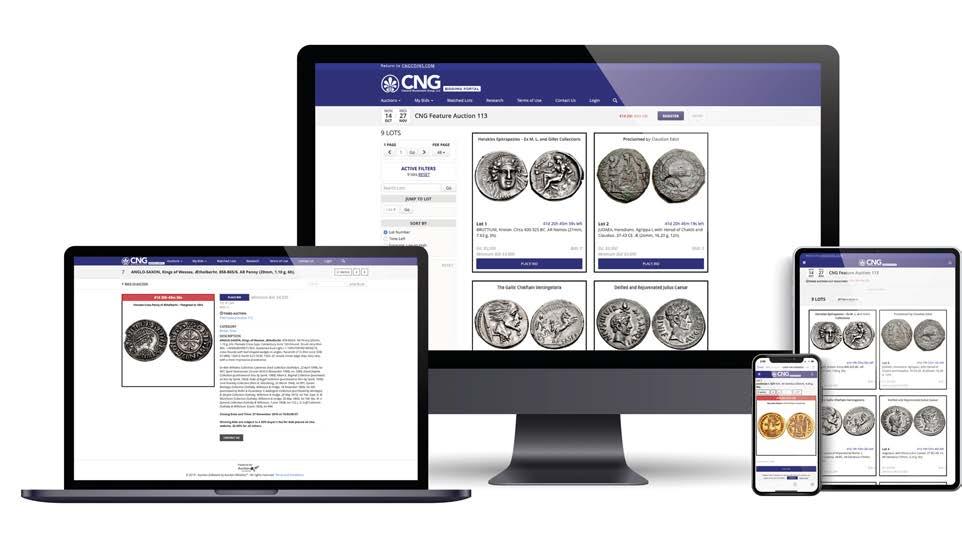
• Register online with your email address and a password

• Once approved, you may place pre-bids up until the moment the lot opens in the auction room
• On the auction day, login to join the auction and participate live
Please Note
• If you have not already registered for our bidding platform, you must create a new registration at auctions.cngcoins.com/register. Your old cngcoins.com handle and password will not allow you to log on or bid.
• You must register to bid before 5PM EST on Monday, May 22, 2023
• All lots won through the CNG Bidding Portal will be subject to a 22.5% buyer’s fee
our app today.
Download
Lot Viewing
Lancaster, PA
Auction lots may be viewed at our Lancaster Office from April 24 – May 22, 2023, by appointment only, except when they are on exhibition at the showing below. Lancaster Office Hours: 10 AM - 5 PM (Monday - Friday).
Schaumburg, IL
Auction lots may be viewed at the Central States Numismatic Convention, Tables 2009 and 2010, from April 27–30, 2023.
Online Viewing
Enlargements of all single lots and selected multiple lots may be viewed on the internet at

NumisBids.com
We are sorry, but photographs of individual coins in multiple lots cannot be provided
Auction Location
This Sale will be conducted live Online from our Lancaster, PA Office
Lot Pickup
Lots will be mailed from our Lancaster, PA Office subsequent to the sale
CNGCOINS.COM SIXBID.COM
Session One – Tuesday Morning – May 23 – 9:00 AM Celtic Coinage .............................................................. 1–3 Greek Coinage ........................................................... 4–294 Session Two – Tuesday Afternoon – May 23 – 2:00 PM Oriental Greek Coinage .................................................. 295–360 Central Asian Coinage ................................................... 361–378 Roman Provincial Coinage ................................................ 379–446 Roman Republican Coinage ............................................... 447–586 Session Three – Wednesday Morning – May 24 – 9:00 AM Roman Imperial Coinage ................................................. 587–702 Byzantine Coinage ...................................................... 703–824 Early Medieval Coinage .................................................. 825–836 Session Four – Wednesday Afternoon – May 24 – 2:00 PM World Coinage ......................................................... 837–879 A Special Collection of Madagascar ......................................... 880–897 United States Coinage .................................................... 898–899 United States Medals ........................................................ 900 British Coinage ........................................................ 901–1111 British Medals ........................................................ 1112–1113 Antiquities ........................................................... 1114–1115
ORDER OF SALE
Session 1 – Tuesday, May 23, 2023 — 9 AM
CELTIC COINAGE
1. EASTERN EUROPE, Imitations of Philip II of Macedon. 2nd century BC. AR Tetradrachm (23mm, 12.52 g, 12 h). Kroisbach type. Mint in Burgenland or Western Slovakia. Diademed, beardless head right, with “boxer’s nose” and pronounced jaw line / Rider on horseback left, showing only his torso, hair bound with diadem and tied into a topknot with three trailing curls; below, torque. OTA 749; Lanz 743; CCCBM I 154; KMW 1391; De la Tour 9901; Allen & Nash –. Deeply toned, patches of hoard patina, minor marks. Good VF. ($1000)
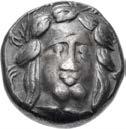

2. EASTERN EUROPE, Imitations of Larissa. Mid-late 3rd century BC. AR Tetradrachm (23mm, 12.42 g, 3h). Apollokopf-Dickscrhötling type. Mint in the central Carpathian region. Facing head of Apollo / Horseman riding right, crowning horse. Cf. OTA 228; KMW –; Lanz –. Toned, minor double strike and flan flaw on obverse. Good VF. Struck in very high relief. Very rare. ($750)
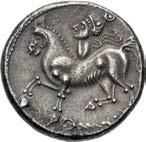

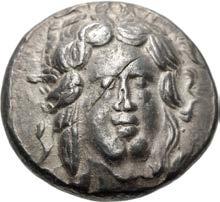


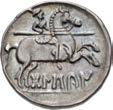
3. EASTERN EUROPE, Imitations of Larissa. Mid-late 3rd century BC. AR Tetradrachm (20mm, 13.74 g, 12h). Apollokopf-Dickscrhötling type. Mint in the central Carpathian region. Facing head of Apollo / Plumed horseman riding left; circle of pellets above, branch below. OTA 230; KMW 1128; Lanz 531. Deeply toned, traces of find patina. VF. Well centered. ($500)
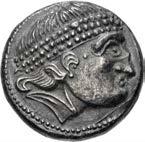
From the Jim Gilman Collection. Ex Kirk Davis FPL 53 (Spring 2008), no. 1; Numismatic Fine Arts VII (6 December 1979), lot 9.
GREEK COINAGE
4. IBERIA, Bolskan. Circa 150-100 BC. AR Denarius (18mm, 4.19 g, 1h). Bare male head right / Warrior on horse rearing right, holding spear. ACIP 1413. Deep iridescent tone, underling luster, some softness to strike, slight die wear on obverse. Near EF. ($300)
From the Richard McAlee Collection.

8
Massalia – Modern Marseilles
The ancient Greek settlement of Massalia, modern Marseilles on the south coast of France, was founded by settlers from Phokaia around 600 BC, becoming the westernmost Greek colony. The trading post soon grew into a thriving port city of more than of 50,000 souls. Massalia flourished and enjoyed good relations with Rome, eventually creating settlements of her own. Her independence ceased abruptly during the Roman civil wars of 49-32 BC, when she was absorbed into the Roman empire as part of Gallia Narbonensis. Nearly all of Massalia’s silver drachm coinage features a bust of Artemis, the city’s patron goddess, on the obverse, with a reverse depicting a lion prowling right or left.
5. GAUL, Massalia. Circa 150-125 BC. AR Drachm (16mm, 2.63 g, 6h). Light standard. Diademed and draped bust of Artemis right, bow and quiver over shoulder / Lion standing left, raising foreleg; Å between hind legs, ˚˙ to right. F&P DRM-37-3; Depeyrot, Hellénistiques 37/3 corr. (letters not in monogram form); SNG Copenhagen 760. In NGC encapsulation 6558557-003, graded MS, Strike: 4/5, Surface: 4/5. ($300)
6. GAUL, Massalia. Circa 125-90 BC. AR Drachm (16.5mm, 2.75 g, 5h). Light standard. Draped bust of Artemis right, wearing stephane, bow and quiver over shoulder / Lion standing left; f to left, d below belly, Å between hind legs. F&P DRM-42-1; Depeyrot, Hellénistiques 42/1; SNG Copenhagen –; SNG Stockholm 25. In NGC encapsulation 6558557-020, graded MS, Strike: 4/5, Surface: 4/5. ($300)
7. GAUL, Massalia. Circa 125-90 BC. AR Drachm (17mm, 2.74 g, 5h). Light standard. Diademed and draped bust of Artemis right, bow and quiver over shoulder / Lion standing left, raising foreleg; ¬ below, ÅQ in exergue. F&P DRM-44-4; Depeyrot, Hellénistiques 44/4; SNG Copenhagen –; SNG Fitzwilliam 24. In NGC encapsulation 6558557-024, graded MS, Strike: 4/5, Surface: 4/5. ($300)
8. GAUL, Massalia. Circa 125-90 BC. AR Drachm (16mm, 2.71 g, 5h). Light standard. Diademed and draped bust of Artemis right, bow and quiver over shoulder / Lion standing left, raising foreleg; ¬ below, ÅÂ in exergue. F&P DRM-44-7; Depeyrot, Hellénistiques 44/7; SNG Copenhagen 779. In NGC encapsulation 6558557-029, graded MS, Strike: 5/5, Surface: 4/5. ($300)
9. GAUL, Massalia. Circa 125-90 BC. AR Drachm (15.5mm, 2.73 g, 5h). Light standard. Diademed and draped bust of Artemis right, bow and quiver over shoulder / Lion standing left, raising foreleg; ¬ below, Å$ in exergue. F&P DRM-44-9; Depeyrot, Hellénistiques 44/9; SNG Copenhagen –. In NGC encapsulation 6558557-034, graded MS, Strike: 5/5, Surface: 4/5. ($300)
10. CAMPANIA, Neapolis. Circa 300-275 BC. AR Nomos (22.5mm, 6.83 g, 6h). Diademed head of female right; four dolphins around / Man-headed bull standing right, head facing, crowned by Nike flying right above; oU5¬ below. Sambon 458; HN Italy 576. Attractively toned, off center on obverse, scratch and light deposits on reverse. Good VF. ($1000)

Ex Classical Numismatic Group 120 (11 May 2022), lot 11; Pegasi XXV (8 November 2011), lot 21.


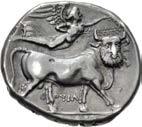









11. CALABRIA, Tarentum. Circa 480-470 BC. AR Nomos (16mm, 7.80 g). Taras riding dolphin right; cockle shell below / Wheel of four spokes. Fischer-Bossert Group 4, 81 (V41/R55); Vlasto 74 (same dies); HN Italy 833; SNG Ashmolean 204 = Pozzi 111 (same dies); SNG Copenhagen 767 (same dies); Boston MFA 47 = Warren 17 (same dies); Jameson 82 (same dies); McClean 529 (same dies). Toned, traces of find patina. Good VF. Well centered. ($750)

9
5 6 7 8 9 10 11
Ex Vlasto Collection
12. CALABRIA, Tarentum. Circa 302-280 BC. AR Drachm (16mm, 2.94 g, 8h). Helmeted head of Athena right / Owl standing right, head facing; zor and olive branch to right. Vlasto 1049 (this coin); HN Italy 975. Find patina, hairline flan crack, a few minor marks, minor die break on reverse. Near EF. ($500)



From the Jim Gilman Collection. Ex Freeman & Sear FPL 8 (Fall 2003), no. 23; Michael Pandely Vlasto Collection.
13. LUCANIA, Herakleia. Circa 390-340 BC. AR Nomos (21mm, 7.68 g, 1h). Helmeted head of Athena right, helmet decorated with Skylla hurling a stone; d>˚>f to right / Herakles standing facing, upper torso turned right, wrestling with the Nemean Lion; club and ˚Ŭ to left; between Herakles’ legs, owl standing right, head facing. Work 39 (same dies); Van Keuren 50; HN Italy 1377; SNG Lloyd 272 (same dies); BMC 28 (same dies); Hirsch 141 (same dies); Pozzi 148 (same dies). Lightly toned, slightly compact flan, faint marks and a little die wear on obverse. Good VF. Fine style. ($1500)
Pedigreed to 1973
14. LUCANIA, Metapontion. Circa 540-510 BC. AR Nomos (30mm, 7.93 g, 12h). Barley ear with eight grains / Incuse barley ear with nine grains. Noe Class III, 55 (same dies); HN Italy 1467. Attractively toned, small area of weak strike, light scratches, die break on reverse. VF. ($1000)
Ex Kirk Davis FPL 63 (Spring 2014), no. 5; Bullowa (20 June 1998), lot 455; Monetarium FPL 27 (Winter 1978/9), lot 5; Auctiones 8 (27 June 1978), lot 25; G. Hirsch 84 (27 June 1973), lot 5.
15. LUCANIA, Metapontion. Circa 440-430 BC. AR Nomos (23.5mm, 7.93 g, 6h). Ear of barley with seven grains / Apollo, nude, standing facing, head left, holding small laurel tree and bow. Noe 314 (same dies); HN Italy 1496; SNG ANS 277 (same dies); SNG Ashmolean 677 (same dies); SNG Copenhagen 1185 (same dies); BMC 47 (same dies); Jameson 266 (same dies); Kraay & Hirmer 232. Lightly toned, traces of find patina and minor deposits, minor edge split. Good VF. Very rare, and attractive for this difficult issue, notorious for metal problems and very worn dies. ($2000)
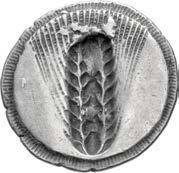

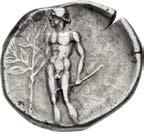

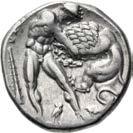

Ex Nomos 8 (22 October 2013), lot 13; Numismatic Fine Arts XIV (29 November 1984), lot 19; Schweizerische Bankverein 5 (16 October 1979), lot 29; Münzen und Medaillen AG FPL 397 (February 1978), no. 5.
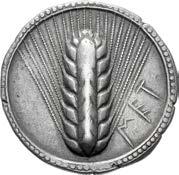
10
16. LUCANIA, Thourioi. Circa 400-350 BC. AR Dinomos – Distater (24.5mm, 15.54 g, 2h). Head of Athena right, wearing crested Attic helmet decorated on its bowl with Skylla raising left arm to head, and on its neck guard with a griffin standing right / Bull butting right on dotted ground line; in exergue, fish right. Noe, Thurian, Group C, 4 (same obv. die); HN Italy 1803; Jameson 363 (same dies); de Luynes 850 (same dies). In NGC encapsulation 6029601-004, graded Ch XF, Strike: 5/5, Surface: 3/5, Fine Style. ($3000)
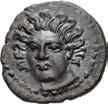



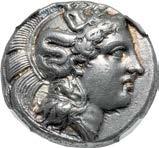


17. BRUTTIUM, Kaulonia. Circa 525-500 BC. AR Nomos (31mm, 7.91 g, 12h). Apollo advancing right, holding branch aloft in right hand, left arm extended, upon which a small daimon, holding branch in each hand, runs right; ˚å¨Ò to left; to right, stag standing right, head reverted; dot-and-cable border / Incuse of obverse, but daimon in outline and no ethnic; radiate border. Noe, Caulonia, Group A, 14; Gorini 3; HN Italy 2035; SNG ANS 147 (same obv. die); McClean 1591 (same dies). Wonderful deep old cabinet tone. EF. ($15,000)

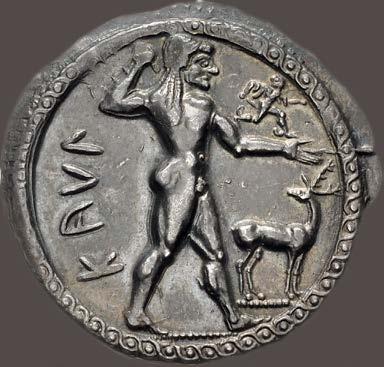
Ex Mark and Lottie Salton Collection.
Kaulonia was founded in the 7th century BC by Achaean Greeks. The location, on the underside of Italy’s “toe,” has long since disappeared beneath the waves, but underwater archaeologists have located more than 100 fluted columns, likely for a large shrine to Apollo, the deity depicted on the city’s beautiful coinage. On this exceptional piece, Apollo’s nude body is shown striding to right, with a small winged daimon on his left arm; to his right stands a stag, sacred to both Apollo and his sister Artemis. The unusual fabric of this piece follows a style peculiar to Greek southern Italy in the archaic period: A broad, thin flan, obverse depicted in relief, the reverse repeating the obverse motif but incuse, and reversed. The reasons for the popularity of this fabric are poorly understood; some scholars have postulated a connection to the mathematician-philosopher Pythagoras, who was active in Italy during this period.
18. BRUTTIUM, Rhegion. Circa 415/0-387 BC. AR Litra (10mm, 0.75 g, 10h). Facing scalp of lion / Olive-spray with two berries. Herzfelder pl. XI, Jβ; HN Italy 2499. Attractively toned, trace deposits. EF. Well struck. ($400)
Ex Numismatica Ars Classica 51 (5 March 2009), lot 555.


19. SICILY, Abakainon. Circa 410-400 BC. AR Litra (11mm, 0.63 g, 3h). Head of female facing slightly left / Sow and piglet standing left. Campana 23; Bertino 21; HGC 2, 21. Find patina, minor die break on reverse. Superb EF. ($500)
From the Jim Gilman Collection. Ex Triton X (9 January 2007), lot 61.
11
18 19
20. SICILY, Gela. Circa 430-425 BC. AR Tetradrachm (22mm, 17.00 g, 8h). Charioteer driving slow quadriga right; wreath above / Forepart of man-headed bull right; [in exergue, goose left]; all within incuse circle. Jenkins Group VI, 399 (O82/R168); HGC 2, 346; BMC 44 (same obv. die); Ars Classica XII, lot 722 (same dies). Lightly toned, some die wear on obverse, a little off center on reverse. VF. ($750)

21. SICILY, Leontini. Circa 476-466 BC. AR Tetradrachm (22.5mm, 1714 g, 1h). Charioteer driving slow quadriga right; above, Nike flying right, crowning horses / Head of roaring lion right; four barley grains around. Boehringer, Münzgeschichte 8 = SNG ANS 230 (same obv. die); HGC 2, 660. Toned, some porosity, minor marks, minor flan flaw on obverse. Good VF. ($3000)
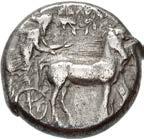



From the W. Hansen Collection, purchased from ArtAncient, 21 March 2016. Ex Gorny & Mosch 215 (14 October 2013), lot 691.
22. SICILY, Leontini. Circa 430-425 BC. AR Tetradrachm (25mm, 17.23 g, 12h). Laureate head of Apollo left / Head of roaring lion left; leaf to right, three barley grains around. Boehringer, Münzgeschichte 55 (same dies); HGC 2, 671; SNG ANS 229-30 (same obv. die); Rizzo, pl. XXIV, 4 (same dies). Light iridescent tone, underlying luster, some weakness to strike, usual die break on obverse. Good VF. ($1500)
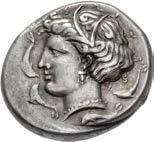

From the Don T. Hayes Collection, purchased from FDC Numismatics.
CNP Plate Coin
23. SICILY, Lilybaion (as ‘Cape of Melkart’). Circa 330-305 BC. AR Tetradrachm (22mm, 16.91 g, 3h). Charioteer, holding kentron and reins, driving fast quadriga left; above, Nike flying right, crowning charioteer with wreath; [te]Q¬Mß[e] (RŠMLQRT = “Raš Melqart” in Punic) in exergue / Wreathed head of Arethousa left; four dolphins swimming around. Jenkins, Punic 59 (O19/R46); CNP 327a (this coin referenced and illustrated); HGC 2, 743; SNG Fitzwilliam 973 (same dies). Lightly toned. VF. Attractive style. ($2000)
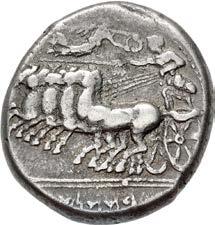



Ex Lanz 60 (11 June 1992), lot 70.
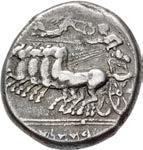
12
24. SICILY, Messana (as Zankle). Circa 500-493 BC. AR Drachm (22mm, 4.86 g). Dolphin left within sickle-shaped harbor / Nine-part incuse square with scallop shell in center. Gielow Group 4; HGC 2, 766. Toned, some porosity, a little roughness, a few light scratches, double struck on obverse. VF. ($1500)
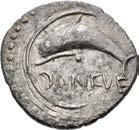
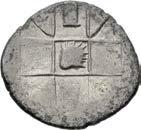

From the Jim Gilman Collection. Ex William N. Rudman Collection (Triton V, 15 January 2002), lot 1188.
25. SICILY, Messana. 425-421 BC. AR Tetradrachm (26mm, 17.18 g, 10h). Charioteer, holding reins, driving slow biga of mules right; above, Nike flying right, crowning mules with wreath; in exergue, two dolphins confronted / Hare springing right; below, dolphin right. Caltabiano Series XIII, 497 (D202/R205); HGC 2, 787; SNG ANS 360 (same dies); SNG Lloyd 1092 (same dies); SNG Lockett 827 = Pozzi 488 (same dies); Hermitage Sale II 293 (same dies); Rhousopoulos 188 (same dies). Attractively toned, area of minor roughness and minor flan flaws on obverse. Good VF. ($2000)
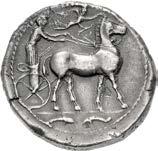

From the Jim Gilman Collection. Ex William N. Rudman Collection (Triton V, 16 January 2002), lot 1190.
Second Known
26. SICILY, Naxos. Circa 415-403 BC. AR Litra (9.5mm, 0.76 g, 11h). Wreathed head of young Dionysos left / Youthful Silenos kneeling left, holding kantharos and thyrsos; vine of ivy to lower left. Cahn –; Campana 27 (same dies as illustration = NAC 25, lot 86); HGC 2, –. Lightly toned. Good VF. Extremely rare, apparently the second known. ($1000)

Ex Moretti Collection
Circa 415-403 BC. AR Litra (12mm, 0.80 g, 8h). Wreathed head of bearded Dionysos right / Grape bunch on vine. Cahn 145 (O88/R116); Campana 29; HGC 2, 976. Iridescent tone, small area of weak strike. VF. ($750)
27. SICILY,
Ex CNG Inventory 735588 (August 2003); A.D. Moretti Collection (Numismatica Ars Classica N, 26 June 2003), lot 1135.







13
Naxos.
28. SICILY, Selinos. Circa 540-515 BC. AR Didrachm (23.5mm, 8.53 g). Selinon leaf; [two tiny pellets across upper field] / Incuse square divided into ten sections. Arnold-Biucchi Group I, 2; HGC 2, 1209. Lightly toned, flan crack, some roughness. Near EF. ($1000)

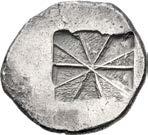
Ex Cederlind 142 (5 April 2007), lot 26.
29. SICILY, Selinos. Circa 455-409 BC. AR Tetradrachm (24mm, 17.24 g, 3h). Artemis, holding reins, driving slow quadriga right; beside her, Apollo standing right, drawing bow; barley grain in exergue / Selinos standing left, wearing himation, holding palm frond and phiale over altar to left; before altar, cock standing left; to right, selinon leaf above bull standing left on basis. Schwabacher 18 (Q5/S16); HGC 2, 1221; SNG ANS 696 (same dies); McClean 2579 (same dies). Old collection tone. VF. ($1500)
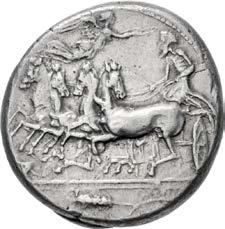

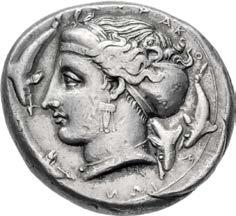

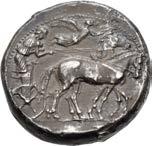
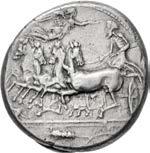
Ex Mark and Lottie Salton Collection.
30. SICILY, Syracuse. Second Democracy. 466-405 BC. AR Tetradrachm (24mm, 17.33 g, 8h). Struck circa 450 BC. Charioteer driving quadriga right; above, Nike flying right, crowning horses; in exergue, ketos right / Head of Arethousa right, wearing tainia; four dolphins around. Boehringer Series XV, 525 (V273/R365); HGC 2, 1316; SNG ANS 170 (same rev. die); Montagu 135 (same dies). Deeply toned, some find patina. Good VF. ($2000)
Ex I. Vecchi 14 (5 February 1999), lot 313.
Referenced by Fischer-Bossert
31. SICILY, Syracuse. Dionysios I. 405-367 BC. AR Tetradrachm (24mm, 17.28 g, 1h). Struck circa 405-400 BC. Charioteer, wearing long chiton, holding kentron and reins, driving fast quadriga right; above, Nike flying left, crowning charioteer; ivy leaf on vine below horses to left; in exergue, grain ear left / Head of Arethousa left, hair in ornate sphendone; four dolphins swimming around. Fischer-Bossert, Coins 83e (V30/R56 – this coin); Tudeer 83; HGC 2, 1342; SNG ANS 291 (same dies); SNG Fitzwilliam 1249 = Bement 521 (same dies); SNG Lockett 977 = Pozzi 619 (same dies); Dewing 850 (same dies); Jameson 823 (same dies). Lightly toned, a little die wear on obverse. VF. Well centered. ($3000)

Ex Classical Numismatic Auctions 7 (4 May 1989), lot 16.

14
28 29
275-215
AR 16 Litrai – Tetradrachm (25mm, 13.59 g, 4h).
circa 240-218/5 BC. Diademed and veiled head left; torch to right / ∫Å%5¬5%%Å% f5¬5%t5do%, Nike, holding reins in both hands, driving fast quadriga right; E below horses. CCO 49 (D12/R31); BAR Issue 65; HGC 2, 1554; SNG ANS 884 (same dies); SNG Ashmolean 2107 (same dies); SNG München 1357 and 1359 (same dies); McClean 1398 (same dies); Ward 337 (same dies); Weber 1707 (same dies). Lightly toned, minor die wear on obverse. Near EF. ($2000)
Ex Jacquier 49 (17 September 2021), lot 66.
Philistis was the daughter of an influential Syracusan named Leptines. Hieron, a mercenary refugee from the army of Pyrrhos of Epeiros, took control of Syracuse after Pyrrhos’ withdrawal from the city in 275 BC. Hieron immediately sought out and married Philistis to secure his position with the city’s elite. His coinage in her name commenced after he was proclaimed king (and she queen) in 265 BC and reflects the strong influence of Ptolemaic Egypt, depicting her veiled head in a manner reminiscent of Egyptian queens Arsinoe II and Berenike II.
CCO Plate Coin – Ex Enna Hoard
33.
II. 275-215 BC. AR 16 Litrai – Tetradrachm (25.5mm, 13.60 g, 11h).
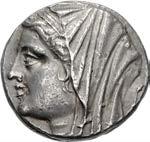





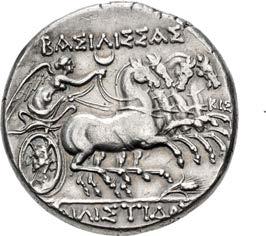
circa 217-215 BC. Diademed and veiled head left / Nike driving slow quadriga right; crescent above, ˚5% to right, grain ear below. CCO 80.1–2 corr. (D19/R53 [nos. 1 and 2 are the same coin]) = Burnett, Enna 41 (this coin); BAR Issue 65; HGC 2, 1554. Light
Ex Peus 299 (6 May 1980), lot 101; Schweizerische Bankverein 5 (16 October 1979), lot 127; 1966 Enna environs Hoard (IGCH 2232). Lot also includes a Baldwin’s inventory ticket.
15
32. SICILY, Syracuse. Philistis, wife of Hieron II.
BC.
Struck
SICILY, Syracuse. Philistis, wife of Hieron
Struck
iridescent tone, minor die wear, slight doubling and minor flan flaw on obverse. Good VF. ($1500)
Unpublished Variety of the Largest Carthaginian Bronze



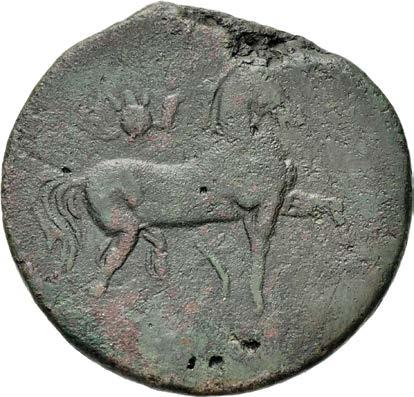
16
34. CARTHAGE. Circa 201-175 BC. Æ 15 Shekels (45mm, 94.03 g, 12h). Carthage mint. Wreathed head of Tanit left / Horse standing right; uraeus above, K (Punic alef) below. CNP 48 var. (unlisted Punic letter); MAA 104 var. (same); SNG Copenhagen (Africa) 399–400 var. (letter on rev.). Dark green-brown patina, a few flan flaws. Near VF. Unpublished with this Punic letter on the reverse. ($750)
Massive Olbia Bronze
From the D.K. Collection. Ex Harlan J. Berk inventory cc96487 (ND); Triton XXIII (14 January 2020), lot 159.
The impressive cast bronzes of Olbia on the Black Sea in many ways presaged the development of the Aes Grave coinage in Italy, although the regions were separated by more than 1,000 miles. Olbia, a colony of Miletus located at the junction of the Hyspanis and Borysthenes rivers in the wilds of Skythia, grew prosperous on trade between the nomadic Skythians and the Greeks. It employed a unique form of coinage consisting of cast bronzes of various sizes and shapes. The smallest Olbian bronzes were made in the shape of dolphins; larger denominations were on circular flans and bore either a facing Gorgon’s head or, as seen here, a helmeted head of Athena in profile. The reverse is a fourspoked wheel, also interpreted as a solar disk. Like the early Romans, the Olbians apparently traded these pieces at “true” value, as opposed to token value, meaning the largest denominations were truly immense and heavy.

May
36.
450-425
AR Tetradrachm (26mm, 14.94 g, 2h). Smordo(s), son of (He)rmokal(les), magistrate. Griffin with curved wing seated left, raising forepaw; kantharos to lower left / Eπ5 sÂ-ordo to rÂ-o˚Ŭ around raised quadripartite incuse square; all within shallow incuse square. May, Abdera, Period IV, Group LIII, 134a (A113/ P110) = AMNG II 58.10a (this coin, illustrated by May); HGC 3, 1136; SNG Fitzwilliam 1638–9 (same obv. die); SNG Spencer-Churchill 100 (same obv. die). Toned, slight granularity, a couple of knocks on edge. VF. With a distinguished pedigree. ($5000)


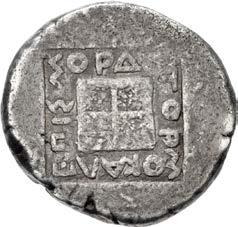
Ex Sotheby’s (7 March 1996), lot 68; Feuardent (9 June 1913), lot 140; Gustav Philipsen Collection (J. Hirsch XXV, 29 November 1909), lot 68. Reportedly ex Strauss Collection, October 1951.
This is the only appearance of a patronymic on a coin of Abdera (see O. Masson, “Quelques nomes de magistrats monétaires Grecs. IV. Noms de monétaires à Abdère et Maronée” in RN 984, p. 54).

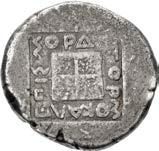
17
35. SKYTHIA, Olbia. Circa 450-440 BC. Cast Æ (69mm, 136.32 g). Head of Athena left, wearing Attic helmet; to left, dolphin upward / Wheel with four spokes (‘solar disk’); πÅUs within quarters. Karyshkovskij p. 392, Таб. II=B, 1; Anokhin 164; cf. HGC 3, 1883 (smaller denomination). Green patina. VF. Very rare. ($3000)
Plate Coin – Referenced in AMNG – Ex Philipsen Collection (1909)
THRACE, Abdera. Circa
BC.
Numismatically Important
37. THRACE, Byzantion. Circa 210-195 BC. AV Stater (19mm, 8.42 g, 12h). In the name and types of Lysimachos. Diademed head of the deified Alexander right, with horn of Ammon / Athena Nikephoros seated left, left arm resting on shield, transverse spear in background; º to inner left, ∫U below throne, ornate trident in exergue. Marinescu Issue 91, unlisted denomination, but obv. die O82 (known for Issue 90); Müller –; HGC 3, 1379. Minor marks, tiny scrape on obverse. Near EF. Well centered and struck. Extremely rare, the fourth known (the others: CGB XXXVI, lot 71 = Rauch 79, lot 2126; Künker 326, lot 683; and Savoca 138, lot 31), and the only one struck from this obverse die that is linked to another issue. ($1500)
38. THRACE, Byzantion. Circa 100-96 BC. AR Tetradrachm (33.5mm, 16.52 g, 12h). In the name and types of Lysimachos. Diademed head of the deified Alexander right, with horn of Ammon / Athena Nikephoros seated left, left arm resting on shield, transverse spear in background; L to inner left, ∫U below throne, ornate trident in exergue. Callataÿ Group 2B, obv. die unlisted; Müller –; HGC 3, 1405. Iridescent tone, slight weakness on high points, a couple of minor scratches in field on reverse. Good VF. ($300)
39. THRACE, Byzantion. Circa 90-80 BC. AR Tetradrachm (33mm, 16.50 g, 12h). In the name and types of Lysimachos. Diademed head of the deified Alexander right, with horn of Ammon / Athena Nikephoros seated left, left arm resting on shield, transverse spear in background; Œ to inner left, ∫U below throne, ornate trident in exergue. Callataÿ Group 3, obv. die D1; Müller 202; HGC 3, 1406. Iridescent tone, faint cleaning marks on obverse. Near EF. ($400)

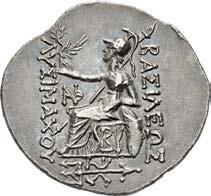


40. THRACE, Byzantion. Circa 90-80 BC. AR Tetradrachm (35mm, 16.32 g, 12h). In the name and types of Lysimachos. Diademed head of the deified Alexander right, with horn of Ammon / Athena Nikephoros seated left, left arm resting on shield, transverse spear in background; Ļ to inner left, ∫U below throne, ornate trident in exergue. Callataÿ Group 3, obv. die unlisted; Müller 208; HGC 3, 1406. Iridescent tone, slight doubling and minor scratch on obverse. Near EF. ($400)

41. THRACE, Byzantion. Circa 90-80 BC. AR Tetradrachm (34.5mm, 16.00 g, 12h). In the name and types of Lysimachos. Diademed head of the deified Alexander right, with horn of Ammon / Athena Nikephoros seated left, left arm resting on shield, transverse spear in background; W to inner left, ∫U below throne, ornate trident in exergue. Callataÿ Group 3, dies D25/R10; Müller 197; HGC 3, 1406. Iridescent tone, porous. EF ($400)
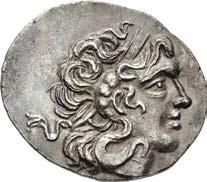
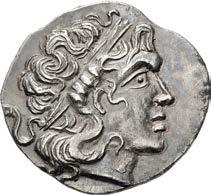





18
38 39 40 41
42. THRACE, Byzantion. Circa 90-80 BC. AR Tetradrachm (32.5mm, 16.25 g, 11h). In the name and types of Lysimachos. Diademed head of the deified Alexander right, with horn of Ammon / Athena Nikephoros seated left, left arm resting on shield, transverse spear in background; Ő to inner left, ∫U below throne, ornate trident in exergue. Callataÿ Group 3, obv. die D43; Müller 218; HGC 3, 1406. Toned, slightly weak strike at high points, a little roughness. Good VF. Attractive late Hellenistic style. ($300)
43. THRACE, Byzantion. Circa 90-80 BC. AR Tetradrachm (36mm, 16.20 g, 11h). In the name and types of Lysimachos. Diademed head of the deified Alexander right, with horn of Ammon / Athena Nikephoros seated left, left arm resting on shield, transverse spear in background; L to inner left, ∫U below throne, ornate trident in exergue. Callataÿ Group 3, obv. die D47; Müller 157; HGC 3, 1406. Iridescent tone, slight roughness, minor die wear on obverse. Good VF. ($300)
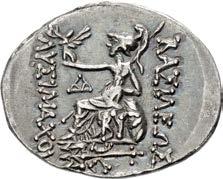
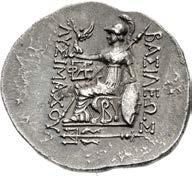
44. THRACE, Byzantion. Circa 90-80 BC. AR Tetradrachm (31.5mm, 16.12 g, 11h). In the name and types of Lysimachos. Diademed head of the deified Alexander right, with horn of Ammon / Athena Nikephoros seated left, left arm resting on shield, transverse spear in background; Ŕ to inner left, ∫U below throne, ornate trident in exergue. Callataÿ Group 3, – (unlisted monogram); Müller –; HGC 3, 1406. Iridescent tone, trace deposits, minor porosity. Near EF. Very rare. ($400)




45. THRACE, Maroneia. Circa 377-365 BC. AR Triobol (14mm, 2.70 g, 12h). Forepart of horse left / Grape-bunch on vine; kantharos to left; all in dotted linear square within incuse square. Schönert-Geiss 262 var. (V–/R53 [unlisted obv. die]); HGC 3, 1534. Attractive iridescent cabinet tone. EF. ($500)
Ex BLS Collection (Classical Numismatic Group Electronic Auction 476, 9 September 2020), lot 39.
46. ISLANDS off THRACE, Thasos. Circa 500-480 BC. AR Stater (22mm, 9.58 g). Satyr advancing right, carrying off protesting nymph / Quadripartite incuse square. Le Rider, Thasiennes 2; HGC 6, 331. Lightly toned. Near EF. Well struck for issue. ($750)


From the HK Collection.
47. ISLANDS off THRACE, Thasos. Circa 480-463 BC. AR Stater (21.5mm, 9.00 g). Satyr advancing right, carrying off protesting nymph / Quadripartite incuse square. Le Rider, Thasiennes 5; HGC 6, 331. Toned, minor doubling and a little die wear on obverse, scuff at edge on reverse. Good VF. Well centered and struck. ($750)




19
42 43 44 45 46 47
Erased Control Marks
48. KINGS of THRACE, Macedonian. Lysimachos. 305-281 BC. AR Tetradrachm (27mm, 17.28 g, 1h). Lampsakos mint. Struck 297/6-282/1 BC. Diademed head of the deified Alexander right, with horn of Ammon / Athena Nikephoros seated left, left arm resting on shield, transverse spear in background; to inner left, traces of M above crescent (erased in die). Cf. Thompson 61 (before erasure); cf. Müller 395 (before erasure); HGC 3, 1750b; cf. SNG BN 2546 (before erasure); cf. Solidus 8, lot 42 (same dies, before erasure). Toned, light scuffs and flan flaws on obverse. Good VF. Very rare with erased control marks. ($1000)
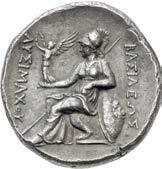
From the D.K. Collection. Ex Spink 258 (28 January 2019), lot 1509; Numismatik Naumann 57 (3 September 2017), lot 77.
49. KINGS of THRACE, Macedonian. Lysimachos. 305-281 BC. AR Tetradrachm (32mm, 16.78 g, 10h). Amphipolis mint. Struck circa 288/7-282/1 BC. Diademed head of the deified Alexander right, with horn of Ammon / Athena Nikephoros seated left, left arm resting on shield, transverse spear in background; ∑ to inner left, Ŗ to outer right, M in exergue. Thompson 207; cf. Müller 538–9; HGC 3, 1750l. Toned, light porosity, minor double strike, a few minor scratches, small spot of smoothing on obverse. Near EF. ($1500)

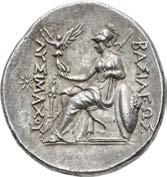

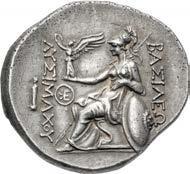
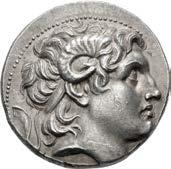


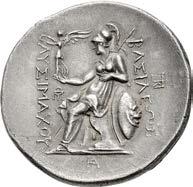
50. KINGS of THRACE, Macedonian. Lysimachos. 305-281 BC. AR Tetradrachm (28.5mm, 16.60 g, 12h). Pergamon mint. Struck circa 287/6-282 BC. Diademed head of the deified Alexander right, with horn of Ammon / Athena Nikephoros seated left, left arm resting on shield, transverse spear in background; herm to outer left; to inner left, pentagram above  Arnold-Biucchi, Pergamene, 8–9 var. (O2/R– [unlisted rev. die]); Thompson 216; Müller 92; HGC 3, 1750m. Toned, a hint of porosity, light marks, minor doubling on obverse. EF. ($2000)
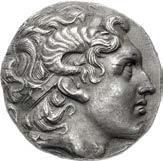
51. KINGS of THRACE, Macedonian. Lysimachos. 305-281 BC. AR Tetradrachm (31.5mm, 16.92 g, 12h). Pergamon mint. Struck circa 287/6-282 BC. Diademed head of the deified Alexander right, with horn of Ammon / Athena Nikephoros seated left, left arm resting on shield, transverse spear in background; herm to outer left, Ņ to inner left. Arnold-Biucchi, Pergamene, 14 var. (O3/R– [unlisted rev. die]); Thompson 217; Müller –; HGC 3, 1750m. Toned, some porosity, light cleaning marks. Near EF. ($1000)
52. KINGS of THRACE, Macedonian. Lysimachos. 305-281 BC. AR Tetradrachm (27.5mm, 17.08 g, 12h). Pergamon mint. Struck circa 287/6-282 BC. Diademed head of the deified Alexander right, with horn of Ammon; ˚ below / Athena Nikephoros seated left, left arm resting on shield, transverse spear in background; star to outer left, cult image to inner left. Arnold-Biucchi, Pergamene 70 (O14/R68 [erroneously listed as 65a (O12/R64) on the plate]); Thompson 227; Müller 288; HGC 3, 1750m; ANS inv. 1944.100.77563 (same dies). Attractive light toning, trace deposits, a few light cleaning scratches on reverse, a couple of minor marks on edge. Near EF. Excellent style and well centered. ($3000)
20
49 50 51 52
(29mm, 16.99 g, 3h). Uncertain
297/6-282/1 BC. Diademed head of the deified Alexander right, with horn of Ammon / ∫Å%5¬EW% 2U%5;ÅcoU, Athena Nikephoros seated left, left arm resting on shield, transverse spear in background; kerykeion to inner left, Þ in exergue. Thompson –; Müller 110 var. (monogram); cf. HGC 3, 1750 (for type); CNG 114, lot 101 = CNG 88, lot 66 var. (monogram; same obv. die). Attractive light iridescent tone, slight doubling on reverse. Superb EF. High relief and fine style. ($7500)



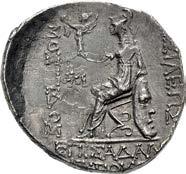

Ex Walter Weise Collection (Künker 347, 22 March 2021), lot 660 (hammer €7500 [≈ $9000]), purchased from Spink London, May 1993. Struck from the same obverse die as the following coin.
The kerykeion is a common symbol on Lysimachos’ issues at Amphipolis, but elements of this coin are not consistent with the products of that mint. For one, the portrait style, particularly the short hair on the neck and the display of the diadem ties, is dissimilar to any of the published issues from Amphipolis, and is more consistent with the coins from one of Lysimachos’ mints in western Asia Minor, such as Ephesos (cf. Meydancikkale 2659) or Alexandreia Troas (cf. Thompson pl. 20, 163). Also, on the issues at Amphipolis with kerykeion, the secondary controls are always placed in the outer right field, not the exergue, as on this coin.


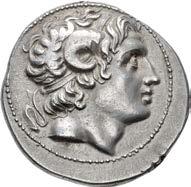
54. KINGS of THRACE, Macedonian. Lysimachos. 305-281 BC. AR Tetradrachm (31.5mm, 16.84 g, 2h). Uncertain mint in northwest Asia Minor. Struck circa 297/6-282/1 BC. Diademed head of the deified Alexander right, with horn of Ammon / Athena Nikephoros seated left, left arm resting on shield, transverse spear in background; kerykeion to inner left, Ŋ in exergue. Thompson –; Müller 110 var. (monogram); cf. HGC 3, 1750 (for type); CNG 114, lot 101 = CNG 88, lot 66 var. (monogram; same obv. die); Künker 347, lot 660 var. (same; same obv. die). Lightly toned, some weakness at high points, indications of undertype and minor die breaks on reverse. Near EF. Struck on a broad flan. ($1500)
Struck from the same obverse die as the previous lot.
55. KINGS of THRACE, Local Dynasts. Mostis. Circa 139/8-101/0 BC. AR Tetradrachm (30.5mm, 16.01 g, 12h). Dated RY 38(?) (102/1 BC). Diademed and draped bust right / Athena Nikephoros seated left, left arm resting on shield decorated with human face, transverse spear in background; ≤ to inner left, EtoU% [¬˙] (date) in exergue. Paunov, Coinage 17–20 var. (O4/R– [unlisted rev. die]); Peykov C4500; HGC 3, 1727. Toned, rough surfaces, porous, double struck on reverse. VF. Rare. ($1500)
Although the date is off the flan, this monogram is known from four dies, all dated to year 38.
21
Fine Style
53. KINGS of THRACE, Macedonian. Lysimachos. 305-281 BC. AR Tetradrachm
mint in northwest Asia Minor. Struck circa
56. MACEDON, Akanthos. Circa 525-470 BC. AR Tetradrachm (29.5mm, 17.16 g). Attic standard. Lion right, attacking bull crouching left, biting into its hindquarter; Q above; floral ornament in exergue / Quadripartite incuse square. Desneux 48–68 var. (unlisted dies); AMNG III/2, 5; HGC 3, 383. Toned. Near EF. Well centered. ($3000)

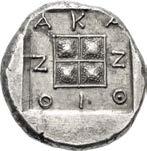
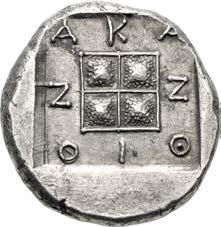


57. MACEDON, Akanthos. Circa 470-430 BC. AR Tetradrachm (28mm, 17.48 g, 5h). Attic standard. Lion right, attacking bull crouching left, biting into its hindquarter; in exergue, fish left / Ethnic in shallow incuse square around quadripartite square in relief. Desneux 97 and 99–100 var. (unlisted dies); AMNG III/2, 21; HGC 3, 385. Lightly toned, underlying luster, a hint of granularity, some minor marks. Near EF. Well centered. ($5000)

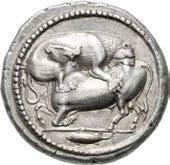
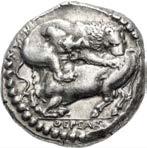

Unpublished Magistrate
58. MACEDON, Akanthos. Circa 430-390 BC. AR Tetradrachm (23.5mm, 14.29 g, 11h). Light ‘Thraco-Macedonian’ standard. Thersas, magistrate. Lion right, attacking bull crouching left, biting into its hindquarter; QErsÅs in exergue / Ethnic in shallow incuse square around quadripartite square in relief, the quarters raised and granulated. Desneux –; AMNG III/2, –; HGC 3, 391 var. (magistrate unlisted). Lightly toned, underlying luster, minor die wear and a few faint cleaning marks on obverse. Near EF. Unpublished with this magistrate, who is also unlisted in Leschhorn. Extremely rare. ($2000)
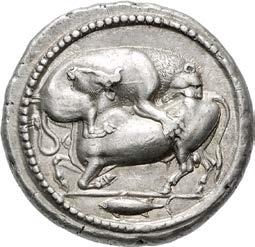
59. MACEDON, Chalkidian League. Circa 382-379 BC. AR Tetrobol (13mm, 2.38 g, 6h). Olynthos mint. Laureate head of Apollo right / Kithara. Robinson & Clement Group I, 92 (A60/P61); HGC 3, 502; SNG ANS 534 (same obv. die). EF. Attractive style. ($500)


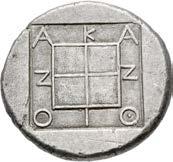
From the W. Hansen Collection. Ex Classical Numismatic Group 91 (19 September 2012), lot 119.
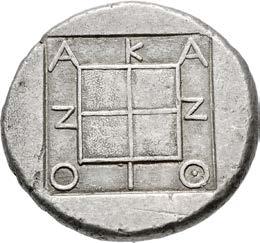
22
60. MACEDON, Chalkidian League. Circa 380 BC. AR Tetradrachm (25mm, 14.35 g, 1h). Olynthos mint. Laureate head of Apollo right / Kithara. Robinson & Clement Group J, 43 (A33/P39); AMNG III/2, –; HGC 3, 498; SNG ANS 477 (same dies); BMC 6 (same dies). Attractive old collection tone, a hint of die wear on obverse. Near EF. ($2000)


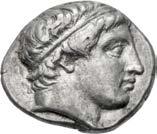
61. KINGS of MACEDON. Archelaos. 413-400/399 BC. AR Stater (24.5mm, 10.68 g, 8h). Aigai mint. Head of Apollo right, wearing tainia / Horse standing right, foreleg raised, wearing bridle with trailing rein, in linear square within incuse square. Westermark, Staters, Group II, Series 2, dies O38/R57; HGC 3, 795. Toned, some die rust on obverse. VF. ($750)
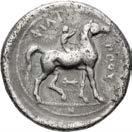

From the Don T. Hayes Collection.
Three Lifetime Issues of Philip II
62. KINGS of MACEDON. Philip II. 359-336 BC. AR Tetradrachm (25mm, 14.40 g, 12h). Pella mint. Struck circa 342/1-337/6 BC. Laureate head of Zeus right / Nude youth, holding palm frond and rein, on horseback right; horizontal thunderbolt below, @ in exergue. Le Rider Group II.A.2, 281 (D157/R222); SNG ANS 393 (same dies). Areas of roughness. Good VF. High relief portrait. ($1000)
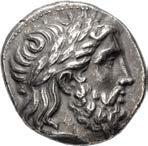
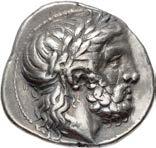
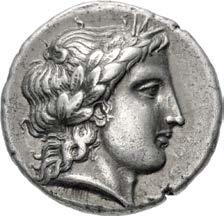


63. KINGS of MACEDON. Philip II. 359-336 BC. AR Didrachm (21mm, 6.96 g, 12h). Pella mint. Struck circa 342/1-337/6 BC. Head of Herakles right, wearing lion skin / Nude youth crowning horse upon which he rides right; horizontal thunderbolt below, @ in exergue. Le Rider Group II.A.2, 311 (D169/R249); SNG ANS –; Weber 2058 (same dies). Toned, typical granular surfaces, scrapes on reverse. Near VF. Very rare. ($500)
64. KINGS of MACEDON. Philip II. 359-336 BC. AR Tetradrachm (24mm, 13.84 g, 10h). Amphipolis mint. Struck circa 355-349/8 BC. Laureate head of Zeus right / Philip, raising hand, on horseback left; Â below raised foreleg. Le Rider Group IB, 43 (D23’/R47); SNG ANS 467; Hermitage Sale II 645 (same dies). Attractive cabinet tone, slightly off center on reverse. EF. ($1500)

From
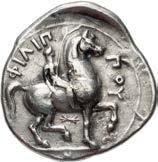
23
62 63
the Collection of a London Novelist, purchased from Sovereign Rarities, Ltd. Ex Shirley Hanbery Collection (Goldberg 96, 14 February 2017), lot 1580, purchased from Frank Kovacs, 1985 (his ticket included).
65. KINGS of MACEDON. Alexander III ‘the Great’. 336-323 BC. AR Tetradrachm (28mm, 17.21 g, 9h). Amphipolis mint. Struck under Antipater, circa 325-323/2 BC. Head of Herakles right, wearing lion skin / Zeus Aëtophoros seated left; boukranion in left field. Price 93; Troxell, Studies, Issue E8. Lovely iridescent tone, light scratches, double struck on reverse. Near EF. ($500)

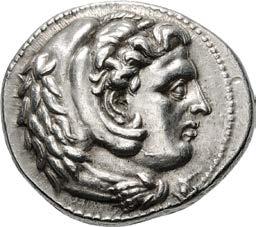
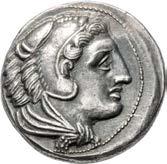
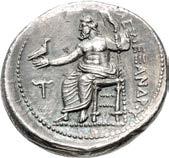
From the Don T. Hayes Collection, purchased from Nilus Coins.
From the First Gold Coinage of the Alexander Type



66. KINGS of MACEDON. Alexander III ‘the Great’. 336-323 BC. AV Stater (19mm, 8.61 g, 12h). Tarsos mint. Struck under Balakros or Menes, circa 332/1-327 BC. Helmeted head of Athena right, coiled serpent on helmet / Nike standing left, holding wreath in extended right hand and cradling stylis in left arm; wreath below right wing. Price 3456 (Sidon); Newell, Dated 1, Type A, unlisted dies (Sidon). Minor die wear. Near EF. Well centered. Very rare, only three noted by Newell, one additional in Pella, one (correctly attributed) in CoinArchives, none in ANS Photofile. ($3000)
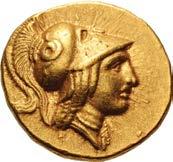
Ex Classical Numismatic Group XXXII (7 December 1994), lot 1143.
This issue was originally given to Sidon by Newell, along with seven other issues of staters (and two distaters) that lacked the mint signature and/or date that is found on nearly all other issues at Sidon. Newell later doubted the attribution, and suggested they may belong to an early mint at Damaskos (cf. G.F. Hill, “Alexander the Great and the Persian lion-gryphon,” JHS 43 [1923], p. 159). While Price retained Newell’s original attribution, he, too, remained skeptical (Price, p. 436). Le Rider, in his recent review of the coinage of Alexander the Great (Alexander the Great: Coinage, Finances, and Policy [Philadelphia, 2007]), recounted the various arguments, but also assimilated more recent research, and convincingly argues that these eight issues of gold actually were the first issues of Alexander type staters at the mint of Tarsos (Le Rider, op. cit., pp. 134–9).
The reattribution to Tarsos has a significant effect on the importance of these staters. It is generally thought that Alexander began issuing his new coinage, staters of Athena/Nike type and tetradrachms of Herakles/Zeus type, shortly after his capture of Tarsos in 333 BC. Recognizing the importance of this mint for Alexander, supported by the state of the evidence at the time, Newell originally attributed a large series of staters to the early period of Alexanders at Tarsos (E.T. Newell, “Tarsos under Alexander,” AJN 52 [1918]). Later research, however, moved nearly all of these issues to a mint in Macedon (cf. Price p. 371, and Troxell, Studies, pp. 99–110). This void of gold coinage is therefore filled with the reattribution of the eight issues from Sidon, resulting in these being not only the first issue of Alexander staters from Tarsos, but the first issues of Alexander’s new stater coinage anywhere.
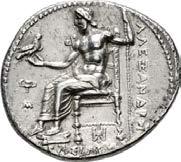

24
67. KINGS of MACEDON. Alexander III ‘the Great’. 336-323 BC. AR Tetradrachm (25mm, 17.13 g, 7h). Babylon mint. Struck under Stamenes or Archon, circa 324/3 BC. Head of Herakles right, wearing lion skin / Zeus Aëtophoros seated left; in left field, kylix above Â, P below throne. Price 3652. Lightly toned, very minor doubling. EF. ($1000)
III
323-317
AR Tetradrachm (24mm, 17.21 g, 12h). In the name and types of Alexander III. Amphipolis mint. Struck under Antipater, circa 320-319 BC. Head of Herakles right, wearing lion skin / Zeus Aëtophoros seated left; ∑ in left field. Price 121; Troxell, Studies, Group I3. Lightly toned, minor flan flaws, a few minor marks, a little off center on reverse. Near EF. ($500)







From the Don T. Hayes Collection.
323-317 BC. AV Stater (18mm, 8.57 g, 1h). In the name of Alexander III. Miletos mint. Struck under Asandros, circa 323-319 BC. Helmeted head of Athena right / Nike standing left, holding wreath and stylis; ä in left field, labrys below right wing. Price 2114; ADM I Series VII. Lustrous, some deposits on obverse. Near EF. ($3000)
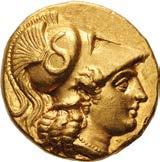
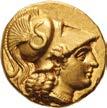
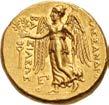

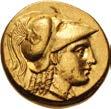

AR Tetradrachm (27.5mm, 17.20 g, 1h). In the name and types of Alexander III. Tarsos mint. Struck under Philotas or Philoxenos. Head of Herakles right, wearing lion skin / Zeus Aëtophoros seated left; in left field, crowning Nike flying right above kerykeion; 2 below throne, [s in exergue]. Price 3044; Newell, Tarsos 51, dies LX/251. Attractive deep iridescent tone, slightly off center. Near EF. High relief.
.
3045
die as
52,
O;
25
68. KINGS of MACEDON. Philip
Arrhidaios.
BC.
69. KINGS of MACEDON. Philip III Arrhidaios.
70. KINGS of MACEDON. Philip III Arrhidaios. 323-317 BC.
($500)
From the Don T. Hayes Collection, purchased from Pegasi Numismatics (inventory 10000320).
71. KINGS of MACEDON. Philip III Arrhidaios. 323-317 BC. AV Stater (17mm, 8.55 g, 9h). In the name and types of Alexander III. Tarsos mint. Struck under Philotas or Philoxenos. Helmeted head of Athena right; [Q to left] / Nike standing left, holding wreath and cradling stylis; kerykeion in left field; below left wing, 2 above Q
Price
(same obv.
illustration); Newell, Tarsos
obv. die
ANS inv. 1949.134.1 (same obv. die). Lustrous, trace deposits, minor scratch in field on reverse, minor delamination on edge. EF. ($3000)
72. KINGS of MACEDON. Philip III Arrhidaios. 323-317 BC. AR Tetradrachm (28mm, 17.08 g, 3h). In the types of Alexander III. Babylon mint. Struck under Archon, Dokimos, or Seleukos I, circa 323-318/7 BC. Head of Herakles right, wearing lion skin / Zeus Aëtophoros seated left; in left field, wheel above :; W below throne. Price P189. A few light marks. Near EF. ($1500)
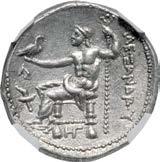






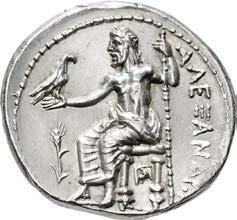
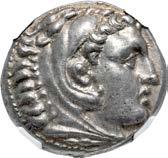
Ex Triton XIV (January 2011), lot 86.
Born circa 359 BC, Arrhidaios was the illegitimate son of Philip II, king of Macedon, by a Thessalian dancer named Philinna. According to Plutarch, a poisoning attempt by Philip’s jealous wife, Olympias, left Arrhidaios mentally compromised and subject to epileptic fits. His halfbrother, Alexander III the Great, was quite fond of him and took him on all of his campaigns, although this was also a way of making sure he did not become a political pawn. When Alexander died in Babylon in June, 323 BC, a council of generals hammered out a compromise by which Arrhidaios was crowned as Philip III, to reign jointly with the infant son of the conqueror, Alexander IV. However, neither had any real power, this being held by a succession of regents. The new king proved as compliant and simple-minded as the generals had hoped, but in 320 BC, Arrhidaios married a niece of Philip II’s, Eurydike, who had enough ambition for the both of them. Eurydike plunged into the complex and deadly politics of the Diadochi. In 317 BC, she threw her support behind Kassander’s successful bid to become regent. Kassander left her and Arrhidaios in charge of Macedon while he went on campaign in Asia. However, Alexander’s mother Olympias raised her own army and invaded Macedon, capturing and ultimately executing the royal couple. The coinage of Philip III Arrhidaios is clearly based on that of Alexander, showing no innovations except for the name.
73. KINGS of MACEDON. Antigonos I Monophthalmos. As Strategos of Asia, 320-306/5 BC, or king, 306/5-301 BC. AR Drachm (19mm, 4.23 g, 12h). In the name and types of Alexander III. Lampsakos mint. Struck circa 310-301 BC. Head of Herakles right, wearing lion skin / Zeus Aëtophoros seated left; in left field, forepart of Pegasos left; â below throne. Price 1393; ADM II Series XVIII. Underlying luster, trace deposits. Choice EF. Well struck on a broad flan. ($750)
74. KINGS of MACEDON. Kassander. As regent, 317-305 BC. AR Tetradrachm (25mm, 17.15 g, 3h). In the name and types of Alexander III. Amphipolis mint. Struck circa 316-311 BC. Head of Herakles right, wearing lion skin / Zeus Aëtophoros seated left; grain ear in left field, À below throne. Troxell, Studies, Issue L4; Price 130. Lightly toned around the devices, wtih fields showing considerable luster. Superb EF. Well struck. ($2000)
Ex DMS Collection.
75. KINGS of MACEDON. Kassander. As regent, 317-305 BC, or King, 305-298 BC. AR Tetradrachm (27mm, 17.20 g, 9h). In the name and types of Alexander III. Amphipolis mint. Struck circa 307-297 BC. Head of Herakles right, wearing lion skin / Zeus Aëtophoros seated left; in left field, ¬ above torch; £ below throne. Price 445; Ehrhardt 29. Lightly toned. In NGC encapsulation 4936335-011, graded Ch AU, Strike: 5/5, Surface: 4/5. ($1000)
26
72 73
76. KINGS of MACEDON. Kassander. As regent, 317-305 BC. AR Tetradrachm (24.5mm, 1436 g, 3h). In the name and types of Philip II. Pella mint. Struck circa 317/6-315/4 BC. Laureate head of Zeus right / Youth, holding palm frond, on horseback right; serpent below, Boeotian shield below horse’s raised foreleg. Le Rider Group III, 529 (D281/R433); SNG ANS 450 (same obv. die). Attractively toned. EF. ($1500)


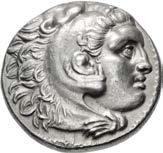

From the D.K. Collection. Ex Gemini VIII (14 April 11), lot 28; Lanz 150 (13 December 2010), lot 109.
77. KINGS of MACEDON. temp. Kassander – Antigonos II Gonatas. Circa 310-275 BC. AR Tetradrachm (27mm, 17.00 g, 12h). In the name and types of Alexander III. Uncertain mint in Greece or Macedon. Head of Herakles right, wearing lion skin / Zeus Aëtophoros seated left; in left field, head of bull left. Price 874; ANS inv. 2002.46.528 (same dies). Lightly toned, some marks, a few light scratches, small die break in reverse. Good VF. ($500)
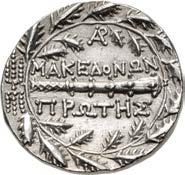
78. KINGS of MACEDON. Perseus. 179-168 BC. AR Drachm (15mm, 2.59 g, 2h). Third Macedonian War issue. Uncertain mint in Thessaly; Hermias, magistrate. Struck circa 171/0 BC. Head of Helios facing slightly right / Rose with bud to right; Erµ5Ås above, z-W flanking stem. Price, Larissa p. 241; SNG Keckman 795. Toned. EF. ($500) Ex Sigmund Collection.
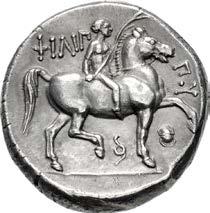
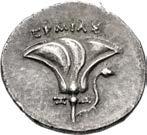

79. MACEDON (Roman Protectorate), Republican period. First Meris. Circa 167-149 BC. AR Tetradrachm (31mm, 16.97 g, 8h). Amphipolis mint. Diademed and draped bust of Artemis right, bow and quiver over shoulder, in the center of a Macedonian shield / Club right; 1 above; all within oak wreath, thunderbolt to left. Prokopov, Silver, Group III, 697 (O145/ R564); HGC 3, 1103; SNG Ashmolean 3292 (same dies). Lightly toned, slight die shift on obverse. Near EF. Nicely centered and well struck. ($750)

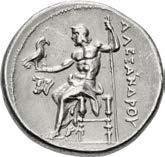


27
ΣIMO - Signed Reverse Die – Ex BCD Collection
80. THESSALY, Larissa. Circa 405/0-370 BC. AR Drachm (16mm, 5.98 g, 4h). Early facing head type. Reverse die signed by the artist Simo–. Head of the nymph Larissa facing slightly right, with hair in ampyx / Horse grazing right; small s5Âo below belly. L-S Group 4, Head Type 18, dies O58/R1; BCD Thessaly II 231 (same dies); HGC 4, 430 corr. (artist signature sometime on reverse). Lightly toned, die breaks, graffito on obverse, granular surface and light cleaning marks on reverse. VF. ($500)
Ex BCD Collection (Classical Numismatic Group 96, 14 May 2014), lot 176.
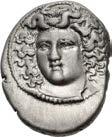


ΣIMO Signed Obverse Die
81. THESSALY, Larissa. Circa 400-370 BC. AR Drachm (20mm, 6.02 g, 4h). Obverse die signed by Simo–. Head of the nymph Larissa facing slightly right; s5Âo above / Horse grazing right. L-S Group 3, Head Type 8, dies 19/2; BCD Thessaly II 195; HGC 4, 430; Traité IV 713 and 718, pl. CCXCIX, 2, 3, and 6 (same dies). Lightly toned, a little die wear, a touch of porosity, a few minor marks. Near EF. Well centered on a broad flan. Exceptional for issue. ($2000)

82. THESSALY, Larissa. Circa 365-356 BC. AR Drachm (17mm, 6.01 g, 12h). Head of the nymph Larissa facing slightly left, with hair in ampyx / Horse standing right, preparing to lie down. Lorber, Hoard, Group L-II, 31 (same dies); BCD Thessaly II 315; HGC 4, 454 corr. (illustrations for 453 and 454 switched). Oblong flan, some granularity, a few marks. Near EF. ($750)

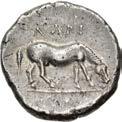
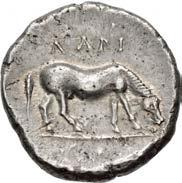
From the Grand Haven Collection.
Extremely Rare and Unpublished
83. AKARNANIA, Federal Coinage (Akarnanian Confederacy). Circa 200-197 BC. AR Stater (20mm, 6.55 g, 1h). Pegasos flying left / Helmeted head of Athena left; ∫ below chin; behind, head of Achelöos left. Imhoof-Blumer, Akarnanians –; Pegasi 2 var. (E on obv., N below chin); BCD Akarnania –; HGC 4, 719 var. (unlisted with this letter on rev.). Toned, old scratches and marks under tone. VF. Extremely rare, unpublished with this letter on reverse. ($500)
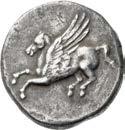



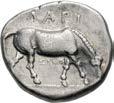
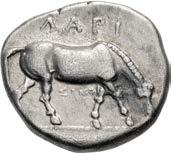
84. BOEOTIA, Thebes. Circa 379-368 BC. AR Stater (19.5mm, 12.10 g). Eugi-, magistrate. Boeotian shield / Amphora; EU-˝5 across central field; all within concave circle. Hepworth 45; BCD Boiotia 518; HGC 4, 1331. Lightly toned. VF. Well centered. ($500)
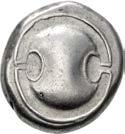
28
82 83
85. EUBOIA, Euboian League. Circa 375-357 BC. AR Stater (20.5mm, 11.03 g, 9h). Head of Euboia right / Cow couchant right; grape bunch on ivy vine above; all within incuse square. Wallace Group 2, 5–8 var. (dies IV/– [unlisted obv. die]); BCD Euboia 3 (same obv. die); HGC 4, 1412. Toned, granular surfaces, some scratches under tone on obverse, double struck on reverse. VF. Rare. ($1000)






Ex Lanz 36 (21 April 1986), lot 262.
86. ATTICA, Athens. Circa 515-510 BC. AR Obol (8.5mm, 0.60 g). “Wappenmünzen” type. Wheel with four spokes / Quadripartite incuse square, divided diagonally. Seltman pl. IV, ρ; Svoronos, Monnaies, pl. I, 54–6; HGC 4, 1654. Granular surfaces, light scuff on reverse. Good VF. ($500)
87. ATTICA, Athens. Circa 515-510 BC. AR Hemiobol (7mm, 0.30 g). “Wappenmünzen” type. Wheel of four spokes / Quadripartite incuse square, divided diagonally. Seltman pl. IV, αα; SNG Copenhagen –; SNG München 17. Toned, minor roughness. Good VF. Rare denomination. ($750)
Ex Classical Numismatic Group 93 (22 May 2013), lot 284; Property of Princeton Economics acquired by Martin Armstrong (Classical Numismatic Group Electronic Auction 271, 11 January 2012), lot 14; Leu 74 (19 October 1998), lot 182.
88. ATTICA, Athens. Circa 475-465 BC. AR Tetradrachm (23mm, 16.65 g, 7h). Helmeted head of Athena right, with frontal eye / Owl standing right, head facing, with spread tail feathers; olive sprig and crescent to left; all within incuse square. Starr Group III, unlisted rev. dies; HGC 4, 1594. Toned, a few light scratches under tone. VF. ($1500)


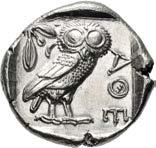
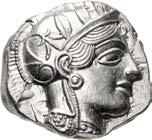
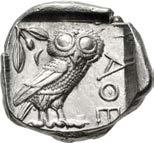



89. ATTICA, Athens. Circa 454-404 BC. AR Tetradrachm (25mm, 17.20 g, 1h). Helmeted head of Athena right, with frontal eye / Owl standing right, head facing, closed tail feathers; olive spray and crescent to left; all within incuse square.

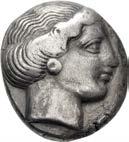
Helmeted head of
Helmeted head
with
29
Kroll 8; HGC 4, 1597. Underlying luster. Superb EF. Fine style and struck on a broad flan. ($2000)
90. ATTICA, Athens. Circa 454-404 BC. AR Tetradrachm (25mm, 17.20 g, 4h).
Athena right,
frontal eye / Owl standing right, head facing, closed tail feathers; olive spray and crescent to left; all within incuse square. Kroll 8; HGC 4, 1597. Underlying luster, slight doubling on reverse. Superb EF. Fine style and struck on a broad flan. ($2000)
86 87 88 89 90 91
91. ATTICA, Athens. Circa 454-404 BC. AR Tetradrachm (25.5mm, 17.16 g, 10h).
of Athena right, with frontal eye / Owl standing right, head facing, closed tail feathers; olive spray and crescent to left; all within incuse square. Kroll 8; HGC 4, 1597. Toned, with some iridescence, minor deposits. EF. ($2000) Ex Edward J. Waddell, Ltd., inventory 54455 (ND); Waddell 107 (26 February 2007), lot 18.
92. ATTICA, Athens. Circa 454-404 BC. AR Tetradrachm (27mm, 17.21 g, 2h). Helmeted head of Athena right, with frontal eye / Owl standing right, head facing, closed tail feathers; olive spray and crescent to left; all within incuse square. Kroll 8; HGC 4, 1597. Lightly toned, underlying luster. EF. Struck on a broad flan, showing much of the crest. ($1000)
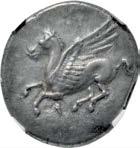
From the Collection of a London Novelist, purchased from Sovereign Rarities, Ltd.
93. ATTICA, Athens. Circa 454-404 BC. AR Tetradrachm (23mm, 17.13 g, 4h). Helmeted head of Athena right, with frontal eye / Owl standing right, head facing, closed tail feathers; olive spray and crescent to left; all within incuse square. Kroll 8; HGC 4, 1597. Toned. In NGC encapsulation 6557416-006, graded XF, Strike: 5/5, Surface: 5/5. ($750)
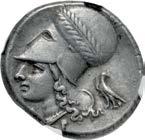
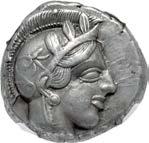
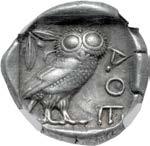

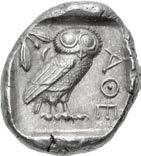
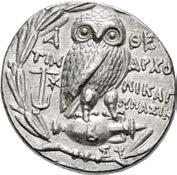
Ex Nomos 10 (18 May 2015), lot 36.
94. ATTICA, Athens. Circa 165-42 BC. AR Tetradrachm (29mm, 16.90 g, 11h). New Style coinage. Timarchos, Nikago–, and Mnasik–, magistrates. Struck 134/3 BC. Helmeted head of Athena Parthenos right / Owl standing right, head facing, on amphora; magistrates’ names in fields, anchor and star to left, ∫ on amphora, %f below; all within wreath. Thompson 361d (same obv. die); HGC 4, 1602. Bright surfaces. Near EF. ($1000)
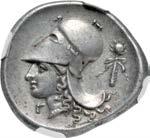
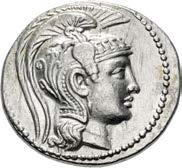
Ex Classical Numismatic Group 93 (22 May 2013), lot 293.
The reverse die used on this coin is the same as Thompson 363a, which may also be the same as 361d, but none of the examples of the latter are published.
95. CORINTHIA, Corinth. Circa 350/45-285 BC. AR Stater (21mm, 8.51 g, 12h). Pegasos flying left / Helmeted head of Athena left, helmet decorated with wreath; [Å]-r flanking point of neck; to right, eagle standing left, head right. Ravel 1008; Pegasi 426; BCD Corinth 101; HGC 4, 1848. Attractively toned. In NGC encapsulation 6290606-001, graded XF, Strike: 4/5, Surface: 4/5. ($750)

Ex Mark and Lottie Salton Collection.
96. CORINTHIA, Corinth. Circa 350/45-285 BC. AR Stater (21mm, 8.51 g, 6h). Pegasos flying left / Helmeted head of Athena left; ˝ below chin, filleted thyrsos to right. Ravel Period V, 1025; Pegasi 416; BCD Corinth 109; HGC 4, 1848. Lightly toned. In NGC encapsulation 6290625-007, graded CH XF★, Strike: 5/5, Surface: 5/5. ($1000)
Ex Mark and Lottie Salton Collection.
30
92 93 95 96
97. CORINTHIA, Corinth. Circa 350/45-285 BC. AR Stater (20mm, 8.56 g, 3h). Pegasos flying left / Helmeted head of Athena left; Å below chin, ¬ and trophy to right. Ravel Period V, 1050; Pegasi 411; BCD Corinth –; HGC 4, 1848. Toned. In NGC encapsulation 6290606-018, graded Ch XF, Strike: 4/5, Surface: 5/5. ($1000)


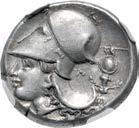

Ex Mark and Lottie Salton Collection.
98. CORINTHIA, Corinth. Circa 350/45-285 BC. AR Stater (20.5mm, 8.45 g, 11h). Pegasos flying left / Helmeted head of Athena right; to left, @ and aryballos inscribed with π. Ravel 1058; Pegasi 378 corr. (symbol); BCD Corinth 123; HGC 4, 1846. Lightly toned, light roughness on obverse, a few marks and minor double strike on reverse. Good VF. ($500)
Ex Lanz 50 (27 November 1989), lot 364.
Ex Jameson and Bement Collections – Pedigreed to 1910 – Illustrated in Seltman
99. ELIS, Olympia. 128th-132nd Olympiad. 268-252 BC. AR Stater (26mm, 11.81 g, 12h). Head of Zeus right, wearing laurel wreath; Å[r] below neck truncation / Eagle standing left; V-Å across upper field; to left, serpent coiled right. Seltman, Temple 235b (dies DE/ζπ) = Jameson 2511 = Bement 1241 (this coin, rev. illustrated in Seltman); BCD Olympia –; HGC 5, 406 (this coin illustrated). Old cabinet tone, a few old scratches under tone, slight die wear and minor doubling on reverse. Near EF. Extremely rare, and with a fantastic pedigree. ($10,000)


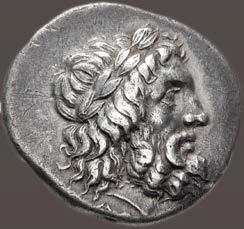


From the Eardley and Ethel Madsen Collection. Ex Robert Jameson Collection (Hess-Leu, 14 April 1954), lot 122; Clarence S. Bement Collection (Part II, Naville VII, 23 June 1924), lot 1241; J. Hirsch XXVI (24 May 1910), lot 528.
This coin was the featured cover coin for the SAN – Journal of the Society for Ancient Numismatics, vol. XXV, no. 1 (Spring 1984)
Located on the northwest corner of the Peloponnesos, the sacred shrine of Olympia became established as the site of the most important Greek festival of athletics in the eighth century BC. The first Olympic Games were held in 776 BC, consisting solely of a foot race, or stadion, won in that year by Koroibus of Elis. As time went on, more events were added, including wrestling, boxing, long jump, javelin, discus, and chariot races. The contests became so important that Greek cities at war would declare a truce for the duration. Soon a permanent complex was built to house the games, and a magnificent temple of Zeus containing a statue ranked as one of the Seven Wonders of the World was completed in 463 BC. The first coins of Olympia date to the games of 468 BC, and new types were issued at four year intervals (to coincide with the games) thereafter. Three basic types were struck, depicting a head of Zeus, Hera, or an eagle. The finest die engravers were employed in their production and coins of Olympia rank as some of the greatest masterpieces of Greek coinage. This silver stater belongs to the Zeus group and was struck in the 260s to 250s BC, for the 128th to 132nd Olympiads.

31
97 98
100. ARGOLIS, Argos. Circa 270-260/50 BC. AR Triobol – Hemidrachm (14mm, 2.59 g, 9h). Forepart of wolf at bay left; Q above / Large A; Q to upper right; below, eagle standing right on harpa right; all within incuse square. BCD Peloponnesos 1113; HGC 5, 670. Attractively toned, minor porosity. Near EF. Well centered. ($500)
101. CRETE, Gortyna. Circa 330-270 BC. AR Stater (27mm, 11.58 g, 12h). Europa seated right within tree branches, propping up her head with her left hand, right hand set on branches to left / Bull standing right, head reverted. Svoronos, Numismatique 57 (same obv. die as illustration); Le Rider, Crétoises, p. 57, 13d, pl. XII, 3 = SNG Lockett 2558 (this coin); SNG Copenhagen 440; Boutin 127; Evans –; Traeger 67. Old cabinet tone, irregular flan, overstruck on a stater of Lyttos (cf. Le Rider, Crétoises, pl. XXV, 13 for type). VF. ($3000)
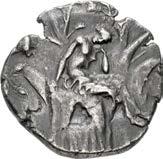

Ex Robert O. Ebert Collection (Stack’s, Bowers, and Ponterio 174, 12 January 2013), lot 5536; Gemini V (6 January 2009), lot 582 (unsold from the Ebert collection); Richard Cyril Lockett Collection (Greek Part III, 27 May 1959), lot 2031, purchased privately from Baldwins for £12.
The Labyrinth at Knossos
102. CRETE, Knossos. Circa 300-270 BC. AR Drachm (18mm, 5.27 g, 10h). Head of Hera left, wearing ornamented stephanos, triple-pendant earring, and necklace / Labyrinth; Å-r flanking, ˚@Ws5 below. Svoronos, Numismatique 70; Le Rider, Crétoises –; SNG Copenhagen –; SNG Lockett 2539–40; BMC 26–7; Boutin 155; Dewing 1987–8; Evans 1597–9; de Luynes 2334 (same dies); Traeger –. Toned, areas of weak strike, slight roughness, tiny nick on obverse, a little die wear on reverse. Good VF. ($10,000)
The ancient city of Knossos, the remains of which were excavated by Sir Arthur Evans, beginning in 1900, was founded in the Minoan Period (circa 1700-1400 BC) as a large and complex palace-city. Although the exact origin of the word labyrinth, as well as its location, remains open to scholarly conjecture, the intricate maze of rooms and interior courtyards of this palace-city contributed to the later Greek use of the word to describe a maze and the source of the events connected with it to Crete.
According to the Greek myth, Minos was the first king of Crete. Although he gave the island its first constitution, ordered the construction of the palace at Knossos, and was the first to build a navy, he was a cruel tyrant and imperialist. One of his subject cities was Athens. He demanded from its citizens as payment every nine years seven youths and seven virgins. Minos would feed them then to the Minotaur, a halfman, half-bull who was held in the Labyrinth, a large walled maze. To stop this brutal tribute, the Athenian hero, Theseus, had himself sent as part of the required tribute. With the assistance of Ariadne, the daughter of Minos, Theseus was able to navigate the Labyrinth successfully and kill the Minotaur.
103. CRETE, Polyrhenion. Circa 320-270 BC. AR Stater (25.5mm, 11.24 g, 12h). Charisthenes, magistrate. Laureate head of Zeus right / Facing head of bull, fillets hanging from horns; below, spearhead right. Svoronos, Numismatique 6 (same dies as illustration); Le Rider, Crétoises, pl. X, 11 and pl. XXXIII, 15 (same dies); SNG Copenhagen –; SNG Fitzwilliam 3986 (same dies); BMC 6 (same dies); Boutin 202 (same dies); Dewing 2083 (same dies); Evans –; Hunterian 1; Traeger –. Numerous light scratches, double struck and off center on reverse. VF. Rare, only one in CoinArchives. ($1000)

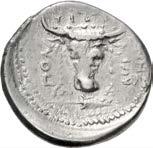
104. CIMMERIAN BOSPOROS, Pantikapaion. Circa 370-355 BC. AR Hemidrachm (14mm, 2.43 g, 2h). Head of bearded satyr facing slightly right / Lion standing right. Anokhin 1011; MacDonald 41; HGC 7, 64. Toned, granular surfaces, traces of find patina. VF. ($1000)

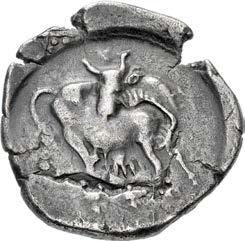


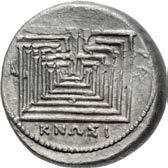
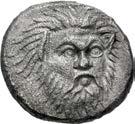


Ex Classical Numismatic Group Electronic Auction 84 (3 March 2004), lot 14.
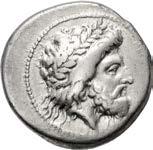
32
Ex Lockett Collection
103 104
An Exceptional and Artistic Pantikapaion Stater



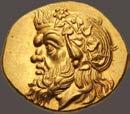



Pantikapaion was founded by Greek colonists from Miletos in the late seventh century BC. Situated on the west side of the Cimmerian Bosporos, in what is now called the Crimea, it achieved great prosperity through its exploitation of the abundant fisheries of the straits and the export of wheat from the Crimea. This wealth is attested by its splendid gold coinage, which commenced in the mid-4th century BC, and by the magnificently furnished rock tombs of its principal citizens in the same period. Later, it was to become a regional capital of the kingdom of Mithradates VI of Pontos (120-63 BC) and later still the seat of the kings of Bosporos (first century BC – fourth century AD). The coinage of Pantikapaion seems to have commenced with silver issues in the latter part of the fifth century BC, but it is for its beautiful gold staters that the mint is chiefly noted. They depict the head of the god Pan (a pun on the name of the city) and on the reverse, the griffin that Herodotos describes as being the guardian of the remote sources of gold.
106. No Lot.
Apparently Unique
of the same year. Dark green patina, flan crack, a few tiny pits. Good VF. Apparently unique. ($500)
88-86 BC. Diademed head of the deified Alexander right, with horn of Ammon / Athena Nikephoros seated left; d5 to inner left, 5% on throne; in exergue, ornate trident left. Callataÿ
From the S & S Collection. Ex CNG inventory 714408 (July 1999).

33
105. CIMMERIAN BOSPOROS, Pantikapaion. Circa 340-325 BC. AV Stater (20.5mm, 9.12 g, 11h). Head of Pan left, wearing ivy wreath / Griffin, holding spear in its mouth, standing left, head facing, forepaw raised, on grain ear; ∏-Å-@ around. Frolova, Catalogue, Group IV, dies Б/в; Anokhin 1021; MacDonald 54; HGC 7, 20; SNG BM Black Sea 864 (same obv. die); Berlin obj. no. 18203030 (same dies); CNG 100, lot 1401 (same dies). Lustrous. In NGC encapsulation 6558117001, graded MS, Strike: 5/5, Surface: 4/5, Fine Style. Well struck from fresh dies, exhibiting sharp details. ($75,000)
107. PONTOS, Kamos. Mid-late 1st century BC. Æ (19mm, 4.17 g, 11h). Dated year 258 of an uncertain era. Laureate head of Apollo right / Stag grazing left; ˚ÅÂo˙-@o@ above and to left in exergue, Ř below, ˙@[%] (date) to right in exergue. Unpublished, but cf. HGC 7, 276–7 for other bronzes of Kamos
108. KINGS of PONTOS. Mithradates VI Eupator. Circa 120-63 BC. AV Stater (18mm, 8.35 g, 12h). First Mithradatic War issue. In the name and types of Lysimachos of Thrace. Istros mint. Struck circa
p. 139, dies D1/R1; AMNG I 482; HGC 3, 1799. Underlying luster, slight doubling, a little die wear. EF. ($1500)
109. BITHYNIA, Kalchedon. Circa 260-220 BC. AR Tetradrachm (29mm, 16.91 g, 12h). In the name and types of Alexander III. Head of Herakles right, wearing lion skin / Zeus Aëtophoros seated left; A in left field, Q below throne; grain ear in exergue. Price 936 (Callatis); Türkoğlu –; HGC 7, 521. Iridescent tone, a little die wear on obverse, slight doubling on reverse. EF. ($1000)

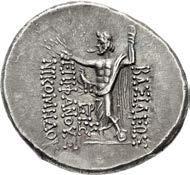
From the D.K. Collection. Ex Goldberg 55 (29 October 2009), lot 36.
110. KINGS of BITHYNIA. Nikomedes IV Philopator. 94-74 BC. AR Tetradrachm (31.5mm, 16.24 g, 12h). Nikomedeia mint. Dated 208 BE (91/0 BC). Diademed head right / Zeus Stephanophoros standing left; to inner left, eagle standing left on thunderbolt above Ś above ˙% (date). Callataÿ p. 63, dies D203/R8 (unlisted die combination); RG 40; HGC 6, 646; DCA 445; Jameson 1390 (same obv. die). Iridescent tone, underlying luster, minor die wear on obverse. Near EF. ($500)
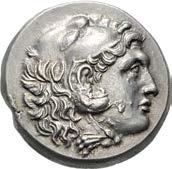
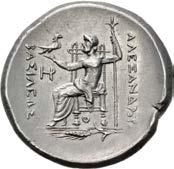
The Electrum Issues of Kyzikos
The celebrated electrum coinage of Kyzikos began in the first half of the sixth century BC, and from the beginning the coinage was notable for the variety and inventiveness of its designs. These staters and fractions were regarded as gold coins and circulated throughout a large area along with the gold darics of the Persian Empire. On all of the coins of Kyzikos, large or small, was engraved the tunny-fish (θυννος), which constituted an important product in the Kyzikene economy.
Extremely Rare Hekte
111. MYSIA, Kyzikos. Circa 600-550 BC. EL Hekte – Sixth Stater (10mm, 2.70 g). Head of tunny left, with tunny upward in its mouth / Quadripartite incuse square. Cf. Hurter & Liewald 24.1 (hemihekte); Von Fritze I –; Boston MFA –; SNG BN –; Numismatik Naumann 71, lot 138; Obolos 5, lot 294 = Helios 2, lot 140; Pecunem 39, lot 269. Good VF. Well centered. Extremely rare as a hekte, apparently the fourth, and finest, known. ($750)
This intriguing electrum hekte depicting two tunnies, one in the mouth of another, is among the earliest struck.
112. MYSIA, Kyzikos. Circa 550-450 BC. EL Hemihekte (9.5mm, 1.32 g). Bull standing left on tunny left / Quadripartite incuse square. Cf. Von Fritze I 88 (unlisted denomination); cf. Boston MFA 1466 = Warren 1544 (stater); cf. SNG BN 222–3 (stater); Hurter & Liewald II –. Toned, traces of find patina, light scratches on obverse. Good VF. Extremely rare, and unpublished, as a hemihekte; none in CoinArchives. ($750)








34
109 110
Ex Sheik Saud Al Thani and Prospero Collections
113. MYSIA, Kyzikos. Circa 550-450 BC. EL Stater (18mm, 15.93 g). Nude youth kneeling left, holding tunny in each hand / Quadripartite incuse square. Von Fritze I 70; Boston MFA 1478 = Warren 1505; SNG BN –. Edge split, scrape on obverse. Good VF. ($2500)





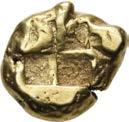

Ex Sheikh Saud Al-Thani Collection (Part IV, Numismatica Ars Classica 126, 17 November 2021), lot 198; Prospero Collection (New York Sale XXVII, 4 January 2012), lot 440, purchased from G. Müller, June 1988; Peus 321 (27 April 1988), lot 286.
114. MYSIA, Kyzikos. Circa 450-330 BC. EL Hekte – Sixth Stater (10mm, 2.63 g). Kekrops left, holding branch; below, tunny left / Quadripartite incuse square. Von Fritze I 158; cf. Boston MFA 1499 = Warren 1450 (stater); SNG BN 306. A little off center. VF. ($500)
Very Rare Cavalryman Type
115. MYSIA, Kyzikos. Circa 450-330 BC. EL Stater (17mm, 15.84 g). Thessalian cavalryman, wearing kausia, on horse rearing right; below, tunny right / Quadripartite incuse square. Von Fritze I 168; Boston MFA –; SNG BN 315. Lightly toned. Near VF. Well centered. Very rare. ($4000)


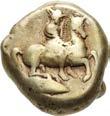
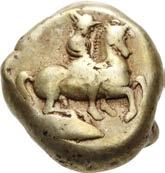
Ex Numismatik Naumann 113 (6 February 2022), lot 367 (hammer €4500).
This very rare type has been hypothesized to depict the mythological ancient Thessalian founders of Kyzikos. The horseman appears to be wearing the petasos and chlamys, commonly worn by Thessalian cavalrymen during antiquity. There is also conjecture that the issue depicts Philip II of Macedon. Philip had been declared the head of the Thessalian League and before his death had begun an invasion of Asia Minor ostensibly to free the Greek cities there from Persian rule. Many Greek cities in Asia Minor revolted, this issue may coincide with that revolt
Ex Roma XXIII (24 March 2022), lot 290; Roma XXII
35
and depict Kyzikene support for Philip’s campaign.
116. MYSIA, Kyzikos. Circa 450-330 BC. EL Stater (17.5mm, 15.94 g). Bridled horse standing right, being restrained by male standing right, in background, who holds bridle with his right hand; below, tunny right / Quadripartite incuse square. Von Fritze I 213; Greenwell, Some 2; Boston MFA 1556–7; SNG BN –; BMC –; FSD SHM 1229 = Hermitage (Exhibition) 118; Gulbenkian 666 (same dies); Jameson 2211. Light scratches in field on obverse. VF. Well centered. Extremely rare, one of only two in CoinArchives (the other: Triton XXIV, lot 643 [hammer $15,000] = Triton XXII, lot 235). ($5000)
(7 October 2021), lot 334.
117. MYSIA, Kyzikos. Circa 450-330 BC. EL Myshemihekte – Twenty-fourth Stater (7mm, 0.67 g). Bearded male, nude but for petasos and cloak tied at neck, crouching left on the back of a sacrificial ram lying left, holding its head up with his left hand, exposing its neck that he prepares to strike with a knife held above in his right hand / Quadripartite incuse square. Cf. Von Fritze I 156 (unlisted denomination); Boston MFA –; BN –. Minor marks, die rust on obverse. VF. Extremely rare, Hurter & Liewald record a single example in a private collection; only one in CoinArchives (Roma XIX, lot 514). ($500)


The identification of the male on the obverse has long been debated. M. F. Lenormant first suggested Phrixos sacrificing the ram with the golden fleece, but Greenwell preferred Odysseus slaying the animal Circe provided him before his descent into Hades, in part due to the figure being bearded, which indicated an older individual, which contrasts with the youthful portraits traditionally given to Phrixos.
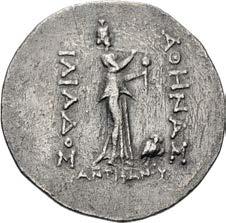
118. MYSIA, Pergamon. Circa 166-67 BC. AR Tetradrachm (28.5mm, 12.68 g, 12h). Cistophoric standard. Struck circa 123-104 BC. Cista mystica within ivy wreath / Two serpents entwined around bow and bowcase; ¯ above, E (civic monogram) to left, serpent-entwined thyrsos to right. Kleiner, Hoard 7; Pinder 101; SNG BN –. Lightly toned. Good VF. ($300)

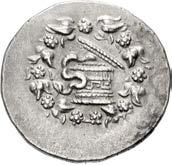
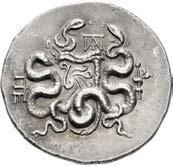

119. TROAS, Ilion. Circa 185-50 BC. AR Tetradrachm (37.5mm, 15.43 g, 12h). Antiphanes, president of the aonothetai Helmeted head of Athena right / The Palladion: Athena Ilias standing right, holding distaff and filleted spear; to inner right, owl standing left, head facing. Ellis-Evans dies O2/R– (unlisted rev. die); Bellinger T37 (same obv. die as illustration); SNG Ashmolean 1159 = SNG Lockett 2738 = Pozzi 2275 (same obv. die); Gulbenkian 962 = Jameson 2231 (same obv. die). Toned, light roughness, numerous scratches. Near VF. Very rare, only three examples of this issue noted by Ellis-Evans, all in museum collections; one in CoinArchives. ($750)
120. AEOLIS, Aigai. Circa 151-143 BC. AR Tetradrachm (34.5mm, 16.69 g, 12h). Stephanophoric type. Wreathed head of Apollo Smintheos right, bow and quiver over shoulder / Zeus standing left, holding eagle and scepter; U to left; all within oak wreath. SNG Ashmolean 1252 (same obv. die); SNG von Aulock 1594 (same obv. die); SNG Copenhagen 6. Lightly toned, a little die wear and minor double strike on obverse. Good VF. ($1000) Ex Lanz 22 (10 May 1982), lot 349.



121. AEOLIS, Kyme. Circa 151/0-143/2 BC. AR Tetradrachm (34.5mm, 16.87 g, 11h). Stephanophoric type. Herakleides, magistrate. Struck circa 151/0 BC. Head of the Amazon Kyme right, wearing tainia / Horse prancing right; below raised foreleg, eagle standing right on thunderbolt; all within laurel wreath. E-E&E-Ö, Phase I, 5; Oakley dies 65/b; SNG Copenhagen 105. Iridescent tone, minor die shift on obverse, light scratch under tone at edge on reverse. Near EF. ($2000)
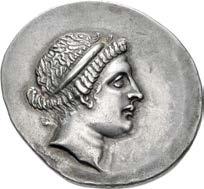
36
118 119 120 121
122. AEOLIS, Myrina. Circa 155-143 BC. AR Tetradrachm (32mm, 16.52 g, 12h). Stephanophoric type. Laureate head of Apollo right / Apollo Grynios standing right, holding branch and phiale; Ĉ to left, omphalos and amphora at feet; all within laurel wreath. Sacks Issue 22, obv. die 19; SNG Salting 32 (same obv. die). Toned. In NGC encapsulation 5770046-002, graded Ch AU, Strike: 5/5, Surface: 2/5, brushed. ($1000)
123. AEOLIS, Myrina. Circa 155-143 BC. AR Tetradrachm (34mm, 16.21 g, 1h). Stephanophoric type. Laureate head of Apollo right / Apollo Grynios standing right, holding branch and phiale; Ş to left, omphalos and amphora at feet; all within laurel wreath. Sacks Issue 24, obv. die 32; Hermitage Sale II 1212; de Luynes 2532. Light scratches on obverse, light scrapes on reverse. VF. ($750)
Ex Classical Numismatic Group Electronic Auction 101 (10 November 2004), lot 37.
124. AEOLIS, Myrina. Circa 155-143 BC. AR Tetradrachm (32.5mm, 16.72 g, 12h). Stephanophoric type. Laureate head of Apollo right / Apollo Grynios standing right, holding phiale and laurel branch; E to left, omphalos and amphora at feet; all within laurel wreath. Sacks Issue 25, obv. die 39. Iridescent tone, minor porosity, some die wear. Near EF. ($750)
125. AEOLIS, Myrina. Circa 155-143 BC. AR Tetradrachm (33mm, 16.42 g, 11h). Stephanophoric type. Laureate head of Apollo right / Apollo Grynios standing right, holding phiale and laurel branch; Ã to left, omphalos and amphora at feet; all within laurel wreath. Sacks Issue 34, obv. die 59 (unlisted for issue). Light golden tone, underlying luster, die breaks on reverse. EF. Very rare issue, only two examples recorded by Sacks, five in CoinArchives. ($750)


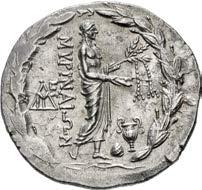
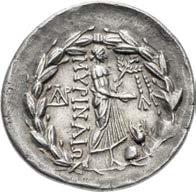
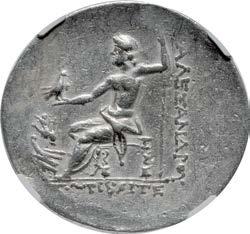
Extremely Rare Methymna Tetradrachm

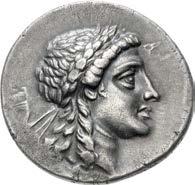
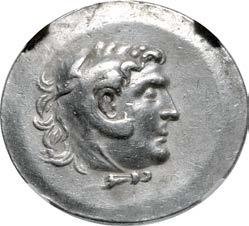
126. LESBOS, Methymna. Circa 188-180 BC. AR Tetradrachm (39mm, 16.59 g, 12h). In the name and types of Alexander III of Macedon. Head of Herakles right, wearing lion skin / Zeus Aëtophoros seated left; in left field, Arion, holding kithara, on dolphin right above prow left; in exergue, [...]Wt5 and ÅrtE flanking vertical kerykeion. Price 1695A corr. (legend on left in exergue); HGC 6, 910. In NGC encapsulation 4284684-003, graded Ch VF, Strike: 5/5, Surface: 4/5. Extremely rare, only one example published: the Giessener Münzhandlung 52, lot 192 coin cited by Price (struck from the same obverse die as the present coin); none in Pella, the ANS photofile, nor CoinArchives. ($500)
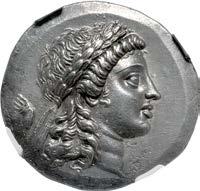
From the D.K. Collection.

37
124 125 122 123
Unpublished Mytilene Tetradrachm
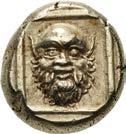




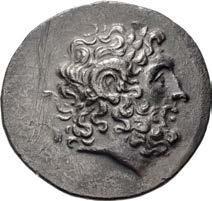
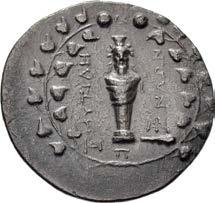

The reverse of this extremely rare type of tetradrachm from Mytilene displays a xoanon, or wooden figure, of Dionysos. Dionysos was extremely important on Lesbos where a number of mysteries associated with him took place. The images of Athena and Dionysos first appear on the earliest electrum issues of Mytilene. The terminus, or xoanon, of Dionysos on the prow has also long been associated with the coinage of Mytilene, appearing on its bronze issues. According to Pausanias (10.19.3), an unusual olive-wood “head of unusual features” was caught up in the nets of some Methymnian fishermen off the coast of Lesbos. Although they threw the head back into the sea, they nevertheless picked it up in their nets again and again. Finally, the Methymnians travelled to Delphi to ask the Pythia for assistance on what they should do. She responded, “worship Dionysos Phallen.” Subsequently, a cult was established on Lesbos, including a festival in which the object was paraded through the streets of Mytilene. Likewise, the city of Krounoi in Moesia was renamed Dionysopolis in Moesia when a similarly unusuallyshaped piece of wood was recovered from the sea near there.


38
127. LESBOS, Mytilene. Circa 521-478 BC. EL Hekte (10.5mm, 2.43 g, 4h). Gorgoneion / Incuse head of Herakles right, wearing lion skin headdress; rectangular punch to left. Bodenstedt Em. 19.1, HGC 6, 944. Some marks, die rust and tiny deposit on obverse. VF. ($750)
128. LESBOS, Mytilene. Circa 377-326 BC. EL Hekte – Sixth Stater (9.5mm, 2.57 g, 12h). Wreathed head of Dionysos right / Head of satyr facing, with no hair, in linear square within incuse square. Bodenstedt Em. 90; HGC 6, 1016 corr. (symbols sometimes on rev.). A little off center on obverse. Good VF. ($750)
129. LESBOS, Mytilene. Circa 160s BC. AR Tetradrachm (35mm, 14.32 g, 1h). Bearded head of Zeus-Ammon right, wearing laurel wreath / Facing xoanon of bearded Dionysos facing, wearing polos; ÂUt5¬˙-@ÅW@ flanking, M to lower right, q and club to lower left, ∏ below; all within wreath of ivy. Cf. EHC 650 and CH VIII, pl. LXIV, 2 (for type); otherwise, unpublished in the standard references. Find patina, fine cleaning scratches in field on obverse. VF. Extremely rare. ($4000)
130.
Circa 145-140 BC. AR Tetradrachm (30.5mm, 15.34 g, 12h). Stephanophoric type. Wreathed head of Demeter right / Two Kabeiroi, nude but for cloak tied at their necks, standing facing, each wearing laurel wreath and holding staff; QEW@ kÅ∫E5rW@ at sides, sUr5W@ below, “ to lower right; all within wreath. Nicolet-Pierre & Amandry pl. 2, 13–8 var. (unlisted dies; Syros); HGC 6, (Syros). Toned, some find patina, porous, cleaning scratches and marks. Near VF. Very rare. ($2000)
This issue had long been attributed to the island of Syros based on the reverse legend. Recent scholarship, however, has convincingly shown that this attribution is erroneous, as the reverse legend does not contain an ethnic, but names the type: the Divine Syrian Kabeiroi. As the issue has long been linked to a rare portrait emission of Eumenes I with the same reverse type, it is clear that it must belong to a mint in the sphere of the kings of Pergamon. Although it is tempting to attribute it to the royal mint at Pergamon, this Attic-standard issue could have been struck at one of several mints under Attalid control. See A. Meadows, “The Closed Currency System of the Attalid Kingdom” in P. Thonemann, Attalid Asia Minor (Oxford, 2013), pp. 184–91 for the most current analysis of this intriguing coinage.
131. IONIA, Ephesos. Phanes. Circa 625-600 BC. EL Myshemihekte – Twenty-fourth Stater (6mm, 0.57 g). Forepart of stag right, head reverted / Abstract geometric pattern within incuse square. Fischer-Bossert, Phanes 42 (O24/R40T); SNG von Aulock 7773. Light scrape and a few hairlines on obverse. Good VF. ($750)
From the W. Hansen Collection, purchased from Calgary Coin Gallery, 30 September 2015. Ex George La Borde Collection; Philip Jones Collection.
132. IONIA, Ephesos. Circa 390-325 BC. AR Tetradrachm (23mm, 15.17 g, 12h). Eochoros, magistrate. Class G, circa 350-340 BC. Bee with straight wings / Forepart of stag right, head left; palm tree to left. Karwiese II, Series 11.1, 325, dies O124/R2; BMC 40 (same obv. die). Lightly toned, edge split, minor flan flaws, some die wear on obverse. VF. ($1500)
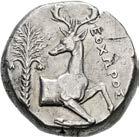


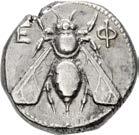
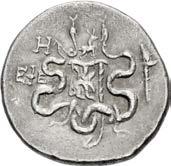
133. IONIA, Ephesos. Circa 180-67 BC. AR Tetradrachm (29mm, 12.54 g, 12h). Cistophoric type. Dated RY 20 of Attalos II of Pergamon (140/39 BC). Cista mystica with serpent within ivy wreath / Two serpents entwined around bow and bowcase; above, stag standing right; ˚ (date) to upper left; to right, draped bust of Artemis right, wearing stephanos, quiver over shoulder. Kleiner & Noe Series 33, unlisted obv. die; DCA 317. Lightly toned. Good VF. Rare date. ($300)
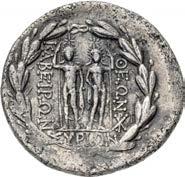
134. IONIA, Ephesos. Circa 180-67 BC. AR Tetradrachm (28mm, 12.62 g, 12h). Cistophoric type. Dated CY 8 (127/6 BC). Cista mystica with serpent within ivy wreath / Two serpents entwined around bow and bowcase; above, stag standing right; ˙ (date) to upper left, lit torch to right. Kleiner, Dated 12; DCA 325. Lightly toned, slight die wear. Good VF. ($300)



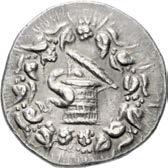


39
WESTERN ASIA MINOR, Uncertain.
From the Don T. Hayes Collection, purchased from Nilus Coins.
133 134
135. IONIA, Ephesos. Circa 133-88 BC. AV Stater (20mm, 8.47 g, 12h). Draped bust of Artemis right, hair drawn together and tied in the back, wearing stephanos and single-pendant earring, bow and quiver over shoulder / Cult statue of Artemis of Ephesos facing, arms outstretched horizontally at sides, fillet hanging from each; E-f flanking its head; torch to inner right. Jenkins, Hellenistic, pl. B, 6 = BM 1896,0601.67 = Montagu I 567 (same dies); Head p. 69, 2–6 var. (control mark); Gulbenkian 985 var. (same); CNG 120, lot 336 = CNG E-460, lot 242 = Heritage 3056, lot 30064 (same dies); Münzen und Medaillen AG 41, lot 191 (same dies). Minor marks. Near EF. Rare. ($4000)


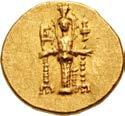

136. IONIA, Miletos. Circa 600-546 BC. EL Stater (20.5mm, 13.78 g). Lion reclining left, head reverted, within rectangular frame divided into smaller rectangular compartments / Central oblong punch, containing a geometric pattern and a quadruped standing left, divided by two lines, flanked by two square punches containing, respectively, a stellate pattern and a geometric design. Hilbert Phase 1, S16 (dies A8/X-F6-Q14r); SNG Kayhan 441; SNG München 701. Lightly toned, irregular flan, light scratches. Near VF. ($2000)

Ex Heritage 3098 (18 January 2022), lot 33133.
137. IONIA, Miletos. Circa 210-190/70 BC. AR Tetradrachm (31mm, 17.02 g, 1h). In the name and types of Alexander III of Macedon. Head of Herakles right, wearing lion skin / Zeus Aëtophoros seated left; in left field, lion standing left, head right, above m (civic monogram); Ō below throne. Marcellesi 43; Price 2168. Light iridescent tone, minor marks, slightly off center. Good VF. ($300)
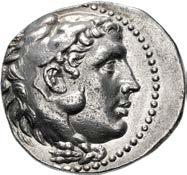
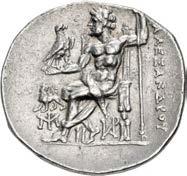
From the Don T. Hayes Collection.
Unique Year 6 Cistophoric Tetradrachm
138. IONIA, Smyrna. Late 2nd-early 1st centuries BC. AR Tetradrachm (27mm, 12.57 g, 6h). Cistophoric standard. Dated CY 6 (96/5 BC [?]). Cista mystica, from which serpent emerges, within ivy wreath / Two serpents entwined around bow and bowcase; Š above, 4 (date) to upper right, ZÂUr to left; to right, turreted head of Tyche right. Unpublished. Lightly toned, traces of find patina, a few light marks, a couple spots of roughness on obverse. Good VF. Unique example dated to year 6 at Smyrna. ($750)
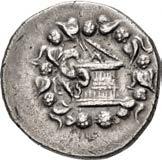
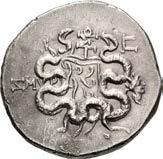
See Carbone, pp. 188–9, for a discussion of the dating of the cistophoric issues at Smyrna.

40
139. IONIA, Uncertain. Circa 650-600 BC. EL Myshemihekte – Twenty-fourth Stater (7mm, 0.85 g). LydoMilesian standard. Flattened striated surface / Incuse square. Weidauer Group II, –; Artemision 4; SNG Kayhan 682. Good VF. ($750)


Ex JTB Collection (Triton XV, 3 January 2012), lot 1233.
140. IONIA, Uncertain. Circa 625-600 BC. EL Trite – Third Stater (12mm, 4.64 g). Lydo-Milesian standard. Geometric figure resembling a star, composed of a cross centered upon a polygon of eight sides / Rectangular incuse divided horizontally and vertically into four compartments by two perpendicular lines; the upper two compartments divided into halves by a single line, the upper halves each containing a pellet, the lower halves bisected by two small vertical lines; the lower two compartments divided into thirds by two parallel lines. McFadden 1; Konuk & Lorber fig. 14; Elektron I 16; Rosen Sale 12; Traité –; Zhuyuetang 2; SNG von Aulock –; SNG Copenhagen (Cyprus, etc.), pl. 10, 318; SNG Kayhan 697. Near EF. ($3000)


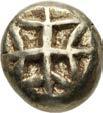


From the W. Hansen Collection, purchased from Calgary Coin Company, 10 July 2015. Ex George La Borde Collection. Reportedly ex Jonathan K. Kern inventory.
141. IONIA, Uncertain. Circa 625-600 BC. EL Forty-eighth or Ninety-sixth Stater (5.5mm, 0.21 g). Uncertain standard. Spiral pattern / Quadripartite incuse square. Roma E-86, lot 484; otherwise, unpublished in the standard references (the citation of SNG von Aulock 7801 in Roma is erroneous; the coin is silver and does not have a spiral design). VF. Extremely rare. ($750)

142.
Uncertain. Circa 600-550 BC. EL Trite – Third Stater (14mm, 4.71 g). Lydo-Milesian standard. Forepart of ram left; uncertain symbol (or die break?) to right / Two incuse squares with geometric patterns. Weidauer 48–9; Traité I 32; Elektron –; Rosen –; SNG Kayhan –; SNG von Aulock –; Boston MFA 1758. A little off center on obverse, a few tiny marks, small scrape at edge on obverse. Good VF. Very rare. ($3000)



Ex Classical Numismatic Group 96 (14 May 2014), lot 479; Numismatica Ars Classica 72 (16 May 2013), lot 368.


143. IONIA, Uncertain. Circa 600-550 BC. EL Hekte – Sixth Stater (10.5mm, 2.34 g). Lydo-Milesian standard. Forepart of bridled horse left / Irregular incuse. Nomos Obolos 22, lot 357; Nomos Obolos 8, lot 538; otherwise, unpublished in the standard references. Slight roughness, minor double strike on obverse. Near EF. Extremely rare. ($500)
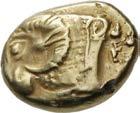

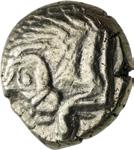
41
IONIA,
144. IONIA, Uncertain. Circa 600-550 BC. EL Twenty-fourth Stater (5mm, 0.59 g, 12h). Lydo-Milesian standard. Palmette motif / Incuse square. Weidauer –; Traité –; Elektron I 33; SNG Kayhan 1531. In NGC encapsulation 5872643-034, graded XF, Strike 5/5, Surface 5/5. ($500)



145. ISLANDS off IONIA, Chios. Circa 435-425 BC. AR Didrachm (15mm, 7.83 g). Sphinx seated left; to left, grape bunch on vine with leaves above amphora / Quadripartite incuse square. Mavrogordato 26; HGC 6, 1121. Toned, slightly granular, a few marks on edge. VF. Rare. ($750)
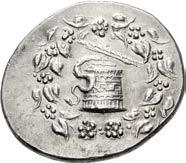
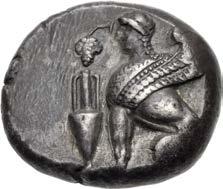
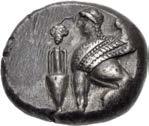
Ex The Numismatic Auction I (13 December 1982), lot 114.
146. ISLANDS off IONIA, Chios. Circa 380-350 BC. AR Tetradrachm (23mm, 15.22 g, 5h). Sokrates, magistrate. Sphinx seated left; to left, grape bunch above amphora; all on shallow convex surface / Quadripartite incuse square, with striated quarters and thick bands; sW˚rÅt˙s on horizontal band. Cf. Mavrogordato 49 (unlisted magistrate); Pixodarus 30 (this coin); HGC 6, 1116. Old collection toning. VF. ($5000)

Ex Vineyard Collection; Lanz 106 (26 November 2001), lot 134; Müller 71 (26 June 1992), lot 237; Burgan (23 December 1991), lot 18; Giessener Münzhandlung 55 (14 May 1991), lot 298; Rauch 45 (29 October 1990), lot 93; Münz Zentrum 67 (7 November 1989), lot 1466; Elsen FPL 55 (May 1983), no. 45; Elsen FPL 46 (July/August 1982), no. 48; Giessener Münzhandlung 16 (20 March 1980), lot 389.
New Date
147. LYDIA, Sardes. Circa 166-67 BC. AR Tetradrachm (31mm, 12.44 g, 12h). Cistophoric type. Dated CY 17 (118/7 BC). Cista mystica with serpent within ivy wreath / Two serpents entwined around bow and bowcase; Ŝ above, 5Z (date) to upper left; to right, lion standing right, head facing, holding spear in its jaws. Hochard –; Kurth –; SNG Copenhagen –; DCA 351 var. (unlisted date). Lightly toned, traces of find patina, slight doubling and minor porosity on reverse. Near EF. Apparently unique and unpublished with this date; none in CoinArchives. ($300)
148. LYDIA, Tralleis. Circa 166-67 BC. AR Tetradrachm (31mm, 12.60 g, 12h). Cistophoric type. Struck circa 155-145 BC. Cista mystica with serpent within ivy wreath / Two serpents entwined around bow and bowcase; filleted thrysos to right. Kleiner & Noe Series 18, unlisted dies; Kurth S415; Carbone –; SNG Copenhagen –. Lightly toned. Near EF. Very rare, none in CoinArchives. ($300)


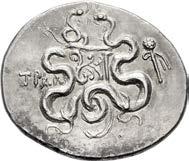


42
149. LYDIA, Tralleis. Circa 166-67 BC. AR Tetradrachm (25.5mm, 12.56 g, 11h). Cistophoric type. Struck circa 155145 BC. Cista mystica with serpent within ivy wreath / Two serpents entwined around bow and bowcase; helmet to right. Kleiner & Noe –; Kurth –; Carbone –; SNG Copenhagen –. Lightly toned. Near EF. Apparently unique and unpublished issue with helmet as sole control mark; none in CoinArchives. ($300)
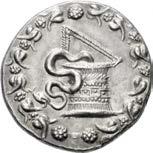
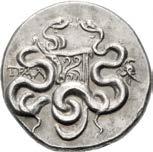



150. KINGS of LYDIA. temp. Ardys – Alyattes. Circa 630s-564/53 BC. EL Forty-eighth Stater (5mm, 0.30 g). LydoMilesian standard. Sardes mint. Head of boar right / Incuse square. Cf. Weidauer Group XIII, 55 (trite); cf. Spier 6 = Rosen 282 (twenty-fourth stater); Kurth G14; cf. SNG Kayhan 1011 (twelfth stater); CNG 72, lot 792. A little off center. VF. Very rare in this denomination. ($400)

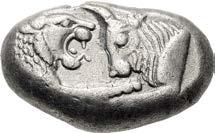



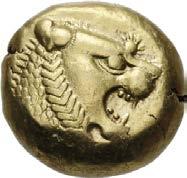
Circa 620/10-550/39 BC. EL Trite – Third Stater (12mm, 4.73 g). Lydo-Milesian

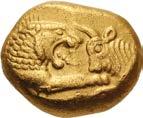


43 Unpublished Issue
151. KINGS of LYDIA. temp. Alyattes – Kroisos.
standard. Sardes mint. Head of roaring lion right; sun with multiple rays on forehead / Two incuse squares. Weidauer Group XVI, 89; Kurth G26; SNG Ashmolean 749–51. Minor edge splits. Good VF. ($1500)
152. KINGS of LYDIA. Kroisos. Circa 564/53-550/39 BC. AV Stater (19.5mm, 8.04 g). Light standard. Sardes mint. Confronted foreparts of lion and bull / Two incuse squares. Berk 3; Kurth G51; Le Rider, Naissance, pl. V, 8; Traité I 401–3; SNG von Aulock 2875; BMC 31; Boston MFA 2073; Gulbenkian 757. A few tiny marks. Good VF. ($7500)
153. KINGS of LYDIA. Kroisos. Circa 564/53-550/39 BC. AR Stater (22.5mm, 10.61 g). Sardes mint. Confronted foreparts of lion and bull / Two incuse squares. Berk 20; Kurth S1; Traité I 407–8; SNG Ashmolean 760. Lightly toned, typical light granularity. Good VF. ($2000)
The Coinage of Antioch ad Maeandrum
The Carian city of Antioch, located near the eastern end of the Maeander valley, was founded on the south bank of the river Maeander, where the river is joined by a major tributary, the Morsynos River, flowing north from Aphrodisias. It was a Hellenistic settlement that was founded by Antiochos I Soter (though some argument has been advanced in favor of Antiochos III), and likely through a synoecism of two villages, Symmaithos and Kranaos (Pliny, NH 5.108). The location was a significant crossing point of the Common Road over the Maeander, between the important cities of Tralles, to the west, and Laodikeia on the Lykon, to the east. Given its important location, surprisingly little is known today about Antioch in the Hellenistic period; there is little mention of the city in contemporary literature and epigraphy, and the site remains unexcavated. In contrast, the city took on a much more important role in the Roman period, when it was fortified, and figured significantly in many emperors’ eastern campaigns.
Its strategic location along a major trade route certainly must have enriched the city, which grew to a considerable size by the first century AD, spanning both sides of the Maeander (cf. Strabo 13.4.15). While the Roman provincial coinage at Antioch is quite sizable, the Hellenistic civic coinage is quite rare. All the civic issues date from the 2nd-1st centuries BC, and primarily consists of bronze coins, with very rare issues of silver tetradrachms and drachms. The types are fairly consistent across all denominations, with the obverse featuring the portrait of either Zeus, Apollo, Dionysos, or Artemis, while the reverse featuring a zebu bull or an eagle standing on a thunderbolt. Interestingly, some of the coins bear the name of a magistrate, while others do not.
The silver has traditionally been dated to the 2nd century BC, and may have begun with a couple of rare issues of Alexander type tetradrachms that M.J. Price (following H. Seyrig) tentatively placed there, circa 190-180 BC, but it is more likely that these Alexanders are actually issues of Tabai (cf. Price p. 311 and Thonemann p. 52). No Seleukid issues are currently attributed to Antioch, but there are many western issues that are unattributed from the reigns of Antiochos I through Antiochos III, so it is possible that some of these issues may actually belong to this city. Thonemann’s recent study of the city’s Hellenistic silver coinage convincingly places it in the early-mid 1st century BC. He notes that Antioch was one of many cities in their region that began striking silver around the same time, and some of those cities struck dated issues that firmly places them in this period. Thoneman also concludes that the silver issues may have been struck during the Mithradatic Wars, possibly for the Roman forces in the region to counter the Pontic threat. In fact, the weight standard of the Antioch silver, with a drachm at c. 3.90-3.96 grams, is compatible with the contemporary Roman denarius. Thonemann also notes that it is possible that Antioch may have received the status of a civitas libera from Sulla for services the city performed for Rome in the early 80s BC. In any case, the silver coinage of Antioch appears to Thonemann to be a “surrogate” Roman coinage, struck for military purposes. Unfortunately, there is still too little evidence to firmly anchor the dating of the coinage to any particular event(s), though it is clear that the coinage probably endured until the end of the Mithradatic Wars in 63 BC, if not shortly thereafter.


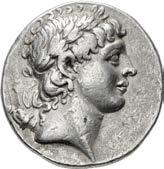

154. CARIA, Antioch ad Maeandrum. Early-Mid 1st century BC. AR Tetradrachm (27mm, 16.18 g, 12h). Diotrephes, magistrate. Laureate head of Apollo right; bow and quiver over shoulder / Zebu bull standing left, head facing; maeander pattern in exergue. Thonemann Group A, 1.a–d (O1/R1); HN Online 1528. A hint of porosity on obverse, tiny die break on reverse. VF. Rare. ($1500)
155. CARIA, Antioch ad Maeandrum. Early-Mid 1st century BC. AR Tetradrachm (27mm, 16.28 g, 12h). Diotrephes, magistrate. Laureate head of Apollo right; bow and quiver over shoulder / Zebu bull standing left, head facing; maeander pattern in exergue. Thonemann Group A, 1.i (O2/R5); HN Online 1528. Tiny flan flaw on obverse, a hint of porosity on reverse. VF. Rare. ($1500)
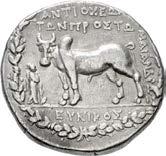
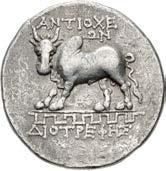
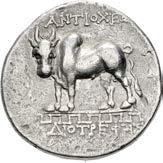
156. CARIA, Antioch ad Maeandrum. Early-Mid 1st century BC. AR Tetradrachm (27mm, 16.15 g, 12h). Eunikos (II), magistrate. Laureate head of Zeus right / Zebu bull standing left, head facing; to left. female standing right, placing hand on chin; all within circular maeander pattern. Thonemann Group A, 17.e–f (O18/R33); HN Online 2069. Minor flan flaw on obverse. Good VF. Rare. ($1500)
157. CARIA, Antioch ad Maeandrum. Early-Mid 1st century BC. AR Tetradrachm (28mm, 15.90 g, 12h). Hermogenes, magistrate. Type 2. Laureate head of Zeus right / Eagle, with closed wings, standing left on thunderbolt; to right, Nike flying left, crowning eagle with wreath; all within circular maeander pattern. Thonemann Group B, 10, b–d var. (O11/R– [unlisted rev. die]); HN Online 2070; Triton XXVI, lot 276 (same dies). Porosity and small flan flaw on obverse. Near VF. Rare. ($1000)
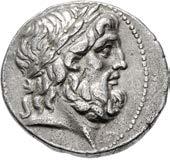
44
154 155 156 157
158. CARIA, Antioch ad Maeandrum. Early-Mid 1st century BC. AR Tetradrachm (27mm, 16.15 g, 12h). Adrastos, son of Pytheos, magistrate. Wreathed head of Dionysos right / Zebu bull standing left, head facing; to left, turreted head of Tyche left; all within circular maeander pattern. Thonemann Group C, 16, a (O17/R31); HN Online 2078; Triton XXVI, lot 278 (same dies). Some porosity. VF. Very rare. ($1500)

Hermias and the Dolphin
159. CARIA, Iasos. Circa 250-190 BC. AR Drachm (19.5mm, 5.44 g, 1h). Persic standard. Euanthous, magistrate. Laureate head of Apollo right / Boy holding on to dolphin swimming right. Ashton, Pre-Imperial, p. 55, 8 var. (A–/P8 [unlisted obv. die]); HN Online –; SNG München 241 (same obv. die). Toned, spot of die rust and a few tiny flan flaws on obverse. Good VF. Very rare with this magistrate. ($1500)



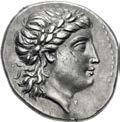
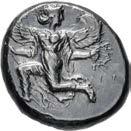
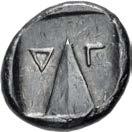
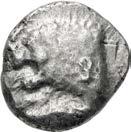
Tales of humans interacting with dolphins occur frequently in Greek lore, and often on coins, most famously those of Tarentum in southern Italy, which depict the hero Taras (or Phalanthos) being rescued by a dolphin. The tale depicted on this issue of Iasos is rather more poignant. Hermias, a Greek youth of Iasos, is said to have taken a swim in the ocean each day after training at the gymnasium. On one such occasion, a dolphin swam up to him and allowed him to clasp his dorsal fin. The two became fast friends and the dolphin waited in the ocean each day for Hermias to dive in and go for a ride. One sad day, Hermias drowned (perhaps accidentally pierced by the dolphin’s fin). The dolphin pulled him back to shore, but the boy could not be revived. Disconsolate, the dolphin beached himself next to the boy and expired.
slightly off center on obverse. Good VF. ($1500)
From the W. Hansen Collection. Ex Classical Numismatic Group Electronic Auction 82 (4 February 2004), lot 14.
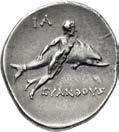
Histiaios of Termera
161.
AR
(21mm, 10.91 g, 10h). Forepart of lion left; monogram or letter (Carian T?) on shoulder / Helmeted head of Athena right within incuse square. Cf. HN Online 2167 (same obv. die as illustration = SNG Kayhan 1666; different revers type); cf. Konuk, Influences, pl. XXIX, 25 (same obv. die, different rev, type); otherwise, unpublished in the standard references. Struck from heavily worn obverse die. Good VF. Apparently unique with this reverse type. ($750)
45
160. CARIA, Kaunos. Circa 410-390 BC. AR Stater (21mm, 11.62 g, 12h). Winged female figure in kneeling-running stance left, head right, holding [kerykeion] and wreath / Baetyl(?); ∂ ˝ (K B in Carian) across upper field; all within incuse square. Konuk Period V, Type 4, 116 (O54/R56); Konuk, Coin M26; HN Online 220. Dark toning,
CARIA, Termera. Histiaios. Tyrant, 490-480 BC.
Stater
Apparently Unique Rhodian Gold Hemistater

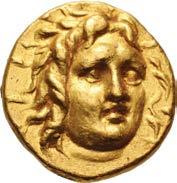


162. ISLANDS off CARIA, Rhodos. Rhodes. Circa 125-88 BC. AV Hemistater (14mm, 4.07 g, 12h). Attic standard. Diognetos, magistrate. Radiate head of Helios facing slightly right / Rose in profile, with bud to left; d5o˝@˙to% above, r-o flanking, cornucopia to lower right; all within incuse square. Jenkins, Rhodian –; cf. Hackens 16–7 (different magistrate; same obv. die); HN Online –; HGC 6, 1414; Ward 718 (same; same obv. die). Minor hairlines. Good VF. Apparently unique with cornucopia. ($20,000)
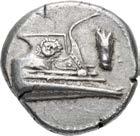


The rare late gold coinage of Rhodes falls into the so-called plinthophoric coinage of the city, from the term plinthos, or ‘brick,’ a reference to the shallow incuse square on the reverse. The use of a reverse incuse, a kind of antiquarian throwback, is a feature of the coinage of Rhodes commencing in circa 173 BC and ending about 88 BC. Nearly all of the coinage of this era were silver drachms and fractions thereof; however, a very limited series of gold coins on a range of denominations from staters down to quarter-staters commenced about 125 BC. The reasons for such an elaborate gold issue are unclear, but may be a response to a silver shortage or other economic crisis; alternatively it may reflect Rhodes’ new role as one of Rome’s chief allies and financial arbiter in the east as the Roman Republic was beginning to acquire provinces in Asia Minor.
163. ISLANDS off CARIA, Rhodos. Rhodes. Early 1st century AD. AR Drachm (16mm, 2.83 g). Reduced Attic standard. Radiate head of Helios facing / Open rose seen from above. Ashton & Weiss 11b (O2/R11); HN Online –; HGC 6, –; RPC I 2744. Attractive iridescent tone, a little die rust on obverse. EF. Rare. ($1000)

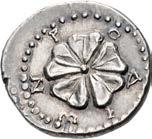
From the Grand Haven Collection. Ex Waddell FPL 68 (1996), no. 61; Ariadne Galleries (9 December 1983), lot 127; Ariadne Galleries (7 December 1982), lot 121; Numismatic Fine Arts X (17 September 1981), lot 202; Numismatica Classica FPL 1 (ND [c. 1979]), no. 25.
164. LYCIA, Phaselis. 4th century BC. AR Stater (21.5mm, 10.38 g, 6h). Prow of galley right, fighting platform decorated with facing gorgoneion; to right, cicada downward / Stern of galley left, pole mounted on the deck from which a wreath hangs. Heipp-Tamer Series 6, unlisted variety; Triton XXV, lot 278; CNG E-411, lot 164; CNG E-402, lot 251; CNG 103, lot 317; CNG 102, lot 536; CNG 99, lot 280 (all from the same dies). Lightly toned. Good VF. ($750)
Ex Pars Coins inventory PCW-G5454 (August 2016).
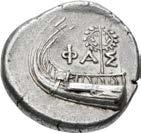
46
Unique Third Stater
165. DYNASTS of LYCIA. Kuprilli. Circa 480-440 BC. AR Third Stater (13mm, 2.55 g). Uncertain mint. Eagle flying right / Triskeles; ˚oπ-r¬-¬3 around; all in pelleted square within incuse square. Cf. Mørkholm & Zahle 51–2 (staters, eagle left); cf. Müseler IV, 49–50 (same); cf. Falghera 126 (sixth stater, eagle left); SNG Copenhagen Supp. –; SNG von Aulock –. Some weakness to strike, minor porosity. VF. Apparently unique as a third stater. ($750)
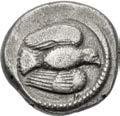
166. CILICIA, Issos. Tiribazos. Satrap of Lydia, 388-380 BC. AR Stater (21.5mm, 10.61 g, 12h). Ba’al standing left, holding eagle and scepter / Ahura-Mazda, body terminating in winged solar disk, facing, head right, holding wreath and lotus flower. Shannahan 9c (O3/R4) = Brindley Group 4 (b), dies 2/c (this coin); Casabonne Series 1; SNG BN 416. Lightly toned, slightly off center, struck with worn obverse die, minor doubling on obverse. Good VF. ($750)

Ex Lanz 34 (25 November 1985), lot 274.
167. CILICIA, Kelenderis. Circa 410-375 BC. AR Stater (20.5mm, 10.62 g, 1h). Nude youth, holding whip, dismounting from horse rearing right / Goat kneeling left, head right, within shallow incuse circle. Casabonne Type 4; Celenderis Series IV, unlisted variety; SNG BN 75 (same dies). A little die wear. Near EF. ($400)
168. CILICIA, Kelenderis. Circa 410-375 BC. AR Stater (22mm, 10.58 g, 5h). Nude youth, holding whip, dismounting from horse rearing right / Goat kneeling left, head right, within shallow incuse circle. Casabonne Type 4; Celenderis Series IV, unlisted variety; SNG BN 75 (same dies). Trace deposits on obverse, minor doubling on reverse. Good VF. ($300)

169. CILICIA, Kelenderis. Circa 410-375 BC. AR Stater (19mm, 10.76 g, 7h). Nude youth, holding whip, dismounting from horse rearing right / Goat kneeling left, head right; branch with three ivy leaves above; [all within shallow incuse circle]. Casabonne Type 4; Celenderis Series IV, unlisted variety; SNG BN –; SNG Levante 24 (same dies); Triton XXV, lot 290 (same dies). Lustrous, some die wear. Near EF. Rare. ($400)
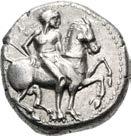

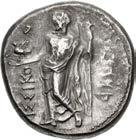
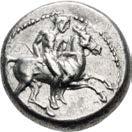
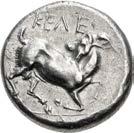



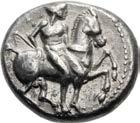

170. CILICIA, Kelenderis. Circa 410-375 BC. AR Stater (22.5mm, 10.89 g, 1h). Nude youth, holding whip, dismounting from horse rearing right / Goat kneeling left, head right; ivy leaf above, π to left; all within shallow incuse circle. Casabonne Type 4; Celenderis Series IV, unlisted variety; SNG BN –; BMC 26. Minor doubling on obverse. Near EF. ($400)

171. CILICIA, Kelenderis. Circa 410-375 BC. AR Stater (20.5mm, 10.66 g, 3h). Nude youth, holding whip, dismounting from horse rearing right / Goat kneeling left, head right; uncertain letter(s) or monogram in exergue; [all within shallow incuse circle]. Casabonne Type 4; Celenderis Series IV, unlisted variety; otherwise, unpublished in the standard references. Some die wear. Near EF. Very rare. ($400)

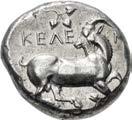
47
168 169 170 171 166 167
172. CILICIA, Nagidos. Circa 400-385/4 BC. AR Stater (18.5mm, 10.62 g, 1h). Aphrodite seated left, holding patera; to right, Eros, nude, standing left, grasping Aphrodite’s arm and holding wreath; s5 to right / Bearded Dionysos, nude but for drapery hanging from arms, standing left, holding kantharos and thyrsos; Ŏ to lower left. Casabonne Type 1; Lederer Group 1, 1 (same obv. die); SNG BN 1 = SNG Levante 1 (same obv. die). Compact flan, struck with worn obverse die. EF ($500)
173. CILICIA, Nagidos. Circa 385/4-375 BC. AR Stater (22mm, 10.70 g, 6h). Aphrodite seated left, holding phiale over altar to left; to right, Eros standing left, crowning her with wreath / Dionysos standing left, holding grape bunch on vine and thyrsos; Å in wreath to left. Casabonne Type 5; Lederer 26; SNG BN 21 var. (control mark); SNG Levante –. Attractive iridescent toning over lustrous surfaces, usual die break, some die rust. EF ($750)
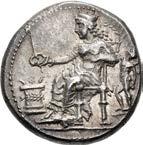
174. CILICIA, Soloi. Circa 440-410 BC. AR Stater (21.5mm, 10.57 g, 12h). Amazon kneeling left, holding bow, quiver on left hip; head of satyr to right / Grape bunch on vine; E¨ to left of stalk, fly to lower right; all in dotted square within incuse square. Casabonne Type 2; SNG BN 128 var. (no letters on rev.); SNG Levante 40 var. (same). Some die wear on obverse. Good VF. ($500)
175. CILICIA, Soloi. Circa 440-410 BC. AR Stater (20mm, 10.64 g, 8h). Amazon kneeling left, holding bow, quiver on left hip / Grape bunch on vine; d-Å flanking stem, e to lower right. Casabonne Type 3; SNG BN 136. A little die wear on obverse. Good VF. ($500)
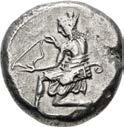
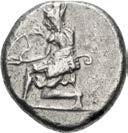

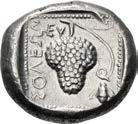


176. CILICIA, Soloi. Circa 440-410 BC. AR Stater (19.5mm, 10.88 g, 12h). Amazon kneeling left, holding bow, quiver on left hip / Grape bunch on vine; 5˜ above stalk, e to lower right. Casabonne Type 3; SNG BN 137 var. (@5 below stalk). A little die wear on obverse. Good VF. Rare. ($500)
177. CILICIA, Soloi. Circa 410-375 BC. AR Stater (20mm, 10.70 g, 10h). Helmeted head of Athena right, helmet decorated with griffin / Grape bunch on vine tendril with leaves at sides; A to lower right. Casabonne Type 5; SNG BN –; SNG Levante –; Triton XXVI, lot 310 (same dies); CNG 93, lot 465 = Triton XV, lot 1255 (same dies). Underlying luster, area of flat strike, a little off center and minor die wear on obverse. Near EF. Rare. ($1500)
178. CILICIA, Soloi. Circa 410-375 BC. AR Stater (20mm, 10.65 g, 7h). Helmeted head of Athena right, helmet decorated with griffin / Grape bunch on vine tendril; A to upper left; all within incuse circle. Casabonne Type 5; SNG BN –; SNG Levante –; Athena Fund II 791 (same dies); Triton XXVI, lot 312 (same dies); Triton XXV, lot 294 (same dies). Underlying luster, some weakness to strike, die wear on obverse. Near EF. Rare. ($1500)


179. CILICIA, Soloi. Circa 410-375 BC. AR Stater (22mm, 10.69 g, 11h). Helmeted head of Athena right, helmet decorated with griffin / Grape bunch on vine tendril; A to upper left; all within incuse circle. Casabonne Type 5; SNG BN –; SNG Levante –; Athena Fund II 791 (same dies); Triton XXVI, lot 312 (same dies); Triton XXV, lot 294 (same dies). Toned, minor die wear, a little off center on obverse. Good VF. Rare. ($1500)
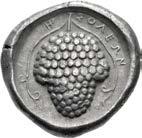





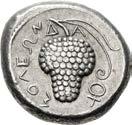
48
172 173 174 175 176 177 178 179
180. CILICIA, Soloi. Circa 410-375 BC. AR Stater (20mm, 10.73 g, 11h). Helmeted head of Athena right, helmet decorated with griffin / Grape bunch on vine tendril with leaves; A to lower right. Casabonne Type 5; SNG BN –; SNG Levante –; Triton XXVI, lot 313 (same dies); Triton XXV, lot 296 (same dies). Lustrous, a little off center and minor die wear on obverse. EF. ($1500)
181. CILICIA, Soloi. Circa 410-375 BC. AR Stater (20mm, 10.72 g, 12h). Helmeted head of Athena right, helmet decorated with griffin / Grape bunch on vine tendril with leaves; A to lower right. Casabonne Type 5; SNG BN –; SNG Levante –; Triton XXVI, lot 313 (same dies); Triton XXV, lot 296 (same dies). Lightly toned, minor die wear on obverse, a little off center on reverse. Near EF. ($1500)

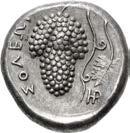
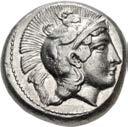

182. CILICIA, Tarsos. Circa 410-385 BC. AR Stater (22mm, 10.87 g, 5h). Satrap on horseback riding right / Hoplite, nude but for helmet, holding spear and shield, kneeling right, in dotted square within shallow incuse square. Casabonne Type F1; Müseler, Tarsos, Group 5, a; SNG BN 215–6. Struck with worn dies, scratch on obverse. Good VF. ($500)
183. CILICIA, Tarsos. Circa 410-385 BC. AR Stater (20mm, 10.63 g, 8h). Satrap on horseback riding right; monogram to right / Hoplite, holding spear and shield, kneeling right; grain ear to right; all in dotted square within shallow incuse square. Casabonne Type F6; Müseler, Tarsos, Group 5, g; SNG BN –; SNG Levante 60. Some weakness to strike on obverse, slight die shift on reverse. Good VF. Rare. ($500)
184. CILICIA, Tarsos. Circa 410-385 BC. AR Stater (22mm, 10.38 g, 6h). Satrap on horseback riding right; monogram to right / Hoplite, holding spear and shield, kneeling right; grain ear to right; all in dotted square within shallow incuse square. Casabonne Type F6; Müseler, Tarsos, Group 5, g; SNG BN –; SNG Levante 60. Lightly toned, slightly weak strike, a little off center on reverse. VF. Rare. ($500)
185. CILICIA, Tarsos. Circa 410-385 BC. AR Stater (20.5mm, 10.62 g, 7h). Satrap on horseback riding right; bee to left / Hoplite, holding spear and shield, kneeling right; grain ear to left, bee to right; all in dotted square within shallow incuse square. Casabonne Type F8; Müseler, Tarsos, Group 5, i; SNG BN 223 (same obv. die). Slightly off center, struck with worn obverse die, some weakness to strike on reverse. Good VF. Rare. ($500)

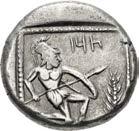
186. CILICIA, Tarsos. Circa 410-385 BC. AR Stater (21.5mm, 10.73 g, 6h). Satrap on horseback riding right / Hoplite, nude but for helmet, holding spear and shield, kneeling left, [within shallow incuse circle]. Casabonne Type F10; Müseler, Tarsos, Group 5, l; SNG BN 226–31. Underlying luster, off center and some die wear on obverse, slight die shift on reverse. Near EF. ($500)

187. CILICIA, Tarsos. Circa 410-385 BC. AR Stater (21mm, 10.83 g, 6h). Satrap on horseback riding right / Hoplite, nude but for helmet, holding spear and shield, kneeling left, [within shallow incuse circle]. Casabonne Type F10; Müseler, Tarsos, Group 5, l; SNG BN 226–31. Weakly struck on obverse, struck with worn reverse die. Good VF. ($500)
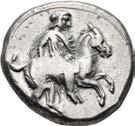

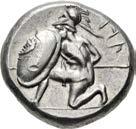


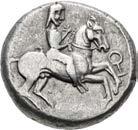
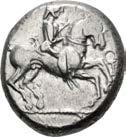

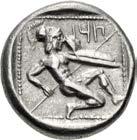
49
180 181 182 183 184 185 186 187
188. CILICIA, Tarsos. Pharnabazos. Persian military commander, 380-374/3 BC. AR Stater (20.5mm, 10.81 g, 11h). Head of Arethousa facing slightly left, hair in ampyx; to left, fish upward / Helmeted and bearded head left, drapery around neck. Casabonone Series 2; Moysey Issue 3, dies 2/– (unlisted rev. die); SNG BN –; SNG Levante –; SNG Hunterian 966 (same obv. die); Jameson 2603 = Pozzi 2847 (same obv. die [erroneously listed under obv. die 1 in Moysey]). Underlying luster, compact flan, minor flan flaws, a little die wear. Near EF. ($750)


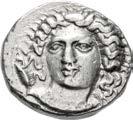


189. CILICIA, Tarsos. Pharnabazos. Persian military commander, 380-374/3 BC. AR Stater (19mm, 10.74 g, 11h). Head of Arethousa facing slightly left, hair in ampyx; to left, fish upward / Helmeted and bearded head left, drapery around neck. Casabonne Series 2; Moysey Issue 3, dies 2/– (unlisted rev. die); SNG BN –; SNG Levante –; SNG Hunterian 966 (same obv. die); Jameson 2603 = Pozzi 2847 (same obv. die [erroneously listed under obv. die 1 in Moysey]). Tiny bump on obverse, slightly soft strike on reverse. Near EF. ($750)
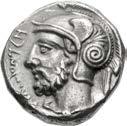
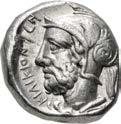
190. CILICIA, Tarsos. Pharnabazos. Persian military commander, 380-374/3 BC. AR Stater (21mm, 10.77 g, 5h). Head of Arethousa facing slightly left, hair in ampyx; to left, fish upward / Helmeted and bearded head left, drapery around neck. Casabonne Series 2; Moysey Issue 3, dies 2/– (unlisted rev. die); SNG BN –; SNG Levante –; SNG Hunterian 966 (same obv. die); Jameson 2603 = Pozzi 2847 (same dies [erroneously listed under obv. die 1 in Moysey]). Underlying luster, some die wear, light marks on obverse. Good VF. ($750)

50
188 189
191. KINGS of CAPPADOCIA. Ariarathes V Eusebes Philopator. Circa 163-130 BC. AR Tetradrachm (34.5mm, 16.23 g, 12h). Mint A (Eusebeia-Mazaka). Dated RY 29 (134/3 BC). Diademed head right / Athena Nikephoros standing left; T to outer left, U to inner left, ] to outer right, Q˚ (date) in exergue. Simonetta 3 (Ariarathes IV); HGC 7, 810; DCA 453. Dark find patina, some scratches, areas of roughness on obverse, minor flan flaw and tiny edge chip on reverse. Near VF. Extremely rare date, only two noted by Simonetta, one additional in CoinArchives. ($1500) Ex Freeman & Sear inventory G7537 (2010).
A Selection of Tigranes II Tetradrachms
Tigranes II won the epithet “The Great” by expanding the Artaxiad Armenian Kingdom to its greatest extent and claiming the title “King of Kings,” hitherto employed by the Achaemenid and Parthian rulers of Persia. The son of the Artaxiad king Artavasdes I (ruled 159-115 BC), Tigranes spent much of his youth as a hostage to his father’s loyalty in the Parthian court. Tigranes inherited the Armenian throne in 95 BC and began methodically turning his mountainous, feudal kingdom into a powerful, centralized Hellenistic state. At its peak his kingdom incorporated all of Seleukid Syria, Cilicia, Cappadocia, and large swaths of Parthia. Though a crafty and talented statesman, his success was due less to his own military prowess than the result of a power vacuum caused by internal strife within Parthia and the collapse of the Seleukid Kingdom, along with the turmoil caused by the titanic struggle between the Roman Republic and Mithridates VI of Pontus. Tigranes formed an alliance with Mithridates, but fared poorly against the Roman generals Lucullus and Pompey. He ultimately elected to formally submit to Rome, which allowed him to retain his core kingdom while giving up his conquests.
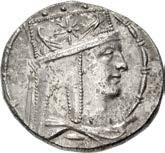
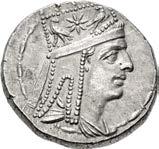
192. KINGS of ARMENIA. Tigranes II ‘the Great’. 95-56 BC. AR Tetradrachm (27mm, 15.50 g, 1h). Tigranocerta mint. Struck circa 80-68 BC. Diademed and draped bust right, wearing tiara decorated with star between two eagles / Tyche of Antioch seated right on rock, holding laurel branch; below, river-god Orontes swimming right; v to inner right, M on rock; all within wreath. SCADA Group 1, obv. die A7; Kovacs 74.1; M&D 2; CAA 17; AC 30. Minor marks, trace deposits. EF. ($1000)
193. KINGS of ARMENIA. Tigranes II ‘the Great’. 95-56 BC. AR Tetradrachm (27mm, 15.97 g, 12h). Tigranocerta mint. Struck circa 80-68 BC. Diademed and draped bust right, wearing tiara decorated with star between two eagles / Tyche of Antioch seated right on rock, holding laurel branch; below, river-god Orontes swimming right; 1 to inner right, M on rock; all within wreath. SCADA Group 1, obv. die A7; Kovacs 74.1; M&D 2; CAA 17; AC 30. Some light roughness on obverse, trace deposits on reverse. EF. ($1000)
194. KINGS of ARMENIA. Tigranes II ‘the Great’. 95-56 BC. AR Tetradrachm (26.5mm, 16.13 g, 12h). Tigranocerta mint. Struck circa 80-68 BC. Diademed and draped bust right, wearing tiara decorated with star between two eagles / Tyche of Antioch seated right on rock, holding laurel branch; below, river-god Orontes swimming right; v to inner right, M on rock; all within wreath. SCADA Group 1, obv. die A10; Kovacs 74.1; M&D 2; CAA 17; AC 30. Minor marks. EF. ($1000)
195. KINGS of ARMENIA. Tigranes II ‘the Great’. 95-56 BC. AR Tetradrachm (26mm, 15.75 g, 12h). Tigranocerta mint. Struck circa 80-68 BC. Diademed and draped bust right, wearing tiara decorated with star between two eagles / Tyche of Antioch seated right on rock, holding laurel branch; below, river-god Orontes swimming right; v to inner right, M on rock; all within wreath. SCADA Group 1, dies A13/P113; Kovacs 74.1; M&D 2; CAA 17; AC 30. Minor marks, trace deposits on reverse. Good VF. ($1000)
196. KINGS of ARMENIA. Tigranes II ‘the Great’. 95-56 BC. AR Tetradrachm (28mm, 15.96 g, 1h). Tigranocerta mint. Struck circa 80-68 BC. Diademed and draped bust right, wearing tiara decorated with star between two eagles / Tyche of Antioch seated right on rock, holding laurel branch; below, river-god Orontes swimming right; M on rock, small Q in right field; all within wreath. SCADA Group 2, obv. die A20; Kovacs 74.2; M&D 1; CAA 19; AC 30. Lightly toned, a few light marks, trace deposits. EF. Well centered. ($1500)

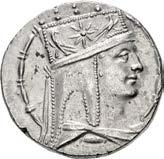
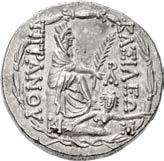
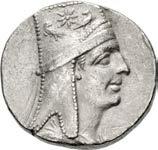



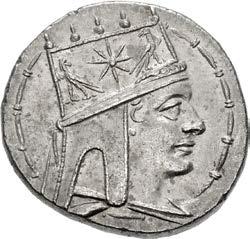

51
194 195 192 193
197. KINGS of ARMENIA. Tigranes II ‘the Great’. 95-56 BC. AR Tetradrachm (26.5mm, 15.74 g, 12h). Tigranocerta mint. Struck circa 80-68 BC. Draped bust right, wearing jeweled diadem and tiara decorated with star between two eagles / Tyche of Antioch seated right on rock, holding laurel branch; below, river-god Orontes swimming right; · on rock; all within wreath. SCADA Group 7, obv. die A49; Kovacs 75.3; M&D 12; CAA 23; AC 33. Light marks and scratches. Good VF. ($750)
Rare Unmarked Issue
198. KINGS of ARMENIA. Tigranes II ‘the Great’. 95-56 BC. AR Tetradrachm (29mm, 15.61 g, 12h). Tigranocerta mint. Struck circa 80-68 BC. Draped bust right, wearing jeweled diadem and tiara decorated with star between two eagles / Tyche of Antioch seated right on rock, holding laurel branch; below, river-god Orontes swimming right; no control marks; all within wreath. SCADA Group 7, obv. die A49, var. (monogram on rock on all reverses listed with this die); Kovacs 75.3 var. (monogram on rock); M&D 12 var. (same); CAA 23 var. (same); AC –. Light marks, small flan flaw on obverse, minor doubling on reverse. Good VF. Very rare variety with no monogram on rock. ($1000)
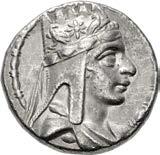
199. KINGS of ARMENIA. Tigranes II ‘the Great’. 95-56 BC. AR Tetradrachm (28.5mm, 16.00 g, 1h). Tigranocerta mint. Struck circa 80-68 BC. Diademed and draped bust right, wearing tiara decorated with star between two eagles / Tyche of Antioch seated right on rock, holding laurel branch; below, river-god Orontes swimming right; on rock, é above ·; all within wreath. SCADA Group 7, obv. die A53; Kovacs 75.1; M&D 9; CAA 33; AC 37. A few light marks, minor die break on obverse, trace deposits on reverse. Near EF. ($1000)

200. KINGS of ARMENIA. Tigranes II ‘the Great’. 95-56 BC. AR Tetradrachm (27.5mm, 15.65 g, 12h). Tigranocerta mint. Struck circa 80-68 BC. Diademed and draped bust right, wearing tiara decorated with star between two eagles / Tyche of Antioch seated right on rock, holding laurel branch; below, river-god Orontes swimming right; · on rock; all within wreath. SCADA Group 7, obv. die A58; Kovacs 75.1; M&D 4; CAA 21; AC 33. Minor marks. Good VF. ($1000)
201. KINGS of ARMENIA. Tigranes II ‘the Great’. 95-56 BC. AR Tetradrachm (28.5mm, 15.86 g, 12h). Tigranocerta mint. Struck circa 80-68 BC. Diademed and draped bust right, wearing tiara decorated with star between two eagles / Tyche of Antioch seated right on rock, holding filleted laurel branch; below, river-god Orontes swimming right; · on rock, pellet in inner right field; all within wreath. SCADA Group 7, obv. die A60; Kovacs 75.2; M&D 7; CAA 31–2; AC 33. Light marks, scratch in field on obverse, minor deposits on reverse. Near EF. ($1000)
202. KINGS of ARMENIA. Tigranes II ‘the Great’. 95-56 BC. AR Tetradrachm (28mm, 15.84 g, 1h). Tigranocerta mint. Struck circa 80-68 BC. Diademed and draped bust right, wearing tiara decorated with star between two eagles / Tyche of Antioch seated right on rock, holding filleted laurel branch; below, river-god Orontes swimming right; · on rock, pellet in right field; all within wreath. SCADA Group 7, obv. die A61; Kovacs 75.2; M&D 7; CAA 31–2; AC 33. Light marks, minor deposits. EF. ($1000)


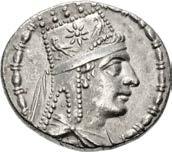



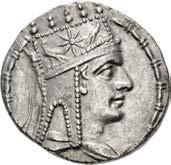

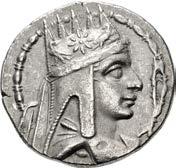

52
197 198 199 200 201 202
203. KINGS of COMMAGENE. Antiochos IV Epiphanes. AD 38-72. Æ Tetrachalkon (22mm, 6.24 g, 12h). Uncertain mint. Diademed and draped bust right / Capricorn right; star above, anchor below; all within laurel wreath. Kovacs 256; RPC I 3855; AC 205. Dark green patina, with a couple spots of light green. EF. Well centered and struck. Exceptional for issue. ($300)





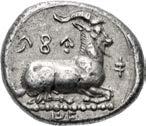


Ex Triton XXIV (19 January 2021), lot 744.
Overstruck on Paphos
Salamis. Phausis(?). Circa 480-460 BC. AR Stater (23mm, 10.98 g, 6h). Ram couchant left; ì1 (pa-usi in Cypriot) above, [ínö (si-se-o in Cypriot) below(?)] / Large ornate ankh enclosing 1 (pa in Cypriot); ö[vs]î (se-[si-le]-o in Cypriot) counterclockwise around from upper right; all within incuse square. McGregor Group F.II.a, 273 (O1/R1); Zapiti & Michaelidou –; Tziambazis –; Jameson 1628 = Traité II 1129, pl, CXXVII, 1 (same dies). Overstruck on stater of Paphos (cf. BMC 1 for type). VF. ($750)
204.
205. CYPRUS, Salamis. Phausis(?). Circa 480-460 BC. AR Stater (19.5mm, 11.05 g, 8h). Ram couchant left; íì1 (pa-u-si in Cypriot) above, [nö (se-o in Cypriot) below(?)] / Large ornate ankh enclosing 1 (pa in Cypriot); övsî (se-si-le-o in Cypriot) counterclockwise around from upper right; all within incuse circle. McGregor Group F.II.a, 274 var. (unlisted dies); Zapiti & Michaelidou –; Tziambazis –; ACGC 1080. Typical irregular flan, area of weak strike and a little off center on obverse. VF. Very rare. ($1000)
206.
Circa 480-460 BC. AR Stater (20.5mm, 10.96 g, 2h). Ram couchant right; pelletin-crescent and 1 (pa in Cypriot) above, nöíì (u-si-se-o in Cypriot) below / Large ornate ankh enclosing 1 (pa in Cypriot); ö[v]sî (se-si-[le]-o in Cypriot) counterclockwise around from upper right; [all within incuse square(?)]. McGregor Group F.II.c, 283 var. (O1/R– [unlisted rev. die]); Zapiti & Michaelidou –; Tziambazis –; Aufhaüser 7, lot 263 var. (orientation of rev. legend; same obv. die). Typical irregular flan, struck with worn dies. Near VF. Very rare. ($1000)
207. CYPRUS, Salamis. Evagoras I. Circa 411-374/3 BC. AR Stater (21.5mm, 11.18 g, 8h). Herakles seated right on rock draped with lion’s skin, leaning on club held in his right hand and holding cornucopia in left; üèãìó (e-u-wa-ko-ro in Cypriot) around / Goat couchant right; nrvs1 (pa-si-le-wo-se in Cypriot) around, E at end in exergue. McGregor Group K.AR.I.a, 414–5 var. (unlisted dies); Zapiti & Michaelidou 1; Tziambazis –; CNG 120, lot 407. Slightly weak strike, minor double strike on reverse. Near EF. ($2000)
208. CYPRUS, Salamis. Evagoras I. Circa 411-374/3 BC. AR Stater (20mm, 11.14 g, 9h). Herakles seated right on rock draped with lion’s skin, leaning on club held in his right hand and holding cornucopia in left; üèãìó (e-u-wa-ko-ro in Cypriot) around / Goat couchant right; nrvs1 (pa-si-le-wo-se in Cypriot) around, E at end in exergue. McGregor Group K.AR.I.a, 414–5 var. (unlisted dies); Zapiti & Michaelidou 1; Tziambazis –; CNG 120, lot 407. Struck with worn obverse die. VF. ($1500)




53
CYPRUS,
CYPRUS, Salamis. Phausis(?).
205 206 207 208
209. SELEUKID EMPIRE. Seleukos I Nikator. Second satrapy and kingship, 312-281 BC. AR Tetradrachm (26.5mm, 16.94 g, 1h). Seleukeia on the Tigris I mint. Struck circa 300-281 BC. Head of Herakles right, wearing lion skin / Zeus Nikephoros seated left; Q in left field. SC 117.4a; ESM 26 var. (monogram; A26/P– [unlisted rev. die]); HGC 9, 12i. Lightly toned, underlying luster, short scrape in field on reverse. EF. ($750)
210. SELEUKID EMPIRE. Antiochos I Soter. 281-261 BC. AR Tetradrachm (29mm, 17.08 g, 5h). Ekbatana mint. Diademed head right / Apollo, testing three arrows and placing hand on grounded bow, seated left on omphalos; to inner left, é above arm, 5 and forepart of horse grazing left below. SC 409.2g; HGC 9, 128h; ESM 529β = ANS inv. 1944.100.73618 (same obv. die). Minor die wear, faint hairlines. Good VF. ($1500)
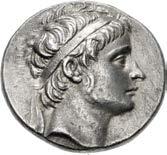
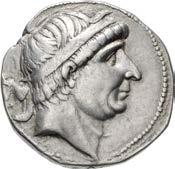


211. SELEUKID EMPIRE. Seleukos II Kallinikos. 246-225 BC. AR Tetradrachm (27mm, 16.94 g, 12h). Antioch on the Orontes mint. Diademed head right / Apollo standing left, leaning on tripod, holding bow; Ç to outer left, i to outer right. SC 689.6a; cf. Le Rider, Antioche 57–67 (obv. die A6); HGC 9, 303p. Lightly toned, some porosity, roughness, and light cleaning marks on obverse, stress cracks and some marks on reverse. Near EF ($750)
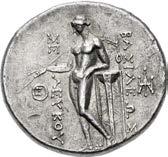
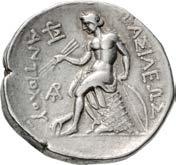
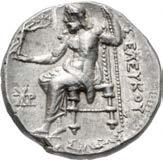
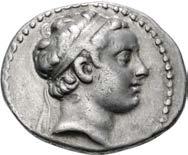
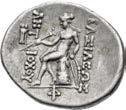


212. SELEUKID EMPIRE. Antiochos, son of Seleukos
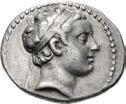
54
IV. 175 BC. AR Drachm (20mm, 4.23 g, 12h). Antioch on the Orontes mint. Diademed head right / Apollo, testing arrow and placing hand on grounded bow, seated left on omphalos; tripod to outer left, J in exergue. SC 1370; Le Rider, Antioche, dies A1/P1; HGC 9, 611. Lightly toned, minor marks. VF. Rare. ($1500)
209 210
213. SELEUKID EMPIRE. Antiochos V Eupator. 164-162 BC. AR Tetradrachm (28.5mm, 15.85 g, 12h). Antioch on the Orontes mint. Diademed head right / Zeus Nikephoros seated left; : to outer left. SC 1575.1; Le Rider, Antioche 25–72 (obv. die A2); HGC 9, 752. Find patina, scratches. Good VF. ($500)
Fourth Known Timarchos Tetradrachm from Ekbatana

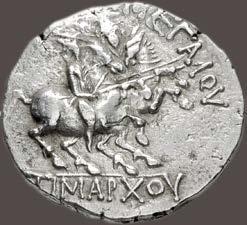
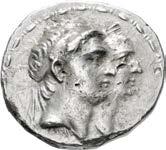
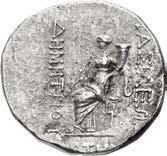
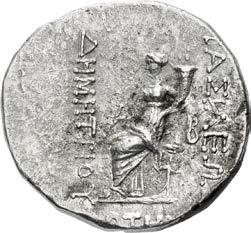
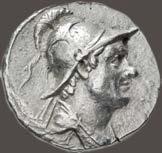
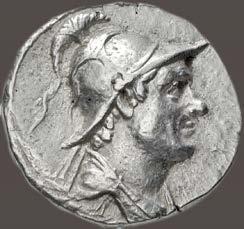
holding couched spears in right hand, palm fronds in left, on horses rearing right. SC 1589; A. Houghton, “Timarchus as king in Babylon” in RN 1979, A (same obv. die); Le Rider, Suse, pl. LXV, 5–6 (same dies as no. 6); HGC 9, 761. Compact flan, a little off center on reverse, indications of overstriking. VF. Extremely rare, the fourth known, and none in CoinArchives (the one helmeted Timarchos tetradrachm listed there is of SC 1588 type). ($30,000)
Unlike many ephemeral Hellenistic reigns, the brief revolt of the Seleukid usurper Timarchos is fairly well-documented by a number of nearcontemporary sources. Hailing from Miletos, Timarchos was a friend of the flamboyant Seleukid king Antiochos IV Epiphanes and served as his ambassador to the Roman Republic. Later, Timarchos was appointed to an eastern satrapy, either Babylon or Media. Upon Antiochos’ death in 164 BC, Timarchos appealed to the Roman Senate that he, not the brother of Antiochos, returning exile Demetrios I, should be named Seleukid king. The Senate, seeking to keep the Seleukid Empire weak and divided, approved his claim. Demetrios, however, moved quickly, securing the western capital of Antioch and the rest of Syria while Timarchos raised a large army and consolidated his hold on the eastern provinces, including the cities of Ekbatana and Seleukia on the Tigris. With his realm adjoining the breakaway Greco-Baktrian kingdom, then ruled by Eukratides I “the Great,” Timarchos chose to imitate Eukratides’ silver tetradrachm type depicting his bust wearing a distinctive, broad-brimmed cavalry helmet, with the reverse showing the Dioskouri on horseback holding couched lances. Like Eukratides, he took the old Achaemenid title of Great King (Megas Basileus). Whether this close copying of coin types and titles suggests a formal alliance between the two rulers remains unresolved. Ultimately, Demetrios marched east and confronted the forces of Timarchos in a great battle outside of Babylon in the Spring of 161 BC, where Timarchos suffered defeat and death. His precious metal coinage was recalled and melted down, accounting for its great rarity today, with only four silver tetradrachms from Ekbatana, a single example from Seleukia on the Tigris, and a handful of drachms surviving. Unique
215. SELEUKID EMPIRE. Demetrios I Soter. 162-150 BC. AR Tetradrachm (27.5mm, 16.73 g, 12h). Ekbatana mint(?). Jugate heads right of Demetrios, wearing diadem, and Laodike, wearing stephanos, within fillet border / ∫Å%5¬EW[%] d˙µ˙tr5oU [%]Wt˙r[o%], Tyche, fully clothed, holding scepter in extended left hand and cradling cornucopia in right arm, seated left on throne supported by tritoness right; ∫ to inner right. Unpublished, but cf. HGC 9, 799 for type. Struck with worn dies, minor flan flaws on obverse, light scrape and a little off center on reverse. VF. Unique. ($3000)
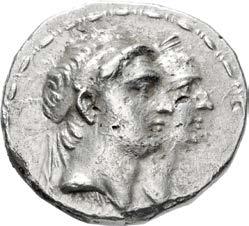
55
214. SELEUKID EMPIRE. Timarchos. Usurper, 164-161 BC. AR Tetradrachm (27mm, 16.73 g, 5h). Ekbatana mint. Diademed and draped bust right, wearing Boeotian helmet, within fillet border / [∫Å%5¬EW%] ÂE˝Å¬oU t5;ÅrcoU, Dioskouroi,
216. SELEUKID EMPIRE. Alexander I Balas. 152-145 BC. AR Tetradrachm (28.5mm, 16.58 g, 12h). Sidon mint. Dated SE 165 (148/7 BC). Diademed head right / Zeus Aëtophoros seated left; aphlaston below throne, E$r (date) and %5dW in exergue. SC 1829; HGC 9, 879; DCA 119. Toned, traces of find patina. Near EF. Extremely rare Zeus Aëtophoros type at Sidon; only two in SCO, one in CoinArchives. ($750)
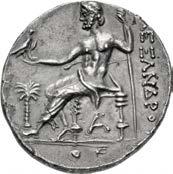
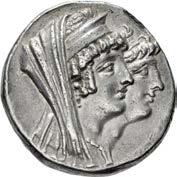
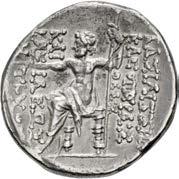



Ex Numismatic Art & Ancient Coins 3 (30 July 1982), lot 63.
217. SELEUKID EMPIRE. Demetrios II Nikator. First reign, 146-138 BC. AR Tetradrachm (24.5mm, 14.04 g, 1h). Sidon mint. Dated SE 170 (143/2 BC). Diademed and draped bust right / Eagle standing left; palm frond diagonally in background; to left, or (date) above monogram; to right, %5dW above aphlaston; Y between legs. SC 1954.4b; HGC 9, 969; DCA 152. Toned, underlying luster. Superb EF. ($750)
218. SELEUKID EMPIRE. Kleopatra Thea & Antiochos VIII. 125-121 BC. AR Tetradrachm (29.5mm, 16.55 g, 11h). Ptolemaïs (Ake) mint. Undated issue, struck circa 124 BC. Jugate heads right / Zeus Nikephoros seated left; [† to outer left]. SC 2271.1; HGC 9, 1182g; CNG 102, lot 613 (same obv. die). Lighty toned, some porosity, small chip at edge on obverse, flan flaw on reverse. Good VF. ($750)
From the Don T. Hayes Collection.
219. PHOENICIA, Arados. Circa 246/5-168/7 BC. AR Tetradrachm (29mm, 13.25 g, 12h). In the name and types of Alexander III of Macedon. Dated CY 76 (184/3 BC). Head of Herakles right, wearing lion skin / Zeus Aëtophoros seated left; palm tree in left field, 1 (civic) monogram below throne, o4 (date) in exergue. Duyrat Autonomous Series I, 1342–9 var. (unlisted dies); Price 3403; HGC 10, 61; DCA 771. Toned, double struck, some die breaks, scratch on obverse, minor flan flaw on reverse. Good VF. ($400)

From the Don T. Hayes Collection.
220. PHOENICIA, Byblos (Gebal). Uncertain king. Circa 433-425 BC. AR Quarter Shekel (15mm, 3.39 g, 4h). Galley with three hoplites left; below, hippocamp left / Vulture standing left on incuse ram lying left, head right. E&E-B Group III.2; HGC 10, 127. Off center, some die wear. VF. Very rare. ($500)
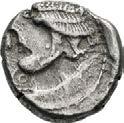
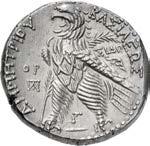
221. PHOENICIA, Sidon. `Abd`aštart (Straton) I. Circa 365-352 BC. AR Quarter Shekel (14mm, 3.08 g, 1h). Dated RY 6 (360/59 BC). Phoenician galley left; ‹‹‹ ‹‹‹ (6 in Phoenician [date]) above, waves below / King of Persia and driver in chariot drawn by two horses left; Bo (’B in Phoenician) above. E&E-S Group IV.2.3, – (unlisted date); HGC 10, 244 var. (same); DCA 852; Triton XVIII, lot 200 (same dies). Toned. VF. Very rare, only one other specimen known with this date. ($300)



56
216 217 218 219 220 221
Ex O’Hagan and Montagu Collections – Pedigreed to 1908
222. PHOENICIA, Sidon. `Abd`aštart (Straton) II. Circa 342-333 BC. AR Dishekel (27mm, 25.53 g, 12h). Dated RY 2 (345/4). Phoenician galley left; ‹‹ (2 in Phoenician [date]) and star above, waves below / King of Persia and driver in chariot drawn by two horses left; to right, King of Sidon standing left, in Egyptian dress, holding cultic scepter and votive vase; [oo (’’ in Phoenician) above]. E&E-S Group IV.4.1.h, 1657 (D11/R13 – this coin); HGC 10, 242; DCA 849. Toned, a few light scratches on obverse, a little off center on reverse. VF. ($2000)
From the D.K. Collection. Ex Lanz 54 (12 November 1990), lot 293; Rosenberg 79 (6 June 1934), lot 978; H. Osborne O’Hagan Collection (Sotheby, Wilkinson & Hodge, 4 May 1908), lot 708; Hyman Montagu Collection (not in sale catalogs).
223. PHOENICIA, Tyre. 126/5 BC-AD 65/6. AR Shekel (27.5mm, 13.17 g, 12h). Dated CY 29 (98/7 BC). Laureate head of Melkart right, [lion skin around neck] / Eagle standing left on prow, palm frond in background; to left, Q˚ (date) above club; %& to right, b (Phoenician B) between legs. DCA-Tyre 104 (same obv. die as illustration); HGC 10, 357; DCA 919. Lightly toned, light scratches, a little roughness. VF. ($750)
224. PHOENICIA, Tyre. 126/5 BC-AD 65/6. AR Shekel (27.5mm, 13.49 g, 1h). Dated CY 55 (72/1 BC). Laureate head of Melkart right, lion skin around neck / Eagle standing left on prow, palm frond in background; to left, E@ (date) above club; d to right, b (Phoenician B) between legs. DCA-Tyre 193; HGC 10, 357; DCA 919. Toned, roughness, cleaning scratches. VF. Rare date. ($750)
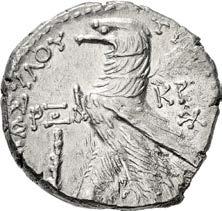
Tyre. 126/5 BC-AD 65/6. AR Shekel (24.5mm, 13.63 g, 1h). Dated CY 161 (AD 35/6). Laureate head of Melkart right, [lion skin around neck] / Eagle standing left on prow, palm frond in background; to left, r$& (date) above club; to right, ˚r above ); ∫ (Phoenician B) between legs. DCA Tyre 590; HGC 10, 357; DCA 920. Slightly off center.
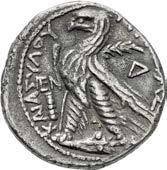

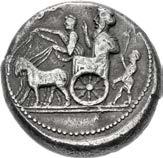
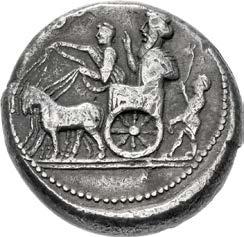
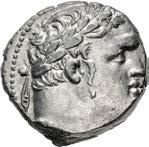

Tyrian shekels and half-shekels continued to be minted until about AD 65. They circulated widely in Judaea and, despite their overtly Pagan imagery, were accepted by the Jewish authorities as payment for the annual Temple tax. The infamous “30 pieces of silver” paid to Judas for betraying Jesus would likely have been Tyrian issues. This shekel was minted after the generally accepted dates for the crucifixion, April of either AD 30 or 33; however, Pontius Pilate was prefect in Judaea until AD 36, so a case could be made for the crucifixion occuring any year between AD 30 and 36.

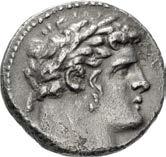
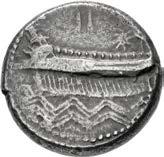
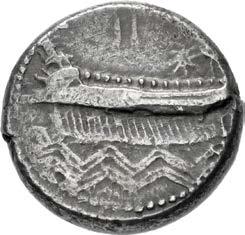
57
225. PHOENICIA,
EF. Choice for issue. ($1000)
223 224
226. PHOENICIA, Tyre. 126/5 BC-AD 65/6. AR Shekel (23mm, 13.75 g, 2h). Dated CY 161 (AD 35/36). Laureate head of Melkart right, [lion skin around neck] / Eagle standing left on prow, palm frond in background; to left, r$& (date) above club; to right, ˚r above @; ∫ (Phoenician B) between legs. DCA-Tyre 594; HGC 10, 357; DCA 920. Die break on reverse. EF. ($750)





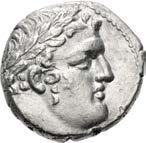
227. SAMARIA, “Middle Levantine” Series. Circa 375-333 BC. AR Obol (7mm, 0.75 g, 4h). Facing head / Owl standing right, head facing; [olive spray(?)] and crescent to left, [L]åDb` (‘BD’L in Aramaic) to right; all within incuse square. Meshorer & Qedar 59 var. (obv. type); Sofaer 114–5 var. (obv. type). Traces of find patina, irregular flan. VF. Very rare. ($750)
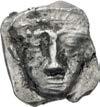


228. JUDAEA, Achaemenid Province (Yehud). Anonymous. Circa 375-332 BCE. AR Half Gerah (7.5mm, 0.31 g, 10h). Bearded head right, wearing crown (Persian Great King?) / Falcon upward, head left, wings spread. MCP YHD 16, dies O6/R13; Meshorer 16d; Hendin 6058d; HGC 10, 445. Find patina, slight roughness. VF. Attractive for issue. ($400)

229. JUDAEA, Achaemenid Province (Yehud). Anonymous. Circa 375-332 BCE. AR Half Ma’ah (6.5mm, 0.40 g). Pellet / Duck standing right, head left. MCP YHD 31, dies O1/R1; Meshorer 27a; Hendin 6075c; HGC 10, 437. Find patina, typical compact flan. Good VF. Exceptional for issue. ($500)
230. JUDAEA, Herodians. Herod I (the Great). 40-4 BCE. Æ Half Prutah (12mm, 0.78 g, 1h). Jerusalem mint. Tripod / Grape bunch on vine. A&F Type 14, dies unlisted; Meshorer 58; Hendin 6218; HGC 10, 668. Earthen dark green-brown patina. VF. Extremely rare, only three noted in A&F, three in CoinArchives: CNG 118, lot 497 (hammer $4000); Triton XVII (2014), lot 391 (hammer $2750), and Heritage 3042 (2015), lot 29138 (hammer $2000). ($1500)






58
Among the Rarest of the Bar Kochba Series Ex Hendin, Shoshana, and Kaufman Collections
JUDAEA, Bar Kochba Revolt. 132-135 CE. AR Zuz – Denarius (18.5mm, 3.31 g, 1h). Dated year 2 (133/4 CE). 3„o 2c (“Shim‘on” in Hebrew) within wreath / Kithara with three strings; L!RC¥ RHL @C (“Y[ear] 2 of the Freedom of Israel” in Hebrew) around. Mildenberg – (O13/R25 [unlisted die combination]); Kaufman I 11 (same dies); Meshorer 239; Hendin 6426a (this coin illustrated); Bromberg 465 (same obv. die); Shoshana I 20298 (this coin). Areas of flat strike. VF. Among the rarest of the Bar Kochba coins, only one other example known from this die pairing. ($3000)
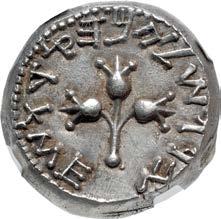
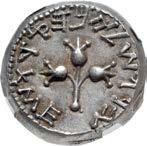

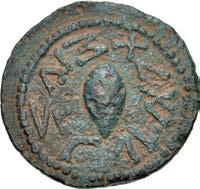
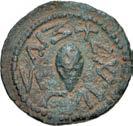

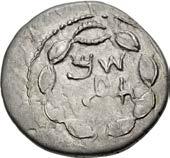

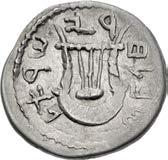


Ex David Hendin Collection (Triton XIX, 5 January 2016), lot 369 (hammered for $5000); Shoshana Collection (Part I, Heritage, 8 March 2012), lot 20298; C. Kaufman Collection.

59
231. JUDAEA, Jewish War. 66-70 CE. AR Shekel (21mm, 14.29 g, 12h). Jerusalem mint. Dated year 2 (67/8 CE). Omer cup / Sprig of three pomegranates. Deutsch 114 (O8/R87); Meshorer 193; Kadman 8; Hendin 6388. In NGC encapsulation 4241836-003, graded Ch AU, Strike: 5/5, Surface: 5/5. ($4000) Ex Heritage 3061 (8 January 2018), lot 32078.
232. JUDAEA, Jewish War. 66-70 CE. Æ Quarter Shekel (22mm, 7.81 g, 6h). Jerusalem mint. Dated year 4 (69/70 CE). Two lulav branches; o¥@R o@RF ¡3c (“year four, quarter” in Hebrew) around / Etrog; 3X¥ß ¡L!GL (“to the redemption of Zion” in Hebrew) around. MCR FJR-14, dies O1/R2; Kadman 33; Meshorer 213; Hendin 6397; Bromberg 386 (same obv. die); Shoshana I 20216; Sofaer 41–3; Spaer 181–2. Earthen green surfaces. VF. ($3000)
233.
234. JUDAEA, Bar Kochba Revolt. 132-135 CE. AR Sela – Tetradrachm. Undated, attributed to year 3 (134/5 CE). Façade of the Temple at Jerusalem; showbread table within, star above, 3∑o2C (“Shim‘on” in Hebrew) at sides / Bundle of lulav; etrog to left, 2LC∑R¥ ¡∑RHL (“For the freedom of Jerusalem” in Hebrew) around. Mildenberg 55 (O13/R41); Meshorer 267; Hendin 6439; Bromberg 104 (same dies); Shoshana I 20334 (same dies); Sofaer 108; Spaer 193–4. Toned, indications of undertype, placed in swivel mount on 15k gold necklace. VF. ($5000)


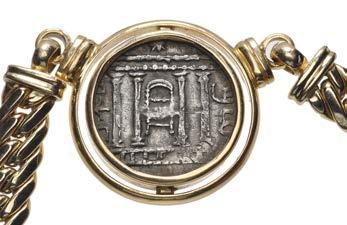
235. PHILISTIA (PALESTINE), Gaza (‘Azah). Mid 5th century-333 BC. AR Drachm (14.5mm, 3.63 g, 12h). Laureate and bearded head of male right / Falcon standing right; olive spray to left; all in dotted square within incuse square. Gitler & Tal V.8D. Toned, porous and some roughness, two test cuts on reverse. VF. Rare. ($1500)
236. PHILISTIA (PALESTINE), Gaza (‘Azah). Mid 5th century-333 BC. AR Drachm (13.5mm, 3.67 g, 3h). Bearded head right / Facing head of Bes in dotted square within incuse square. Gitler & Tal VI.14D; Fischer-Bossert, Notes 32. Lightly toned, some roughness, test cut on reverse. VF. Very rare. ($1500)




237. PHILISTIA (PALESTINE), Uncertain mint. Mid 5th century-333 BC. AR Drachm (16.5mm, 4.16 g, 9h). Imitating Athens. Helmeted head of Athena right, with profile eye / Owl standing right, head facing; olive sprig and crescent to left. Gitler & Tal IX.1D. A little off center, light porosity, struck with worn obverse die. VF. ($500)



238. PHILISTIA (PALESTINE), Uncertain mint. Mid 5th century-333 BC. AR Drachm (13.5mm, 2.27 g, 5h). Helmeted head of Athena right, with frontal eye / Persian Great King standing facing, head left, between two lions he holds by the tail; all within incuse square. Cf. Gitler & Tal XIII (for series, rev. type unlisted); otherwise, unpublished in the standard references. Toned, light granularity, test cut on reverse. VF. ($1000)
239. PHILISTIA (PALESTINE), Uncertain mint. Mid 5th century-333 BC. AR Drachm (16mm, 2.68 g, 12h). Laureate head of male left / Owl, with closed wings, standing facing; palm fronds flanking; all within incuse circle. Unpublished, but cf. Gitler & Tal XIV.32O for obols with similar types. Find patina, earthen deposits, test cut on reverse. VF. Extremely rare. ($1000)



240. PHILISTIA (PALESTINE), Uncertain mint. Mid 5th century-333 BC. AR Drachm (12.5mm, 3.33 g, 6h). Bearded head left / Paradise flower/Phoenician palmette in dotted square within incuse square. Gitler & Tal XVII.2D; HGC 10, 604. Toned, test cut on reverse. Good VF. Rare. ($1000)

60
235 236 237 238 239 240
241. NABATAEA. Malichos I. Circa 59/8-30 BC. AR Quarter Shekel – “Drachm” (17mm, 3.37 g, 12h). Petra mint. Dated RY 26 (35/4 BC). Diademed head right / Eagle standing left; palm frond to left; l ˚4 (date) to right. CN 10; Hoover & Barkay 15 = Barkay, Silver 1; Meshorer, Nabataea 12 var. (no palm frond); HGC 10, 679; DCA 957. Toned, some scratches, light scuff on reverse. Good VF. ($2000)

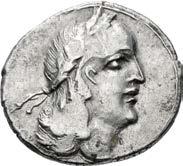

242. NABATAEA. Malichos I. Circa 59/8-30 BC. Æ (17mm, 3.88 g, 12h). Petra mint. Dated RY 27 (33/2 BC). Diademed head right / Palm of hand; 00:d 8 (“Y[ear] 27” [date], in Nabataean) across field. CN 14; Meshorer, Nabataea 17; HGC 10, 685; DCA 966. Earthen dark green patina. VF. Exceptional for issue. ($500)

243. NABATAEA. Malichos I. Circa 59/8-30 BC. AR Quarter Shekel – “Drachm” (16.5mm, 2.71 g, 12h). Petra mint. Dated RY 28 (33/2 BC). Diademed head right; e (W[?] in Nabataean) / Eagle standing left; 116ss (“Y[ear] 28” [date], in Nabataean) across field. CN 16; Meshorer, Nabataea –; Schmitt-Korte II –; Hoover & Barkay 16 = Huth 46; cf. HGC 10, 682; cf. DCA 958 (didrachm); Triton XXVI, lot 401 (hammer $7000). Rough find patina, a little off center. Near VF. Very rare. ($1000)


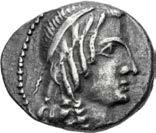
244. NABATAEA. Obodas II, with Hagaru I. Circa 30-9 BC. AR Half Shekel – “Didrachm” (18mm, 6.99 g, 12h). Petra mint. Dated RY 7 (24/3 BC). Jugate head of Obodas, diademed, and bust of Hagaru, veiled and draped, right / eT∫n r¬m Ar¬m tr∫a (‘BDT MLK’ MLK NBṬW in Nabataean = Obodas the King, King of the Nabataeans), eagle standing left; a∫! tn! (ŠNT ŠB’ in Nabataean = year seven [date]) at end of legend to upper right, o (Nabataean S) and h (Nabataean Ḥ) across field. Cf. CN 41 (bronze); cf. Meshorer, Nabataea 27 (same); DCA –. Dark find patina, slightly off center, light scratches. VF. Clear date. Unique. ($3000)


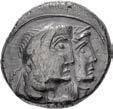
This type is known dated RY 6 (Barkay 35), but this example is clearly dated RY 7, as the bronze issue CN 41.


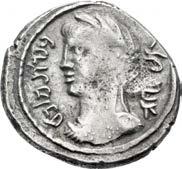



61
Unpublished and Unique
242 243
245. NABATAEA. Obodas II, with Hagaru I. Circa 30-9 BC. AR Sela’ – “Drachm” (19.5mm, 4.63 g, 12h). Petra mint. Dated RY 16 (15/4 BC). Wreathed and diademed head of Obodas right / Veiled and draped bust of Hagaru left; date (in Nabataean) to right. CN 56 (same dies as illustration); Meshorer, Nabataea –; DCA 967 var. (unlisted date). Some weakness to strike. Good VF. Well centered on a broad flan. Extremely rare. ($3000)
246. NABATAEA. Obodas II, with Hagaru I. Circa 30-9 BC. AR Sela’ – “Drachm” (17mm, 4.47 g, 12h). Petra mint. Dated RY 17 (14/3 BC). Jugate head of Obodas, diademed, and bust of Hagaru, veiled and draped, right / Diademed head of Obodas right; date (in Nabataean) at end of legend to left. CN 58; Meshorer, Nabataea 32; DCA 965 (Obodas III). Area of weak strike, slightly off center. VF. ($750)
247. ARABIA, Northwestern. Lihyan. 2nd–1st centuries BC. Æ Tetradrachm (22mm, 12.12 g, 11h). Imitating Athens. Schematic head right, upward crescent on cheek / Schematic owl standing right, head facing; olive spray to left. Huth, Athenian, fig. 5, e; Huth 40. Earthen dark green patina, cleaning scratches. VF. ($750)


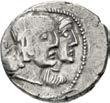
248. PERSIA, Achaemenid Empire. temp. Xerxes I to Darios II. Circa 485-420 BC. AV Daric (13mm, 8.25 g). LydoMilesian standard. Sardes mint. Persian king or hero, wearing kidaris and kandys, quiver over shoulder, in kneeling-running stance right, holding spear and bow / Incuse punch. Carradice Type IIIb, Group A/B (pl. XIII, 27); Meadows, Administration 321; BMC Arabia pl. XXIV, 26; Sunrise 24. Lustrous, a few trace deposits. Good VF. ($1500)
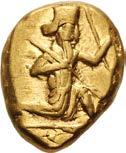



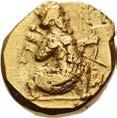

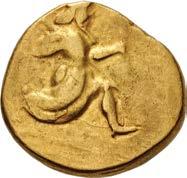
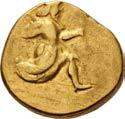
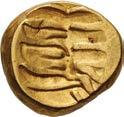
249. PERSIA, Alexandrine Empire. temp. Stamenes – Seleukos. Satraps of Babylon, circa 328/3-311 BC. AV Double Daric (19mm, 16.50 g). Imitating Achaemenid type. Persian king or hero, wearing kidaris and kandys, quiver over shoulder, in kneeling-running stance right, holding spear in right hand, bow in left; unclear control mark to left; Â to lower right / Patterned incuse punch. Cf. Nicolet-Pierre 1–4; cf. SNG Berry 1454–5; cf. Traité II 755 var. (same). Some minor roughness, scratch on obverse. VF. ($4000)
250. PERSIA, Alexandrine Empire. temp. Stamenes – Seleukos. Satraps of Babylon, circa 328/3-311 BC. AV Double Daric (20mm, 16.51 g). Imitating Achaemenid type. Persian king or hero, wearing kidaris and kandys, quiver over shoulder, in kneeling-running stance right, holding spear in right hand, bow in left; no control marks(?) / Patterned incuse punch. Triton XXV, lot 511; CNG 114, lot 435; Heritage 3089, lot 31033; otherwise, unpublished without control marks. Weakly struck off center and minor flan flaws on obverse. Near VF. ($3000)
The majority of the control marks on these double darics are in the left field, so it is possible that it is simply off the flan on this example.
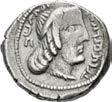
62
246 247
Pedigreed to 1951 – Referenced by Zervos
251. PTOLEMAIC KINGS of EGYPT. Ptolemy I Soter. As satrap, 323-305/4 BC. AR Tetradrachm (25mm, 17.21 g, 12h). In the name and types of Alexander III of Macedon. Memphis or Alexandreia mint. Struck circa 323-317 BC. Head of Herakles right, wearing lion skin / Zeus Nikephoros seated left; rose in left field, d5-o below throne. CPE 19; Svoronos –; Zervos Issue 2C, dies 202/i (this coin referenced); Price 3971 var. (position of letters on rev.). Lovely old collection tone, area of soft strike and a few old scratches in field on reverse. Good VF. Well centered. ($2000)
From the Collection of a London Novelist, purchased from Sovereign Rarities Ltd. Ex Dr. Walter Stoecklin (†1975) Collection (Nomos 14, 17 May 2017), lot 176 (his ticket included), purchased from Bank Leu, Zurich; Münzen und Medaillen AG FPL 105 (August 1951), no. 6.
252. PTOLEMAIC KINGS of EGYPT. Ptolemy I Soter. As satrap, 323-305/4 BC, or king, 305/4-282 BC. AR Tetradrachm (29mm, 15.65 g, 1h). Ptolemaic standard. In the name of Alexander III of Macedon. Uncertain Mint 3, probably Memphis. Struck circa 306-303 BC. Diademed head of the deified Alexander right, wearing elephant skin, aegis around neck / Athena Alkidemos advancing right; , to inner left; to right, È and eagle standing right on thunderbolt. CPE 89; Svoronos 139; Zervos Issue 67, obv. die 640; SNG Copenhagen 23; BMC 46 (same obv. die); Jameson 1000 (same obv. die); McClean 9769 (same obv. die). Old cabinet tone, bankers’ marks and test punch on obverse, a few light scratches under tone. Near EF. Well centered and struck. ($2000)

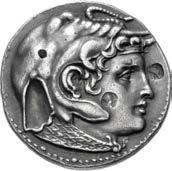

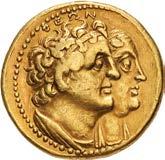



Ex Ken Bressett Collection.
and
285-
(27.5mm, 27.65 g, 12h). Alexandreia mint. Struck circa 272-261/0 BC. Conjoined busts of Ptolemy II and Arsinöe II right; Ptolemy is diademed and draped, Arsinöe is diademed and veiled; ÅdE¬fW@ above, shield to left / Conjoined busts of Ptolemy I and Berenike I; Ptolemy is diademed and draped, Berenike is diademed and veiled; QEW@ above. CPE 313; Svoronos 603α (same dies); Olivier & Lorber dies 14/52, 125 (this coin); SNG Copenhagen 132; Adams III 2083; Boston MFA 2274; Dewing 2752; Kraay & Hirmer 801; Noeske 37. Lightly toned, a few light scratches and marks, minor edge marks from prior bezel. VF. ($7500)
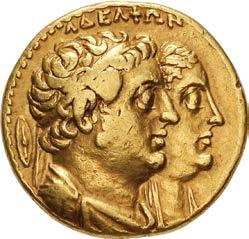

AV
Ex Birger Bentsen Collection (Leu Numismatik Web Auction 16, 22 May 2021), lot 48; Nomos Obolos 14 (15 December 2019), lot 323; Stack’s Bowers & Ponterio 174 (11 January 2013), lot 304.
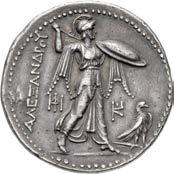
63
253. PTOLEMAIC KINGS of EGYPT. Ptolemy II Philadelphos, with Arsinöe II, Ptolemy I,
Berenike I.
246 BC.
Mnaieion – ‘Oktadrachm’
254. PTOLEMAIC KINGS of EGYPT. Ptolemy II Philadelphos. 285-246 BC. AR Tetradrachm (28mm, 13.31 g, 11h). Uncertain mint 23, imitating Ptolemaïs (Ake). Dated RY 32 (254/3 BC). Diademed head of Ptolemy I right, aegis around neck / Eagle with closed wings standing left on thunderbolt; to left, fi above ¬E; to right, Å∫ above Q. CPE 700; Lorber, Mint 6; Svoronos 776; SNG Copenhagen –. Underlying luster, a few light scratches on obverse. Near EF. ($500)
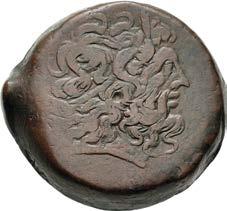
Extremely Rare Issue – CPE Plate Coin
255. PTOLEMAIC KINGS of EGYPT. Ptolemy IV Philopator. 222-205/4 BC. Æ Tetrobol (37.5mm, 51.01 g, 12h). Alexandreia mint. Series 5F, struck circa 219-205/4 BC. Diademed head of Zeus-Ammon right / Eagle, wings spread, standing left, head right, on thunderbolt; W between legs; c/m: cornucopia within incuse rectangle. CPE B519 (this coin referenced, illustrated [erroneously] as B515); Svoronos –; SNG Copenhagen –. Earthen brown surfaces. VF. Extremely rare, none in CoinArchives, nor CPE; only three noted in CPE (all in the market). ($400)
Ex WCM Collection; A European Ptolemaic Collection (VAuctions 218, 18 December 2008), lot 86.

Very Rare Sidon Issue
256. PTOLEMAIC KINGS of EGYPT. Ptolemy IV Philopator. 222-205/4 BC. AR Tetradrachm (25mm, 14.01 g, 12h). Sidon mint. Struck circa 219-217 BC. Jugate draped busts right of Serapis, wearing laurel wreath with small atef crown above his forehead, and Isis, wearing grain ear wreath with miniature horned disc above her forehead / ∫Å%5¬EW%
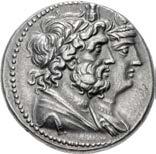

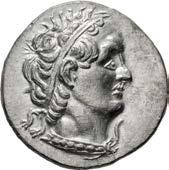
∏to¬EÂÅ5oU, eagle standing left, head right, on thunderbolt; filleted double cornucopia over shoulder, no control marks. CPE 934; Svoronos –; Landvatter Group 4, 86 (O26/R75); SNG Copenhagen –. Lightly toned, some faint cleaning marks. Near EF. Very rare Sidon issue without control marks, only eight noted by Landvatter, one additional in CoinArchives (Nomos 20, lot 287 [hammer 11,000 CHF]). ($7500)

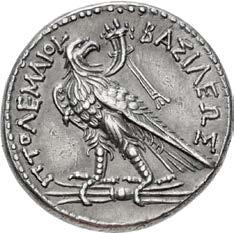

64
257. PTOLEMAIC KINGS of EGYPT. Ptolemy V Epiphanes. 204-180 BC. AR Tetradrachm (25mm, 14.09 g, 12h). Alexandreia or an uncertain mint in Phoenicia. Struck circa 199/7 BC. Diademed head of Ptolemy I right, wearing aegis around neck / Eagle standing left, wings closed, on thunderbolt; 6 to left, spearhead to right. Svoronos 1250; Carlen, Spearhead, Group 1, 13–4 (O3/R7); SNG Copenhagen –; BMC 53–4. Slight weakness to strike, cleaning scratches. VF. Rare. ($1000)

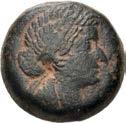

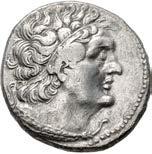
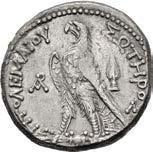
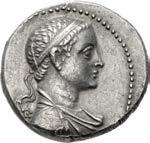
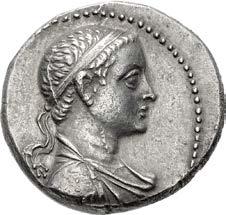
258.
KINGS of EGYPT. Ptolemy V Epiphanes. 204-180 BC. AR Tetradrachm (25mm, 14.14 g, 12h). Tyre mint. Struck circa 202-200 BC. Diademed and draped bust right / Eagle standing left on thunderbolt; to left, club surmounted by Tyre monogram; @5 to right, d5 between legs. Svoronos 1297; Olivier 2877–9 (D4/R77); SNG Copenhagen –; Pozzi 3250 (same dies). Lightly toned, trace deposits, faint cleaning marks, die break on obverse. Near EF. High relief portrait. Very rare, only six examples noted by Olivier, four additional in CoinArchives. ($1500)
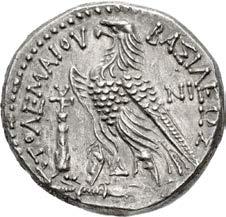
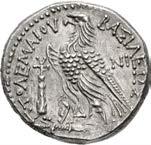
VIII Euergetes II (Physcon). 145-116 BC. Æ Drachm (44mm, 65.60 g, 12h). Kyrene mint. Diademed head of Zeus-Ammon right / Filleted double cornucopia; f to left. Svoronos 1640; Asolati 82; Buttrey, Coins 74; SNG Copenhagen –. Dark red-brown patina, some roughness, a hint of smoothing, area of weak strike. VF. ($500)
Ex WCM Collection; Freeman & Sear 11 (23 November 2004), lot 221.
of EGYPT. Kleopatra VII Thea Neotera. 51-30 BC. Æ Obol – 40 Drachmai (20mm, 7.92 g, 12h). Alexandreia mint. Diademed and draped bust right / Eagle standing left on thunderbolt; cornucopia to left, Â (mark of value) to right. Svoronos 1872; SNG Copenhagen 422–4. Earthen black surfaces, some tooling. Near VF. ($750)

65
PTOLEMAIC
259. PTOLEMAIC KINGS of EGYPT. Ptolemy
260. PTOLEMAIC KINGS
261. KYRENAICA, Kyrene. temp. Magas. Circa 294-275 BC. AR Didrachm (19.5mm, 7.84 g, 11h). Head of Zeus Karneios left / Silphion plant; stars across upper fields. BMC 237; SNG Copenhagen 1237. Light marks, areas of find patina. VF. ($750)
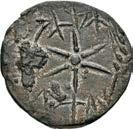
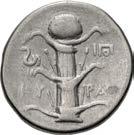
262. KYRENAICA, Kyrene. temp. Magas. Circa 294-275 BC. AR Didrachm (21mm, 7.57 g, 12h). Head of Zeus Karneios left / Silphion plant; to upper left, serpent coiled left; 5† to upper right. BMC 243–5; SNG Copenhagen 1239. Minor roughness. VF. ($750)
263. KYRENAICA, Kyrene. temp. Magas. Circa 294-275 BC. AR Didrachm (21mm, 7.66 g, 12h). Head of Zeus Karneios right / Silphion plant; 0 to upper left, crab to upper right, ˚U-rÅ across lower field. BMC 255; SNG Copenhagen 1243 var. (control marks in lower fields). Lightly toned. VF. Struck on a broad flan. ($500)
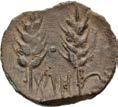
264. KINGS of NUMIDIA or MAURETANIA. Uncertain. 1st century BC. Æ Unit(?) (26mm, 8.77 g, 1h). Head of male left / Head of female right. MAA 39; Mazard 101; SNG Copenhagen –. Brown surfaces. Near VF. Extremely rare. ($500)
265. MAURETANIA, Lixus. Circa 50-1 BC. Æ Half Unit (21mm, 4.33 g, 1h). Male head right, wearing tall bonnet with hanging cord / Two grape bunches. MAA 174; Mazard 642; SNG Copenhagen 704 var. (head left). Green and brown patina, some encrustation and roughness, edge chip. VF. Rare. ($300)
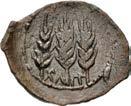


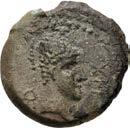



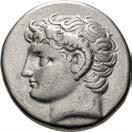
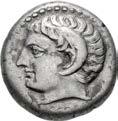
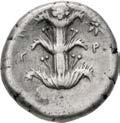
From the D.M.K. Collection.
266. MAURETANIA, ŠMŠ. Circa 50-1 BC. Æ Half Unit (21.5mm, 5.86 g, 10h). Facing head of Baal-Melkart / Star between grape cluster and grain ear. MAA 179; Mazard 645 (Lixus); SNG Copenhagen 707–11 (Lixus). Dark green-brown patina. Near EF. ($500)
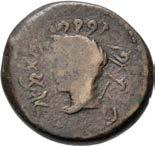
From the D.M.K. Collection.
267. KINGS of MAURETANIA. Boccus I and successors. 118-33 BC. Æ Half Unit(?) (18.5mm, 2.90 g, 1h). Tingi mint. Bearded head right / Two grain ears; pellet between. MAA 48; Mazard 600 (Tingi civic); SNG Copenhagen 728 (same). Earthen brown patina. VF. Very rare. ($300)
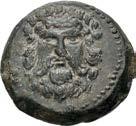
From the D.M.K. Collection.
268. KINGS of MAURETANIA. Boccus I and successors. 118-33 BC. Æ Half Unit(?) (20.5mm, 3.30 g, 6h). Tingi mint. Bearded head right / Three grain ears. MAA 49; Mazard 607 (Tingi civic); SNG Copenhagen 728 (same). Rough greenbrown patina. VF. Very rare. ($300)
From the D.M.K. Collection.
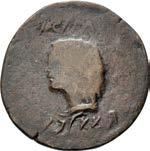
66
261 262 263 264 265 266 267 268
From the D.M.K. Collection.
The Benevolent Rule of Juba II and Kleopatra Selene
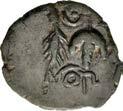
little roughness. VF. Very rare. ($1000)
From the D.M.K. Collection.
Juba II was born about 50 BC, the son of King Juba of Numidia who lost his kingdom and his life following Caesar’s victory over the Pompeians at Thapsus in 46 BC. The child was brought to Rome to adorn the dictator’s triumph and then remained in the capital, where he received his education and was later granted Roman citizenship. During this time, he became a close friend of Octavian, thirteen years his senior. In 25 BC, Octavian, now Rome’s first emperor under the name of Augustus, granted his friend Juba the North African Kingdom of Mauretania, which had been annexed by the Romans following the death of Bocchus III in 33 BC. About five years later, Juba II married the 20-year-old Kleopatra Selene, daughter of Mark Antony and Queen Kleopatra VII of Egypt, who had been brought up by the emperor’s sister, Octavia, following her parents’ suicide in Alexandria in 30 BC. Their rule over Mauretania was benevolent, and quite prosperous, though there were constant border security problems. Juba survived to an advanced age and was eventually succeeded by Ptolemy, his son by Kleopatra Selene, in AD 24.
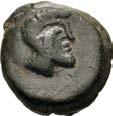




From the D.M.K. Collection.

67
269. KINGS of MAURETANIA. Boccus I and successors. 118-33 BC. Æ Half Unit (18mm, 5.29 g, 9h). Sala mint. Bearded head right / Grain ear and grape bunch; pellet-in-crescent above. MAA 51; Mazard 650 (Sala civic); SNG Copenhagen 715–6 (same). Dark green-brown patina, slightly off center, light smoothing. VF. Very rare. ($300)
270. KINGS of MAURETANIA. Juba II, with Kleopatra Selene. 25 BC-AD 24. AR Denarius (17.5mm, 3.44 g, 4h). Caesarea mint. Dated RY 6 (20/19 BC). Diademed head of Juba left; date in legend to left / Head of Kleopatra Selene left. Spoerri-Butcher Group 1.b, – (unlisted dies); Mazard 357; MAA 114; SNG Copenhagen 546. Find patina, some porosity and a
271. KINGS of MAURETANIA. Juba II. 25 BC-AD 24. Æ Half Unit (21mm, 4.47 g, 12h). ŠMŠ mint. Diademed head right / Bearded head facing. MAA 238; Mazard 396; SNG Copenhagen 632. Dark green-brown patina, some smoothing. VF. Very rare. ($300)
Extremely Rare Denarius of Kleopatra Selene
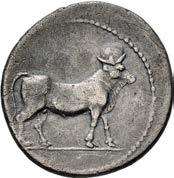


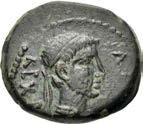

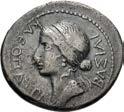


272. KINGS of MAURETANIA. Kleopatra Selene. Queen, wife of Juba II, 25 BC-AD 24. AR Denarius (20mm, 3.45 g, 2h). Caesarea mint. Diademed and draped bust left / Bull, head surmounted by globe, standing right. MAA 109; Mazard 393; SNG Copenhagen –. Toned, light porosity, scratches and marks. VF. Extremely rare, none in CoinArchives. ($3000)
From the D.M.K. Collection.
Kleopatra Selene, along with her brothers Alexander Helios and Ptolemy Philadelphos, were brought to Rome following Octavian’s victory at Actium. Kleopatra’s hand was given to Juba II, Augustus’ loyal client king of Mauretania, sometime between 26 and 20 BC. She reigned in Mauretania alongside Juba II and is frequently depicted with him, and rarely by herself, on the kingdom’s silver coinage. The date of her death is a matter of debate, possibly occurring sometime around AD 4 or as late as AD 17. Her brothers presumably died in childhood, either naturally or by assassination.
Ptolemy - Last of the Ptolemies and the Final King of Mauretania
Ptolemy of Mauretania was the last independent king of North Africa and the final ruler who could plausibly claim descent from Ptolemy I Soter of Egypt. He was the son of Juba II and Kleopatra Selene, the daughter of the famous Egyptian queen Kleopatra VII, whose hand was given to Juba by Augustus. Ptolemy seems not to have been as strong a leader as his revered father or grandmother. After his father’s death in AD 24, increasing restiveness among the native tribes led to the outbreak of several revolts, which he could not quell. He eventually ran afoul of the emperor Caligula, and was called to Rome in AD 39 or 40, whereupon he was put to death. Mauretania was formally annexed to the Empire in AD 44, and the revolts were brutally crushed by Roman legions.
The exact date of the beginning of Ptolemy’s reign is not currently known, though he certainly ruled alongside his father during the final years of Juba’s reign. The only firm date in the historical record for Ptolemy’s reign is his final year, AD 40, but there is disagreement among scholars as to when Ptolemy was called to Rome, and when he actually departed Mauretania. This could have been as early as late AD 39, or as late as early AD 40. Assuming his year 20 coins are his latest, would place the beginning of his first year as early as AD 20 or as late as AD 21. It must be pointed out, though, that without knowing the date of his elevation by Juba, there is a possibility that the year 20 coins are not his latest.
The following run of 22 silver denarii struck by this last Ptolemaic king is the largest ever entered in a single auction.
AD circa 20/1-40. AR Denarius (15.5mm, 2.11 g, 12h). Caesarea mint. Dated RY 1 (circa AD 20/1 or 21/2). Diademed and draped bust right / Palm tree. MAA 248; Mazard 414; SNG Copenhagen –. Toned, light roughness, faint cleaning scratches, indications of undertype on reverse. VF. Very rare, only one example in CoinArchives (Triton XXIV, lot 35). ($1000)
From the D.M.K. Collection.
274. KINGS of MAURETANIA. Ptolemy. AD circa 20/1-40. Æ Half Unit (22.5mm, 6.81 g, 7h). Caesarea mint. Dated RY 1 (circa AD 20/1 or 21/2). Diademed and draped bust right / Draped bust of Africa right, wearing elephant headdress; barley grain to right. MAA 353; Mazard 497; SNG Copenhagen 664. Dark green patina, some encrustation, cleaning scratches. VF. Very rare, one in CoinArchives (CNG E-477, lot 214 [hammer $900] = CNG 100, lot 1618). ($500)
From the D.M.K. Collection.
68
273. KINGS of MAURETANIA. Ptolemy.
275. KINGS of MAURETANIA. Ptolemy. AD circa 20/1-40. AR Denarius (16mm, 2.09 g, 7h). Caesarea mint. Dated RY 6 (circa AD 25/6 or 26/7). Diademed and draped bust right / Club within wreath. MAA 265; Mazard 431; SNG Copenhagen 639. Find patina, small scuff on reverse. Good VF. Very rare, none in CoinArchives. ($1000)
From the D.M.K. Collection.
276. KINGS of MAURETANIA. Ptolemy. AD circa 20/1-40. AR Denarius (15mm, 1.68 g, 8h). Caesarea mint. Dated RY 6 (circa AD 25/6 or 26/7). Diademed and draped bust right / Draped curule chair, surmounted by laurel wreath, against which rests a scepter. MAA 266; Mazard 441; SNG Copenhagen –. Toned, faint cleaning scratches and marks. VF. Very rare, one in CoinArchives, with different orientation of legend on reverse. ($1000)





From the D.M.K. Collection.
277. KINGS of MAURETANIA. Ptolemy. AD circa 20/1-40. AR Denarius (15.5mm, 2.23 g, 10h). Caesarea mint. Dated RY 6 (circa AD 25/6 or 26/7). Diademed and draped bust right / Capricorn right; cornucopia over shoulder. MAA 267; Mazard 453; SNG Copenhagen 640. Toned, some find patina, minor marks, light roughness. Good VF. Very rare, none in CoinArchives. ($750)
From the D.M.K. Collection.
278. KINGS of MAURETANIA. Ptolemy. AD circa 20/1-40. AR Denarius (15mm, 1.98 g, 7h). Caesarea mint. Dated RY 7(?) (circa AD 26/7 or 27/8). Diademed and draped bust right / Draped curule chair, surmounted by laurel wreath, against which rests a scepter; date partially off flan. MAA 278; Mazard 442; SNG Copenhagen –. Find patina. Good VF. Very rare, none in CoinArchives. ($750)









From the D.M.K. Collection.
Although the final digits of the date are off the flan, year 7 is the only date where the date is arranged across the upper field as here.
279. KINGS of MAURETANIA. Ptolemy. AD circa 20/1-40. AR Denarius (14.5mm, 1.97 g, 6h). Caesarea mint. Dated RY 8 (circa AD 27/8 or 28/9). Diademed and draped bust right / Draped curule chair, surmounted by laurel wreath, against which rests a scepter. MAA 286; Mazard 443; SNG Copenhagen 646. Find patina, a little off center, scratch on obverse. VF. Very rare, one in CoinArchives (Heritage 3101, lot 32062). ($750)
From the D.M.K. Collection.
280. KINGS of MAURETANIA. Ptolemy. AD circa 20/1-40. AR Denarius (15.5mm, 1.98 g, 9h). Caesarea mint. Dated RY 9 (circa AD 28/9 or 29/30). Diademed and draped bust right / Capricorn right; cornucopia over shoulder. MAA 296; Mazard 456; SNG Copenhagen 647. Find patina. Good VF. Very rare, none in CoinArchives. ($1000)
From the D.M.K. Collection.
281. KINGS of MAURETANIA. Ptolemy. AD circa 20/1-40. AR Denarius (16mm, 2.34 g, 11h). Caesarea mint. Dated RY 10 (circa AD 29/30 or 30/1). Diademed and draped bust right / Palm tree. MAA 300; Mazard 420 (same obv. die as illustration); SNG Copenhagen 651. Toned, light roughness. Near EF. Very rare, none in CoinArchives. ($1500)
From the D.M.K. Collection.
69
275 276 277 278 279 280 281
282. KINGS of MAURETANIA. Ptolemy. AD circa 20/1-40. AR Denarius (14.5mm, 1.94 g, 12h). Caesarea mint. Dated RY 12 (circa AD 31/2 or 32/3). re-x • pTOLe, diademed and draped bust right / Club within wreath. MAA 311 corr. (obv. legend); Mazard 436 corr. (same; same dies as illustration); SNG Copenhagen 653 (same dies). Lightly toned, slight roughness. Near EF. Very rare, none in CoinArchives. ($1000)
From the D.M.K. Collection.
283. KINGS of MAURETANIA. Ptolemy. AD circa 20/1-40. AR Denarius (15mm, 1.62 g, 5h). Caesarea mint. Dated RY 12 or 13 (circa AD 31/2–33/4). rex pTOL, diademed and draped bust right / Club within wreath; rA xii (or xiii) along lower edge. Cf. MAA 311 and 320; cf. Mazard 436 and 467; cf. SNG Copenhagen 653. Toned, a little off center, flan flaw on obverse. EF. Unpublished with this obverse legend, extremely rare thus. ($1000)











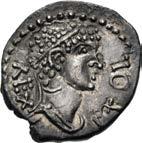


From the D.M.K. Collection.
284. KINGS of MAURETANIA. Ptolemy. AD circa 20/1-40. AR Denarius (14.5mm, 2.00 g, 3h). Caesarea mint. Dated RY 13 (circa AD 32/3 or 33/4). Diademed and draped bust right / Capricorn right; cornucopia over shoulder. MAA 322; Mazard 459; SNG Copenhagen –. Lightly toned, a few flan flaws, some die wear on obverse. Near EF. Very rare, none in CoinArchives. ($1000)
From the D.M.K. Collection.
285. KINGS of MAURETANIA. Ptolemy. AD circa 20/1-40. AR Denarius (14.5mm, 2.10 g, 1h). Caesarea mint. Dated RY 16 (circa AD 35/6 or 36/7). Diademed and draped bust right / Club within wreath. MAA 333; Mazard Supp. III 438 bis; SNG Copenhagen –. Find patina. Near EF. Very rare, none in CoinArchives. ($750)
From the D.M.K. Collection.
286. KINGS of MAURETANIA. Ptolemy. AD circa 20/1-40. AR Denarius (14.5mm, 2.15 g, 3h). Caesarea mint. Dated RY 16 (circa AD 35/6 or 36/7). Diademed and draped bust right / Grain ear within wreath. MAA 339; Mazard 491 bis; SNG Copenhagen –. Toned. EF. Struck from fresh dies. Very rare, none in CoinArchives. ($1500)
From the D.M.K. Collection.
287. KINGS of MAURETANIA. Ptolemy. AD circa 20/1-40. AR Denarius (13.5mm, 1.98 g, 10h). Caesarea mint. Dated RY 16, 17, or 18 (circa AD 35/6–38/9). Diademed and draped bust right / Draped curule chair, surmounted by laurel wreath, against which rests a scepter; traces of final digit(s) of date visible at lower edge. Cf. MAA 335, 343, or 346; Mazard 449, 450, or Mazard Suppl. III 449 bis; cf. SNG Copenhagen 660. Toned, extensive cleaning scratches, die breaks on reverse. Good VF. Very rare, none in CoinArchives. ($1000)
From the D.M.K. Collection.
70
284 285 286 287
288. KINGS of MAURETANIA. Ptolemy. AD circa 20/1-40. AR Denarius (14.5mm, 1.94 g, 11h). Caesarea mint. Dated RY 17 (circa AD 36/7 or 37/8). Diademed and draped bust right / Capricorn right; cornucopia over shoulder. MAA 341; Mazard 463; SNG Copenhagen –. Find patina, light scratches on obverse. Near EF. Very rare, possibly only one in CoinArchives (but the date is partially obscured; also, another coin is incorrectly attributed). ($1000)
From the D.M.K. Collection.
289. KINGS of MAURETANIA. Ptolemy. AD circa 20/1-40. AR Denarius (15mm, 1.97 g, 5h). Caesarea mint. Dated RY 17 (circa AD 36/7 or 37/8). Diademed and draped bust right / Cornucopia; transverse scepter in background. MAA 342; Mazard 476; SNG Copenhagen –. Find patina. Good VF. Very rare, none in CoinArchives. ($750)
From the D.M.K. Collection.
290. KINGS of MAURETANIA. Ptolemy. AD circa 20/1-40. AR Denarius (14.5mm, 2.18 g, 7h). Caesarea mint. Dated RY 17 (circa AD 36/7 or 37/8). Diademed and draped bust right / Draped curule chair, surmounted by laurel wreath, against which rests a scepter. MAA 343; Mazard Suppl. III 449 bis; SNG Copenhagen 660. Deep iridescent tone, minor roughness, a little off center. Near EF. Very rare, none in CoinArchives. ($750)
From the D.M.K. Collection.
291. KINGS of MAURETANIA. Ptolemy. AD circa 20/1-40. AR Denarius (15mm, 1.64 g, 7h). Caesarea mint. Dated RY 20 (circa AD 39/40). Diademed and draped bust right / Three crossed grain ears. MAA 349; Mazard 496; SNG Copenhagen –. Find patina, numerous cleaning scratches. VF. Very rare, only one in CoinArchives. ($1000)
From the D.M.K. Collection.
292. KINGS of MAURETANIA. Ptolemy. AD circa 20/1-40. AR Denarius (14mm, 1.62 g, 7h). Caesarea mint. Dated RY 20 (circa AD 39/40). re[x pTOLe]ÂWE¨ (sic), diademed and draped bust right / Altar decorated with r A above wreath; [piet]-¬t5 to right, cc (date) below. Cf. MAA 350; cf. Mazard 429; SNG Copenhagen –; Roma E-Sale 69, lot 238 (same rev. die). Most find patina remaining, compact flan, minor roughness, cleaning scratches on obverse. VF. Very rare, only one in CoinArchives. ($1000)












From the D.M.K. Collection.
293. KINGS of MAURETANIA. Ptolemy. AD circa 20/1-40. AR Denarius (13.5mm, 2.33 g, 7h). Caesarea mint. Dated RY 20 (circa AD 39/40). Diademed and draped bust right / Kerykeion between two grain ears. Roma XIX, lot 261; Roma E-Sale 69, lot 27; otherwise, unpublished. Lightly toned, numerous cleaning scratches, roughness on obverse. VF. Very rare, only two in CoinArchives. ($750)

From the D.M.K. Collection.
294. KINGS of MAURETANIA. Ptolemy. AD circa 20/1-40. AR Denarius (15.5mm, 1.77 g, 7h). Caesarea mint. Dated RY 20 (circa AD 39/40). Diademed and draped bust right / Draped curule chair, surmounted by laurel wreath, against which rests a scepter. Unpublished. Rough find patina, numerous cleaning scratches. VF. Extremely rare, none in CoinArchives. ($750)

From the D.M.K. Collection.
End of Session 1
71
288 289 290 291 292 293 294
Session 2 – Tuesday, May 23, 2023 — 2 PM
ORIENTAL GREEK COINAGE


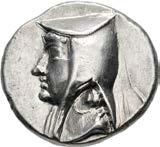
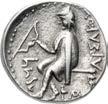
295. KINGS of PARTHIA. Arsakes I. 247-211 BC. AR Drachm (18mm, 4.16 g, 12h). Mithradatkart - Nisa(?) mint. Head left, wearing bashlyk / yrnk (krny = “commander-in-chief” in Aramaic) to left, ÅrsÅ˚oU to right, archer (Arsakes I) seated left on backless throne, holding bow; § below throne. Sellwood 3.1; A&S Type 3 (unlisted dies); Sunrise 238; Shore 2. Light iridescent toning, hint of die rust on reverse. Good VF. Very rare. ($1500)

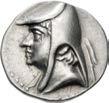
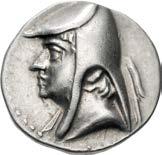
From the Nisa Collection.
296. KINGS of PARTHIA. Arsakes I. 247-211 BC. AR Drachm (17mm, 4.17 g, 12h). Mithradatkart-Nisa(?) mint. Head left, wearing bashlyk / ÅrsÅ˚oU to left, yrnk (krny = “commander-in-chief” in Aramaic) to right, Archer (Arsakes I) seated right on backless throne, holding bow; § below throne. Sellwood 4.1; A&S Type 4/10 (same dies); Sunrise 239; Shore –. Hint of porosity, small die break on obverse, traces of underlying luster. Good VF. Very rare. ($1500)
From the Nisa Collection.
297. KINGS of PARTHIA. Arsakes I. 247-211 BC. AR Drachm (18mm, 4.19 g, 11h). Hekatompylos mint. Head left, wearing bashlyk / Archer (Arsakes I) seated right on backless throne, holding bow; ~ to right. Sellwood 5.1 (Arsakes II); A&S Type 5, 11 (Arsakes II; same dies); Sunrise 240; Shore 3 (Arsakes II). Iridescent toning, obverse struck with worn die. EF. ($500)
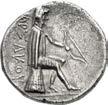


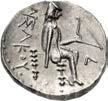

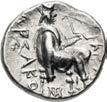

298. KINGS of PARTHIA. Artabanos I (Arsakes II). 211-185 BC. AR Drachm (16mm, 4.10 g, 12h). RhagaiArsakeia(?) mint. Struck circa 211-209 BC. Head left, wearing bashlyk / Archer (Arsakes I) seated right on backless throne, holding bow; to right, eagle standing facing, head left. Sellwood 6.1; A&S Type 6 (dies 12 and 46); cf. Sunrise 241-3 (for type); cf. Shore 4 (same); Todd Ballen Collection (Triton XII, 5 January 2010), lot 507 (same obv. die). Iridescent toning, slight marks, traces of die rust. EF. ($500)
299. KINGS of PARTHIA. Phriapatios. 185-170 BC. AR Drachm (17.5mm, 3.87 g, 12h). Hekatompylos mint. Head left, wearing bashlyk / Archer (Arsakes I) seated right on omphalos, holding bow. Sellwood 7.1 (Mithradates I); Sunrise 245 (Artabanos I [Arsakes II]); Shore 5 corr. (Mithradates I; Sellwood 7.1, not 8.1). Toned with traces of iridescence, light porosity, some cleaning marks. Near EF. ($500) From the Nisa Collection.
72
297 298 299
300. KINGS of PARTHIA. Phriapatios. 185-170 BC. AR Drachm (19.5mm, 4.16 g, 12h). Hekatompylos mint. Head left, wearing bashlyk / Archer (Arsakes I) seated right on omphalos, holding bow. Sellwood 7.1 (Mithradates I); Sunrise 246 (Artabanos I [Arsakes II]; same obv.die); Shore 5 corr. (Mithradates I; Sellwood 7.1, not 8.1). Toned with traces of iridescence, light porosity, some cleaning marks. Near EF. ($500)
From the Nisa Collection.
301. KINGS of PARTHIA. Phriapatios. 185-170 BC. AR Drachm (21mm, 3.87 g, 12h). Hekatompylos mint. Head left, wearing bashlyk / Archer (Arsakes I) seated right on omphalos, holding bow. Sellwood 8.1 (Mithradates I); Sunrise 248 (Artabanos I [Arsakes II]); cf. Shore 6 (Mithradates I). Iridescent toning, some porosity and crystallized surfaces. Near EF. Struck on broad flan. Rare. ($500)
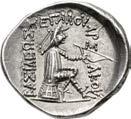


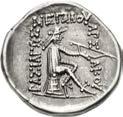

From the Nisa Collection.
302. KINGS of PARTHIA. Phriapatios. 185-170 BC. AR Drachm (18mm, 3.58 g, 12h). Hekatompylos mint. Head left, wearing bashlyk and earring / Archer (Arsakes I) seated right on omphalos, holding bow. Sellwood 8.1 (Mithradates I); Sunrise 248; Shore 5-6. Deposits, scratches. Near EF. Rare. ($500)
303. KINGS of PARTHIA. Phriapatios. 185-170 BC. AR Drachm (22mm, 3.79 g, 12h). Hekatompylos mint. Head left, wearing bashlyk / Archer (Arsakes I) seated right on omphalos, holding bow. Sellwood 10.15 (Mithradates I); Sunrise –; Shore –. Bright surfaces, some doubling on reverse. Near EF. ($500)
From the Nisa Collection.
304. KINGS of PARTHIA. Phriapatios to Mithradates I. Circa 185-132 BC. AR Drachm (19mm, 4.22 g, 12h). Hekatompylos mint. Head left, wearing bashlyk / Archer (Arsakes I) seated right on omphalos, holding bow. Sellwood 9.1 (Mithradates I); Sunrise 251-2; Shore 7-8 corr. (Mithradates I). Iridescent toning, light porosity and die rust. EF. Attractive, well centered strike. ($500)
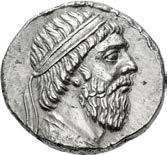

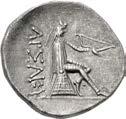

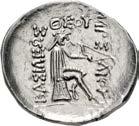
From the Nisa Collection.
305. KINGS of PARTHIA. Mithradates I. 165-132 BC. AR Drachm (20mm, 4.47 g, 12h). Hekatompylos mint. Struck circa 141-132 BC. Diademed bust left within bead-and-reel border / Archer (Arsakes I) seated right on omphalos, holding bow. Sellwood 11.1; Sunrise 265-6; Shore 24. Toned with some iridescence, a couple of light scratches under tone. Good VF. ($750)

306. KINGS of PARTHIA. Mithradates I. 165-132 BC. AR Drachm (21mm, 3.95 g, 12h). Hekatompylos mint. Struck circa 141-132 BC. Diademed bust left within bead-and-reel border / Archer (Arsakes I) seated right on omphalos, holding bow. Sellwood 11.1; Sunrise 265-6; Shore 24. Iridescent toning, area of peripheral flat strike on obverse, crystallized surfaces, a couple of tiny hairline die breaks. EF. ($500)
From the Nisa Collection.
307. KINGS of PARTHIA. Mithradates I. 165-132 BC. AR Tetradrachm (28mm, 15.25 g, 12h). Seleukeia on the Tigris mint. Dated 173 SE (140/39 BC). Diademed bust right / Young Herakles standing left, holding skyphos and club; n to outer left; ˝or (date) in exergue. Sellwood 13.3; Sunrise 261; Shore 36. Slight iridescent toning, traces of deposits, traces of die rust and flan flaws, slight double strike on obverse, reverse struck with worn die. Good VF. ($1500)


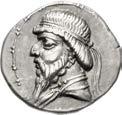
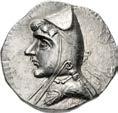

73
303 304 305 300 301 302 307 306
308. KINGS of PARTHIA. Mithradates I. 165-132 BC. AR Drachm (17mm, 3.52 g, 12h). Seleukeia on the Tigris mint. Struck circa 141-138 BC. Diademed and bearded bust right / Zeus Aëtophoros seated left; Q in exergue. Sellwood 13.6; Sunrise 263; Shore –. Toned with some iridescence, minor roughness and porosity, flan crack. Good VF. Rare. ($750)
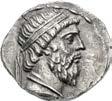
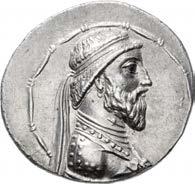
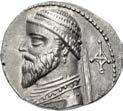



Ex Shore Collection
309. KINGS of PARTHIA. Phraates II. 132-126 BC. AR Drachm (21mm, 3.87 g, 12h). Nisa mint. Struck circa 128127 BC. Diademed bust left; trace of @5 down right / Archer (Arsakes I) seated right on omphalos, holding bow. Sellwood 16.6; Sunrise 271; Shore 46 (this coin). Iridescent toning, crystallized surfaces. Near EF. Struck on a broad flan. ($500)
From the Nisa Collection. Ex Fred B. Shore Collection (Classical Numismatic Group 36, 5 December 1995), lot 46.
310. KINGS of PARTHIA. Phraates II. 132-127 BC. AR Tetradrachm (31.5mm, 15.87 g, 12h). Seleukeia on the Tigris mint. Struck circa 129 BC. Diademed bust right / Male deity seated left, holding Nike, who crowns him with wreath, in extended right hand, cradling cornucopia in left arm; p to outer left, o in exergue. Sellwood 17.1 var. (placement of monograms); Sunrise 267; Shore –. Light iridescent toning, porosity, cleaning scratches. Good VF. Very rare. ($1500)


From the Nisa Collection.
311. KINGS of PARTHIA. Artabanos III. 126-122 BC. AR Drachm (20mm, 3.93 g, 12h). Ekbatana mint. Diademed bust left; q to right / Archer (Arsakes I) seated right on omphalos, holding bow. Sellwood 20.3; Sunrise 279; Shore 61. Iridescent toning, traces of find patina, light roughness. EF. Very rare. ($500)
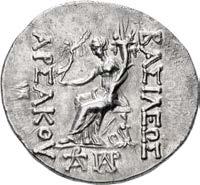
312. KINGS of PARTHIA. Artabanos III. 126-122 BC. AR Tetradrachm (33mm, 16.09 g, 12h). Seleukeia on the Tigris mint. Diademed bust right / Demeter seated left, holding cornucopia and Nike, who crowns her with wreath; winged tritoness supporting throne; to outer left, horse’s head left; ûs in exergue. Sellwood 21.4 var. (no horse’s head); Sunrise 275 var. (same); Shore –; PDC 31011. Light iridescent toning, porosity, light hairlines, slight double strike on reverse, obverse off center. Near EF. ($1500)
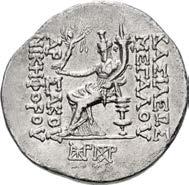

From the Nisa Collection.

74
309 311 312 308
313. KINGS of PARTHIA. Mithradates II. 121-91 BC. AR Tetradrachm (29mm, 15.63 g, 12h). Seleukeia on the Tigris mint. Struck circa 120/19-109 BC. Diademed bust left / Archer (Arsakes I) seated right on omphalos, holding bow; palm to outer right; t¨ in exergue. Sellwood 24.4; Sunrise 284 (same dies); Shore 67. Slight iridescence, slight weakness at high point of bust, a touch off center. EF. Exceptional portrait. ($2000)
From the Nisa Collection.
314. KINGS of PARTHIA. Mithradates II. 121-91 BC. AR Drachm (22mm, 4.20 g, 12h). Ekbatana mint. Struck circa 120/19-109 BC. Diademed and draped bust left, wearing torque ending in sea-horse / Archer (Arsakes I) seated right on throne, holding bow. Sellwood 26.1; Sunrise 290; Shore 77. Bright surfaces, traces of die rust, obverse slightly off center. EF. Struck on a broad flan. ($500)

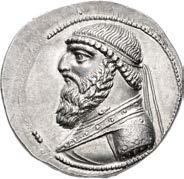
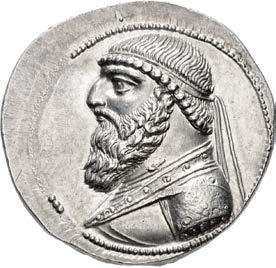
From the Nisa Collection.
315. KINGS of PARTHIA. Mithradates II. 121-91 BC. AR Drachm (21mm, 3.96 g, 12h). Ekbatana mint. Struck circa 119-109 BC. Diademed bust left / Archer (Arsakes I) seated right on omphalos, holding bow. Sellwood 24.9; Sunrise 286; Shore 69. Iridescent toning, light scratches, die rust on reverse. Good VF. ($500)
Extremely Rare Gotarzes Tetradrachm
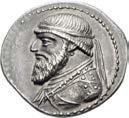




316. KINGS of PARTHIA. Gotarzes I. 91-87 BC. AR Tetradrachm (31mm, 14.20 g, 12h). Seleukeia on the Tigris mint. Bust left, wearing tiara decorated with eight-rayed star / Archer (Arsakes I) seated right on throne, holding bow; & to inner left; ˙ to inner right; palm to outer right. Sellwood 32.1 (Unknown King); Sunrise 304; Shore –. Iridescent toning, cleaning scratches, test cut on edge. VF. Uncertain Aramaic graffiti on obverse. Extremely rare. ($5000)

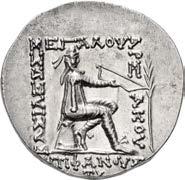
From the Nisa Collection.

75
314
315
317. KINGS of PARTHIA. Arsakes XVI. 78/7-62/1 BC. AR Drachm (18.5mm, 4.12 g, 12h). Ekbatana mint. Diademed bust left; torque ends in pellet / Archer (Arsakes I) seated right on throne, holding bow; empty cloak sleeve ends in pellet, and ends below seat level. Cf. Sellwood 30.14 (Unknown King); Sunrise –; cf. Shore 135. Iridescent toning, several tiny edge splits. Near EF. Portrait of fine style. ($500)
From the Nisa Collection.
318. KINGS of PARTHIA. Phraates III. Circa 70/69-58/7 BC. AR Drachm (20mm, 4.17 g, 12h). Mithradatkart mint. Struck circa 62 BC. Diademed facing bust, wearing necklace with medallion / Archer (Arsakes I) seated right on throne, holding bow; % below bow; Sellwood legend iii. Sellwood 35.4 var. (Darius?; rev. legend); Sunrise 328; Shore –. Iridescent toning. Near EF. ($750)
319. KINGS of PARTHIA. Phraates III. Circa 70/69-58/7 BC. AR Drachm (20mm, 4.21 g, 12h). Mithradatkart mint. Struck circa 62 BC. Diademed facing bust, wearing necklace with medallion / Archer (Arsakes I) seated right on throne, holding bow; ! below bow; Sellwood legend iii. Sellwood 35.5 (Darius?); Sunrise –; Shore 166. Iridescent toning, a few tiny die breaks. Near EF. ($750)
320. KINGS of PARTHIA. Phraates III. Circa 70/69-58/7 BC. AR Drachm (20mm, 4.16 g, 12h). Rhagai mint. Struck circa 62 BC. Diademed facing bust, wearing necklace with medallion / Archer (Arsakes I) seated right on throne, holding bow; Ç below bow; Sellwood legend i. Sellwood 35.7 var. (rev. legend); Sunrise 330-1; Shore 165. Iridescent toning, a couple of hairline die breaks and traces of die rust on obverse. Near EF. ($750)


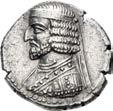


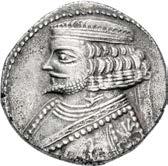
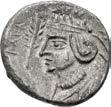
321. KINGS of PARTHIA. Phraates IV. Circa 38/7-2 BC. AR Tetradrachm (28mm, 14.81 g, 12h). Seleukeia on the Tigris mint. Dated Panemos 283 SE (June 30 BC). Diademed bust left / Phraates seated right, receiving hand of Tyche kneeling left, holding scepter; fl between; ˝∏4 (year) below throne; ∏Å@ (month) in exergue. Sellwood 53.1 var. (month); Sunrise –; Shore –; Callataÿ, Tétradrachmes –; PDC –; Zeno –. Iridescent toning, trace deposits, some porosity. VF. Graffiti m (mem in Parthian) on obverse. Extremely rare, none in CoinArchives. ($750)
From the Nisa Collection.
322. KINGS of PARTHIA. Phraatakes, with Musa. Circa 2 BC-AD 4. AR Drachm (19mm, 3.68 g, 12h). Susa mint. Struck circa AD 1-4. Diademed bust of Phraatakes left; Nikai flying to right [and left] crowning him with wreaths / Crowned bust of Musa left; palm frond to left. Sellwood 58.11; Sunrise –; Shore –; PDC 9668; Baldwin’s 90, lot 1236. Toned, porosity. Good VF. Extremely rare, only the Baldwin’s coin in CoinArchives. ($750)
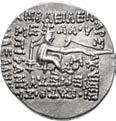

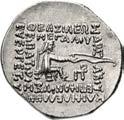
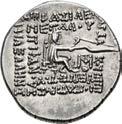

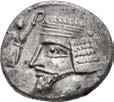
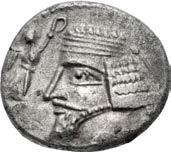
76
319
320
317 318
323. KINGS of PARTHIA. Artabanos V. Circa AD 80-90. AR Tetradrachm (29mm, 14.23 g, 12h). Seleukeia on the Tigris mint. Dated Apellaios 392 SE (November AD 80). Diademed bust left / Artabanos seated left, receiving open diadem from Tyche standing right, holding scepter; ∫Jt (year) above, G∏G#5o¨[¨] (month) in exergue. SNP 7, 843A-8; Sellwood 74.3 (Artabanos III); Sunrise 441 var. (month); Shore –. Some find patina and deposits, porosity, tiny edge splits and small flan crack. Good VF. ($500)
From the Nisa Collection.
324. KINGS of PARTHIA. Osroes I. Circa AD 108/9-127/8. AR Drachm (21mm, 3.74 g, 12h). Ekbatana mint. Diademed bust left, wearing long beard and with hair in bunches above head and over ears / Archer (Arsakes I) seated right on throne, holding bow; + below bow. Sellwood 80.1; Shore 442; Sunrise 443. Iridescent toning, hint of roughness. EF. ($500)
325. KINGS of PARTHIA. Osroes I. Circa AD 108/9-127/8. AR Drachm (20mm, 3.50 g, 12h). Ekbatana mint. Diademed bust left, wearing long beard and with hair in bunches above head and over ears / Archer (Arsakes I) seated right on throne, holding bow; + below bow. Sellwood 80.1; Shore 442; Sunrise 443. Toned with traces of iridescence, light roughness and porosity. EF. ($500)
From the Nisa Collection.
Heavy-Weight Drachm


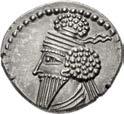


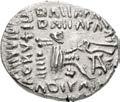
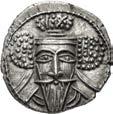
326. KINGS of PARTHIA. Osroes I. Circa AD 108/9-127/8. AR Drachm (19mm, 4.60 g, 12h). Ekbatana mint. Diademed bust left, wearing long beard and with hair in bunches above head and over ears; all within wreath(?) border / Archer (Arsakes I) seated right on throne, holding bow; + below bow. Sellwood 80.1; Shore 442; Sunrise 443. Light iridescence, traces of porosity and die rust, double strike on obverse, a couple of edge splits. Near EF. A heavy-weight specimen with unusually-cut hair. Very rare. ($500)


From the Nisa Collection.
327. KINGS of PARTHIA. Vologases V. Circa AD 191-208. AR Drachm (19mm, 3.73 g, 12h). Ekbatana mint. Diademed facing bust, wearing long beard and with hair in bunches above head and over ears / Archer (Arsakes I) seated right on throne, holding bow; e below bow; GLM ySGLy (wlkši mlk in Parthian) above. Sellwood 86.3; Sunrise 455; Shore 448. Toned, hairline flan crack, minor die break on obverse. EF. ($500)

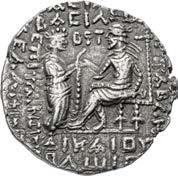
77
324
325
328. KINGS of PARTHIA. Vologases V. Circa AD 191-208. AR Drachm (19mm, 3.70 g, 12h). Ekbatana mint. Diademed facing bust, wearing long beard and with hair in bunches above head and over ears / Archer (Arsakes I) seated right on throne, holding bow; e below bow; GLM ySGLy (wlkši mlk in Parthian) above. Sellwood 86.3; Sunrise 455; Shore 448. Iridescent toning, flan crack. Near EF. ($500)

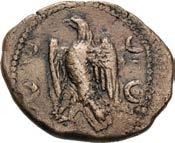
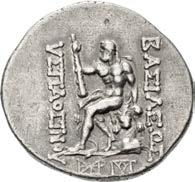
From the Nisa Collection.
329. KINGS of PARTHIA. Vologases V. Circa AD 191-208. AR Drachm (19mm, 3.60 g, 12h). Ekbatana mint. Diademed facing bust, wearing long beard and with hair in bunches above head and over ears / Archer (Arsakes I) seated right on throne, holding bow; e below bow; GLM ySGLy (wlkši mlk in Parthian) above. Sellwood 86.5; Sunrise 454 corr. (listed as Sellwood 86.3 and 448); Shore –. Iridescent toning, a few marks under tone. EF. ($500)
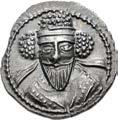
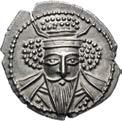
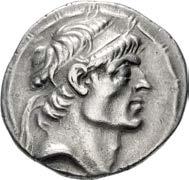
From the Nisa Collection.
330. KINGS of CHARACENE. Hyspaosines. Circa 128/7-124 BC. AR Tetradrachm (32mm, 16.34 g, 1h). Seleukia on the Tigris mint. Undated issue of SE 186 (127/6 BC). Diademed head right / Herakles seated left on rock, holding club on knee; oand ß in exergue. Assar fig. 14; De Morgan –; BMC –; Sunrise –; Zeno 251038 (= CNG 114, lot 460) var. (second monogram). Toned. VF. Extremely rare. ($1000)
Dr. Assar has suggested that the extreme rarity of this issue may be due to withdrawal from circulation and overstriking after the Parthian reconquest of Seleukeia. Dr. G.R.F. Assar, “Recent Studies in Parthian History: Part III,” The Celator, Vol. 15, no. 2 (February 2001) pp. 1722 (this coin illustrated as fig. 4).
A New Type Unknown to van’t Haaff
above anchor with two crossbars / Eagle standing left with wings displayed; four crescents around. van’t Haaf –, but cf. 14.2 (Phraates; drachm); Zeno –, but


78
328 329
331. KINGS of ELYMAIS. Orodes II. Early-mid 2nd century AD. Æ Tetradrachm (30mm, 14.43 g, 12h). !k¬M DWrW (wrwdh mlk’ in Parthian), diademed bust facing, wearing Parthian-style tiara decorated with star and pellet-in-crescent; to right, pellet-in-crescent
cf. 303456 (Orodes II; for obv.). Brown surfaces, areas of double strike. VF. Extremely rare, none in CoinArchives. ($750)
Very Rare Double-Engraved Reverse Legend – Overstruck on an Issue of Seleukos I
3 (zy ’lhy’ in Aramaic) up left, ¥ !KR†Rp †D3b (bgdt prtrk’ z in Aramaic) down right, 3˚2/%;a 3¥ aKR†Rp †D3b (bgdt prtrk’ zy ’lh/hyy [sic] in Aramaic) flanking scepter. van’t Haaff, Persis, Type 511/514 e-f var. (no double-engraved rev.; same obv. die); K&M 2/1 var. (no double-engraved rev.); Alram 511 var. (same); Sunrise 557 var. (same). Toned with traces of iridescence, light roughness, double strike on reverse. Good VF. Overstruck on an uncertain mint tetradrachm of Alexander III type, likely an issue of Seleukos I. Very rare ($5000).
333. KINGS
Early 3rd century BC. AR Drachm (20mm, 3.87 g, 7h). Istakhr (Persepolis) mint. Head right, with short beard, mustache, and earring, wearing kyrbasia with flaps tied behind / Baydād enthroned left, holding scepter and cup; standard to inner left; 3†RaPP (blundered prtrk’? in Aramaic) up left, [...!KR†Rp †D3[b] ([b]gdt prtr[k’...] in Aramaic) down right. van’t Haaff, Persis, Type 512b var. (rev. legend; same obv. die); K&M –; Alram 512 var. (same); Sunrise 558 var. (same). Toned with traces of iridescence, some porosity and corrosion. VF. Very rare. ($1500)
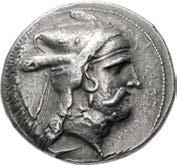



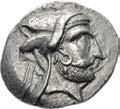

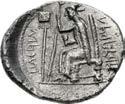
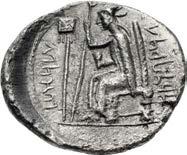
79
332. KINGS of PERSIS. Baydād (Bagadat). Early 3rd century BC. AR Tetradrachm (30mm, 17.06 g, 9h). Istakhr (Persepolis) mint. Head right, with short beard, mustache, and earring, wearing kyrbasia with flaps tied behind / Baydād enthroned left, holding scepter and cup; standard to inner left; !3%;!
of PERSIS. Baydād (Bagadat).
334. KINGS of PERSIS. Ardaxšir (Artaxerxes) I. 3rd century BC. AR Tetradrachm (26mm, 17.02 g, 5h). Istakhr (Persepolis) mint. Head right, with mustache and earring, wearing kyrbasia / Fire temple of Ahura-Mazda; to left, Ardaxšir standing right; standard to right; YR†5@6Rà (‘rthštry in Aramaic) down left, à32;à 3¥ àKR†RP (prtrk’ zy ’lhy’ in Aramaic) in exergue; sRP (prs in Aramaic) down inner right. van’t Haaff, Persis, Type 520.1; K&M –, but cf. 2/11 (Vahbarz; same obv. die, but later die state); Alram 520.1; Sunrise –. Bright surfaces, traces of deposits, slight die breaks. Near EF. Extremely rare with the inclusion of prs in Aramaic on the reverse. ($4000)
What is known of the fratarakas of Persis, apart from the single late reference in Polyaenus (Strategmata 7.40) derives from their coinage. While the chronology of frataraka succession is still disputed somewhat, recent scholarship has placed Ardaxšir (Artaxerxes) I before Vahbarz (Oborzos) in the sequence (see most recently, PA. van’t Haaff 2020). The obverse die of this tetradrachm, clearly struck under Ardaxšir (Artaxerxes) I with his name on the reverse, continued to be used to strike tetrdachms of Vahbarz (Oborzos), where the die break before the bashlyk becomes significantly greater (see K&M 2/11). This suggests that Vahbarz (Oborzos) continued to use his predecessor’s obverse die for some as yet unknown reason to strike his own tetradrachms for a time into his own reign.
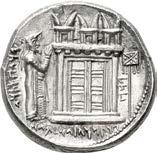
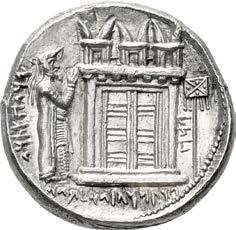
On the reverse of this tetradrachm, the legend includes for the first time the word sRP (prs in Aramaic). While common on the issues of Vahbarz (Oborzos), where it is preceded by the word RP (br = “son” in Aramaic) suggesting that he is a locally-born ruler, prs appears prior to this tetradrachm only on a drachm of Ardaxšir (Artaxerxes) I (see K&M 2/7). The use of this phrase may reflect an attempt at independence against Seleukid authority beginning with Ardaxšir (Artaxerxes) and continuing especially under Vahbarz (Oborzos), whose actions recorded by Polyaenus now appear in a new light, supported by his special issue of drachms (K&M 2/16).
335. KINGS of PERSIS. Vādfradād (Autophradates) I. 3rd century BC. AR Tetradrachm (27mm, 16.95 g, 9h). Vādfradād (Autophradates) I. Head right, with mustache and earring, wearing diadem and kyrbasia / Fire temple of AhuraMazda; above, half-figure of Ahura-Mazda; to left, Vādfradād standing right, bow set on ground before; standard to right; †DRP†w (wtprdt in Aramaic) down right, 3¥ âKR†Rp (prtrk’ zy in Aramaic) in exergue, ⁄3%;â (’lhy’ in Aramaic) up left. van’t Haaff Type 540/542; cf. K&M 2/17 (for type); cf. Alram 533 (for type); Sunrise –. Iridescent toning, deposits, cleaning scratches, some roughness, tiny edge split. Good VF. ($2000)
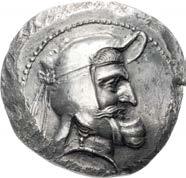


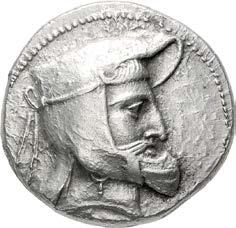
336. KINGS of PERSIS. Vādfradād (Autophradates) II. Early-mid 2nd century BC. AR Tetradrachm (24mm, 15.81 g, 10h). Istakhr (Persepolis) mint. Bearded head right, wearing diadem and kyrbasia adorned with eagle / Fire temple of Ahura-Mazda; above, half-figure of Ahura-Mazda; to left, Vādfradād standing right, bow before; to right, eagle standing left on standard; å! (’’ in Aramaic) to inner right; possible traces of additional legend in exergue. van’t Haaff, Persis Type 546a (same obv. die as illustration) K&M 3/1 var. (no legend on rev. - same obv. die); Alram 546 var. (no legend on rev.); DeMorgan, pl. XXVIII, 7 and 10 var. (same); cf. BMC 1 (Darius[?]; for type); Sunrise –; MACW –; Roma XXI, lot 306 (same obv. die); Leu Web Auction 14, lot 648 (same obv. die); nomos 14, lot 172 (same obv. die); VAuctions 354/Pars Coins 10, lot 111 = VAuctions 350/Pars Coins 7, lot 169 (same dies); CNG 111, lot 441 (same obv. die). Deposits, hairline die break on reverse. Good VF. ($2000)
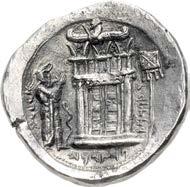

80
Extremely Rare Issue
Extremely Rare Obol
of PERSIS. Šabuhr (Shahpur), son of Pāpag (Papak). Circa AD 211/2-213. AR Obol (12.5mm, 0.47 g, 3h). Istakhr (Persepolis) mint. Bearded bust of Šabuhr left, wearing diadem and Parthian-style tiara decorated with pellet-increscent / Bearded bust of Pāpag left, wearing diadem and Parthian-style tiara with leaf ornament; ≥ behind bust. van’t Haaff, Persis, Type 655Ab; K&M 6/2; Alram –; Sunrise –. Iridescent toning. EF. Very rare. ($400)
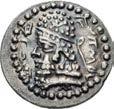
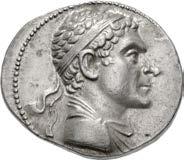
I Theos Megas. Circa 225-200/195 BC. AR Tetradrachm (27mm, 16.37 g, 12h). Mint B (“Baktra”). Struck circa 206-200 BC. Diademed older head right / Herakles seated left on rock, holding club set on rocks; } below rock. Kritt B17; Bopearachchi 12A; MPHB 613 (dies 167/382); SNG ANS 143-4; HGC 12, 43. Light deposits, scratches, and porosity. Good VF. ($500)
200-185 BC. AR Tetradrachm (36mm, 16.70 g, 12h). Diademed and draped bust right, wearing elephant skin headdress / Herakles standing facing, crowning himself, holding club and lion skin; D to inner left. Bopearachchi 1F; MPHB 54 (dies 16/41); SNG ANS 190; HGC 12, 63. Iridescent toning, circulation marks, slight double strike. Good VF. ($2000)

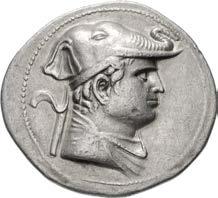


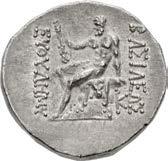
185-175 BC. AR Tetradrachm (31mm, 16.87 g, 12h). Diademed and draped bust right / Zeus standing facing, holding scepter and figure of Hekate; who holds torch in each hand; D to inner left. Bopearachchi 1D; MPHB dies O1/R R8; SNG ANS 230; HGC 12, 81. Lightly toned, traces of underlying luster, minor marks. Near EF. ($1500)
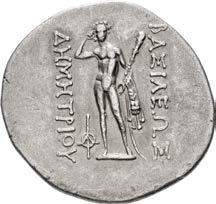


81
337. KINGS
338. BAKTRIA, Greco-Baktrian Kingdom. Euthydemos
339. BAKTRIA, Greco-Baktrian Kingdom. Demetrios I Aniketos. Circa
340. BAKTRIA, Greco-Baktrian Kingdom. Agathokles Dikaios. Circa
Pedigree Tetradrachm
341. BAKTRIA, Greco-Baktrian Kingdom. Agathokles Dikaios. Circa 185-175 BC. AR Tetradrachm (31.5mm, 16.42 g, 12h). Commemorative issue struck for Antiochos III of Syria. Diademed head of Euthydemos right / Zeus Bremetes, seen from behind, advancing left, aegis draped over outstretched arm, and brandishing thunderbolt; in inner left field, wreath above eagle standing left; D to inner right. Bopearachchi 13A; HGC 12, 84; Triton XII, lot 402 (same obv. die). Lightly toned, rough surfaces with remnants of horn silver and find patina, cleaning marks. VF. ($1500)
The attribution of the individual on this tetradrachm, one of the series of pedigree issues struck by Agathokles, has been the subject of much discussion. Based on his own coinage, the portrait here is that of Euthydemos I. The legend – ANTIOXOY NIKATOPOΣ – suggests one of the early Seleukid kings of that name, and attempts have been made to associate the Antiochos on this tetradrachm with Antiochos II, who is named on the issues of Diodotos I. Jens Jakobsson (“Antiochus Nicator, the Third King of Baktria?”, NC 170 [2010], p. 25), while rightly arguing against Antiochos II as the person commemorated, offered no alternative. Brian Kritt, who recently has revisited the issue (New Discoveries in Bactrian Numismatics, Chapter 5), convincingly suggests Antiochos III as the mostly likely candidate. Antiochos III, whose historical epithet is Megas (the Great), conducted a vigorous series of campaigns in the East, including the subjugation of the Parthians, his victories in Bactria, including the capture of Aï Khanoum, and his subsequent campaigning in India (p. 80). Like Alexander before him (who also figures in the pedigree series), Antiochos would have been a figure worthy of emulation by Agathokles and with whom he would wish to be associated.
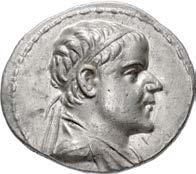

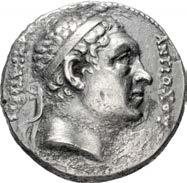
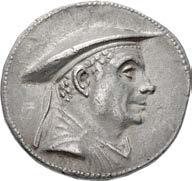
342. BAKTRIA, Greco-Baktrian Kingdom. Antimachos I Theos. Circa 180-170 BC. AR Tetradrachm (32mm, 17.01 g, 12h). Diademed and draped bust right, wearing kausia / Poseidon, laureate, standing facing, holding trident and cradling filleted palm frond; K to inner right. Bopearachchi 1D; MPHB Group III; SNG ANS 276-7; HGC 12, 106. Toned, some deposits and encrustation, light marks under tone, tiny pit on obverse, small flan flaw on reverse. VF. ($1000)
343. BAKTRIA, Greco-Baktrian Kingdom. Eukratides I Megas. Circa 170-145 BC. AR Tetradrachm (34.5mm, 16.97 g, 12h). Diademed and draped bust right / The Dioskouroi, holding couched spears and palm fronds, on horses rearing right; } in lower right field. Bopearachchi 1B; SNG ANS 431; HGC 12, 130. Iridescent toning, some roughness, slight double strike on reverse, tiny edge split. Good VF. ($1000)
344. BAKTRIA, Greco-Baktrian Kingdom. Eukratides I Megas. Circa 170-145 BC. AR Tetradrachm (33mm, 16.99 g, 12h). Diademed and draped bust right / The Dioskouroi, holding couched spears and palm fronds, on horses rearing right; D in lower right field. Bopearachchi 1D; SNG ANS 432; HGC 12, 130. Traces of deposits, some marks, slight double strike on reverse, underlying luster, hint of porosity. Good VF. High relief portrait. ($1000)
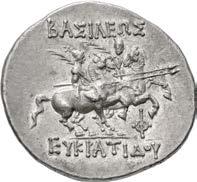

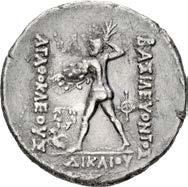
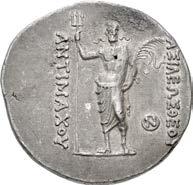
82
343
344
345. BAKTRIA, Greco-Baktrian Kingdom. Eukratides I Megas. Circa 170-145 BC. AR Drachm (19mm, 4.20 g, 12h). Diademed and draped bust right / The Dioskouroi, holding couched spears and palm fronds, on horses rearing right; } to left. Bopearachchi 2B; SNG ANS 437-8 var. (placement of monogram) HGC 12, 135. A few faint scratches, slight double strike on reverse. Near EF. ($1000)
346. BAKTRIA, Greco-Baktrian Kingdom. Eukratides I Megas. Circa 170-145 BC. AR Drachm (20mm, 4.19 g, 12h). Diademed and draped bust right / The Dioskouroi, holding couched spears and palm fronds, on horses rearing right; Å in upper left field, I in lower right. Bopearachchi 2C; SNG ANS 439-41; HGC 12, 135. Light iridescence, light marks and flaws, traces of underlying luster. Good VF. ($500)

347. BAKTRIA, Greco-Baktrian Kingdom. Eukratides I Megas. Circa 170-145 BC. AR Drachm (19mm, 4.23 g, 12h). Diademed and draped bust right / The Dioskouroi, holding couched spears and palm fronds, on horses rearing right; Å in upper left field, à in lower right. Bopearachchi 2D; SNG ANS –; HGC 12, 135. Light iridescence, hint of deposits. Good VF. Rare. ($500)
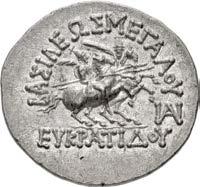

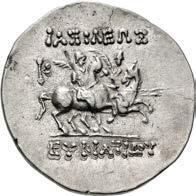
348. BAKTRIA, Greco-Baktrian Kingdom. Eukratides I Megas. Circa 170-145 BC. AR Tetradrachm (33mm, 16.97 g, 12h). Helmeted, diademed, draped, and cuirassed bust right / The Dioskouroi, holding couched spears and palm fronds, on horses rearing right; D in lower right field. Bopearachchi 6O; SNG ANS 467; HGC 12, 131. Iridescent tone. Good VF. ($1000)


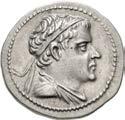
349. BAKTRIA, Greco-Baktrian Kingdom. Eukratides I Megas. Circa 170-145 BC. AR Tetradrachm (33mm, 17.06 g, 12h). Helmeted, diademed, draped, and cuirassed bust right / The Dioskouroi, holding couched spears and palm fronds, on horses rearing right; : in lower right field. Bopearachchi 6V; SNG ANS –; HGC 12, 131. Light iridescence, traces of underlying luster, slightly off center, slight double strike on obverse. EF. ($1000)
350. BAKTRIA, Greco-Baktrian Kingdom. Eukratides I Megas. Circa 170-145 BC. AR Tetradrachm (33mm, 16.98 g, 12h). Helmeted, diademed, draped, and cuirassed bust right / The Dioskouroi, holding couched spears and palm fronds, on horses rearing right; T in lower right field. Bopearachchi 6W; SNG ANS 469-71; HGC 12, 131. Traces of deposits, traces of underlying luster. Near EF. ($1000)


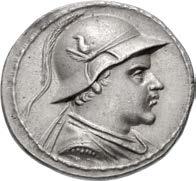

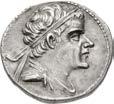
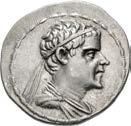

83
346 347 348 349
351. BAKTRIA, Greco-Baktrian Kingdom. Eukratides I Megas. Circa 170-145 BC. AR Tetradrachm (34mm, 16.29 g, 12h). Helmeted, diademed, draped, and cuirassed bust right / The Dioskouroi, holding couched spears and palm fronds, on horses rearing right; à in lower right field. Bopearachchi 6X; SNG ANS 472; HGC 12, 131. Iridescent toning. Good VF. ($750)

352. BAKTRIA, Greco-Baktrian Kingdom. Eukratides I Megas. Circa 170-145 BC. AR Tetradrachm (32.5mm, 17.01 g, 12h). Helmeted, diademed, draped, and cuirassed bust right / The Dioskouroi, holding couched spears and palm fronds, on horses rearing right; Î in lower left field. Bopearachchi 6Z; SNG ANS 473; HGC 12, 131. Traces of deposits, scuff and hairline die break on reverse, underlying luster. Good VF. ($1000)
353. BAKTRIA, Greco-Baktrian Kingdom. Eukratides I Megas. Circa 170-145 BC. AR Drachm (22.5mm, 4.09 g, 12h). Helmeted, diademed, draped, and cuirassed bust right / The Dioskouroi, holding couched spears and palm fronds, on horses rearing right; T to lower right. Bopearachchi 7I var. (monogram to left); SNG ANS 479-82; HGC 12, 136. Iridescent toning, some porosity and roughness. VF. ($500)


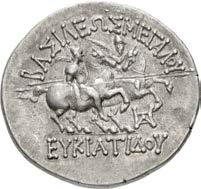
354. BAKTRIA, Greco-Baktrian Kingdom. Eukratides I Megas. Circa 170-145 BC. AR Tetradrachm (36mm, 16.86 g, 12h). Diademed and helmeted heroic bust left, seen from behind, brandishing spear / The Dioskouroi, holding couched spears and palm fronds, on horses rearing right; D in lower right field. Bopearachchi 8B; SNG ANS 485; HGC 12, 132. Iridescent toning, circulation marks. VF. ($3000)

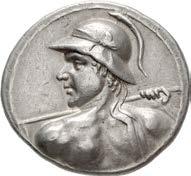

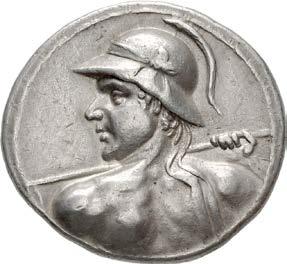


84
351 352
Greco-Baktrian Kingdom. Demetrios II. Circa 150-145 BC. AR Tetradrachm (35mm, 16.87 g, 12h). Diademed and draped bust right / Athena standing facing, wearing triple crested helmet, holding spear and shield set on ground; , below spear. Bopearachchi 1E; SNG ANS 393-4; HGC 12, 126. Light iridescence, traces of deposits, slight doubling. EF. ($3000)
Greco-Baktrian Kingdom. Eukratides II Soter. Circa 145-140 BC. AR Tetradrachm (34mm, 16.97 g, 12h). Diademed and draped bust right / Apollo standing left, holding arrow and bow set on ground; à to inner left. Bopearachchi 1I; SNG ANS 623; HGC 12, 161. Iridescent toning, slight porosity. Good VF. ($750)
Greco-Baktrian Kingdom. Eukratides II Soter. Circa 145-140 BC. AR Tetradrachm (33mm, 17.01 g, 12h). Diademed and draped bust right / Apollo standing left, holding arrow and bow set on ground; ◊ to inner left. Bopearachchi 1M; SNG ANS –; HGC 12, 161. Iridescent toning, slight doubling on reverse, a couple of tiny edge splits. Near EF. ($1000)
BAKTRIA, Greco-Baktrian
Eukratides II Soter. Circa 145-140 BC. AR Tetradrachm (33mm, 16.89 g, 12h). Diademed and draped bust right / Apollo standing left, holding arrow and bow set on ground; ° to inner left. Bopearachchi 1Q; SNG ANS 624; HGC 12, 161. Iridescent toning, small die break on obverse, underlying luster. Near EF. ($1000)




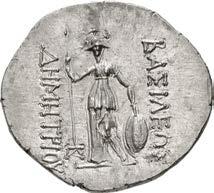

Eukratides II Soter. Circa 145-140 BC. AR Tetradrachm (32mm, 15.49 g, 12h). Diademed and draped bust right / Apollo standing left, holding arrow and bow set on ground; N to inner left. Bopearachchi 3B; SNG ANS 625-6; HGC 12, 162. Iridescent toning, slight porosity, minor double strike on reverse. Good VF. ($750)
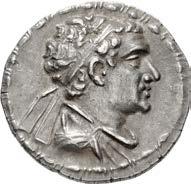
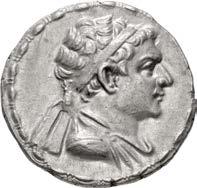

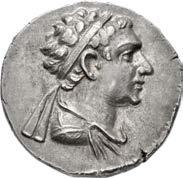
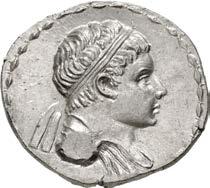
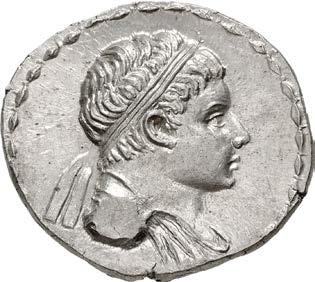
85
355. BAKTRIA,
356. BAKTRIA,
357. BAKTRIA,
358.
Kingdom.
359. BAKTRIA, Greco-Baktrian Kingdom.
356 357 358 359
360. BAKTRIA, Greco-Baktrian Kingdom. Heliokles Dikaios. Circa 145-130 BC. AR Tetradrachm (33mm, 15.85 g, 12h). Diademed and draped bust right / Zeus standing facing, holding thunderbolt and scepter; d in exergue. Bopearachchi 2B; SNG ANS 652-3; HGC 12, 171. Bright surfaces, traces of deposits, slight porosity, cleaning marks, a couple of edge splits with associated lamination, slight double strike on reverse. Near EF. Rare. ($750)
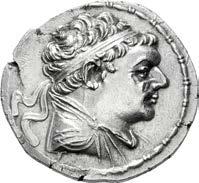
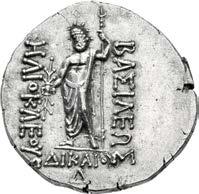
CENTRAL ASIAN COINAGE
361. INDIA, Kushan Empire. Vima Kadphises. Circa AD 113-127. AV Dinar (21mm, 7.97 g, 12h). Bilingual series. Main mint in Baktria. Diademed and crowned half-length bust of Vima Kadphises right on clouds, holding mace-scepter over shoulder; flames at shoulder; 9 to left / Ithyphallic Siva standing facing, head left, holding composite trident with ax in right hand, he-goat skin draped over left arm; 9 to left, 0 (Three Jewels) to right. Bopearachchi, Premiers –; MK 18 (dies 5α/20); ANS Kushan 269; Donum Burns 81. Toned, traces of reddish deposits. Good VF. ($2000)
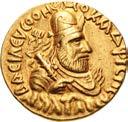
127-151. AV Dinar (20mm, 7.94 g, 12h). Main mint in Baktria (Balkh?). Early phase. Kanishka standing left, holding goad and scepter, sacrificing over altar to left; flame at shoulder / Miiro (Mithra) standing left, extending in benediction and holding hilt of sword; 9 to left. MK 31 (dies 4/3 [unlisted die combination]); ANS Kushan –; Donum Burns 114. Lightly toned. Good VF. ($1500)


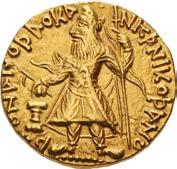


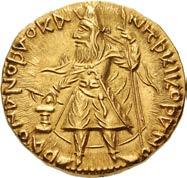

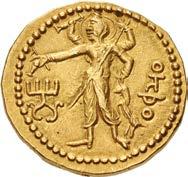
AV Dinar (20mm, 7.97 g, 12h). Main mint in Baktria (Balkh?). Early phase. Kanishka standing left, holding goad and scepter, sacrificing over altar to left; flame at shoulder / Siva standing left, pouring water from flask and holding vajra (thunderbolt), trident, and he-goat; 9 to left. MK 37 (dies 3/2); ANS Kushan 371-2; Donum Burns 119-21. Traces of deposits in devices. Near EF. ($3000)
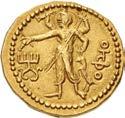
86
362. INDIA, Kushan Empire. Kanishka I. Circa AD
Ex Gert Cleff Collection.
363. INDIA, Kushan Empire. Kanishka I. Circa AD 127-151.
AD 127/8-152. AV Dinar (20mm, 7.99 g, 12h). Main mint in Baktria (Balkh?). Late phase. Kanishka, diademed and crowned, standing facing, head left, holding goad and scepter, sacrificing over altar to left; flame at shoulder / Siva, nimbate, standing facing, head left, pouring water from flask and holding vajra (thunderbolt), trident, and he-goat; 8 to left. MK 62 (O25/R31 – unlisted die combination); ANS Kushan 382; Donum Burns 131 (same dies). EF. ($3000)

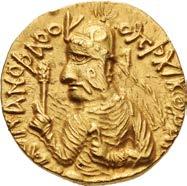

Ex Triton XVII (7 January 2014), lot 461.
127-151. AV Dinar (21mm, 7.94 g, 12h). Main mint in Baktria (Balkh?). Late phase. Kanishka standing left, holding goad and scepter, sacrificing over altar to left; flame at shoulder / Miiro (Mithra) standing left, extending hand in benediction and holding hilt of sword; 9 to left. MK 64 (O7/R19A); ANS Kushan 378; Donum Burns –. Deposits in devices, obverse struck with broken and worn die. Good VF. ($1500)
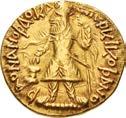
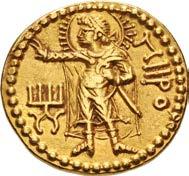
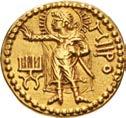

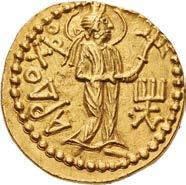

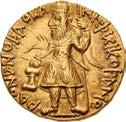

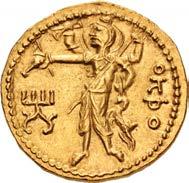
7.92 g, 12h). Main mint in Baktria (Balkh?). Early phase. Crowned and diademed bust left on clouds, holding mace scepter and goad; flames over shoulder / Ardoxsho standing facing, head right, holding cornucopia; 7 to right. MK 154 (O10/R7); ANS Kushan 721; Donum Burns 232. Lightly toned, a couple of light marks. Near EF. ($1500)
(13mm, 2.05 g, 12h). Main mint in Baktria (Balkh?). Late phase. Crowned and diademed bust left on clouds, holding mace scepter and goad; flames over shoulder / Mioro (Mithra) standing facing, head left, extending hand in benediction and holding hilt of sword; & to left. MK 275 (dies 7/11); ANS Kushan 748 (same dies); Donum Burns 259 (same dies); Bellaria Collection (CNG 66), lot 968 (same dies). Toned, deposits in devices, edge marks. Good VF. Very rare, only one in CoinArchives. ($750)

87
364. INDIA, Kushan Empire. Kanishka I. Circa
365. INDIA, Kushan Empire. Kanishka I. Circa AD
366. INDIA, Kushan Empire. Huvishka. Circa AD 151-190. AV Dinar (19mm,
367. INDIA, Kushan Empire. Huvishka. Circa AD 151-190. AV Quarter Dinar
368. INDIA, Kushan Empire. Huvishka. Circa AD 151-190. AV Dinar (21mm, 7.97 g, 12h). Main mint in Baktria (Balkh?). Late phase. Crowned and diademed bust left on clouds, holding mace scepter and goad; flames over shoulder / Ardoxsho, wearing stephane, standing facing, head right, extending cornucopia with both hands; 7 to right. MK 287 (dies 1/– [unlisted rev. die]); ANS Kushan 751 corr. (Göbl number); Donum Burns 264. Lightly toned, traces of deposits, die break on edge of obverse, evidence of having been placed in a bezel. Good VF. ($1500)

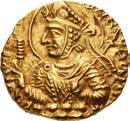














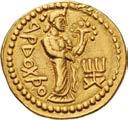
369. INDIA, Kushan Empire. Huvishka. Circa AD 152-192. AV Dinar (20mm, 7.92 g, 12h). Subsidiary mint in Gandhara (Peshawar?). Late phase. Nimbate, diademed, and crowned half-length bust left on clouds, flames at shoulder, holding mace-scepter and filleted spear over shoulder / Nana, nimbate, wearing fillet and crescent, standing facing, head right, holding scepter and box; ^ to right. Cf. MK 365-365A (same obv. die as 365A); ANS Kushan –; cf. Donum Burns 295 (same obv. die). Toned, traces of deposits in devices, obverse struck with slightly worn die. Near EF. ($2000)
I. AD 223/4-240. AR Drachm (25mm, 4.15 g, 3h). Mint B (“Hamadan”). Phase 3, circa AD 233/4-238/9. Bust right, wearing diadem (type R) / Fire altar (flames 1) with diadems (type R); three pellets decorating altar base. SNS type VII(4a)/3b(2b) and pl. 16, 234; Sunrise 710. Iridescent toning, deposits in devices, traces of die rust, tiny edge split. EF. ($750)
88
370. SASANIAN KINGS. Ardaxšīr (Ardashir)
371. SASANIAN KINGS. Ardaxšīr (Ardashir) I. AD 223/4-240. AV Sixth Dinar (14.5mm, 1.41 g, 3h). Mint C (“Ctesiphon”). Phase 3, circa AD 233/4-238/9. Bust right, wearing diadem (type R) and close-fitting headdress with korymbos and no earflaps; pellet to each side of crown, trace of star on far shoulder / Fire altar (flames 2) with diadems (type G). SNS type IIIa/3a and cf. pl. 10, A24; Saeedi –; Sunrise –; Zeno 35632 = Triton VII, lot 557. Toned, deposits in devices, scratches and marks, traces of die rust. VF. Extremely rare. ($3000)
372. SASANIAN KINGS. Šābuhr (Shahpur) I. AD 240-272. AV Dinar (23mm, 7.27 g, 3h). Mint I (“Ctesiphon”). Phase 1a, circa AD 240-244. Bust right, wearing diadem and mural crown with korymbos and ribbons / Fire altar; flanked by two attendants wearing mural crowns. SNS type IIc/1a, style A, Group indéterminé; Saeedi AV9; Sunrise –. Lightly toned, light die rust, slight double strike on obverse. Near EF. ($3000) Ex Leu 7 (24 October 2020), lot 1411.
(Shahpur) I. AD 240-272. AV Dinar (23mm, 7.37 g, 3h). Mint I (“Ctesiphon”). Phase 2, circa AD 260-272. Bust right, wearing diadem and mural crown with korymbos and ribbons / Fire altar; flanked by two attendants wearing mural crowns, each with korymbos. SNS type IIc/1a, style A ou Ater; Saeedi –; Sunrise –. Lightly toned, traces of deposits. VF. ($3000)


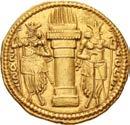
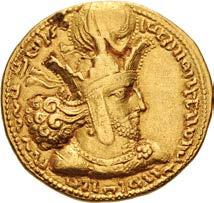
I. AD 240-272. AV Dinar (21.5mm, 7.42 g, 3h). Mint I (“Ctesiphon”).
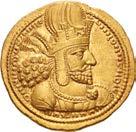
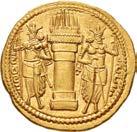



Phase 2, circa AD 260-272. Bust right, wearing diadem and mural crown with korymbos / Fire altar; flanked by two attendants wearing mural crowns; ˘ to right of altar shaft. SNS type IIc/1b, style P, group b and plate 30, 126 var. (no pellets); Saeedi AV4 var. (same); Sunrise 739 var. (same). Lightly toned, hint of underlying luster. EF. ($4000)
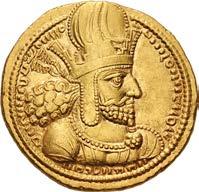


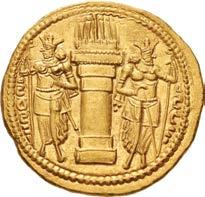
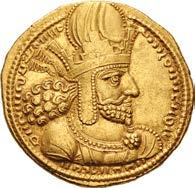

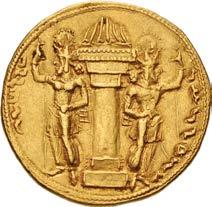
89
373. SASANIAN KINGS. Šābuhr
374. SASANIAN KINGS. Šābuhr (Shahpur)
375. SASANIAN KINGS. Šābuhr (Shahpur) I. AD 240-272. AV Dinar (22mm, 7.38 g, 3h). Mint I (“Ctesiphon”). Phase 2, circa AD 260-272. Bust right, wearing diadem and mural crown with korymbos / Fire altar; flanked by two attendants wearing mural crowns; ˘ to right of altar shaft. SNS type IIc/1b, style P, group b and plate 30, 126 var. (no pellets); Saeedi AV4 var. (same); Sunrise 739 var. (same). Lightly toned, light die rust, slight double strike on reverse, slight edge flaw, traces of underlying luster. EF. ($4000)
376. SASANIAN KINGS. Šābuhr (Shahpur) I. AD 240-272. AV Dinar (21mm, 7.43 g, 3h). Mint I (“Ctesiphon”). Phase 2, circa AD 260-272. Bust right, wearing diadem and mural crown with korymbos / Fire altar; flanked by two attendants wearing mural crowns; ˘ to right of altar shaft. SNS type IIc/1b, style P, group b and plate 30, 126 var. (no pellets); Saeedi AV4 var. (same); Sunrise 739 var. (same). Lightly toned, light die rust, slight double strike on reverse, small edge cut, hint of underlying luster. Near EF. ($3000)
Extremely Rare Mixed Style Issue
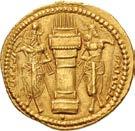

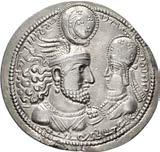


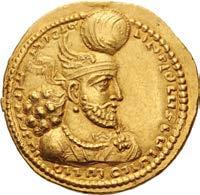
90
377. SASANIAN KINGS. Vahrām (Bahram) II, with Prince 1. AD 276-293. AR Drachm (27mm, 4.06 g, 3h). Style Uncertain (B?). Bust of Bahram right vis-à-vis bust of Prince 1 left; Bahram wearing winged crown with korymbos, prince wearing diadem and tiara with earflaps / Fire altar flanked by two attendants, the one on the left wears crown with korymbos, the other wears mural crown; ≥ to right of flames. SNS type II(1)/I(1a) and plate 25, A88; Saeedi –; Sunrise –, but cf. 773 (for type). Light iridescent toning, edge crimped with associated flaws. Good VF. ($750)
378. SASANIAN KINGS. Vahrām (Bahram) II. AD 276-293. AV Dinar (22mm, 7.16 g, 3h). Style I/G. ‘HWPY/HRPY’ (Herat?) or ‘Marw’ mint. Phase I. Bust right, wearing winged crown with korymbos / Fire altar; flanked by two attendants, the left wearing winged crown with korymbos, the right wearing mural crown; pellet below altar. SNS type I1/1(1a), style I (for obv.) and style G (for rev.); Saeedi –; Sunrise 765. Lightly toned, doubling on reverse, evidence of having been placed in a bezel. EF. Extremely rare style combination. ($4000)
ROMAN PROVINCIAL COINAGE
Rare Issue for Lucius Aelius Sejanus
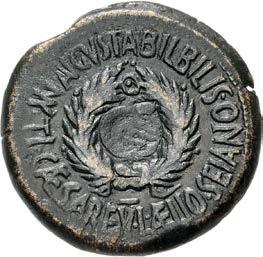
with the name of Sejanus. Rare with the full name of Sejanus intact. ($1500)
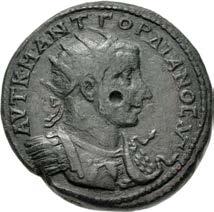

From the D.K. Collection.
Lucius Aelius Sejanus came from an up-and-coming equestrian family. Early in his career, Sejanus served with Augustus’ grandson Gaius in the east, and may have accompanied Drusus Caesar north to quell the mutinies that broke out upon Augustus’ death. He was made praefectus praetorio (commander of the Praetorian Guard) along with his father Lucius Seius Strabo, but when Strabo was promoted to the post of praefectus Aegypti, Sejanus took sole command of the Guard. As head of a force of 12,000 loyal soldiers, he used his position to gain influence over Tiberius.
In AD 23, upon the death of Drusus Caesar, Sejanus proposed marrying Drusus’ widow Livilla, with whom he was allegedly having an affair. So indispensable had he become in maintaining order in the capital that Tiberius called him “the partner of my labors,” a position that Sejanus carefully built upon following the emperor’s retirement to Capri in AD 26. Using the emperor’s absence to his advantage, Sejanus imprisoned Germanicus’ widow, Agrippina Senior, her sons Nero and Drusus, and their supporters on charges of treason. In AD 31, Sejanus served as consul with Tiberius – the first step, he hoped, in acquiring tribunician power and becoming the imperial heir. Although Sejanus’ position seemed unassailable, Tiberius became aware of Sejanus’ machinations and condemned his consular colleague in a letter to the Senate. Sejanus and his children were executed, reprisals followed against his adherents, and the Senate issued a damnatio memoriae.
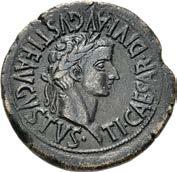
Very Rare Published Medallion
Anchialus. Gordian III. AD 238-244. Æ Medallion (35mm, 31.48 g, 7h). Radiate and cuirassed bust right, seen from the front, aegis on shoulder, gorgoneion on breastplate / On left, Hygieia standing right, feeding serpent from patera held in her arms right; on right, Asclepius standing facing, leaning on serpent-entwined staff to left, gathering himation with left; small figure of Telesphorus; to left, ibis standing left, to right, small altar. Tachev, Anchialos 5 (O3/R3) = RPC VII.2 1097.2 (this coin); AMNG 619; Varbanov 651(this coin illustrated). Dark brown patina, light roughness. VF. Very rare, one of three specimens known to RPC. ($750)
From the Dr. Michael Slavin Collection, purchased from Barry Murphy, October 2003. Ex Gorny & Mosch 121 (10 March 2003), lot 305.
The three main Greco-Roman deities of healing are depicted on the reverse of this attractive medallion: Asclepius, god of medicine; his daughter Hygeia, goddess of good health; and his son Telesphorus, god of recovery, shown as a small figure wearing a hooded cloak. Asclepius and his symbol, the serpent-twined staff, feature frequently on the coinage of Anchialus, indicating the presence of a temple and cult-center there.
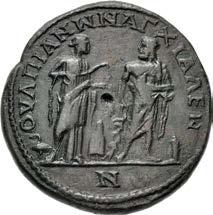
91
379. SPAIN, Bilbilis. Tiberius. AD 14-37. Æ As (29.5mm, 12.98 g, 1h). L. Aelius Sejanus, praetorian consul. Struck AD 31. Laureate head right / (MVN) • (AV)GVSTA BILBILIS above, • TI • CÆSARE • V • L • ÆLIO • SEIANO below, laurel wreath containing COS. ACIP 3024; Burgos 284; RPC I 398. Brown surfaces, minor porosity. VF. Important historical type
380. THRACE,
Herakles and the Apples of the Hesperides Medallion

NEΩKOPΩN, Hercules standing facing, head right, lion skin over left arm, leaning right hand on club set on ground and holding Apples of the Hesperides in extended left hand; to right, the serpent Ladon coiled around tree. Schönert, Perinthos 858; RPC VII.2 568; Varbanov 528. Dark brown patina, light roughness, small flan crack. Near EF. Very rare, only six known to RPC. Attractive. ($5000)
Because he had been assisted in completing some of his earlier tasks, Hercules was compelled to undergo two more labors. The first of these was to steal the Apples of the Hesperides, nymphs who lived in a grove at the far western edge of the world. Hercules tricked the Titan Atlas, whose task it was to support the heavens, to retrieve the apples in return for holding up the heavens while he did so. Having accomplished the task, Atlas was reluctant to give up his freedom and told Hercules that he would take back the apples to Mycenae. Once again, Hercules tricked the Titan, requesting that Atlas hold the heavens while Hercules adjusted his cloak to be more comfortable.
382. PHOCIS, Delphi. Antinoüs. Died AD 130. Æ (24mm, 9.91 g, 3h). Aristomos, priest of the cult of Antinoüs. Bare head right / Tripod of Delphi. Blum p. 34, 2, pl. I, 7; RPC III 444; BCD Lokris 400. Red-brown surfaces, porosity. Fine. Very rare. ($500)


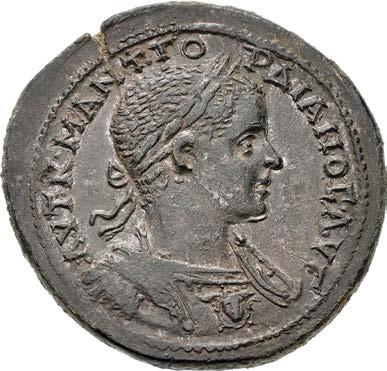
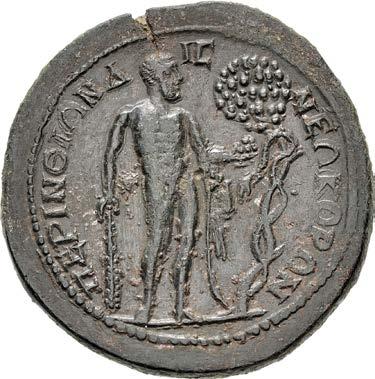
The tripod sat in front of the Temple at Delphi and was used in the rituals of the Oracle. It is said that the tripod sat above a chasm from which a constant stream of cold vapor arose, the Oracle would breathe the vapor and enter a state of frenzy from which she could see her visions. After completing his Twelve Labors, Herakles attempted to steal the tripod after the Oracle could not cure him of his disease.
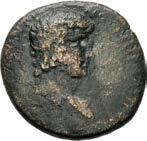
92
381. THRACE, Perinthus. Gordian III. AD 238-244. Æ Medallion (43mm, 36.02 g, 1h). • AVT • K • M • ANT • ΓO PΔIANOC • AVΓ, laureate and cuirassed bust right, seen from the front, slight drapery on shoulder; gorgoneion on breastplate / ΠEPINΘIΩN Δ IC
Ex Mabbott Collection – Pedigreed to 1951
383. CORINTHIA, Corinth. Agrippina Senior, with Nero and Drusus Caesar. Wife of Germanicus, AD 5-33. Æ (19mm, 8.42 g, 6h). P. Vipsanius Agrippa and M. Bellius Proculus, duovirs. Struck under Caligula, 37-38 AD. Draped bust right / [P] VIPSANIO [AGRIPPA IIVIR COR], NED in field, confronted bare heads of Nero and Drusus Caesars. Amandry XVII 69.3 (this coin); BCD Corinth –; RPC I 1174. Brown patina, minor porosity, slightly off center. VF. Finer than any in CoinArchives or RPC. Rare. ($300)
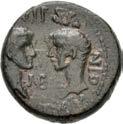
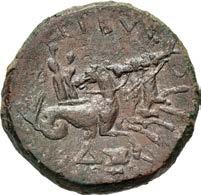
From the Conti Collection, purchased from Harlan J. Berk, Ltd. Ex Münzen und Medaillen AG FPL 325 (July 1971), no. 2; Thomas O. Mabbott Collection (Schulman, 6 June 1969), lot 852; Münzen und Medaillen AG X (22 June 1951), lot 109.
Rare Fleet Coinage

384. ACHAEA, Fleet Coinage. Uncertain mint. Mark Antony. 38-37 BC. Æ “Sestertius” (33mm, 22.22 g, 9h). Heavy series. L. Sempronius Atratinus, auger and consul designatus. Bare head of Antony right vis-à-vis head of Octavia left / Two figures embracing (Antony and Octavia as Poseidon and Amphitrite?) standing right on quadriga of hippocamps; HS to left; lituus to right; in exergue, Δ and astragalus. Amandry, Bronze I, Series II.1.A, 1-10 var. (unlisted dies); RPC I 1453; CRI 279; Sydenham 1261. Red-brown surfaces with green deposits, roughness, smoothed, details enhanced. Near VF. Extremely rare. ($3000)
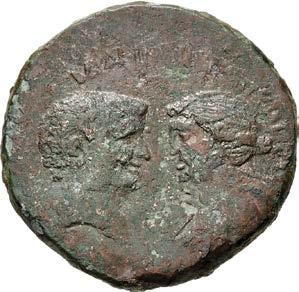
The curious “fleet coinage” of Mark Antony was struck at several mints over the course of 37/6 BC, probably commencing after Antony and Octavian signed the Pact of Tarentum, which renewed their triumval powers and partnership. Octavia, Antony’s wife and Octavian’s sister, was instrumental in the negotiations and frequently appears on the coins, including this rare specimen. The coins are all bronzes of a range of denominations that anticipate the ones in use during the empire – sestertius, dupondius, as, etc. Three Antonian admirals are named as moneyers, including L. Sempronius Atratinus, as seen here. All coins feature nautical themes, hence the term “fleet coinage.” Although Roman denominations and legends are employed, many of the numerals, including marks of value, are Greek, indicated they were intended for use in the east, where many were struck. The evidence points to an early experiment in a revolutionary new universal coinage system that was ahead of its time, but was later taken up, tweaked, and fully implemented by Augustus.

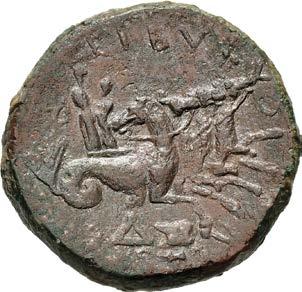
of BOSPORUS. Rhescuporis II, with Caracalla. AD 211/2-226/7. EL Stater (19mm, 7.62 g, 12h). Dated Bosporan Era 512 (AD 215/6). Diademed and draped bust of Rhescuporis right / Laureate, draped, and cuirassed bust of Caracalla right; eight-rayed star to right; BIΦ (date) below. MacDonald 555/4; Frolova 79, pl. XLV, 21; SNG Stancomb 1002 (this coin). Minor obverse scrape, residual luster. Near EF. ($750) Ex William Stancomb Collection (Roma E-Sale 69, 16 April 2020), lot 412.
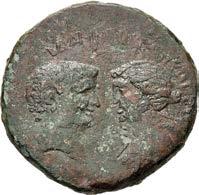
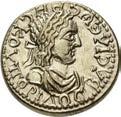
93
Published in SNG Stancomb
385. KINGS
A Scene Recounted by Virgil in the Aeneid
AD 222-235. Æ (34mm, 21.66 g, 6h). Laureate and cuirassed bust right, seen from the front, cuirass decorated with gorgoneion / Aeneas advancing right, looking left, leading Ascanius by the hand and carrying Anchises on his shoulder. RG 92; RPC VI Online 3003; BMC 37. Brown patina, roughness and smoothing. Fine. Extremely rare, only three known to RPC, none in CoinArchives. ($400)

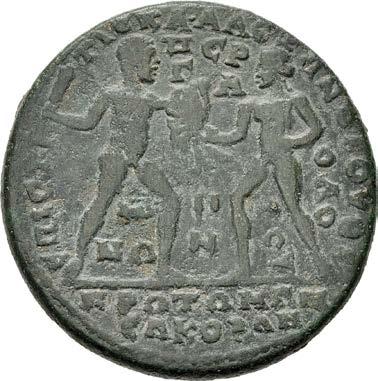
386.
The reverse depicts a scene recounted by Virgil in the Aeneid when the Greeks attacked and set fire to Troy. Here we see Aeneas fleeing, carrying his aged father Anchises on his shoulder, leading his son Ascanius by the hand to safety.
Æ (36mm, 26.51 g, 7h). C. Cadius Rufus, proconsul. Struck circa AD 47-48. Draped bust left, hair in long plait / Façade of basilica: a two story tetrastyle central bay with two story wings flanking; inscribed entablature above. RG 33 var. (bust right); RPC I 2034. Red-brown patina, smoothed fields, scrapes and roughness, tooled. Near VF. Very rare. ($1000)
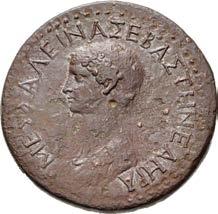
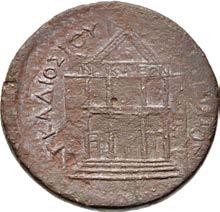
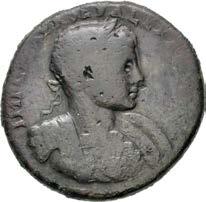
Claudius was unlucky in marriage, but his third wife caused him the most scandal. Valeria Messalina was only 14 or 15 when she married the emperor, who at the time was about 50 years old. Although she bore Claudius two children (Claudia Octavia and Britannicus), she appears to have felt little attraction to her much older husband and was notoriously promiscuous, according to ancient accounts. While the emperor was traveling to Ostia in AD 48, he was informed that Messalina had secretly taken a second husband, a senator named Gaius Silius, who was said to be the handsomest man in Rome. Claudius returned to Rome and swiftly had Silius executed. Messalina was ordered to commit suicide, but could not muster the courage to do so, and a soldier promptly ran her through. A damnatio memoriae was pronounced against her name.
No Imperial issues with the portrait of Messalina were struck. As for the small number of provincial issues that carry her portrait, the largest and most impressive are from Nicaea in Bithynia. The elaborate building depicted on the reverse may represent the city’s gymnasium, which stood in the city center. The geographer Strabo mentions the building as being especially magnificent, with a tower at its center from which all four city gates could be seen.
94
BITHYNIA, Apamea. Severus Alexander.
387. BITHYNIA, Nicaea. Messalina. Augusta, AD 41-48.
Enlargement of Lot 388
Hercules’ Ninth Labor - The Golden Girdle of Hippolyte
At the request of Admete, Eurystheus’ daughter, Hercules as his Ninth Labor went to seize the golden girdle of Hippolyte, a garment that gave power and supremacy to the wearer. The daughter of Otrera and the god Ares, Hippolyte was the queen of the Amazons, an all female race who lived near the slopes of the Caucasus. To accomplish this Labor, Hercules organized an expedition which included the Athenian hero Theseus. Upon the heroes’ arrival, the Amazon women greeted them warmly, while Hippolyte offered the girdle as a gift. Hera, on hearing this, took the form of an Amazon, spreading a rumor that Hercules had come to steal away their queen and take her back with him to Greece. The female warriors, in protection of their queen, began fighting the heroes. In the melée that followed, Hercules slew Hippolyte, thinking she had betrayed him. Winning the battle, Hercules headed back for Mycenae. On the way, he saved the life of Hesione, daughter of Laomedon, king of Troy. Laomedon, however, refused to reward the hero for his service. In retribution, Hercules slew the king and all his sons, save the youngest, Podarces, who later became known as Priam.
Ex
Rare Vespasian Junior
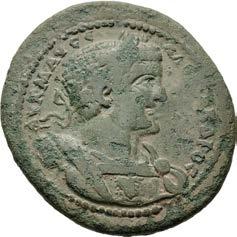

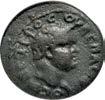

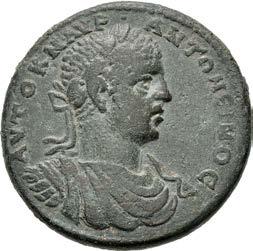
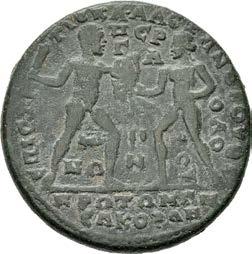
One of the greatest problems facing Domitian toward the end of his reign was the lack of an heir – a problem which he solved by adopting two sons of his niece Domitilla and her husband Titus Flavius Clemens,
the heirs
Junior
Junior.
Domitilla to Pandateria on charges of atheism. As nothing further is recorded about either adopted heir, it can be assumed that both were punished in some way for the supposed crimes of their parents.
suspicious of Flavius, Domitian exiled him along
95
388. MYSIA, Pergamum. Elagabalus. AD 218-222. Æ Medallion (42mm, 40.37 g, 12h). Ti. Claudius Alexander, theologos and strategos. Laureate, draped, and cuirassed bust right, aegis on shoulder, seen from the front / Hercules advancing right, holding raised club and lion skin, fighting Amazon (Hippolyte) standing left and holding shield(?). Weisser 2138; RPC VI Online 4210; SNG BN 2259 (same dies). Earthen green patina, minor deposits. VF. Extremely rare, only four known to RPC, this the finest specimen. ($2000)
389. TROAS, Alexandria Troas. Severus Alexander. AD 222-235. Æ (40mm, 28.28 g, 7h). Aur. Metronax, strategos Laureate and cuirassed bust right, gorgoneion on breastplate, seen from front / Tyche standing facing, head left, wearing kalathos, holding patera and cornucopia, to left, lighted altar. RPC VI Online 4099.4 (this coin); SNG München 167. Earthen green patina, double struck obverse. VF. Very rare, four known to RPC including this coin, the only one to come to auction. ($300)
Savoca Online Auction 39 (22 December 2019), lot 157.
390. IONIA, Smyrna. Vespasian Junior. Caesar, AD ?-95/6. Æ (16mm, 12h). Struck circa AD 94/5. Bare head right / Nike advancing right, holding wreath and palm frond. Klose Type XLII, Serie A, Gruppe a, 1 (V1/R1); RPC I 1028; BMC 319. In ANACS encapsulation 6097699, graded F 12. Rare. ($500)
renaming
Vespasian
and Domitian
Becoming
with
391. LYDIA, Silandus. Commodus. AD 177-192. Æ (30mm, 11.37 g, 12h). Tatianos, archiereus as archon. Struck circa AD 177-9. Laureate, draped, and cuirassed beardless bust right / On left, youthful mountain nymph seated right on rock, resting hand on knee, grasping tree with left hand; on right, river-god Hermos reclining left on urn, holding reed and cornucopia. Kurth 65 (this coin); Hochard 2239 (D12/R22); RPC IV.2 Online 1443.3 (this coin); BMC 23. Green-brown patina, deposits, lamination flaws. VF. Very rare, only four known, including this coin. ($300)
From the Dr. Michael Slavin Collection. Ex Classical Numismatic Group Electronic Auction 74 (1 October 2003), lot 57.
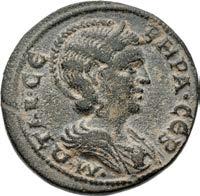
BMC describes the figure on the reverse as Pan holding a pedum, RPC and Hochard maintain this description. However, Kurth describes the reverse figure on the left as a “youthful mountain nymph” and notes that “[t]he “pedum” mentioned in BMC...is simply the result of a cracked die.” There is no evidence of a pedum on this, or the other specimens cited in RPC.
392. LYDIA, Tralles. Augustus. 27 BC-AD 14. Æ (20mm, 5.86 g, 12h). Menandros, son of Parrhasios, magistrate. Bare head of Vedius Pollio right; uncertain object behind / Laureate head of Zeus right. Kurth 136; RPC I 2635; SNG Copenhagen 688; BMC 76-8. Earthen brown patina, off center obverse. VF. ($400)
Ex Savoca Online Auction 29 (30 December 2018), lot 2018.
An equestrian and confidant of Augustus, Vedius Pollio seems to have had an important administrative career, serving in the restoration of a proconsular government in Asia and possibly even in the refoundation of Tralles as Caesarea. His portrait appears on bronze coins of Tralles, highly unusual for anyone other than the emperor or members of his family, and indicates he served as the equivalent of a proconsul, possibly circa 31-30 BC. But his personal cruelty, especially toward slaves, undid his friendship with Augustus and made him infamous to later generations. Pollio is said to have kept a pool of lampreys explicitly for the purpose of executing slaves who displeased him. During a banquet honoring Augustus, a cup-bearer broke a goblet and Pollio ordered him thrown to the lampreys. Augustus was so appalled, he pardoned the slave and ordered all of Pollio’s glassware smashed.




393. LYDIA, Tripolis. Otacilia Severa. Augusta, AD 244-249. Æ (33mm, 15.71 g, 6h). Diademed and draped bust right / Leto advancing right, facing left, large veil billowing behind, holding the infants Apollo and Artemis in her arms. Kurth 164; RPC VIII Online 20616; SNG Copenhagen 752. Dark green patina with earthen highlights. VF. Very rare, only three known to RPC, all in museum collections. ($400)
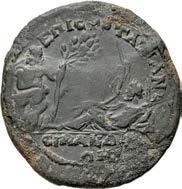
Leto was the divine daughter of two Titans, Coeus and Phoebe, and, by Zeus, the mother of the twin deities Apollo and Artemis. Little is recorded about her in the classical myths, except that, like many mortal women who had caught Zeus’ eye, she incurred the wrath of Hera and had to flee to the island of Delos in order to safely give birth.
Unpublished Capitoline Triad
394. CARIA, Trapezopolis. Hadrian. AD 117-138. Æ (30.5mm, 16.20 g, 6h). Ti. Fla. Max. Lysias, archon. Struck mid 120’s AD. AY KAI TPA AΔPIANOC CЄ, laureate, draped, and cuirassed bust right, aegis on shoulder, seen from the front / ΔIA T Φ MAΞ ΛYCIOYYIΘY ΠOΛЄΩN TPAΠЄZOΠOΛITΩN, The Capitoline Triad: Zeus Lydios, holding eagle and scepter, standing left between Hera to left, holding scepter and patera, and Athena to right, holding olive branch, spear, and shield. Unpublished in the standard references. Green-brown patina, roughness. VF. Extremely rare, unpublished. ($300)
The Capitoline Triad–Jupiter, Juno, and Minerva–are depicted here holding their various symbolic implements. Though appearing infrequently on Roman coinage, the Triad remained at the center of Roman religion until it was replaced by Christianity.


96
392 391
393 394
395. PHRYGIA, Aezanis. Augustus. 27 BC-AD 14. Æ (21mm, 8.60 g, 12h). Potitus Valerius Messala, proconsul. Struck circa 25 BC. Bare head of Potitus Valerius Messala left / Right hand holding scales; monogram to right. von Aulock, Aizanoi 7–8; RPC I 3067.6 (this coin); SNG von Aulock 3342. Green patina with red earthen highlights, cleaning scratches. Good Fine. Extremely rare. ($1000)

Ex Papillon 6 (7 May 2020), lot 305.
396. PHRYGIA, Cibyra. Vespasian(?). AD 69-79. Æ (28.5mm, 18.42 g, 11h). Laureate head right / Hexastyle temple, clippeus in pediment. Weiser, Kibyra –; RPC III 1261; BMC 40. Brown surfaces, roughness, minor deposits. VF. Very rare, only two in RPC. ($500)
RPC notes that the portrait could also be that of Nero. This coin uses the three bar sigma “4E∫Å4to4” whereas the other specimens use the quadrate style “ΣEBAΣTOΣ”. The two known specimens in RPC use the quadrate style. Unfortunately, both were in use at this time and neither emperor have any other coins with their portrait from this city for comparison. The identity of the obverse portrait will probably never be certain.
397. LYCAONIA, Iconium. Gordian III. AD 238-244. Æ (34mm, 24.39 g, 6h). Laureate, draped, and cuirassed bust right, seen from behind / Gordian on horseback galloping right, preparing to spear fallen enemy below; in exergue, harpa. von Aulock, Lykaoniens –; SNG BN –; RPC VII.2 Online 2768.3 (this coin). Olive green patina, earthen deposits. Good VF. Very rare, only three known to RPC, including this coin. ($750)
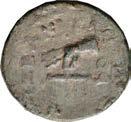
Ex Roma 3 (32 March 2012), lot 521 (hammer £1800).
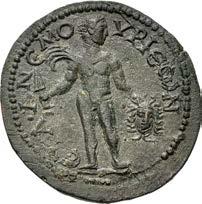


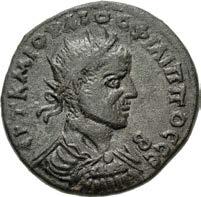
398. CILICIA, Anemurium. Maximinus I. AD 235-238. Æ Triassarion (34mm, 16.03 g, 6h). Dated RY 1 (235/6 AD). Laureate, draped, and cuirassed bust right, seen from the front, cuirass decorated with gorgoneion / Perseus standing facing, head left, holding sword and severed head of Medusa. Köhler-Osbahr 71; RPC VI Online 7014.10 (this coin); SNG BN 709 var. (holding harpa, same obv. die); SNG Levante 498 var. (same, same obv. die). Dark brown patina, minor roughness, small patch of lamination, scratches and doubling on obverse, die flaw on reverse. Near EF. Rare variety with Perseus holding a sword instead of harpa. ($750)
From the D.K. Collection. Ex Berk BBS 216 (27 July 2021), lot 505.
The Greek hero Perseus is shown here having just slain the Gorgon Medusa by cutting off her head, which then became a potent weapon for turning his enemies to stone.
399. CILICIA, Diocaesarea. Philip I. AD 244-249. Æ (33mm, 18.38 g, 6h). Radiate, draped, and cuirassed bust right, seen from behind / Tyche, turreted, draped, and veiled, seated right, holding grain ears; on right, another Tyche stands left, turreted and draped, holding rudder and cornucopia; below, river-god Calycadnus(?) swimming right. Staffieri, Diocaesarea 22; RPC VIII Online 2053 (this coin illustrated); SNG BN 879-82; SNG Levante 676. Olive green patina. Good VF. ($300)
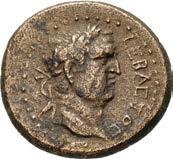


From the Dr. Michael Slavin Collection. Ex Classical Numismatic Group 55 (13 September 2000), lot 966.
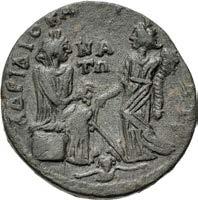
97
398 395 396
397
The Poet Aratus – Extremely Rare and Published
400. CILICIA, Pompeiopolis. Time of Marcus Aurelius. AD 161-180. Æ (18mm, 4.27 g, 12h). Dated CY 229 (AD 163/4). APA TOC, draped bust of Aratus right / ΠOMΠHIOΠOΛITΩN, Nike standing left on globe, holding wreath and palm; AΓ ΓT (date) across field. RPC IV –; SNG BN –; P. R. Franke, “Chrysippos und Aratos aus Soloi” in JNG 61, p. 19, no. 12 (this coin). Brown patina, roughness. Good Fine. Extremely Rare. ($500)
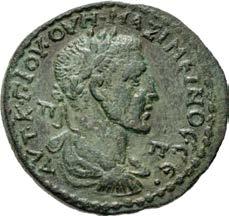


Ex Heidelberger Münzhandlung 64 (20 November 2014), lot 1291.
Born at Soli (Pompeiopolis) and a contemporary of the Helleistic poets Callimachus and Theocritus, Aratus was a disciple of the Peripatetic philosopher Praxiphanes. He was acquainted with several important scholars, including the Stoic philosopher Zeno, as well as Callimachus, and Menedemus, the founder of the Eretrian School of philosophy. In 276 BC, he was invited to the court of the Macedonian king Antigonus II Gonatas to compose a poem on that king’s victory over the Gauls the previous year. His most famous poem and major extant work, Phaenomena (“Appearances”), describes the constellations and other celestial phenomena, as well as weather lore. Aratus subsequently spent time at the court of Antiochus I Soter of Syria, but later returned to Pella in Macedon, where he died about 240 BC.
RPC Online Plate Coin
401. CILICIA, Tarsus. Maximinus I. AD 235-238. Æ (38mm, 24.55 g, 6h). Laureate, draped, and cuirassed bust right, seen from behind / The Three Graces (Charites) standing with arms around one another; central figure seen from behind, each holds a flower; B to right. RPC VI Online 7112.16 (this coin); SNG BN 1605 (same dies); SNG Levante 1096 var. (radiate bust & arrangement of rev. legend). Green patina, minor deposits on reverse. Good VF. ($1000)

From the D.K. Collection. Ex Berk BBS 217 (30 November 2021), lot 426; Classical Numismatic Review XLV.1, (Winter 2020), no. 528365; Gorny & Mosch 265 (14 October 2019), lot 1103; Gorny & Mosch 176 (10 March 2009), lot 1727.
The Three Graces (or Charites) were goddesses of beauty, charm, and amusement, the embodiment of loveliness in all its aspects. Although their names varied from place to place, the most commonly encountered are Aglaea (“Beauty”), Euphrosyne (“Cheer”), and Thalia (“Flowering”). Over time an artistic convention of depicting the Graces developed: the three deities were shown undraped, each with one arm placed on the figure adjacent to them, the central figure standing facing the opposite direction as the others. This is the convention that one finds in numismatic depictions of the goddesses. By the representation of the Three Graces, the city of Tarsus emphasized its claim for beauty according to its status “Kalliste,” the most beautiful city.
98
Antinoüs, Favorite of Hadrian
RPC Online cites only five examples, including this coin. ($3000)
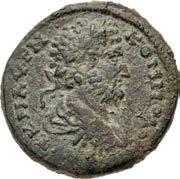
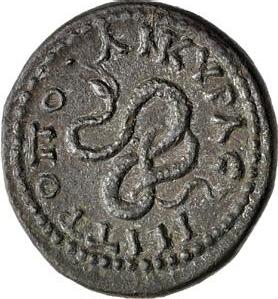
From the D.K. Collection. Ex Classical Numismatic Review XLV.1 (Winter 2020), no. 525646; Roma XVIII (29 September 2019), lot 765. One of the most remarkable cults of the ancient world was that which grew up around Antinoüs, a handsome youth from Claudiopolis in Bithynia, who attracted the attention of the emperor Hadrian and became his constant companion. Hadrian apparently encountered Antinous during a visit to Bithynia circa AD 123 and brought him back to Rome for higher education. He became one of the emperor’s pages and, by AD 128, an important part of his traveling retinue. During the emperor’s tour of Egypt in October AD 130, Antinoüs fell into the Nile and drowned, resulting in suspicions of suicide or ritual murder. The distraught Hadrian had his favorite immediately deified, and the worship of Antinoüs became an important facet of the imperial cult in the eastern Roman Empire.

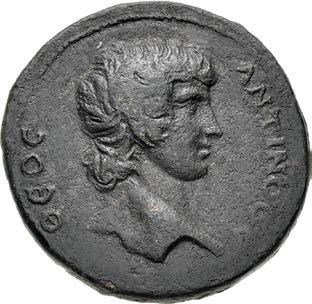
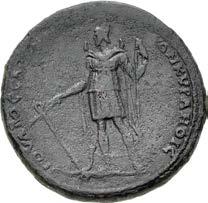
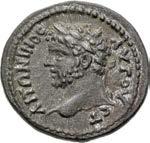
Third and Finest Known
/
draped, and cuirassed bust right,
suckling the twins Remus and Romulus; fig tree behind. Arslan –; SNG BN –; RPC
RPC describes the object above the wolf as “uncertain object (eagle on two wreaths?)” and that area is obscured by thick patina or a hole on the two known specimens. The tree on this
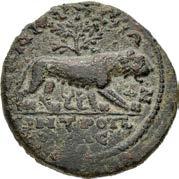
99
402. GALATIA, Ancyra. Antinoüs. Died AD 130. Æ (34mm, 25.46 g, 7h). Julius Saturninus, legatus Augusti. Bare head right / The god Mên standing left wearing cloak and oriental tiara, crescent on shoulder, holding anchor and scepter. Arslan –; Blum –; RPC III 2838.5 (this coin); SNG BN 2445 var. (draped bust). Dark brown surfaces, light overall porosity. Good VF. Very rare,
403. GALATIA, Ancyra. Commodus. AD 177-192. Æ (30mm, 16.81 g, 12h). Laureate,
seen from behind
She-wolf standing right,
IV.3 Online 3585 corr. (tree not described). Dark brown patina with earthen green highlights, light roughness. VF. Very rare, two known to RPC. ($300)
example is clear, correcting the RPC description.
404. GALATIA, Ancyra. Caracalla. AD 198-217. Æ (25mm, 7.81 g, 7h). Laureate head left / Coiled serpent. Arslan –; SNG BN –; SNG Hunterian 2171 var. (obv. legend); Malloy XIV (1979), lot 803 (same dies). Dark green patina, slight roughness, smoothing, details strengthened. Good VF. Very rare. ($400)
405. CAPPADOCIA, Caesarea-Eusebia. Domitian. AD 81-96. AR Didrachm (22mm, 7.19 g, 6h). Dated RY 13 (AD 93/4). AVT KAI ΔΟΜΙΤΙΑΝΟC CEBACTOC ΓΕΡΜ, laureate head right / Athena standing right, holding owl in right hand and spear in left, ЄTO IΓ (date) across field. Ganschow, Münzen 92a; Sydenham, Caesarea 124; RPC II 1669. Toned. In NGC encapsulation 4936335-010, graded XF, Strike: 4/5, Surface: 5/5, Fine Style. Well centered on a round flan of good metal, rare in this quality. ($1500)
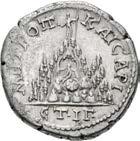

Eusebia, a city at the base of Mount Argaeus, became the capital of Cappadocia circa 163 BC and seat of King Ariarathes V Eusebes, after whom it was named. Cappadocia passed under Roman control in AD 17, and its capital, now renamed Caesarea-Eusebia, became the most important mint in eastern Asia Minor, producing silver coins in a range of denominations with both Latin and Greek legends. Dies and workmanship equaled those of Rome and the Syrian capital of Antioch, which shared its minting privileges. The coins were used to pay both soldiers and military contractors in the Roman province of Asia. Coins are often dated by regnal year, as is this pleasing didrachm of Domitian, dated to the 13th year of his rule (AD 93/4).
A Run of Rare Caesarea Tridrachms from the McAlee Collection
406. CAPPADOCIA, Caesarea-Eusebia. Septimius Severus. AD 193-211. AR Tridrachm (24mm, 8.22 g, 12h). Dated RY 17 (AD 208/9). Laureate, draped, and cuirassed bust right, seen from behind / Nike advancing left, holding wreath and palm frond; ЄT IZ (date) in exergue. Ganschow, Münzen 443.2 (this coin); Sydenham, Caesarea –. Lightly toned with underlying luster, small edge chips. Good VF. Extremely rare, one of only two specimens known to Ganschow. ($750)

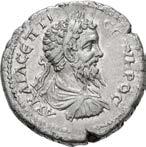
From the Richard McAlee Collection. Ex Berk BBS 116 (17 October 2000), lot 528.
407. CAPPADOCIA, Caesarea-Eusebia. Septimius Severus. AD 193-211. AR Tridrachm (25mm, 5.85 g, 11h). Dated RY 18 (AD 209/10). Laureate, draped, and cuirassed bust right, seen from behind / Radiate male figure seated left on Mt. Argaeus, holding branch and globe; ЄT IH (date) in exergue. Ganschow, Münzen 448f.6 (this coin); Sydenham, Caesarea Suppl. 403b. Lightly toned, minor porosity. VF. Rare. ($400)
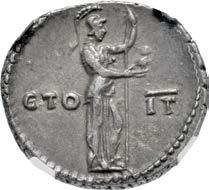
From the Richard McAlee Collection. Ex Classical Numismatic Group 84 (5 May 2010), lot 865.
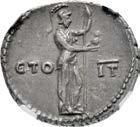

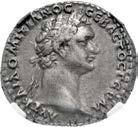
408. CAPPADOCIA, Caesarea-Eusebia. Julia Domna. Augusta, AD 193-217. AR Tridrachm (24mm, 7.32 g, 11h). Dated RY 13 of Severus (AD 204/5). Draped bust right / Mt. Argaeus surmounted by male figure holding scepter and globe; ЄT•IΓ• (date) in exergue. Ganschow, Münzen 472.1 (this coin); Sydenham, Caesarea –. Lightly toned with some iridescence, minor porosity and deposits. Good VF. Extremely rare, only this coin known to Ganschow. ($400)
From the Richard McAlee Collection. Ex Classical Numismatic Group 84 (5 May 2010), lot 867.
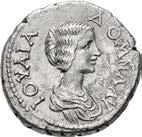
100
407 408
409. CAPPADOCIA, Caesarea-Eusebia. Julia Domna. Augusta, AD 193-217. AR Tridrachm (24mm, 8.55 g, 12h). Dated RY 18 of Severus (AD 209/10). Draped bust right / Nike advancing right, holding wreath and palm frond; ЄT IH (date) across lower field. Ganschow, Münzen 510b.1 (this coin); Sydenham, Caesarea –. Lightly toned, area of weak strike, minor porosity at edge. Good VF. Extremely rare, only this coin known to Ganschow. ($600)
From the Richard McAlee Collection. Ex Triton XIII (5 January 2010), lot 1471.
410. CAPPADOCIA, Caesarea-Eusebia. Caracalla. AD 198-217. AR Tridrachm (25mm, 9.16 g, 12h). Dated RY 13 of Septimius Severus (AD 204/5). Laureate, draped, and cuirassed bust right, seen from behind / Mt. Argaeus surmounted by male figure holding scepter and globe; ЄT IΓ (date) in exergue. Ganschow, Münzen 537c.1 (this coin); Sydenham, Caesarea –. Lightly toned with underlying luster, minor porosity and weakness at edge. Good VF. Extremely rare, only this coin known to Ganschow. ($500)
From the Richard McAlee Collection. Ex Berk BBS 116 (17 October 2000), lot 540.
411. CAPPADOCIA, Caesarea-Eusebia. Caracalla. AD 198-217. AR Tridrachm (23mm, 8.35 g, 12h). Dated RY 16 of Septimius Severus (AD 207/8). Laureate head right / Mt. Argaeus surmounted by male figure holding scepter and globe; ЄT Iς (date) in exergue. Ganschow, Münzen 584f.2 (this coin); Sydenham, Caesarea –. Lightly toned with underlying luster, minor porosity. Good VF. Rare. ($400)
From the Richard McAlee Collection. Ex Classical Numismatic Group 85 (15 September 2010), lot 615.
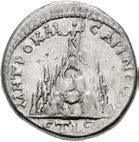
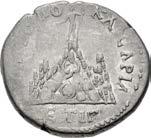
412. CAPPADOCIA, Caesarea-Eusebia. Geta. As Caesar, AD 198-209. AR Tridrachm (24mm, 8.45 g, 12h). Dated RY 13 of Septimius Severus (AD 204/5). Bareheaded, draped, and cuirassed bust right, seen from the front / Mt. Argaeus surmounted by male figure holding scepter and globe; ЄT IΓ (date) in exergue. Ganschow, Münzen 621b.1 (this coin); Sydenham, Caesarea –. Lightly toned, minor porosity, weak strike in obverse legend. Good VF. Extremely rare, only this coin known to Ganschow. ($1000)


From the Richard McAlee Collection. Ex Triton XIII (5 January 2010), lot 1491.
413. CYRRHESTICA, Beroea. Diadumenian. As Caesar, AD 217-218. BI Tetradrachm (24mm, 13.89 g, 12h). Radiate, draped, and cuirassed bust right / Eagle standing facing, head and tail left, with wings displayed, holding wreath in beak; palm frond to left; between legs, winged animal flanked by B-Є. Prieur 897 (same dies); Bellinger 90. Lightly toned, surfaces a little grainy. Good VF. Rare; four known to Prieur, three in CoinArchives, including this coin. ($300) Ex Classical Numismatic Group Electronic Auction 435 (2 January 2019), lot 253.

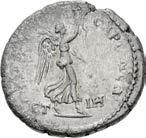
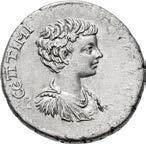
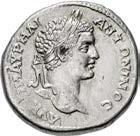

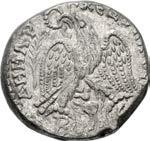
101
411
412
414. CYRRHESTICA, Cyrrhus. Caracalla. AD 198-217. BI Tetradrachm (25mm, 15.49 g, 12h). Struck AD 215-217. Radiate head right / Eagle standing facing on filleted thyrsus, head and tail right, with wings displayed, holding wreath in beak. Prieur 910 corr. (obv. legend); Bellinger –. Toned with iridescence, minor deposits. Good VF. Very rare, only four known to Prieur. ($300)

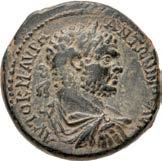



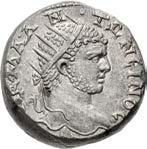




From the Richard McAlee Collection. Ex Baldwin’s 100 (27 September 2016), lot 781; Classical Numismatic Group 79 (17 September 2008), lot 637.
415. CYRRHESTICA, Hierapolis. Caracalla. AD 198-217. Æ (27mm, 17.05 g, 1h). Laureate, draped, and cuirassed bust right, seen from behind / Atargatis, wearing kalathos and holding scepter, seated left on lion advancing right. Butcher 54; SNG München 480 var. (rev. legend); cf. BMC 50-52. Dark brown patina with earthen highlights. Good VF. Very rare. Attractive. ($500)
Antony & Cleopatra
416. SELEUCIS and PIERIA, Antioch. Mark Antony & Cleopatra VII of Egypt. 36 BC. AR Tetradrachm (26mm, 14.74 g, 12h). Struck circa 36-34 BC. BACIΛICCA KΛЄOΠATPA ΘЄA NЄωTЄP[A], diademed bust of Cleopatra right, wearing earring, necklace, and embroidered dress / ANTωNIOC AVTOKPATωP TRITON TPIωN ANΔPωN, bare head of Antony right. McAlee 174; Prieur 27; RPC I 4094; HGC 9, 1361. Toned, porosity, scratches and deposits, off center on obverse. Near VF. ($7500)
These remarkable silver tetradrachms were probably struck at Antioch during the Parthian / Armenian campaign of 36-34 BC to honor perhaps the most famous “power couple” of all time. The attribution to Antioch remains uncertain and other mint sites in the Levant have been proposed; it is also possible they were struck at a mint moving with the army. The talented die engraver has taken particular care to give Cleopatra a powerful, almost masculine profile to complement Antony’s pugnacious portrait. Ancient historians note that Cleopatra was not incomparably beautiful (although none suggest she was anything less than pleasing to gaze upon), but her remarkable mind, her musical voice, and the vast wealth of her kingdom made her irresistible to two of the most powerful men of the age: Julius Caesar and Mark Antony. The titles display Cleopatra’s dominance in the relationship, depicting her on the obverse and touting her as “Queen Cleopatra, new (or “young”) goddess,” while Antony remains only a mortal “victorious general and Triumvir.”
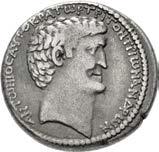

102
414 415
417. SELEUCIS and PIERIA, Antioch. Mark Antony & Cleopatra VII of Egypt. 36 BC. AR Tetradrachm (26mm, 15.42 g, 12h). Struck circa 36-34 BC. BACIΛICCA KΛЄOΠATPA ΘЄA NЄωTЄPA, diademed bust of Cleopatra right, wearing earring, necklace, and embroidered dress / ANTωNIOC AVTOKPATωP TRITON TPIωN ANΔPωN, bare head of Antony right. McAlee 174; Prieur 27; RPC I 4094; HGC 9, 1361. Toned, light porosity, a few scratches. Near VF. Well centered with complete legends on both sides. ($5000)
418. SELEUCIS and PIERIA, Antioch. Galba. AD 68-69. Æ As (29.5mm, 14.92 g, 12h). G. Licinius Mucianus, legatus Syriae. Dated Caesarian Era 117 (AD 68/9). Laureate head right / EΠI MOYKIA NOY AN TIOXEΩ N ET ZI P (date), within laurel wreath composed of eight sets of leaves. McAlee 311; Butcher 147i; RPC I 4313. Dark brown patina with light earthen deposits, small flan flaw on reverse. Near VF. Rare. ($500)
Gaius Licinius Mucianus was a Roman general and governor in Syria. He met then general Vespasian in AD 66 and by 69 had agreed to ally behind Otho, then take up arms against Vitellius, who had recently deposed Otho. It was agreed that Vespasian would stay behind in the east to quell a local revolt in Berytus while Mucianus marched west, picking up former praetorians who had previously supported Otho and those opposed to Vitellius. Mucianus arrived in Rome the day after the death of Vitellius to find Vespasian’s younger son, Domitian, sitting on the throne. The following day, Vespasian was declared emperor by the Senate. The year of the four emperors and the civil war had ended with Vespasian the victor, ushering in the beginning of the new Flavian era in Rome. Little is known of Mucianus’ life from this point on; it is believed that he became one of the emperor’s advisors and inner circle. He died in Rome before the end of Vespasian’s reign.
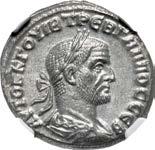


419. SELEUCIS and PIERIA, Antioch. Philip II. AD 247-249. BI Tetradrachm (27mm, 11.40 g, 6h). Struck AD 248. Laureate and cuirassed bust left, wearing balteus / Eagle standing left with wings displayed, holding wreath in beak; ANTIOCHIA, S C in exergue. McAlee 1051b; Prieur 461; RPC VIII Online 47998. Lightly toned. Well struck. In NGC encapsulation 4934478, graded MS, Strike: 5/5, Surface: 4/5. ($400)
NGC MS 5/5, 5/5
420. SELEUCIS and PIERIA, Antioch. Trebonianus Gallus. AD 251-253. BI Tetradrachm (25mm, 10.98 g, 6h). 1st officina. Struck AD 251. Laureate, draped, and cuirassed bust right; • below / Eagle standing facing, head and tail left, with wings displayed, holding wreath in beak; A between legs, S C in exergue. McAlee 1172a; Prieur 656; RPC IX Online 1787. Lightly toned, lustrous. In NGC encapsulation 5872737-298, graded MS, Strike: 5/5, Surface: 5/5. ($500)
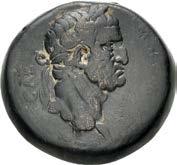
and
Uranius
Usurper,
253-254. BI Tetradrachm (26.5mm, 11.60 g, 12h). Radiate, draped, and cuirassed bust right, seen from behind / Eagle standing facing, head and tail left, with wings spread, holding wreath in beak; S C below wings, ЄMICA in exergue. Cf. Baldus 10-11 (dies VIII/– [unlisted rev. die]); Prieur –; RPC IX 1871 var. (SC below wings). Toned, small metals flaws, smoothing. VF. Very rare, unpublished variety of an already rare type.



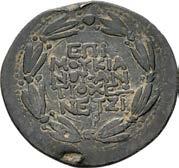
103
Rare Uranius Tetradrachm
421. SELEUCIS
PIERIA, Emesa.
Antoninus.
AD
($1000)
419
420
422. SELEUCIS and PIERIA, Gabala. Caracalla. AD 198-217. BI Tetradrachm (27mm, 13.26 g, 6h). Struck AD 215217. Laureate, draped, and cuirassed bust right, seen from behind / Eagle standing facing, head left, with wings displayed, holding wreath in beak; date-palm to right; between legs, crescent over crab. Prieur 1088; Bellinger 223. Toned with iridescence, a little weakly struck at high points. VF. Extremely rare, only two cited by Prieur, three in CoinArchives. ($300)
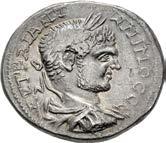

From the Richard McAlee Collection. Ex Peus 409 (25 April 2013), lot 788.
Rare Lighthouse of Laodicea
423. SELEUCIS and PIERIA, Laodicea ad Mare. Time of Domitian. AD 81-96. Æ (19mm, 5.03 g, 12h). Dated CY 141 (AD 93/4). Draped bust of Dionysus left, wearing vine wreath; to left, filleted thyrsus / Lighthouse of Laodicea; AMP (date) to left. Prieur & Amandry pl. 13, b; RPC II 2035A; SNG München 878. Rough brown surfaces, edge split. Near VF. Extremely rare. ($400)
424. SELEUCIS and PIERIA, Laodicea ad Mare. Septimius Severus. AD 193-211. AR Tetradrachm (25mm, 13.53 g, 11h). Struck circa AD 208-209. Laureate and draped bust right, seen from the front / Eagle standing facing, head and tail left, with wings displayed, holding wreath in beak; star between legs. Prieur & Amandry Group III, 34a; McAlee, Severan, Group III, 25; Prieur 1149. Lustrous. Good VF. ($300)
425. COELESYRIA, Chalcis ad Belum. Mark Antony and Cleopatra. 32-31 BC. Æ (22mm, 7.61 g, 12h). Dated RY 21 (Egyptian) and 6 (Phoenician) of Cleopatra (32/1 BC). Diademed and draped bust of Cleopatra right / Bare head of Antony right. Svoronos 1887; RPC I 4771; DCA 476; SNG München 1006; Sofaer 43. In NGC encapsulation 5772051-001, graded Ch XF, Strike: 4/5, Surface: 2/5. Well struck with clear portraits. ($750)
Ex Classical Numismatic Group Electronic Auction 432 (16 December 2020), lot 220.
426. COELESYRIA, Chalcis ad Belum. Mark Antony and Cleopatra. 32-31 BC. Æ (20mm, 5.56 g, 11h). Dated RY 21 (Egyptian) and 6 (Phoenician) of Cleopatra (32/1 BC). Diademed and draped bust of Cleopatra right / Bare head of Antony right. Svoronos 1887; RPC I 4771; DCA 476; SNG München 1006; Sofaer 43. Green patina with earthen deposits, scrape on obverse, porosity. Near VF. ($500)
Rare Cleopatra from Damascus
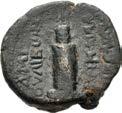
427. COELESYRIA, Damascus. Cleopatra VII Thea Neotera. 51-30 BC. Æ (23mm, 9.78 g, 12h). Dated CY 276 (37/6 BC). Diademed and draped bust right / Tyche seated left on rock, holding cornucopia; ςOΣ (date) and grain ear to left; below, river-god Orontes swimming right; all within wreath. Svoronos 1890; RPC I 4781; SNG Copenhagen 419. Green patina, with earthen green highlights. Good Fine. Rare. ($750)
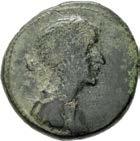
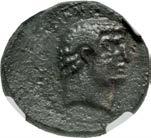
Ex Numismatica Ars Classica 64 (17 May 2012), lot 2247.

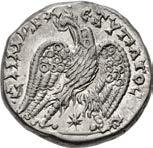
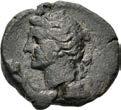


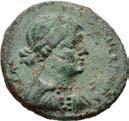
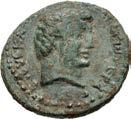
104
425 426 427 422 423 424
428. COELESYRIA, Heliopolis. Divus Septimius Severus. Died AD 211. Æ (24mm, 10.12 g, 12h). Struck under Caracalla, circa AD 211-212. Laureate, draped, and cuirassed bust right, seen from the front / Aerial perspective view of the temple of Jupiter Optimus Maximus Heliopolitanus. Sawaya 404 (D81/R157); BMC 4. Dark green patina with some earthen highlights/deposits, slight roughness on the obverse. VF. ($500)


From the Conti Collection. Ex Garth R. Drewry Collection (Classical Numismatic Group 69, 8 June 2005), lot 1218.
429. PHOENICIA, Aradus. Diadumenian. As Caesar, AD 217-218. BI Tetradrachm (26mm, 12.50 g, 1h). Radiate, draped, and cuirassed bust right, seen from behind / Eagle standing facing, head and tail right, with wings displayed, holding wreath in beak; between legs, bull’s head right. Prieur 1253 corr. (rev. legend); Bellinger 248. Toned, light porosity. VF. ($300)
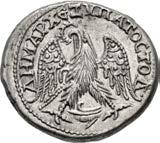

From the Richard McAlee Collection. Ex Baldwin’s 100 (27 September 2016), lot 806; Classical Numismatic Group 60 (22 May 2002), lot 1386.
430. PHOENICIA, Berytus. Caracalla. AD 198-217. BI Tetradrachm (26mm, 13.02 g, 12h). Struck AD 215-217. Laureate bust right, slight drapery on left shoulder / Eagle standing facing, head and tail left, with wings displayed, holding wreath in beak; between legs, prow left. Prieur 1293; Bellinger 282. Toned with underlying luster. Near EF. ($300)
From the Richard McAlee Collection.
Ex Michel Prieur Collection
431. PHOENICIA, Byblus. Caracalla. AD 198-217. AR Tetradrachm (27mm, 13.15 g, 12h). Struck AD 215-217. Laureate head right / Eagle standing facing, head left, with wings displayed, holding wreath in beak, atop garlanded altar; K to right. Prieur 1307 (this coin illustrated); Bellinger –. Toned, minor porosity, area of weakness in reverse legend. Good VF. Very rare, one of four cited by Prieur, four in CoinArchives. ($750)
From the Richard McAlee Collection. Ex Michel Prieur Collection (Triton XXII, 8 January 2019), lot 703.
432. PHOENICIA,
Caracalla. AD 198-217. AR Tetradrachm (25mm, 12.56 g, 6h). Struck AD 215-217. Laureate, draped, and cuirassed bust right / Eagle standing facing, head and tail left, wings displayed, holding wreath in beak; XX to right of head, three-horned altar between legs. Prieur 1318; Bellinger 266. Deeply toned, minor deposits. VF. Extremely rare, only two known to Prieur, one in CoinArchives. ($300)
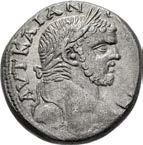

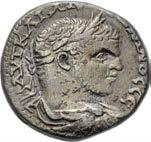
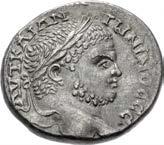

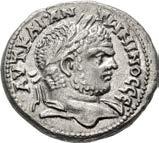
1358; Bellinger 289. Lightly toned, minor porosity, underlying luster. VF. ($300)
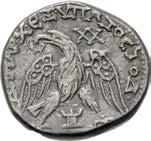
From the Richard McAlee Collection. Ex Garth R. Drewry Collection (Classical Numismatic Group Electronic Auction 136, 29 March 2006), lot 178; Classical Numismatic Group 60 (22 May 2002), lot 1396.
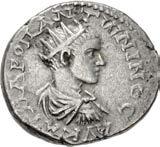
105
Byblus.
From the Richard McAlee Collection.
433. PHOENICIA, Sidon. Caracalla. AD 198-217. AR Tetradrachm (23.5mm, 12.38 g, 12h). Struck AD 215-217. Laureate head right / Eagle standing facing, head left, with wings displayed, holding wreath in beak; carriage of Astarte between legs. Prieur
428 429 430 431 432 433
Unique Variety – Ex Hendin Collection
434. JUDAEA, Procurators. Pontius Pilate. 26-36 CE. Æ Prutah (15mm, 2.02 g, 11h). In the names of Julia Augusta (Livia) and Tiberius. Jerusalem mint. Dated RY 16 of Tiberius (29/30 CE). Simpulum facing right; LIς (date) in legend / Three bound grain ears. Meshorer 331 var.; Hendin 6370d; RPC I 4967 var.; Bromberg –; Shoshana I 20192 var.; Sofaer 34–6 var.; Spaer 274 var. (all with simpulum facing left). Black patina with earthen dusting. Good VF. Unique variety, the only example seen by David Hendin. ($500)



Ex David Hendin Collection (Triton XIX, 5 January 2016), lot 369 (hammer $4500).
Finest Known Example - Referenced in RPC
435. JUDAEA, Aelia Capitolina (Jerusalem). Hadrian, with Aelius Caesar. 117-138 CE. Æ (24mm, 10.39 g, 1h). Laureate and draped bust of Hadrian right / Bare head of Aelius right. Meshorer, Aelia 8; RPC III 3969.16 (this coin); Rosenberger 8. Green patina with attractive earthen highlights. Good VF. Rare and likely the finest known example. ($750)
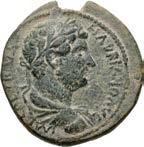
Ex Kenneth S. Abramowitz Collection (Triton XIX, 5 January 2016), lot 371 (hammer $1600).
Rare Legend Variety
436. JUDAEA, Aelia Capitolina (Jerusalem). Caracalla. 198-217 CE. BI Tetradrachm (26mm, 13.11 g, 6h). Struck 215-217 CE. Laureate, draped, and cuirassed bust right, seen from the front / ΔHMAPX ЄΞ VΠATOC T Δ, eagle standing facing on filleted thyrsus, head and tail left, with wings displayed, holding wreath in beak; wine jar between legs. Meshorer 89a var. (rev. legend); Prieur 1626-8 var. (same); Bellinger –; Sofaer 80 var. (same). Toned, minor porosity, light marks. VF. Very Rare. A rare legend variety, only four in CoinArchives. ($750)
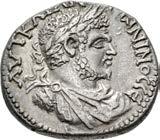
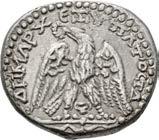

From the Richard McAlee Collection.
437. JUDAEA, Gaba. temp. Vespasian, 69-79 CE. Æ (16mm, 3.43 g, 12h). Dated CY 136 (77/8 CE). Veiled female head right, wearing earring / Nike standing left, holding wreath; PΛ ς (date; retrograde) in legend and field. Kindler, Geva 7; RPC II 2234; Rosenberger 3; Sofaer 2 (same dies). Earthen brown patina. VF. Very rare, only two known to RPC. ($500)

106
438. ARABIA, Bostra(?). Trajan. AD 98-117. AR Tridrachm (25mm, 10.24 g, 7h). Struck AD 112-114. Laureate and draped bust right, seen from behind / Cult image of Artemis of Perge within distyle shrine set on four steps; eagle in pediment. Ganschow, Münzen X15d; RPC III 4071 (Arabian mint); Metcalf, Tell Kalak 4; Sydenham, Caesarea 190. Attractive cabinet tone, minor pitting. Good VF. ($300)
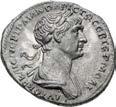

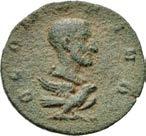
From the Richard McAlee Collection.
Traditionally thought to be tridrachms, but more recently termed tetradrachms (see K. Butcher, “The silver coinage of Roman Arabia,” Judaea and Rome in Coins 65 BCE-135 CE [London, 2012], p. 208). Ganschow, in his 2018 corpus, identifies them as tridrachms still.


439. ARABIA, Bostra(?). Trajan. AD 98-117. AR Drachm (19mm, 3.22 g, 7h). Struck AD 114-116. Laureate and draped bust right, seen from behind / Camel standing left. Ganschow, Münzen X19b; RPC III 4078 (Arabian mint); Metcalf, Tell Kalak –; Sydenham, Caesarea 204. Iridescent tone, minor porosity. Near EF. ($300)



From the Richard McAlee Collection.
440. ARABIA, Bostra(?). Trajan. AD 98-117. AR Drachm (19mm, 3.28 g, 7h). Struck AD 114-116. Laureate, draped, and cuirassed bust right, seen from behind / Camel standing left. Ganschow, Münzen X19d; RPC III 4076 (Arabian mint); Metcalf, Tell Kalak 18; Sydenham, Caesarea 205. Attractive cabinet tone with iridescence, short flan cracks, reverse slightly off center. Near EF. ($300)
From the Richard McAlee Collection.
holding
by
Ex Triton XXI (9 January 2018), lot 826.
The father of Philip I, Julius Marinus hailed from a small town in the province of Arabia (modern day Shuhba, Syria; the original name of the ancient town is unknown). Following the death of Marinus, Philip deified his father and had a temple to him built in his newly aggrandized hometown – now renamed Philippopolis and elevated to the rank of colonia
The neat fabric of the city’s coins is quite out of place for Arabia. This, combined with die links between the coins of Philippopolis, Zeugma, and Antioch, point to production at a central location, with Antioch being the likeliest candidate.

107
441. ARABIA, Philippopolis. Divus Julius Marinus. Died before AD 244. Æ (23mm, 5.60 g, 6h). Struck circa AD 247-249. ΘЄΩ MAPINΩ, bareheaded bust right, slight drapery on far shoulder, supported
eagle standing right / ΦIΛIΠΠOΠOΛIT-ΩN KOΛ[ΩNIAC], Roma or Allat standing left,
patera and spear, with shield at side; S C across field. Butcher, Two, pl. 25, 11; Spijkerman 2; Sofaer 2; SNG ANS 1402. Earthen green patina. VF. ($1000)
439
440
442. MESOPOTAMIA, Carrhae. Caracalla. AD 198-217. BI Tetradrachm (27mm, 11.55 g, 6h). Struck AD 215-217. Laureate, draped, and cuirassed bust left, seen from behind / Eagle standing facing on bull’s head, head right, tail left, with wings displayed, holding wreath in beak. Prieur 821; Bellinger –. Toned with underlying luster, minor porosity, scratch on reverse. Near EF. Rare. ($300)
From the Richard McAlee Collection.
443. EGYPT, Alexandria. Sabina. Augusta, AD 128-136/7. Æ Hemidrachm (28.5mm, 15.09 g, 12h). Dated RY 19 of Hadrian (AD 134/5). Draped bust right, wearing stephane / Pharos surmounted by two Tritons, each blowing a trumpet, between a lantern surmounted by a statue, holding situla and scepter; entryway below; L ЄNN ЄAKΔ (date) around. Köln 1270; Dattari (Savio) 2073; K&G 33.11; RPC III 6072.12 (this coin); Emmett 1343.19 (R4). Brown patina, with blue-green deposits, some porosity. VF. Rare. ($500)
Pedigreed to 1975
444. EGYPT, Alexandria. Marcus Aurelius & Lucius Verus. AD 161-169. BI Tetradrachm (23mm, 12.41 g, 11h). Dated RY 1 (AD 161/2). Laureate and draped busts of Lucius Verus and Marcus Aurelius, vis-à-vis / ЄIPHNH, Eirene seated left, holding patera, resting forearm on chair back; cornucopia at side; L A (date) across field. Köln –; Dattari (Savio) 9146; K&G 37.418; RPC IV.4 15617; Emmett 2041 (R3). Steel-grey patina, a couple of minor pits. VF. Very rare. ($500) Ex Scott Collection (Bowers & Ruddy Galleries, 5 June 1975), lot 1767.
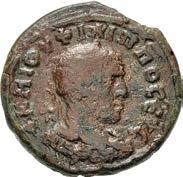
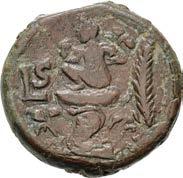
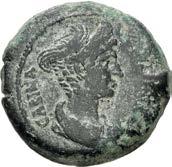
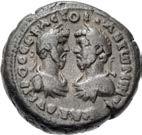


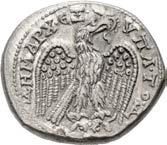


Extremely Rare Depiction of Harpocrates
445. EGYPT, Alexandria. Philip I. AD 244-249. Æ Drachm (30mm, 20.13 g, 12h). Dated RY 6 (AD 248/9). Laureate, draped, and cuirassed bust right / Harpocrates, crowned with skhent, seated left on lotus flower, raising finger to lips and holding flail; below, the serpent Uraeus erect left flanked by ears of grain with poppies; at right, palm frond; to left, L ς (date). Köln –; Dattari (Savio) 4942; K&G –; RPC VIII Online 2874 corr. (rev. description); Emmett 3524.6 (R3). Red surfaces, smoothing, minor deposits. Fine. Extremely rare, only one example in CoinArchives. ($500)
612; MAA 159; RPC I 857. Brown patina, roughness. VF. Very rare. ($500)
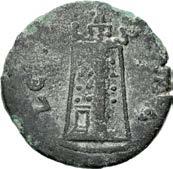
108
446. MAURETANIA, Tingi. 38-33 BC. Æ (28mm, 13.99 g, 12h). L. Aurelius Seneca and Q. Fabius Fabullus, quattuorviri. Two ears of grain / Head of Baal (or the Ocean) facing, transverse scepter behind. Amandry, Tingi Ia (D1/R1); Mazard
442 443
From the D.M.K. Collection.
ROMAN REPUBLICAN COINAGE

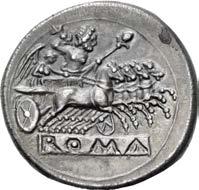

447. Anonymous. Circa 230 BC. Æ Aes Grave As (63mm, 299.0 g, 12h). Libral standard. Rome mint. Head of Roma right, wearing Phrygian helmet; i (mark of value) to left / Wheel of six spokes; i (mark of value) between spokes. Crawford 24/3; ICC 66; HN Italy 326; RBW 33. Green patina, light roughness, minor deposits. VF. ($3000)

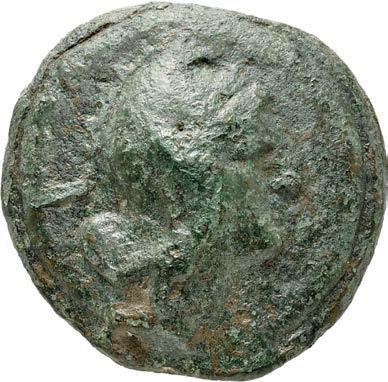
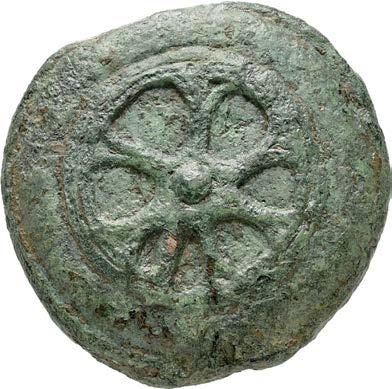
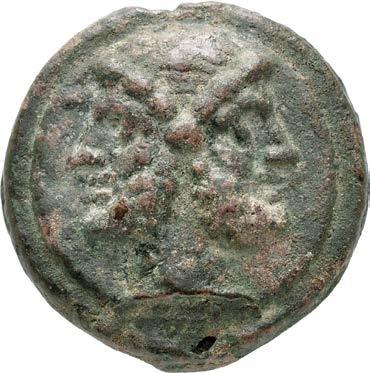
From the D.K. Collection.
448. Anonymous. Circa 225-217 BC. Æ Aes Grave As (61mm, 275.3 g, 12h). Rome mint. Head of bearded Janus; – (mark of value) below; all on a raised disk / Prow of galley right; i (mark of value) above; all on a raised disk. Crawford 35/1; ICC 74; Sydenham 71; HN Italy 337; RBW 83. Green-brown patina, deposits, small casting pit and edge flaw. Good VF. ($2000)

From the D.K. Collection.
449. Anonymous. Circa 225-212 BC. AR Didrachm – Quadrigatus (21.5mm, 6.64 g, 8h). Rome mint. Laureate head of Janus; straight truncation / Jupiter, hurling thunderbolt and holding scepter, in galloping quadriga right driven by Victory; incuse ROMA in raised tablet below. Crawford 28/3; Sydenham 64b; RSC 23; cf. RBW 64. Attractive cabinet toning, some light scratches under tone and minor die break on obverse. EF. ($1500)
Ex Father & Son Collection (Classical Numismatic Group 118, 13 November 2021), lot 888.
109
450. Anonymous. 211-210 BC. AR Denarius (19mm, 4.12 g, 11h). Grain ear (third) series. Uncertain mint in Sicily. Helmeted head of Roma right; x (mark of value) to left / The Dioscuri, each holding spear, on horseback right; two stars above, grain ear below; rOÂA in linear frame in exergue. Crawford 72/3; Sydenham 193; RSC 20m; RBW 305. Iridescent toning, minor areas of weak strike, die break on obverse. Near EF. Rare. ($750)
From the Michael Stolt Collection. Ex Numismatica Ars Classica 114 (6 May 2019) lot 385 (hammer 1800 CHF); JD Collection (Part III , Numismatica Ars Classica 78, 26 May 2014), lot 379; Numismatic Fine Arts XXVII (4 December 1991), lot 264.
451. Anonymous. 211-210 BC. AR Victoriatus (17mm, 3.42 g, 3h). Unmarked series. Uncertain mint in southeast Italy. Laureate head of Jupiter right / Victory standing right, crowning trophy. Crawford 83/1b; Schaefer & Friedman Fig. 22; Sydenham 83; RSC –; RBW 337. Lustrous, slightly off center. EF. ($750)
From the Michael Stolt Collection.
452. Anonymous. 211-208 BC. AR Victoriatus (16mm, 3.23 g, 9h). Unmarked series. Uncertain mint. Laureate head of Jupiter right / Victory standing right, crowning trophy. Crawford 90/2; Schaefer & Friedman Fig. 24; Sydenham 83; RSC –; RBW –. Lightly toned with underlying luster. EF. ($500)
453. Anonymous. 209-208 BC. AR Denarius (18mm, 4.43 g, 7h). Anchor (first) series. Rome mint. Helmeted head of Roma right; x (mark of value) to left / The Dioscuri, each holding spear, on horseback riding right; anchor below. Crawford 50/2; Sydenham 144; RSC 20a; RBW 186. Lightly toned, slight porosity. Near EF. Sharply struck from masterfully engraved dies. Rare. ($500)
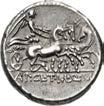

From the Michael Stolt Collection. Ex Artemide Aste LIV (7 November 2020), lot 157. (hammer €3000).
454. Anonymous. 209-208 BC. AR Denarius (18.5mm, 3.29 g, 1h). Staff series. Uncertain mint in Sicily. Helmeted head of Roma right; x (mark of value) to left / The Dioscuri, each holding spear, on horseback right; two stars above, staff right; rOÂA in linear frame in exergue. Crawford 78/1; Sydenham 208; RSC 20bb; RBW 326. Deeply toned with hints of luster, minor cleaning scratches. EF. ($500)

From the Michael Stolt Collection. Ex Numismatica Ars Classica 73 (18 November 2013), lot 30; Schweizerische Kreditanstalt 4 (3 December 1985), lot 324.
455. Man. Aemilius Lepidus. 114-113 BC. AR Denarius (19mm, 3.76 g, 7h). Rome mint. Laureate, diademed, and draped bust of Roma right; • (mark of value) to left / Equestrian statue right on three arches. Crawford 291/1; Sydenham 554; Aemilia 7; RBW 1124. Light iridescent tone, minor flan flaw on reverse. EF. Rare this nice. ($400)
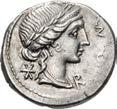
and Q. Urbinius. 111-110 BC. AR Denarius (17mm, 3.89 g, 3h). Rome mint. Helmeted head of Roma right; quadrangular device to left / Victory, holding reins, driving triga right. Crawford 299/1a; Sydenham 570; Claudia 2; BMCRR Rome 1290; Kestner 2552–3; RBW 1141. Attractive iridescent cabinet tone. Good VF. ($300)






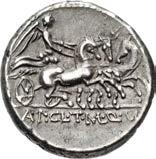
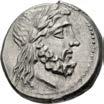


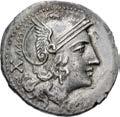

110
450 451 452 453 454 455
456. Appius Claudius Pulcher, T. Manlius Mancius,
457. Lucius Appuleius Saturninus. 104 BC. AR Denarius (20mm, 3.85 g, 6h). Rome mint. Helmeted head of Roma left / Saturn, holding harpa and reins, driving quadriga right; C below. Crawford 317/3b; Sydenham 578a; Appuleia 1; RBW 1171 var. (control mark). Iridescent tone. EF. ($300)
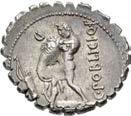
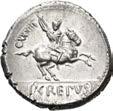
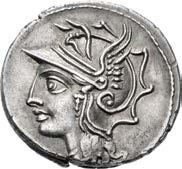

Lucius Apuleius Saturninus was elected moneyer in 104 BC, from whence he rose to Tribune of the Plebs from 103 to 100 BC as an ally to the “outsider” general and Consul Gaius Marius. At Marius’s behest, he introduced land reform measures rewarding retiring soldiers with large tracts of land in Italy and the provinces, which put him squarely at odds with the aristocrat-favoring optimates in the Senate. Like the Gracchi before him, he relied on the votes of the common people, along with violence and illicit coercion, to retain office and ram his program through. Ultimately he pushed things too far and lost the support of Marius, who ordered his arrest following the Senate’s “Ultimate Decree.” Kept in the Curia Hostilia awaiting trial, he and dozens of his supporters were murdered by the hired goons of his enemies, who climbed on the roof and pelted the prisoners with roof tiles. His descendants included the Triumvir Lepidus.





Abduction of the Sabine Women
458. L. Titurius L.f. Sabinus. 89 BC. AR Denarius (20mm, 3.86 g, 5h). Rome mint. Bearded head right of the Sabine king, Tatius; ë (for Tatius) to right / Abduction of the Sabine women: two Roman soldiers, facing each other, each carrying off a Sabine woman in his arms. Crawford 344/1a; Sydenham 698; Tituria 1; RBW –. Iridescent tone. EF. Exceptional strike, showing facial details of the figures on the reverse. ($750) Ex Numismatica Ars Classica 78 (26 May 2014), lot 619.

The tale of the “Rape of the Sabine Women” (”rape” in the sense of an abduction, rather than a sexual assault), as related by Livy, dates from the early history of Rome. Romulus and his male followers, having founded Rome, found themselves in desperate need of females to take to wife and grow their community. According to Livy, Romulus attempted to negotiate with his neighbors for their daughters to supply the Roman men with brides, but having failed, he devised a plan to abduct the women instead. He held a large festival and invited the neighboring tribes to attend; at a given signal the Roman men grabbed the Sabine girls and carried them off to their homes. The women were offered proper marriage and property rights, which all of them accepted. The Sabines went to war to get their daughters back, lead by King Tatius (depicted on the obverse of this issue), but at a critical point in the conflict, the Sabine women appeared and threw themselves between the combatants, imploring fathers and husbands alike to cease fighting. The men relented and agreed to unite the Roman and Sabine people, with Tatius and Romulus ruling jointly. The tale had special relevance to the moneyer, whose name indicates his Sabine lineage, and to the political context of 89 BC, with Rome just emerging from the Social Wars, which the moneyer conflates with the struggle between Rome and the Sabines, ultimately resulting in unification.

111
459. Pub. Crepusius. 82 BC. AR Denarius (18.5mm, 3.91 g, 9h). Rome mint. Laureate head of Apollo right, with scepter over shoulder; r to left, leaf below chin / Horseman galloping right, brandishing spear; Cxxxiii to left. Crawford 361/1c; Sydenham 738a; Crepusia 1; RBW –. Underlying luster, minor marks. EF. ($300)
460
460. C. Poblicius Q.f. 80 BC. AR Serrate Denarius (20.5mm, 4.02 g, 6h). Rome mint. Helmeted and draped bust of Roma right; D above / Hercules standing left, strangling the Nemean Lion; club at his feet; to left, D above bow and quiver. Crawford 380/1; Sydenham 768; Poblicia 9; RBW 1408 var. (control). Iridescent toning, a few light scratches on obverse. Good VF. ($300)
459
461. C. Naevius Balbus. 79 BC. AR Serrate Denarius (18mm, 3.78 g, 5h). Rome mint. Diademed head of Venus right / Victory driving galloping triga right, holding reins; x above. Crawford 382/1b; Sydenham 769b; Naevia 6; RBW 1410 var. (control). Cabinet tone, tiny area of flat strike on reverse. EF. ($300)

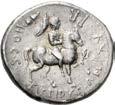



Ex Classical Numismatic Group 40 (with Numismatica Ars Classica, 4 December 1996), lot 1270.
462. P. Satrienus. 77 BC. AR Denarius (17mm, 3.64 g, 6h). Rome mint. Helmeted head of young Mars right; %xii to left / She-wolf standing left with paw raised. Crawford 388/1b; Sydenham 781a; Satriena 1; RBW 1422. Gray and iridescent toning, some die wear and horn silver on obverse, areas of roughness on reverse. Near EF. ($500)
Ex Chiltern Collection (Triton XVI, 8 January 2013), lot 778.
The she-wolf (or lupa) figures prominently in Roman mythology and iconography. The Roman foundation myth holds that the city’s founders, the brothers Romulus and Remus, were abandoned by order of the hostile king Amulius of Alba Longa, but were found by a she-wolf, who brought them to her den and suckled them as her own pups. The wolf, both with and without the twins, thereafter became a symbol of Rome, appearing in statuary, mosaics, and finally coins.
463. M. Aemilius Lepidus. 58 BC. AR Denarius (18mm, 3.99 g, 4h). Rome mint. Laureate and diademed female head (Rome?) right; palm frond to left / Equestrian statue of M. Aemilius Lepidus right, holding trophy over shoulder. Crawford 419/1c; Sydenham 830a; Aemilia 22a; RBW –. Light cabinet tone with golden iridescence around devices. EF. A rare Crawford number. ($500)
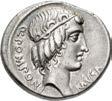
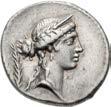
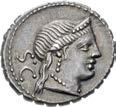
A wily and wealthy nobleman, Marcus Aemilius Lepidus parlayed his position as Julius Caesar’s colleague in the consulships of 46 BC into the role of power broker between the rivals Mark Antony and Octavian after the great dictator’s murder. He won wide-ranging Triumviral powers in the settlement of 43 BC, but took no part in the campaign against Brutus and Cassius and soon lost influence. He helped Octavian defeat Sextus Pompey in 36 BC, but afterward overreached and was easily outmaneuvered by Octavian and stripped of all real powers, retaining only the post of Pontifex Maximus, which he held until his death in 12 BC. This denarius was struck at the outset of his political career. The statue on the reverse honors his great-grandfather of the same name, consul of 187 and 175 BC, a highly successful politician and statesman described by Polybius as “the handsomest man of his time.”
464. Q. Pomponius Musa. 56 BC. AR Denarius (17.5mm, 4.03 g, 7h). Rome mint. Diademed head of Apollo right / Hercules Musagetes, Conductor of the Muses, standing right, wearing lion skin and playing lyre; club to right. Crawford 410/1; Sydenham 810; Pomponia 8; RBW –. Toned. Near EF. ($750)
The Muses were nine divine maidens, the daughters of Zeus and Mnemosyne (Memory), who embodied the human arts and sciences. They were Calliope (epic poetry), Clio (history), Erato (erotic poetry), Euterpe (music, lyric poetry), Melpomene (tragedy), Polyhymnia (hymns), Terpsichore (dance), Thalia (comedy), and Urania (astronomy). Knowingly or not, the moneyer Q. Pomponius Musa’s denarius group, surely intended as a canting pun on his cognomen, created a “collector’s set” of coins that challenged the holder of one example to find all of its components, which includes Hercules Musarum, the “host” or “conductor” of the assembly.
112
461 462 463 464
The ‘Other’ Erato
A Reassessment” in FIDES, for the identification of the muse as Erato. Lustrous. Good VF. ($750)

This type is called “Terpsichore” by Crawford and most other authors, but Phil Davis has recently identified this coin type as Erato. A complete discussion of this subject can be found in the article Phil wrote for the festschrift created for the late Rick Witschonke (FIDES, pp. 393-401). Phil’s logic is very sound and will make completing a set of Muses much easier, as the previously rare, known from a single die, Erato is now shown to be a die variety. (Davis identifies the obverse turtle symbol as being for Terpsichore.)



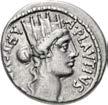
Splendid Reverse
3.83 g, 6h). Rome mint. Veiled head of Vesta right / Curule chair within Temple of Vesta; urn to left, voting tablet inscribed AC (Absolvo Condemno) to right. Crawford 428/1; Sydenham 917; Cassia 9; RBW 1533. Iridescent toning, slightly off center. Near EF. Well struck Temple of Vesta. ($750)
Ex Pegasi Numismatics BBS 141 (21 February 2012), lot 294.

Bacchius Judaeus
467. A. Plautius. 55 BC. AR Denarius (17mm, 3.89 g, 6h). Rome mint. Turreted head of Cybele right / Bacchius Judaeus (Aristobulus II, High Priest and King of Judaea) kneeling right, holding reins and offering up olive branch; to left, camel standing right. Crawford 431/1; Sydenham 932; Plautia 13; RBW 1540. Minor marks, light porosity. Good VF. ($500)

The enigmatic “Bacchius the Jew” depicted in supplication on the reverse has been plausibly identified by Michael Harlan as the Judaean high priest Aristobulus II, who was deposed by Pompey the Great after his siege of Jerusalem in 63 BC. The moneyer, Aulus Plautius, is known to have been a partisan of Pompey’s, and his choice of coin types suggests he served under Pompey in the campaign.
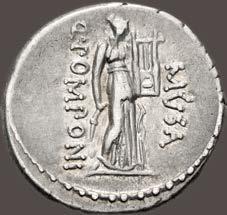

113
465. Q. Pomponius Musa. 56 BC. AR Denarius (18mm, 3.95 g, 9h). Rome mint. Laureate head of Apollo right; handle of plectrum to left / Erato, the Muse of Erotic Poetry, standing right, holding plectrum and lyre. Crawford 410/7d corr. (obv. symbol and rev. type); Sydenham 820a corr. (same); Pomponia 17a corr. (same); RBW –; see P. Davis, “Erato or Terpsichore:
466. Q. Cassius Longinus. 55 BC. AR Denarius (18mm,
468. L. Vinicius. 52 BC. AR Denarius (18mm, 3.84 g, 8h). Rome mint. Laureate head of Concordia right / Victory flying right, carrying palm frond decorated with four wreaths. Crawford 436/1; Campana, Vinicius 25-39 (O2/R3); Sydenham 930; Vinicia 1a; RBW 1548. Patches of luster, banker’s mark on obverse, light graffiti in field on reverse. Good VF. Of the 11 obverse dies recorded in Campana, only one has this obverse legend variation. Rare variety. ($300)


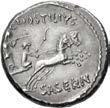
This reverse type depicts Victory carrying four wreaths attached to a palm frond, referring to Pompey’s three recent triumphs on three continents (Europe, Asia, and Africa), together with a fourth wreath, which is the golden crown, conferred on him by the Senate on the occasion of his triumph in 63 BC. The reverse also celebrates the good relationship between Pompey, Julius Caesar, and Crassus.
The Gallic Chieftain - Vercingetorix
469. Moneyer issues of Imperatorial Rome. L. Hostilius Saserna. 48 BC. AR Denarius (17.5mm, 3.93 g, 6h). Rome mint. Head of Gallic captive (Vercingetorix?) right; Gallic shield to left / Two warriors in galloping biga right: one driving, holding whip and reins, and the other, facing backward, holding shield and brandishing spear. Crawford 448/2a; CRI 18; Sydenham 952; Hostilia 2; RBW 1569. Attractive old cabinet tone with some light iridescence, slightly off center, some minor die wear on obverse. EF. Outstanding portrait of Vercingetorix. ($2000)
From the Collection of a London Novelist, purchased from Sovereign Rarities. Ex Numismatica Ars Classica 100 (29 May 2017), lot 342.
The portrait on the obverse has sometimes been identified as the famous chief of the Arverni, Vercingetorix, whom Julius Caesar captured in 52 BC in Alesia. It is difficult to imagine anyone placing such a dramatic portrait of a defeated foe on their coinage, but it is clear from surviving sources of the period that the Romans had a good deal of respect for the Gauls as honorable warriors. Crawford and Sear believe this identification is unlikely, but the large, distinctive, and carefully engraved head suggests the die cutter worked with an eye toward creating an individualized portrait, rather than a stylized personification of a Gaul. The reverse is also of particular historical interest, in that it depicts the manner in which chariots were used in Celtic Gaul, and perhaps in Britain as well.



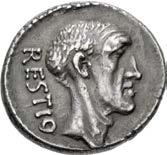

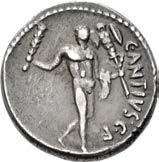
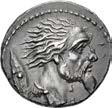

114
470. Moneyer issues of Imperatorial Rome. L. Hostilius Saserna. 48 BC. AR Denarius (17mm, 3.95 g, 6h). Rome mint. Bare head of Gallia right; carnyx (Gallic trumpet) to left / Diana (Artemis) of Ephesus standing facing, placing hand on head of stag, leaping left, and holding spear. Crawford 448/3; CRI 19; Sydenham 953; Hostilia 4; RBW 1570. Lightly toned, areas of luster. EF. ($750)
471. Moneyer issues of Imperatorial Rome. C. Antius C.f. Restio. 47 BC. AR Denarius (18mm, 4.01 g, 3h). Rome mint. Bare head of the tribune C. Antius Restio right / Hercules advancing right, holding club and trophy, lion skin over arm. Crawford 455/1a; CRI 34; Sydenham 970; Antia 1; RBW 1593. Old cabinet tone. Good VF. Well centered and struck for issue. ($750)
Implements for the Production of Coins
472. Moneyer issues of Imperatorial Rome. T. Carisius. 46 BC. AR Denarius (17.5mm, 3.40 g, 3h). Rome mint. Head of Juno Moneta right, two locks of hair on neck / Implements for coining money: anvil die with garlanded punch die above, tongs and hammer on either side; all within laurel wreath. Crawford 464/2; CRI 70; Sydenham 982b; Carisia 1b; RBW –. Oval flan, banker’s mark on obverse. Good VF. ($400)
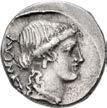
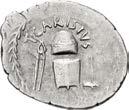
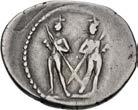

A temple to Juno Moneta (Juno “the Advisor”) was dedicated on the Capitoline Hill in 344 BC and its grounds served as Rome’s first mint. The association between this temple and the minting of coinage was such that the English words “mint,” “money,” and “monetary” derive from “moneta.”
473. Moneyer issues of Imperatorial Rome. T. Carisius. 46 BC. AR Denarius (17.5mm, 3.71 g, 7h). Rome mint. Head of Juno Moneta right, one lock of hair on neck / Implements for coining money: anvil die with garlanded punch die above, tongs and hammer on either side; all within laurel wreath. Crawford 464/2; CRI 70; Sydenham 982a; Carisia 1a; RBW 1614. Light cabinet tone. Good VF. One of the few coins to display the implements used in coin production. ($300)
474. Moneyer issues of Imperatorial Rome. Lollius Palicanus. 45 BC. AR Denarius (20mm, 3.91 g, 10h). Rome mint. Diademed head of Libertas right / View of Rostra in the Roman Forum, ornamented with ships’ beaks and surmounted by subsellium (tribune’s bench). Crawford 473/1; CRI 86; Sydenham 960; Lollia 2; RBW 1652. Lightly toned with underlying luster, slightly off center. EF. ($750)
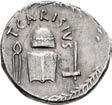
The First Portrait of Brutus?
475. Moneyer issues of Imperatorial Rome. L. Servius Rufus. 43 BC. AR Denarius (22mm, 3.76 g, 6h). Uncertain Sicilian mint. Bare head (of Brutus?) right; L · ÍeruiuÍ ruFuÍ around / The Dioscuri standing facing, each holding spear and with sword hanging from waist. Crawford 515/2; CRI 324; Sydenham 1082; Sulpicia 10; BMCRR Rome 4205; Kestner 3789; RBW 1793. Lightly toned, light marks, area of weak strike at edge. VF. ($5000)
Ex Historical Scholar Collection; Numismatica Ars Classica M (20 March 2002), lot 2548; Birkler & Waddell IV (9 December 1982), lot 410.
The portrait on this type, issued during the confused period between the assassination of Julius Caesar in March of 44 BC and the formation of the Second Triumvirate in November 43 BC, is almost certainly that of Marcus Junius Brutus, Caesar’s lead assassin. Crawford assigned the date as 41 BC, which was followed by Sear; this was corrected to 43 by B. Woytek in Arma et Nummi (Vienna, 2003), pp. 433-445. In this context, the striking of a coin clearly favoring the anti-Caesarian faction seems to have been part of a Senatorial strategy aimed at hedging bets against all possible outcomes in the looming civil war. The moneyer, L. Servilius Rufus, is only known from his coins; as part of the Tresviri Monetales for the year, he clearly chose to favor the assassins, while the other two, M. Arrius Secundus and C. Numonius Vaala, struck coins with portraits resembling the young Octavian and the deceased Caesar (or possibly the current senior consul, Aulus Hirtius), respectively. Notably lacking is a portrait resembling Mark Antony, who was currently in rebellion against all the other factions. All of these coins are rare, indicating a rather limited issue, versus the extraconstitutional coinage being rapidly hammered out by the opposing sides in the buildup to war. The portrait on Rufus’s issue has also been assigned to an ancestor, Servius Sulpicius Rufus, but there is little or no basis for this attribution. Its close resemblance to surviving portrait busts and coins of Brutus, including the famous Eid Mar type, leaves little doubt of the subject’s true identity. As such it is the most affordable available coin type with a contemporary portrait of Brutus. Intriguingly, with Woytek’s dating, it seems clear this is also the first numismatic portrait of Brutus, anticipating the Eid Mar and other issues of Brutus by about a year.

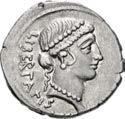

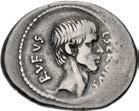
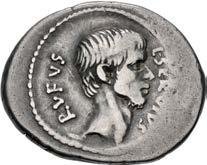
115
472 473
476. Moneyer issues of Imperatorial Rome. L. Mussidius Longus. 42 BC. AR Denarius (17mm, 3.91 g, 7h). Rome mint. Diademed and veiled head of Concordia right; star below chin / Shrine of Venus Cloacina: Circular platform surmounted by two statues of the goddess, each resting hand on cippus, the platform inscribed CLOACiN and ornamented with trellispattern balustrade, flight of steps and portico on left. Crawford 494/42b; CRI 188a; Sydenham 1093a; Mussidia 6; RBW 1745. Underlying luster, minor marks, small die flaw on obverse. Near EF. Sharply struck reverse. ($500)
477. Moneyer issues of Imperatorial Rome. C. Vibius Varus. 42 BC. AR Denarius (19mm, 3.88 g, 6h). Rome mint. Laureate and bearded head of Hercules right / Minerva standing right, holding spear and Victory; shield set on ground to right. Crawford 494/37; CRI 193; Sydenham 1139; Vibia 23; RBW 1740. Residual luster, lightly toned, minor porosity. Good VF. ($500)

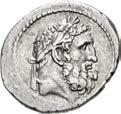

478. Moneyer issues of Imperatorial Rome. P. Accoleius Lariscolus. 41 BC. AR Denarius (20mm, 4.14 g, 1h). Rome mint. Draped bust of Diana Nemorensis right, hair closely bound with fillet / Triple cult statue of Diana Nemorensis facing, supporting on their hands and shoulders a beam, above which are five cypress trees, the figure on left holding poppy in right hand, that on right holding lily in left hand. Crawford 486/1; CRI 172; Sydenham 1148; Accoleia 1; RBW 1701–2. Light iridescent toning, traces of underlying luster. Near EF. ($500)
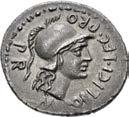

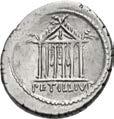
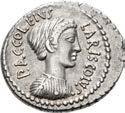
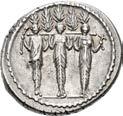
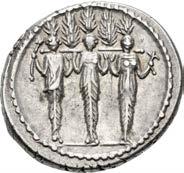
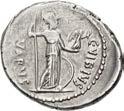

479. Moneyer issues of Imperatorial Rome. Petillius Capitolinus. 41 BC. AR Denarius (19mm, 3.76 g, 9h). Rome mint. Bare head of bearded Jupiter right / The Temple of Jupiter Capitolinus: richly decorated hexastyle façade with ornamented pediment and garlands hanging within three openings. Crawford 487/1; CRI 173; Sydenham 1149; Petillia 1; RBW 1703. Light iridescence with residual luster, off center on obverse. Good VF. ($500)
Cnaeus Pompey Jr
480. The Pompeians. Cnaeus Pompey Jr. Summer 46-Spring 45 BC. AR Denarius (20.5mm, 3.65 g, 6h). Corduba mint; Marcus Poblicius, legatus pro praetore. Helmeted head of Roma right / Hispania standing right, shield on her back, holding two spears over shoulder and presenting palm frond to Pompeian soldier standing left on prow, armed with sword. Crawford 469/1a; CRI 48; Sydenham 1035; RSC 1 (Pompey the Great); RBW –. Toned, some porosity, slightly off center on reverse. Good VF. ($750)
The elder son of Pompey the Great, Gnaeus Pompey the Younger took up the banner of Republican resistance to Julius Caesar after his father’s defeat and death. He was born in 75 BC to Gnaeus Pompeius Magnus, Rome’s leading general, and Mutia Tertia, his third wife. Unlike his more charming younger brother, Sextus Pompey, Gnaeus lacked his father’s brilliance and had a vicious streak which disturbed his father’s supporters. When Julius Caesar crossed the Rubicon in 49 BC to seize control of the state, Pompey and both his sons fled Rome along with most of the Senate. The elder Pompey placed Gnaeus in charge of a fleet summoned from Egypt that sank several of Caesar’s ships as they attempted to land troops and supplies in Greece. Despite this victory, Caesar defeated Pompey at Pharsalus and pursued him to Egypt, where the old general met his end. Gnaeus and Sextus at first fled to Africa, where they helped Cato and Metellus Scipio raise a new army. Again defeated by Caesar at Thapsus in 46 BC, the Pompey brothers took ship to Spain, where they joined forces with Titus Labienus and raised yet another army. Once again, Caesar pursued. The battle of Munda on March 17, 45 BC was an extremely close-run affair that could have gone either way, but a timely cavalry charge led by one of Caesar’s allies won the day. As at Thapsus, Gnaeus and Sextus managed to escape. But after they parted ways, Gnaeus’ ship was chased down by Caesar’s fleet, and Gnaeus was captured and summarily executed. Sextus managed to give the Caesarians the slip and survived to resist the rule of Caesar and his successors for another decade.
116
476 477 479 480
Exceptional Sextus Pompey
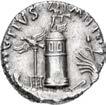
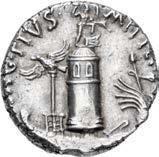


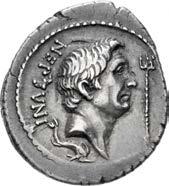
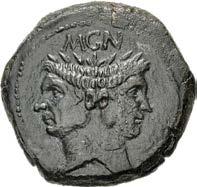
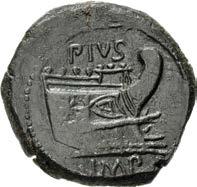

481. The Pompeians. Sextus Pompey. 42-38 BC. Æ As (32.5mm, 26.66 g, 12h). Uncertain Sicilian mint. Laureate Janiform head of Pompey the Great / Prow of galley right. Crawford 479/1; Martini, Sextus Emission III, Group 1, Series A; CRI 336; Sydenham 1044a; RBW 1676. Glossy brown patina, light roughness at upper periphery, scratch on obverse. Near EF. In fine style, exceptional. ($750)
From the D.K. Collection.
The roller-coaster career of Sextus Pompey, youngest son Pompey The Great, spanned the dying years of the Roman Republic and its rebirth as an Empire. Born around 67 BC in Rome, Sextus came of age during Pompey’s ascendancy as the leading general of Rome and the most powerful man in the Republic. After Pompey’s defeat by Julius Caesar at Pharsalus in 48 BC, Sextus joined his father’s flotilla sailing for the supposed safe haven of Egypt. He thus witnessed firsthand his father’s treacherous murder by minions of King Ptolemy XIII. Caesar’s assassination on March 15, 44 BC brought a brief revival of Senatorial control during which Sextus, improbably, found himself appointed commander of the Roman fleet. He wasted no time in seizing Sicily and spent the next months building an impregnable power base on the island even as Rome fell under the sway of Caesar’s political heirs, Antony, Octavian, and Lepidus. While the Triumvirs hunted down Caesar’s assassins, Sextus enjoyed a rollicking life as a pirate king, using his fleet to raid far and wide. Octavian in particular hated the charismatic Sextus and repeatedly sent fleets and armies against Sicily to dislodge him, only to meet humiliating defeat each time. Finally, at the battle of Naulochus in 36 BC, Sextus met his match in Octavian’s brilliant commander, Marcus Agrippa. Defeated and stripped of his fleet, he fled to the East and tried to make a separate peace with Mark Antony. Although tempted, Antony was not yet ready to break with Octavian and had Sextus put to death.
Excellent Portrait of Pompey the Great
483/2;
235;
1350;
From the Collection of a London Novelist. Ex Classical Numismatic Review XLIV.2 (Summer 2019), no. 511005; Spink (27 March 2019), lot 250.
of dogs and fishes, wielding a rudder as a club with both hands. Crawford 511/4a-c; CRI 335; Sydenham 1348; RSC 2;
From the Collection of a London Novelist. Ex Classical Numismatic Review XLIV.2 (Summer 2019), no. 514997; Numismatica Ars Classica 78 (26 May 2014), lot 757.
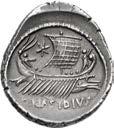

117
482. The Pompeians. Sextus Pompey. 42-38 BC. AR Denarius (17.5mm, 3.74 g, 12h). Massilia (Marseilles) mint; Q. Nasidius, commander of the fleet. Bare head of Pompey the Great right; trident to right; below, dolphin right; NepTuNi to left / Galley with bank of rowers right, under full sail, helmsman steering rudder, hortator standing on prow; star to upper left; œ • NAÍiDiuÍ below. Crawford
CRI
Sydenham
RSC 20 (Pompey the Great); RBW 1698. Deeply toned, a couple of minor flan flaws on obverse. Near EF. An excellent portrait and complete depiction of a galley with nautical and mythological imagery. ($7500)
483. The Pompeians. Sextus Pompey. 40-39 BC. AR Denarius (16.5mm, 3.96 g, 11h). Uncertain Sicilian mint. The Pharos of Messana surmounted by statue of Neptune standing right, with foot on prow, holding trident and rudder; in foreground, galley to left, with aquila on prow and scepter, trident, and grappling-iron in stern / The monster Scylla left, her torso
RBW 1787 var. (rev. legend). Attractive light toning with iridescent highlights, compact flan. EF. Well struck. ($2000)
484. The Pompeians. Sextus Pompey. 37/6 BC. AR Denarius (18.5mm, 3.85 g, 1h). Uncertain Sicilian mint. Bare head of Pompey the Great right; capis to left, lituus to right / Neptune standing left, holding apluster and resting foot on prow between the Catanaean brothers Anapias and Amphinomus running in opposite directions, bearing their parents on their shoulders. Crawford 511/3a; CRI 334; Sydenham 1344; RSC 17 (Pompey the Great); RBW 1785. Light iridescence with residual luster, slightly off center on obverse. EF. An outstanding portrait in high relief. Well detailed reverse. ($2000)
This attractive denarius belongs to his piratical period on Sicily and honors his father, Pompey the Great, on the obverse, while the reverse depicts the sea god Neptune along with the semi-legendary Catanean twins, Anapius and Amphinomus, who rescued their parents from an eruption of Mount Aetna and became symbols of filial piety.
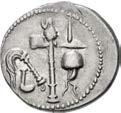
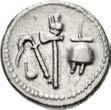

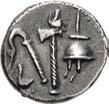

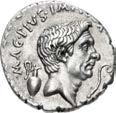
485. The Pompeians. Sextus Pompey. 37/6 BC. AR Denarius (19mm, 3.84 g, 3h). Uncertain Sicilian mint. Bare head of Pompey the Great right; capis to left, lituus to right / Neptune standing left, holding apluster and resting foot on prow between the Catanaean brothers Anapias and Amphinomus running in opposite directions, bearing their parents on their shoulders. Crawford 511/3a; CRI 334; Sydenham 1344; RSC 17 (Pompey the Great); RBW 1785. Small banker’s marks on obverse. VF. ($1000)
Military Pay for Julius Caesar’s Army
Julius Caesar and his armies assembled on the banks of the Rubicon River on 10 January 49 BC, ready to invade Italy. Since large quantities of denarii were necessary to pay Caesar’s military expenses, the mint traveled with them. This issue was ordered, not by a moneyer, as was usual, but by Julius Caesar himself. The obverse clearly depicts the triumph of good over evil, numismatic propaganda designed to encourage Caesar’s soldiers during the long, intense campaign. The reverse, depicting priestly emblems, tells of Caesar’s office as Pontifex Maximus, high priest. In all likelihood, this type was used by Caesar’s military forces at least until the decisive battle of Pharsalus.
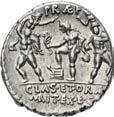
486. The Caesarians. Julius Caesar. April-August 49 BC. AR Denarius (16.5mm, 3.78 g, 3h). Military mint traveling with Caesar. Elephant advancing right, trampling on horned serpent / Emblems of the pontificate: simpulum, aspergillum, securis, and apex. Crawford 443/1; CRI 9; Sydenham 1006; RSC 49; RBW 1557. Attractive deep cabinet tone with some luster, some horn silver. Good VF. ($1500)
From the Collection of a London Novelist, purchased from Sovereign Rarities.
487. The Caesarians. Julius Caesar. April-August 49 BC. AR Denarius (16.5mm, 3.76 g, 12h). Military mint traveling with Caesar. Elephant advancing right, trampling on horned serpent / Emblems of the pontificate: simpulum, aspergillum, securis, and apex. Crawford 443/1; CRI 9; Sydenham 1006; RSC 49; RBW 1557. Minor roughness and delaminationv. Near EF. ($1000)
488. The Caesarians. Julius Caesar. April-August 49 BC. AR Denarius (18mm, 3.94 g, 3h). Military mint traveling with Caesar. Elephant advancing right, trampling on horned serpent / Emblems of the pontificate: simpulum, aspergillum, securis, and apex. Crawford 443/1; CRI 9; Sydenham 1006; RSC 49; RBW 1557. Minor marks on reverse. Good VF. ($1000)
489. The Caesarians. Julius Caesar. April-August 49 BC. AR Denarius (19mm, 3.85 g, 5h). Military mint traveling with Caesar. Elephant advancing right, trampling on horned serpent / Emblems of the pontificate: simpulum, aspergillum, securis, and apex. Crawford 443/1; CRI 9; Sydenham 1006; RSC 49; RBW 1557. Lightly toned, underlying luster, minor marks. Good VF. ($1000)
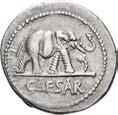
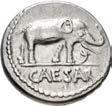



118
484 485 486 487 488 489
490. The Caesarians. Julius Caesar. April-August 49 BC. AR Denarius (18mm, 3.66 g, 6h). Military mint traveling with Caesar. Elephant advancing right, trampling on horned serpent / Emblems of the pontificate: simpulum, aspergillum, securis, and apex. Crawford 443/1; CRI 9; Sydenham 1006; RSC 49; RBW 1557. Flan flaw at edge, roughness, off center on reverse. Near EF. ($750)
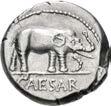

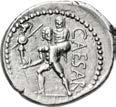
491. The Caesarians. Julius Caesar. Late spring-early summer 48 BC. AR Denarius (19mm, 3.99 g, 11h). Military mint traveling with Caesar. Diademed female head (Clementia?) right, wearing oak wreath; %ii (= 52, Caesar’s age) to left / Gallic trophy, holding oval shield and carnyx surmonted by wolf’s head; securis to right. Crawford 452/2; CRI 11; Sydenham 1009; RSC 18; DCA 937; RBW –. Toned, patches of iridescence, minor deposits. EF. ($750)
Ex J. Westervelt Collection (Knobloch FPL 25 [December 1964]), no. 246.
492. The Caesarians. Julius Caesar. Late spring-early summer 48 BC. AR Denarius (18mm, 4.01 g, 3h). Military mint traveling with Caesar. Diademed female head (Clementia?) right, wearing oak wreath; %ii (= 52, Caesar’s age) to left / Gallic trophy, holding oval shield and carnyx surmonted by wolf’s head; securis to right. Crawford 452/2; CRI 11; Sydenham 1009; RSC 18; DCA 937; RBW –. Light roughness, dig on obverse. Good VF. ($750)
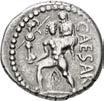

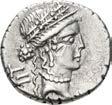
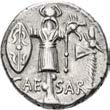
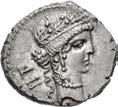

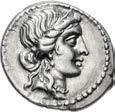

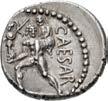
493. The Caesarians. Julius Caesar. Late 48-47 BC. AR Denarius (17mm, 3.85 g, 6h). Military mint traveling with Caesar in North Africa. Diademed head of Venus right / Aeneas advancing left, holding palladium and bearing Anchises on his shoulder. Crawford 458/1; CRI 55; Sydenham 1013; RSC 12; RBW 1600. Attractive old cabinet tone, off center on reverse. EF. ($750)
494. The Caesarians. Julius Caesar. Late 48-47 BC. AR Denarius (18.5mm, 3.88 g, 5h). Military mint traveling with Caesar in North Africa. Diademed head of Venus right / Aeneas advancing left, holding palladium and bearing Anchises on his shoulder. Crawford 458/1; CRI 55; Sydenham 1013; RSC 12; RBW 1600. Lustrous, scratch in field on obverse, graffiti on reverse. Good VF. ($750)
495. The Caesarians. Julius Caesar. Late 48-47 BC. AR Denarius (16.5mm, 3.82 g, 6h). Military mint traveling with Caesar in North Africa. Diademed head of Venus right / Aeneas advancing left, holding palladium and bearing Anchises on his shoulder. Crawford 458/1; CRI 55; Sydenham 1013; RSC 12; RBW 1600. Lightly toned, banker’s mark on reverse. Good VF. ($750)
119
493 494 490 491 492 495
496. The Caesarians. Julius Caesar. Late 47 BC. AR Denarius (19mm, 3.88 g, 6h). Mint in Sicily (Lilybaeum?); Aulus Allienus, proconsular governor of Sicily. Diademed and draped bust of Venus right / Trinacrus standing left, foot on prow, holding triskeles and cloak, resting elbow on knee. Crawford 457/1; CRI 54; Sydenham 1022; RSC 1; RBW 1599. Toned, minor flan crack, banker’s mark on obverse. Good VF. Well centered. ($1000)
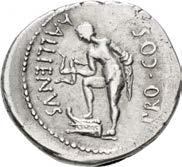
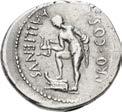
Before embarking for North Africa from the Sicilian port of Lilybaeum, Caesar spent some time on the island organizing the invasion force with which he was going to confront Scipio and the other Pompeians. During this period (late 47 BC), a small issue of denarii was produced in Caesar’s name by Aulus Allienus, who had been appointed proconsular governor of Sicily the preceding year. The issue – one of the rarest in the Caesarian series – was unusual in that it bore the name of one of the dictator’s lieutenants in addition to his own name, a feature more characteristic of the Pompeian coinage.
Caesar Rewards the Troops at Thapsus
497. The Caesarians. Julius Caesar. Early 46 BC. AV Aureus (20mm, 7.95 g, 9h). Rome mint; A. Hirtius, praetor. Veiled head of female (Vesta or Pietas?) right; C • CAeÍAr COÍ Ter around / Emblems of the augurate and pontificate: lituus, capis, and securis; A • hirTiuÍ • pr around from lower left. Crawford 466/1; Molinari 464-5 (D86/R303); CRI 56; Sydenham 1018; RBW 1634. Reddish tone, minor deposits and scratches, die rust. Near VF. ($5000)
From the D.K. Collection.
Aulus Hirtius, friend and confidant of Julius Caesar, was praetor in 46 BC, and thus charged with the distribution of the first truly large issue of Roman gold coins to date. The aurei were for distribution to the general’s successful troops after their final victory over the Pompeians in Africa at Thapsus. Each legionary received 5000 denarii (200 aurei), centurions twice that. Since Caesar had at least 40,000 legionnaires at Thapsus, the amount of coin needed was immense. But the amount of booty collected from Caesar’s many campaigns was also colossal, and Hirtius seems to have been able to supply the need. Hirtius later finished the dictator’s memoirs after his assassination and was himself killed at the Battle of Mutina in 43 BC.
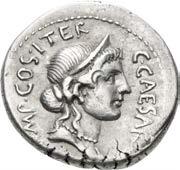


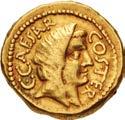
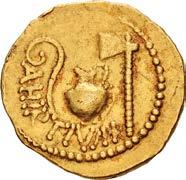
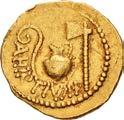
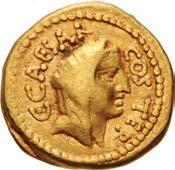
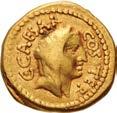
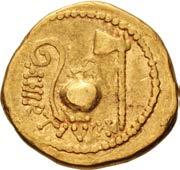
498. The Caesarians. Julius Caesar. Early 46 BC. AV Aureus (18.5mm, 8.02 g, 9h). Rome mint; A. Hirtius, praetor. Veiled head of female (Vesta or Pietas?) right; C • CAeÍAr COÍ Ter around / Emblems of the augurate and pontificate: lituus, capis, and securis; A • hirTiuÍ • pr around from lower left. Crawford 466/1; Molinari 413-6 (D70/R279); CRI 56; Sydenham 1018; RBW 1634. Minor deposits, underlying luster. Near VF. ($5000)
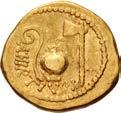
120
499. The Caesarians. Julius Caesar. January-April 46 BC. AR Denarius (20mm, 3.83 g, 8h). Uncertain mint, possibly Utica. Wreathed head of Ceres right / Emblems of the augurate and pontificate: simpulum, aspergillum, guttus, and lituus; D (donativum = largess) to right. Crawford 467/1a; CRI 57; Sydenham 1023; RSC 4a; RBW 1637. Toned with iridescence. EF. ($1500)

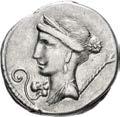
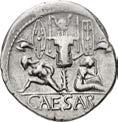

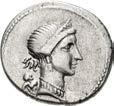
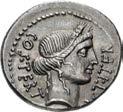

From the D.K. Collection.
500. The Caesarians. Julius Caesar. Late 46-early 45 BC. AR Denarius (18mm, 3.96 g, 3h). Military mint traveling with Caesar in Spain. Diademed head of Venus right, with Cupid over her shoulder / Trophy of Gallic arms, composed of helmet and cuirass, oval shield and carnyx in each hand; two seated captives at base, the one on left a female in attitude of dejection, the one on right a bearded male with hands bound behind him. Crawford 468/1; CRI 58; Sydenham 1014; RSC 13; RBW 1639. Minor marks. Good VF. ($500)
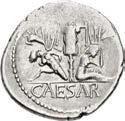
501. The Caesarians. Julius Caesar. Late 46-early 45 BC. AR Denarius (19mm, 3.80 g, 11h). Military mint traveling with Caesar in Spain. Draped bust of Venus left, wearing stephane; small Cupid at point of bust; lituus to left, scepter to right / Trophy of Gallic arms, holding a shield and carnyx in each hand; on left, kneeling bearded male captive seated left, looking right; on right, seated female captive right, resting head in hand. Crawford 468/2; CRI 59; Sydenham 1015; RSC 14; RBW 1640. Hints of luster, minor marks. Good VF. Well centered, and an attractive style. ($1000)
502. The Caesarians. Julius Caesar. Late 46-early 45 BC. AR Denarius (20mm, 3.66 g, 6h). Military mint traveling with Caesar in Spain. Draped bust of Venus left, wearing stephane; small Cupid at point of bust; lituus to left, scepter to right / Trophy of Gallic arms, holding a shield and carnyx in each hand; on left, kneeling bearded male captive seated left, looking right; on right, seated female captive right, resting head in hand. Crawford 468/2; CRI 59; Sydenham 1015; RSC 14; RBW 1640. Underlying luster, area of weak strike. Good VF. ($750)
503. The Caesarians. Julius Caesar. Late 46-early 45 BC. AV Aureus (20mm, 8.04 g, 11h). Rome mint; L. Munatius Plancus, praefectus Urbi. Draped and winged bust of Victory right, hair rolled back and collected into a knot behind; C • CAeÍ upward to left, DiC • Ter downward to right / Guttus (single-handled sacrificial jug); L • pLANC upward to left, prAeF • œB downward to right. Crawford 475/1a; CRI 60; Sydenham 1019; Bahrfeldt 20; Calicó 45; RBW 1663. Lightly toned with residual luster, off center and scrape on reverse. VF. ($5000)
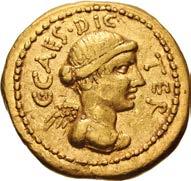
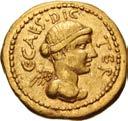

121
499 500 501 502
504. The Caesarians. Julius Caesar. Late 46-early 45 BC. AV Aureus (20mm, 8.09 g, 12h). Rome mint; L. Munatius Plancus, praefectus Urbi. Draped and winged bust of Victory right, hair rolled back and collected into a knot behind; C • CAeÍ upward to left, DiC • Ter downward to right / Guttus (single-handled sacrificial jug); L • pLANC upward to left, prAeF • œB downward to right. Crawford 475/1a; CRI 60; Sydenham 1019; Bahrfeldt 20; Calicó 45; RBW 1663. Light porosity, minor marks. VF. ($5000)
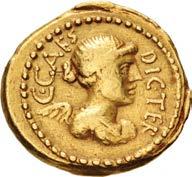
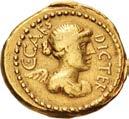
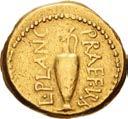

From the D.K. Collection.
505. The Caesarians. Julius Caesar. January 44 BC. AV Aureus (23mm, 8.07 g, 10h). Rome mint. Diademed head of Venus right; CAeÍ DiC upward to left, œuAr downward to right / COÍ • œuiNC within laurel wreath. Crawford 481/1; Alföldi Type II, AV 5 (same dies); CRI 117; Sydenham 1021; Calicó 42a (same obv. die as illustration); Biaggi 32 (same obv. die); RBW 1694-5 (same obv. die). In NGC encapsulation 6556998-001, graded Ch VF, Strike: 4/5, Surface: 2/5, flan flaw. Rare. ($4000)
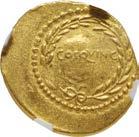
Commemorating Caesar’s fourth dictatorship and fifth consulship. Sear (CRI p. 80) suggests that this issue was “intended for distribution to notables at the time of the consular ceremonies.”
First Portrait Denarius of Julius Caesar

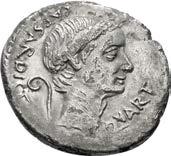

506. The Caesarians. Julius Caesar. January 44 BC. AR Denarius (18.5mm, 3.51 g, 12h). Lifetime issue. Rome mint; M. Mettius, moneyer. Laureate head right; lituus left behind neck, CAeÍAr • DiCT downwards to left, œuArT upwards to right / Juno Sospita, wearing goat skin headdress, brandishing spear in right hand and holding shield in left, in galloping biga right; Â ÂeTTiuÍ in exergue. Crawford 480/2a; Alföldi Type II, 10 (A3/R4); CRI 98; Sydenham 1057; RSC 36; RBW –. Toned, some roughness. VF. Very rare. ($5000)
This very rare coin comes from the first issue of denarii featuring the portrait of Julius Caesar. In issuing coins of this type, Caesar became the first living Roman to be depicted on a coin issued by the Roman mint, a step that effected great changes in Caesar’s life and in Roman numismatics.
The presence of Caesar’s portrait on this issue presents a revolution in Roman Republican Coinage. Until now, obverses had been the preserve of patron deities and of deceased Romans of import. Elsewhere in the ancient world obverse designs had featured the portraits of kings, many of whom inhabited a grey area between humanity and divinity. By placing his portrait on the obverse of coins minted in his name, Caesar was clearly adopting the role of king in all but name, with the helpful ambiguity between kingship and divine status as an extra layer of meaning. Such a step would have been unambiguous to contemporary Romans, who had maintained a proudly and virulently anti-monarchy stance since the expulsion of the Etruscan kings.
These coins clearly played an important part in the creation of Caesar’s post-Civil War persona, along with various other regal honors and public displays of his power, and therefore contributed to his assassination. The influence of this controversial issue of coins can be seen in all of the later Roman issues, both Imperatorial and Imperial, and, by extension, the coinage of the world.
122
507. The Caesarians. Julius Caesar. January-February 44 BC. AR Denarius (18.5mm, 4.13 g, 1h). Lifetime issue. Rome mint; P. Sepullius Macer, moneyer. Laureate head right; star of eight rays to left / Venus Victrix standing left, holding Victory on outstretched right hand and scepter in left. Crawford 480/5a; Alföldi Type V, 61 (A39/R2); CRI 106; Sydenham 1071a; RSC 41a; RBW 1679 var. (scepter without star). Lustrous, a little soft on the high points. Near EF. Great portrait. ($2000)
508. The Caesarians. Julius Caesar. February-March 44 BC. AR Denarius (17mm, 3.96 g, 3h). Lifetime issue. Rome mint; P. Sepullius Macer, moneyer. Laureate head right / Venus Victrix standing left, holding Victory and scepter resting on star. Crawford 480/11; Alföldi Type VI, 60 (A10/R3); CRI 107b(1); Sydenham 1072; RSC 40; RBW 1684. Deeply toned with iridescence, areas of weakness, numerous scratches. Good VF. ($1500)
509. The Caesarians. Julius Caesar. February-March 44 BC. AR Denarius (19.5mm, 3.59 g, 5h). Lifetime issue. Rome mint; P. Sepullius Macer, moneyer. Laureate and veiled head right / Venus Victrix standing left, holding Victory and scepter; shield set on ground to right. Crawford 480/13; Alföldi Type IX, 97 (A49/R13); CRI 107d; Sydenham 1074; RSC 39; RBW 1685. Light iridescence, a few minor scratches. Good VF. ($2000)
510. The Caesarians. Julius Caesar. February-March 44 BC. AR Denarius (20mm, 3.72 g, 2h). Lifetime issue. Rome mint; P. Sepullius Macer, moneyer. Laureate and veiled head right / Venus Victrix standing left, holding Victory and scepter resting on star. Crawford 480/14; Alföldi Type VII, 17 (A11/R10); CRI 107e; Sydenham 1074a; RSC 39/40; RBW –. Toned, light porosity, area of weak strike. EF. ($2000)

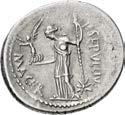

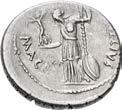



511. The Caesarians. Julius Caesar. February-March 44 BC. AR Denarius (18mm, 3.89 g, 3h). Lifetime issue. Rome mint; C. Cossutivs Maridianus, moneyer. Laureate and veiled head right / Venus Victrix standing left, holding Victory and resting arm on shield set on globe. Crawford 480/15; Alföldi Type XVIII, 17-19 (A2/R3 [unrecorded die pair]); CRI 111a; Sydenham 1068; RSC 10; RBW –. Light iridescence, areas of weak strike, minor porosity, slightly off center. Good VF. ($2000)
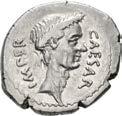
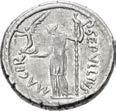
Caius Cossutius Maridianus was apparently the last man appointed to the recently expanded quatrovirate of moneyers in 44 BC. His portrait coinage for Julius Caesar commences later than that of his colleagues, starting after Caesar was named Dictator In Perpetuo (”Perpetual Dictator”) on February 15; uniquely, the obverse legend for this type reads DICT IN PERPETVO, including the IN. All of his Caesar heads are veiled, alluding to Caesar’s role as Pontifex Maximus.


512. The Caesarians. Julius Caesar. March-April 44 BC. AR Denarius (19mm, 3.89 g). Rome mint; M. Mettius, moneyer. Laureate head right / Venus Victrix standing left, holding Victory in extended right hand and transverse scepter in left, resting her left elbow on shield set on celestial globe to right; A to left. Crawford 480/17; Alföldi Type XVI, 2 (A1/R1); CRI 101; Sydenham 1055; RSC 35; RBW 1686. Lightly toned with underlying luster, trace deposits, small scratch on obverse. Near EF. ($3000)
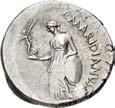
123
507 508 509 510 511 512
513. The Caesarians. Julius Caesar. 42 BC. AR Denarius (18mm, 3.95 g, 12h). Rome mint; L. Mussidius Longus, moneyer. Laureate head right / Rudder, cornucopia on globe, winged caduceus, and apex. Crawford 494/39a; CRI 116; Sydenham 1096a; RSC 29; RBW 1742. In NGC encapsulation 6556997-001, graded Ch VF, Strike: 3/5, Surface: 4/5. ($1500)
Ex Z.P. Collection (Roma XXIII, 24 March 2022), lot 770.
514. The Caesarians. Divus Julius Caesar. 40 BC. AR Denarius (20mm, 3.60 g, 7h). Rome mint; Q. Voconius Vitulus, moneyer. Laureate head right / Bull-calf walking left. Crawford 526/4; CRI 331; Sydenham 1133; RSC 45; RBW 1813. Toned, some hairlines and minor marks, a trace of horn silver on reverse. VF. A vivid portrait. ($3000)
From the Collection of a London Novelist, purchased from Sovereign Rarities. Ex Numismatica Ars Classica 51 (5 March 2009), lot 791; Lanz 82 (24 November 1997), lot 247.
515. The Republicans. C. Cassius Longinus. Spring 42 BC. AR Denarius (18mm, 3.53 g, 6h). Military mint, probably at Smyrna; P. Cornelius Lentulus Spinther, legatus. Tripod surmounted by cortina and two laurel branches, fillet hanging on either side / Capis and lituus. Crawford 500/1; CRI 219; Sydenham 1308; RSC 7; RBW 1761. In NGC encapsulation 6290568005, graded MS, Strike: 5/5, Surface: 4/5. ($2000)
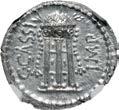


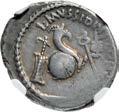
The obverse of this denarius closely copies the reverse of the aureus struck by M. Aquinius, and was probably minted on the occasion of the meeting in Smyrna between Cassius and Brutus. The capis and lituus, symbols of the pontificate, recall Spinther’s election to that college in 57 BC.

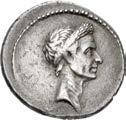
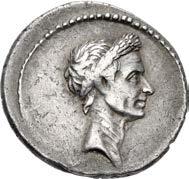

124
Very Rare Cassius Aureus
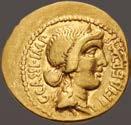

Shakespeare depicts the “lean and hungry” Cassius as primary ringleader in the conspiracy against Julius Caesar, motivated more by envy than love of liberty. The Bard gets the basic facts right, but omits the details of Cassius’ colorful career. Born into a senatorial family but lacking any talent for politics, Gaius Cassius Longinus found soldiering more to his liking and joined the triumvir Crassus on his doomed expedition against the Parthians in 53 BC. Cassius managed to rescue himself and a handful of others from the massacre and escaped to Roman Syria, where he remained for another two years ably defending the province from Parthian attack. He returned to Rome as a war hero in 51 BC and fell in with the Pompeian faction, serving as commander of Pompey’s fleet during the civil war of 49-48 BC. After Pompey’s defeat and death, Cassius accepted a pardon from Caesar and loyally served him for the next four years. Cassius perhaps hoped to attain supreme power once Caesar retired, but it soon became apparent the dictator had no intention of stepping down. Thus, Cassius suborned his close friend Marcus Junius Brutus and several other senators into a conspiracy, and he was one of the first to plunge his dagger into Caesar on the Ides of March, 44 BC. After fleeing Rome with the other conspirators, Cassius returned to Syria and commandeered several crack legions and a fleet, which he used to attack and pillage the wealthy island of Rhodes in order to procure gold for the approaching civil war. He joined forces with Brutus in 42 BC and the two marched into Thrace to meet the pro-Caesarian legions led by Mark Antony and Octavian. Though their army outnumbered the Caesarians, Cassius and Brutus seemed oddly fatalistic and made a suicide pact should either meet defeat or capture. At the first clash at Philippi in early October, Cassius suffered a reverse and rashly fell on his sword before he could be told that Brutus had counterattacked and saved the day. Demoralized by his friend’s death, Brutus was easily defeated three weeks later and took his own life.
This aureus was issued by P. Cornelius Lentulus Spinther and M. Servilius, who were joint legates to Cassius and Brutus and issued coins in the names of their generals. Lentulus Spinther was born in 74 BC and assumed the toga virilis in 57 BC, and in the same year was elected to the college of augurs. After the murder of Caesar, he joined the parties of Cassius and Brutus and was probably killed at Philippi. The reverse type of this coin refers to Lentulus’ appointment to the college of augurs, and is one of the few instances in imperatorial coinage in which a moneyer used a reverse type that was personal to himself.




125
516. The Republicans. C. Cassius Longinus. Spring 42 BC. AV Aureus (21mm, 7.70 g, 6h). Military mint, probably at Smyrna; P. Cornelius Lentulus Spinther, legatus. Diademed head of Libertas right; C • CAÍÍi • iÂp upward to left, LeiBerTAÍ upward to right / Capis and lituus; LeNTuLuÍ/ÍpiNT in two lines below. Crawford 500/2; CRI 220; Sydenham 1306; Bahrfeldt 58; Calicó 65; Biaggi 45; RBW –. Lustrous. VF. Struck on a broad flan. Very rare. ($15,000)
517. The Republicans. C. Cassius Longinus. Spring 42 BC. AR Denarius (20mm, 3.39 g, 6h). Military mint, probably at Smyrna; P. Cornelius Lentulus Spinther, legatus. Diademed head of Libertas right / Capis and lituus. Crawford 500/3; CRI 221; Sydenham 1307; RSC 4a; RBW 1762. Some luster, soft strike on high points, die flaw on reverse. Good VF ($750)
Brutus and Liberty
518. The Republicans. Brutus. Spring-early summer 42 BC. AR Denarius (19mm, 3.60 g, 5h). Military mint traveling with Brutus in Lycia. Head of Libertas right / Lyre; quiver to left, laurel branch tied with fillet to right. Crawford 501/1; CRI 199; Sydenham 1287; RSC 5; RBW 1767. Residual luster, off center. Near EF. ($750)

Marcus Junius Brutus was a blue-blooded Roman whose fortune derived from lending money at exorbitant interest rates when, in 44 BC, he was suborned into the conspiracy against his former benefactor, Julius Caesar. As his distant ancestor had entered history as a great tyrannicide, Brutus soon became the de facto leader and spokesman for the assassins. After the Ides of March, Brutus induced a cowed senate to give him a governorship in northern Greece and promptly departed to raise money and arms for the brewing civil war against Caesar’s adherents. He cut a brutal swath through Greece, Thrace and Asia Minor, looting city treasuries and enforcing horrendous taxes at the point of a sword. He turned his ill-gotten gains into silver denarii to pay his growing army and navy, including this type depicting the head of Libertas, exemplar of senatorial liberty. However, Brutus and his companions were soon maneuvered into battle against the Caesarians at Philippi in Greece, where Mark Antony proved to be much the better general. Brutus took his own life with the very dagger he had plunged into Caesar, earning this unattractive character the reputation as a martyr for the cause of liberty.
519. The Republicans. Brutus. Spring-early summer 42 BC. AR Denarius (19mm, 3.73 g, 12h). Military mint traveling with Brutus in southwestern Asia Minor; L Sestius, proquaestor. Veiled and draped bust of Libertas right / Tripod; securis to left, simpulum to right. Crawford 502/2; CRI 201; Sydenham 1290; RSC 11; RBW 1768. Lightly toned, residual luster, slightly off center on obverse. Near EF. ($1500)

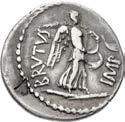
520. The Republicans. Brutus. Late summer-autumn 42 BC. AR Denarius (20mm, 3.73 g, 12h). Military mint traveling with Brutus and Cassius in western Asia Minor or northern Greece; P. Servilius Casca Longus, moneyer. Laureate and bearded head of Neptune right; trident below / Victory advancing right on broken scepter, holding palm frond over left shoulder and broken diadem bound with fillet. Crawford 507/2; CRI 212; Sydenham 1298; RSC 3; RBW 1780. Toned, slightly off center, edge nicks, banker’s mark on reverse. VF. ($750)
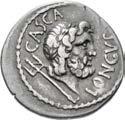
Ex Marti Hervera 66 (3 May 2011), lot 149.
521. The Republicans. Brutus. Late summer-autumn 42 BC. AR Denarius (19mm, 3.62 g, 12h). Military mint traveling with Brutus and Cassius in western Asia Minor or northern Greece; L. Plaetorius Cestianus, moneyer. Laureate, veiled, and draped female bust right, wearing polos / Sacrificial axe and simpulum. Crawford 508/2; CRI 214; Sydenham 1300; RSC 2; RBW 1781. Iridescent toning, a little off center on obverse, slightly weak strike on reverse. VF. Rare. ($1000)



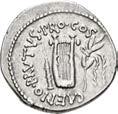

Ex Roma XVIII (29 September 2019), lot 988; Nomisma Spa 59 (14 May 2019), lot 128.
The final issue struck in the name of Brutus prior to the battle of Philippi.
126
520 521
Fourrée EID MAR Denarius
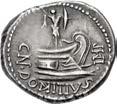
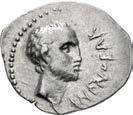
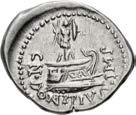
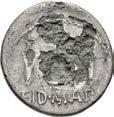

522. The Republicans. Brutus. Late summer-autumn 42 BC. Fourrée Denarius (19mm, 2.49 g, 9h). Mint moving with Brutus in northern Greece; L. Plaetorius Cestianus, magistrate. Bare head of Brutus right / Pileus between two daggers pointing downward; ei‰ • ÂAr below. Cf. Crawford 508/3; Campana, Eid Mar, P1-8 (dies OP1/RP1); cf. CRI 216; cf. Sydenham 1301; cf. RSC 15; RBW –. Toned, large area of broken plating on reverse, some scratches and scrapes. Fine. Very rare, thirteen fourrées listed in Campana, two additional specimens in CoinArchives, including this coin. ($2000)
Ex Bellwether Collection (Classical Numismatic Group 115, 16 September 2020), lot 604 (where it hammered for $5,000); Classical Numismatic Group Inventory 91549 (20 May 1996); Dix and Webb 21 (27 March 1996), lot 43.
One of the most important coins associated with an event in ancient history, this denarius pointedly commemorates the assassination of Julius Caesar by depicting the perpetrator of the act (Brutus), by naming the date of the act (EID[ibus] MAR[tiis], by displaying the instruments of the act (daggers) between the reason for the act (the pileus [freedman’s cap] as a symbol of liberty). Though many senators plotted against Caesar and are collectively represented by the two daggers, the portrait of Brutus alone emphasizes his primary role in the conspiracy
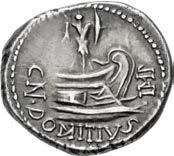
The only securely identified portraits of Brutus occur on coins inscribed with his name; all others, whether on coins or other artifacts, are identified based on the three issues inscribed BRVTVS IMP (on aurei) or BRVT IMP (on denarii). A careful study of Brutus’ portraits by S. Nodelman segregates these inscribed portraits into three main categories: a ‘baroque’ style portrait on the aurei of Casca, a ‘neoclassical’ style on the aurei of Costa, and a ‘realistic’ style on the ‘EID MAR’ denarii, which Nodelman describes as “the soberest and most precise” of all.

Two Denarii of Domitius Ahenobarbus

523. The Republicans. Cn. Domitius L.f. Ahenobarbus. 41-40 BC. AR Denarius (18.5mm, 3.89 g, 9h). Uncertain mint in the region of the Adriatic or Ionian Sea. Bare head of Ahenobarbus right, wearing short beard / Prow right surmounted by a military trophy. Crawford 519/2; CRI 339; Sydenham 1177; Domitia 21; RBW 1803. Attractive old cabinet tone, some light scratches mostly under tone. Near EF. ($2000)
From the Collection of a London Novelist. Ex Gorny & Mosch 261 (4 March 2019), lot 611.
Gnaeus Domitius Ahenobarbus commanded a fleet against the Triumvirs, achieving a minor victory in September of 42 BC. But that very day, the Triumvirs won the battle of Philippi, and Ahenobarbus found himself fighting for a lost cause. He became a piratical rogue, terrorizing the ports of the Adriatic like his western counterpart, Sextus Pompey, until he signed the Pact of Brundisium in 40 BC, which reconciled him to Mark Antony. His great-grandson would become the Emperor Nero (AD 54-68). The rare coinage of Ahenobarbus belongs to his stint as a “pirate king” 42-40 BC. This silver denarius bears an appropriately nautical reverse celebrating his victories at sea. The balding, bearded portrait on the obverse remains enigmatic; it may represent Gnaeus himself, or one of his ancestors.
524.
127
The Republicans. Cn. Domitius L.f. Ahenobarbus. 41-40 BC. AR Denarius (21mm, 3.62 g, 11h). Uncertain mint in the region of the Adriatic or Ionian Sea. Bare head of Ahenobarbus right, wearing short beard / Prow right surmounted by a military trophy. Crawford 519/2; CRI 339; Sydenham 1177; Domitia 21; RBW 1803. Residual luster, small test cut, obverse struck from a worn die, small die flaw on reverse. Good VF. ($1000)
An Extensive Offering of the Coinage of Mark Antony

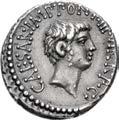
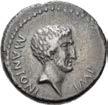
525. The Triumvirs. Mark Antony. 42 BC. AR Denarius (17mm, 3.65 g, 1h). Military mint traveling with Antony in Greece. Bare head right, wearing beard / Facing head of Sol on disk within distyle temple. Crawford 496/1; CRI 128; Sydenham 1168; RSC 12a; RBW –. Deep iridescent toning, minor marks. VF. ($500)

Ex Earle K. Stanton Collection (Knobloch FPL 26 [February 1965]), no. 463.
This coin type was likely struck soon after the battle of Philippi in the late summer or early autumn of 42 BC. Antony is still shown wearing the mourning beard he had grown after Julius Caesar’s death; the title of IMP, however, places it after the battle. The reference to the sun god within a temple on the reverse, probably an allusion to the East, continues the solar references he had taken up upon is arrival in Greece for the campaign against the assassins.


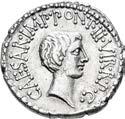
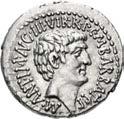
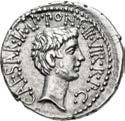
Ex Apostolo Zeno Collection
526. The Triumvirs. Mark Antony. Late summer-autumn 42 BC. AR Denarius (18.5mm, 3.85 g, 5h). Military mint traveling with Antony in Italy. Bare head right, wearing beard; lituus to left / Radiate head of Sol right. Crawford 496/2; CRI 127; Sydenham 1170; RSC 68; RBW 1754. Deeply toned with light iridescence. VF. ($500)
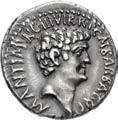
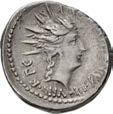
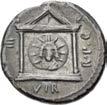
Ex Earle K. Stanton Collection (Knobloch FPL 26 [February 1965]), no. 464 Apostolo Zeno Collection (Part II, Dorotheum, 8 June 1956), lot 2866.
527. The Triumvirs. Mark Antony and Octavian. Spring-early summer 41 BC. AR Denarius (18.5mm, 4.14 g, 12h). Ephesus mint; M. Barbatius Pollio, quaestor pro praetore. Bare head of Mark Antony right / Bare head of Octavian right, with slight beard. Crawford 517/2; CRI 243 var. (Octavian beardless); Sydenham 1181; RSC 8a; RBW 1798. Attractive deep cabinet toning with iridescent highlights, a few light marks under tone. Near EF. ($2000)
From the Collection of a London Novelist, purchased from Sovereign Rarities. Ex Yves Gunzenreiner Collection (Leu Numismatik 1, 25 October 2017), lot 158.
528. The Triumvirs. Mark Antony and Octavian. Spring-early summer 41 BC. AR Denarius (20mm, 3.93 g, 12h). Ephesus mint; M. Barbatius Pollio, quaestor pro praetore. Bare head of Mark Antony right / Bare head of Octavian right, with slight beard. Crawford 517/2; CRI 243 var. (Octavian beardless); Sydenham 1181; RSC 8a; RBW 1798. Lightly toned, slight iridescence, minor marks. EF. Excellent portraits. ($1500)
529. The Triumvirs. Mark Antony and Octavian. Spring-early summer 41 BC. AR Denarius (20mm, 3.78 g, 12h). Ephesus mint; M. Barbatius Pollio, quaestor pro praetore. Bare head of Mark Antony right / Bare head of Octavian right. Crawford 517/2 var. (Octavian with beard); CRI 243; Sydenham 1181 var. (same); RSC 8; RBW 1798 var. (Octavian with slight beard). Lightly toned, some luster. Near EF. Excellent portraits on a broad flan. ($1500)
530. The Triumvirs. Mark Antony and Octavian. Autumn 41 BC. AR Denarius (18.5mm, 3.72 g, 1h). Military mint traveling with Antony in Syria(?). Bare head of Mark Antony right / Bare head of Octavian right. Crawford 528/3; CRI 251; Sydenham 1194; RSC 2; RBW –. Toned, minor porosity and deposits, small die flaw on obverse. VF. ($500)
128
525 526 527 528 529 530
•
C
Extremely Rare Aureus of Antony & Octavia



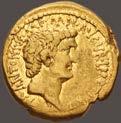
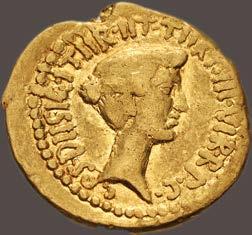
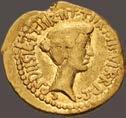
533/3b;
Shortly after the Battle of Philippi in 42 BC, cracks began to appear in the Second Triumvirate. Antony’s affair with Cleopatra, queen of Egypt, and his designs on Rome’s eastern holdings, prompted Octavian to formulate a binding agreement that would buy him time to strengthen his own position. At Brundisium a pact was signed, bringing about a reconciliation and some semblance of peace. As a condition of this reconciliation, Antony was married to Octavian’s widowed sister, Octavia. She stayed with him in Athens while he continued to prepare for a war against Parthia, and where, in 39 BC, he was associated with the “New Dionysus.” In 37 BC, she helped negotiate the Pact of Tarentum, which renewed the triumvirate until 33 BC. Antony, by this time, however, had renewed his affair with Cleopatra. He remained in the East, where he married the queen, and subsequently fathered several children. In 32 BC, as a renewal of civil war became imminent, Antony divorced Octavia. In the aftermath of Antony’s death, Octavia, known for her loyalty and nobilty, brought Antony’s surviving children to Rome to live with her.

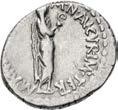

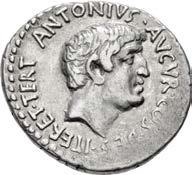
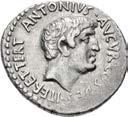
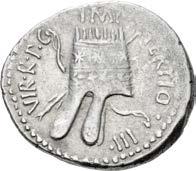
129
531. The Triumvirs. Mark Antony and Octavia. Summer-autumn 39 BC. AV Aureus (19.5mm, 7.80 g, 9h). Athens mint. Bare head of Mark Antony right; Â • ANTONiuÍ • Â • F • Â • N • Augur • iÂp • TiirT around / Head of Octavia right, her hair tied in a knot behind with one long plait arranged as a loop on top of her head; COÍ • DiiÍiG • iTiir • iiT • TiirT • iii • uir
r • p •
around. Crawford
CRI 269; Bahrfeldt 91; Calicó 116; Sydenham 1201; BMCRR East 145; RBW –. Residual luster, minor marks. Near VF. Extremely rare. ($40,000)
532. The Triumvirs. Mark Antony. Summer 38 BC. AR Denarius (19mm, 3.88 g, 8h). Athens mint. Mark Antony, veiled, and wearing the priestly robes of an augur, standing right, holding lituus / Radiate head of Sol right. Crawford 533/2; CRI 267; Sydenham 1199; RSC 13a; RBW 1820. Hairline scratches, small die flaw on obverse, area of weakness on reverse. VF. ($500)
533. The Triumvirs. Mark Antony. Summer 38 BC. AR Denarius (19mm, 3.67 g, 6h). Athens mint. Mark Antony, veiled, and wearing the priestly robes of an augur, standing right, holding lituus / Radiate head of Sol right. Crawford 533/2; CRI 267; Sydenham 1199; RSC 13a; RBW 1820. Light scratches, minor deposits, weakness at the periphery. VF. ($400)
534. The Triumvirs. Mark Antony. Autumn 37 BC. AR Denarius (21mm, 3.91 g, 6h). Antioch or military mint traveling with Canidius Crassus in Armenia. Bare head right / Seven-pointed Armenian tiara right, decorated with three stars; crossed bow and arrow to left. Crawford 539/1; CRI 297; Sydenham 1205; RSC 19; RBW 1828. Iridescent tone, minor porosity, area of weak strike at the periphery. Good VF. ($3000)
532
533
535. The Triumvirs. Mark Antony. Autumn 37 BC. AR Denarius (20mm, 3.98 g, 5h). Antioch or military mint traveling with Canidius Crassus in Armenia. Bare head right / Seven-pointed Armenian tiara right, decorated with three stars; crossed bow and arrow to left. Crawford 539/1; CRI 297; Sydenham 1205; RSC 19; RBW 1828. Lightly toned, surface cracks, traces of undertype. VF. ($1000)




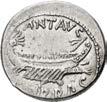
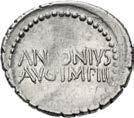

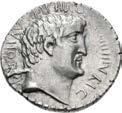

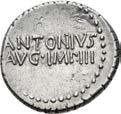

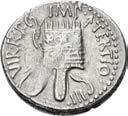
536. The Triumvirs. Mark Antony. Summer 32 BC. AR Denarius (19mm, 3.79 g, 12h). Athens mint. Bare head right; small p (signature) in hair below ear / ANTONiuÍ/Aug • iÂp • iii in two lines. Crawford 542/2; CRI 347; Sydenham 1209; RSC 2; RBW 1831. Lustrous, minor nicks on reverse. EF. ($2000)
537. The Triumvirs. Mark Antony. Summer 32 BC. AR Denarius (19mm, 3.86 g, 1h). Athens mint. Bare head right; small p (signature) in hair below ear / ANTONiuÍ/Aug • iÂp • iii in two lines. Crawford 542/2; CRI 347; Sydenham 1209; RSC 2; RBW 1831. Residual luster, small die break on obverse, weakness at the periphery. Near EF. ($1500)
538. The Triumvirs. Mark Antony. Summer 32 BC. AR Denarius (21mm, 3.84 g, 12h). Athens mint. Bare head right; small p (signature) in hair below ear / ANTONiuÍ/Aug • iÂp • iii in two lines. Crawford 542/2; CRI 347; Sydenham 1209; RSC 2; RBW 1831. Light iridescence, trace luster, softly struck at center of reverse. VF. ($1000)
The Legionary Denarii of Mark Antony
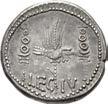


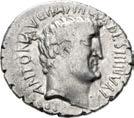
539. The Triumvirs. Mark Antony. Autumn 32-spring 31 BC. AR Denarius (17mm, 3.96 g, 6h). Legionary type. Patrae(?) mint. Praetorian galley right / Aquila between two signa; Leg ii across lower field. Crawford 544/14; CRI 349; Sydenham 1216; RSC 27; RBW 1838. Minor hairlines, residual luster. Near EF. Sharp reverse. ($1000)
540. The Triumvirs. Mark Antony. Autumn 32-spring 31 BC. AR Denarius (15.5mm, 3.89 g, 6h). Legionary type. Patrae(?) mint. Praetorian galley right / Aquila between two signa; Leg iii across lower field. Crawford 544/15; CRI 350; Sydenham 1217; RSC 28; RBW 1839. Minor marks, underlying luster. Near EF. ($1000)
541. The Triumvirs. Mark Antony. Autumn 32-spring 31 BC. AR Denarius (16.5mm, 3.81 g, 6h). Legionary type. Patrae(?) mint. Praetorian galley right / Aquila between two signa; Leg iu across lower field. Crawford 544/17; CRI 352; Sydenham 1219; RSC 30; RBW –. Lustrous, die scrapes on reverse. EF. ($1000)
542. The Triumvirs. Mark Antony. Autumn 32-spring 31 BC. AR Denarius (17mm, 3.52 g, 12h). Legionary type. Patrae(?) mint. Praetorian galley right / Aquila between two signa; Leg iu across lower field. Crawford 544/17; CRI 352; Sydenham 1219; RSC 30; RBW –. Toned. Good VF. ($750)
Ex Centurion Collection (Classical Numismatic Group 118, 13 November 2021), lot 948; Gorny & Mosch 253 (5 March 2018), lot 450.
130
535 536 537 538 539 540 541 542
543. The Triumvirs. Mark Antony. Autumn 32-spring 31 BC. AR Denarius (17mm, 3.95 g, 7h). Legionary type. Patrae(?) mint. Praetorian galley right / Aquila between two signa; Leg u across lower field. Crawford 544/18; CRI 354; Sydenham 1221; RSC 32; RBW 1840. Lightly toned, underlying luster, minor marks. Near EF. ($1000)
544. The Triumvirs. Mark Antony. Autumn 32-spring 31 BC. AR Denarius (17mm, 3.82 g, 6h). Legionary type. Patrae(?) mint. Praetorian galley right / Aquila between two signa; Leg ui across lower field. Crawford 544/19; CRI 356; Sydenham 1223; RSC 33; RBW 1841. Minor marks. Good VF. ($750)
545. The Triumvirs. Mark Antony. Autumn 32-spring 31 BC. AR Denarius (17mm, 3.86 g, 6h). Legionary type. Patrae(?) mint. Praetorian galley right / Aquila between two signa; Leg uii across lower field. Crawford 544/20; CRI 357; Sydenham 1224; RSC 34; RBW 1842. A couple of light scratches and marks. Near EF. ($1000)
546. The Triumvirs. Mark Antony. Autumn 32-spring 31 BC. AR Denarius (16.5mm, 4.02 g, 6h). Legionary type. Patrae(?) mint. Praetorian galley right / Aquila between two signa; Leg uiii across lower field. Crawford 544/21; CRI 358; Sydenham 1225; RSC 35; RBW –. Light iridescent tone, minor scratches, delaminations on reverse. Good VF. ($500)
547. The Triumvirs. Mark Antony. Autumn 32-spring 31 BC. AR Denarius (16.5mm, 3.84 g, 6h). Legionary type. Patrae(?) mint. Praetorian galley right / Aquila between two signa; Leg ix across lower field. Crawford 544/23; CRI 359; Sydenham 1227; RSC 37; RBW –. Lightly toned with slight iridescence, trace deposits. Good VF. ($750)

548. The Triumvirs. Mark Antony. Autumn 32-spring 31 BC. AR Denarius (19mm, 4.04 g, 10h). Legionary type. Patrae(?) mint. Praetorian galley right / Aquila between two signa; Leg uiiii across field. Crawford 544/22; CRI 360; Sydenham 1226; RSC 36; RBW –. A couple of light scratches and marks, off center on obverse. Good VF. ($750)

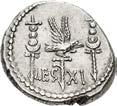


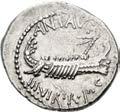
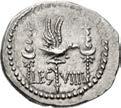
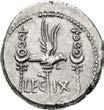
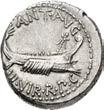



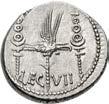
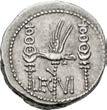


549. The Triumvirs. Mark Antony. Autumn 32-spring 31 BC. AR Denarius (17mm, 3.86 g, 7h). Legionary type. Patrae(?) mint. Praetorian galley right / Aquila between two signa; Leg x across lower field. Crawford 544/24; CRI 361; Sydenham 1228; RSC 38; RBW –. Lustrous, small die flaw on obverse, small edge cut. Near EF. ($750)
550. The Triumvirs. Mark Antony. Autumn 32-spring 31 BC. AR Denarius (18mm, 3.89 g, 1h). Legionary type. Patrae(?) mint. Praetorian galley right / Aquila between two signa; Leg xi across lower field. Crawford 544/25; CRI 362; Sydenham 1229; RSC 39; RBW –. A couple of light marks, scrape on reverse. Good VF. ($750)
131
543 544 545 546 547 548 549 550
551. The Triumvirs. Mark Antony. Autumn 32-spring 31 BC. AR Denarius (17mm, 3.87 g, 1h). Legionary type. Patrae(?) mint. Praetorian galley right / Aquila between two signa; Leg • xii • ANTiœuAe above. Crawford 544/9; CRI 363; Sydenham 1231; RSC 40; RBW 1834. Some luster, slightly off center. EF. ($1500)
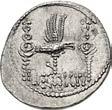
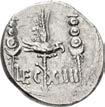


552. The Triumvirs. Mark Antony. Autumn 32-spring 31 BC. AR Denarius (19.5mm, 3.93 g, 11h). Legionary type. Patrae(?) mint. Praetorian galley right / Aquila between two signa; Leg xii across lower field. Crawford 544/26; CRI 365; Sydenham 1230; RSC 41; RBW –. Underlying luster, minor marks and scratches. Good VF. ($750)
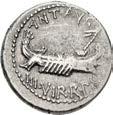


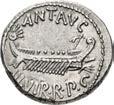
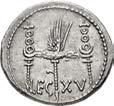

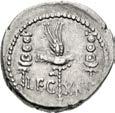
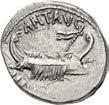
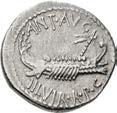
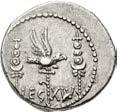
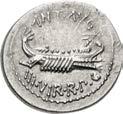

553. The Triumvirs. Mark Antony. Autumn 32-spring 31 BC. AR Denarius (18.5mm, 3.83 g, 6h). Legionary type. Patrae(?) mint. Praetorian galley right / Aquila between two signa; Leg xiu across lower field. Crawford 544/29; CRI 369; Sydenham 1234; RSC 44; RBW –. Minor scratches, slight double strike and off center on reverse. Good VF. ($750)
554. The Triumvirs. Mark Antony. Autumn 32-spring 31 BC. AR Denarius (17mm, 3.75 g, 1h). Legionary type. Patrae(?) mint. Praetorian galley right / Aquila between two signa; Leg xiiii across lower field. Crawford 544/28; CRI 370; Sydenham 1233; RSC 43; RBW –. Underlying luster, porosity, areas of flat strike. Good VF. ($750)
555. The Triumvirs. Mark Antony. Autumn 32-spring 31 BC. AR Denarius (18mm, 3.77 g, 4h). Legionary type. Patrae(?) mint. Praetorian galley right / Aquila between two signa; Leg xiiii across lower field. Crawford 544/28; CRI 370; Sydenham 1233; RSC 43; RBW –. Trace deposits, off center, minor die flaws on reverse. VF. ($500)
556. The Triumvirs. Mark Antony. Autumn 32-spring 31 BC. AR Denarius (18mm, 3.81 g, 6h). Legionary type. Patrae(?) mint. Praetorian galley right / Aquila between two signa; Leg xu across lower field. Crawford 544/30; CRI 371; Sydenham 1235; RSC 47; RBW 1845. Lustrous, light scratch in reverse field. EF. ($1000)
557. The Triumvirs. Mark Antony. Autumn 32-spring 31 BC. AR Denarius (18mm, 3.88 g, 6h). Legionary type. Patrae(?) mint. Praetorian galley right / Aquila between two signa; Leg xu across lower field. Crawford 544/30; CRI 371; Sydenham 1235; RSC 47; RBW 1845. Lustrous, trace deposits, light scratches, double struck on reverse. Good VF. ($750)
558. The Triumvirs. Mark Antony. Autumn 32-spring 31 BC. AR Denarius (18mm, 3.92 g, 3h). Legionary type. Patrae(?) mint. Praetorian galley right / Aquila between two signa; Leg xu across lower field. Crawford 544/30; CRI 371; Sydenham 1235; RSC 47; RBW 1845. Toned, area of weak strike, minor marks and scratches. Good VF. ($750)
132
551 552 553 554 555 556 557 558
559. The Triumvirs. Mark Antony. Autumn 32-spring 31 BC. AR Denarius (18mm, 3.69 g, 9h). Legionary type. Patrae(?) mint. Praetorian galley right / Aquila between two signa; Leg xui across lower field. Crawford 544/31; CRI 372; Sydenham 1236; RSC 48; RBW –. Minor marks and hairlines. Good VF. ($750)
560. The Triumvirs. Mark Antony. Autumn 32-spring 31 BC. AR Denarius (17mm, 3.87 g, 6h). Legionary type. Patrae(?) mint. Praetorian galley right / Aquila between two signa; Leg xuii • CLAÍÍiCAe above. Crawford 544/10; CRI 373; Sydenham 1238; RSC 50; RBW 1835. Lustrous, trace deposits. Near EF. ($1000)
561. The Triumvirs. Mark Antony. Autumn 32-spring 31 BC. AR Denarius (19mm, 3.96 g, 4h). Legionary type. Patrae(?) mint. Praetorian galley right / Aquila between two signa; Leg xuii across lower field. Crawford 544/32; CRI 374; Sydenham 1237; RSC 49; RBW 1846. Toned, light marks, off center on reverse. Good VF. ($750)
562. The Triumvirs. Mark Antony. Autumn 32-spring 31 BC. AR Denarius (17.5mm, 3.79 g, 6h). Legionary type. Patrae(?) mint. Praetorian galley right / Aquila between two signa; Leg xuiii across lower field. Crawford 544/33; CRI 376; Sydenham 1239; RSC 51; RBW –. Lightly toned, off center, die flaw on obverse. Near EF. ($1000)
563. The Triumvirs. Mark Antony. Autumn 32-spring 31 BC. AR Denarius (18mm, 3.97 g, 6h). Legionary type. Patrae(?) mint. Praetorian galley right / Aquila between two signa; Leg xuiii across lower field. Crawford 544/33; CRI 376; Sydenham 1239; RSC 51; RBW –. Lightly toned, light scratches and deposits, scrape on reverse. Near EF. ($1000)
564. The Triumvirs. Mark Antony. Autumn 32-spring 31 BC. AR Denarius (19.5mm, 3.71 g, 6h). Legionary type. Patrae(?) mint. Praetorian galley right / Aquila between two signa; Leg xix across lower field. Crawford 544/35; CRI 378; Sydenham 1242; RSC 55; RBW 1847. Iridescent tone, minor flan cracks. EF. ($1000)
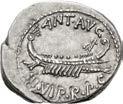


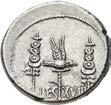
LEG XVIIII – Rarest of Antony’s Legionary Denarii

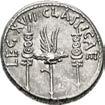
565. The Triumvirs. Mark Antony. Autumn 32-spring 31 BC. AR Denarius (17mm, 3.91 g, 6h). Legionary issue. Patrae(?) mint. Praetorian galley right; ANT • Aug above, iii • uir • r • p • C below / Aquila between two signa; Leg xuiiii across lower field. Crawford 544/34; CRI 379; Sydenham 1241; RSC 54; RBW –. Minor scratches, small die flaw on obverse, off center on reverse. Near EF. An extremely rare type with XVIIII, as opposed to the more frequently encountered LEG XIX. ($5000)
Not to be confused with a similar legion under the command of Octavian, this Antonian legion was either disbanded or incorporated into another legion after Actium. Antonian legionary denarii were hammered out in such great numbers that uniformity in die engraving suffered; hence some engravers chose different ways of depicting the same Roman numeral – XIX and XVIIII are both seen, although the longer form is considerably rarer.




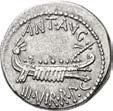

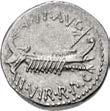


133
559 560 561 562 563 564
566. The Triumvirs. Mark Antony. Autumn 32-spring 31 BC. AR Denarius (19mm, 3.75 g, 6h). Legionary type. Patrae(?) mint. Praetorian galley right / Aquila between two signa; Leg xx across field. Crawford 544/36; CRI 380; Sydenham 1243; RSC 57; RBW 1848. Toned with light iridescence, minor deposits. Near EF. ($1000)
567. The Triumvirs. Mark Antony. Autumn 32-spring 31 BC. AR Denarius (18mm, 3.71 g, 7h). Legionary type. Patrae(?) mint. Praetorian galley right / Aquila between two signa; Leg xxi across field. Crawford 544/37; CRI 381; Sydenham 1244; RSC 58; RBW –. Iridescent tone with underlying luster, multiple scratches, areas of weak strike. Good VF. ($750)
568. The Triumvirs. Mark Antony. Autumn 32-spring 31 BC. AR Denarius (17mm, 3.76 g, 6h). Legionary type. Patrae(?) mint. Praetorian galley right / Aquila between two signa; Leg xxii across lower field. Crawford 544/38; CRI 382; Sydenham 1245; RSC 59; RBW –. Light iridescence, minor doubling, off center. Near EF. ($750)
569. The Triumvirs. Mark Antony. Autumn 32-spring 31 BC. AR Denarius (19mm, 3.95 g, 6h). Legionary type. Patrae(?) mint. Praetorian galley right / Aquila between two signa; Leg xxiii across lower field. Crawford 544/39; CRI 383; Sydenham 1246; RSC 60; RBW –. Scratches. Good VF. ($750)
570. The Triumvirs. Mark Antony. Autumn 32-spring 31 BC. AR Denarius (18.5mm, 3.79 g, 6h). Legionary type. Patrae(?) mint. Praetorian galley right / Three signa decorated with wreaths and rostra; ChOrTiÍ • ÍpeCuLATOru above. Crawford 544/12; CRI 386; Sydenham 1214; RSC 6; RBW 1837. Toned, trace deposits, light scratches. Good VF. ($750)
Octavian Mourns Caesar’s Death
571. The Triumvirs. Octavian. Early 40 BC. AR Denarius (20.5mm, 3.97 g, 10h). Military mint traveling with Octavian in Italy; Q. Salvius, moneyer. Bare head right, wearing slight beard / Winged thunderbolt. Crawford 523/1a; CRI 300; Sydenham 1326b; RSC 514; RBW 1808. Lightly toned with iridescence, traces of underlying luster, slightly off center, soft strike at the periphery. Near EF. ($500)
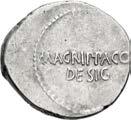
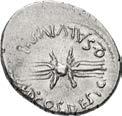
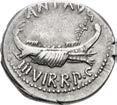
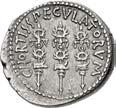
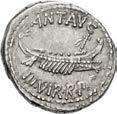


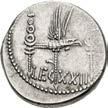




This issue of Octavian depicts him wearing a slight beard. Beginning with his earliest appearance on aurei and denarii struck in 43 BC and down to around 36 BC (see Crawford 540/1-2), Octavian continued to wear this slight beard, originally worn by Roman men who were in the period of mourning (see Crawford 496/2 for an issue of Antony, dated spring-summer 42 BC). As Octavian continued to wear it long after the period of mourning was technically over, the reason he continued to do so was to emphasize his vow of pietas to his slain adoptive father. When combined with the title Divi filius, bestowed on him by the Senate, this beard became part of powerful political message to advance his political position over all his rivals.
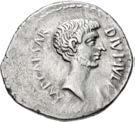
572. The Triumvirs. Octavian and Agrippa. 38 BC. AR Denarius (21mm, 3.98 g, 12h). Military mint traveling with Agrippa in Gaul or with Octavian in Italy. Bare head of Octavian right, wearing slight beard / Â • AgrippA • COÍ/DeÍig in two lines across field. Crawford 534/3; CRI 307; Sydenham 1331; RSC 545; RBW –. Lightly toned, minor porosity, scratches. Good VF. Struck on a broad flan. ($1000)
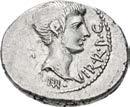
134
566 567 568 569 570 571
573. The Triumvirs. Octavian. Summer 37 BC. AR Denarius (20mm, 3.33 g, 1h). Mint in southern or central Italy. Bare head right, wearing slight beard / Emblems of the augurate and pontificate: simpulum, aspergillum, guttus, and lituus. Crawford 538/1; CRI 312; Sydenham 1334; RSC 91; RBW 1826. Traces of luster, multiple marks and scratches, minor deposits. Near EF. ($750)
574. The Triumvirs. Octavian. Spring-early summer 36 BC. AR Denarius (18mm, 3.90 g, 6h). Southern or central Italian mint. Bare head right, wearing slight beard / Tetrastyle temple of Divus Julius: statue of Julius Caesar as augur standing within, DiuO iuL on architrave, star within pediment, figures along roof line; lighted altar to left. Crawford 540/2; CRI 315; Sydenham 1338; RSC 90; RBW 1829. Scratch on reverse. VF. ($500)
575. The Triumvirs. Octavian. Autumn 32-summer 31 BC. AR Denarius (20.5mm, 3.85 g, 11h). Uncertain mint in Italy (Rome?). Diademed head of Venus right / Octavian advancing left, extending arm and holding spear. CRI 397; RIC I 251; RSC 70. Residual luster, light hairlines. EF. ($1500)
576. The Triumvirs. Octavian. Autumn 32-summer 31 BC. AR Denarius (20.5mm, 3.99 g, 7h). Uncertain mint in Italy (Rome?). Diademed head of Venus right / Octavian advancing left, extending arm and holding spear. CRI 397; RIC I 251; RSC 70. Light scratches, off center on reverse. Near EF. ($1000)
577. The Triumvirs. Octavian. Autumn 31-summer 30 BC. AR Denarius (21mm, 3.85 g, 3h). Uncertain mint in Italy (Rome?). Bare head left / Victory standing right on globe, holding palm frond and wreath. CRI 408; RIC I 255; RSC 66. Lustrous, light hairlines, minor flan flaw on obverse. EF. Well centered on a broad flan. An outstanding portrait and an attractive coin in hand. ($2000)

578. The Triumvirs. Octavian. Autumn 30 BC. AR Denarius (19mm, 3.43 g, 9h). Uncertain mint in Italy (Rome?). Victory standing right on prow of galley, holding palm frond over shoulder and wreath / Octavian, holding branch and reins, driving triumphal quadriga right. CRI 416; RIC I 264; RSC 115. Toned, shallow test cut on edge, some minor marks. VF. ($750)

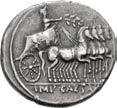



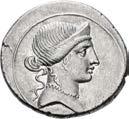

Ex Classical Numismatic Group 93 (22 May 2013), lot 1131.
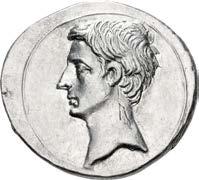



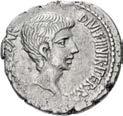
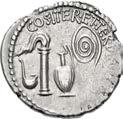
135
573 574
575 576
579. The Triumvirs. Octavian. Autumn 30-summer 29 BC. AR Denarius (20.5mm, 3.74 g, 9h). Uncertain mint in Italy (Rome?). Bare head right / Naval and military trophy facing, composed of helmet, cuirass, shield, and crossed spears, set on prow of galley right; crossed rudder and anchor at base. CRI 419; RIC I 265a; RSC 119. Residual luster, light scratches, banker’s mark on obverse. EF. Well struck. ($1500)

Octavian Claims the Senate in the Name of Julius Caesar
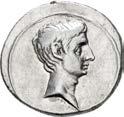
580. The Triumvirs. Octavian. Autumn 30-summer 29 BC. AR Denarius (20mm, 3.69 g, 10h). Uncertain mint in Italy (Rome?). Bare head right / iÂp • CAeÍAr on the architrave of the Roman Senate House (Curia Julia), with porch supported by four short columns, statue of Victory on globe surmounting apex of roof, and statues of standing figures at the extremities of the architrave. CRI 421; RIC I 266; RSC 122. Pitting, trace deposits. Good VF. ($750)
This audacious denarius, it can be argued, symbolized the beginning of the end of the Roman Republic. The Curia Julia, a structure which still stands today just north of the Roman Forum, began its construction under Julius Caesar as a new building for Senate meetings. Its true purpose was to reorient the Senate of Rome to be an appendage of the Roman Forum rather than in its own demarcated area of prominence – yet another of Caesar’s slights against the authority of the Senate. The Curia Julia’s construction and Caesar’s simultaneous reorganization of the Comitium forced the Senate to temporarily meet at the Theater of Pompey – a further indignity that became a consideration during their fatal conspiracy against Caesar. With Caesar’s assassination at the hands of the Senate on the Ides of March, the Curia Julia remained unfinished for a decade and a half of ensuing triumviral civil wars. Octavian, the adopted heir to Caesar and the emergent victor of the civil conflicts, would finally complete and officially dedicate the structure on the 28th of August, 29 BC – mere weeks after the celebrations of his military conquests. In doing so, Octavian succeeded in appearing to restore power to the Senate and the Republic after years of strife, while sending a strong message to the political establishment of Rome that the work of his adoptive father would not be denied. By prominently displaying the legend IMP • CAESAR on the architrave of the Curia Julia on the reverse of this coin, Octavian officially claims the Roman Senate House in the name of Julius Caesar, and continues the momentum of a legacy that would unravel the Roman Republic.

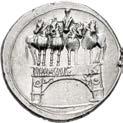


581. The Triumvirs. Octavian. Autumn 30-summer 29 BC. AR Denarius (20mm, 3.77 g, 10h). Uncertain mint in Italy (Rome?). Bare head right / Octavian’s Actian arch (Arcus Octaviani), showing a single span surmounted by Octavian in facing triumphal quadriga; iÂp • CAeÍAr on the architrave. CRI 422; RIC I 267; RSC 123. Area of soft strike. Near EF. ($1500)

The single-span Arcus Octaviani, celebrating Octavian’s victory at Actium, was replaced in 19 BC by the Arcus Augusti, a triple-span arch built to celebrate the recovery by Augustus of the famous standards lost by Antony and Crassus.
582. The Triumvirs. Octavian. Autumn 30-summer 29 BC. AR Denarius (19mm, 4.01 g, 9h). Uncertain mint in Italy (Rome?). Laureate head of Octavian, as Apollo, right / Rostral column ornamented with two anchors and six beaks of galleys, surmounted by a statue of Octavian, holding spear and parazonium. CRI 423; RIC I 271; RSC 124. Lustrous, small scrapes. EF. Struck on a broad flan. An attractive portrait and a particularly well detailed rostral column. ($1500)
This issue depicts the column decreed by the Senate in recognition of Octavian’s victory over Antony and Cleopatra at Actium. The monument stood on the Palatine Hill, before the temple of Apollo.
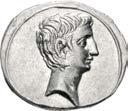
136
581
582
583. The Triumvirs. Octavian. Autumn 30-summer 29 BC. AR Denarius (22mm, 3.62 g, 2h). Uncertain mint in Italy (Rome?). Laureate head of Octavian, as Apollo, right / Rostral column ornamented with two anchors and six beaks of galleys, surmounted by a statue of Octavian, holding spear and parazonium. CRI 423; RIC I 271; RSC 124. Trace deposits and hairlines, residual luster. Near EF. ($1000)

584. The Triumvirs. Octavian. Autumn 30-summer 29 BC. AR Denarius (19mm, 3.92 g, 9h). Uncertain mint in Italy (Rome?). Laureate head of Apollo of Actium right, with features resembling Octavian / Octavian, as city founder, holding whip and plow-handle, plowing right with yoke of oxen. CRI 424; RIC I 272; RSC 117. Residual luster, light hairlines. EF. ($1000)

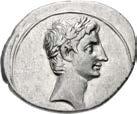


585. The Triumvirs. Octavian. Autumn 30-summer 29 BC. AR Denarius (19.5mm, 3.75 g, 9h). Uncertain mint in Italy (Rome?). Laureate bust of Octavian, as Jupiter Terminus, right; winged thunderbolt to left / Octavian seated left on curule chair, holding Victory. CRI 427; RIC I 270; RSC 116. Residual luster, trace deposits and hairlines, off center on obverse. EF. ($1500)
Aegypto Capta
586. The Triumvirs. Octavian. 28 BC. AR Denarius (20.5mm, 3.53 g, 1h). “Aegypto Capta” commemorative. Uncertain mint in Italy (Rome?). Bare head right; lituus behind neck / Crocodile standing right with jaws open; AegupTO above, CApTA below. CRI 430; RIC I 275a; RSC 2. Attractive cabinet toning, a few light marks, small flan flaw on obverse. Near VF. Rare. ($1500)
Ex Peter J. Merani Collection (Triton XXIV, 19 January 2021), lot 77, purchased from Kirk Davis; I. Vecchi 4 (5 December 1996), lot 44.
Following the decisive battle of Actium, in August of 30 BC Octavian invaded Egypt and founded the Prefecture of Egypt, leaving intact the Ptolemaic structures in culture and administration. Octavian struck this issue to commemorate the event; the reverse depicts a crocodile, which was the symbol of the country and, locally, an important deity.


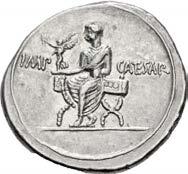


End of Session 2
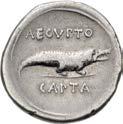
137
583
584
Session 3 – Wednesday, May 24, 2023 — 9 AM
ROMAN IMPERIAL COINAGE
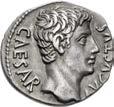
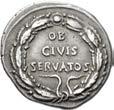
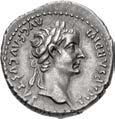

587. Augustus. 27 BC-AD 14. AR Denarius (18mm, 3.90 g, 5h). Uncertain Spanish mint (Colonia Patricia?). Struck 1918 BC. Bare head right / OB/ CIVIS/ SERVATOS in three lines within oak wreath with wreath ties drawn upward. RIC I 77a; RSC 208. Toned, high relief portrait. Good VF. ($1000)
Ex Leu Numismatik Web Auction 16 (22 May 2021), lot 3341 (hammer $1670).
Very Rare Restitution Issue
588. Augustus. 27 BC-AD 14. AR Denarius (19mm, 3.87 g, 10h). Restitution issue. Rome mint. Struck under Hadrian, circa AD 117-138. Laureate head right / Gaius and Lucius Caesar standing facing, each resting hand shield set on ground; behind the shields, two crossed spears; above, on left, a simpulum left, and on right, lituus right. Woytek & Blet-Lemarquand 9-10 (dies III/3); cf. RIC I 208; cf. Lyon 82 var. (simpulum and lituus turned inward); cf. CNG 63, lot 1213 (same dies). Faint hairlines, lightly toned. Near EF. Rare. ($750)

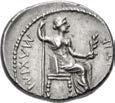

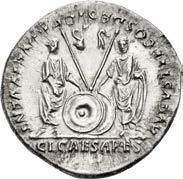
The style and fabric of this coin suggest that it belongs to an anonymous restitution issue, likely of Hadrian. The restitution issues of Trajan are well known since the coins are marked with Trajanic legends. The fact that this coin retains its original legend without any mention of the issuer suggests that it is not part of the great restitution series of Trajan, but part of a later anonymous issue. Apart from style, on all known specimens the lituus has a split base and is turned to the right, and the simpulum is large, rather bulbous and turned to the left, features not seen on the issues of Augustus.

589. Tiberius. AD 14-37. AR Denarius (18.5mm, 3.82 g, 12h). “Tribute Penny” type. Lugdunum (Lyon) mint. Group 4, AD 18-35. Laureate head right; one ribbon on shoulder / Livia (as Pax) seated right on chair, feet on footstool, holding scepter and olive branch; ornate chair legs, single line below. RIC I 30; Lyon 150; RSC 16a. Toned. EF. ($1500)
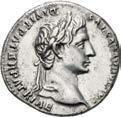
From the collection of a London Novelist. Ex DMS Collection (Triton XXII, 7 January 2019), lot 994; Classical Numismatic Group inventory 160226 (December 2005); Spink 175 (28 September 2005), lot 399.
590. Tiberius. AD 14-37. AR Denarius (18mm, 3.83 g, 12h). “Tribute Penny” type. Lugdunum (Lyon) mint. Group 4, AD 18-35. Laureate head right, one ribbon on shoulder / Livia (as Pax) seated right, holding scepter and olive branch; ornate chair legs. RIC I 30; Lyon 150; RSC 16a. Attractively toned, a little off center on reverse. EF. Bold portrait. ($1000)
Ex Gorny & Mosch 155 (5 March 2007), lot 288.
138
589 590
Ex
Pedigreed to 1959
right, cloaks flying / C
CAESAR

RIC I 49 (Gaius) corr. (rev. legend). Red-brown patina, traces of die rust, light smoothing. Near EF. Exceptional in hand. ($1500)
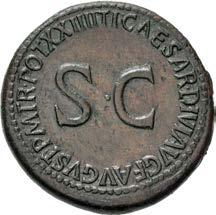

around large
Ex Ernst Ploil Collection (Part III, Numismatica Ars Classica 101, 24 October 2017), lot 107 (hammer


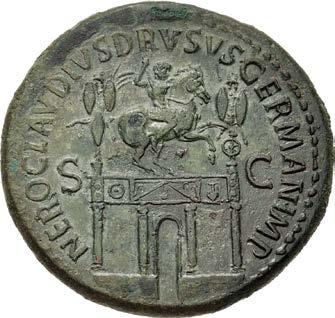

right / NERO
DRVSVS
139
591. Tiberius. AD 14-37. Æ Sestertius (36mm, 28.04 g, 12h). Rome mint. Struck AD 22-23. Tiberius seated left on curule chair, feet on footstool, holding patera and scepter / TI CAESAR DIVI AVG F AVGVST P M TR POT XXIIII around large S • C. RIC I 48. Red-brown patina, smoothing. Good VF. ($750)
A. Kreisberg (with H.M.F. Schulman, 3 April 1959), lot 32.
•
•
• AVG • PRON • AVG • P • M • TR • P • IIII • P • P
S • C.
592. Nero & Drusus Caesar. Died AD 31 and 33, respectively. Æ Dupondius (29mm, 15.59 g, 6h). Rome mint. Struck under Gaius (Caligula), AD 40-41. Nero and Drusus Caesar on horseback riding
DIVI
2750 CHF); Künker 83 (17 June 2003), lot 752.
•
•
• AVG • P • M • TR • P • IMP • P • P •,
•
•
•
•
593. Claudius. AD 41-54. Æ Sestertius (37mm, 26.08 g, 6h). Rome mint. Struck AD 42-43. TI
CLAVDIVS
CAESAR
laureate head
CLAVDIVS
GERMAN
IMP, S C across field, triumphal arch, surmounted by an equestrian statue right between two trophies; the rider strikes downward with spear in right hand. RIC I 114; von Kaenel Type 71; BMCRE 188-91; BN 212-5. Attractive green patina, smoothed and tooled. EF. ($3000) Ex Vico 113 (8 March 2007), lot 271 (reverse illustrated on back cover of catalog).
594. Nero. AD 54-68. AV Aureus (19mm, 7.61 g, 1h). Rome mint. Struck AD 56-57. NERO • CAESAR • AVG • IMP •, bare head right / PONTIF • MAX • TR • P • III • P • P •, EX • S C within oak wreath. RIC I 11; Calicó 421; BMCRE 12-3; BN 18; Adda 33. Lustrous, marks, scrape on reverse. Good VF. Handsome, youthful portrait. ($3000)

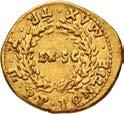
595. Nero. AD 54-68. Æ Sestertius (34.5mm, 26.04 g, 6h). Rome mint. Struck circa AD 64. Laureate head left / Nero, in military dress, on horseback riding right, holding couched spear, soldier on foot behind; before him, a second soldier advancing right and looking back, holding signum. RIC I 175; WCN 133. Dark green patina, some pitting and smoothing. VF. Rare variety with Nero riding among infantry soldiers. ($1500)
Ex Collection of an Archaeologist (Künker 347, 22 March 2021), lot 423, purchased from Günther Schlüter (Chairman of the German Numismatic Society 1975-1977), December 1993, who had purchased the coin from Spink, March 1961.
596. Nero. AD 54-68. Æ Dupondius (29mm, 16.29 g, 6h). Rome mint. Struck circa AD 64. Radiate head right / Victory flying left, holding wreath and palm frond; II (mark of value) in exergue. RIC I 196; WCN 205. Attractive tan river surfaces, minor roughness on reverse. VF. ($400)

From the Richard McAlee Collection. Ex Frederick S. Knobloch Collection (Stack’s, 1 May 1980), lot 225.
Ex Ploil Collection
597. Nero. AD 54-68. AR Denarius (18.5mm, 3.45 g, 6h). Rome mint. Struck circa AD 65-66. Laureate head right / Hexastyle temple of Vesta with domed roof, set on podium of four steps; within, statue of Vesta seated left, holding patera and scepter. RIC I 62; RSC 335. Lightly toned. Near EF. Well struck on a broad flan. ($2000)
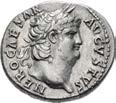

From the collection of a London Novelist. Ex Ernst Ploil Collection (Part III, Numismatica Ars Classica 101, 24 October 2017), lot 147; Lanz 123 (30 May 2005), lot 468.
598. Nero. AD 54-68. Æ Sestertius (35mm, 27.84 g, 7h). Rome mint. Struck circa AD 66. Laureate head right / Roma seated left on cuirass, right foot on helmet, holding Victory and parazonium; shields to right. RIC I 329; WCN 160. Dark brown patina, surface marks, edge scrape. Good VF. A striking portrait with a particularly attractive reverse. ($1500)
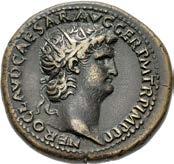



Ex Classical Numismatic Group 118 (13 September 2021), lot 987; T. R. Fehrenbach Collection (Heritage 3089, 21 January 2021), lot 32177; Classical Numismatic Review XV.4 (4th Quarter 1990), no. 56; Aus dem Monetarium FPL (December 1989), no. 3.
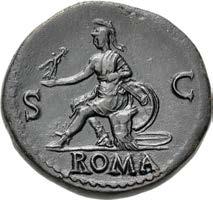
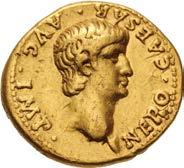
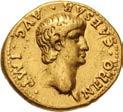
140
595
596
The Civil War of AD 68/9
The civil wars at the end of Nero’s reign began with the revolt of the governor of Gallia Lugdunensis, Gaius Julius Vindex, probably at the beginning of March of AD 68. Vindex offered the leadership of the revolt to Servius Sulpicius Galba, then governor of Hispania Tarraconensis, who was hailed imperator by the Spanish legions at Carthago Nova in April of the same year. The title was cautiously refused, but Galba did declare himself the legatus of the senate and people of Rome. Just a month later, Galba’s confidence would be shaken by the crushing defeat of Vindex near Besançon by the general Lucius Verginius Rufus, governor of Germania Superior. But in another twist of fate, by 9 June, Nero was dead, having taken his own life. Galba began his march to Rome, and his brief reign was underway.

Coinage, of course, was needed to pay the soldiery during these precarious months of revolt and without an emperor to strike in the name of (save for that in honor of the “model emperor” of Roman history, Augustus), coinage was struck with messages suiting the political climate. The issues struck under Vindex in Gaul possess a more aggressive air that underscores the militant nature of his revolt, while Galba’s coinage, minted in Spain, tend to be more constitutional and optimistic in tone.

599. Civil War. AD 68-69. AR Denarius (17mm, 3.39 g, 6h). Group I (Spain). Uncertain Spanish mint. Diadamed and draped bust of Bonus Eventus right / Roma advancing right, holding Victory on globe and transverse scepter. RIC I 11; AM 53; RSC 400. Some light scratches and porosity, edge split, graffito (“VII”) in field on obverse. VF. Very rare. ($1000)






Ex Dipl.-Ing. Christian Gollnow Collection (Leu Numismatik 9, 24 October 2021), lot 1029, purchased from Harlan J. Berk, June 1992.
600. Civil War. AD 68-69. AR Denarius (18mm, 3.34 g, 5h). Group VI. Uncertain mint in Spain. Struck 3 April-2nd half of June AD 68. Filleted head of Bonus Eventus right / Roma standing right, holding crowning Victory in right hand and eagletipped scepter in left. RIC I 11 var. (rev. legend); AM 50; RSC 400 var. (same). A few light scratches, areas of find patina, off center on obverse. Good VF. Extremely rare variety, known from just two examples (the other in Madrid). ($1500)
Ex Dipl.-Ing. Christian Gollnow Collection (Leu Numismatik 9, 24 October 2021), lot 1026.
601. Civil War. AD 68-69. AR Denarius (17mm, 3.43 g, 6h). Group VII. Uncertain mint in Spain. Struck 3 April-2nd half of June AD 68. CONCORDIA • ORB • TER •, diademed and veiled bust of Concordia right / PIA FELICITAS, Felicitas standing left, holding patera over altar in her right hand, short scepter in left. RIC I 41; AM 48a; BSFN (May 1973), p. 384f. = Martin 4a (this coin); RSC –. Old cabinet tone, some faint scratches under tone, metal flaw on reverse. VF. Extremely rare, one of two known examples. ($3000)
Ex Dipl.-Ing. Christian Gollnow Collection (Leu Numismatik 9, 24 October 2021), lot 1022.
602. Civil War. AD 68-69. AR Denarius (18mm, 3.39 g, 6h). Augustus, with Divus Julius type. Uncertain mint in Spain or Gaul. Struck 3 April-late June AD 68. CAESAR AVGVSTVS, laureate head right / DIVVS IVLIVS across field, Sidus Iulium: eight-rayed comet with tail upwards. RIC I 92; AM A10; RSC 98 (Augustus); Mairat 146.6 (this coin); BMCRE 49 = Nicolas, Néron A8. Lighlty toned, slightly granular surfaces. Good VF. Struck on a full flan. Very rare. ($5000)

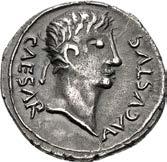
Ex Dipl.-Ing. Christian Gollnow Collection (Leu Numismatik 9, 24 October 2021), lot 1043, purchased from Paul-Francis Jacquier, September 1992.
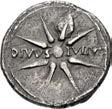
141
599 600
603. Civil War. AD 68-69. AR Denarius (18mm, 3.56 g, 5h). ‘Virtus-Roma Group’ - ‘Jupiter Group’, Style A. Uncertain mint in Gaul or Rhine Valley. Struck circa May/June-December AD 68. Helmeted and draped bust of Roma right / Jupiter seated left on throne, holding thunderbolt in right hand and scepter in left. RIC I 62; AM 20; RSC 374. Toned; a few light scratches. VF. Very rare. ($2000)
Ex Dipl.-Ing. Christian Gollnow Collection (Leu Numismatik 9, 24 October 2021), lot 1148, purchased from Harlan J. Berk, 1993.
604. Civil War. AD 68-69. AR Denarius (17mm, 3.46 g, 5h). ‘S P Q R Group’. Uncertain mint in Gaul or Rhine Valley. Struck May/June AD 68. Victory standing left on globe, holding wreath in left hand and palm frond over right shoulder / S P · Q R within oak wreath. RIC I 72; AM 77; RSC 420; Mairat 97.12 (this coin). Attractive cabinet tone, minor field marks. Near EF. Rare. ($3000)

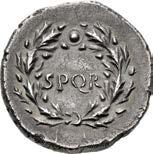
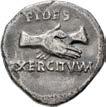


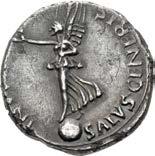
Ex Dipl.-Ing. Christian Gollnow Collection (Leu Numismatik 9, 24 October 2021), lot 1088; Nomos 9 (21 October 2014), lot 221.

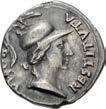
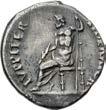

605. Civil War. AD 68-69. AR Denarius (17mm, 3.17 g). ‘S P Q R Group’. Uncertain mint in Gaul or Rhine Valley. Struck May/June AD 68. Victory standing left on globe, holding wreath in left hand and palm frond over right shoulder / S P · Q R within oak wreath. RIC I 72; AM 77; RSC 420. Toned, minor marks, reverse slightly off center. Good VF. Rare. ($1500)
Ex Dipl.-Ing. Christian Gollnow Collection (Leu Numismatik 9, 24 October 2021), lot 1083, purchased from Seaby.

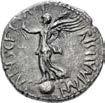
Extremely Rare Variety
606. Civil War. AD 68-69. AR Denarius (18mm, 3.18 g, 10h). ‘S P Q R Group’. Uncertain mint in Gaul or Rhine Valley. Struck circa May/June-December AD 68. Victory standing right on globe, holding wreath in right hand and palm frond over left shoulder / S P · Q R within laurel wreath. RIC I 73b var. (oak wreath); AM 78 var. (same); RSC 421 var. (same). Deeply toned, some reverse deposits, small edge chips. Good VF. Extremely rare variety, one of three known specimens with a laurel wreath. ($1500)
Ex Dipl.-Ing. Christian Gollnow Collection (Leu Numismatik 9, 24 October 2021), lot 1112; Lanz 16 (24 April 1979), lot 349.
Published by Nicolas
607. Civil War. AD 68-69. AR Denarius (17mm, 3.18 g, 6h). ‘Fides Group’. Uncertain mint in Gaul or Rhine Valley. Struck circa May-June AD 68. Clasped right hands / Concordia standing left, holding branch in right hand and cornucopia in left. RIC I 118; AM 3; RSC 359; Nicolas, Neron 3 and pl. XV, 3 (this coin). Toned, a few scratches. VF. Rare and unusually complete. ($1000)
Ex Dipl.-Ing. Christian Gollnow Collection (Leu Numismatik 9, 24 October 2021), lot 1059; Dr. E. P. Nicolas Collection (Kampmann, 9 March 1982), lot 210.
142
605 606
Ex Mazzini & Ryan Collections – Pedigreed to 1921
608. Civil War. AD 68-69. AR Denarius (16.5mm, 3.54 g, 6h). Group IV (‘Military’[?] group). Uncertain (Southern Gaul?) mint. Struck AD 69(?). Clasped right hands / Clasped right hands. RIC I 121; AM 7 (this coin cited); RSC 363; Mazzini 363 (this coin). Attractive cabinet tone with colorful iridescent highights, minor marks and scratches under tone. Near EF. ($2000)
From the collection of a London Novelist. Ex de Guermantes Collection (Leu 86, 5 May 2003), lot 781; G. Mazzini Collection; V. J. E. Ryan Collection (Part V, Glendining, 2 April 1952), lot 2121; Bourgey (20 December 1921), lot 112.
609. Galba. AD 68-69. AV Aureus (19mm, 7.21 g, 6h). Rome mint. Struck circa July AD
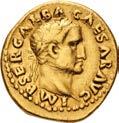
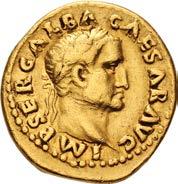


68-January 69. IMP SER GALBA CAESAR AVG, laureate head right / ROMA RENASC, Roma, helmeted and in military dress, advancing right, holding Victory on globe in right hand and transverse spear in left. RIC I 198; Calicó 491 (same dies as illustration); BMCRE –; BN –; Adda 40. Minor surface and edge marks, light deposits, small obverse scrapes. Near VF. Very rare. Only three examples in CoinArchives. ($5000)
610. Galba. AD 68-69. AR Denarius (19mm, 3.49 g, 6h). Rome mint. Struck circa July AD 68-January 69. Bare head right / S P Q R/ OB/ C S in three lines within oak wreath. RIC I 167; RSC 287. Lustrous. Near EF. ($1500)
611. Galba. AD 68-69. AR Denarius (19mm, 3.22 g, 6h). Rome mint. Struck circa July AD 68-January 69. Laureate and
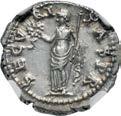





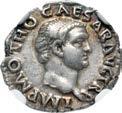
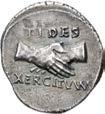
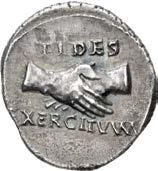

RIC I 189;
55a.
($1500)
From the collection of a London Novelist. Ex Baldwin’s 44 (2 May 2006), lot 179.
15 January–8 March.
17.
143
draped bust right / Diva Julia Augusta (Livia) standing left, holding patera and scepter.
RSC
Attractive cabinet tone, a few old scratches under tone, minor edge marks. Good VF.
610
612. Otho. AD 69. AR Denarius (18.5mm, 3.31 g, 6h). Rome mint. Struck
Bare head right / Securitas standing left, holding wreath and scepter. RIC I 8; Muona Group 1, Type 4B, Portrait Type A; RSC
In NGC encapsulation 6369972-005, graded Ch XF, Strike: 5/5, Surface: 3/5. ($2000)
611
Exceptional Otho – Ex Gasvoda Collection
613. Otho. AD 69. AR Denarius (20.5mm, 3.58 g, 7h). Rome mint. Struck 15 January–8 March. IMP OTHO CAESAR AVG TR P, bare head right / SECVRI TAS P R, Securitas, draped, standing left, holding wreath in right hand and scepter in left. RIC I 10; Muona Group 2, Type 9B; RSC 15; BMCRE 19; BN 11-13. Lightly toned, with underlying luster. EF. Well centered and struck on a broad flan. Exceptional as such. ($7500)
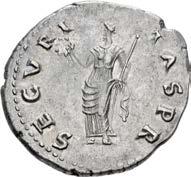

From the collection of a London Novelist. Ex Gasvoda Collection (Part I, Numismatica Ars Classica 86, 8 October 2015), lot 150; Purchased from Steve Rubinger; Numismatica Ars Classica 46 (2 April 2008), lot 521.
614. Vitellius. AD 69. Æ Sestertius (34mm, 22.17 g, 6h). Rome mint. Struck circa late April-20 December. Laureate and draped bust right / Pax standing left, holding olive branch and cornucopia. RIC I 118. Dark red-brown and green patina, areas of roughness and smoothing. VF. Bold portrait. ($2000)

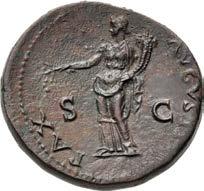
From the Richard McAlee Collection. Ex Classical Numismatic Group Electronic Auction 90 (23 May 2012), lot 1487.
615. Vespasian. AD 69-79. Fourrée Denarius (17.5mm, 2.65 g, 7h). Imitating a “Judaea Capta” commemorative from the Rome mint, circa 21 December AD 69-early 70. Laureate head right / IVDAEA in exergue, palm tree; to right, Judaea seated right, hands bound behind back. Cf. RIC II.1 4; cf. Hendin 6510; cf. RSC 229. Toned, a couple of breaks in the plating, scrape on reverse near edge. VF. ($500)
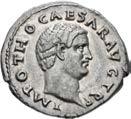


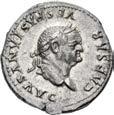



Ex Dr. Jay M. Galst Collection (Classical Numismatic Group 118, 13 September 2021), lot 1003; Coin Galleries (16 February 1994), lot 293.
616. Vespasian. AD 69-79. Æ Sestertius (34mm, 25.42 g, 6h). “Judaea Capta” commemorative. Rome mint. Struck AD 71. Laureate head right / Victory standing right, left foot on helmet, inscribing shield with right hand set on palm tree; on right, Judaea seated right, in attitude of mourning. RIC II.1 221; Hendin 6538. Green and brown patina, a few cleaning marks. VF. ($1500)
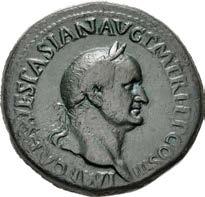
Ex Father & Son Collection (Classical Numismatic Group 118, 13 November 2021), lot 1008; Patrick H. C. Tan Collection (Classical Numismatic Group 84, 5 May 2010), lot 983.
617. Vespasian. AD 69-79. AR Denarius (18mm, 3.40 g, 6h). Rome mint. Struck July AD 77-December 78. Laureate head right / Modius with seven ears of grain. RIC II.1 980; RSC 216. Lightly toned, hairlines, flan flaws on reverse. EF. ($500)
From the collection of a London Novelist. Ex Yves Gunzenreiner Collection (Leu Numismatik 1, 25 October 2017), lot 183.
144
614 615 616 617
Sear Plate Coin


EF.
Colosseum Sestertius
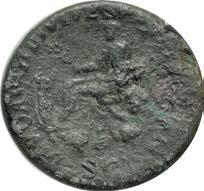
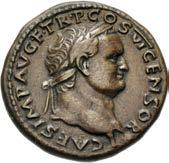
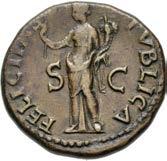
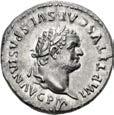
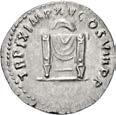
145
618. Titus. As Caesar, AD 69-79. Æ Dupondius (28mm, 12.89 g, 6h). Lugdunum (Lyon) mint. Struck under Vespasian, AD 77-78. Laureate head right, globe at point of neck / Felicitas standing left, holding caduceus and cornucopia. RIC II.1 1252 (Vespasian); Lyon 107 (Vespasian); S 2466 (this coin illustrated). Attracive brown surfaces. VF. Excellent portrait. ($500)
From the Richard McAlee Collection. Ex Numismatic Fine Arts [XVII] (27 June 1986), lot 765; Numismatic Fine Arts VI (27 February 1979), lot 676.
619. Titus. AD 79-81. AR Denarius (18mm, 3.49 g, 5h). Rome mint. Struck 1 January-30 June AD 80. Laureate head right / Pulvinar (throne) of Apollo and Diana(?): square seat with semi-circular back, decorated with three palmettes. RIC II.1 122; RSC 313. Lightly toned, lustrous, light scratch on obverse, slight reverse die wear.
($500)
620. Divus Titus. Died AD 81. Æ Sestertius (32mm, 25.57 g, 6h). Rome mint. Struck under Domitian, AD 81-82. View of the Flavian Amphitheater (The Colosseum), seen from aerial perspective; to left, Meta Sudans; to right, porticus of the Baths of Titus / DIVO AVG T DIVI VESP F V[ESPASIAN], S C in exergue, Divus Titus seated left on curule chair, holding branch; arms around. RIC II.1 131 (Domitian); Elkins Type D, 9 (A5/P8). In ANACS encapsulation 6029636, graded F 15, Corroded. Very rare. ($5000)
621. Julia Titi. Augusta, AD 79-90/1. AR Denarius (18mm, 3.51 g, 6h). Rome mint. Struck under Titus, AD 80-81. Diademed and draped bust right; hair in long plait / Venus, seen half from behind, naked to the hips, standing right, resting elbow on column, holding transverse scepter and crested helmet. RIC II.1 388 (Titus); RSC 14; BMCRE 141-3 (Titus); BN 106-7 (Titus). Beautifully toned, some faint hairlines under tone. Near EF. ($2500)
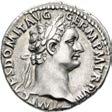


Ex Thomas A. Palmer Collection (Classical Numismatic Group 118, 13 September 2021), lot 1040, purchased from Classical Numismatic Group, August 1995; Leu 59 (17 May 1994), lot 264; Leu 45 (26 May 1988), lot 323.
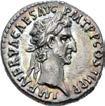
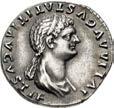
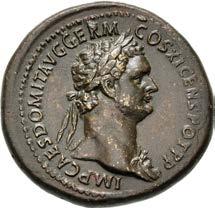

Flavia Julia Titi was born in AD 65 as the daughter of Titus Flavius Vespasianus, an up-and-coming junior officer in the Roman Army. Titus was soon forced to divorce Julia’s mother, whose family was implicated in a plot against the Emperor Nero. Three years later, Vespasian seized the throne and Titus, his eldest son, was named Caesar and heir-apparent. Julia was Titus’ only child and soon became a pawn in the game of dynastic politics. In her teens, Julia evidently developed an attachment to Titus’ younger brother Domitian. When she came of age, Titus, perhaps reluctantly, proposed that she marry Domitian. But Domitian was enamored with another lady and refused the match. A short time later Julia was betrothed to a cousin, Flavius Sabinus, who was just starting on his political career. In AD 79, Vespasian died and Titus became sole emperor. One of his first official acts was to raise Julia to the rank of Augusta, or Empress, the first woman in more than a decade to hold that exalted position. He struck this lovely coin for the occasion, pairing Julia’s obverse portrait with a charming image of Venus with her half-covered derriere turned coyly to the viewer. Julia thus became the first reigning Roman empress to be honored with a regular issue of Roman coins struck solely in her own name.
Exceptional
Attractive brown patina with patches of red. Good VF. Exceptional reverse. ($2000)
From the DMS Collection. Ex Triton IX (10 January 2006), lot 1437.
623. Domitian. AD 81-96. AR Denarius (18mm, 3.53 g, 6h). Ludi Saeculares (Secular Games) issue. Rome mint. Struck 14 September-31 December AD 88. Laureate head right / Herald, wearing long garment to ankles and short over-garment to waist, round cap with two feathers on head, advancing left, holding vertical wand in right hand and round shield, on which is helmeted bust of Minerva right, in left. RIC II.1 596; RSC 76/77. Lightly toned with hints of luster, small flan flaws on reverse. Good VF. ($500)

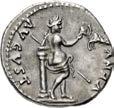
From the DFA Collection.
624. Nerva. AD 96-98. AR Denarius (17mm, 3.54 g, 6h). Rome mint. Struck AD 97. Laureate head right / Libertas standing left, holding pileus in right hand and vindicta in left. RIC II 19; RSC 113. Stunning iridescent tone, lustrous, trace deposits. EF. ($1000)
According to A Dictionary of Ancient Roman Coins by John Melville Jones, “Libertas”, the vindicta, which Libertas carries, was “the rod with which a slave was touched during the ceremony of manumission or liberation.”

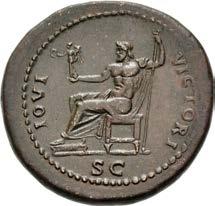
146
622. Domitian. AD 81-96. Æ Sestertius (36mm, 26.29 g, 6h). Rome mint. Struck AD 85. Laureate bust right, wearing aegis / Jupiter seated left, holding Victory in extended right hand, scepter in left. RIC II.2 352.
623
624
626.
98-117. Æ
(27mm, 13.37 g, 6h). Rome mint. Struck 20 February AD 116-August 117. Radiate and draped bust right / Trajan, in military dress, advancing right, head left, between two trophies, raising hand in address and holding spear. RIC II 676; Woytek 586v. Brown surfaces. Good VF. ($500)

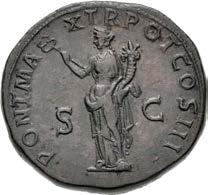
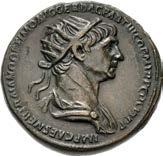

From the Richard McAlee Collection. Ex Superior (22 August 1994), lot 2386.
627.
117-138. Æ
(35mm, 30.37 g, 5h). Rome mint. Struck circa AD 119-mid 120. Laureate heroic bust right, slight drapery / Felicitas standing left, holding caduceus in right hand and cornucopia in left. RIC II.3 244; Banti 610. Brown surfaces, minor roughness, lightly smoothed. VF. ($750)
Ex Classical Numismatic Group inventory 155861 (December 2004).
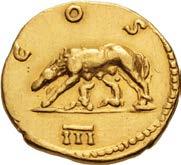

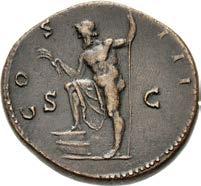
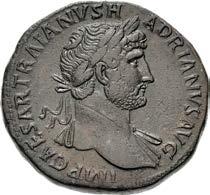
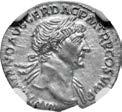
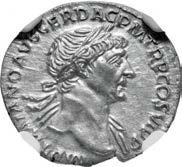
628. Hadrian. AD 117-138. AV Aureus (19mm, 6.83 g, 6h). Rome mint. Struck circa AD 124-125. HADRIANVS AVGVSTVS, Laureate bust left, slight drapery / COS above, III in exergue, she-wolf standing left, suckling the Twins (Romulus and Remus). RIC II.3 710 (same obv. die as illustration); Calicó 1235 (same obv. die as illustration); BMCRE –; Biaggi 599 (same obv. die); Mazzini 423 (same obv. die). Some hairlines. Good VF. Rare. ($4000)

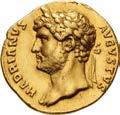
Pedigreed to 1961
629.
117-138.
(33mm, 25.59 g, 5h). Rome mint. Struck circa AD 125-126/7. Laureate bust right, slight drapery / Neptune standing left, right foot set on prow, mantel on thigh, holding acrostolium and trident. RIC II.3 811; Banti 172. Brown patina with tan highlights, small area of pitting on obverse. Good VF. ($1500)

Ex Collection of an Archaeologist (Künker 347, 22 March 2021), lot 423, purchased from Günther Schlüter (Chairman of the German Numismatic Society 1975-1977), August 1993; Seaby Coin & Medal Bulletin 514 (March 1961), no. B257.
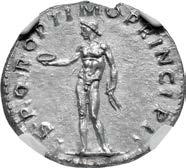
147
625. Trajan. AD 98-117. AR Denarius (18mm, 3.05 g, 6h). Rome mint. Struck AD 113-114. Laureate bust right, slight drapery / Bonus Eventus standing left, holding patera and grain ears. RIC II 276; Woytek 421b; RSC 398a. Lightly toned. In NGC encapsulation 4936325-002, graded MS, Strike: 5/5, Surface: 3/5. ($500)
Trajan. AD
Dupondius
Hadrian. AD
Sestertius
Hadrian. AD
Æ Sestertius
626
627
630. Hadrian. AD 117-138. AR Denarius (18mm, 3.24 g, 5h). Rome mint. Struck AD 133-circa 135. Bare head right / Salus, draped, standing right, right hand extended, feeding out of patera serpent coiled around and rising from altar to right. RIC II.3 2048; RSC 1335. Iridescent tone, a few shallow scratches under tone on reverse. Superb EF. Struck from fresh dies. ($1000)

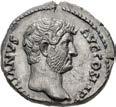

Ex Ulysses Collection (Triton XXV, 26 January 2022), lot 899; Leu Numismatik 4 (25 May 2019), lot 646.
631. Hadrian. AD 117-138. AR Denarius (18mm, 3.10 g, 6h). Rome mint. Struck AD 133-circa 135. Bare head right / Salus, draped, standing right, right hand extended, feeding out of patera serpent coiled around and rising from altar to right. RIC II.3 2048; RSC 1335. Beautiful iridescent tone with underlying luster, a few very minor flan flaws on reverse. Choice EF. ($750)
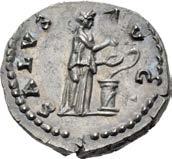
Ex Leu Numismatik 3 (27 October 2018), lot 240.
The Provincial Series of Antoninus Pius
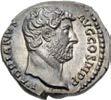
632. Antoninus Pius. AD 138-161. Æ Sestertius (32mm, 22.72 g, 5h). Provincial series. Rome mint. Struck AD 139. Laureate head right / DACIA, S - C, COS II in exergue, Dacia standing facing, head left, holding crown in right hand, draco standard in left. RIC III 581; Banti 135. Dark green patina, flan crack, roughness on reverse. VF. Very rare, only one known to Banti. ($750)
Ex Friedrich Collection (Numismatica Ars Classica, 2 April 1995), lot 1355, purchased from Frank Kovacs.


The Provincial coin issues of Antoninus Pius begin early in his reign, circa AD 139, and represent something of a continuation from the similar series of his predecessor, Hadrian. Unlike Hadrian, Antoninus never left Italy over the 24 years of his reign and never saw the vast majority of the provinces depicted, although he did serve as governor of Asia during his senatorial career. The provincial sestertii of Antoninus are, as a rule, quite rare and difficult to acquire in pleasing grades.
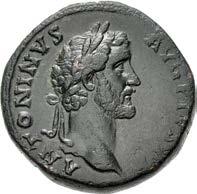

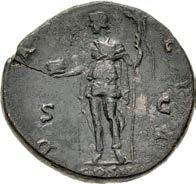

Banti Plate Coin – Extremely Rare
633.
Ex Galerie des Monnaies of Geneva [1] (25 June 1976), lot 800.
($750)
148
Antoninus Pius. AD 138-161. Æ Sestertius (32mm, 29.88 g, 5h). Provincial series. Rome mint. Struck AD 139. Laureate head right / DACIA, S - C, COS II in exergue, Dacia standing facing, head left, holding crown in right hand, falx in left. RIC III –; Banti 136 (this coin). Black patina, minor pitting. VF. Extremely rare, one of two known specimens.
632
633
Ex Platt Hall and Vierordt Collections – Pedigreed to 1904
634. Antoninus Pius. AD 138-161. Æ Sestertius (35mm, 26.48 g, 5h). Rome mint. Struck circa AD 140. ANTONINVS AVGVSTVS PIVS, laureate bust right, wearing aegis / P P TR P COS III, S C in exergue, Aeneas, wearing short tunic and cloak, advancing right, carrying Anchises on left shoulder and leading Ascanius by right hand: Anchises is veiled and draped and holds box in left hand, Ascanius wears Phrygian cap and holds pedum in left hand. RIC III 615; Strack 903 (this coin cited); Banti 309 (this coin illustrated); BMCRE 1264. Brown patina, tooled and smoothed. VF. Very rare. ($3000)
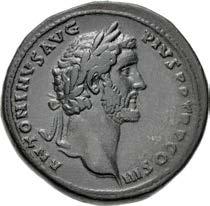
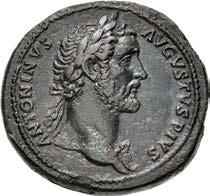
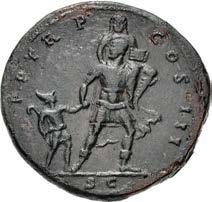
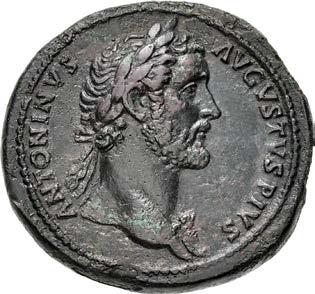
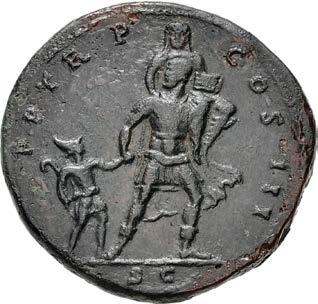

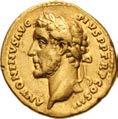

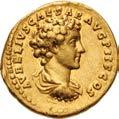
Ex Künker 288 (13 March 2017), lot 577; Kunst und Münzen XXIX (20 May 1993), lot 384; Henry Platt Hall Collection (Part II, Glendining, 16 November 1950), lot 1458; M. L. Vierordt Collection (J. Schulman, 5 March 1923), lot 1479; Egger XLIII (14 April 1913), lot 943; J. Hirsch XI (4 May 1904), lot 916.
The reverse depicts a scene recounted by Virgil in the Aeneid, when the Greeks attacked and set fire to Troy; here we see Aeneas fleeing, carrying his aged father, Anchises, on his shoulder, leading his son, Ascanius, by the hand to safety.

149
635. Antoninus Pius, with Marcus Aurelius as Caesar. AD 138-161. AV Aureus (18.5mm, 7.03 g, 12h). Rome mint. Struck circa AD 141-143. ANTONINVS AVG PIVS P P TR P COS III, laureate head of Pius left / AVRELIVS CAESAR AVG P II F COS, bareheaded, draped, and cuirassed bust of Aurelius right. RIC III 421b; Calicó 1734 (same rev. die as illustration; same obv. die as illustration of Calicó 1733); BMCRE 170; Biaggi 798 (same rev. die). Minor marks and nicks, faint hairlines. Good VF. Rare. ($3000)
636. Antoninus Pius. AD 138-161. Æ Sestertius (34mm, 28.15 g, 12h). Rome mint. Struck circa AD 141-143. Laureate head right / Antoninus Pius and Marcus Aurelius seated left on sella castrensis on raised daïs, extending hand; to left and right, lictor standing, holding rod. RIC III 628; Banti 374. Dark gray patina, smoothed. VF. ($750)
From the Richard McAlee Collection. Ex Classical Numismatic Group 87 (18 May 2011), lot 1006.
A King Given to the Quadi
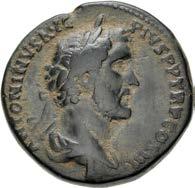






The Quadi were a Germanic tribe situated in modern Moravia, western Slovakia. Tacitus refers to them in his Germania as a warlike people akin to the Marcomanni, who like them were governed by kings “descended from the noble line of Maroboduus and Tudrus.” Both tribes fought against, and were defeated by, the future emperor Tiberius circa 6 AD, although a revolt in Illyricum prevented the Romans from attempting to occupy or annex their lands. Tacitus, in his Annals relates a series of kings of both tribes who were raised up and rapidly deposed during the reign of Tiberius after about AD 18; the last of these kings was a Quadian named Vannius, who reigned until circa AD 50. The Marcomanni agreed to a treaty by which future kings would be appointed by Rome, but the only evidence we have that the Quadi agreed to a similar arrangement is this rare coin type of Antoninus Pius, struck in AD 143, which depicts the emperor crowning the Quadian king, along with the legend REX QVADIS DATVS (”a king given to the Quadi”). Three decades later, the Quadi would join the Marcomanni is making war on the Romans, even invading Italy and placing Aquileia under siege. The vicious, protracted conflict occupied much of Marcus Aurelius’ reign. One of the books of his Meditations was written “Among the Quadi.” Though Marcus ultimately pushed them back across the frontier, the Quadi remained a thorn in the Roman side until the fifth century AD.

150
637. Antoninus Pius. AD 138-161. Æ Sestertius (32mm, 25.12 g, 12h). Rome mint. Struck AD 143. Laureate and draped bust right / REX QVADIS DATVS, S C in exergue, Pius standing left, togate, presenting a diadem to the king of the Quadi standing right. RIC III 620; Banti 324. Dark brown patina, earthen highlights, minor cleaning scratches. Near VF. Very Rare. ($1000)
638. Antoninus Pius. AD 138-161. AR Denarius (19mm, 3.32 g, 6h). Rome mint. Struck AD 149-150. Laureate head right / Bonus Eventus standing left, holding patera in right hand and grain ears in left. RIC III 180; RSC 218. Iridescent toning, small edge splits. Choice EF. Well struck and attractively toned. ($500)
From the DFA Collection.
639. Antoninus Pius. AD 138-161. AV Aureus (18mm, 6.76 g, 6h). Rome mint. Struck AD 150-151. ANTONINVS PI VS P P TR P XIIII, laureate bust right, slight drapery / LAET I T IA, COS IIII in exergue, Ceres, draped, standing right, holding two grain ears in right hand; at her right side, Proserpina, draped, standing left, holding pomegranate in left hand. RIC III 199 var. (bust type); Strack 224; Calicó 1559a (same obv. die as illustration); BMCRE 724, note; Adda 192 (same obv. die); cf. Biaggi 733. Small flan flaw on obverse. Near EF. ($3000)
High Relief

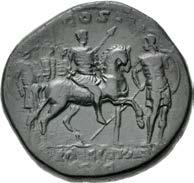
640. Antoninus Pius. AD 138-161. AV Aureus (18.5mm, 7.24 g, 6h). Rome mint. Struck AD 153-154. ΛNTONINVS ΛVG PI VS P P TR P XVII, laureate head right / COS IIII, Antoninus Pius, togate, standing left, holding globe in extended right hand and volumen in left at side. RIC III 233b; Strack 270δ; Calicó 1527 (same obv. die as illustration); BMCRE 813; Adda 183; Biaggi 718 (same obv. die); Mazzini 312 (same obv. die). Lustrous. In NGC encapsulation 6559106-004, graded MS, Strike: 5/5, Surface: 4/5, Fine Style. Well struck in high relief. ($7500)

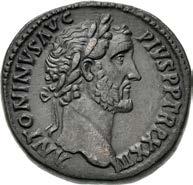


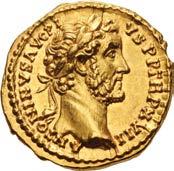
From the Willamette Valley Collection. Ex Grand Haven Collection (Triton XXIV, 19 January 2021), lot 1093; Heritage 3075 (15 August 2019), lot 32051; Classical Numismatic Review XXVI.1 (Summer 2001), no. 103.
The mild, civilian nature of Antoninus’ government is exemplified by this aureus, which depicts him on the reverse wearing the toga, traditional garb of a Roman civil magistrate, and holding a globe and volumen, or scroll. The globe had been a symbol of universal rule since the emergence of classical Greece.

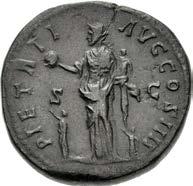
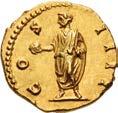
641.

151
Antoninus Pius. AD 138-161. Æ Sestertius (32mm, 28.41 g). Rome mint. Struck AD 159-160. Laureate head right / Pietas standing left, holding globe and child; a child standing on either side of her. RIC III 1031; Banti 287. Brown patina, smoothing. Good VF. ($750)
642. Marcus Aurelius. As Caesar, AD 139-161. Æ Sestertius (32mm, 29.30 g, 12h). Rome mint. Struck under Antoninus Pius, AD 153-154. Bareheaded, draped, and cuirassed bust right / Minerva seated right, holding spear and shield set on ground to right. RIC III 1315 (Pius); Banti 336. Brown-green surfaces, lightly tooled. Good VF. ($400)
From the Richard McAlee Collection. Ex Classical Numismatic Group Electronic Auction 398 (31 May 2017), lot 531.
643. Marcus Aurelius. AD 161-180. Æ Sestertius (32mm, 24.93 g, 6h). Rome mint. Struck AD 169. Laureate head right / Marcus Aurelius on horseback right, holding spear and reins; to left, three soldiers standing right; to right, soldier standing left, holding spear and shield. RIC III 963; MIR 18, 179-6/30; Banti 244. Dark brown patina, minor roughness and deposits on reverse. VF. Rare. ($750)
From the D.K. Collection. Ex Classical Numismatic Group 97 (17 September 2014), lot 670; Roma VI (29 September 2013), lot 944. This reverse commemorates Aurelius’ departure in AD 169 on his first campaign against the Germanic tribes.
641
642
Lustrous Commodus Aureus
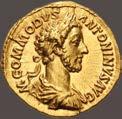

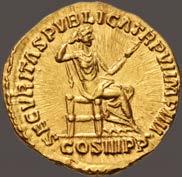
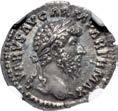

Lustrous, minor scratch on reverse, edge lightly grazed. EF. ($15,000)
The sole reign of Commodus, AD 180-192, is often viewed as the tipping point where The Roman Empire’s long decline began. Commodus has thus been featured in novels, plays, and feature films, usually as a villain, most recently in the cinema epics “Fall of the Roman Empire” (1964), portrayed by Christopher Plummer, and “Gladiator” (2001), portrayed by Joaquin Phoenix. His actual persona, and the events of his 12-year sole reign, are far more complex and fantastical than depicted in either film. The son of the greatly revered “Philosopher Emperor” Marcus Aurelius (AD 161-180), Commodus was born “in the purple” in AD 161 and was raised in an almost monastically austere environment. Marcus made him co-Augustus in AD 177, and the following year he accompanied Marcus to the Danubian front on a strenuous military campaign against the Germanic tribes. Worn out by his exertions, Marcus died on 17 March AD 180, commending Commodus to the legions as his successor. Freed of his dutiful father’s control, Commodus cut a deal with the Germans and abandoned all further plans of military conquest. Returning to Rome, he plunged into sensual pursuits and left governing to a succession of favorites who, for the most part, plundered the public purse and aggrandized themselves. His lax rule soon led to plots against the regime, which were ruthlessly suppressed; one ended in the exile and executions of his sister Lucilla and wife Crispina. Rejecting the intellectuality of his father, Commodus favored the physicality of the Arena and fancied himself as a great athlete, hunter and gladiator. The Roman people seemed largely to enjoy his antics; however his close advisors began to fear for their own lives and ultimately arranged his death by strangulation at the hands of his wrestling instructor. The damage done by his 12 years of listless, corrupt rule was deep and lasting.
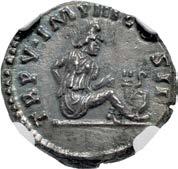
While Commodus continued and worsened the debasement of Roman silver coinage begun by his father, the gold coinage remained of high purity, weight and artistry. This beautiful aureus, struck early in his sole reign, depicts him as a young man very much in the image of his father. The historians Dio and Herodian both describe him as exceptionally handsome, a picture borne out by his coin portraits and sculpture. The reverse evokes the “Security of the Public” in an uncertain age.

152
644. Lucius Verus. AD 161-169. AR Denarius (18.5mm, 3.48 g, 2h). Rome mint. Struck AD 165. Laureate head right / Parthian captive seated right, hands bound behind his back; at feet, bow, quiver and shield. RIC III 540 (Aurelius); MIR 18, 112-14/30; RSC 273. Attractive iridescent tone. In NGC encapsulation 4936390-002, graded Ch AU, Strike: 5/5, Surface: 4/5. ($500)
645. Commodus. AD 177-192. AV Aureus (19.5mm, 7.09 g, 6h). Rome mint. Struck AD 181. M • COMMODVS ΛNTONINVS ΛVG, laureate, draped, and cuirassed bust right / SECVRITΛS PVBLICΛ TR P VI IMP IIII, COS III P P in exergue, Securitas, draped, seated right, resting head on right hand and holding transverse scepter in left. RIC III 23 var. (not cuirassed); MIR 18, 514-2/37; Calicó 2325 (same rev. die as illustration); BMCRE 54 var. (same; same rev. die); Biaggi 1011 var. (bust type); Mazzini 700 v. (same obv. die).
Ex Classical Numismatic Group inventory 902141 (August 2011).



Second and Finest Known
647.
AD 177-192. AV Aureus (20mm, 7.72 g, 12h). Rome mint. Struck AD 192. M COMM ANT P FEL AVG BRIT P P, laureate, draped, and cuirassed bust right / FIDEI CO HO R TIVM AVG, Fides standing left, holding two grain ears in right hand and vexillum in left. Cf. RIC III 199 (denarius); MIR 18 –; Calicó –; cf. G. Hirsch 303, lot 3090. Fully lustrous, minor scratch in field on obverse. EF. Extremely rare, the second known and in superior grade. ($15,000)
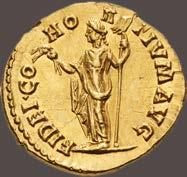
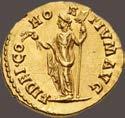
Despite his increasingly erratic rule, the Emperor Commodus enjoyed relatively good relations with the soldiery during his 15-year reign. Early on, aristocratic conspiracies against Commodus caused his complete alienation from the Roman Senate, leading him to rely heavily on the army, the 10 cohorts of Praetorian Guard in particular, to carry out his will. The two Praetorian commanders, or praefects, wielded great power in this regime, but at the same time bore the brunt of his violent mood swings and arbitrary decisions. Cleander, the most powerful of these viziers, held sway for three years before a grain shortage caused public rioting and calls for his execution, which Commodus quickly heeded. This extremely rare aureus type, issued in AD 192, thanks the Praetorian Cohorts for their loyalty to him in the aftermath of Cleander’s fall, slyly referenced by the figure of Fides (Fidelity) clutching two grain ears. The new praefect, Laetus, would soon engineer a successful conspiracy against his master, and the Praetorians would ultimately prove themselves loyal only to whomever paid them the most.


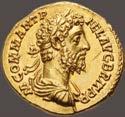
Powerful Portrait of Pertinax
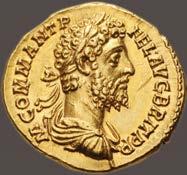
153
646. Commodus. AD 177-192. Æ Sestertius (32mm, 29.14 g, 6h). Rome mint. Struck AD 184. Laureate head right / Fides standing right, holding two stalks of grain and raising plate of fruits. RIC III 413; MIR 18, 598-6/30; Banti 478. Dark brown patina. Good VF. ($1500)
Commodus.
648. Pertinax. AD 193. Æ Sestertius (32mm, 22.85 g, 5h). Rome mint. 2nd emission. Laureate head right / Providentia, draped, standing left, right hand slightly raised toward small star, left hand on breast. RIC IV 22; Lempereur Type 10, 780 (D281/R405); Banti 20; BMCRE 28-30. Rough green patina, some smoothing in fields, lightly double struck on reverse. Good VF. Powerful portrait. ($3000)
649.
(18mm, 2.95 g, 11h). Rome mint. Struck under Didius Julianus. Draped bust right / Juno standing left, holding patera and vertical scepter; at feet to left, peacock standing left, head right. RIC IV 7a (Julianus); RSC 2. Well centered on an impressive round flan, attractive portrait, lightly toned. VF. Exceptional for issue, very rare with complete legends. ($1000)
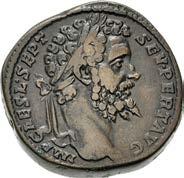
650. Didia Clara. Augusta, AD 193. AR Denarius (18mm, 2.79 g, 12h). Rome mint. Struck under Didius Julianus. Draped bust right / Hilaritas standing left, holding long palm frond in right hand and cornucopia in left. RIC IV 10 (Didius); RSC 3. Lightly toned. Near VF. Very rare. ($1000)
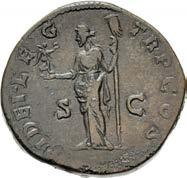

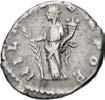


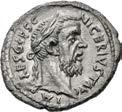
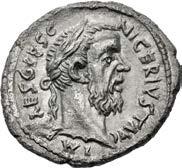

Ex Classical Numismatic Group Electronic Auction 328 (11 June 2014), lot 535; Classical Numismatic Group Electronic Auction 202 (14 January 2009), lot 334.
Superb Portrait of Niger
Published in 1931
154
Manlia Scantilla. Augusta, AD 193. AR Denarius
651. Pescennius Niger. AD 193-194. AR Denarius (19.5mm, 3.28 g, 12h). Antioch mint. Laureate head right / Salus standing right, feeding snake held in her arms; lighted altar to right. RIC IV 77; RSC 68. Lightly toned, some luster remaining, minor porosity, small area of clogged die in obverse legend. Good VF. Exceptional portrait. ($1000)
652. Septimius Severus. AD 193-211. Æ Sestertius (30mm, 28.66 g, 12h). Rome mint. Struck AD 193. Laureate head right / Fides standing left, holding Victory and vexillum. RIC IV 651; Banti 49; H.-J. Lückger, “Zum Korpus der römischen Kaisermünzen. Abweichungen und neue Stücke zu Cohen II Auflage und Mattingly & Sydenham,” in Frankfurter Münzzeitung 2/15 (March 1931), 11 (this coin). Even brown surfaces. VF. ($400)
649 650
From the Richard McAlee Collection. Ex Peus 417 (2 November 2016), lot 391; Hermann-Joseph Lückger Collection (his collection ticket included).
Dis Auspibus – The Divine Heralds
AD 193-211. AV Aureus (20mm, 7.24 g, 12h). Rome mint. Struck AD 194. L SEPT SEV PE RT AVG IMP III, laureate head right / DIS • AVSPICIB T R P • II, COS • II • P P in exergue, Hercules, naked, on left, standing left, holding club set on ground in right hand, lion skin over left arm; on right, Bacchus (or Liber), wearing wreath, naked, standing fleft, holding oenochoe in right hand and vertical thyrsus in left; between them, a panther, standing left, head right. RIC IV 31; Calicó 2446; BMCRE 63 (same rev. die); Biaggi 1069 (same obv. die); Rauch 103, lot 415 (same dies). Underlying luster, tiny die flaw on reverse. EF. ($20,000)


653.
The first Roman emperor from Africa, Septimius Severus was born in Leptis Magna, which is present day Al-Khums, Libya. Severus seized power after the death of Pertinax in AD 193. On 1 June AD 193 Didius Julianus was killed by a palace soldier. Severus fought against the rival emperor Pescennius Niger, who he defeated in AD 194 at the battle of Issus in Cilicia. The reverse of this coin depicts the gods Hercules and Bacchus, patron deities of his hometown. They are identified as “Dis Auspicibus,” the Divine Heralds, who, together figure in the rhetoric of conquest and power, mediating between the Olympian deities and humankind. Septimius Severus celebrates their intervention in his rise to the throne and the defeat of his rival claimants with this magnificent reverse type.
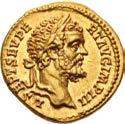

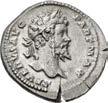
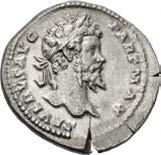


654.
AD
head of Septimius Severus right / Laureate, draped and cuirassed bust of Caracalla right. RIC IV 157; RSC 2a. In NGC encapsulation 6558570-002, graded Ch XF, Strike: 5/5, Surface: 1/5, smoothing ($600) Ex Aufhäuser 16 (16 October 2001), lot 364.
Restorer of the City
AD
AV Aureus (21mm, 7.35 g, 6h). Rome mint. Struck AD 201. SEVERVS PIVS
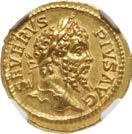


Flush with plunder from his eastern conquests and cash forcibly extracted from his political enemies, Septimius Severus engaged in a prodigious building campaign in the city of Rome, including the arch that bears his name and still survives in the Roman Forum. He also built the Septizodium, an elaborately layered colonnade that served as a public gathering place and alternate forum, which survived until demolished by Pope Sixtus V in 1588. These and other improvements were celebrated on coinage naming Severus as “Restitutor Urbis,” or “Restorer of the City,” including this aureus.
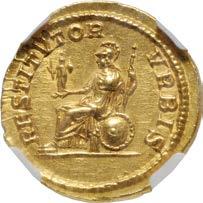
155
Septimius Severus.
Septimius Severus, with Caracalla. AS 193-211. AR Denarius (2.69 g, 6h). Dynastic issue. Rome mint. Struck
200-201. Laureate
655. Septimius Severus.
193-211.
AVG, laureate head right / RESTITVTOR VRBIS, Roma, helmeted, draped to feet, seated left on small, round shield, holding palladium on extended right hand and scepter, nearly vertical, in left, resting feet on stool. RIC IV 288; Calicó 2529a; BMCRE 358; Biaggi 1101; Jameson –; Mazzini –. In NGC encapsulation 4938386-016 graded Ch AU, Strike: 5/5, Surface: 3/5, edge scuff. ($10,000)
Celebrating the Seventh Ludi Saeculares
656. Septimius Severus. AD 193-211. Æ As (28mm, 9.44 g, 12h). Ludi Saeculares (Secular Games) issue. Rome mint. Struck under Septimius Severus and Caracalla, AD 204. Laureate, draped, and cuirassed bust right / COS/ III/ LVD/ SAEC/ FEC in five lines on column; to left, Liber standing right, holding cup and thyrsus; to right, Hercules standing left, holding club and lion skin. RIC IV 764A. Rough green-brown surfaces. VF. Very rare. ($400)
From the Richard McAlee Collection, purchased from Roberto Pedoni (with his ticket).
The Ludi Saeculares were celebrated at the close of every saeculum (a length of time corresponding to the maximum age an individual might live, usually defined as 100 or 110 years). This issue, struck in AD 204, celebrated the seventh Ludi Saeculares in Roman coinage 220 years after the Augustan celebration.

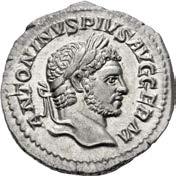
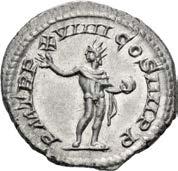

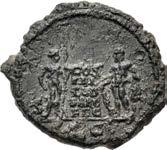
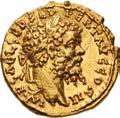
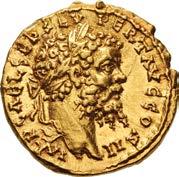
Second Known Example
657. Septimius Severus. AD 193-211. AV Aureus (19mm, 6.98 g, 11h). Emesa mint. Struck AD 194-195. IMP CΛE L SEP SEV PERT AVG COS II, laureate head right / ROMΛ ΛETERNΛ, Roma, helmeted and draped, seated left on cuirass, holding Victory on outstretched right hand and vertical spear in left; shield to right. Calicó 2534, illustrating NGSA 10 (2018), lot 56 = NAC 99 (2017), lot 21 = Triton III (1999), lot 1115 = Lanz 74 (1995), lot 591 (same rev. die); otherwise, unpublished. Lustrous, some die rust, scratch on obverse. EF. Extremely rare; the second known example. ($15,000)
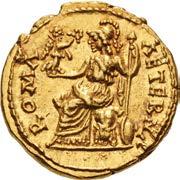
Emesa, a caravan city in north-western Syria, was the hometown of Julia Domna, wife of Septimius Severus, whose family connections to the priestly ruling caste of that city proved important to the Severan dynasty. Unlike many cities in the East, Emesa remained loyal to Severus during the destructive civil war with Pescennius Niger, who was governor of Roman Syria before being acclaimed by his soldiers as Augustus in AD 193. Severus sent his armies eastward and engaged Niger in a series of battles starting in the fall of AD 193, culminating with a decisive victory at Issus in May of AD 194. Niger was hunted down and killed. Severus and Julia Domna then undertook a triumphant tour of the eastern cities, probably arriving in Emesa in mid-194, an occasion marked by the striking of gold aurei, including this exceedingly
Ex Classical Numismatic Group inventory 846662 (May 2009).

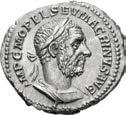
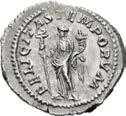
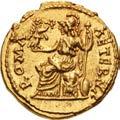
156
rare example.
658. Caracalla. AD 198-217. AR Denarius (19mm, 3.14 g, 6h). Rome mint. Struck AD 216. Laureate and bearded head right / Sol standing left, raising right hand and holding globe in left. RIC IV 281b; RSC 359. Choice EF. Well centered and struck with fresh dies. ($300)
659. Macrinus. AD 217-218. AR Denarius (20mm, 3.60 g, 12h). Rome mint, 1st officina. 2nd emission, AD 217-218. Laureate and cuirassed bust right / Felicitas standing left, holding long caduceus in right hand and cornucopia in left. RIC IV 59; Clay Issue 2; RSC 15a. Great metal with a superb portrait. EF. ($300)
660. Macrinus. AD 217-218. Æ As (25mm, 12.95 g, 12h). Rome mint. 2nd emission, AD 217-218. Laureate and cuirassed bust right, wearing long beard / Macrinus, togate, standing left in triumphal quadriga pacing left, holding branch in right hand and short scepter in left; to right, behind him, Victory standing left, crowning him. RIC IV 162; Clay Issue 2; BMCRE 134. Dark green-brown patina. Good VF. ($500)

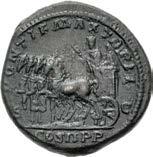
661. Diadumenian. As Caesar, AD 217-218. AR Denarius (19mm, 3.14 g, 12h). Rome mint. 3rd emission of Macrinus, AD 218. Bareheaded, draped, and cuirassed bust right / Spes advancing left, holding flower and raising hem of skirt. RIC IV 117; Clay Issue 3; RSC 21b. Lightly toned, lustrous, minor deposits. EF. ($500)
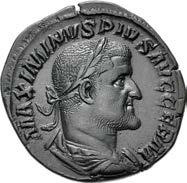
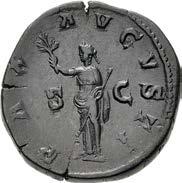
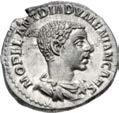
Slow Quadriga Bearing the Sacred Stone of Emesa
662. Elagabalus. AD 218-222. AR Denarius (19mm, 3.17 g, 6h). Uncertain eastern mint. Struck AD 218-219. Laureate, draped, and cuirassed bust right / Slow quadriga right, bearing the sacred stone of Emesa on which is an eagle, surrounded by four parasols. RIC IV 195; Thirion 360; RSC 268. Lustrous, rough edges. EF. ($2000)
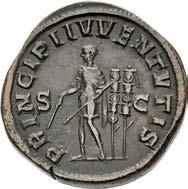
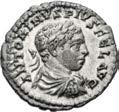
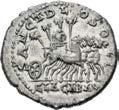
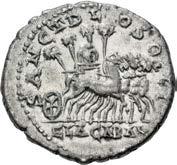
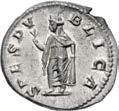
Ex Nilus Coins inventory 006-50 (ND).
At the age of fourteen, Varius Avitus Bassianus (better known as Elagabalus or Heliogabalus) inherited the office of high priest of the sun god El-Gabal at Emesa in Syria. The deity was worshipped in the form of a conical sacred stone, or baetyl, likely a large meteorite. When an unlikely coup made him emperor in June of AD 218, Elagabalus determined to take the stone with him to Rome and introduce its worship to the whole empire. During his reign, the emperor was devoted to promoting the cult of El-Gabal, building a lavish temple on the Palatine Hill to house the stone. For a brief period, the exotic eastern deity nearly came to dominate the Roman Pantheon.
This issue, struck in AD 218-219, likely refers to the journey from Emesa to Rome. The procession was repeated every year in the transfer of the stone from its principal temple in Rome to its “summer home,” a large and richly decorated temple in the suburbs. Describing the transfer, Herodian (V.6.7) writes:
A six-horse chariot bore the sun god, the horses huge and flawlessly white, with expensive gold fittings and rich ornaments. No one held the reins, and no one rode in the chariot; the vehicle was escorted as if the sun god himself were the charioteer. Heliogabalus ran backward in front of the chariot, facing the god and holding the horses’ reins. He made the whole journey in this reverse fashion, looking up into the face of his god.
663. Maximinus I. AD 235-238. Æ Sestertius (30.5mm, 19.12 g, 12h). Rome mint. 3rd emission, late AD 236-237. Laureate, draped, and cuirassed bust right / Pax standing left, holding olive branch and scepter. RIC IV 81; BMCRE 148-52; Banti 12. Even dark gray surfaces. Good VF. ($400)
From the Richard McAlee Collection. Ex Classical Numismatic Group 87 (18 May 2011), lot 1048.
664. Maximus. Caesar, AD 235/6-238. Æ Sestertius (31mm, 25.50 g, 12h). Rome mint. 3rd emission of Maximinus I, AD 236-237. Bareheaded and draped bust right / Maximus standing left, holding baton in right hand and transverse spear in left; two signa to right. RIC IV 13; BMCRE 213-7; Banti 6. Attractive brown patina, minor doubling on obverse, light smoothing in fields. VF. ($500)
From the DFA Collection.
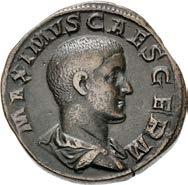
157
660 661
663
664
665. Gordian II. AD 238. Æ Sestertius (31mm, 22.19 g, 12h). Rome mint. Struck 1-22 April. Laureate, draped, and cuirassed bust right / Virtus, helmeted, in military attire, standing left, holding shield set on ground in right hand and spear in left. RIC IV 8; BMCRE 31-2; Banti 7. Dark green-brown patina, traces of deposits. VF. ($750)
Banti Plate Coin – Pedigreed to 1931
666. Balbinus. AD 238. Æ Sestertius (30.5mm, 27.30 g, 12h). Rome mint. 1st emission. IMP CAES D CAEL BALBINVS AVG, laureate, draped, and cuirassed bust right / P M TR P COS II P P, Felicitas standing left, holding caduceus in right hand and long scepter in left. RIC IV 18; BMCRE 32 note; Banti 6 (this coin). Red-brown surfaces, small flan crack, excellent portrait. Good VF. Very rare: BMCRE footnote reads “The sestertius with this rev. C. 19 (Wiczay), has not been confirmed,” and Banti records only four examples, including this coin. ($3000)

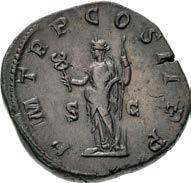
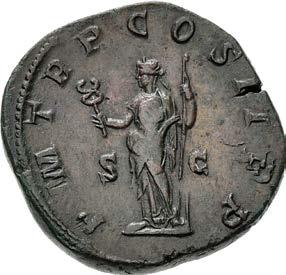
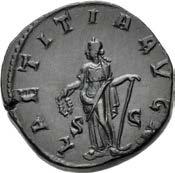
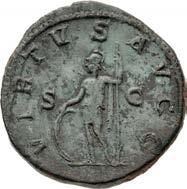

From the DMS Collection, purchased from Classical Numismatic Group, January 2006. Ex Lanz 125 (28 November 2005), lot 940; Prof Dr. Prix Collection (Helbing 63, 29 April 1931), lot 1128.
667.
AD 238-244. Æ Sestertius (29.5mm, 19.53 g, 11h). Rome mint, 3rd officina. 8th-11th emissions, late AD 240-early 243. Laureate, draped, and cuirassed bust right / Laetitia standing left, holding wreath and anchor. RIC IV 300a; Banti 38. Even dark brown surfaces. Good VF. Bold portrait. ($400)

From the Richard McAlee Collection. Ex Classical Numismatic Group 87 (18 May 2011), lot 1070.

158
Gordian III.
Extremely Rare Tranquillina Denarius – Ex Feirstein Collection

668. Tranquillina. Augusta, AD 241-244. AR Denarius (20mm, 2.99 g, 1h). Rome mint. Special emission, mid AD 243. SABINIA TRANQVILLINA AVG, draped bust right, wearing stephane / CONCORDIA AVGG, Concordia seated left on throne, holding patera in right hand and cradling double cornucopia in left arm. RIC IV 252; RSC 1a; Biaggi 2395; Hunter 1. Cabinet tone, areas of luster. EF. Attractive portrait. Extemely rare and one of the finest known. ($10,000)


Ex New York Sale XXXIV (6 January 2015), lot 649; Barry Feirstein Collection (Part 1, Numismatica Ars Classica 39, 16 May 2007), lot 153.
Furia Sabinia Tranquillina was the daughter of the formidably named Gaius Furius Sabinius Aquila Timesitheus, a highly respected career soldier of equestrian rank who rose to become Praetorian Prefect under the boy emperor Gordian III. In AD 241, Tranquillina married Gordian, making Timesitheus his father-in-law and guardian, and hopefully setting the stage for a successful dynasty. The next few years appeared to be relatively tranquil, but in early AD 243 Gordian and Timesitheus were forced into arms by an aggressive Persian attack on the eastern frontier. Under the Prefect’s guidance, the Romans won a major victory in early AD 244, but at this point Timesitheus fell suddenly ill and died, leaving the young, inexperienced Gordian without his mentor and guardian. In short order he was dead, either slain in battle or the victim of a coup led by his successor, Philip I. It is not known whether Tranquillina was present in camp or back in Rome, but we hear no more of her. While there is an abundant provincial coinage for Tranquillina, her Roman issues are exceptionally rare.
669. Philip I. AD 244-249. Æ Sestertius (28mm, 18.45 g, 12h). Rome mint, 1st officina. 4th emission, AD 245. Laureate, draped, and cuirassed bust right / Philip seated left, holding globe and parazonium. RIC IV 148a; Banti 30. Even dark brown surfaces. Good VF. ($400)
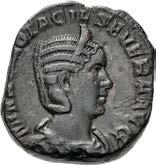


From the Richard McAlee Collection. Ex Classical Numismatic Group 87 (18 May 2011), lot 1089.
Wonderful Hippopotamus
(26mm, 19.09 g, 12h). Ludi Saeculares (Secular Games) issue, commemorating the 1000th anniversary of Rome. Rome mint, 4th officina. 9th emission of Philip I, AD 248. Draped bust right, wearing stephane / Hippopotamus standing right. RIC IV 200a (Philip I); Banti 13. Dark brown patina, minor roughness on obverse. Good VF. A wonderful Hippopotamus. ($500)
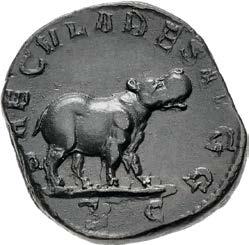
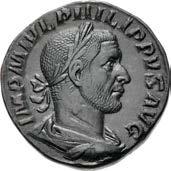
AD 244-249. Æ
Ex Classical Numismatic Group 87 (18 May 2011), lot 1104.
Continuing the tradition of Claudius and Antoninus Pius before him, the celebration of the Secular Games at the end of every century since the founding of Rome culminated during the reign of Philip I, as the city celebrated her 1,000th anniversary in AD 248. The legends on these issues almost exclusively read SAECVLARES AVGG, and feature a similar iconography from previous games, such as the she-wolf suckling the twins, the various wild beasts paraded through the amphitheater, and a cippus inscribed for the preservation of the memory of these events.
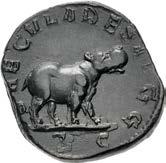
159
670. Otacilia Severa. Augusta,
Sestertius
671. Philip II. As Caesar, AD 244-247. Æ Sestertius (29mm, 20.14 g, 12h). Rome mint, 3rd officina. 4th emission of Philip I, AD 245. Bareheaded and draped bust right / Philip standing right, holding spear and globe. RIC IV 255a; Banti 10. Even dark brown surfaces. Good VF. Excellent portrait. ($400)
From the Richard McAlee Collection. Ex Classical Numismatic Group 87 (18 May 2011), lot 1107.
The Usurper Jotapian
672. Jotapian. Usurper, circa AD 248-249. Antoninianus (21mm, 4.19 g, 6h). Nicopolis in Seleucia mint. IM C M F R IOTAPIANVS A, radiate and cuirassed bust right, seen from behind / VICT OR I A AV G, Victory advancing left, holding wreath in right hand and palm frond in left. RIC IV 2a(n); Bland, Jotapian 9.10 (dies XII/ix); RSC 1a var. (obv. legend); CNG 114, lot 967 (same dies). Toned, deposits. VF. Rare. ($5000)
Jotapian († AD 249) led a short-lived revolt in Syria while Philip I was still emperor. Little is known of Jotapian’s background. It was said that he boasted of a relationship to Severus Alexander, and his unusual name, although otherwise unknown for a man, is attested in its feminine form “Jotape” in the royal houses of Commagene and Emesa. The revolt was brief, and the crude style proves that the revolt was geographically confined, for Jotapian plainly did not control a major Roman mint. His head was brought to Rome and shown to Trajan Decius “as was customary, although Decius had not asked for it” (Aur. Vict., Caes. 29.4).


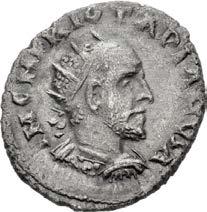


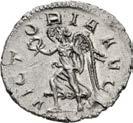
AD
From the DFA Collection.
Extremely Rare Aureus of Valerian I





160
673. Aemilian.
253. AR Antoninianus (21mm, 2.23 g, 12h). Rome mint. Radiate, draped, and cuirassed bust right / Victory advancing left, holding wreath in outstretched right hand, palm frond over left shoulder. RIC IV 11; RSC 53. Toned with areas of luster, slight porosity, small scratch and flan flaw on reverse. Good VF. ($500)
674. Valerian I. AD 253-260. AV Aureus (19.5mm, 2.91 g, 12h). Rome mint. 1st emission, AD 253-254. IMP C P LIC VALERIANVS AVG, laureate, draped, and cuirassed bust right / VICTORIA AVGG, Victory standing left, holding wreath in outstretched right hand, palm frond cradled in left arm. RIC V –; MIR 36, 30a (same dies as illustration); Calicó 3447a; Biaggi –. Light hairlines, some luster remains. Near EF. Extremely rare, only two in CoinArchives. ($5000)
Fine Portrait of Gallienus

In NGC encapsulation 6030426-005, graded MS, Strike: 4/5, Surface: 4/5. Fine late portrait of Gallienus. ($7500)
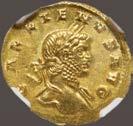
Ex Roma XXI (24 March 2021), lot 700; Roma XVIII (29 September 2019), lot 1210; Heritage 3071 (6 January 2019), lot 34115.
It is interesting that, as the economic and military crises of the third century worsened, the Romans chose different forms of debasement for their silver, bronze and gold currency to stretch their waning supply of precious metals. The traditional bronze denominations disappeared almost entirely, while the silver content of the denarius and its eventual replacement, the antoninianus, rapidly declined to less than 5%, with the remainder mainly copper. The gold coinage was kept essentially pure, rather than cut with silver as other cultures had done, but the aureus denomination declined precipitously in weight from the second century norm of 7.5 grams to less than a third of that weight at the depths of the crisis, circa AD 268. The weights of individual aurei struck during this period fluctuated so wildly that it appears they were essentially treated as bullion, with scales employed to weigh out a certain value as in pre-coinage days. This aureus, struck circa AD 266-267, weighs in at 4.04 grams, but a quick survey shows that other aurei struck from the same mint (Siscia), in the same time span, can weigh as little as 1.95 grams and as much as 4.75 grams.
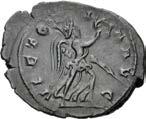
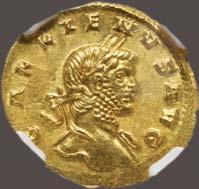
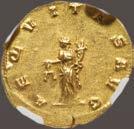

The Gallo-Roman usurper Ulpius Cornelius Laelianus was apparently a high-ranking officer under Postumus at the city of Moguntiacum (modern Mainz, Germany) on the Rhine, home base of Legio XXII Primigenia. In February or March of AD 269, his legion proclaimed him emperor in revolt against Postumus. His family name of Ulpius suggests a distant connection to the Spanish imperial line of Trajan, perhaps supported by his use of Hispania as a reverse type on one of his gold aurei. His revolt against Postumus apparently came after his soldiers repulsed a German invasion, and may have had the tacit support of the legitimate Roman Emperor Claudius II Gothicus. Postumus, however, quickly placed Moguntiacum under siege and Laelianus was soon killed by his own soldiers, but Postumus was himself slain when he refused to let his soldiers plunder the city. The turmoil led to a rapid turnover of rulers in the Gallo-Roman realm and the loss of Spain to the central Roman Empire. An unresolved mystery of his brief “reign” lasting, at most, two months, is the location of his mint: Laelianus’ rare coinage is neatly engraved and struck, with excellent portraiture, suggesting it was produced at a regular mint. Mainz, however, had no mint facilities, and if his coinage was produced at Colonia Agrippensis (Colonge) or Treveri (Trier), his revolt must have extended to those cities as well as Mainz.

161
675. Gallienus. AD 253-268. AV Aureus (20mm, 4.04 g, 12h). Siscia mint. 3rd emission, AD 266-267. GALLIENVS AVG, laureate head right / AEQVITAS AVG, Aequitas standing facing, head left, holding scales in right hand and cornucopia cradled in left arm. RIC V.1 23 var. (Rome mint, bust type); MIR 36, 1423c (same dies); Calicó 3461 var. (Rome mint, bust type). Lustrous.
676. Laelianus. Romano-Gallic Usurper, AD 269. Antoninianus (23mm, 2.64 g, 8h). Colonia Agrippinensis (Cologne) mint. Radiate and cuirassed bust right / Victory running right, holding wreath and palm frond. RIC V 9; CGE 532; Gilljam 106A (dies XXX/16); AGK 1c. Glossy brown patina. Near EF. Struck on a broad flan. Rare and exceptional for issue. ($750)
Zenobia – Published by Bland
holding patera in right hand and scepter in left; at feet to left, peacock standing left, head right; star to left; H. RIC V Online 3129 (this coin referenced); Cf. RIC V 2; Bland, Coinage 30h (dies 50/v – this coin); BN pl. 86, 289 = Leu 48, lot 408 (same dies); MIR 47, 360b (same dies). Rough surfaces, smoothed. VF. Extremely rare. Not suitable for encapsulation. ($5000)




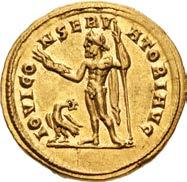
From the Conti Collection. Ex Ronald J. Hansen Collection (Classical Numismatic Group 94, 18 September 2013), lot 1082; Noble 91 (21 July 2009), lot 3741; Gordon S. Parry Collection (Classical Numismatic Group 79, 17 September 2008), lot 1202; Aufhäuser 10 (5 October 1993), lot 577.
The widow of Odenathus, the ruler of the rich eastern trade center Palmyra, and the mother and regent of Vaballathus, Septimia Zenobia became a powerful regional ruler in her own right. Granted de facto power in the East by the emperor Gallienus to counteract the Persian advance, Odenathus used the opportunity to establish his own separatist kingdom. When Odenathus was murdered in AD 267, Zenobia used the moment to advance her son Vaballathus. Since he was still in his minority, Zenobia took over as regent, using the confusion following the death of Gallienus to offset her position between Rome and Persia and expand Palmyrene power. In AD 269 the Palmyrenes seized control of Egypt and with it, the Roman grain supply. To bolster her position, Zenobia began to lay claims to an illustrious ancestry, including Cleopatra VII of Egypt and the legendary Dido of Carthage.
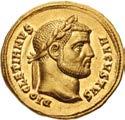
Aurelian, initially taken with concerns in the west, pragmatically acquiesced to Zenobia and Vaballathus’ rule in the East. Eventually, though, the situation was stabilized in the West, allowing him to vigorously campaign against them in AD 272. Palmyra was sacked, and both Zenobia and Vaballathus were captured as they tried to make their way to Persia. She was brought to Rome and paraded in Aurelian’s triumph in AD 274, bound in gold chains. According to later tradition, Aurelian, impressed by her beauty and dignity, later freed her, and granted her a villa in Tibur, where she spent the rest of her life.
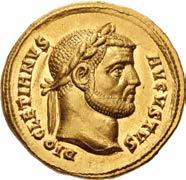
678. Diocletian. AD 284-305. AV Aureus (20mm, 6.51 g, 1h). Cyzicus mint. Struck AD 284-286. DIOCLETIANVS AVGVSTVS, laureate head right / IOVI CO NSERV ATORI AVG, Jupiter Optimus Maximus standing left, holding thunderbolt in right hand and scepter in left; to left at feet, eagle standing left, head and tail right, with wings displayed, holding wreath in beak. RIC VI 298; Depeyrot 14/1; Calicó 4514 . Lustrous. In NGC encapsulation 6559106-005, graded Ch AU, Strike: 5/5, Surface: 5/5. High relief, and perfectly centered. Extremely rare, such that Calicó only has a line drawing of this issue. ($10,000)
From the Willamette Valley Collection. Ex Monaco Collection (Heritage 3094, 19 August 2021), lot 32075; Roma XXI (24 March 2021), lot 717.
Diocletian’s tetrarchy (’rule of four’) was devised to replace the unstable system of family dynasties which was greatly responsible for the military chaos of the previous century. Central to this system was the founding of two imperial houses, each with an Augustus and Caesar, which would oversee respective portions of the empire. Diocletian modeled the imperial houses upon the Romans’ religious pantheon. As the senior Augustus and Caesar, Diocletian and Galerius comprised the ‘Jovian’ house, and thus enjoyed the protection of Jupiter, the chief deity of the Roman pantheon. This aureus of Diocletian thus depicts Jupiter, Protector of the Augustus. Maximianus and Constantius were the members of the ‘Herculian’ house, and had the protection of Hercules, who was the right-hand lieutenant to Jupiter.
162
677. Zenobia. Usurper, AD 268-272. Antoninianus (20mm, 3.55 g, 6h). Antioch mint, 8th officina. 2nd emission, MarchMay AD 272. [S] ZЄNOBIA AVG, draped bust right, wearing stephane, set on crescent / IVNO RЄGINA, Juno standing left,
Impressive Bronze Medallion
679. Maximianus. First reign, AD 286-305. Æ Medallion (40mm, 46.96 g, 1h). Rome mint. Struck AD 297-298. VIRTVS MAXIMIANI AVG, laureate and cuirassed half-length bust left, breastplate adorned with Medusa’s head facing. He holds the horse by the bridle and carries a shield, on which the she-wolf left, head right, nurses Romulus and Remus / MONETA AVGG, the Tres Monetae standing left, each holding scale over pile of coins in right hand, cornucopia in left. Gnecchi II p. 129, 18, pl. 127, 6. Dark green-brown patina, scratches. VF. Rare with this fascinating bust type. ($7500)

From the D.K. Collection. Ex Rauch 82 (23 April 2008), lot 591 (hammer €12,000).
The Tres Monetae, female personifications of the metals of gold, silver, and bronze used to strike coins, regularly appear on Imperial medallions during the economic crisis of the second half of the third century and reflect the efforts of a series of emperors to revive the economy through monetary reform. By the time of the Tetrarchy, massive inflation had crippled the economy and Diocletian implemented dramatic economic reforms, which included the introduction of the silver argenteus and bronze follis in AD 294/5.

680. Maximianus. First reign, AD 286-305. AR Argenteus (17mm, 3.17 g, 12h). Nicomedia mint, 3rd officina. 1st emission, late AD 295-296. Laureate head right / The four tetrarchs sacrificing over tripod before city enclosure with six turrets; SMNΓ. RIC VI 19b; Gautier, Argent 2; RSC 552b. Deeply toned, flan crack. Near EF. ($400)
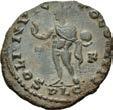
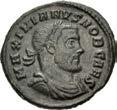
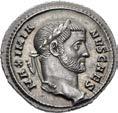


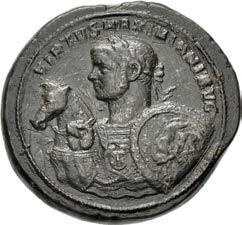
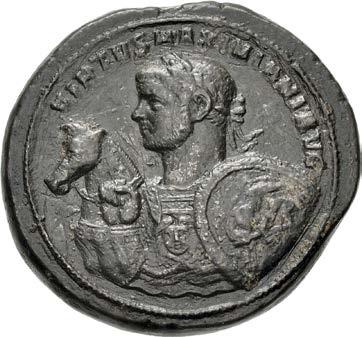
681. Galerius. As Caesar, AD 293-305. AR Argenteus (19mm, 2.92 g, 12h). Rome mint. 1st unmarked emission, late AD 294-early 295. Laureate head right / The four tetrarchs sacrificing over tripod before city enclosure with six turrets. RIC VI 29b; Gautier, Argent 58; RSC 219a. Beautifully toned with iridescence, lustrous. Choice EF. Perfectly centered on a broad flan. ($750)
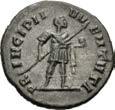

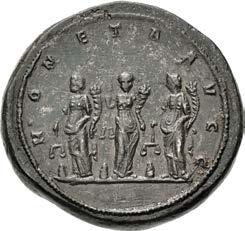
163
682. Galerius. As Caesar, AD 293-305. Denarius (18mm, 2.48 g, 12h). Rome mint. Struck AD 293-294. Laureate, draped, and cuirassed bust right / Prince standing right, holding spear and globe. RIC V 708 var. (bust type). Partial silvering toned gray and green. Near EF. ($500)
680 681 682 683
683. Constantine I. AD 307/310-337. Æ Follis (17.5mm, 1.26 g, 5h). Lugdunum (Lyon) mint. Struck AD 315. Laureate bust left, wearing trabea, holding Victory on globe / Sol standing left, raising hand and holding globe; T|F//PLG. RIC VII –; Lyon 554. Green patina with some earthen deposits. Near EF. Extremely rare bust type. ($300)
684.
AV Solidus (19.5mm, 4.44 g, 12h). Sirmium mint. Struck AD 320. CONSTANT INVS P F AVG, laureate head right / VICTORIB AVGG ET CAESS NN, Victory seated right on cuirass, holding shield inscribed VOT/ XX in two lines; to right, trophy and captive seated right, looking left, raising left hand to head; SIRM. RIC VII 10; Alföldi 631; Depeyrot 2/7; Biaggi 2026. Light marks. Near EF. Very rare. Only two other examples in CoinArchives. ($5000)
Ex Dr. Albrecht Ullrich Collection (Künker 365, 4 April 2022), lot 5435; Giessener Münzhandlung 50 (24 September 1990), lot 704; Peus 271 (25 November 1969), lot 409.
Superb Constantine Solidus

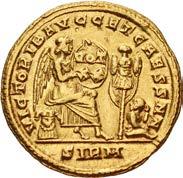
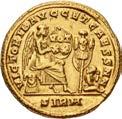
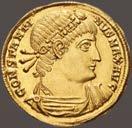


685.
AV Solidus (21mm, 4.45 g, 6h). Tricennalia issue. Nicomedia mint, 2nd officina. Struck AD 335. CONSTANTI NVS MAX AVG, rosette-diademed, draped, and cuirassed bust right / VICTORIA CONSTANTINI AVG, Victory, draped from her waist, seated right on shield and cuirass, holding shield with left hand, inscribing VOT/XXX in two lines with stylis held in her right hand; to right, Genius standing left, supporting shield with both hands. RIC VII 178; Alföldi 616; Depeyrot 44/2; Biaggi 2017 var. (officina); Jameson –; Mazzini 615/a var. (same). Lustrous. In NGC encapsulation 6559106-001, graded MS, Strike: 5/5, Surface: 3/5, light marks. Exceptional strike from fresh dies. ($10,000)
From the Willamette Valley Collection. Ex Classical Numismatic Group 112 (11 September 2019), lot 661; Dipl.-Ing. Christian Gollnow [“Friend of the Romans”] Collection (Münzen und Medaillen AG 92, 22 November 2002), lot 304; Münzen und Medaillen AG FPL 573 (March 1994), no. 53; Münzen & Medaillen AG FPL 566 (June 1993), no. 35; Numismatic Fine Arts XXIX (13 August 1992), lot 438.
Constantine I “the Great” was one of only three Roman Emperors to ever celebrate a Tricennalia marking 30 years of rule, an event celebrated by the issuance of this gold solidus type from the mint of Nicomedia in AD 335. Constantine had completely revolutionized the Roman world during his long and eventful reign, reunifying the empire after decades of internal division, moving the imperial capital to his own city Constantinople (the renamed Byzantium), and, most importantly, changing Christianity from a small, persecuted sect to the most favored religion of a huge multinational state. Even the visual iconography of coinage saw radical change: here Constantine adopts an elaborate jeweled diadem in place of the former simple wreath worn by Roman rulers, and his long, carefully arranged hair presages the coiffeurs of medieval kings to come. However, Constantine was at pains to show some adherence to Roman tradition: the figure of Victory accompanied by a small winged Genius on the reverse does show continuity with the pagan past.

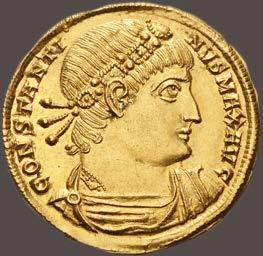
164
Constantine I. AD 307/310-337.
Constantine I. AD 307/310-337.
Very Rare Constantine II Solidus – Ex Dimitriadis, Dreesman, and Biaggi Collections


686. Constantine II. AD 337-340. AV Solidus (21mm, 4.46 g, 5h). Antioch mint. CONSTAN TINVS AVG, laureate, draped, and cuirassed bust right / VICTO RIA AVG, Victory advancing left, holding grounded trophy and palm frond; *|LXXII//SMAN•. RIC VIII 3; Depeyrot 1/1; Biaggi 2007 (this coin). Underlying luster. In NGC encapsulation 6559106-002, graded AU★, Strike: 5/5, Surface: 4/5. Very rare. ($4000)
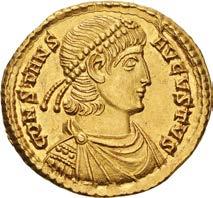
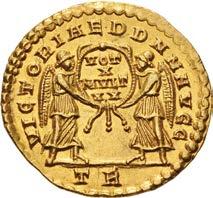


From the Willamette Valley Collection. Ex Heritage 3085 (5 August 2020), lot 30058; Dimitriadis Collection (Heritage 3032, 10 April 2014), lot 23659; Dreesmann Collection (Part I, Spink, 13 April 2000), lot 157; Ceresio [I] (26 September 1987), lot 339; Leo Biaggi de Blasys (1906-1979) Collection.
The LXXII in the right field indicates that 72 solidi were struck from a pound of gold, one of the few times a statement of value can be found on Roman gold coinage.

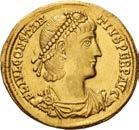
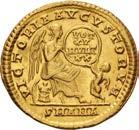
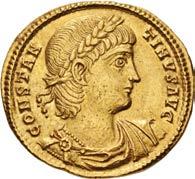
Flavius Claudius Constantinus, second son of Constantine I the Great, was about one year old when he was first proclaimed Caesar in AD 316, along with his adolescent half-brother, Crispus. The younger Constantine was one of three sons from his father’s marriage to Fausta, whose intrigues on behalf of her boys eventually led to the execution of Crispus in AD 326, followed by her own death a few months later. Thus at the age of 10, Constantine II found himself both motherless and senior heir to the Roman Empire. His brothers Constans and Constantius II were soon also raised to the rank of Caesar, though as eldest Constantine retained preeminence. He underwent years of military and governmental training, primarily at the Western provincial capital of Trier on the German frontier, accompanying his father on several campaigns. In AD 335, the elder Constantine redrafted the succession, bringing in two nephews to create an unwieldy five-way split of the empire. But when Constantine died in AD 337, the three brothers arranged for the execution of the nephews and divided the empire between them. Despite his seniority, Constantine II emerged with only Britain, Gaul, Germany and Spain under under his control, perhaps the poorest and least populous regions of the Empire. Incensed at this treatment, Constantine insisted on his own seniority and demanded more territory from his brothers, leading Constans and Constantius to form an alliance against him. A three-way conference in June of AD 338 failed to resolve their differences. In April of AD 340, Constantine launched an invasion of Italy while Constans was away in the Balkans. Expecting little or no resistance, Constantine must have been shocked when his army was ambushed by a strong force near Aquileia. During the skirmish, a chance arrow struck Constantine, killing the 24-year-old emperor. Constans’ soldiers threw his body into a nearby river, but it was later retrieved and given an honorable burial. Due to the brevity of his reign, his gold coinage is much rarer than that of his namesake father or his more successful brothers.
From the Willamette Valley Collection. Ex Classical Numismatic Group inventory 510902 (August 2019); Dr. Klaus Berthold Collection (Künker 318, 11 March 2019), lot 1940; Tkalec (24 October 2003), lot 421.
165
687. Constans. AD 337-350. AV Solidus (23mm, 4.64 g, 6h). Decennalia issue. Treveri (Trier) mint. Struck AD 347-348. CONSTANS AVGVSTVS, pearl-diademed, draped, and cuirassed bust right / VICTORIAE DD NN AVGG, two Victories standing facing one another, holding wreath inscribed VOT/ X/ MVLT/ XX between them; TR. RIC VIII 135; Depeyrot 6/3; Biaggi 2123. Fully lustrous. In NGC encapsulation 6559106-003, graded Ch AU, Strike: 5/5, Surface: 4/5. Perfectly centered on a broad, round flan. ($4000)
688. Constantius II. AD 337-361. AV Solidus (22mm, 4.45 g, 6h). Antioch mint, 1st officina. Struck AD 337-347. Pearldiademed, draped, and cuirassed bust right / Victory seated right on cuirass, holding shield inscribed VOT/ XV/ MVLT/ XX in four lines; shield also supported by small Genius; shield set on ground behind Victory; SMANA. RIC VIII 25; Depeyrot 5/3. Areas of luster. EF. ($1500)
Exceptional Jovian Solidus – Pedigreed to 1929

689. Jovian. AD 363-364. AV Solidus (21mm, 4.46 g, 12h). Antioch mint, 7th officina. D N IOVIAN VS P F AVG, pearl-diademed, draped, and cuirassed bust right / SECVRITA S REI PVBLICAE, Roma, holding spear in left hand, and Constantinopolis, with right foot on prow and holding scepter in left hand, enthroned facing, the latter turned to left, holding between them a shield inscribed VOT/ V/ MVL/ X in four lines; ANTZ. RIC VIII 222; Depeyrot 18/1; Biaggi 2225 var. (officina); Mazzini 8 var. (same). Lustrous. In NGC encapsulation 6559106-006, graded Ch AU, Strike: 5/5, Surface: 3/5. Rare and exceptional for issue. ($7500)

From the Willamette Valley Collection. Ex Provence Collection (Classical Numismatic Group 114, 13 May 2020), lot 1017; Rauch 102 (7 November 2016), lot 564; Künker 273 (14 March 2016), lot 957; Hess-Divo 326 (28 May 2014), lot 120; Numismatica Ars Classica 75 (18 November 2013), lot 345; Classical Numismatic Review XXI.2 (Fall 1996), no. 65; Vinchon (24 April 1996), lot 117; Hermann Vogel Collection (A. Hess 194, 25 March 1929), lot 964.
690. Valentinian I. AD 364-375. AV Solidus (21mm, 4.50 g, 12h). Treveri (Trier) mint, 3rd officina. Struck mid AD 373-April 375. Rosette-diademed, draped, and cuirassed bust right / Valentinian and Valens enthroned facing, each with right hand on a globe between them; above, Victory facing with wings spread; palm between; TROBT. RIC IX 17b.6; Depeyrot 43/1; Biaggi 2237. Lustrous, hairlines and minor deposits, small die flaw on reverse. Choice EF. ($1000)
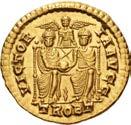

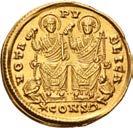
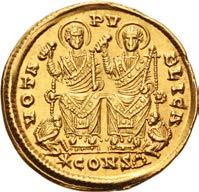

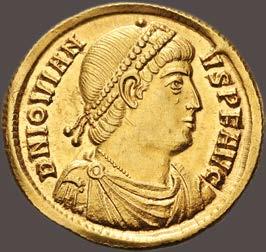
Ex Classical Numismatic Group inventory 152526 (April 2004).

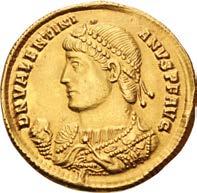
Attractive Consular Solidus
691. Valentinian I. AD 364-375. AV Solidus (21mm, 4.45 g, 6h). Constantinople mint. Struck January AD 368. D N VALENTINI ANVS P F AVG, consular bust left, wearing pearl-diadem and imperial mantle, holding mappa and scepter / VOTA PV BLICA, Valentinian I and Valens enthroned facing, both nimbate, each holding a mappa and scepter; bound captive to left and right; *CONS ե . RIC IX 29a; Depeyrot 22/1; DOCLR 190; Biaggi 2244; Mazzini 68. Lustrous. In NGC encapsulation 6559106-008, graded AU, Strike: 5/5, Surface: 3/5. Exceptional. ($5000)
From the Willamette Valley Collection. Ex Peter J. Merani Collection (Triton XXIV, 19 January 2021), lot 194; Mark Poncin Collection (Triton X, 8 January 2007), lot 801; William H. Williams Collection (Triton VI, 14 January 2003), lot 1111; Numismatic Fine Arts XXII (1 June 1989), lot 150.
166
Extremely Rare 1 1/2 Scripulum
692. Valens. AD 364-378. AV 1 1/2 Scripulum (13mm, 1.67 g, 12h). Treveri (Trier) mint. Struck March-April AD 369. Rosette-diademed, draped, and cuirassed bust right / Victory advancing left, holding wreath in raised right hand and cradling palm in left arm; TROB. RIC IX 21c; Depeyrot 32/4; Hunter –; DOC –; Biaggi –. Lustrous. Good VF. Extremely rare, only two in CoinArchives. ($1500)
Ex Triton VIII (11 January 2005), lot 1263.
The 1 1/2 scripulum was equal to nine siliquae or 3/8 of a solidus. This denomination was struck in very small numbers, likely for ceremonial use. It was abandoned in the 380’s, replaced by the tremissis.
Choice Valens Solidus
693. Valens. AD 364-378. AV Solidus (21mm, 4.44 g, 5h). Antioch mint, 5th officina. Struck late AD 366-367. D N VALENS PER F AVG, pearl-diademed, draped, and cuirassed bust right / RESTITVTOR REIPVBLICAE, Valens standing right, holding labarum with cross on banner and Victory on globe; cross to left; *ANTЄ*. RIC IX 2d.xxxvii.5; Depeyrot 27/3; Biaggi 2255. Underlying luster. In NGC encapsulation 6559106-007, graded MS, Strike: 5/5, Surface: 4/5. Well centered. Sharply struck and attractive. ($4000)
From the Willamette Valley Collection. Ex Roma E-Sale 92 (16 December 2021), lot 1083 (hammer £4800).


694. Procopius. Usurper, AD 365-366. Æ (19mm, 3.31 g, 6h). Constantinople mint, 2nd officina. Pearl-diademed, draped, and cuirassed bust left / Procopius standing facing, head right, holding labarum and shield set on ground; unidentified object at feet to left, Christogram to upper right; CONSB•. RIC IX 17a.4; LRBC 2082. Dark brown patina, minor deposits, light scrape on reverse. VF. ($500)


From the DFA Collection. Ex G. Hirsch 280 (9 February 2012), lot 4869. MS★
– Ex Bastien & Platt Hall Collections
695. Gratian. AD 367-383. AV Solidus (21mm, 4.55 g, 5h). Thessalonica mint. Struck AD 378-383. D N GRATIA NVS P F AVG, pearl-diademed, draped, and cuirassed bust right / VICTOR IA AVGG, Gratian and Valentinian enthroned facing, each with right hand on globe between them; above, Victory facing with wings spread; palm fond between legs; TESOB. RIC IX 34a; Depeyrot 34/1; Biaggi –. Lustrous. In NGC encapsulation 6559106-009, graded MS★, Strike: 5/5, Surface: 4/5. ($4000)



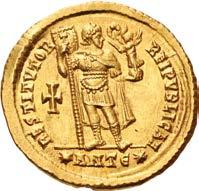
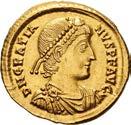
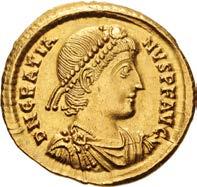

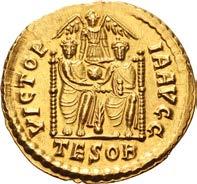
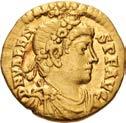
From the Willamette Valley Collection. Ex Edward J. Waddell inventory 54487 (April 2021); Pierre Bastien Collection (Numismatica Ars Classica 111, 24 September 2018), lot 261; Henry Platt Hall Collection (Part II, Glendining, 16 November 1950), lot 2072.

167
5/5 4/5
696. Arcadius. AD 383-408. AV Solidus (21mm, 4.46 g, 6h). Mediolanum (Milan) mint. Struck AD 397-402. Pearldiademed, draped, and cuirassed bust right / Arcadius standing right, holding labarum in right hand and Victory on globe in left, right foot on captive below; M|D//COMOB. RIC IX 35b and RIC X 1205b; Toffanin 500/2; Depeyrot 16/1; DOCLR 265; Biaggi –. Some luster, light die rust. EF. ($1500)

Ex Numismatica Ars Classica Spring Sale 2020 (25 May 2020), lot 1263; Marti Hervera 1083 (16 October 2014), lot 235.

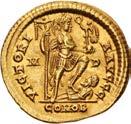

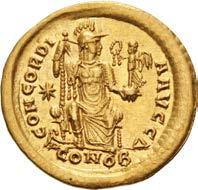

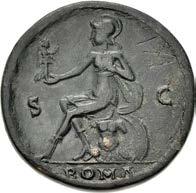
697. Honorius. AD 393-423. AV Solidus (20.5mm, 4.44 g, 6h). Constantinople mint, 9th officina. Struck AD 397-402. Pearl-diademed, helmeted, and cuirassed bust facing slightly right, holding spear over shoulder and shield / Constantinopolis enthroned facing, head right, foot on prow, holding scepter and Victory on globe; Θ//CONOB. RIC X 8; Depeyrot 55/2. In NGC encapsulation 2490351-005, graded MS, Strike: 5/5, Surface: 4/5. ($750)
Ex Stack’s Bowers Galleries (14 May 2018), lot 70118.
698. Honorius. AD 393-423. AV Solidus (21mm, 4.47 g, 6h). Constantinople mint, 4th officina. Struck AD 408-420. Pearl-diademed, helmeted, and cuirassed bust facing slightly right, holding spear and shield / Constantinopolis seated facing, head right, right foot on prow, holding scepter and Victory on globe; star to left; Δ//CONOB. RIC X 201; Depeyrot 73/1; Biaggi –. Underlying luster. EF. ($750)
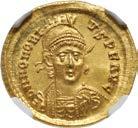
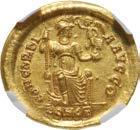

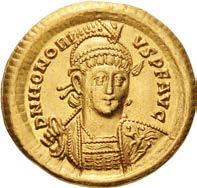
699. Contorniates. Late 4th century AD. Æ (32.5mm, 21.99 g, 12h). In the name of Nero. NERO CLAVD CAESAR AVG GER P M TR P IMP P P, laureate head left; uncertain monogram incised to left / ROMA in exergue, S C across field, Roma seated left on cuirass, right foot on helmet, holding Victory and parazonium; shield behind; IXI incised to right. Alföldi, Kontorniat 129; Tocci –; Sachero –. Dark green patina, scratch in field on obverse. VF. Exceptional style, likely copied directly from an original sestertius of Nero. ($1000)
Ex Triton XIV (3 January 2011), lot 869.
700. Johannes. Usurper, AD 423-425. Æ (13mm, 1.04 g, 12h). Rome mint, uncertain officina. Pearl-diademed, draped, and cuirassed bust right / Victory advancing left, holding trophy over shoulder and dragging captive; staurogram to left; [...]. Cf. RIC X 1913, 1920, 1923; Ulrich-Bansa 7a; cf. LRBC 837-838. Dark brown patina, area of weak strike. VF. Rare. Unusually strong portrait and clear legends for this typically crude issue. ($500)
From the DFA Collection.

168
696 697
701. Valentinian III. AD 425-455. AV Semissis (17mm, 2.15 g, 7h). Decennalia issue. Rome mint. Struck circa AD 435-6. Rosette-diademed, draped, and cuirassed bust right / Victory seated right on cuirass, holding wreath inscribed VOT/ X/ MVLT/ XX in four lines set on low column; wreath supported from underneath by Genius standing left; R|M//COMOB. RIC X 2048 (same rev. die); Depeyrot 42/2; Lacam pl. 2, 30; Hunter 3; DOCLR –; Biaggi –. Some luster, slight die rust. Good VF. Very rare. ($1500)
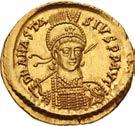



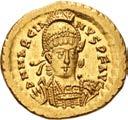
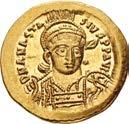
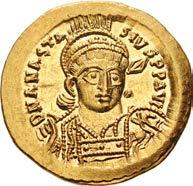
Ex Triton VIII (11 January 2005), lot 1281; Peus 378 (28 April 2004), lot 983; Gorny & Mosch 121 (10 March 2003), lot 531.
702. Marcian. AD 450-457. AV Solidus (21mm, 4.50 g, 6h). Constantinople mint, 7th officina. Struck AD 450. Pearldiademed, helmeted, and cuirassed bust facing slightly right, holding spear and shield / Victory standing left, holding long, jeweled cross in right hand; star to right; Z//CONOB. RIC X 510; DOCLR 481; Depeyrot 87/1; Biaggi –. Lustrous, slight hairlines. Choice EF. Well centered and struck. ($750)
Ex Harlan J. Berk inventory cc91670 (ND).
BYZANTINE COINAGE

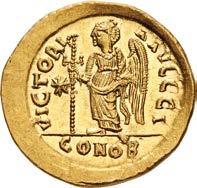
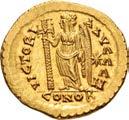

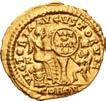
703. Anastasius I. 491-518. AV Tremissis (15mm, 1.50 g, 6h). Constantinople mint. Struck 491-492(?). Diademed, draped, and cuirassed bust right / Victory advancing right, head left, holding wreath and globus cruciger; star to right; CONOB. DOC 10b; MIBE 11; SB 8. Lustrous. Superb EF. Virtually as struck. ($400)
From the Gasvoda Collection. Ex Leu Numismatik 7 (24 October 2020), lot 1935.
704. Anastasius I. 491-518. AV Solidus (21mm, 4.47 g, 6h). Constantinople mint, 3rd officina. Struck 492-507. Helmeted and cuirassed bust facing slightly right, holding spear over shoulder, shield on left shoulder / Victory standing left, holding long jeweled cross; star to right; Γ//CONOB. DOC 3c; MIBE 4a; SB 3. Lustrous. In NGC encapsulation 6558566-009, graded MS, Strike: 5/5, Surface: 2/5, brushed, edge crimp. ($750)
From the Gasvoda Collection. Ex Roma E-Sale 68 (27 February 2020), lot 1300.
Ch MS 5/5 5/5 Solidus
705. Anastasius I. 491-518. AV Solidus (21mm, 4.48 g, 6h). Constantinople mint, 10th officina. Struck 498-518. D N ANASTA SIVS PP AVC, helmeted and cuirassed bust facing slightly right, holding spear over shoulder and shield decorated with horseman motif / VICTORI AAVCCC, Victory standing left, holding staff surmounted by reversed staurogram; star to left; I//CONOB. DOC 7j; MIBE 7; SB 5. Fully lustrous. In NGC encapsulation 6559106-010, graded Ch MS, Strike: 5/5, Surface: 5/5. Sharply struck on a broad flan. ($1000)
From the Willamette Valley Collection. Ex Roma XIX (26 March 2020), lot 989; Leu Numismatik AG 4 (25 May 2019), lot 837.
169
701 702
703 704
706. Anastasius I. 491-518. AV Solidus (20.5mm, 4.47 g, 7h). Constantinople mint, 5th officina. Struck 507-518. Helmeted and cuirassed bust facing slightly right, holding spear over shoulder, shield on left shoulder / Victory standing left, holding staff surmounted by reversed staurogram; star to left; Є//CONOB. DOC 7e; MIBE 7; SB 5. In NGC encapsulation
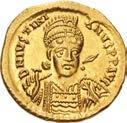
6558569-010, graded MS, Strike: 5/5, Surface: 4/5. ($750)
From the Gasvoda Collection. Ex Roma E-Sale 69 (16 April 2020), lot 1283.
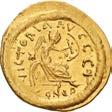


707. Justin I. 518-527. AV Solidus (20mm, 4.49 g, 7h). Constantinople mint, 10th officina. Struck 518-522. Helmeted and cuirassed bust facing slightly right, holding spear over shoulder, shield on left shoulder / Victory standing left, holding long staff surmounted by reversed staurogram; star to left; I//CONOB. DOC 1h; MIBE 2; SB 55. Lustrous. In NGC encapsulation
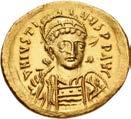
6558566-008, graded MS, Strike: 5/5, Surface: 2/5, brushed, slight bend. ($1500)
From the Gasvoda Collection. Ex Triton XX (9 January 2017), lot 979; Golden Horn Collection (Stack’s, 12 January 2009), lot 2346; Jürgen K. Schmidt Collection (Triton V, 15 January 2002), lot 2261.
708. Justinian I. 527-565. AV Solidus (19.5mm, 4.47 g, 6h). Constantinople mint, 4th officina. Struck 527-537. Helmeted and cuirassed bust facing slightly right, holding spear over shoulder, shield on left shoulder / Angel standing facing, holding long cross and globus cruciger; star to right; Δ//CONOB. DOC 3d; MIBE 5; SB 137. Lustrous. In NGC encapsulation
6558566-006, graded MS, Strike: 5/5, Surface: 4/5. ($500)
From the Gasvoda Collection, purchased from Sovereign Rarities, January 2020.
709. Justinian I. 527-565. AV Solidus (21mm, 4.42 g, 6h). Constantinople mint, uncertain officina. Struck 527-537. Helmeted and cuirassed bust facing slightly right, holding spear over shoulder, shield on left shoulder / Angel standing facing, holding long cross and globus cruciger; star to right; [...]//CONOB. DOC 3; MIBE 5; SB 137. In NGC encapsulation 43755330-006, graded MS, Strike: 4/5, Surface: 3/5, clipped. ($750)
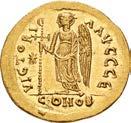
710. Justinian I. 527-565. AV Semissis (17.5mm, 2.18 g, 6h). Constantinople mint. Struck 527-552. Diademed, draped, and cuirassed bust right / Victory seated right, inscribing shield set on knee; star to left, staurogram to lower right; CONOB. DOC 17; MIBE 17; SB 143. Lustrous. In NGC encapsulation 6558566-007, graded MS, Strike: 5/5, Surface: 4/5, clipped. ($400)
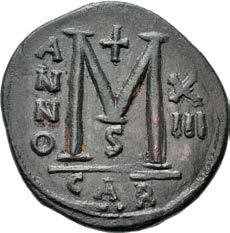

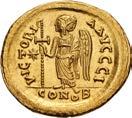
From the Gasvoda Collection. Ex Künker 326 (7 October 2019), lot 1769.
711. Justinian I. 527-565. Æ Follis (37mm, 23.36 g, 7h). Carthage mint, 6th officina. Dated RY 13 (539/40). Helmeted and cuirassed bust facing, holding globus cruciger and shield, decorated with soldier on horseback motif, on left shoulder; cross to right / Large M; cross above; A/N/N/O - X/III (date) across field; S//CAR. DOC 292a; MIBE 195; SB 261. Attractive dark green and red-brown patina, some minor smoothing marks. EF. Exceptional for issue. ($750)
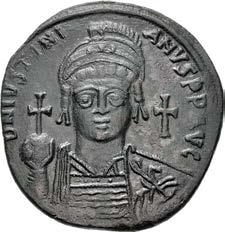
From the Gasvoda Collection. Ex Jack A. Frazer Collection (Triton XXIII, 14 January 2020), lot 912; Classical Numismatic Group inventory 151319 (December 2003).
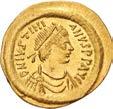
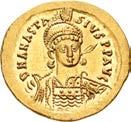
170
706 707 708 709
710 711
712 713
712. Justinian I. 527-565. AV Solidus (21mm, 4.37 g, 6h). Rome mint. Struck 537-542. Helmeted and cuirassed bust facing, holding globus cruciger and shield, decorated with soldier on horseback motif, on left shoulder / Angel standing facing, holding long cross and globus cruciger; star to right; CONOB. DOC 318a; MIBE 31; SB 288. Lustrous, lightly clipped, usual minor doubling on obverse, some minor marks, hairlines. Near EF. Very rare. Only approximately 10-15 examples known. ($1000)
713. Justinian I. 527-565. Æ Half Follis (21.5mm, 8.66 g, 6h). Rome mint. Struck 537-539. Diademed, draped, and cuirassed bust right / Large K; cross to left, star to right; all within wreath. DOC 325b; MIBE 223; SB 303. Attractive dark olive patina. EF. Among the finest known for issue. ($600)

From the Gasvoda Collection. Ex Artemide LII (26 October 2019), lot 436.
714. Anonymous. temp. Justinian I, circa 530. AR Third Siliqua or Scripulum(?) (13.5mm, 0.86 g, 7h). Constantinople mint. Helmeted, draped, and cuirassed bust of Constantinopolis right / Large K. Bendall, Anonymous 8b; Vagi 3051. Lightly toned, some slight porosity. Good VF. ($400)
From the DFA Collection.
The introduction of this type probably occurred in 530, on the bicentennial of the founding of Constantinople, but the large output and scant hoard evidence would seem to suggest a much longer period of mintage, perhaps lasting decades. Bendall proposes (p. 151):
If we consider that type 8 was originally struck to commemorate the bicentennial of the foundation of Constantinople, what reasons might there be for the continued striking for so long? Was it struck in large quantities at intervals, perhaps every succeeding tenth anniversary of Constantinople, or was it struck more frequently in smaller quantities? This is probably an unanswerable question but I have one suggestion. Consuls distributed coins to the populace at the consular games, the emperors in gold and non-imperial consuls in silver. Originally the consulship had been a great honour since the consuls named the year. However, by the early sixth century, consulships were not held every year and the cost of the games [became] so expensive that in the east, where the senators were not as wealthy as the old families in the west, the emperor defrayed part of the costs. Justinian I held his last consulship in 540 and the last private consulship was held the following year. It is possibly not a coincidence that, since the consulship was no longer annual, thus making its use in annual dating prone to error, its demise basically coincided with the commencement of dating official documents by regnal year from 538. A further reason for the demise of the consulship was that Justinian possibly no longer wished to subsidize the games at a time when he needed every penny to pay for his reconquest of Africa and Italy.

The consulship was not held again until Justin II took it in 566. It was held thereafter at regular intervals and only by the emperors; Tiberius Constantine in 579, Maurice for six days at the end of 583 and from July to November 602, while Phocas took the consulship in December 603, which was the last occasion which it was held. The taking of the consulship by Justin II in 566 was well received by the populace of Constantinople, but they could hardly have been starved for entertainment during the previous 25 years. In fact, the founding of the city had always been celebrated and it may well be that this now took on a more important part in the entertainment of the citizens. Could it be that type 8 was struck annually on these occasions, after 530, or possibly, after 541? A regular small annual issue might well have been sufficient to introduce these coins into the currency pool.
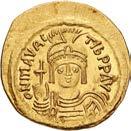



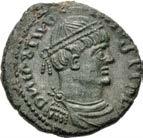
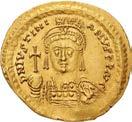
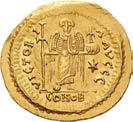
715. Justin II. 565-578. AV Solidus (19.5mm, 4.44 g, 6h). Constantinople mint, 10th officina. Struck 567-578. Helmeted and cuirassed bust facing, holding Victory on globe and shield on left shoulder / Constantinopolis seated facing on throne, head right, holding scepter and globus cruciger; I//CONOB. DOC 4i; MIBE 5; SB 345. Lustrous. In NGC encapsulation 6558566005, graded Ch AU, Strike: 5/5, Surface: 4/5, clipped. ($500)
From the Gasvoda Collection. Ex Numismatik Naumann 81 (1 September 2019), lot 672.
716. Maurice Tiberius. 582-602. AV Solidus (20mm, 4.37 g, 7h). Constantinople mint, 7th officina. Struck 583/4-602. Helmeted, draped, and cuirassed bust facing, holding globus cruciger / Angel standing facing, holding long staff surmounted by staurogram and globus cruciger; Z//CONOB. DOC 5g; MIBE 6; SB 478. Lustrous. In NGC encapsulation 6558566-004, graded MS, Strike: 5/5, Surface: 4/5, clipped. ($500)
From the Gasvoda Collection. Ex Classical Numismatic Group Electronic Auction 451 (4 September 2019), lot 485.

171
715 716
717. Maurice Tiberius. 582-602. AR Light Siliqua (20mm, 1.94 g, 8h). Ceremonial coinage. Constantinople mint. Struck 583/4-602. Helmeted, draped, and cuirassed bust right; all within double pelleted border / Cross potent set on globe; all within double pelleted border; [four globules] around and outside border. DOC –; MIBE 54a; SB 491. Toned, find patina, some roughness, scratches, minor flan crack, porous. VF. ($1000)
From the Gasvoda Collection. Ex Classical Numismatic Group 114 (13 May 2020), lot 1040.

718. Maurice Tiberius. 582-602. AV Solidus (18mm, 4.53 g, 6h). Carthage mint. Dated IY 1 (597/8). Helmeted and cuirassed bust facing, holding globus cruciger; A (date) at end of legend / Angel standing facing, holding long staff surmounted by staurogram and globus cruciger; A (date)//CONOB. DOC 230; MIBE 25b; SB 549. Near EF. Rare. ($750)



From the Gasvoda Collection. Ex Triton XXV (11 January 2022), lot 1036.
Plated by Ranieri
719. Maurice Tiberius. 582-602. AV Tremissis (15.5mm, 1.46 g, 5h). Ravenna mint. Diademed, draped, and cuirassed bust right / Victory standing facing, head left, holding wreath and globus cruciger; star to right. DOC 287; MIBE 50; Ranieri 480 (this coin); SB 592. Near EF. Very rare. ($500)
From the Gasvoda Collection. Ex Künker 351 (25 September 2021), lot 595; Numismatica Ars Classica Autumn Sale 95 (26 October 1995), lot 805; Leu & Numismatica Ars Classica (26 May 1993), lot 511.
720. Maurice Tiberius, with Constantina and Theodosius. 582-602. Æ 8 Pentanummia – Follis (29mm, 13.11 g, 7h). Cherson mint. Maurice, holding globus cruciger, and Constantina, holding cruciform scepter in both hands, standing facing, nimbate; cross in field above / Theodosius, nimbate, standing facing, holding long cross; to right, cross above large H. DOC 303.2 var. (obv. figures on dias); MIBE 157a; SB 607. Dark green-brown patina. Good VF. ($750)

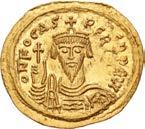

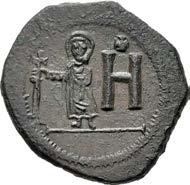

From the Gasvoda Collection. Ex Jack A. Frazer Collection (Triton XXIII, 14 January 2020), lot 918; Berk BBS 142 (15 March 2005), lot 378.
721. Phocas. 602-610. AV Solidus (23mm, 4.36 g, 7h). Constantinople mint, 6th officina. Struck 604-607. Draped and cuirassed bust facing, wearing crown without pendilia, holding globus cruciger / Angel standing facing, holding long staff surmounted by staurogram and globus cruciger; S//CONOB. DOC 5f; MIBE 7; SB 618. Lustrous. In NGC encapsulation 6558566-003, graded MS, Strike: 3/5, Surface: 2/5, die shift, clipped, brushed. ($500)

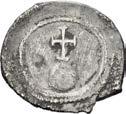
From the Gasvoda Collection. Ex Roma E-Sale 74 (20 August 2020), lot 1463.

722. Phocas. 602-610. AR Quarter Siliqua – 120 Nummi (9.5mm, 0.38 g, 6h). Ravenna mint. Struck 602-607. Crossdiademed and draped bust right / Large ΦK within wreath. DOC 130a; MIBE 58a; Ranieri 516; SB 702. Toned, light scuff on reverse. Near EF. Very rare. The first we have offered in over ten years. ($1000)
From the Gasvoda Collection. Ex Artemide LII (26 October 2019), lot 446.
172
718 719 721 722
Rare Carthage Solidus of the Heraclii

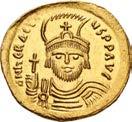

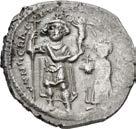

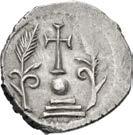

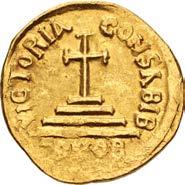
723. Revolt of the Heraclii. 608-610. AV Solidus (19mm, 4.47 g, 6h). Carthage mint. Dated IY 12 (608/9). DMN HЄR[AC]ΛI CONSVΛI IB, facing busts of Heraclius the younger, beardless, and the Exarch Heraclius, bearded, both wearing consular robes; cross above / VICTORIA CONSΛB, cross potent set on three steps; IB//CONOB. DOC 13; MIBE 2; SB 720. In NGC encapsulation 6558560-001, graded Ch AU, Strike: 3/5, Surface: 4/5. Very rare. ($15,000)
From the Gasvoda Collection. Ex Elsen 125 (13 June 2015), lot 567.
The episode known as the “Revolt of the Heraclii” marked one of the few times the East Roman Empire witnessed a “constitutional” coup d’etat. Phocas, a low-ranking officer in the Byzantine army, had seized power in AD 602, but within six years his incompetence in dealing with escalating crises had badly weakened the empire’s military position, crippled the economy, and alienated much of of society. Beginning in 608, the aged exarch of Africa and his son, both named Heraclius, began issuing coinage in opposition to Phocas at Carthage and Alexandria. This coinage named both Heraclii as consuls, an old Republican title that hadn’t been held by anyone outside the imperial family in nearly a century. The two men are shown without crowns or diadems and wearing consular robes, the age-old dress of office. By what authority the Heraclii held that title remains unclear; the Senate of Carthage could not legally bestow it, the Senate of Constantinople was under the thumb of Phocas, and the last recorded act of the Senate of Rome was to erect statues of Phocas and his wife Leontia in the Forum in AD 603. Still, even if self-appointed, the reticence of the Heraclii to claim the full imperial title and their adherence to old Republican forms bespeaks their respect for constitutional government, as opposed to the outright tyranny of Phocas. Aided by this “champions of the people” pose, the revolt gained support in the provinces and the younger Heraclius was ultimately able to enter Constantinople and depose Phocas in October of AD
610. The younger Heraclius was proclaimed emperor; the elder Heraclius passed away peacefully soon after receiving word of his son’s accession. The Carthage solidi of the Revolt of the Heraclii are far rarer than the Alexandria mint issues and are distinguished by the younger Heraclius, and future emperor, being depicted beardless.
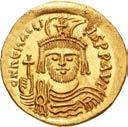
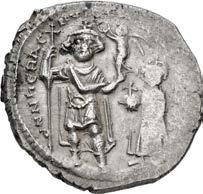
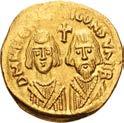
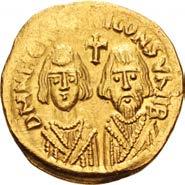
724. Heraclius. 610-641. AV Solidus (20.5mm, 4.42 g, 7h). Constantinople mint, 5th officina. Struck 610-613. Draped and cuirassed facing bust, wearing plumed helmet, holding cross / Cross potent set on three steps; Є//CONOB. DOC 3b; MIB 5; SB 731. Lustrous. In NGC encapsulation 6558566-001, graded MS, Strike: 5/5, Surface: 3/5, edge marks, edge bend. ($1500)
From the Gasvoda Collection. Ex Triton XVIII (5 January 2015), lot 1301.
725. Heraclius. 610-641. AV Solidus (20mm, 4.52 g, 7h). Constantinople mint, 5th officina. Struck 610-613. Draped and cuirassed facing bust, wearing plumed helmet, holding cross / Cross potent set on three steps; N to right; Є//CONOB. DOC 4; MIB 6b (same dies); SB 732. Lustrous. In NGC encapsulation 6558568-008, graded MS, Strike: 5/5, Surface: 4/5. ($500)
From the Gasvoda Collection. Ex Künker 351 (25 September 2021), lot 600.
726. Heraclius, with Heraclius Constantine. 610-641. AR Miliaresion (21mm, 4.48 g, 7h). ‘Ceremonial’ coinage. Constantinople mint. Struck circa 620. Heraclius standing facing, wearing military attire and crown, holding long cross and crowning Victory; to right, Heraclius Constantine standing facing, wearing crown and chlamys, holding globus cruciger / Cross potent set on globe set on three steps; palm fronds flanking. DOC 58; MIB 129; SB 789. Lightly toned. In NGC encapsulation 6558569-014, graded AU, Strike: 3/5, Surface: 4/5. Very rare. Among the finest known for this difficult issue. ($2000)
From the Gasvoda Collection. Ex Heritage 3081 (12 January 2020), lot 30202.
173
724
725
Extremely Rare
727. Heraclius, with Heraclius Constantine. 610-641. AV Solidus (21.5mm, 4.45 g, 6h). Constantinople mint, 10th officina. Struck 629-631. Crowned facing busts of Heraclius and Heraclius Constantine, each wearing chlamys; cross above / Cross potent set on three steps; K to right; IB//CONOB. DOC 30d; MIB 36; SB 755. Lustrous. In NGC encapsulation 6558566-002, graded Ch AU, Strike: 5/5, Surface: 3/5, edge bend. Extremely rare, possibly the second known example. All references cite the same coin from a 1928 Santamaria sale. ($600)
From the Gasvoda Collection. Ex Provence Collection (purchased privately).
728. Heraclius, with Heraclius Constantine and Heraclonas. 610-641. AV Solidus (20mm, 4.48 g, 6h). Constantinople mint, 8th officina. Dated IY 12 (638/9). Heraclonas, Heraclius, and Heraclius Constantine standing facing, each wearing crown and chlamys and holding globus cruciger / Cross potent set on three steps; monogram to left; IB monogram (date) to right; H// CONOB. DOC 41h; MIB 48; SB 767. In NGC encapsulation 6558568-010, graded MS, Strike: 5/5, Surface: 4/5. ($500)
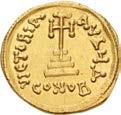

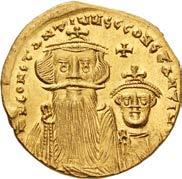

From the Gasvoda Collection.
729. Constans II. 641-668. AV Solidus (20mm, 4.40 g, 6h). Constantinople mint, 4th officina. Struck 641-646. Crowned, draped, and cuirassed bust facing, holding globus cruciger / Cross potent set upon three steps; ∆//CONOB. DOC 1d; MIB 3b; SB 938. Minor die rust. EF. ($1000)
From the Gasvoda Collection. Ex Phoibos Collection (Künker 341, 1 October 2020), lot 6162.
730. Constans II. 641-668. AV Solidus (19mm, 4.37 g, 6h). Constantinople mint, 9th officina. Dated IY 7 (648/9). Crowned facing bust, wearing chlamys, holding globus cruciger / Cross potent set on three steps; Z (date) to right; Θ// CONOB. DOC 13 var. (unlisted officina); MIB 16a; SB 949. Lustrous. In NGC encapsulation 6558566-010, graded MS, Strike: 5/5, Surface: 3/5, clipped. ($500)

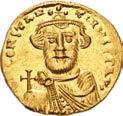
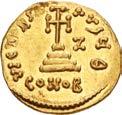
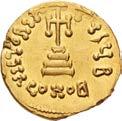

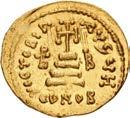

From the Gasvoda Collection. Ex W. Besler Collection (Nomos 21, 21 November 2020), lot 373.
731. Constans II, with Constantine IV. 641-668. AV Solidus (20mm, 4.30 g, 6h). Constantinople mint, 2nd officina. Struck 654-659. Crowned facing busts of Constans and Constantine, each wearing chlamys; cross above / Cross potent set on three steps; B//CONOB. DOC 25b; MIB 26; SB 959. Lustrous, clipped, hairlines on reverse, a couple edge marks. EF. ($500)
174
728
729
732. Constans II, with Constantine IV, Heraclius, and Tiberius. 641-668. AV Solidus (19.5mm, 4.45 g, 6h). Constantinople mint, 3rd officina. Struck circa 661-circa 663. Crowned facing busts of Constans, with long beard, wearing plumed helmet and chlamys, and Constantine, beardless, wearing chlamys; cross above / Cross potent set on three steps flanked by Heraclius and Tiberius, each wearing chlamys and holding globus cruciger; Γ//CONOB. DOC 30c; MIB 31; SB 964. Lustrous. In NGC encapsulation 6558569-002, graded MS, Strike: 5/5, Surface: 4/5. ($750)
From the Gasvoda Collection. Ex Numismatik Naumann 97 (6 December 2020), lot 653.
Extremely Rare Late Constans II
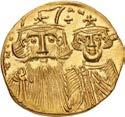

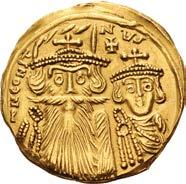
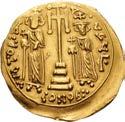
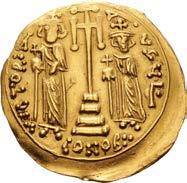
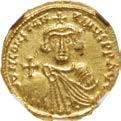
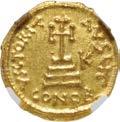

733. Constans II, with Constantine IV, Heraclius, and Tiberius. 641-668. AV Solidus (20mm, 4.44 g, 6h). Syracuse mint. Struck circa 668. Crowned facing busts of Constans, with long beard, and Constantine, beardless, each wearing chlamys; cross above / Cross potent set on three steps, flanked by crowned facing figures of Heraclius, on left, and Tiberius, on right, each wearing chlamys and holding globus cruciger; Γ• at end of legend; CONOB∴. Cf. DOC 162 (for obverse type); MIB pl. 23 (same dies); cf. Anastasi 222 (Constantine IV; for reverse); cf. SB 1202 (same). Lustrous, a few light scratches and marks, some light deposits. Good VF. Extremely rare. Only two known examples. ($3000)
An extremely rare late Constans II die-pair was thought by Hahn in MIB to be a hybrid with a reverse die known to Constantine IV. Alternatively, this reverse die may have originally been used for Constans with the reverse die simply continuing in usage into the reign of Constantine IV. Given that this reverse die is known for Constans II from only two examples, it is probable that it was issued in Syracuse very late into Constans II’s reign, and ceased production immediately upon his death.
Very Rare Rome Mint Indiction Year Three
734. Constans II. 641-668. AV Solidus (18.5mm, 4.44 g, 6h). Rome mint. Dated IY 3 (644/5). Crowned facing bust, wearing chlamys, holding globus cruciger / Cross potent set on three steps; K to right; Γ (date)//CONOB. DOC 10a (Heraclonas); MIB 112.1 (same dies as illustration); SB 1117. In NGC encapsulation 4282776-004, graded MS, Strike: 4/5, Surface: 4/5. Very Rare. ($1500)
Ex Heritage 3072 (15 January 2019), lot 35579; Property of Princeton Economics acquired by Martin Armstrong (Classical Numismatic Group Electronic Auction 271, 11 January 2012), lot 106; Sotheby’s New York (2 November 1998), lot 282; Bonhams 3 (3 December 1980), lot 155.
175
735. Constantine IV Pogonatus, with Heraclius and Tiberius. 668-685. AV Solidus (19mm, 4.02 g, 6h). Syracuse mint. Struck 677-678. Crowned facing bust with short beard, wearing chlamys, holding globus cruciger / Cross potent set on three steps, flanked by crowned facing figures of Heraclius and Tiberius, each wearing chlamys and holding globus cruciger; Γ•//CONOB. DOC 56; MIB 31; Anastasi 222; SB 1202. In NGC encapsulation 6558568-011, graded Ch AU, Strike: 4/5, Surface: 2/5, light marks, clipped. ($2000)
From the Gasvoda Collection. Ex Triton XXIII (14 January 2020), lot 922; Property of Princeton Economics acquired by Martin Armstrong (Classical Numismatic Group Electronic Auction 271, 11 January 2012), lot 109; Sotheby’s New York (2 November 1998), lot 311; Bonhams 3 (3 December 1980), lot 207.
736. Justinian II. First reign, 685-695. AV Solidus (19mm, 4.42 g, 7h). Constantinople mint, 10th officina. Struck 686/7. Crowned facing bust, wearing chlamys, holding globus cruciger / Cross potent set on three steps; IA//CONOB. DOC 3c (same dies); MIB 3 (citing the DOC coin); SB 1244. Lustrous. In NGC encapsulation 4938331-029, graded MS, Strike: 4/5, Surface: 4/5, clipped. Extremely rare. The second known, with the DOC coin the only other known example, none in CoinArchives. ($1000)
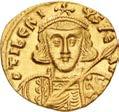


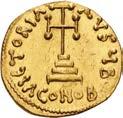
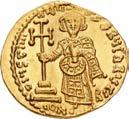
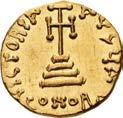

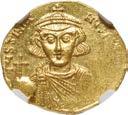


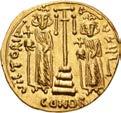
From the Gasvoda Collection. Ex Classical Numismatic Group Electronic Auction 477 (23 September 2020), lot 671.
737. Justinian II. First reign, 685-695. AV Solidus (19.5mm, 4.17 g, 7h). Constantinople mint, 1st officina. Struck 687692. Crowned facing bust with slight beard, wearing chlamys, holding globus cruciger / Cross potent set on three steps; A// CONOBΓ. DOC 6a; MIB 7; SB 1247. Lustrous. In NGC encapsulation 6558568-013, graded MS, Strike: 5/5, Surface: 4/5, clipped. ($750)
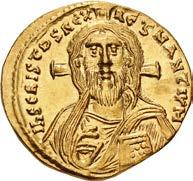
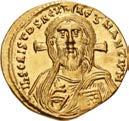
From the Gasvoda Collection. Ex Numismatik Naumann 92 (2 August 2020), lot 957.
Superb Western Influenced Portrait of Christ
738. Justinian II. First reign, 685-695. AV Solidus (20mm, 4.49 g, 6h). Constantinople mint, 2nd officina. Struck 692695. Facing bust of Christ Pantokrator / Justinian standing facing, wearing crown and loros, holding cross potent set on two steps and akakia; B//CONOP. DOC 7b var. (officina not retrograde); MIB 8a; SB 1248. Lustrous. In NGC encapsulation 6558568-012, graded MS, Strike: 5/5, Surface: 4/5, clipped. ($3000)
From the Gasvoda Collection. Ex Nomos 20 (10 July 2020), lot 422.
739. Leontius. 695-698. AV Solidus (19.5mm, 4.32 g, 6h). Constantinople mint, 2nd officina. Crowned facing bust, wearing loros, holding akakia and globus cruciger / Cross potent set on three steps; B//CONOB. DOC 1b; MIB 1; SB 1330. Lustrous. In NGC encapsulation 6558566-011, graded MS, Strike: 4/5, Surface: 4/5, clipped. ($1000)
From the Gasvoda Collection, purchased from Herb Kreindler, August 2019.
740. Tiberius III (Apsimar). 698-705. AV Solidus (18.5mm, 4.43 g, 7h). Constantinople mint, 3rd officina. Crowned and cuirassed facing bust, holding transverse spear and shield on left shoulder / Cross potent set on three steps; Γ//CONOB. DOC 1 var. (unlisted officina); MIB 1; SB 1360. Lustrous. In NGC encapsulation 6558566-012, graded Ch AU, Strike: 4/5, Surface: 4/5. ($1500)
From the Gasvoda Collection. Ex Künker 326 (7 October 2019), lot 1819; Giessener Münzhandlung 78 (13 June 1996), lot 677.
176
735 736 737 739 740
Two Superb Eastern Influenced Portraits of Christ
From the Gasvoda Collection. Ex Classical Numismatic Group 114 (13 May 2020), lot 1044.
742.
Tiberius. Second reign, 705-711. AV Solidus (20mm, 4.40 g, 6h).
mint. Struck 705-711. Facing bust of Christ Pantokrator / Crowned facing busts of Justinian, with slight beard and wearing chlamys, and Tiberius, wearing chlamys; holding between them cross potent set on two steps. DOC 2b; MIB 2b; SB 1415. Lustrous. In NGC encapsulation 6558569-011, graded MS, Strike: 4/5, Surface: 4/5, clipped. ($2500)
From the Gasvoda Collection. Ex Künker 326 (7 October 2019), lot 1823.
Upon his return to power, Justinian II resumed his innovative coinage featuring an obverse portrait of Christ. The new sacred image, however, was different from the “classic” Christ of Justinian’s first reign. Jesus is shown with a head of tight, curly hair and a close-cropped beard, perhaps inspired by Eastern iconography.

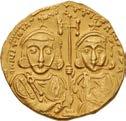







lightly clipped, reverse double struck. Near EF. ($1000)

177
741. Justinian II. Second reign, 705-711. AV Solidus (20mm, 4.45 g, 6h). Constantinople mint. Struck 705. Facing bust of Christ Pantokrator / Crowned facing bust of Justinian, wearing loros, holding cross potent set on three steps and globus cruciger inscribed PAX. DOC 1; MIB 1; SB 1413. Lustrous. In NGC encapsulation 6558566-013, graded MS, Strike: 5/5, Surface: 3/5, brushed. ($3000)
Justinian II, with
Constantinople
743. Justinian II, with Tiberius. Second reign, 705-711. AV Solidus (19.5mm, 4.37 g, 6h). Constantinople mint. Struck 705-711. Facing bust of Christ Pantokrator / Crowned facing busts of Justinian, with slight beard and wearing chlamys, and Tiberius, wearing chlamys; holding between them cross potent set on two steps. DOC 2b; MIB 2b; SB 1415. Light find patina,
742
741
744. Philippicus (Bardanes). 711-713. AV Solidus (19mm, 4.55 g, 6h). Constantinople mint, 10th officina. Crowned facing bust, wearing loros, holding globus cruciger and eagle-tipped scepter / Cross potent set on three steps; I//CONOB. DOC 1j var. (obv. legend); MIB 1 var. (same); SB 1447. Lustrous. In NGC encapsulation 6558566-014, graded MS, Strike: 5/5, Surface: 4/5. An interesting variety with Philippicus’ name spelled with two P’s instead of the more commonly found Latin spelling of just one. ($2500)

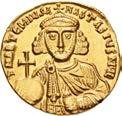
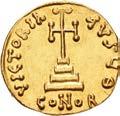
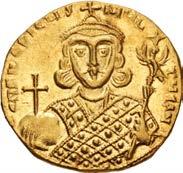

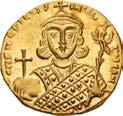
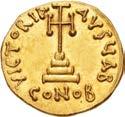
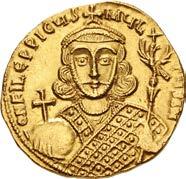

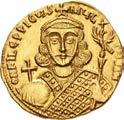
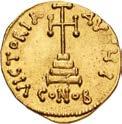
From the Gasvoda Collection. Ex Nomos 19 (17 November 2019), lot 424; G. Hirsch 135 (19 January 1983), 803.
Bardanes was a general of Armenian origins who was proclaimed Emperor upon the final overthrow of Justinian II. Almost immediately, he alienated the clergy by reviving the Monothelite heresy (proposing that Christ had a single, divine nature and will) which had supposedly been stamped out decades previously. He was also unsuccessful in stopping Arab and Bulgarian advances, prompting the Byzantine army to depose and blind him after 18 months of ineffective rule. He was replaced by the finance minister Artemius, who reigned as Anastasius II.
745. Philippicus (Bardanes). 711-713. AV Solidus (19.5mm, 4.41 g, 6h). Constantinople mint, 1st officina. Crowned facing bust, wearing loros, holding globus cruciger and eagle-tipped scepter / Cross potent set on three steps; AB//CONOB. DOC 2 var. (unlisted officina); MIB 2 var. (same); SB 1448 var. (same). Lustrous. In NGC encapsulation 6558568-015, graded MS, Strike: 5/5, Surface: 3/5, brushed. Extremely rare in this officina. Unlisted in the standard references and with only three examples in CoinArchives, including this coin. ($2500)
From the Gasvoda Collection. Ex Roma XXII (7 October 2021), lot 941.
Exceptional Provenance
746. Anastasius II Artemius. 713-715. AV Solidus (18.5mm, 4.39 g, 6h). Constantinople mint, 9th officina. Crowned facing bust, wearing chlamys, holding globus cruciger and akakia / Cross potent set on three steps; Θ//CONOB. DOC 2h; MIB 2; Füeg 2.I.1; SB 1463. Lustrous. In NGC encapsulation 6558566-015, graded MS, Strike: 5/5, Surface: 3/5, clipped. ($1500)
From the Gasvoda Collection. Ex Künker 326 (7 October 2019), lot 1824; Künker 277 (21 June 2016), lot 196; Andre Constantine Dimitriadis Collection (Heritage 3035, 3 September 2014), lot 29502, purchased from Spink, May 1998; Numismatic Fine Arts XVIII (1 April 1987), lot 874; Numismatic Fine Arts II (25 March 1976), lot 540; Leu 2 (25 April 1972), lot 483.
178
747. Anastasius II Artemius. 713-715. AV Semissis (16.5mm, 2.13 g, 7h). Constantinople mint. Crowned facing bust, wearing chlamys, holding globus cruciger and akakia / Cross potent set upon globus. DOC 4; MIB 5; SB 1465; Berk, Roman 209 (this coin illustrated). In NGC encapsulation 5746398-015, graded Ch AU, Strike: 4/5, Surface: 3/5, edge marks. Rare. ($1000)
From the Gasvoda Collection. Ex Heritage 3085 (5 August 2020), lot 31164; Property of Princeton Economics acquired by Martin Armstrong (Classical Numismatic Group Electronic Auction 271, 11 January 2012), lot 123; Gemini VII (9 January 2011), lot 1016; Sotheby’s New York 7214 (2 November 1998), lot 379.
748. Theodosius III of Adramytium. 715-717. AV Solidus (19mm, 4.47 g, 6h). Constantinople mint, 5th officina. Crowned facing bust, wearing loros, holding patriarchal globus cruciger in right hand and akakia in left / Cross potent set on three steps; Є//CONOB. DOC 1b.1; MIB 1; Füeg 1.A.5; SB 1487. In NGC encapsulation 6558872-002, graded Ch AU, Strike: 5/5, Surface: 3/5, edge marks, brushed, scuffs. Very rare. ($7500)

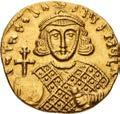
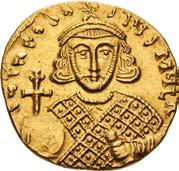

From the Gasvoda Collection. Ex Leu Numismatik 7 (24 October 2020), lot 1943.
Füeg Plate Coin

717-741. AV Solidus (18.5mm, 4.46 g, 6h). Constantinople mint, 10th officina. Struck 717-720. Crowned facing bust, wearing chlamys, holding globus cruciger and akakia / Cross potent set on three steps; IC// CONOB. DOC 2 var. (unlisted officina); MIB 2 var. (same); Füeg 1.B.20 (this coin illustrated); SB 1503 var. (same). Lustrous. In NGC encapsulation 6558568-009, graded MS, Strike: 4/5, Surface: 4/5, brushed. Extremely rare with this officina; this coin the only example in CoinArchives. ($1500)

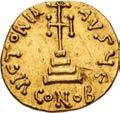

749.
From the Gasvoda Collection. Ex Künker 351 (25 September 2021), lot 625; Lanz 74 (20 November 1995), lot 893.
Illustrated by Sear
mint, 1st
Struck 720-circa 721. Crowned facing bust of Leo III, wearing chlamys, holding globus cruciger and akakia / Large M surmounted by crowned facing bust of Constantine, wearing chlamys, holding globus cruciger and akakia; cross to right; A/A/N - X/X across lower field; A. DOC 29b; SB 1514 (this coin illustrated). Brown
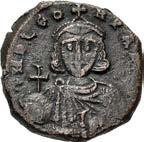

179
Leo III the “Isaurian”.
750. Leo III the “Isaurian”, with Constantine V. 717-741. Æ Follis (23mm, 7.06 g, 6h). Constantinople
officina.
patina, some roughness. VF. ($1000) Ex Classical Numismatic Group inventory 97615 (circa 1990-1992).
751. Leo III the “Isaurian”, with Constantine V. 717-741. AV Solidus (19.5mm, 4.46 g, 6h). Constantinople mint. Struck circa 737-741. Crowned facing bust of Leo, wearing chlamys, holding globus cruciger and akakia / Crowned facing bust of Constantine, wearing chlamys, holding globus cruciger and akakia. DOC 7c.1; Füeg 7.E.6; SB 1504. Lustrous. In NGC encapsulation 6558567-001, graded XF, Strike: 5/5, Surface: 2/5, graffiti. ($750)

From the Gasvoda Collection, purchased from Herb Kreindler, August 2019.
Very Rare Rome Mint Leo III
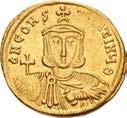

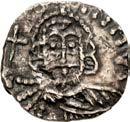

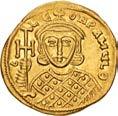
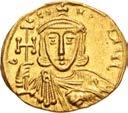
752. Leo III the “Isaurian”, with Constantine V. 717-741. Debased AV Tremissis (13mm, 1.22 g, 5h). Rome mint. Struck 721-741. Crowned facing bust of Leo III, wearing chlamys, holding globus cruciger / Crowned facing bust of Constantine V, wearing chlamys, holding globus cruciger; I - Є/* across field. DOC 88; SB 1534. Toned, light scrape on obverse, some flan flaws and scratches on reverse. Good VF. Very rare, only one in DOC, and this is the only example in CoinArchives. ($1500)

From the Gasvoda Collection. Ex Künker 326 (7 October 2019), lot 1827.
753. Constantine V Copronymus, with Leo III. 741-775. AV Solidus (20mm, 4.46 g, 6h). Constantinople mint. Struck 741-751. Crowned facing bust of Leo, wearing chlamys, holding cross potent and akakia / Crowned facing bust of Constantine, wearing chlamys, holding cross potent and akakia. DOC 1d.1; Füeg 2.B.6; SB 1550. Lustrous. In NGC encapsulation 6558567002, graded MS, Strike; 5/5, Surface: 3/5, lt. scratches. ($750)

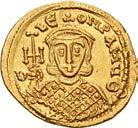
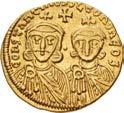

From the Gasvoda Collection, purchased from Herb Kreindler, August 2019.
754. Constantine V Copronymus, with Leo IV and Leo III. 741-775. AV Solidus (20.5mm, 4.41 g, 6h). Constantinople mint. Struck 751-circa 757. Crowned facing busts of Constantine V and Leo IV, each wearing chlamys; cross above, • between / Crowned facing bust of Leo III, wearing loros, holding cross potent; Θ at end of legend. DOC 2c; Füeg 4.A.3; SB 1551. Some luster. Near EF. ($750)
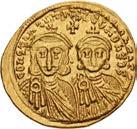

755. Constantine V Copronymus, with Leo IV and Leo III. 741-775. AV Solidus (19.5mm, 4.43 g, 6h). Constantinople mint. Struck 751-circa 757. Crowned facing busts of Constantine V and Leo IV, each wearing chlamys; cross above, • between / Crowned facing bust of Leo III, wearing loros, holding cross potent; Θ at end of legend. DOC 2c; Füeg 4.A.5; SB 1551. Lustrous. Near EF. ($750)
756. Constantine V Copronymus, with Leo IV and Leo III. 741-775. AV Solidus (21.5mm, 4.45 g, 6h). Constantinople mint. Struck 751-circa 757. Crowned facing busts of Constantine V and Leo IV, each wearing chlamys; cross above, • between / Crowned facing bust of Leo III, wearing loros, holding cross potent; Θ at end of legend. DOC 2c; Füeg 4.B.6; SB 1551. Lustrous. In NGC encapsulation 6558567-003, graded AU, Strike: 4/5, Surface: 5/5, die shift. ($500)
From the Gasvoda Collection. Ex Nomos 20 (10 July 2020), lot 428.
180
753 754 755 756
757. Constantine V Copronymus, with Leo IV and Leo III. 741-775. AV Solidus (20mm, 4.29 g, 5h). Constantinople mint. Struck circa 757-775. Crowned facing busts of Constantine V and Leo IV, each wearing chlamys; cross above, • between; ~ at end of legend / Crowned facing bust of Leo III, wearing loros, holding cross potent; Θ at end of legend. DOC 2e; Füeg 6.B.2; SB 1551. Lustrous. In NGC encapsulation 6558567-004, graded AU, Strike: 5/5, Surface: 4/5. ($750)
From the Gasvoda Collection, purchased from Herb Kreindler, August 2019.
The Last Byzantine Coin From Ravenna
758. Constantine V Copronymus. 741-775. Æ Follis (14mm, 2.45 g, 6h). Ravenna mint. Crowned facing bust, with short beard, wearing chlamys, holding globus cruciger / Large M; cross above, N/N/N to left, X/X/X to right, RAV below. DOC –; Ranieri 840 (this coin illustrated); SB 1580 (this coin cited and illustrated). Brown patina, some roughness. VF. The only known example; this coin cited as unique in SB, and rated R5 in Ranieri, none in CoinArchives. ($750)
Ex Harlan J. Berk and Victor England (7 December 1989), lot 303.
The only sole reign coin of Constantine V from Ravenna known. Ten years into Constantine’s reign, Ravenna, the last Byzantine bastion in Italy, finally succumbed to Lombard pressure. This is the only known coin that has been attributed to Constantine V’s sole reign from Ravenna. Furthermore, this coin remains unique even over thirty years since it originally appeared.
759. Leo IV the Khazar, with Constantine VI, Leo III, and Constantine V. 775-780. AV Solidus (20mm, 4.41 g, 6h). Constantinople mint. Struck 776-778. Crowned facing busts of Leo IV and Constantine VI, each wearing chlamys; cross above, • between; Θ at end of legend / Crowned facing busts of Leo III and Constantine V, each wearing loros; cross above, • between. DOC 1b; Füeg 2; SB 1583. Underlying luster, a few minor spots of weakness. EF. ($600)
760. Leo IV the Khazar, with Constantine VI, Leo III, and Constantine V. 775-780. AV Solidus (21.5mm, 4.45 g, 6h). Constantinople mint. Struck 778-780. Leo IV and Constantine VI enthroned facing, each wearing crown and chlamys, and holding akakia; cross above / Crowned facing busts of Leo III and Constantine V, each wearing loros; cross above, • between. DOC 2; Füeg 1.A.1 (Constantine VI); SB 1584. Lustrous. In NGC encapsulation 6558567-005, graded AU, Strike: 4/5, Surface: 4/5, edge mark. ($750)
From the Gasvoda Collection, purchased from Herb Kreindler, August 2019.
761. Constantine VI & Irene, with Leo III, Constantine V, and Leo IV. 780-797. AV Solidus (20.5mm, 4.38 g, 6h). Constantinople mint. Struck 780-790. Crowned facing busts of Constantine VI, wearing chlamys and holding globus cruciger, and Irene, wearing loros and holding globus cruciger and cruciform scepter; cross above, • between / Constantine V, Leo III, and Leo IV seated facing, each wearing crown and chlamys. DOC 1; Füeg C.2.2/Ir.2 (obv./rev.); SB 1593. Underlying luster, minor area of weakness, a few light marks, minor roughness. Good VF. ($750)
762. Constantine VI & Irene, with Leo III, Constantine V, and Leo IV. 780-797. AV Solidus (18.5mm, 4.41 g, 6h).
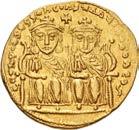
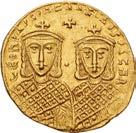

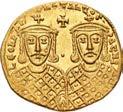





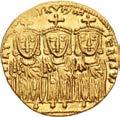
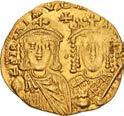

Constantinople mint. Struck 790-792. Crowned facing busts of Constantine VI, wearing chlamys and holding globus cruciger, and Irene, wearing loros and holding cruciform scepter; cross above, • between / Constantine V, Leo III, and Leo IV seated facing, each wearing crown and chlamys. DOC 2; Füeg Ir.4.7/C.4.18; SB 1591. Lustrous. In NGC encapsulation 6558567-007, graded MS, Strike: 4/5, Surface: 5/5. ($1500)
From the Gasvoda Collection. Ex Roma XVIII (29 September 2019), lot 1303.
181
761 762 757 758 759 760
763. Constantine VI & Irene, with Leo III, Constantine V, and Leo IV. 780-797. AV Solidus (20mm, 4.53 g, 6h). Constantinople mint. Struck 790-792. Crowned facing busts of Constantine VI, wearing chlamys and holding globus cruciger, and Irene, wearing loros and holding cruciform scepter; cross above, • between / Constantine V, Leo III, and Leo IV seated facing, each wearing crown and chlamys. DOC 2; Füeg Ir.2.1/C.2 (obv./rev.); SB 1591. Some luster, some areas of weakness, a few light scratches. Good VF. ($750)
764. Constantine VI & Irene. 780-797. AV Solidus (19mm, 4.48 g, 7h). Constantinople mint. Struck 792-797. Crowned facing bust of Irene, wearing loros, holding globus cruciger and cruciform scepter / Crowned facing bust of Constantine, wearing chlamys, holding globus cruciger and akakia; Θ at end of legend. DOC 3a; Füeg 5.A; SB 1594. Lustrous. In NGC encapsulation 6558568-014, graded Ch AU, Strike: 4/5, Surface: 4/5. ($2500)


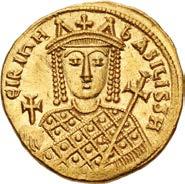

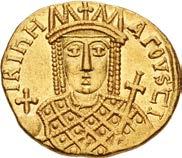

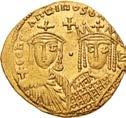






From the Gasvoda Collection. Ex Roma XVIII (29 September 2019), lot 1305.
765. Irene. 797-802. AV Solidus (19mm, 4.43 g, 5h). Constantinople mint. Struck 797-802. Crowned facing bust of Irene, wearing loros, holding globus cruciger and cruciform scepter / Crowned facing bust of Irene, wearing loros, holding globus cruciger and cruciform scepter; Θ at end of legend. DOC 1a; Füeg 1.C.1; SB 1599. Lustrous. In NGC encapsulation 6558567-006, graded MS★, Strike: 5/5, Surface: 4/5. ($4000)
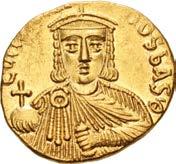

From the Gasvoda Collection. Ex Roma XVIII (29 September 2019), lot 1306.
766. Nicephorus I, with Stauracius. 802-811. AV Solidus (19mm, 4.36 g, 6h). Constantinople mint. Struck 803-811. Crowned facing bust of Nicephorus, wearing slight beard and chlamys, holding cross potent and akakia / Crowned bust of Stauracius facing, wearing chlamys, holding globus cruciger and akakia; X at end of legend. DOC 2c; Füeg 2.A.2; SB 1604. Lustrous. Near EF. ($500)

767. Nicephorus I, with Stauracius. 802-811. AV Solidus (19mm, 3.12 g, 6h). Syracuse mint. Struck 810-811. Crowned facing bust of Nicephorus I, wearing short beard and chlamys, holding cross potent and akakia / Crowned facing bust of Stauracius, wearing chlamys, holding a globus cruciger. DOC 6; Anastasi 468; SB 1608. Toned, some light scratches and minor deposits, a little die rust. VF. Very rare. ($2000)
From the Gasvoda Collection. Ex HC Collection (Triton XXIII, 14 January 2020), lot 933, purchased from M. Geiger (1980).
768. Nicephorus I, with Stauracius. 802-811. AV Semissis (14.5mm, 1.82 g, 6h). Syracuse mint. Struck 810-811. Crowned facing bust of Nicephorus, wearing chlamys, holding globus cruciger and akakia / Crowned facing bust of Stauracius, holding cross potent on globus and akakia. DOC 7; Anastasi 469; SB 1609. Some faint hairlines. Good VF. Very rare. ($300)
From the Gasvoda Collection. Ex Künker 465 (4 April 2022), lot 5548.
182
768 766 767
A Pair of Michael I & Theophylactus Solidi


769. Michael I Rhangabe, with Theophylactus. 811-813. AV Solidus (19.5mm, 4.48 g, 6h). Constantinople mint. • mIXA HL ЬASILЄ´, crowned facing bust of Michael, wearing chlamys, holding cross potent in right hand and akakia in left / ΘЄOFVLA CτOS ∂ЄSP´, crowned facing bust of Theophylactus, wearing loros, holding globus cruciger in right hand and cruciform scepter in left; X at end of legend. DOC 1a; Füeg 1.B (same obv. die as illustration); SB 1615. Underlying luster, a few scratches and die breaks, minor deposit on reverse. Superb EF. Very Rare. ($7500)
770. Michael I Rhangabe, with Theophylactus. 811-813. AV Solidus (20mm, 4.49 g, 6h). Constantinople mint. • mIXA HL ЬASILЄ´, crowned facing bust of Michael, wearing chlamys, holding cross potent in right hand and akakia in left / ΘЄOFVLA CτOS ∂ЄSP´, crowned facing bust of Theophylactus, wearing loros, holding globus cruciger in right hand and cruciform scepter in left; Є at end of legend. DOC 1b; Füeg 1.A; SB 1615. Light scratches and a few marks on reverse. Superb EF. Very Rare. ($7500)
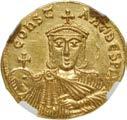




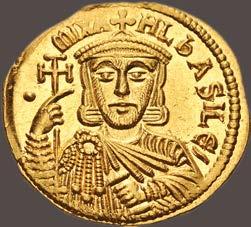



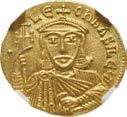
From the S & S Collection.
771. Michael I Rhangabe, with Theophylactus. 811-813. AR Miliaresion (23mm, 2.21 g, 11h). Constantinople mint. Cross potent set on three steps / Legend in five lines. DOC 3; SB 1616. Attractive cabinet tone. In NGC encapsulation 6558569-008, graded Ch XF, Strike: 4/5, Surface: 3/5, edge chips. ($300)
From the Gasvoda Collection, purchased from Edward J. Waddell, Ltd.
772. Leo V the Armenian, with Constantine. 813-820. AV Solidus (19.5mm, 4.43 g, 6h). Constantinople mint. Crowned facing bust of Leo, wearing chlamys, holding cross potent and akakia / Crowned facing bust of Constantine, wearing chlamys, holding globus cruciger and akakia; X at end of legend. DOC 2b; Füeg 2.B.2; SB 1627. Lustrous. In NGC encapsulation 6057926-003, graded MS, Strike: 5/5, Surface: 5/5. ($2000)
From the Gasvoda Collection.
183
769
770
773. Leo V the Armenian, with Constantine. 813-820. AV Solidus (19.5mm, 3.82 g, 6h). Syracuse mint. Struck 815817. Crowned facing bust of Leo, with beard, wearing loros, holding cross potent; Λ to right / Crowned facing bust of Constantine, wearing chlamys, holding globus cruciger. DOC 14 var. (rev. legend); Anastasi 489A; SB 1631 var. (same). Lustrous. In NGC encapsulation 6558872-005, graded AU, Strike: 4/5, Surface: 4/5. Very rare. ($3000)

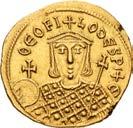
From the Gasvoda Collection. Ex HC Collection (Triton XXIII, 14 January 2020), lot 934, purchased from M. Geiger (1980).
774. Michael II the Amorian, with Theophilus. 820-829. AV Solidus (21mm, 4.38 g, 5h). Constantinople mint. Struck 821-829. Crowned facing bust of Michael, wearing chlamys, holding cross potent and akakia / Crowned facing bust of Theophilus, wearing loros, holding globus cruciger and cruciform scepter; Є at end of legend. DOC 5a; Füeg 4.A.1; SB 1640. Lustrous. In NGC encapsulation 6558567-008, graded Ch AU, Strike: 4/5, Surface: 2/5, edge marks. ($1000)


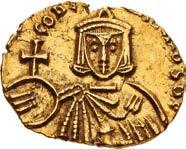


From the Gasvoda Collection. Ex Numismatik Naumann 81 (1 September 2019), lot 686.
775. Michael II the Amorian, with Theophilus. 820-829. Æ Follis (30.5mm, 8.19 g, 7h). Constantinople mint. Struck 821-829. Crowned facing busts of Michael, wearing chlamys, and Theophilus, wearing loros; cross above / Large M; cross above, X/X/X to left, N/N/N to right, Θ below. DOC 10; SB 1642. Attractive green-brown patina. Near EF. ($300)
From the Iconodule Collection.
776. Michael II the Amorian, with Theophilus. 820-829. Æ Follis (29mm, 8.19 g, 6h). Constantinople mint. Struck 821-829. Crowned facing busts of Michael, wearing chlamys, and Theophilus, wearing loros; cross above / Large M; cross above, X/X/X to left, N/N/N to right, Θ below. DOC 10; SB 1642. Dark brown-green patina, some faint smoothing marks on reverse. Near EF. ($300)

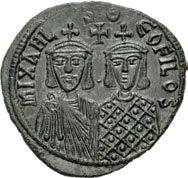
From the Iconodule Collection.

184
775
776
Füeg Plate Coin
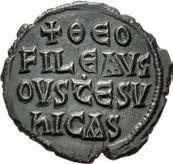
777. Theophilus, with Constantine. 829-842. AV Solidus (20.5mm, 4.47 g, 6h). Constantinople mint. Struck 830 or 831. * OЄOFI LOS ЬASILЄ´, crowned facing bust of Theophilus, wearing chlamys, holding patriarchal cross in right hand and akakia in left / + COҺSτ AҺτ´ ∂ЄSPO´ Λ, crowned facing bust of Constantine, wearing loros, holding patriarchal globus cruciger in right hand and cruciform scepter in left. DOC 2a; Füeg 2.C.3 (this coin illustrated); SB 1654. Lustrous, a couple of scuffs on reverse, some edge marks (possibly ex-mount). EF. Very rare. ($5000)




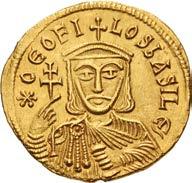
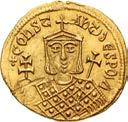
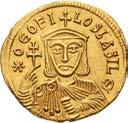
From the Gasvoda Collection, purchased from Herb Kreindler, August 2019.
778. Theophilus, with Constantine and Michael III. 829-842. AV Solidus (20mm, 4.55 g, 6h). Constantinople mint. Struck 830/1-840. Crowned facing bust of Theophilus, wearing chlamys, holding patriarchal cross and akakia; star at beginning of legend, Θ at end / Crowned facing busts of Michael and Constantine, each wearing chlamys; cross above. DOC 3d; Füeg 3.H.2.y; SB 1653. In NGC encapsulation 6558567-009, graded Ch AU, Strike: 4/5, Surface: 4/5, die shift. ($750)
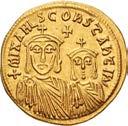

From the Gasvoda Collection, purchased from Herb Kreindler, August 2019.
779. Theophilus. 829-842. Æ Follis (28mm, 7.94 g, 7h). Constantinople mint. Struck 830/1-842. Half-length facing figure of Theophilus, wearing loros and tufa decorated with pellets, holding labarum and globus cruciger / Legend in four lines. DOC 15a; SB 1667. Brown-green patina. Good VF. ($300)
From the Iconodule Collection.
780. Theophilus. 829-842. AV Solidus (16mm, 3.78 g, 5h). Syracuse mint. Struck 831-842. Crowned facing bust of Theophilus, wearing loros, holding cross potent / Crowned facing bust of Theophilus, wearing chlamys, holding globus cruciger. DOC 24; Anastasi 530b; SB 1670. Lustrous. In NGC encapsulation 6558567-010, graded MS, Strike: 5/5, Surface: 3/5, edge smoothing, brushed. ($500)

From the Gasvoda Collection. Ex Jack A. Frazer Collection (Classical Numismatic Group Electronic Auction 465, 8 April 2020), lot 592; Ponterio 17 (30 November 1984), lot 185.
781. Theophilus. 829-842. AV Semissis (11.5mm, 1.74 g, 6h). Syracuse mint. Struck 831-842. Crowned facing bust of Theophilus, wearing loros, holding globus cruciger / Crowned facing bust of Theophilus, wearing loros, holding globus cruciger. DOC 26c.1; Anastasi 560; SB 1674. Good metal for issue. In NGC encapsulation 3811719-005, graded Ch MS, Strike: 5/5, Surface: 4/5. ($400)
From the Gasvoda Collection. Ex Heritage 3083 (24 April 2020), lot 32192.

185
778 779 780 781
782. Michael III “the Drunkard”, with Theodora and Thecla. 842-867. AV Solidus (19.5mm, 4.15 g, 6h). Constantinople mint. Struck 842-circa 843. Crowned facing bust of Theodora, wearing loros, holding patriarchal globus cruciger and cruciform scepter / Crowned facing bust of Michael, wearing chlamys, and holding globus cruciger, and crowned half-length figure of Thecla, to right, wearing loros, and holding patriarchal cross and akakia. DOC 1e; Füeg 1.B; SB 1686. Holed and repaired, overstuck on an earlier Constantinople mint solidus. VF. Very rare. ($4000)
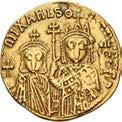
From the Gasvoda Collection. Ex Numismatica Ars Classica 75 (18 November 2013), lot 724; Sotheby’s (17 November 1983), lot 351.
783. Basil I the Macedonian, with Constantine. 867-886. AV Solidus (19mm, 4.41 g, 6h). Constantinople mint. Struck 868-879. Christ Pantokrator enthroned facing; star at end of legend / Crowned facing busts of Basil, wearing loros, and Constantine, wearing chlamys, holding patriarchal cross between them. DOC 2c; Füeg 3.C.14; SB 1704. In NGC encapsulation 6558569-005, graded Ch AU, Strike: 4/5, Surface: 5/5, die shift. ($750)
From the Gasvoda Collection. Ex Künker 326 (7 October 2019), lot 1845; Giessener Münzhandlung 64 (11 October 1993), lot 891.
784. Basil I the Macedonian, with Constantine. 867-886. AR Miliaresion (23mm, 3.01 g, 1h). Constantinople mint. Struck 868-879. Cross potent set on three steps on globe / Legend in six lines. DOC 7; SB 1708. Attractive cabinet tone with some light iridescence. In NGC encapsulation 6558569-009, graded Ch MS★, Strike: 5/5, Surface: 5/5. ($500)

From the Gasvoda Collection. Ex Phoibos Collection (Künker 326, 7 October 2019), lot 1847.
785. Basil I the Macedonian, with Constantine. 867-886. AR Miliaresion (23mm, 2.97 g, 12h). Constantinople mint. Struck 868-879. Cross potent set on three steps on globe / Legend in six lines. DOC 7; SB 1708. Iridescent toning, some minor doubling. EF. ($400)
From the Rome on the Euphrates Collection, purchased from Dennis Kroh in the 1980s.
786. Basil I the Macedonian. 867-886. Æ Follis (26mm, 7.10 g, 6h). Constantinople mint. Struck 879-886. Basil enthroned facing, wearing loros, holding labarum and akakia / Legend in four lines. DOC 12; SB 1709. Green-brown patina, some light smoothing marks. Near EF. ($300)



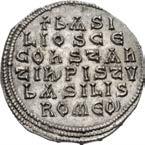
From the Iconodule Collection.
787. Leo VI the Wise, with Constantine VII. 886-912. AR Miliaresion (24mm, 2.93 g, 1h). Constantinople mint. Struck 908-912. Cross potent set on three steps on globe / Legend in five lines. DOC 4; SB 1727. Attractive old cabinet tone. In NGC encapsulation 6558569-007, graded AU, Strike: 4/5, Surface: 5/5, die shift. ($500)



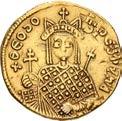

From the Gasvoda Collection, purchased from Edward J. Waddell, Ltd.

186
784
785
782
783
786
787
From the Gasvoda Collection. Ex Cherson Collection of I. K. (Roma E-Sale 68, 27 February 2020), lot 1336.
Rare Solidus of Alexander

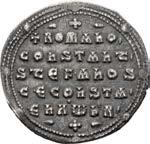


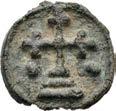
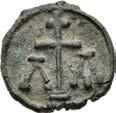

wearing loros, holding globus cruciger in right hand, being crowned by St. Alexander, to right, holding cross in left hand. DOC 2; Füeg 2.A;
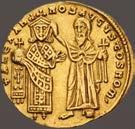

3/5, edge marks. Very rare. ($15,000)
From the Gasvoda Collection, purchased from Herb Kreindler, August 2019.
Alexander, the third son of Basil I, was co-emperor throughout his brother Leo VI’s reign, although he took no part in actual governing. Upon Leo’s death, he succeeded to the position of senior emperor, ruling alongside Leo VI’s young son Constantine VII. Byzantine sources are unanimous in proclaiming Alexander a self-indulgent drunkard, feckless and unfit to rule. He dismissed nearly all of Leo’s ministers and generals, whose diplomatic skills had kept the empire relatively stable and prosperous for the previous 25 years. He also broke a peace treaty with Bulgaria by refusing to pay tribute upon his accession, prompting a long and destructive war. He was spared witnessing the consequences of his folly, however, contracting a stomach ailment and dying after only a year and a month as senior ruler. His extremely rare gold solidi bear the only numismatic depiction of a Saint Alexander, who is shown crowning the emperor on the reverse. This probably represents Alexander of Constantinople, the first archbishop of that city, who lived in the time of Constantine the Great.
187
788. Leo VI the Wise. 886-912. Æ (18mm, 2.86 g, 12h). Cherson mint. Large patriarchal cross potent; Λ to left, A to right / Large cross-crosslet set on two steps; • to left, • to right. DOC 12.1-2; SB 1734. Earthen green-brown and red patina, a few minor flan flaws. Good VF. Very rare. ($300)
789. Alexander. 912-913. AV Solidus (21mm, 4.43 g, 5h). Constantinople mint. + IҺSXRS RЄX RЄςҺAҺτIЧm, Christ Pantokrator enthroned facing, raising right hand in benediction and holding Gospels in left / + ALЄXAҺd ROS AЧPЧSτOS ROm´, crowned figure of Alexander standing facing,
SB 1737. In NGC encapsulation 6558873-001, graded Ch XF, Strike: 5/5, Surface:
790. Constantine VII Porphyrogenitus, with Romanus I. 913-959. AV Solidus (19.5mm, 4.41 g, 6h). Constantinople mint. Struck 921. Christ Pantokrator enthroned facing / Crowned facing half-length busts of Romanus, wearing loros, and Constantine, wearing chlamys, holding patriarchal cross between them. DOC 4; Füeg 4; SB 1746. In NGC encapsulation 6558567-011, graded MS, Strike: 5/5, Surface: 4/5. ($1500)
From the Gasvoda Collection.
791. Constantine VII Porphyrogenitus, with Romanus I, Stephen, and Constantine. 913-959. AR Miliaresion (23.5mm, 2.79 g, 12h). Constantinople mint. Struck 931-944. Cross potent set of three steps on four pellets; in central medallion, crowned facing bust of Romanus, wearing loros / Legend in five lines. DOC 20; SB 1755. Old cabinet tone. In NGC encapsulation 6558569-006, graded AU, Strike: 5/5, Surface: 3/5, edge crimp. ($300)
From the Gasvoda Collection. Ex Jack A. Frazer Collection (Classical Numismatic Group Electronic Auction 456, 13 November 2019), lot 575.
790
791
792. Constantine VII Porphyrogenitus, with Romanus I. 913-959. AV Solidus (19.5mm, 4.43 g, 6h). Constantinople mint. Struck 945-959. Facing bust of Christ Pantokrator, three pellets in each arm of nimbus; five pellet signature at end of legend / Crowned facing busts of Constantine, wearing loros, and Romanus, wearing chlamys, holding patriarchal cross between them. DOC 15; Füeg 15.B.2 (Constantine VII and Romanus II); SB 1751. In NGC encapsulation 6558567-012, graded Ch AU, Strike: 5/5, Surface: 4/5. ($750)


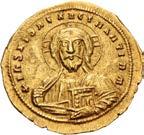
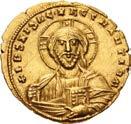

From the Gasvoda Collection. Ex Provence Collection (purchased privately).
793. Nicephorus II Phocas. 963-969. AV Histamenon Nomisma (20mm, 4.41 g, 5h). Constantinople mint. Facing bust of Christ Pantokrator / Facing half-length busts of the Theotokos and Nicephorus, wearing crown and loros, holding patriarchal cross between them. DOC 4; Füeg 3.C.3; SB 1778. In NGC encapsulation 6558567-013, graded Ch AU, Strike: 5/5, Surface: 4/5. ($1000)
From the Gasvoda Collection. Ex Numismatik Naumann 81 (1 September 2019), lot 694.
794. John I Zimisces. 969-976. AV Histamenon Nomisma (21mm, 4.34 g, 6h). Constantinople mint. Facing bust of Christ Pantokrator / Half-length facing bust of John, crowned and wearing loros, holding globus surmounted by trefoil, and the Theotokos, crowning and blessing John; above, manus Dei descending. DOC 1a; Füeg 1.A (same dies); BN 4 (same dies); SB 1787. Some marks and minor scratches, scuff on reverse, a couple of light edge scuffs and marks (possibly ex-mount). Near EF. Very rare. A seldom offered type and the first we have offered in twenty-five years. ($750)
795. John I Zimisces. 969-976. AV Histamenon Nomisma (22mm, 4.43 g, 6h). Constantinople mint. Facing bust of Christ Pantokrator / Half-length facing bust of John, crowned and wearing loros, holding long cross, and the Theotokos, crowning and blessing John; above, manus Dei descending. DOC 2; Füeg 2; SB 1786. In NGC encapsulation 6558567-014, graded Ch AU, Strike: 4/5, Surface: 4/5. Very rare. ($1000)
From the Gasvoda Collection, purchased from Herb Kreindler, August 2019. Ex Heritage 3035 (3 September 2014), lot 29602 (hammer $3250).
796. Basil II Bulgaroktonos, with Constantine VIII. 976-1025. AV Histamenon Nomisma (27mm, 4.44 g, 6h). Constantinople mint. Struck 1005-1025. Facing bust of Christ Pantokrator, upturned crescents in upper two quarters of nimbus / Crowned half-length busts of Basil, wearing loros, with suspended crown above head, and Constantine, wearing chlamys, holding long cross between them. DOC 6a; Füeg II 6.B; SB 1800. In NGC encapsulation 6558569-004, graded Ch AU, Strike: 5/5, Surface: 4/5, wavy flan. ($1000)

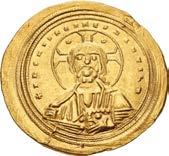
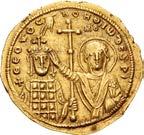

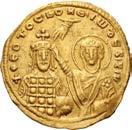

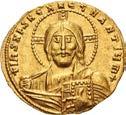
From the Gasvoda Collection. Ex Roma XVIII (29 September 2019), lot 1310.
797. Basil II Bulgaroktonos, with Constantine VIII. 976-1025. AV Histamenon Nomisma (24.5mm, 4.42 g, 6h). Constantinople mint. Struck 1005-1025. Facing bust of Christ Pantokrator; upturned crescents in upper two quarters of nimbus cross / Crowned half-length busts of Basil, wearing loros, with suspended crown above head, and Constantine, wearing jeweled chlamys, holding long cross between them. DOC 6a; Füeg II 6.B1; SB 1800. Obverse double struck, singular light scratch on obverse and reverse. EF. An exceptionally early and vibrant strike. Most interestingly featuring a die engraver’s spacing line in a crescent shape spanning the two rulers’ shoulders. Similar in function to a die engraver’s centering circle and only seen on especially early strikes. ($1500)
Ex Triton XVII (6 January 2014), lot 884 (hammer $3250); Bowers & Merena (13 September 1993), lot 15.
188
792 793 794 795 796 797
798. Anonymous Folles. temp. Basil II & Constantine VIII, circa 976-1025. Æ Follis (25mm, 10.70 g, 6h). Constantinople mint. Facing bust of Christ Pantokrator; two pellets on book, one pellet in bars of nimbus / Legend in four lines. DOC A2.1/ A2.9 (obv./rev.); SB 1818. Attractive partial brown-green patina with some minor spots of bare metal showing, some faint smoothing marks. Near EF. ($300)

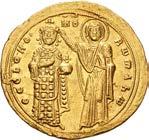

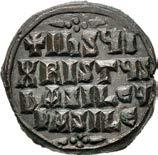
From the Iconodule Collection.
799. Constantine VIII. 1025-1028. AV Histamenon Nomisma (24mm, 4.40 g, 6h). Constantinople mint. Facing bust of Christ Pantokrator, upturned crescents in upper two quarters of nimbus / Crowned facing bust of Constantine, wearing jeweled loros, holding labarum and akakia. DOC 1; Füeg II 1.A.7; SB 1815. Some luster. In NGC encapsulation 6558567-015, graded AU, Strike: 5/5, Surface: 2/5, wrinkled, edge marks. ($600)
From the Gasvoda Collection. Ex Jack A. Frazer Collection (Classical Numismatic Group Electronic Auction 460, 29 January 2020), lot 848; Berk BBS 32 (12 June 1984), lot 30.
800. Romanus III Argyrus. 1028-1034. AV Histamenon Nomisma (23.5mm, 4.43 g, 6h). Constantinople mint. Christ Pantokrator enthroned facing / Romanus, placing hand on breast and holding globus cruciger, standing facing, being crowned and blessed by the Theotokos, nimbate; seven pellets in loros end; M Θ, each with macron above, in upper field. DOC 1b; Füeg II 1.D.7.y; SB 1819. Lustrous. In NGC encapsulation 6558568-001, graded MS, Strike: 5/5, Surface: 5/5. ($500)
From the Gasvoda Collection. Ex Künker 326 (7 October 2019), lot 1860.
801. Constantine IX Monomachus. 1042-1055. AV Histamenon Nomisma (29mm, 4.41 g, 5h). Constantinople mint. Struck 1042-1046. Christ Pantokrator enthroned facing / Crowned facing bust, wearing loros, holding cruciform scepter with tendril ornament and patriarchal globus cruciger. DOC 1a; Füeg II 1.B; SB 1828. In NGC encapsulation 6558568-002, graded MS, Strike: 4/5, Surface: 3/5, die shift, edge crimps. ($500)

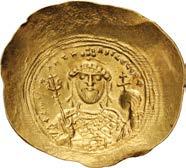



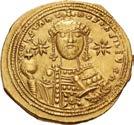

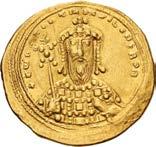
From the Gasvoda Collection. Ex Leu Numismatik Web Auction 13 (15 August 2020), lot 1660.
A Celestial Event – The Supernova of 1054
802. Constantine IX Monomachus. 1042-1055. AV Histamenon Nomisma (21mm, 4.41 g, 6h). Constantinople mint. Struck circa 1054-1055. Facing bust of Christ Pantokrator / Crowned facing bust of Constantine, holding globus cruciger and sword; two stars flanking crown. DOC 4b; Füeg II 4.B.2; SB 1831. In NGC encapsulation 6558872-004, graded MS★, Strike: 5/5, Surface: 4/5. Rare. ($3000)
From the Gasvoda Collection. Ex Classical Numismatic Group 117 (19 May 2021), lot 723.
The meaning of the stars that appear on these rare histamena flanking the imperial bust has been a matter of much discussion. Hendy (DOC III, p. 734) suggested that they represented the 1054 appearance of SN 1054, a celestial event that was widely seen and recorded by Chinese, Japanese, and Arab astronomers, as well as the Mimbres and Anasazi in North America. Visible even in daylight from when it first appeared in the constellation of Taurus on 4 July 1054 until it faded in April 1056, Grierson (DOC III, p. 736) concluded that the supernova could not have escaped the notice of anyone interested in astronomy and “may conceivably have found its way onto the coins [since] the dates, at all events, seem to agree.”
189
798 799 800 801
803. Theodora. 1055-1056. AV Histamenon Nomisma (24mm, 4.41 g, 6h). Constantinople mint. Christ standing facing on suppedion, holding Gospels / Theodora, wearing crown and loros, and the Theotokos standing facing, holding between them a labarum with pellet on shaft and beneath; M Θ, each with macron above, flanking the Theotokos’ head. DOC 1a; Füeg II 1.C; SB 1837. In NGC encapsulation 6558568-004, graded Ch AU★, Strike: 5/5, Surface: 4/5. ($4000)
From the Gasvoda Collection, purchased from Numismatica Genevensis SA, January 2020. Ex Vinchon (13 April 1991), lot 48.
804. Theodora. 1055-1056. PB Seal (32mm, 35.54 g, 12h). Facing bust of Christ Pantokrator / Half-length facing bust of Theodora, wearing ornate crown and jeweled loros, holding ornate cruciform scepter. BLS 82; DOCBS –. Even tan surfaces with a few minor spots of roughness. Good VF. Remarkably clear. Comparable in quality to the other two examples cited in BLS, one of which is in the British Museum. ($500)

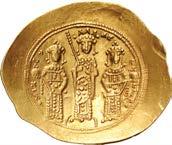

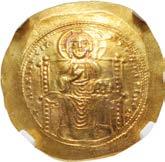
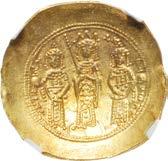

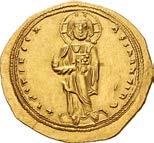

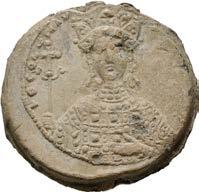
805. Eudocia, with Michael VII and Constantius. 1067. AV Histamenon Nomisma (26mm, 4.39 g, 6h). Constantinople mint. Christ Pantokrator enthroned facing / Crowned facing figures of Eudocia, holding jeweled scepter, standing facing on suppedion, flanked by her sons Michael, to left, holding globus cruciger and akakia, and Constantius, to right, holding akakia and globus cruciger, all wearing loros. DOC 1; Füeg II 1.y; SB 1857. Lustrous, attractive red-gold toning, well centered and struck. In NGC encapsulation 6057862-008, graded MS★, Strike: 5/5, Surface: 4/5. ($1500)
From the Gasvoda Collection. Ex Heritage 3094 (19 August 2021), lot 34332.
806. Eudocia, with Michael VII and Constantius. 1067. AV Histamenon Nomisma (28mm, 4.37 g, 6h). Constantinople mint. Christ Pantokrator enthroned facing / Crowned facing figures of Eudocia, holding jeweled scepter, standing facing on suppedion, flanked by her sons Michael, to left, holding globus cruciger and akakia, and Constantius, to right, holding akakia and globus cruciger, all wearing loros. DOC 1; Füeg II 1.y2; SB 1857. In NGC encapsulation 6558872-001, graded AU, Strike: 4/5, Surface: 2/5, scratches. ($2000)
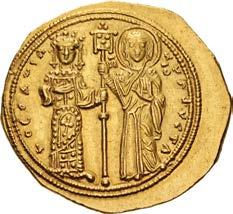
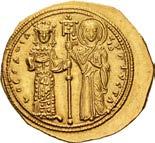
From the Gasvoda Collection. Ex Classical Numismatic Group 118 (13 September 2021), lot 1225.
Very Rare Fractional Miliaresion
807. Romanus IV Diogenes. 1068-1071. AR 1/3 Miliaresion (16.5mm, 0.84 g, 6h). Constantinople mint. Half-length bust of the Theotokos, orans / Crowned facing half-length bust of Romanus, wearing loros, holding patriarchal cross and globus cruciger; border decorated by four evenly spaced Δ’s. DOC 7; SB 1865A. Toned, find patina, some minor marks. Good VF. Very rare. An excellent example for this difficult type. ($1000)
From the Gasvoda Collection. Ex Leu Numismatik 7 (24 October 2020), lot 1969.

190
805 806
808.
VII
1071-1078. EL Histamenon Nomisma (30mm, 4.39 g, 7h). Constantinople mint. Facing bust of Christ Pantokrator / Crowned facing bust of Michael, wearing jeweled loros, holding labarum with pellet on shaft and globus cruciger. DOC 2d; SB 1868. In NGC encapsulation 6558568-005, graded MS, Strike: 5/5, Surface: 4/5. ($500)
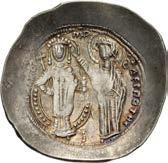
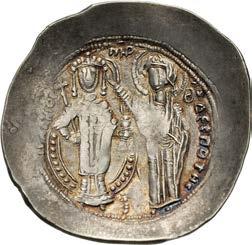

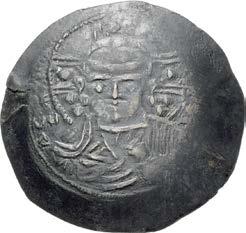




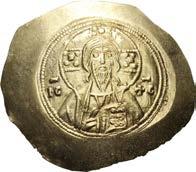
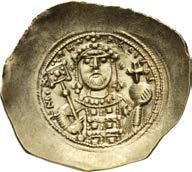
From the Gasvoda Collection. Ex Classical Numismatic Group Electronic Auction 446 (19 June 2019), lot 471.
809. Alexius I Comnenus. 1081-1118. EL Histamenon Nomisma (26mm, 4.24 g, 6h). Thessalonica mint. Struck 10821087. Facing bust of Christ Pantokrator / St. Demetrius standing right, holding sword and presenting patriarchal cross set on globe on two steps to Alexius, standing facing, wearing crown and loros. DOC 5a; SB 1905. Attractive iridescent toning, flan crack. Near EF. ($300)
From the Gasvoda Collection. Ex Künker 326 (7 October 2019), lot 1881.
810.
in
1185-1191. EL Aspron Trachy (27mm, 4.44 g, 6h). Nicosia mint(?). Struck 1187-circa 1191. Full length figure of Christ standing facing on suppedion, raising right hand in benediction and holding Gospels in left; IC - XC, each with macron above and star beneath, flanking head of Christ / ICAAKIOC ΔECΠOTHC, full length facing figures of Isaac, to left, wearing crown and chlamys, holding cruciform scepter in right hand and akakia in left, being crowned by the Theotokos, to right; MP ΘV, each with macron above, flanking the head of the Theotokos. DOC 1 bis 1-2; NumCirc
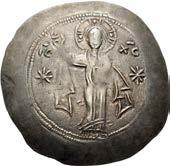
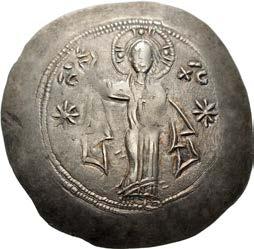
(May 1989), p. 117, fig. A-B; SB –. Toned. In NGC encapsulation 6558560-002, graded Ch VF, Strike: 3/5, Surface: 5/5. Extremely rare. Known from only four examples including this coin, which features a complete legend. ($7500)
From the Gasvoda Collection. Ex Numismatik Naumann 82 (6 October 2019), lot 826 (hammer $12,000).
Ex Bendall and Slocum Collections
Rare and attractive for issue. Among the finest known. ($2000)
191
Michael
Ducas.
Isaac Comnenus. Usurper
Cyprus,
XCVII.4
811. Isaac Comnenus. Usurper in Cyprus, 1185-1191. BI Aspron Trachy (26.5mm, 3.75 g, 6h). Nicosia mint(?). Struck 1187-circa 1191. Facing bust of Christ Pantokrator / Isaac standing facing, holding cruciform scepter and akakia; manus Dei to upper right. DOC 3; SB 1992. Dark brown patina, minor flan crack. Good VF.
808 809
From the Gasvoda Collection. Ex Simon Bendall Collection (Classical Numismatic Group 115, 16 September 2020), lot 781 (hammer $6,000); Numismatica Ars Classica 56 (8 October 2010), lot 833; John J. Slocum Collection (Sotheby’s, 14 October 1999), lot 180.
812. Isaac II Angelus. First reign, 1185-1195. AV Hyperpyron (25mm, 4.38 g, 6h). Constantinople mint. The Theotokos enthroned facing, holding head of the Holy Infant on lap; M P - Θ V, each with macron above, flanking head of the Theotokos / Isaac, wearing crown and loros, holding cruciform scepter and being crowned by manus Dei above, and the Archangel Michael standing facing, holding sword in sheath between them. DOC 1d; SB 2001. In NGC encapsulation 6558568-006, graded MS, Strike: 4/5, Surface: 4/5. ($400)

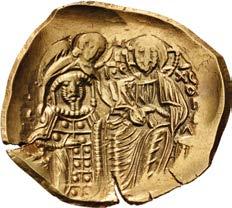
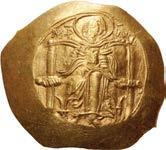
From the Gasvoda Collection. Ex Leu Numismatik Web Auction 11 (22 February 2020), lot 2212.
813. Michael VIII Palaeologus. 1261-1282. AV Hyperpyron (24mm, 4.26 g, 6h). Constantinople mint. The Theotokos enthroned facing, holding medallion of Holy Infant on lap; sigla: B | B / Michael standing facing, being presented by St. Michael, who stands behind him, to Christ enthroned left, holding scroll. DOC 1 var. (sigla); LBC 485 (same rev. die as illustration); PCPC 3B (same rev. die as illustration); SB 2241. A few flan cracks. Good VF. Very rare. ($2000)
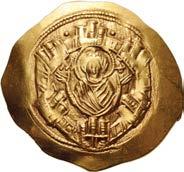

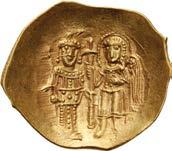

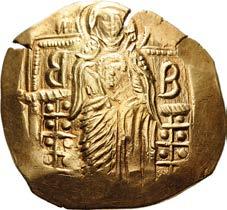
From the Gasvoda Collection.
814 815
814. Michael VIII Palaeologus. 1261-1282. AV Hyperpyron (28.5mm, 4.39 g, 6h). Constantinople mint. Half-length figure of the Theotokos, orans, within city walls with six towers, MP - Θ flanking head of the Theotokos; sigla: • | • / Michael kneeling slightly right, being presented by the Archangel Michael, standing behind, to Christ, seated facing to right, holding scroll; M to right of the head of the Archangel Michael; IC - X, each with macron above, flanking head of Christ. DOC Class IIa var. (unlisted sigla); PCPC 4 (sigla 29); SB 2242. In NGC encapsulation 6558568-007, graded Ch AU, Strike: 4/5, Surface: 3/5, marks, edge crimps. Exceptional for issue. ($1500)
From the Gasvoda Collection. Ex Classical Numismatic Group 114 (13 May 2020), lot 1065.
815. Michael VIII Palaeologus. 1261-1282. AR Trachy (23mm, 2.67 g, 12h). Constantinople mint. St. Michael the Archangel standing facing, holding sword over right shoulder and shield or scabbard; M/I - X, each with macron above, flanking / Michael VIII standing facing, wearing loros, holding cross-tipped scepter and akakia. Cf. DOC 114-24 (for obverse type; Æ Trachea); cf. BTM C.23-4 (for obverse type) and C.25 (for reverse); cf. NumCirc XC.4 (May 1982), p. 121-4, fig. 5 (for obverse type); cf. SB 2283 and 2285 (for obverse and reverse type respectively; Æ Trachea). Toned, double struck, areas of weakness, minor edge split. Good VF. Apparently unique, the only example in CoinArchives. ($2000)

From the Gasvoda Collection. Ex Triton XXIII (14 January 2020), lot 940; Savoca 24 (29 July 2018), lot 564; Triton XIII (5 January 2010), lot 459.
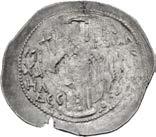
192
816. Andronicus II Palaeologus, with Michael IX. 1282-1328. AR Basilikon (19mm, 1.52 g, 6h). Constantinople mint. Christ Pantokrator enthroned facing; IC - XC, each with macron above, flanking head of Christ; sigla: triple pellets | triple pellets / Crowned standing figures of Andronicus, to left, and Michael, to right, both wearing loros, placing hand on chest, and holding long cross between them. DOC –; LBC 760; LPC p. 66, 5; PCPC 133 var. (sigla); NumCirc LXXX.12 (December 1972), p. 4523, 3 SB 2401. Toned. In NGC encapsulation 6558569-015, graded Ch XF, Strike: 5/5, Surface: 4/5. Very rare. ($1000)
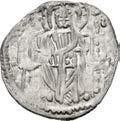

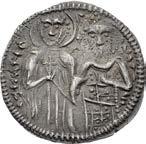

From the Gasvoda Collection. Ex Iconodule Collection (Triton XXIII, 14 January 2020), lot 941.


817. John V Palaeologus. 1341-1391. AR Basilikon (15.5mm, 1.03 g, 6h). Constantinople mint. Struck circa late 1341. Full-length facing figures of St. Demetrius, to left, holding cross before chest, and Andronicus III, to right, wearing crown and loros / Half-length figure of John, wearing loros, holding labarum and globus cruciger; above, Christ with hands outstretched over John; IC - XC, each with macron above, flanking head of Christ. DOC 944; LPC p. 120, 7 (Andronicus III); PCPC 199 (Andronicus III); SB 2474 (Andronicus III). Toned. In NGC encapsulation 6558569-012, graded Ch XF, strike: 4/5, Surface: 3/5. Very rare. ($2000)
From the Gasvoda Collection. Ex Malcolm W. Heckman Collection (Classical Numismatic Group 118, 13 September 2021), lot 1227; Classical Numismatic Group Electronic Auction 307 (24 July 2013), lot 381.
For DOC’s attribution to John V see DOC V.1 pp. 176-9
818. John V Palaeologus, with Anna of Savoy (Regent). 1341-1391. AR Basilikon (19mm, 0.86 g, 6h). Constantinople mint. Struck 1341-1347. Christ Pantokrator enthroned facing; IC - XC, each with macron above, flanking head of Christ / Anna standing facing to left, holding trefoil scepter, and John, standing facing to right, holding akakia and cruciform scepter. DOC 1103–44; LPC p. 132, 2; PCPC 277; SB 2503. Lightly toned, some usual weakness. Near EF. ($750)
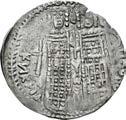



From the Gasvoda Collection. Ex Leu Numismatik 7 (24 October 2020), lot 1972.
819. John V Palaeologus, with John VI. 1341-1391. AR Basilikon (21mm, 1.29 g, 6h). Constantinople mint. Struck 1347-1353. Christ Pantokrator enthroned facing; sigla: B | B / Crowned facing figures of John VI, to left, holding labarum, and John V, to right, holding labarum scepter, each wearing loros and holding akakia between them. DOC V.1 p. 185, 10; LPC –; PCPC –; NumCirc CVI.3 (April 1998), p. 102, 1; SB –. Attractively toned, some usual doubling, minor areas of weakness. Good VF. Extremely rare. ($1000)
From the S & S Collection.
193
818
819
Unique Variety
820. John V Palaeologus, with John VI. 1341-1391. AR Basilikon (19mm, 1.37 g, 12h). Constantinople mint. Struck 1347-1353. Christ Pantokrator standing facing within mandorla / Crowned facing figures of John V, to left, holding cruciform scepter, and John VI, to right, holding cruciform scepter, each wearing loros and holding long cross between them. Cf. DOC V.1 p. 184, 2 (for obv. type); cf. LBC 850 (for similar type); cf. LPC p. 140, 3 (for obv. type); cf. PCPC 288 (for similar type); NumCirc CVI.3 (April 1998), p. 102, 2 (same); cf. SB 2529A (same). Lightly toned, areas of weakness, light scratches. Near VF. Extremely rare. Presently only known from this example. ($500)
From the Iconodule Collection.
This interesting Basilikon features the two emperors holding cruciform scepters rather than the more prevalent labarum on similar types. Additionally, whereas the type with the rulers each holding a labarum features the two rulers holding a staff between them, on this example one finds a long cross similar to the one illustrated in LPC p. 140-1, 4. Finally, while the most similar types place John VI on the left and John V on the right, on this example, John V appears on the left as in the NumCirc example.
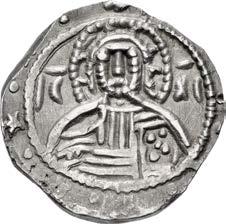
821. John V Palaeologus. 1341-1391. AR Stavraton (23.5mm, 8.22 g, 6h). Class IIb. Constantinople mint. Struck 1379-1391. Facing bust of Christ Pantokrator; IC - XC, each with macron above, flanking head of Christ / Crowned and nimbate facing bust of John; sigla: • | •. DOC 1273-5 (same rev. die); PCPC 306 (sigla 3); SB 2510. Lightly toned. In NGC encapsulation 6558569-013, graded AU, Strike: 4/5, Surface: 4/5, light scuff. ($1500)
From the Gasvoda Collection. Ex Iconodule Collection (Triton XXV, 11 January 2022), lot 1081.
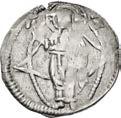
822.
1391-1425. AR Eighth Stavraton (14.5mm, 0.88 g, 12h). Light (Class II) Coinage. Constantinople mint. Struck 1403-1425. Facing bust of Christ Pantokrator; IC - XC, each with macron above, flanking head of Christ; sigla: C | Π / Crowned facing bust of Manuel; sigla: • | •. DOC 1543-1588; PCPC 335.4-5 (sigla 63); SB 2553. Toned, holed. Good VF. ($400)
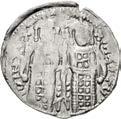

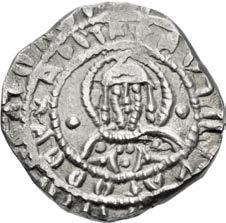
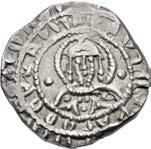

From the Gasvoda Collection. Ex Italo Vecchi Collection (Roma E-Sale 75, 15 October 2020), lot 1006.

194
Manuel II Palaeologus.
Ex Constantine XI Hoard – Published by Bendall

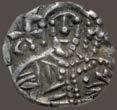

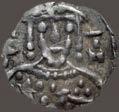
823. Constantine XI Palaeologus (Dragases). 1448-1453. AR Stavraton (21mm, 6.77 g, 12h). Constantinople mint. Facing bust of Christ Pantokrator; IC - XC, each with macron above, flanking head of Christ / [KωNCTANTINOC ΔЄCΠOTHC O ΠAΛЄOΛOΓ] / [ΘV XAPITH] BACIΛЄV[C POMЄON], crowned facing bust of Constantine. DOC 1787 var. (sigla); Bendall, Coinage 93 (this coin); LBC 1095 var. (same); PCPC –; SB –. Attractively toned. In NGC encapsulation 6558565-001, graded AU, Strike: 3/5, Surface: 5/5. Very rare. ($30,000)
From the Gasvoda Collection. Ex Long Valley River Collection (Roma XX, 29 October 2020), lot 761, purchased from Harlan J. Berk, 16 July 1990; Constantine XI hoard (1991).
Constantine XI, a member of the last Byzantine dynasty, the Palaeologian, was a heroic figure despite being fated to be the terminal Byzantine ruler. One of the younger sons of Emperor Manuel II, Constantine distinguished himself during the siege of Constantinople in 1422 during the last days of Manuel II’s rule. After Manuel suffered a stroke and became incapable of governing, Constantine’s older brother, future emperor John VIII, took the reins of the government on behalf of his father. However, John’s first priority was to seek to rally support for the Byzantine state against the ascendant Ottomans. In pursuit of this objective, he embarked on a tour of Western Europe. In his stead, he left his younger brother Constantine as regent and granted him the title of despot. Constantine effectively administered what was left of the shrinking Byzantine State in his brother’s absence, but John’s quest to enlist western support for Byzantium was ultimately unsuccessful.
Once John assumed the imperial mantle upon the death of Manuel II, Constantine was tasked with governing one of the few remaining possessions of the once-illustrious Byzantine Empire—the Depostate of Morea. Constantine again proved himself a capable ruler and administrator, using the limited resources he had at his disposal to recover Morea from the Franks who had occupied the Peloponnesos since the Fourth Crusade. Ultimately, Constantine’s Morea encompassed the entire Pelponnesos and, along with Epirus, constituted the bulk of Byzantine possessions outside of Constantinople which was itself quickly shrinking into a city-state as more and more territory was lost to the Ottomans.
When John died in 1448 without issue, Constantine was designated as his successor and called to assume the fateful position of emperor. Crowned at the citadel at Mystras, Constantine traveled from Morea to Constantinople in a hired Catalan galley—a succinct representation of how miserably Byzantine power had dwindled by the mid 15th century. All Constantine could do as emperor was prepare for the inevitable attack by the Ottomans. He worked to repair the city walls and recruit and muster as many soldiers as possible to mount his final defense of the city. As part of that effort, coins such as this rare example were minted to pay the mostly hired soldiers.
The attack came in late May of 1453. Constantine himself manned the ramparts and fought valiantly during the city’s final defense. He was ultimately killed upon the city walls and his corpse mutilated by the invaders. Thus ended the Byzantine Empire, an institution that lasted nearly a millennium and outlasted its parent Western Roman Empire by five centuries.
824. Constantine XI Palaeologus (Dragases). 1448-1453. AR Eighth Stavraton (12mm, 0.60 g, 6h). Constantinople mint. Facing bust of Christ Pantokrator, holding Gospels in both hands; IC - XC, each with macron above, flanking head of Christ / Crowned facing bust of Constantine; K/I | T/N flanking. DOC 1789; Bendall, Coinage 105-6 var. (sigla); LBC –; PCPC –; SB –. In NGC encapsulation 6057866-005, graded Ch XF, Strike: 4/5, Surface: 4/5. Two outstanding portraits for issue. Very rare. ($7500)
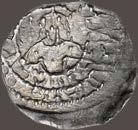
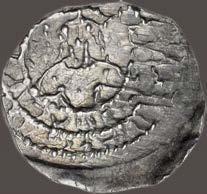
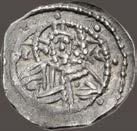
From the Gasvoda Collection. Ex Heritage 3094 (19 August 2021), lot 33123.
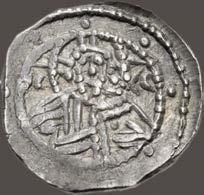
195
823
824
EARLY MEDIEVAL COINAGE
825. LOMBARDS, Tuscany. Municipal coinage. Circa 700-750. AV Tremissis (27mm, 1.45 g, 6 or 12h). Lucca mint.






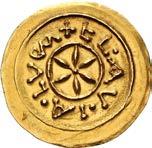


Fl · &¨ · 5& · l¨ · 1&, stellate symbol within circle / ¨5¨5¨5¨5¨5¨5¨5¨5, cross potent. Bernareggi, Tremissi –; Bernareggi, Moneta –; Bernareggi 204 var. (obv. legend); Arslan –; BMC Vandals –; MEC 1, –; CNI XI –; MIR –; Bellesia, Lucca, 2/D (this coin illustrated). Light toning in devices. EF. Extremely rare. ($5000)
Ex Triton XX (8 January 2017), lot 1128.
826. MEROVINGIANS, Clermont-Ferrand. Circa 560-585. AV Tremissis (11mm, 1.2312 g, 12h). Uncertain moneyer.
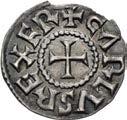

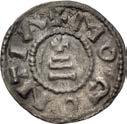


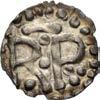

[...] ˞⌴VƩ⍛ [...], diademed and draped bust right / ม [...] ⌴Ƀ [...] © [...], Victory standing right, holding spear; star to left. Cf. NM 1 ([Childebert II] for type); cf. Belfort 327 (same); Prou –; MEC 1, –; cf. CNG 94, lot 1565; cf. Hess-Divo 313, lot 313 = Bruun Rasmussen 774, lot 5291 (same). Toned, struck with worn and rusty dies. Near VF. Extremely rare. ($1000)
827. MEROVINGIANS, Quentovic. Circa 585-675. AV Tremissis (13mm, 1.31 g, 9h). Dutta, moneyer. ๘ XƩXVVƩ⍛⌴˞ , diademed head right; two pellets below / ๘ ⌴V˶˶© ©©⌴Ve˶© (sic), cross pattée; ©X© below. NM 9; Lafaurie, VVic, Type IXc, 83-5; 87-8 (same obv. die); Belfort 2198; Prou 1141; EMC 2011.0127 = Coin Register 2011, 47 (this coin). Earthen deposits in devices, obverse struck with rusty die. Good VF. ($1000)
Found near Ipswich, 2011.
828. CAROLINGIANS. Pépin ‘le Bref’ (the Short). King of the Franks, 754/5-768. AR Denier (16mm, 0.95 g, 11h). Uncertain mint, possibly St. Denis. Large ⎁ ; ʖ ; above, ! with • at each end; • below ⎁ ; ˘ below ʖ / ( ©V˶ )/ ˶⌴ባ ••/ Ⱦℽ in three lines between two ! with • at each end. Cf. Depeyrot 892/2; cf. M&G 47; cf. Gariel, pl. I, 1-7; cf. Prou 2-4; MEC 1, 720 (all refs. for type). Iridescent toning, struck on a slightly ragged flan. Good VF. ($3000)
829. CAROLINGIANS. Charlemagne (Charles the Great). As Charles I, King of the Franks, 768-814. AR Denier (21mm, 1.51 g, 3h). Class 3. Mogontia[cum] (Mainz) mint . Struck 793/4-812. แ ⍛©⎁ǮVs ⎁⍟ҟ Ŋ⎁ , Ǔ²⎁⌴ǮVs monogram / แ ȵ⌴g⌴n˶Ʃ© , cross pattée set on three steps. Coupland, Charlemagne 7b/12; Depeyrot 577; M&G 91; MEC 1, 742. Iridescent toning. VF. Rare. ($2000)
Ex Gordon Andreas Singer inventory 132487750 (ND).
830. CAROLINGIANS. Charles le Chauve (the Bald). As Charles II, King of West Francia, 840-877. AR Denier (21mm, 1.64 g, 6h). Type A. Metullo (Melle) mint. แ ⍛©⎁ǮVs ⎁⍟ҟ Ŋ⎁ , cross pattée / แ ȵe˶VǮǮ⌴ , Ǔ²⎁⌴ǮVs monogram. Depeyrot 606; M&G 1063; MEC 1, 924. Deep iridescent toning, slight edge loss. EF ($300)
Ex Gordon Andreas Singer inventory 12131275 (ND).
196
826 827 829 830
831. CAROLINGIANS. Charles le Chauve (the Bald). As Charles II, King of West Francia, 840-877. AR Denier (20mm, 1.71 g, 4h). Class 2. Lugduni Clavati (Laon) mint. Struck 864-877 and later. แ Ŷ⎁©⍆I© ĕ!I ⎁⍟ҟ , Ǔ²⎁⌴ǮVs monogram / ส ǮVŶĕVnI æǮ©V©⍆I , cross pattée. Depeyrot 482; M&G 794; MEC 1, 869. Iridescent toning, tiny green deposit, a couple of die breaks, slightly wavy flan. EF. ($300)
832. CAROLINGIANS. Charles le Chauve (the Bald). As Charles II, King of West Francia, 840-877. AR Denier (21mm, 1.71 g, 12h). Class 2. Cinomanis (Le Mans) mint. Struck 864-877. แ Ŷ⎁©⍆I© ĕ!I ⎁⍟ҟ , Ǔ²⎁⌴ǮVs monogram / ส æInℽȵ©nI⌽ æIVI⍆©⌽ , cross pattée. Depeyrot 559; M&G 905; MEC 1, 872-4. Iridescent toning, small die break on obverse, slightly wavy flan. Near EF. ($300)
833. CAROLINGIANS. Charles le Chauve (the Bald). As Charles II, King of West Francia, 840-877. AR Denier (20mm, 1.71 g, 4h). Class 2. Rotumacus (Rouen) mint. Struck 864-877 and later. แ Ŷ⎁©⍆I© ĕ!I ⎁⍟ҟ , Ǔ²⎁⌴ǮVs monogram / ส ⎁⌴⍆⌴ȵ / ©æV⌽ æIVII , cross pattée. Depeyrot 878; M&G –; MEC 1, 893. Deep iridescent toning, slightly wavy flan. Near EF. ($300)
834. CAROLINGIANS. Charles le Chauve (the Bald). As Charles II, King of West Francia, 840-877. AR Denier (20mm, 1.72 g, 4h). Class 2. S[an]c[t]i Dionysii (St. Denis) mint. Struck 864-877 and later. แ Ŷ⎁©⍆I© ĕ!I ⎁⍟ҟ , Ǔ²⎁⌴ǮVs monogram / ส sæI ባI⌴nѝsII ȵ , cross pattée. Depeyrot 896; M&G 843; MEC 1, 897. Iridescent toning, traces of deposits. Good VF. ($300)
835. CRUSADERS, Antioch. Levon I of Armenia. 1198-1219. BI Denier (19mm, 0.82 g, 6h). Sis mint, but struck for use in Antioch. แ Ǯģɦ ēģƩ Ż⎁˶Ʃ² (sic), cross pattée / แ ⎁ģX ²⎁ȵģɃƩɦ⎁ , crowned facing head; crown with pendilia. AC 281 var. (obv. legend); CCA 9 var. (same); MAC 33 var. (same); CCS 133a var. (same); CNG 115, lot 823 (same rev. die); CNG 85, lot 100. Lightly toned, deposits, light porosity, areas of weak strike, tiny edge chip. Good VF. Extremely rare. ($3000)
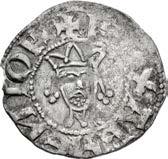
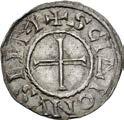


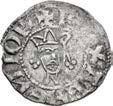



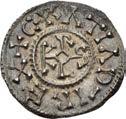

When Levon was granted the title of king of Armenia, he took the assumption that this entitled him to the crusader principality of Antioch as well. Despite two assaults on the city in 1203 and 1208, Levon was never able to capture it and enforce his claim against Bohémond IV. These rare western-style deniers were most likely struck at Sis for circulation in the Antiochene territory that Levon did hold.

836. CRUSADERS, Latin Kingdom of Jerusalem. temp. Sybelle. 1186-1190. BI Denier (19mm, 1.04 g, 12h). Struck during the siege of Jerusalem, 1187. DID[...] SIRVT + (sic), Tower of David / +[SEP]V[LCHRVM DO]MINI, view of the Church of the Holy Sepulcher. Metcalf, Crusades, p. 77; cf. C.J. Sabine, “Numismatic iconography of the Tower of David and the Holy Sepulchre,” NC 1979, pl. 17, 3; N. du Quesne Bird, “Two deniers from Jerusalem, Jordan,” NumCirc LXXIII.5 (May 1965), p. 109; Slocum 288; CCS 51. Iridescent toning, light porosity, areas of peripheral flat strike. VF. Great metal for issue. Very rare. ($5000)
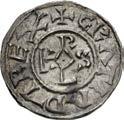

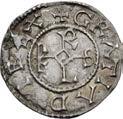
End of Session 3
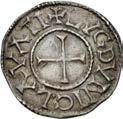
197
831 832 833 834
Ex
Session 4 – Wednesday, May 24, 2023 — 2 PM
WORLD COINAGE
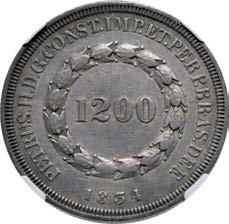
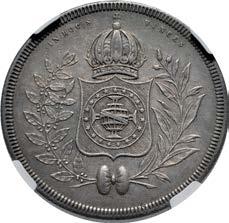


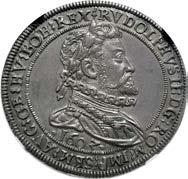
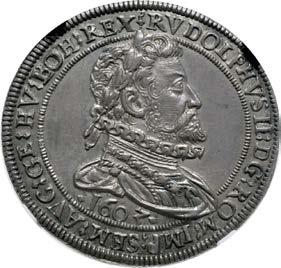
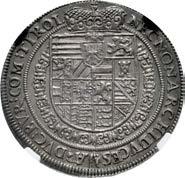
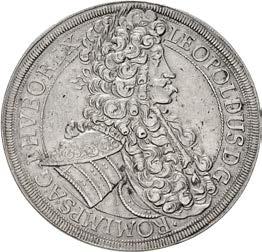

198
837. AUSTRIA, Holy Roman Empire. Rudolf II. Emperor, 1576-1611. AR Quarter Taler (30mm, 12h). Dated 1603 Crowned and collared coat-of-arms. Moser & Tursky 356; Moser & Tursky, Rudolf R284; KM 44. Rich cabinet toning. In NGC encapsulation 21258746-026, graded MS 61. Very rare, especially in this condition. ($1500)
Koehlmoos Collection (Sincona 76, 17 May 2022), lot 1386 (hammer 2000 CHF); Meister & Sonntag 9 (26 May 2010), lot 982.
838. AUSTRIA, Holy Roman Empire. Leopold I. Emperor, 1658-1705. AR Taler (43mm, 29.00 g, 12h). Wien (Vienna) mint. Dated 1704. Laureate and armored bust right / Crowned double-headed eagle facing, wings spread, holding sword and scepter; crowned and collared coat-of-arms on breast. Herenik 603; Davenport 1001; KM 1413. Lightly toned, a few hairlines. Good VF. ($500)
839. BOLIVIA, Colonial (as Alto Perú). Felipe IV. King of Spain, 1621-1665. AR 8 Reales (39mm, 26.54 g, 9h). Potosí mint. Struck 1650-1651. Crowned coat-of-arms; P/Θ to left, 8/Θ to right / Arms of Spain within angled quadrilobe. Menzel Po-250; KM 19b. In PCGS encapsulation 46027381, graded VF 35. ($300)
840. BRAZIL, Empire. Pedro II. 1831-1889. AR 1200 Réis (36mm, 6h). Rio de Janiero mint. Dated 1834. Denomination within wreath / Crowned coat-of-arms within wreath. KM 454. Even toning with hints of iridescence. In NGC encapsulation 3170647-005, graded AU 55. ($500)
839 840
841.
II Estridsen. 1047-1075. AR Penny (17mm, 0.69 g, 6h). West Danish standard. Viborg mint; Godin, moneyer. ม ŻɭዝዢɃ ม , draped bust left with wild hair, holding lis-tipped scepter; pellet below each curvature and two on staff / ม ± ⌦ዛ ⎍ʼ Hɭ , voided long cross with triple-crescent ends and pellet at center; in each quarter, trefoil on pile. Cf. Hauberg 65/59-60 (for obv./rev.); cf. Hede I 61; cf. Becker Collection 111. Rich glossy find patina. Good VF. Rare. ($750)
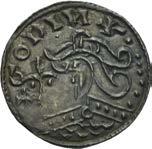

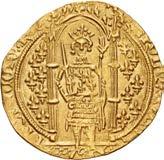

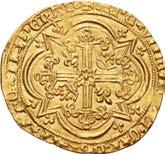

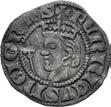

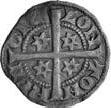
and right, holding sword with annulet pommel, and main de Justice / Cross tréflée; in center of cross, pellet within angled quadrilobe; lis in first and fourth quarters, crown in second and third; all within angled quadrilobe; lis in spandrels. Duplessy
Extremely Rare Scottish Type Esterlin
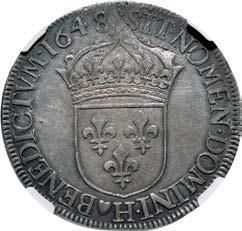
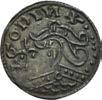
199
DENMARK. Svend
842. FRANCE, Royal. Charles V le Sage (the Wise). 1364-1380. AV Franc à pied (27mm, 3.77 g, 7h). Uncertain provincial mint. Struck after 1368. King standing facing within Gothic arch; semé of seven lis to left
360A/360 (obv./rev.); Dieudonné 792; Ciani –; Friedberg 284. In NGC encapsulation 6492212-017, graded MS64. ($1500)
843. FRANCE, Royal. Louis XIV le Roi Soleil (the Sun King). 1643–1715. AR Écu à la mèche longue (39mm, 6h). La Rochelle mint; différent: heart. Dated 1648 H. Laureate, draped, and cuirassed bust right / Crowned coat-of-arms. Duplessy 1469; Ciani 1849; KM 155.7. Toned. In NGC encapsulation 6351118-007, graded AU 53. ($300)
๘ ŖĚˆˆƱý⎍˫
844. FRANCE, Provincial. Lorraine (duchy). Ferry IV le Lutteur (the Fighter). 1312-1328. AR Esterlin (18mm, 1.23 g, 2h). Nancy mint.
ĕĚƱ Żˆa˫ , crowned head left; lis-tipped scepter to left / ⌦ɨn Ϳɨn ˆĚn ŻƱĚ , long cross pattée; mullets of six points in quarters. J. A. Stewart, “A New Sterling of Lorraine” in NC 15 (1935), o. 209 = Mayhew 308a (same dies); De Saulcy –. Find patina, slightly wavy flan. VF. Extremely rare, possibly the second known. ($750)
845. FRANCE, Provincial. Metz (Archbishophric). temp. Gaston Henri de Bourbon. 1612-1652. AR Taler (43mm, 28.82 g, 5h). Dated 1646. Coat-of-arms within floral polylobe with lis at cusps / Nimbate bust of St. Stephen left. Boudeau 1673; Davenport 5583; KM 27 (German States). Richly toned, flan split. Good VF. ($500)
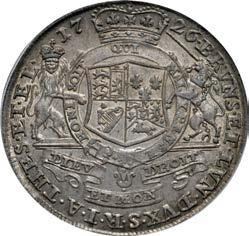
Ex Sincona 47 (5 May 2018), lot 1770.
Impressive Wildman Multiple
846. GERMANY, Braunschweig-Lüneburg-Celle (Duchy). Christian Ludwig. 1648-1665. AR 3 Taler – Löser zu 3 Reichstalern (78mm, 96.14 g, 12h). Zellerfeld mint; mm: crossed keys. Dated 1665 HS. Crowned CL monogram within wreath; around, fourteen crowned coats-of-arms on vines / SINGERE · ET · CON STANTER · AO 1665, wildman standing left, holding tree trunk; in background, view of the countryside including miners and woodworkers. Davenport 192; Welter 1501; KM 256.2. Deep old cabinet tone with minor staining, die breaks on obverse, traces of prior mount. Good VF. ($10,000)


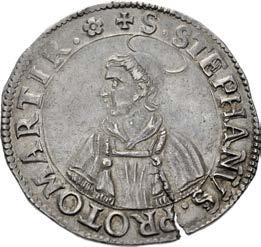

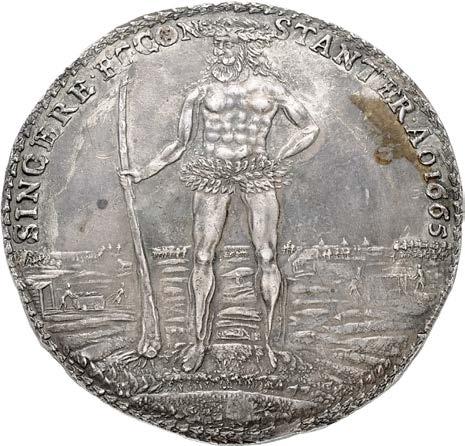
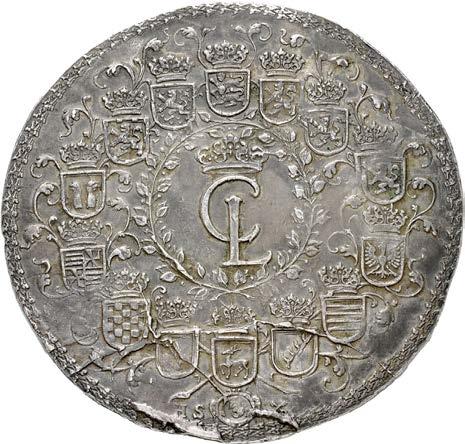
847. GERMANY, Braunschweig-Lüneburg (Principality & Electorate). Georg I. As King of Great Britain, 17141727. AR Taler (40mm, 6h). Clausthal mint. Dated 1727 CPS. Laureate, draped, and cuirassed bust right / Crowned coat-ofarms within garter; lion and unicorn supporters. Smith 27; Welter 2230; Davenport 2081; KM 101.3. Deep iridescent toning. In PCGS encapsulation 45816555, graded AU 58. ($500)
848. GERMANY, Hall in Schwaben (free and imperial city). Joseph II. Emperor, 1765-1790. AR Halbtaler (34mm, 11h). Nürnberg mint. Dated 1777 KR Œ. Laureate, draped, and cuirassed bust right / Three coats-of arms, each in ornate frame. Raff 53.1; KM 45.2. Light blue toning with significant luster and eye appeal. In PCGS encapsulation 34368248, graded MS 61. ($750)
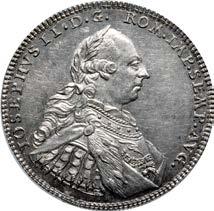
200
847
848
849. HUNGARY, Kingdom of Hungary. Matthias I Corvinus. 1458-1490. AV Florin – Goldgulden (21mm, 3.55 g, 5h). Nagybánya (Frauenbach / Baia Mare) mint. Struck circa 1485. Crowned Holy Virgin enthroned facing, cradling Holy Infant; in exergue, raven standing left, holding ring / Ladislaus I standing facing, holding ax and globus cruciger; across field, n and shield emblazoned with bird. Lengyed 46/1/2 var. (legend stops); Huszár 684; Friedberg 22. Good VF. ($500)
850. INDIA, Medieval. Yadavas of Devagiri. Kampiladeva. 1300-1327. AV Pagoda (12mm, 3.84 g, 9h). Dagger between two conchs or water pots / śri siya/di kambala/deva in Devanagari; sword in exergue. Adams III 76 (this coin); cf. Mitchiner, South I 306-7 (for type); MNI –. VF. ($750)
Ex Dr. Lawrence A. Adams Collection (Classical Numismatic Group Electronic Auction 366, 13 January 2016), lot 76, purchased from Stephen Album, 1992.
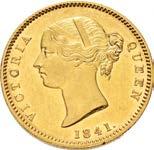
851. INDIA, Islamic Sultanates. Bahmani. ‘Ala’ al-Din Ahmad Shah II. AH 838-862 / AD 1435-1457. AV Tanka (18mm, 11.11 g, 2h). Citing his father, Shihab al-Din Ahmad Shah I. Muhammadabad mint. AH date off flan. al-sultan legend / abu’l muzaffar legend with additional bin ahmad shah al-sultan. CIS BH81; Rajgor Type 2608. Deposits. Good VF. ($1000)
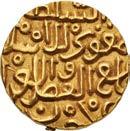

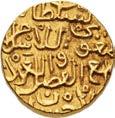
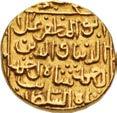

852. INDIA, Islamic Sultanates. Bahmani. ‘Ala’ al-Din Ahmad Shah II. AH 838-862 / AD 1435-1457. AV Tanka (20mm, 11.11 g, 2h). Citing his father, Shihab al-Din Ahmad Shah I. Muhammadabad mint. AH date off flan. al-sultan legend / abu’l muzaffar legend with additional bin ahmad shah al-sultan. CIS BH81; Rajgor Type 2608. Deposits, slight double strike on reverse. Good VF. ($1000)
853. INDIA, Colonial. British India. Victoria. Queen of the United Kingdom of Great Britain and Ireland, 1837-1901. AV Mohur (26mm, 11.63 g, 12h). Divided legend type. Calcutta mint. Dated 1841. VICTORIA QUEEN, young head left; date below, serif on crossbar of 4; incuse W. W. on truncation of neck / EAST INDIA COMPANY, lion advancing left; palm tree behind; in exergue, ONE MOHUR above, yek ashrafi (= one ashrafi) in Persian. UCI 3.11; Pridmore 22(2); Friedberg 1595a. In PCGS encapsulation 46881067, graded AU 58. ($5000)


ITALY, Genova. Pietro di Campofregoso. Doge, 1450-1458. AV Ducato (22mm, 3.54 g, 8h). Stylized castle within polylobe; crosses at cusps, annulets in spandrels / Short cross pattée within polylobe; crosses at cusps, annulets in spandrels. MIR 93; Friedberg 377. Minor weakness, slightly waterworn. Near EF. ($750)
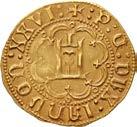


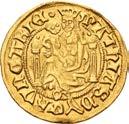

201
849 850 851 852
854.
855. ITALY, Genova. The Biennial Doges. 1528-1797. AR 2 Scudi (55mm, 73.67 g, 12h). Dated 1633. Crowned gate with griffin supporters; facing cherub below / Short cross pattée, with floral scroll at each end and winged head of cherubim above floral scroll in each quarter. MIR 215/13; KM 59; Davenport 547. Toned, scattered marks, tiny attempted piercing, faint traces of mount. VF. ($750)
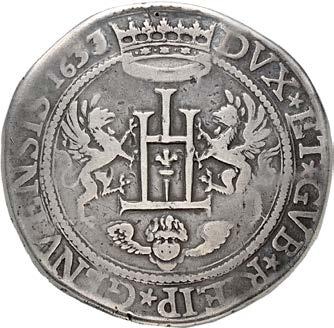



856. ITALY, Napoli (kingdom). Filippo II di Spagna. 1554-1598. AR Mezzo Ducato (33mm, 14.87 g, 1h). First period. Napoli (Naples) mint. Struck 1554-1556. Bareheaded, armored, and draped bust right, wearing ruff; (IBR) to left / Crowned coat-of-arms. MIR 160; Pannuti-Riccio 5. Toned. In NGC encapsulation 6436165-013, graded AU 55. ($500)
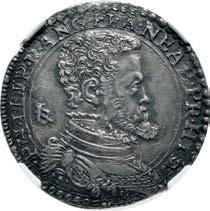





Two Very Rare Early Rome Mint Papal Issues
857. ITALY, Papal (Papal state). temp. Sergius I–John VII. 687-707. AR Eighth Siliqua – 30 Nummi (7mm, 0.15 g, 5h). Rome mint. Struck in the name of Tiberius III, 698-705. Crowned facing bust of Tiberius III, wearing chlamys, holding spear over left shoulder / Cruciform monogram of Roma and Tiberius; R to left, T above, m to right, B below. Aue, Silbermünzen 22 (this coin illustrated); MIR 7/1 (this coin illustrated); O’Hara, Find 23 = Morrisson & Barrandon 23 (this coin) DOC –; MIB 71; SB 1404A (this coin cited). Toned, find patina. VF. Extremely rare, one of only three known. ($2000)
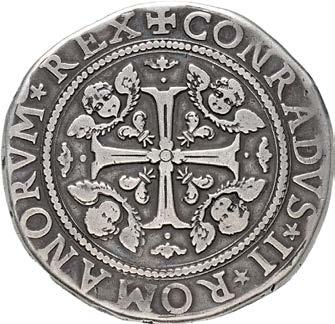

Ex Leu/Numismatica Ars Classica (26 May 1993), lot 599.
858. ITALY, Papal (Papal state). Gregory III. 731-741. AR Eighth Siliqua – 30 Nummi (9mm, 0.32 g, 6h). Rome mint. Struck in the name of Gregory III and Leo III, 717-741. Crowned facing bust of Leo III, wearing chlamys, holding globus cruciger in right hand; stars flanking head / Cruciform monogram of Gregory; ς to left, O above, R to right, Є below. Aue, Silbermünzen 27-9; MIR 12; O’Hara, Find, 29; Morrisson & Barrandon BN 3; Woods fig. 2 (this coin illustrated); DOC 92; MIB –; SB 1534C. Deeply toned, deposits. EF. Very rare. ($5000)
From the Gasvoda Collection. Ex Richard A. Jourdan Collection (Triton XXIII, 14 January 2020), lot 1141; Triton XIX (4 January 2016), lot 762.
202
857 858
The Only English Pope
859. ITALY, Papal (Papal state). Hadrian IV. 1154-1159. PB Seal – Bulla (40mm, 44.88 g, 12h). ADRI/ANVS/ PP • IIII • in three lines / Head of St. Peter and St. Paul facing slightly right and left, respectively; long cross between, S PA S PE above. Serafini 1. Remnants of original cord attached. Near VF. Very rare. ($2500)
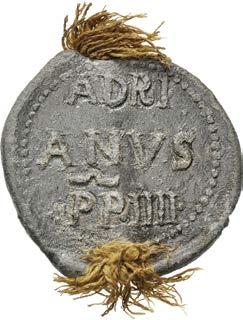
Since no coins were issued in his name, the lead bullae of Hadrian IV are the only way to include this pope into a papal coin collection. The only Englishman elected to the throne of St. Peter, Nicholas Brekespear of St. Albans became Hadrian IV in 1154. His most famous and farreaching papal act was the Donation of Ireland in 1156, granting Henry II of England dominion over Ireland.

The Spark of the Reformation
860. ITALY, Papal (Papal state). Leo X. 1513-1521. AR Giulio (27mm, 3.66 g, 12h). Macerata (or Ancona) mint. View of St. Peter’s Basilica / Leo kneeling right, presenting model of church to St. Peter seated left, holding keys and gospel. MIR 678/2; Muntoni 73; Berman 671. Toned. Near EF. Very rare. ($2500)
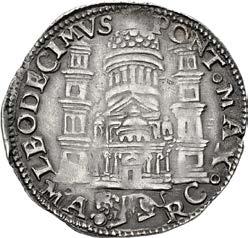

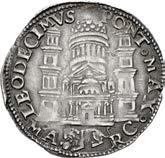
From the Rome on the Euphrates Collection. Ex Elsen 82 (11 December 2004), lot 1976.
Leo X was the son of Lorenzo de Medici, “il Magnifico,” who succeeded the warrior-pope Julius II. A serious patron of the arts, like his father, and intimate friends with many of the titans of the Italian High Renaissance, he oversaw the completion of many of the artistic projects begun by his predecessor. Among these was the new St. Peter’s Basilica. Designed by the great architect Donato Bramante and begun in 1506 to replace the earlier dilapidated Constantinian version, its construction encompassed the better part of the sixteenth and early seventeenth centuries to complete. To provide much-needed funds for the basilica’s construction, Leo in 1517 offered indulgences, papal rescripts which, when purchased, allowed partial absolution for the recipient. It was the aggressive marketing and perceived “selling” of these indulgences by the Dominican friar Johann Tzetzel in his native Germany, which in part, precipitated the actions of Martin Luther and sparked the Protestant Reformation.
861. ITALY, Papal (Papal state). Clement XI. 1700-1721. AV Mezzo scudo (17mm, 1.67 g, 12h). Rome mint. Dated year 17 (AD 1717/8). Bust right, wearing camauro, mozzetta, and pallium / Nimbate and draped bust of St. Peter left, head facing. MIR 2255/1; Muntoni 29; Berman 2367; KM 768; Friedberg 189 (Vatican); Adams I 812 (this coin). In NGC encapsulation 6268020-007, graded AU 58. ($600)

Ex Peter Corcoran Collection (New York Sale LV, 12 January 2022), lot 1353; Dr. Lawrence A. Adams Collection (Classical Numismatic Group 100, 7 October 2015), lot 812; Lighthouse Collection (Stack’s, 16 June 1978), lot 260.
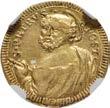
203
862. ITALY, Savoia (duchy). Carlo II. 1504-1553. AR Testone (28mm, 9.21 g, 12h). Type II. Bourg mint. Draped bust right, wearing berretto / Coat-of-arms; knot and annulet above. MIR 339a. Toned. In NGC encapsulation, graded XF 40. ($2000)
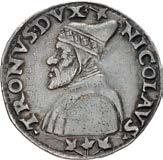

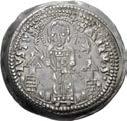



Ex Stack’s Bowers Galleries (16 August 2021), lot 41079.
863. ITALY, Trieste (Archbishophic). Anonymous issues. Circa 1195. AR Denaro (21mm, 1.13 g, 10h). Archbishop enthroned facing, holding crozier and gospels / Temple with five columns and two towers; small cross pattée above. Bernardi, Duecento W1d, – (dies W14/– [unlisted rev. die]); MEC 12, –. Light, patchy toning. EF. ($500)
864. ITALY, Trieste (archbishophric). Giuardo. 1199-1212. AR Denaro (20mm, 1.14 g, 2h). Giuardo enthroned facing, holding crozier and gospels / Temple with single arch and central cupola flanked by two towers. Bernardi, Duecento G2, 42 (dies G07/g07 – this coin); cf. MEC 12, 946 (for type). Rich cabinet toning with flashes of iridescence in reverse devices, spot of green deposit. EF. ($500)
Ex “Collezione ef” (per Bernardi).
865. ITALY, Trieste (archbishophric). Volrico de Portis. 1234-1254. AR Denaro (21mm, 1.30 g, 8h). Volrico enthroned facing, holding crozier and gospels / Temple with single arch and central cupola flanked by two towers. Bernardi, Duecento VM, 753 (dies VM23/vm35 – this coin); cf. MEC 12, 948 (for type). Old cabinet toning. Good VF. ($500)
Ex “Collezione gb” (per Bernardi).
866. ITALY, Trieste (Commune). 1254-1257. AR Denaro (20mm, 1.05 g, 2h). St. Justus standing facing, holding quill; towers to left and right / Temple with central cupola flanked by two towers. Bernardi, Duecento T, 845 (dies T02/t02 – this coin); cf. MEC 12, 950 (for type). Old cabinet toning, double struck, a few scratches. Good VF. ($500)
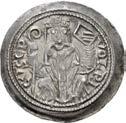
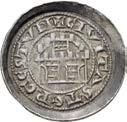

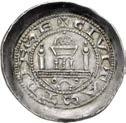
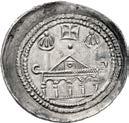

Ex Lazara Collection (per Bernardi).
867. ITALY, Venezia (Venice). Nicolò Tron. 1471-1473. AR Trono – Lira (37mm, 6.42 g, 10h). Struck 1472-1473. Draped bust left, wearing ducal biretta; three leaves below / Winged lion of St. Mark facing, holding gospel; all within wreath. MEC 12, 1342; Paolucci 2; Biaggi 2901. Deeply toned, graffiti. VF. ($500)
Ex Münzen und Medaillen AG 90 (14 June 2000), lot 443.
204
863
864
865
866
868. LOW COUNTRIES, Gent (Gand [city]). AV Nobel (32mm, 6.93 g, 8h). Dated 1583. Half-length figure of king standing facing within ship, holding sword and shield; N T flanking / Cross fleurdelisée and feuillue; in center of cross, rosette within angled quadrilobe; in each quarter, crown above lion passant left; all within tressure of eight arches; trefoils in spandrels. Vanhoudt, Munten 444; Vanhoudt I228; Delmonte, Or 538. Slightly wavy flan, minor marks. VF. ($4000)

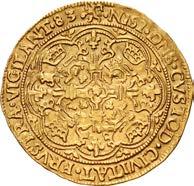
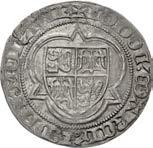



869. LOW COUNTRIES, Vlaanderen (Flanders). Filips de Goede (the Good). 1419-1467. AV Gouden leeuw – Lion d’or (30mm, 4.00 g, 4h). Brugge mint. Struck 1545-1460. Lion standing left in Gothic arch; crowned trefoils flanking / Coatof-arms over cross fleurée. Delmonte, Or 489; De Mey, Flanders 837; Friedberg 185. Hairlines and light scratches, traces of bezel on edge. Good VF. ($1000)
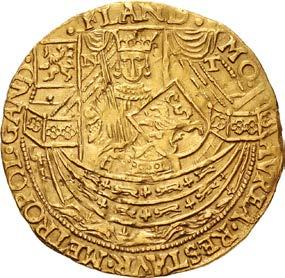


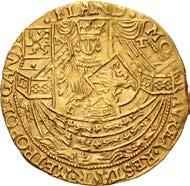
Ex Classical Numismatic Group 69 (8 June 2005), lot 2091.
Jose de Moravia. 1388-1402
Ex Peter Woodhead Collection (Spink 238, 27 June 2016), lot 1714, purchased from Jan Lis, September 1971.
205
870. LUXEMBOURG.
and 1407-1411. AR Gans – Gros (25.5mm, 2.86 g, 7h). 1st emission, 1388-1397. Coat-of-arms within trilobe / Long cross pattée. Faces in Os and Cs in legends. Weiller 157; De Mey, Luxembourg 170. Toned. Near EF. ($500)
871. MEXICO, Colonial. Carlos III. King of Spain, 1759-1788. AR 8 Reales (38mm, 26.98 g, 12h). Columnario type. Mexico City mint. Dated 1766 Mo MF. Crowned coat-of-arms / Crowned hemispheres between crowned Pillars of Hercules ornamented with banners; all set on waves. Gilboy M-8-46; BW 28.4; KM 105. Hints of luster, hairlines. EF. ($400)
Ex Karolkiewicz Collection
872. POLAND, Kingdom. Jan II Kazimierz. 1648-1668. AV Dwudukat – 2 Ducats (29mm, 6.89 g, 10h). Kraków mint. Dated 1664 AT. Crowned and armored bust right / Crowned and collared coat-of-arms. Kopicki 1920; MP 1623 (Bydgoszcz mint; this coin cited); KM 119; Friedberg 89. In NGC encapsulation 6511703-002, graded AU Details, obverse repaired. We note a small area of expert repair, most likely of graffiti, in the obverse field before the face. ($5000)
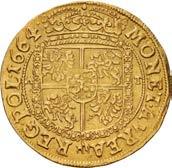
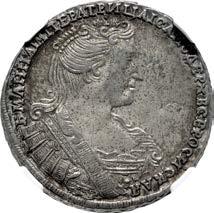

Ex Henry V. Karolkiewicz Collection (Triton IV, 6 December 2000), lot 2314.
873. RUSSIA, Empire. Anna Ioannovna. 1730-1740. AR Half Rouble (33mm, 12h). Kadashevsky mint. Dated 1733 Crowned and mantled bust right / Crowned double-headed eagle facing, wings spread, holding scepter and globus cruciger; crown above. Diakov 3; Bitkin 145; KM 195. Deeply toned. In NGC encapsulation 5964929-005, graded AU 55. ($750)
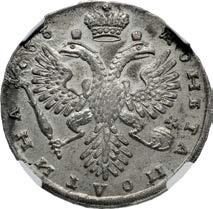

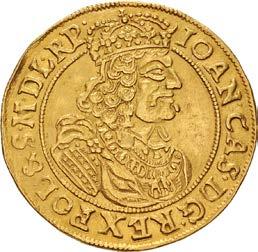
874. RUSSIA, Empire. Ekaterina II Velikaya (the Great). 1762-1796. AV 10 Roubles (29mm, 12h). Sankt-Peterburg (St. Petersburg) mint. Dated 1767/6 СПБ. Crowned bust right / Crowned cruciform coats-of-arms with crowned doubleheaded eagle at center. Diakov 158; Bitkin 15; KM (C) 79a; Friedberg 129a. In NGC encapsulation 6506621-004, graded AU Details, mount removed. Scrapes. ($2500)


206
875. RUSSIA, Empire. Ekaterina II Velikaya (the Great). 1762-1796. AV 5 Roubles (23mm, 12h). Sankt-Peterburg (St. Petersburg) mint. Dated 1785 СПБ. Crowned bust right / Crowned cruciform coats-of-arms with crowned double-headed eagle at center. Diakov 503; Bitkin 85; KM (C) 78c; Friedberg 130b. In NGC encapsulation 6506621-003, graded AU 55. ($5000)
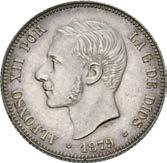
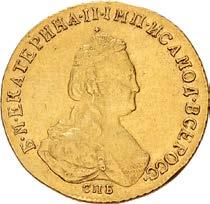
876. RUSSIA, Empire. Nikolai II Aleksandrovich. 1894-1917. AV 5 Roubles (18mm, 11h). Sankt-Peterburg (St. Petersburg) mint. Dated 1909 ЗБ. Bare head left / Crowned double-headed eagle facing, holding scepter and globus cruciger. Bitkin 34; KM (Y) 62; Friedberg 180. In NGC encapsulation 1521549-021, graded MS 64. ($750)
877. SPAIN, Kingdom. Carlos III. 1759-1788. AV 8 Escudos (36.4mm, 27.06 g, 12h). Sevilla (Seville) mint. Dated 1787/6 S CM/C. Armored and draped bust right / Crowned coat-of-arms within Collar of the Order of the Golden Fleece. ME 12999; Calicó 841; KM 409.2a; Friedberg 293. Toned, banker’s mark, hairlines. Near EF. ($1500)

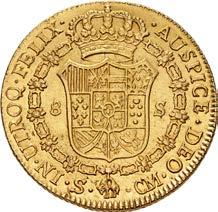
Ex Classical Numismatic Group 97 (17 September 2014), lot 959.



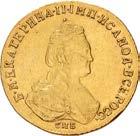



878. SPAIN, First Republic. 1873-1874. Æ 2 Pesetas Prueba (27mm, 6.24 g, 6h). Madrid mint. Dated 1870 M (18 74 en estrellas). Hispania seated left, holding olive branch / Crowned coat-of-arms flanked by Pillars of Hercules. Cf. Calicó y Trigo 3; cf. KM 654 (for regular circulation strike). A few light marks. Proof. ($3000)
Ex Áureo & Calicó 380 (16 December 2021), lot 20 (hammer €3400).
879. SPAIN, Kingdom. Alfonso XII. 1874-1885. AR 2 Pesetas (27mm, 6h). Madrid mint. Dated 1879 EM M (18 79 en estrellas). Bare head left / Crowned coat-of-arms between Pillars of Hercules. ME 17496; KM 678.1. Toned. In NGC encapsulation 6506621-002, graded MS 64. One of three in this grade at NGC with none higher ($500)
207
878 879
A SPECIAL COLLECTION OF MADAGASCAR
A note from the collector: My interest in Madagascar developed in the early 1950s when I was about eight years old. I cannot identify a trigger but I recall pestering my father for old books and artifacts relating to the subject. Over the years I have built up a collection of ethnography, books and handwritten documents by early travelers and settlers, local artifacts and numismatic items. Those offered here are a small selection.
The Colonization of Madagascar
880. MADAGASCAR, Colonial. French. Louis XIV. 1643-1715. AR Medal (63mm, 114.05 g, 12h). The Colonization of Madagascar. By J. Warin. Dated 1665. LVDOVICVS · MAGNUS · FRAN · ET · NAV · REX · P · P ·, armored and draped bust right / COLONIA MADAGASCARICA, zebu bull standing left, head facing; ebony tree and landscape in background; 1665 in exergue. Jacquiot fig. 1, a; Jones II 240. Lightly toned with gleaming luster, small flan crack, minor hairlines, edge ding. EF. Much as struck. The diagnostic reverse die break at a very early stage, as on the BM specimen examined by Jones. Extremely rare. A spectacular and highly important medal.

($10,000)
From an English private collection of coins and medals relating to Madagascar, formed from the 1960s to the present. Ex Peus 394 (31 October 2007), lot 1740 (hammer €11,750).

In 1664, as the French sought to expand their colonial holdings into the southern Indian ocean, Louis XIV granted the rights to the island of Madagascar, as well as the outlying islands, to the Compagnie des Indes Orientales. The French were utterly unprepared for the tropical climate. By 1673, the colony had failed, and commercial efforts were redirected to the Mascarene islands.

208
881.
Colonial. French. Louis XIV. 1643-1715. Æ Medal (50mm, 54.69 g, 12h). The Colonization of Madagascar. By J. Warin. Dated 1665, though possibly a later restrike. LVD · MAGNVS · · FR · ET · NAV · REX ·, armored and draped bust right; traces of (erased?) signature on truncation of bust / COLONIA MADAGASCARICA, zebu bull standing left, head facing; ebony tree and landscape in background; · 1665 · in exergue. Jacquiot fig. 1, b; Jones II 242 var. (obv. type; same rev. die); ANS 0000.999.44214 (for a much later restrike). Chocolate brown surfaces with bluish tone and some brilliance. Choice EF. Very rare, particularly with this obverse. ($2000)

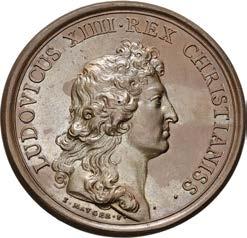

From an English private collection of coins and medals relating to Madagascar, formed from the 1960s to the present. Ex Palombo 9 (26 June 2010), lot 495.
Jones notes that Warin was commissioned to make a smaller size in addition to the larger type offered in the previous lot. He illustrates a medal from the same reverse die as the present piece, but combined with an obverse intended for a naval medal. Despite the lack of a signature, Jones assigns that medal to Warin.
882.
Lot of two (2) Æ Medals. The Colonization of Madagascar. By J. Mauger. Dated 1665 (in Roman numerals), though struck 1702. LUDOVICUS XIIII · REX CHRISTIANISS ·, bare head right / COLONIA MADAGASCARICA, zebu bull standing left, head facing; ebony tree in background; M · DC · LXV · in exergue. Jacquiot fig. 1, c; Jones II p. 226, fig. 43.
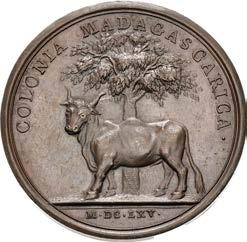
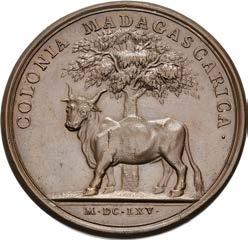

a) Thin flan (41mm, 25.66 g, 12h)
b) Thick flan (41mm, 34.46 g, 12h). 19th century restrike(?), with slightly more deterioration of reverse die.
Both medals: Richly toned. EF. ($400)
From an English private collection of coins and medals relating to Madagascar, formed from the 1960s to the present.
209
MADAGASCAR,
MADAGASCAR, Colonial. French. Louis XIV. 1643-1715.
a b



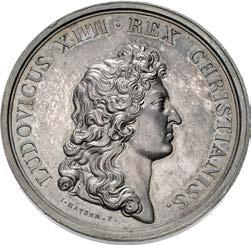
210
883. MADAGASCAR, Colonial. French. Louis XIV. 1643-1715. AR Medal (42mm, 37.84 g, 12h). The Colonization of Madagascar. By J. Mauger. Dated 1665 (in Roman numerals), though a 19th century restrike of a 1702 original. LUDOVICUS XIIII · REX CHRISTIANISS ·, bare head right / COLONIA MADAGASCARICA, zebu bull standing left, head facing; ebony tree in background; M · DC · LXV · in exergue. EDGE: argent. Jacquiot fig. 1, c; Jones II p. 226, fig. 43. Beautifully toned and as struck. Choice EF. Very rare in silver. ($2000)
From an English private collection of coins and medals relating to Madagascar, formed from the 1960s to the present. Reportedly ex Virgil Brand Collection, purchased from Edward Frossard, 1883.
884. MADAGASCAR, Kingdom of Imerina. Ranavalona III. 1883-1897. Pattern AR 5 Francs (38mm, 26.30 g, 6h). Différents: star and head left. Dated 1886. S . M . RANAVONA III, crowned bust facing slightly right / ROYAUME DE MADAGASCAR, crowned R. Chauvicourt 4; MCF 7; Davenport 515; KM (X) M1. Minor marks and hairlines. EF. Rare. ($2000)
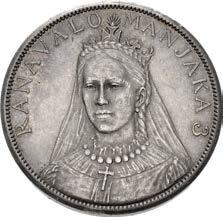
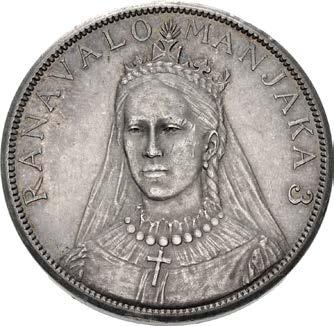
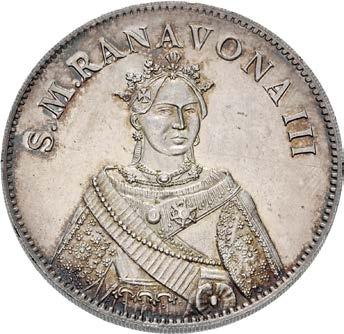
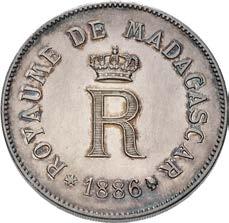

From an English private collection of coins and medals relating to Madagascar, formed from the 1960s to the present.
Fantasy Pattern for Reginald Huth
885. MADAGASCAR, Kingdom of Imerina. Ranavalona III. 1883-1897. Pattern AR 5 Francs (38mm, 24.90 g, 12h). By John H. Pinches, for Reginald Huth. Dated 1895. RANAVALO MANJAKA 3, crowned bust facing slightly left / (crescent) RABODOMAMDRIANIMPOINIMERINA (crescent) 1895, Jerusalem cross within polylobe; lis in quarters, rosettes in angles. Chauvicourt 6; MCF 9; Davenport 516; KM (X) M4. Toned, light marks on obverse. EF. Extremely rare – only 25 struck in silver. ($2000)
From an English private collection of coins and medals relating to Madagascar, formed from the 1960s to the present. This silver pattern is from a fascinating series of fantasies commissioned by the British collector Reginald Huth, primarily featuring crownsized coins for various reigning queens. Fantasy patterns for Ranavalona III of Madagasar, Lili’uokalani and Ka’iulani of Hawaii, Isabel II of Spain, and Queen Victoria were struck by the Pinches of London. In several cases, these are the only “coins” bearing that monarch’s portrait, and all are highly sought after by modern collectors.

211
The following lots were produced in response to a severe shortage of metal during the First World War due to the recall, in the colonies as in metropolitan France, of metal for arms production. Nor was any metal allocated for new coinage. The currency comprised principally stamps of the period stuck on cardboard. They are known as either monnaies carton (cardboard money) or timbres monnaie (stamp money).
There are two main groups, named according to design, with several varieties within each. They are vola alika (Malagasy: dog money) and volan’ omby (Malagasy: zebu money). Unsurprisingly they are all rare, especially in the excellent condition of those offered here. Owing to the speed that the pieces became damaged in circulation, a yellow varnish was introduced to try to fortify them (see lots 893-896). This saw little success.
886. MADAGASCAR, Colonial. French. Third Republic. 1897-1940. Cardboard 10 Centimes – Ilavaomena (41x24mm). Emergency issue. Issued December 1916-December 1919. Dog standing right, head facing. Pasted on a 10 centimes stamp. Chauvicourt 9; MCF 13a; Pick 7. EF. ($300)

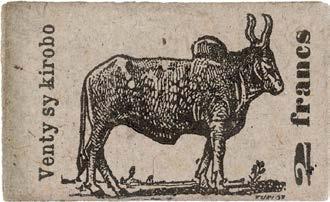
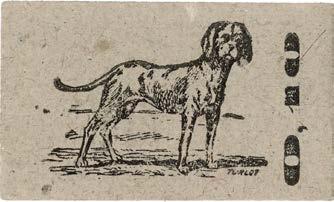
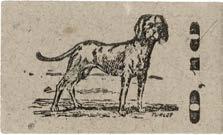
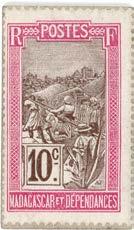
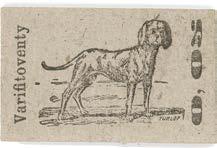
From an English private collection of coins and medals relating to Madagascar, formed from the 1960s to the present.
887. MADAGASCAR, Colonial. French. Third Republic. 1897-1940. Cardboard 5 Centimes – Variftoventy (40x35mm). Emergency issue. Issued December 1916-December 1919. Dog standing right, head facing. Pasted on a 5 centimes stamp. Chauvicourt 8; MCF 11b; Pick 9. EF. ($300)
From an English private collection of coins and medals relating to Madagascar, formed from the 1960s to the present.

212
887 886
Lot 886
Lot 892
Lot 889
888. MADAGASCAR, Colonial. French. Third Republic. 1897-1940. Cardboard 10 Centimes – Ilavaomena (40x24.5mm). Emergency issue. Issued December 1916-December 1919. Dog standing right, head facing. Pasted on a 10 centimes stamp. Chauvicourt 9; MCF 13b; Pick 10. EF. ($300)
From an English private collection of coins and medals relating to Madagascar, formed from the 1960s to the present.
889. MADAGASCAR, Colonial. French. Third Republic. 1897-1940. Cardboard 50 Centimes – Lasiroa (40x25m). Emergency issue. Issued December 1916-December 1919. Dog standing right, head facing. Pasted on a 50 centimes stamp. Chauvicourt 11; MCF 18b; Pick 11A. EF. ($300)
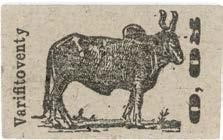
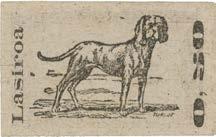


From an English private collection of coins and medals relating to Madagascar, formed from the 1960s to the present.
890. MADAGASCAR, Colonial. French. Third Republic. 1897-1940. Cardboard 5 Centimes – Varifitoventy (41x25mm). Emergency issue. Issued December 1916-December 1919. Zebu standing right. Pasted on a 5 centimes stamp. Chauvicourt 14; MCF 12a; Pick 16. EF. ($300)

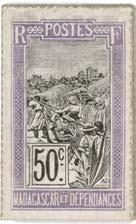
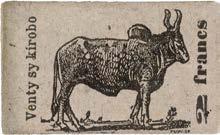
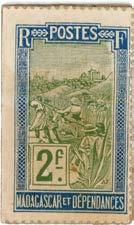
From an English private collection of coins and medals relating to Madagascar, formed from the 1960s to the present.
891. MADAGASCAR, Colonial. French. Third Republic. 1897-1940. Cardboard 25 Centimes – Pitoventy sy Voamena (41x24mm). Emergency issue. Issued December 1916-December 1919. Zebu standing right. Pasted on a 25 centimes stamp. Chauvicourt 16; MCF 16a; Pick 18. Some foxing. Good VF. ($300)
From an English private collection of coins and medals relating to Madagascar, formed from the 1960s to the present.
892.
Colonial. French. Third Republic. 1897-1940. Cardboard 2 Francs – Venty sy Kirobo (40x24mm). Emergency issue. Issued December 1916-December 1919. Zebu standing right. Pasted on a 2 franc stamp.
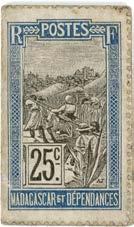
19; MCF 24a; Pick 21. Crease. Good VF. ($300)
From an English private collection of coins and medals relating to Madagascar, formed from the 1960s to the present.

213
MADAGASCAR,
Chauvicourt
888 889 890 891
893. MADAGASCAR, Colonial. French. Third Republic. 1897-1940. Cardboard 10 Centimes – Ilavaomena (40x24mm). Emergency issue. Issued December 1916-December 1919. Zebu standing right. Pasted on a 2 franc stamp and varnished as made. Chauvicourt 15; MCF 14b; Pick 29. EF. ($300)

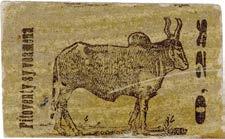
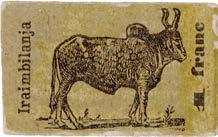
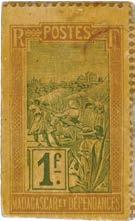


From an English private collection of coins and medals relating to Madagascar, formed from the 1960s to the present.
894. MADAGASCAR, Colonial. French. Third Republic. 1897-1940. Cardboard 25 Centimes – Pitoventy sy Voamena (41x24mm). Emergency issue. Issued December 1916-December 1919. Zebu standing right. Pasted on a 25 centimes stamp and varnished as made. Chauvicourt 16; MCF 16b; Pick 30. Near VF. ($300)
From an English private collection of coins and medals relating to Madagascar, formed from the 1960s to the present.
895. MADAGASCAR, Colonial. French. Third Republic. 1897-1940. Cardboard 1 Franc – Iraimbilanja (40x24mm). Emergency issue. Issued December 1916-December 1919. Zebu standing right. Pasted on a 25 centimes stamp and varnished as made. Chauvicourt 18; MCF 22 var. (unvarnished types); Pick 32. Near EF. ($300)
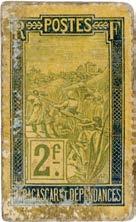
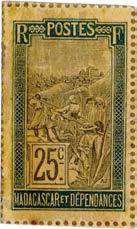
From an English private collection of coins and medals relating to Madagascar, formed from the 1960s to the present.
896. MADAGASCAR, Colonial. French. Third Republic. 1897-1940. Cardboard 2 Francs – Venty sy Kirobo (40x25mm). Emergency issue. Issued December 1916-December 1919. Zebu standing right. Pasted on a 25 centimes stamp and varnished as made. Chauvicourt 19; MCF 24b; Pick 33. Good VF. Some loss of varnish. ($300)
From an English private collection of coins and medals relating to Madagascar, formed from the 1960s to the present.
214
893 895 894 896
897. MADAGASCAR. Lot of four (4) coins. Includes:

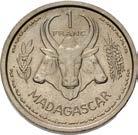
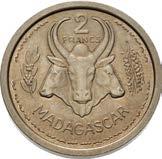
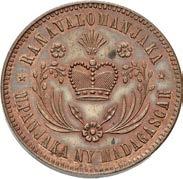
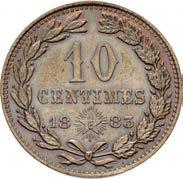
a) Kingdom of Imerina. Ranavalona III. 1883-1897. CU 10 Centimes. (31mm, 9.83 g, 6h). Paris mint. Dated 1883 E. RANAVALOMANJAKA * MPANJAKA NY MADAGASCAR *, crown over wreath; two rosettes above / 10/ CENTIMES/ 18 (E in radiant star) 83. Chauvicourt 3; MCF 4; KM (X) 1. Lustrous, spot. Choice EF.
b) Colonial, Free France. 1940-1944. CU 50 Centimes (20mm, 2.75 g, 6h). Pretoria, South Africa mint. Dated 1943. Rooster standing left / Cross of Lorraine. Chauvicourt 21; MCF 34; KM 1. Lustrous. AU.

c) Colonial, Fourth Republic. 1946-1958. CU-NI Essai de Franc (27mm, 10.05 g, 6h). Paris mint; différents: cornucopia and wing Dated 1948. Bust of Marianne left, wearing winged Phrygian cap; four ships in background / Triple-headed zebu bull facing; olive branch and grain ears flanking. Chauvicourt 29; MCF 36; KM E1. A few spots. UNC.
d) Colonial, Fourth Republic. 1946-1958. CU-NI Essai de 50 Centimes. (22mm, 5.26 g, 6h). Paris mint; différents: cornucopia and wing. Dated 1948. Bust of Marianne left, wearing winged Phrygian cap; four ships in background / Triple-headed zebu bull facing; olive branch and grain ears flanking. Chauvicourt 31; MCF 37; KM E2. A few spots. UNC.

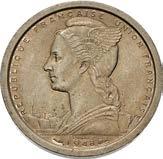
Four (4) coins in lot.
From an English private collection of coins and medals relating to Madagascar, formed from the 1960s to the present.
UNITED STATES COINAGE
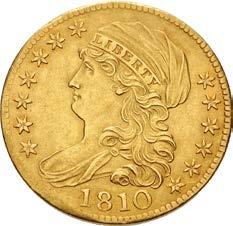
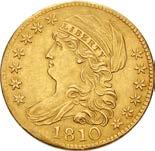
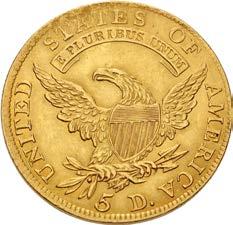
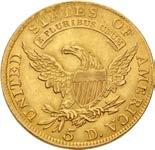
($400)
From the S&S Collection. Ex Malter XXXIX (2 April 1989), lot 1467.
215
898. 1810 Capped Bust Half Eagle. Large Date, Large 5, BD-4, R.2. NGC MS 61. 6511706-001. An attractive coin of this early type. ($5000)
a d c b
Ex Heritage 131752 (26 December 2017), lot 27722 (price realized $16,800).

UNITED STATES MEDALS

Unusual Magic Square in Gold – An Object of Mysticism


900.
(40mm,
By Albert
Copyright 1942. AGW: 2.8321. Magical square consisting of sixteen numerals (four columns and four
each totaling 16). Sixteen letter border outside; above, S. 40 – 80G; 1492 to left; 1861 to right; below, © ALBERT WISS/1942 in two lines / Ornate design reminiscent of the mystic tree of life with central voided cross flanked containing pellet; two additional pellets, flanking; above, the numbers 31; 431658 and JULY 4; 1776 below; additional stars and numbers-in circles around. Edge: 1000 – FINE PURE. See Stack’s Bowers January 2012 Americana, lot 6308 (for another in gold). Small spot of toning, hairlines, spots of roughness. EF. Unusual. ($7500)
According to the Catalog of Copyright Entries, Part 4 for 1941 (New Series, Volume 36, No. 4), p. 144, Albert Wiss is listed as entry number 6103 for a “Mandala dvaya maga,” or “circular two-fold priest.” Born in 1882 in Switzerland, Wiss was listed as an importer of watches in the 1915 New York State Census. In the 1930 Federal Census, he and his family were listed as living in Yonkers, where he is listed as an importer of jewelry (on his own account). Subsequently, in the 1940 Federal Census, he has no occupation (but has income from other sources), and has moved once again with his family to Hillsdale, Bergen Co., NJ. The enumerator also noted that Wiss had completed four years of college, which might help explain his interest in Eastern mysticism, represented by this medal.
216
899. 1907 St. Gaudens High Relief, Wire Edge Double Eagle. PCGS MS 62. 13560094. Struck in high relief and very pretty. ($7500)
24k AV Medal
80.29 g, 6h). Magic Square.
Wiss.
rows,
BRITISH COINAGE
901. CELTIC, Imported coinage. Ambiani. Circa 100-50 BC. AV Stater (17mm, 6.66 g, 12h). Gallo-Belgic Ca, biface type. Devolved head of Apollo right / Disjointed horse right; pellets above, pellet below, pellet in lozenge above tail. Depeyrot, NC VI, 137; D&T 159; Sills 409-10; Van Arsdell 42-1; ABC 13; SCBC 11. Well worn as usual. Toned. Good Fine. ($500)
From the Trehearne Collection.
902. CELTIC, Imported coinage. Ambiani Circa 100-50 BC. AV Stater (17mm, 6.14 g). Gallo-Belgic E. Gallic Wars Issue. Plain bulge with die break / Large disjointed horse right; ornaments around; solid exergue line above pellets-increscents. Depeyrot, NC VI, 161; D&T 238; Van Arsdell 52-1; ABC 16; SCBC 11. Light marks on obverse. Good VF. Well centered. ($600)


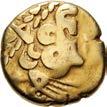

From the Trehearne Collection.
903. CELTIC, Imported coinage. Ambiani. Circa 100-50 BC. AV Stater (16mm, 6.20 g). Gallo-Belgic E. Gallic Wars Issue. Plain bulge / Large disjointed horse right; ornaments around; solid exergue line above pellets-in-crescents. Depeyrot, NC VI, 161; D&T 238; Van Arsdell 52-1; ABC 16; SCBC 11. A few very light marks on obverse. Good VF. ($600)
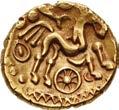

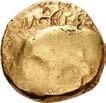

From the Trehearne Collection.
904. CELTIC, Imported coinage. Ambiani. Circa 100-50 BC. AV Stater (18mm, 6.35 g). Gallo-Belgic E. Gallic Wars Issue. Plain bulge / Large disjointed horse right; ornaments around; solid exergue line above pellets-in-crescents. Depeyrot, NC VI, 161; D&T 238; Van Arsdell 52-1; ABC 16; SCBC 11. Toned, struck from a clashed obverse die. Good VF. ($600)
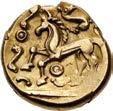

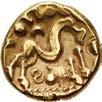

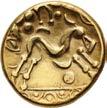
From the Malthouse Collection.
905. CELTIC, Imported coinage. Ambiani. Circa 100-50 BC. AV Stater (17mm, 5.90 g). Gallo-Belgic E. Gallic Wars Issue. Plain bulge / Large disjointed horse right; ornaments around; solid exergue line above pellets-in-crescents, S S below horse. Depeyrot, NC VI, 161; D&T 242; Van Arsdell –; ABC 16 var. (no retrograde S S); SCBC 11 var. (same). Minor marks. Die rust. Good VF. Rare variant. ($750)

906. CELTIC, Atrebates & Regni. Uninscribed. Circa 60-20 BC. AV Stater (19mm, 6.00 g, 6h). Selsey Two-Faced type (Atrebatic B). Devolved head of Apollo right with ‘hidden face’ motif / Disjointed horse right; ‘arm’ above, wheel below. Bean Q1-3; ABC 485; Van Arsdell 210-1; SCBC 38. Toned, a few light marks. Good VF. ($750)
Climping Type
907. CELTIC, Atrebates & Regni. Uninscribed. Circa 50-40 BC. AV Stater (18mm, 5.66 g, 4h). Climping type. Devolved head of Apollo with floral scepter bisecting laurel; wings flanking scepter head, crescent face to lower left, harp shape to lower right / Horse left; sea-horse shapes and pellets-in-annulets around. Bean –; ABC 524; Van Arsdell –; SCBC 33A. Hairline flan split. Obverse slightly off center. EF. Very rare. ($1500)
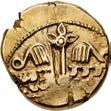
217
901 902 903 904 905 906
908
909
908. CELTIC, Atrebates & Regni. Commius. Circa 45-30 BC. AV Stater (16mm, 5.48 g, 12h). Commios Muzzles type (Atrebatic C). Southern mint. Struck circa 30-25 BC. Devolved head of Apollo right, with two ‘hidden face’ motifs / Devolved horse right; remains of charioteer’s arms above, wheel below; [COÂ-ÂiOÍ] along right edge from below. Bean COM1-3; ABC 1022; Van Arsdell 350-1; SCBC 65. Some die rust. Good VF. ($1000)
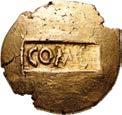
909. CELTIC, Atrebates & Regni. Tincommius. Circa 30 BC-AD 10. AV Stater (19mm, 5.38 g, 2h). Tincomarus Warrior type (Atrebatic F). Southern mint. Table inscribed COÂ F / Warrior, preparing to hurl spear, on horse leaping right; star to upper left, annulet to lower left, TiN to lower right. Bean TIN4-7c; ABC 1067; Van Arsdell 385-1; SCBC 76. Lustrous, edge splits, worn dies. Near EF. ($1000)

From the Treahearne Collection.
910. CELTIC, Atrebates & Regni. Verica. Circa AD 10-40. AV Stater (18mm, 5.32 g, 2h). Vine Leaf Viri type (Atrebatic K). Southern mint. Vine leaf; ui ri across fields / Horseman with spear and shield on back, leaping from platform; C O F around. Allen & Haselgrove Series D, 62-75 (dies F/g); Bean VERS3-1; ABC 1193; Van Arsdell 520-1; SCBC 121. Lustrous, some die wear and flatness of strike, minor mark on leaf. Near EF. Well centered. ($1500)
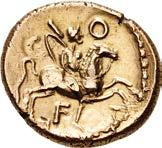

From the Trehearne Collection.
911. CELTIC, Atrebates & Regni. Verica. Circa AD 10-40. AV Stater (18mm, 5.34 g, 11h). Vine Leaf Viri type (Atrebatic K). Southern mint. Vine leaf; [u]i ri across fields / Horseman with spear and shield on back, leaping between two platforms; C O F around. Van Arsdell, “Clashed Dies and the Organization of Verica’s Mint,” in NumCirc CII.9 (November 1994), pp. 402-3; cf. Allen & Haselgrove Series D, 86-9 (dies H/n, without clash); Bean VERS3-1b; ABC 1193; Van Arsdell 520-1; SCBC 121. Off center. Good VF. Very rare clashed die error. ($1500)




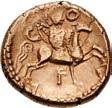

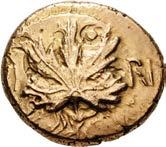



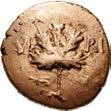
Ex Chris Rudd eAuction 153 (16 July 2017), lot 10; Spink 230 (15 July 2015), lot 362.
912
913
912. CELTIC, Trinovantes & Catuvellauni. Uninscribed. Circa 60-20 BC. AV Stater (17mm, 5.86 g, 2h). Early Whaddon Chase type (Trinovantian D). Wreath, cloak and crescents; rounded wing motif above wreath / Celticized horse right; wing motif and three pellets above, lozenge before, pellet and annulet below. ABC 2433; Van Arsdell 1476-1; SCBC 32. Light marks, edge split. VF. ($600)
From the Trehearne Collection.
913. CELTIC, Trinovantes & Catuvellauni. Uninscribed. Circa 60-20 BC. AV Stater (16mm, 5.55 g, 6h). Middle Whaddon Chase, big wheel type (Trinovantian E). Wreath in cross shape with two confronted crescents at center; wing motifs in forward quarters / Horse leaping right; wheel below, wing motif and pellets above. ABC 2442; Van Arsdell 1487-1; SCBC 32. Edge splits, minor obverse scrape. Good VF. ($1000)
218
914. CELTIC, Trinovantes & Catuvellauni. Uninscribed. Circa 60-20 BC. AV Stater (17mm, 5.84 g). Late Whaddon Chase type (Trinovantian F). Traces of crossed wreaths / Celticized horse right; ‘wing’ with beaded tail above; star to right, pellet sun below. ABC 2344; Van Arsdell 1502-1; SCBC 33. Some marks, die breaks, edge split. Good VF. ($600)
From the Trehearne Collection.
915. CELTIC, Trinovantes & Catuvellauni. Uninscribed. Circa 60-20 BC. AV Quarter Stater (12mm, 1.18 g). Harlow Wheel type (Atrebatic B). Stylized cruciform wreath; outline crecent ending in pellet-in-annulets in opposing quarters / Horse right; wheel motif above, solar disk ornament below. ABC 2463; Van Arsdell 234; SCBC 43. Hairline striking split. Minor marks, some die rust. Good VF. Very rare. ($600)


916. CELTIC, Trinovantes & Catuvellauni. Addedomaros. Circa 40-30 BC. AV Stater (20mm, 5.49 g). Floral Spiral, normal type (Trinovantian K). Two crescents back-to-back; all over partial double lozenge, with pellets in border / Horse prancing right; spiral sun above, branch below; pellets-in-annulets around; [ADD]iiDOÂArOÍ around. ABC 2511; Van Arsdell 1635-1; SCBC 202. Light marks, edge splits. Near EF. Struck on a very broad flan. Rare. ($2000)



917. CELTIC, Trinovantes & Catuvellauni. Dubnovellaunus. Circa 30-10 BC. AV Stater (15mm, 5.45 g). Dubnovellaunus Branch type (Trinovantian L). Open wreath; two outline crescents back to back at center, pellet-in-annulets above and below / Horse leaping left; pellet to left, pellet-in-annulet above, branch below; [DuBNOuiiLA] above. Kretz, Trinovantian, Group D, dies D3-2; ABC 2392; Van Arsdell 1655-1; SCBC 207. Toned, light marks on obverse. Good VF. Well centered. ($1500)
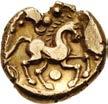

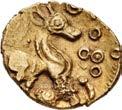
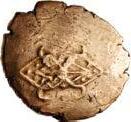

From the Trehearne Collection.

219
Three Exceptional Cunobelin Staters from the Borden Hoard
918. CELTIC, Trinovantes & Catuvellauni. Cunobelin. Circa AD 10-43. AV Stater (16mm, 5.32 g, 8h). Linear type (Trinovantian U). Camulodunum mint. Grain ear with central linear stalk; CA Âu flanking, pellet above Â, privy mark + to lower left / Horse leaping right; branch and two pellets above, CuN below. PAS BH-137A04 CH16 (this coin); Allen, Cunobelin 24-6 (dies G/g); ABC 2774; Van Arsdell 1925-5; SCBC 281. Pristine surfaces, reverse slightly off center. Superb EF. Much as struck. Rare in this condition. ($3000)
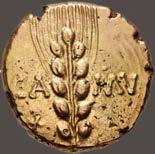
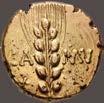
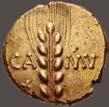
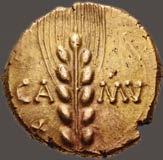

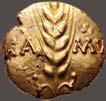

Ex Borden Hoard (PAS BH-137A04).
919. CELTIC, Trinovantes & Catuvellauni. Cunobelin. Circa AD 10-43. AV Stater (16mm, 5.59 g, 4h). Linear type (Trinovantian U). Camulodunum mint. Grain ear with central linear stalk; CA Âu flanking, pellet above Â, privy mark + to lower left / Horse leaping right; branch and two pellets above, CuN below. PAS BH-137A04 CH9 (this coin); Allen, Cunobelin – (dies G/h [unlisted die combination]); ABC 2774; Van Arsdell 1925-5; SCBC 281. Minor metal flaws and soft spot on forepart of horse. EF. Much as struck. Rare in this condition. ($3000)
Ex Borden Hoard (PAS BH-137A04).
920. CELTIC, Trinovantes & Catuvellauni. Cunobelin. Circa AD 10-43. AV Stater (17mm, 5.41 g, 10h). Wild type (Trinovantian V). Camulodunum mint. Grain ear; CA Âu flanking; triple pellets to upper right, pellet to upper right / Horse leaping right; branch and star above, CuN below. PAS BH-137A04 CH32 (this coin); cf. Allen, Cunobelin 49-50 (unlisted dies); ABC 2777; Van Arsdell 1931-9; SCBC 285. Lustrous, a few minor metal flaws. Superb EF. Much as struck. Rare in this condition. ($3000)
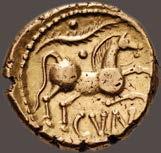

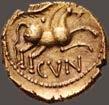


Ex Borden Hoard (PAS BH-137A04).
The Borden Hoard, a group of 42 Cunobelin gold staters of unparalleled quality, is the kind of carefully researched and coordinated find that fills metal detectorists’ dreams. On New Year’s Day 1873, workmen digging in a garden in the parish of Borden, Kent uncovered three gold coins: a Roman aureus of emperor Claudius and two gold staters of the British Celtic king Cunobelin. No further discoveries were made for nearly 150 years.
Then in 2018, a detectorist, armed with knowledge of the Victorian find, approached the land owner seeking permission to detect on their land. Permission was granted, but as the fields were then filled with crops, only limited areas could be detected. Those searches revealed nothing. Finally, in February 2019, the nowbarren fields underwent a proper search. A single gold stater was found in an area of particularly deep soil. The landowner agreed to bring in an excavator to remove the top layers of dirt, allowing the detectorist’s equipment to reach deeper into the ground, and this stunning hoard was at long last brought back into the light of day.
The staters from the hoard are remarkable for their highly lustrous, original surfaces. It is evident they saw very little or no circulation before being buried. The considerable depth of the deposit no doubt further resulted in their exceptional state of preservation.
220
918 919 920
922
921. CELTIC, Belgae(?). Uninscribed. Circa 80-50 BC. AV Stater (19mm, 6.05 g, 4h). Chute type (Durotrigan A). Devolved head of Apollo right / Disjointed horse left; pellets above, ‘crab’ below, pellet in lozenge above tail; below, zigzag and pellet pattern between two parallel lines. ABC 746; Van Arsdell 1205-1; SCBC 22. Light marks on obverse. VF. ($500)


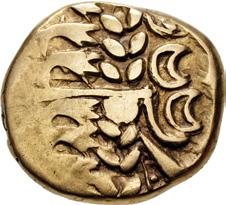


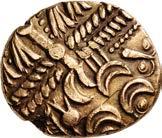

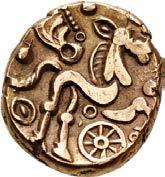




From the Trehearne Collection.
922. CELTIC, Belgae(?). Uninscribed. Circa 80-50 BC. AV Stater (18mm, 6.07 g, 10h). Chute type (Durotrigan A). Devolved head of Apollo right / Disjointed horse left; pellets above, ‘crab’ below, pellet in lozenge above tail; below, zigzag and pellet pattern between two parallel lines. ABC 746; Van Arsdell 1205-1; SCBC 22. Light mark on reverse. VF. ($500)
From the Trehearne Collection.
Extremely Rare Ladder Mane Stater
923. CELTIC, Belgae(?). Uninscribed. Circa 50-20 BC. AV Stater (17mm, 5.32 g, 4h). Ladder Mane type. Devolved head of Apollo right with two ‘hidden face’ motifs / Disjointed horse left right with ‘ladder mane’; wing above, wheel below, [sprial sun to right[. PAS BH-785FF3 (this coin); ABC 764; Van Arsdell –; Van Arsdell, “Three New Celtic Staters,” in NumCirc C.3 (April 1992), 346-1; SCBC –. Toned, light marks on obverse. Near EF. ($4000)
Found in St. Mary Bourne, Hampshire, August 2012.
This distinctive type was first published in the Numismatic Circular in May 1992, where Robert Van Arsdell described it as ‘an Atrebatic type [that] represents the transition between the uninscribed coins and the first dynastic issues of Commius.’ The authors of ABC and subsequently Sills give the type to Hampshire, which was the territory of the Belgae. The very neat die cutting with the ‘ladder’ mane and twisted tail to the horse distinguish it from other late uninscribed issues. The rounded wing shaped object above the horse is found on uninscribed types of the Catuvellauni.

924.
Uninscribed. Circa 65-20 BC. BI Stater (18mm, 4.16 g, 4h). Cranborn Chase type (Durotrigan E). Devolved head of Apollo right / Disjointed horse left; pellets above, pellet below, pellet in lozenge above tail, [zigzag and pellet pattern between two parallel exergue lines]. ABC 2157; Van Arsdell 1235-1; SCBC 366. Minor deposits, small flan flaw on reverse. Near EF. ($400)
From the Trehearne Collection.
Superb Bodvoc Stater

221
CELTIC, Durotriges.
925. CELTIC, Dobunni. Bodvoc. Circa 15-10 BC. AV Stater (17mm, 5.50 g, 3h). Boduoc Bold type (Dobunnic C). BODuOC on plain field / Disjointed horse right with triple tail; wheel below, two pellet-in-annulets and crescent above; pellets and small crosses around. ABC 2039; Van Arsdell 1052-1; SCBC 388. Lustrous. EF. ($5000)
921
926. CELTIC, North-Eastern series (‘Corieltauvi’). Uninscribed. Circa 60-20 BC. AV Stater (18mm, 5.89 g, 10h). North East Coast, right type (Corieltauvian A). Devolved head of Apollo right / Disjointed horse right; below, pelleted sun over zig-zag line; pellets around. ABC 1719; Van Arsdell 800-9; SCBC 28. Minor area of flat strike. Near EF. ($750)
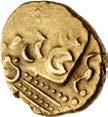

927. CELTIC, North-Eastern series (‘Corieltauvi’). Uninscribed. Circa 60-20 BC. AV Stater (18mm, 6.14 g, 11h). North East Coast, left type (Corieltauvian A). Devolved head of Apollo right / Disjointed horse left; below, pelleted sun over zig-zag line; pellets around. ABC 1722; Van Arsdell 804-1; SCBC 29. Toned, hairline flan crack. VF. ($600)
From the Trehearne Collection.
928. CELTIC, North-Eastern series (‘Corieltauvi’). Uninscribed. Circa 50-20 BC. AV Stater (18mm, 5.47 g, 10h). South Ferriby Legs type (Corieltauvian D). Devolved head of Apollo right / Disjointed horse left; eight-pointed star below, ‘anchor’ face above. ABC 1743; Van Arsdell 811-1; SCBC 390. Edge split. Near EF. ($750)




929. CELTIC, North-Eastern series (‘Corieltauvi’). Volisios Dumnocoveros. Circa AD 35-40. AV Stater (18mm, 5.02 g, 3h). Volisios Dumnocoveros type (Corieltauvian P). Vertical wreath; uOLi/ÍiOÍ in two lines across field; pelleted annulet and spiral in alternating quarters / Disjointed horse left; triple pellets to left; Du NOCO uerOÍ around. ABC 1980; Van Arsdell 978-1; SCBC 416. Off center on reverse. Good VF. ($1500)
930. CELTIC, Iceni. Uninscribed. Circa 60-50 BC. AV Stater (81mm, 6.04 g, 10h). Norfolk Wolf, right type (Icenian A). Devolved head of Apollo right / Disjointed wolf right; pellet over crescent above, crescent and pellets above, bird to upper left. MfT Norfolk Wolf A, die group 4, dies M/14; ABC 1393; Van Arsdell 610-1; SCBC 30. Worn obverse die. VF. ($1000)
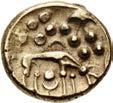
From the Trehearne Collection.
931. ANGLO-SAXON, Kings of Northumbria. Aldfrith. 685-705. AR Sceatt (10mm, 1.11 g, 12h). York mint. ม aዢčŊ l ዢčк˝ , pellet-in-annulet / Quadruped with forked tail standing left. SCBI 69 (Abramson), 827 (this coin); Booth, Sceattas 3 (dies A/c); Chapman 1-8; Pirie, Guide 1.2; North 176; SCBC 846. Attractive find patina. Near EF. Rare in this grade. ($1500)

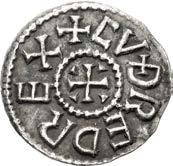
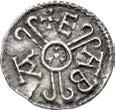






Ex Tony Abramson Collection. Found near Lincoln, Lincolnshire, 2012.
932. ANGLO-SAXON, Kings of Kent. Cuthred. 798-807. AR Penny (18mm, 1.22 g, 12h). Canterbury mint; Eaba, moneyer. Struck 798-805. ม ü⎍ T ʼዞዝ ʼዞҟ , short cross pattée with wedges in angles / ม ዞ ¥ዛ ¥ in angles of two-lined tribrach moline with annulet at center containing small tribrach. Naismith C18.4; SCBI 67 (BM), 675; North 209; SCBC 876. Toned, small edge crack, slight porosity. Near EF. ($2500)
222
926 927
928 929
933. ANGLO-SAXON, Archbishops of Canterbury. Æthelheard, with Offa of Mercia as overlord. 792/3-805. AR Penny (16mm, 1.07 g, 7h). Three-line type. Canterbury mint. Struck circa 792/3-796. ¨ዞዝዢ⌦ / Hዞ¨ʼዝ / ¨ʼæዞዩ in three lines / (triangle) Ȯ (triangle)/ ḦมḦ ℽዟዟ¨ / Ḩ ʼዞҢ / in three lines. EMC 2020.0317 (this coin, since filed); Chick 247; SCBI 67 (BM), 747-8; North 229; SCBC 885. Some porosity, edges filed round. VF. Very rare. ($1500) Found near Orsett, Essex, September 2020.
934. ANGLO-SAXON, Kings of Mercia. Offa. 757-796. AR Penny (17mm, 0.97 g, 6h). Light coinage, portrait type. Canterbury mint; Peohtweald, moneyer. Struck circa 785-792/3. Draped bust right / ዩዞ HͿ ⎍¥ ⌦č in angles of a Celtic cross with a long cross
ȮɭnዞͿ© , double pincer-shaped cross
132; North 347; SCBC 916. Toned. Good VF. ($3000)
AR Penny
1.14 g,
in East Anglia (Ipswich?); Monne, moneyer. Struck 837/8-845. ม , short cross pattée with pellets in quarters / ม ó ɭዡ ó ɭ Ḩ ዡ Ḩ ዞͿ , short cross pattée with pellets in quarters. EMC 2015.0155 = EMC 2021.0412 (this coin); Naismith E45.2; cf. SCBI 36 (Berlin), 92 (for type); North 446/3; SCBC 951. Edge slightly filed since discovery, minor edge loss, small flan split. Good VF. A highly unusual rendering of the king’s name. ($1000)
Found near Louth, Lincolnshire, May 2015.
937. ANGLO-SAXON, Anglo-Viking (Danish Northumbria). Cnut. Circa 900-905. AR Penny (20mm, 1.35 g, 10h). Class IIe/Cunneti type. York mint. Inverted patriarchal cross with pellets in upper angles / Short cross pattée with pellets in second and third quarters. L&S class IIe; SCBI 29 (Merseyside) 333 (same dies); North 501; SCBC 993. Rich old iridescent toning. Good VF. ($750)

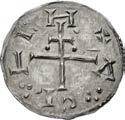
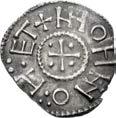
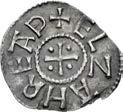

Ex Spink 236 (22 March 2016), lot 595.
938. ANGLO-SAXON, Kings of All England. Æthelred II. 978-1016. AR Penny (20mm, 1.65 g, 7h). Crux type (BMC iiia, Hild. C). Shaftesbury mint; Æthelgar, moneyer. Struck circa 991-997. Draped bust left; trefoil-tipped scepter to left / ม

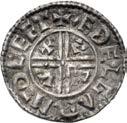
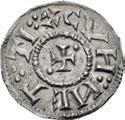
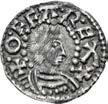
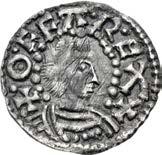


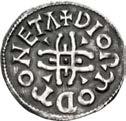

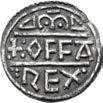
üዞዟͿ , voided short cross; ü ʼ ⎍ ҟ in quarters. SCBI –; North 770; SCBC 1148. Toned, crimped, peck marks. VF. Rare moneyer at this mint. ($500)
With ticket indicating the coin was purchased from Baldwin’s, October 1966.
223
fleurée over small saltire cross of petals. Chick 128; cf. SCBI 67 (BM), 34-5 (for similar); North 294; SCBC 905. Waterworn, slightly crimped. VF. Very rare. ($3000)
ม ዝዢɭʼȮɭዝ
935. ANGLO-SAXON, Kings of Mercia. Coenwulf. 796-821. AR Penny (20mm, 1.46 g, 6h). Canterbury mint; Deormod, moneyer. Struck circa 810-812. Diademed bust right /
superimposed on cross pommée; wedges in angles. Naismith 39.1; SCBI 67 (BM),
936. ANGLO-SAXON, Kings of East Anglia. Æthelstan I. Circa 827-845.
(20mm,
3h). Mint
®T ዞ⌦ű¨ʼ ዦ!ɭ
936 937 938
939. ANGLO-SAXON, Kings of All England. Æthelred II. 978-1016. AR Penny (20.5mm, 1.67 g, 3h). Intermediate Small Cross/Crux type mule (BMC iii, Hild Cb). Winchester mint; Beorhtsige, moneyer. Struck circa 995-997. Diademed and draped bust left / ม ዛӎʼ˫ዢűዞ ዦ!ɭ ዩዢn , voided short cross; ü ʼ ⎍ ҟ in quarters. Harvey 542a (dies Z/s – this coin); North p. 159, n. 312; SCBC 1150/1148. Worn reverse die. Small edge split. Pecks. Toned. VF. Rare. ($750)
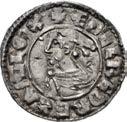
Ex Captain “Peter” Arnot (Buckland, Dix, and Wood, 21 March 1995), lot 134; Glendining (14 March 1973), lot 1; 1972 Stryiewo Wielke Hoard.
940. ANGLO-SAXON, Kings of All England. Cnut. 1016-1035. AR Penny (18mm, 0.94 g, 9h). Pointed Helmet type (BMC xiv, Hild. G). Stamford mint; Ælfheah, moneyer. Struck circa 1023-1030. Bust left, wearing pointed helmet; trefoiltipped scepter before / ม ©⌦ዟ©ዡ ɭn Ӳ˸an , voided short cross, limbs united at base by two concentric circles with pellet in center; in each angle, broken annulet enclosing pellet; additional pellets in first and fourth quarters. SCBI 15 (Copenhagen), 3504; North 787; SCBC 1158. Iridescent toning, small edge split. Near EF. ($400)
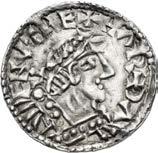
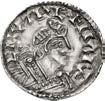
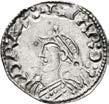
941. ANGLO-SAXON, Kings of All England. Harold I Harefoot. 1035-1040. AR Penny (17mm, 0.85 g, 6h). Jewel Cross type (BMC i, Hild. A). London mint; Korf, moneyer. Struck 1035-circa 1038. Diademed bust left; pellet to left /
üɭያዟዢ ɭn ⌦⎍nዝዞnዞዞ Ḧ , cross composed of four ovals united at base by two concentric circles enclosing a pellet. SCBI 40 (Stockholm), 398 (same rev. die); North 802; SCBC 1163. Lightly brushed. Good VF. ($750)
942. ANGLO-SAXON, Kings of All England. Harold I Harefoot. 1035-1040. AR Penny (18mm, 1.11 g, 12h). Jewel Cross type (BMC i, Hild. A). Thetford mint; Brunstan, moneyer. Struck 1035-circa 1038. Diademed bust left /
ɭn T ዞɭዝ , cross composed of four ovals united at base by two concentric circles enclosing a pellet. SCBI 18 (Copenhagen), 553 (same dies); North 802; SCBC 1163. A few black deposits, small patch of roughness. Good VF. ($750)
943. ANGLO-SAXON, Kings of All England. Harthacnut. 1035-1042. AR Penny (17mm, 1.15 g, 10h). Jewel Cross type (BMC ia, Hild. Aa). Canterbury mint; Ælfræd, moneyer. Struck circa 1036-1037. Diademed bust right / ม ® ⌦ዟያዞዝ ɭn
üዞn˸ , cross composed of four ovals united at base by two concentric circles. SCBI 40 (Stockholm), 8 (same dies); North 809; SCBC 1167. Some light marks. EF. ($4000)
Unrecorded Chester Mint Harthacnut
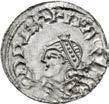
944. ANGLO-SAXON, Kings of All England. Harthacnut. 1035-1042. AR Penny (16mm, 0.97 g, 6h). Jewel Cross type (BMC ia, Hild. Aa). Chester mint; Eadsige, moenyer. Struck circa 1036-1037. Diademed bust right / ม ዞዝSዢűዞ ɭn ⌦ዞዢü , cross composed of four ovals united at base by two concentric circles. SCBI –; North 809; SCBC 1167. Lightly toned, slight double strike on obverse. EF. Apparently unrecorded for this mint. An intriguing coin. ($4000)

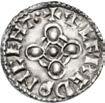
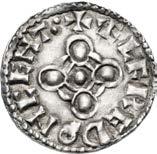

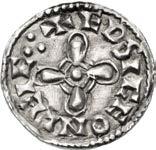
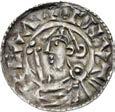

Coins of Harthacnut of the Jewel Cross type are very seldom encountered from mints north of the river Thames. This was the territory assigned to his half brother Harold I following the division of the kingdom after the death of their father Cnut. While the Jewel Cross type is well attested for Harold I at Chester, no pennies of Harthacnut are recorded. Eadsige is known at Dover for this reign and type.
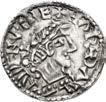



224
ม
ม ዛያ⎍nSͿ©n
940 941 942 941
945. ANGLO-SAXON, Kings of All England. Harthacnut. 1035-1042. AR Penny (18mm, 1.12 g, 1h). Arm and Scepter type (BMC [Cnut] xvii, Hild. [Cnut] I). Lincoln mint; Godric, moneyer. Struck in the name of Cnut, 1040-1042. Diademed bust left, holding trefoil-tipped scepter / ม űɭዝያዢü ɭn ⌦ዢnüɭ , quadrilateral, with pellet in center and angles, over voided short cross. Mossop pl. LXIV, 9 (dies A/a) = SCBI 14 (Copenhagen), 1626; North 799; SCBC 1169. Slight porosity. Near VF. ($1500)
946. ANGLO-SAXON, Kings of All England. Edward the Confessor. 1042-1066. AR Penny (19mm, 1.33 g, 12h). Sovereign/Eagles type (BMC ixa, Hild. H var.). York mint; Thorr, moneyer. Struck circa 1056-1059. Edward seated facing on throne, holding scepter and globus cruciger / ม T ɭያያ ɭn ዞɭዟዞያዩዢüü , voided cross; martlets in quarters, with additional annulets in second and third. Freeman 388; SCBI 21 (Reading), 383-4 (same dies); North 827 var. (annulets on rev.); SCBC 1181 var. (same). A few light marks under rich golden toning. Good VF. ($750)
From the D.K. Collection.
947. ANGLO-SAXON, Kings of All England. Edward the Confessor. 1042-1066. AR Penny (20mm, 1.41 g, 6h). Hammer Cross type (BMC xia, Hild. G var.). York mint; Ulfketill, moneyer. Struck circa 1059-1062. Crowned bust right, scepter before /
ɭn ዞɭዟዞያዩ , voided cross, arms terminating in inward-facing crescents; annulet in second quarter. Freeman 408; SCBI 21 (Yorkshire), 494 (same dies); North 828; SCBC 1182. Toned. Good VF. ($500)
Ex Classical Numismatic Group Electronic Auction 408 (25 October 2017), lot 674.
948. NORMAN. William I ‘the Conqueror’. 1066-1087. AR Penny (18mm, 1.16 g, 9h). Two Scepters type (BMC iv). Norwich mint; Eadweald, moneyer. Struck circa 1072-1074. Crowned facing bust; cross-tipped scepter to left, trefoil-tipped scepter to right / ม ዞ©ዝዩɭ⌦ዝ ɭn nɭያ T, cross fleurée, with annulet at center; all over cross botonnée in saltire. SCBI –; BMC –; North 844; SCBC 1253. Slight porosity. Wavy flan. VF. ($750)
Ex Triton IV (5 December 2000), lot 948.
949. NORMAN. William I ‘the Conqueror’. 1066-1087. AR Penny (20mm, 1.39 g, 3h). Paxs type (BMC viii). Winchester mint; Wigmund. Struck circa 1083-1086. Crowned facing bust, holding scepter; annulet on right shoulder / ม ዩዢȵ⎍nዝ ɭn ዩዢ ü, cross pattée; letters of P A X S in annulets within quarters. Harvey – (dies –/b; unlisted obv. die); SCBI 20 (Mack), 1468 (same dies); BMC 1132-4; North 848; SCBC 1257. Light golden toning. Good VF. ($750)
From the D.K. Collection.
è ዢዢ , crowned and draped bust left, holding cross-tipped scepter; two quatrefoils to left / ม


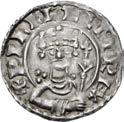
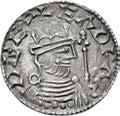
, small cross pattée; quatrefoils-in-annulets in outer legend. Pimprez 7 = M. Allen, “The Mints and Moneyers of England and Wales 1066-1158: Addenda and Corrigenda” in BNJ (2012), p. 90 (this coin); SCBI –; BMC –; North 867; SCBC 1272. Usual areas of weakness, official edge snick otherwise much as struck. Lightly toned. VF. Much as struck on a neat round flan. Extremely rare – one of only two known examples of this type for Hereford, and the sole example of this moneyer. ($2500)

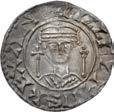
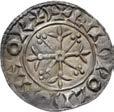


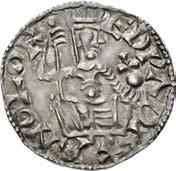
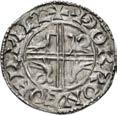

Ex 2002 Pimprez (Oise) Hoard (Spink 170, 6 October 2004), lot 391.
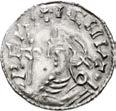
225
⎍⌦ዟዢüዢ⌦
ม
ʼዞ⎍ [...] ˫ዩዞ
ม ʼͿ ɭn ዡዞʼዞ
950. NORMAN. Henry I. 1100-1135. AR Penny (21mm, 1.39 g, 10h). Double Inscription type (BMC xi). Hereford mint; Ravenswert, moneyer. Struck circa 1115. [...] ዞ
/
947 948 949 950
951. NORMAN. Henry I. 1100-1135. AR Penny (19mm, 1.33 g, 9h). Facing Bust/Cross Fleury type (BMX x). Worcester mint; Godric, moneyer. Struck circa 1117. Crowned facing bust; annulets flanking / ม gɭዝʼዢü⎍S Ḧ ɭn Ḧ ዩዢያ , cross fleurée, with annulet at center. EMC 2022.0288 (this coin); SCBI –; BMC –; North 866; SCBC 1271. Edge snick, somewhat irregular edge. Near VF. Very rare, this moneyer previously unrecorded for type X. ($750) Found near Stowmarket, Suffolk, before 2018.
952. NORMAN. Stephen. 1135-1154. AR Penny (18mm, 1.33 g, 6h). Profile/Cross and Piles type (BMC vi). Canterbury(?) mint; Rodbert, moneyer. Struck circa 1150-1154. Crowned bust left, holding scepter / ม ʼɭዝዛዞʼ [ ͿḦ ɭn Ḧ ü¥ ] n , cross fleurée, with saltire cross at center and piles surmounted by trefoils in each quarter. Mack 79; SCBI 20 (Mack), 1618; North 879; SCBC 1281; Wicklewood Hoard 76a (same rev. die). Some light porosity. VF. Bold portrait. Very rare. ($750)
953. PLANTAGENET. Henry II. 1154-1189. AR Penny (20mm, 1.43 g, 3h). Short cross type, class Ib1. Winchester mint; Gocelm, moneyer. Struck 1180-circa 1182. Crowned bust facing, holding scepter / Voided short cross with small crosses in angles. Harvey 2457c (dies J/j) = SCBI 56 (Mass), 502; North 963; SCBC 1344. Toned, with a sharply defined portrait. Good VF. ($300)
From the New Horizons Collection. Ex Classical Numismatic Group inventory 498110 (November 2018); Dix Noonan Webb 148 (18 September 2018), lot 736; Spink Numismatic Circular LXXV.9 (September 1967), no. 5854.
954. PLANTAGENET. John. 1199-1216. AR Penny (18mm, 1.43 g, 6h). Short Cross type, class Va2. Canterbury mint; Goldwine, moneyer. Struck in the name of Henry II, 1204-1205. Crowned bust facing, holding scepter / Voided short cross with small crosses in angles. SCBI 56 (Mass), 1203 (this coin); North 969; SCBC 1350B. Deeply toned. Near EF. Well struck. ($300)
From the New Horizons Collection. Ex Dix Noonan Webb 122 (2 April 2014), lot 228; J.P. Mass Collection (Part III, Dix Noonan Webb 69, 15 March 2006), lot 1018; G.V. Doubleday (Glendining, 8 June 1988), lot 955; L.A. Lawrence (Glendining, 28 November 1951), lot 1012 (part of).
955. PLANTAGENET. John. 1199-1216. AR Penny (20mm, 1.46 g, 3h). Short Cross type, class Vb2. London mint; Willelm L, moneyer. Struck in the name of Henry II, 1205-1207. Crowned bust facing, holding scepter / Voided short cross with small crosses in angles. SCBI 56 (Mass), 1203 (this coin); North 969; SCBC 1350B. Deeply toned. Near EF. Well struck, rare moneyer. ($300)

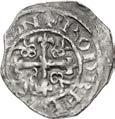


From the New Horizons Collection. Ex Classical Numismatic Group inventory 498109 (November 2018); R. Inder (Dix Noonan Webb 148, 18 September 2018), lot 188; Dix Noonan Webb 122 (2 April 2014), lot 228; J.P. Mass Collection (Part III, Dix Noonan Webb 69, 15 March 2006), lot 1018; G.V. Doubleday (Glendining, 8 June 1988), lot 955; L.A. Lawrence (Glendining, 28 November 1951), lot 1012 (part of).
956. PLANTAGENET. Edward I. 1272-1307. AR Penny (18mm, 1.49 g, 5h). Long cross coinage, class 7. London mint; Phelip, moneyer. Struck 1272-1275. Crowned facing bust, holding scepter / Voided long cross, with trefoil in each quarter. North 1002; SCBC 1378. Toned. Good VF. Rare. ($400)
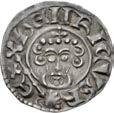
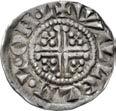
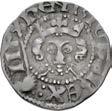
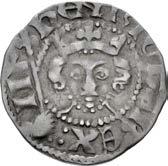
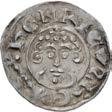

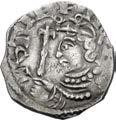

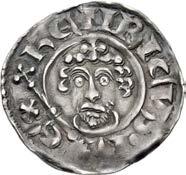
From the New Horizons Collection, with an old Seaby ticket.
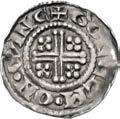
226
951 952 954 955
Select Highlights from the Malthouse Collection


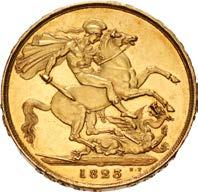
The Malthouse Collection was formed by two generations of an old English family in the late nineteenth and early twentieth centuries. It is understood that the final addition to the collection was made around 1940. The coins were housed in a fine mahogany cabinet, lying undisturbed for the past eighty-three years. Consequently a very high proportion of the coins have wonderfully rich cabinet tones. Further selections from the Malthouse Collection will be offered in future e-sales.
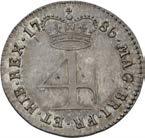
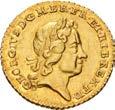

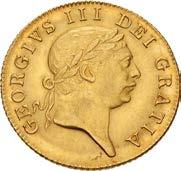

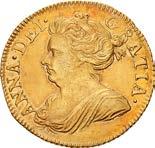


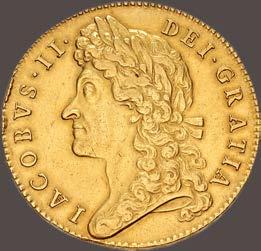



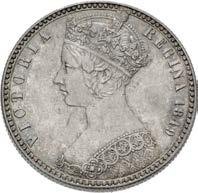
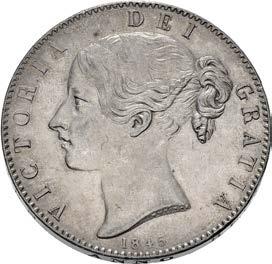

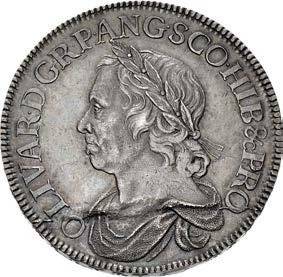
957. PLANTAGENET. Edward III. 1327-1377. AV Half Noble (27mm, 3.81 g, 11h). Fourth coinage, Pre-Treaty period, series C/A mule. Tower (London) mint; im: cross 3. Struck 1351-1352. Edward standing facing in ship with bowsprit, holding sword and shield; ornaments 1-1-1, ropes 3/3, quatrefoils 3/3, lis 4 / Voided short cross potent over cross fleurée et lisée; in each quarter, crown over lion passant; at center, E within angled quadrilobe, each angle ending in trilobe; all within polylobe; trefoils in spandrels; pellet below crown in fourth quarter. Lawrence 4 = BM 1935,0603.7 (same dies); Schneider 14 (same obv. die); North 1145; SCBC 1492. Toned, trace of black deposits, hairline edge crack. Good VF. Very rare. ($2500)


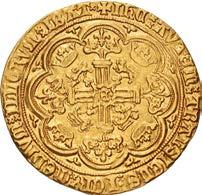
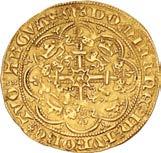
Ex Dr. Baumhauer Collection.
Note the pellet below the crown in the 4th quarter of the reverse, yet another unusual feature of the mysterious class A series.
958. PLANTAGENET. Edward III. 1327-1377. AV Noble (33mm, 6.98 g, 2h). Fourth coinage, Post-Treaty period, Group III. Calais mint. Struck 1369-1377. Edward standing facing in ship, holding sword and shield; ornaments 1-1-1-1, ropes 3/1, quatrefoils 4/4, lis 4; flag at stern / Voided short cross potent over cross fleurée, pellets flanking top and bottom lis; in each angle, crown over lion passant over voided trefoil; at center, E and pellet within quadrilobe; all within polylobe, with trefoils in spandrels. Cf. Schneider 115 (for type); North 1281; SCBC 1521. Edge filed. Some die rust. VF. ($2500)
From the Malthouse Collection.
959. PLANTAGENET. Edward III. 1327-1377. AR Groat (27mm, 4.43 g, 10h). Pre-Treaty period, group C. Tower (London) mint; im: cross 1. Struck 1351-1352. Crowned facing bust within tressure of arches with lis at cusps / Long cross pattée, triple pellets in quarters. Lawrence 27; North 1147; SCBC 1565. Light marks under rich tone. Good VF. ($400)
From the New Horizons Collection. Ex Classical Numismatic Group inventory 496245 (December 2018); WRG Collection (Classical Numismatic Review XLIII.2 [Summer 2018]), no. 485448, purchased from William B. Porter, April 1991.
960. LANCASTER. Henry V. 1413-1422. AV Noble (33mm, 7.05 g, 2h). Class C. Tower (London) mint. Henry standing facing in ship with bowsprit, holding sword and shield; rosette to left of hand; ornaments -11-11, ropes 3/2, quatrefoils 3/3, lis 1-2-1; broken annulet on hull / Voided short cross potent over cross fleurée; in each angle, crown over lion passant over trefoil; at center, ƌ within angled quadrilobe; all within polylobe, with trefoils in spandrels. Schneider 227 (same rev. die); North 1371; SCBC 1742. Polished, pinhole striking perforation in legend. Near EF. Sharp details. ($5000)
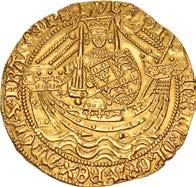
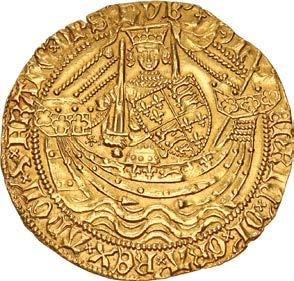
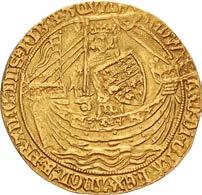
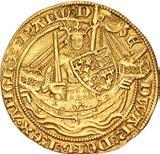
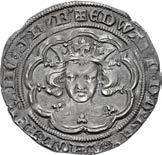
228
957 958
961. LANCASTER. Henry V. 1413-1422. AR Farthing (9mm, 0.30 g, 11h). Class G. London (Tower) mint. Crowned facing bust / Long cross pattée, triple pellets in quarters. Withers III 2f; North 1413; SCBC 1798. Toned. Good VF. An excellent example of this very rare little coin. ($1000)
962. LANCASTER. Henry VI. First reign, 1422-1461. AV Quarter Noble (19mm, 1.74 g, 2h). Annulet issue. Tower (London) mint; im: lis. Struck 1422-circa 1430. Coat-of-arms; small lis above; all within polylobe with trefoil cusps / Cross fleurée with lis at ends and in center; in each angle, lion passant left over trefoil; all within polylobe, with pellet in spandrels; mullet in legend. Schneider 295-7; North 1420; SCBC 1810. In NGC encapsulation 6515817-002, graded MS 65. Top Pop. A crisp, high grade coin. ($1000)
From the Malthouse Collection. Ex C.L.V. Marno Collection (sold en bloc to Spink, 1923).
963. YORK (Restored). Edward IV. Second reign, 1471-1483. AV Angel (28mm, 4.99 g, 12h). Tower (London) mint; im: annulet/–. Struck 1472-1473. Archangel Michael slaying the Dragon / Ship bearing shield and cross, E Ⴙ flanking cross. Schneider 455 (same obv. die); North 1626; SCBC 2091. Earthen deposits, dig on reverse, scratches. VF. ($2000)
964. YORK (Restored). Edward IV. Second reign, 1471-1483. AV Angel (27mm, 5.02 g, 12h).

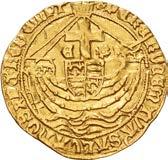
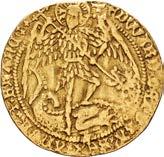
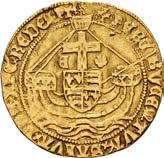






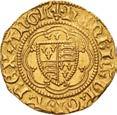

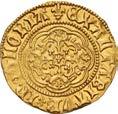
229
From the Malthouse Collection.
Tower (London) mint; im: pierced cross and pellet in second quarter. Struck 1477-1480. Archangel Michael slaying the Dragon / Ship bearing shield and cross; Ě and rose flanking cross. Cf. Schneider 464-5 (for type); North 1626; SCBC 2091. Scattered light marks, faint traces of mount. Good Fine. ($1500)
965. YORK (Restored). Edward IV. Second reign, 1471-1483. AV Angel (28mm, 5.02 g, 10h). Tower (London) mint; im: cinquefoil. Struck 1480-1483. Archangel Michael slaying the Dragon / Ship bearing shield and cross, E and rose flanking cross. Cf. Schneider 467-8 (for type); North 1626; SCBC 2091. Hairline edge split, minor marks, slightly wavy flan. Near VF. ($1500)
964 965
From the Malthouse Collection.
966. TUDOR. Henry VII. 1485-1509. AR Groat (26mm, 2.83 g, 7h). Facing Bust issue, class IIa. London (Tower) mint; im: cinquefoil/–. Struck 1489-1493. Crowned facing bust within tressure of arches with lis at cusps / Long cross pattée; triple pellets in quarters. North 1704; SCBC 2195. Toned. Good VF. ($500)
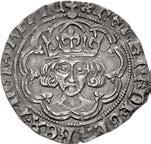

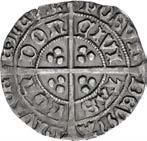

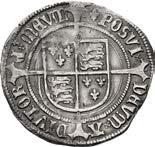


From the New Horizons Collection. Ex Stewartby (Part 5, Spink 243, 28 March 2017), lot 1479; R.C. Lockett (English Part II, Glendining, 11 October 1956), lot 1705a; W.J. Potter Collection.
967. TUDOR. Henry VII. 1485-1509. AR Penny (16mm, 0.73 g, 8h). Sovereign type. London (Tower) mint; im: –. Henry enthroned facing, holding scepter and globus cruciger, on throne with two pillars decorated with lis / Coat-of-arms over long cross fourchée. Allen, Classification 4; North 1726; SCBC 2230. Toned. VF. Well struck and centered. ($300)
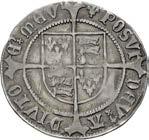

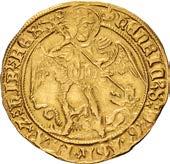


From the New Horizons Collection. Ex Classical Numismatic Group inventory 537686 (July 2020); M. Lessen (Dix Noonan Webb 168, 29 January 2020), lot 830, purchased from Seaby, 11 March 1965.
968. TUDOR. Henry VII. 1485-1509. AR Groat (25mm, 3.03 g, 5h). Tentative profile issue. Tower (London) mint; im: –/lis. Struck 1502-1504. Crowned bust right; double band to crown / Coat-of-arms over long cross fourchée. Potter & Winstanley Type Ib, obv. die 3, rev. 10; SCBI 23 (Ashmolean), 766 (same obv. die); North 1744; SCBC 2256. Some light marks. Toned. Near VF. Extremely rare from these early tentative dies reading hENRICVS. ($750)
969. TUDOR. Henry VII. 1485-1509. AR Groat (26.5mm, 2.64 g, 7h). Tentative profile issue. Tower (London) mint; im: –/lis. Struck 1502-1504. Crowned bust right; double band to crown / Coat-of-arms over long cross fourchée. Potter & Winstanley Type Ib, obv. die 4, rev. 10; SCBI 23 (Ashmolean), –; North 1744; SCBC 2256. Scratches in field on obverse. Toned. Near VF. Very rare early tentative issue reading hENRIC. ($750)
Ex R.A. Shuttlewood (Spink 151, 15 March 2001), lot 75.
970. TUDOR. Henry VIII. 1509-1547. AV Angel (29mm, 5.12 g, 12h). Third coinage. London (Tower) mint; im: lis. Struck 1544-1547. Archangel Michael slaying dragon to lower right; annulet to left of St. Michael’s head / Ship bearing cross above coat-of-arms; ƌ ຎ flanking base of cross; ი on hull. Whitton, p. 188; Schneider 624 var. (legend stops); North 1830; SCBC 2299. Richly toned. In NGC encapsulation 6511703-001, graded AU 58. ($3000)
Ex Triton XVII (7 January 2014) lot 1441; Ross Blakey (Spink 217, 26 June 2013), 471.
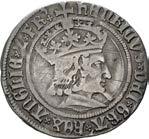
230
968
969
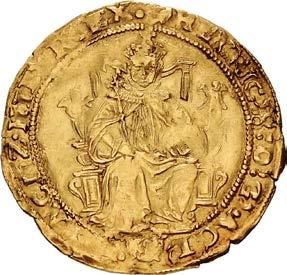
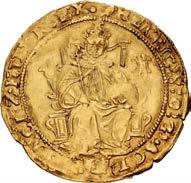

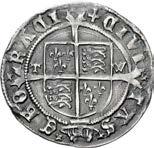
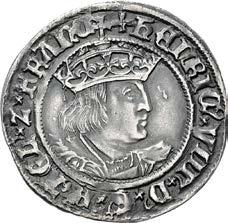


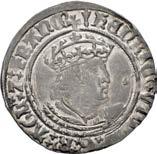
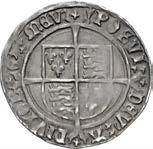

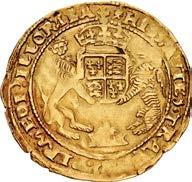
231
971. TUDOR. Henry VIII. 1509-1547. AR Groat (25mm, 2.80 g, 9h). Second coinage. Tower (London) mint; im: arrow. Struck 1526-1544. Crowned bust (Laker D) right / Coat-of-arms over long cross fourchée; saltires in forks. North 1797; SCBC 2337E. Slight double strike. In NGC encapsulation 6511703-004, graded AU 58 (incorrectly as SCBC 2337C). Lustrous. ($750)
972. TUDOR. Henry VIII. 1509-1547. AR Groat (25mm, 2.68 g, 6h). Second coinage. Tower (London) mint; im: arrow. Struck 1526-1544. Crowned bust (Laker D) right / Coat-of-arms over long cross fourchée; saltires in forks. North 1797; SCBC 2337E. Richly toned. VF. ($500)
Thomas Wolsey Groat
973. TUDOR. Henry VIII. 1509-1547. AR Groat (25mm, 2.65 g, 3h). Second coinage. York mint; im: voided cross. Thomas Wolsey, archbishop. Struck 1526-1530. Crowned bust (Laker D) right / Coat-of-arms over long cross fourchée; saltires in forks, T W flanking, tasseled gallero below at base of cross. North 1799; SCBC 2339. Some light tooling to remove deposits in parts of legends. Good VF. Well struck issue of Thomas Wolsey. ($750)
974. TUDOR. Edward VI. 1547-1553. AV Half Sovereign (33mm, 6.14 g, 12h). Tower (London); im: martlet. Posthumous issue in the name of Henry VIII, struck 1547-1549. Edward seated facing on throne, holding scepter and orb; rose below / Crowned coat-of-arms with lion and griffin as supporters; crown below. Cf. Schneider 660 (for type); North 1865; SCBC 2391. In NGC encapsulation 6515817-003, graded MS 61. Pleasing lustrous surfaces. ($4000) From the Malthouse Collection.
971
972
Charming Edward VI Portrait
975. TUDOR. Edward VI. 1547-1553. AV Half Sovereign (29mm, 5.28 g, 8h). Second period. Southwark mint; im: Y. Struck January 1549-April 1550. Bareheaded and armored bust right / Crowned coat-of-arms; E R flanking. Schneider 686 var. (stops on rev.); North 1908; SCBC 2435. Hairlines flan crack in center. Toned. VF. A pleasant portrait of the boy king. ($4000)
From the Malthouse Collection.
976. TUDOR. Philip & Mary. 1554-1558. AR Shilling (31mm, 6.13 g, 5h). Tower (London) mint. Dated 1554. Confronted busts of Philip, armored, and Mary, veiled; crown above / Crowned coat-of-arms; X II (mark of value) flanking crown. North 1967; SCBC 2500. Toned, edge splits. Near VF. Well balanced portraits. ($1000)


From the Malthouse Collection.
977. TUDOR. Elizabeth I. 1558-1603. AV Half Pound (30mm, 5.04 g, 9h). First issue, crown gold coinage. Tower (London) mint; im: cross-crosslet. Struck 1560-1561. Crowned bust 3C left / Crowned coat-of-arms; E R flanking. Brown & Comber G6; Schneider 738 var. (obv. legend); North 1944; SCBC 2520B. Toned, slightly clipped, light scratch on reverse. VF. ($3000)



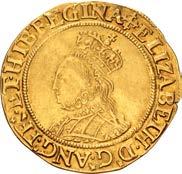
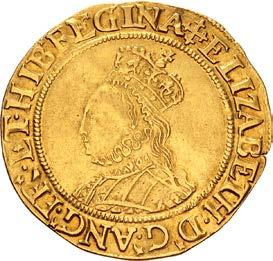
From the Malthouse Collection.
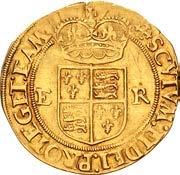
232
FACTV’·
6513467-001,
· ISTVD ·
AU 55.
·
From the Malthouse Collection.
980
From
From the Malthouse Collection.
981
NGC
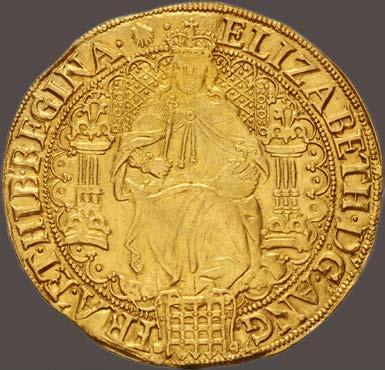



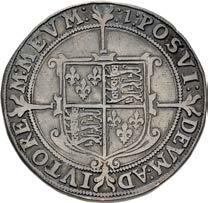

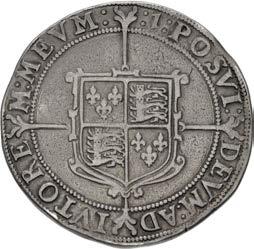
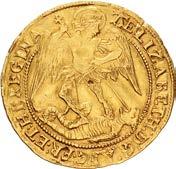


233
Elizabeth Sovereign Graded AU 55
978. TUDOR. Elizabeth I. 1558-1603. AV Sovereign (43mm, 15.29 g, 7h). Sixth issue, fine gold coinage. Tower (London) mint; im: escallop. Struck 1584-1586. ELIZABETH · D’· G’· ANG’· FRA’· ET · HIB · REGINA · ჲ ·, Elizabeth, holding lis-tipped scepter in right hand, left hand set on globus cruciger propped on her knee, seated facing on ornate throne with pellets on back and pillars with single pellets; all within tressure of arches; portcullis (with chains) below / ჲ A · DNO’·
EST
ET
EST · MIRAB’ · IN · OCVLIS · NRIS’·, coat-of-arms at center of Tudor rose. Brown & Comber A12; Schneider 781; North 2529; SCBC 2529. Some softness on the Queen’s face as usual for this die. In
encapsulation
graded
Struck on a broad flan with rich gold tone over handsome surfaces. ($25,000)
979. TUDOR. Elizabeth I. 1558-1603. AV Angel (29mm, 5.11 g, 6h). Sixth issue, fine gold coinage. Tower (London) mint; im: A. Struck 1582-1584. Archangel Michael slaying the Dragon / Ship bearing shield and cross, E Ⴙ flanking cross. Brown & Comber C29; Schneider 787; North 2005; SCBC 2531. Two small digs, light scratches and hairlines. VF. ($2000)
980. TUDOR. Elizabeth I. 1558-1603. AR Crown (42mm, 29.59 g, 6h). Seventh issue. Tower (London) mint; im: 1. Struck 1601. Crowned and draped bust left, holding lis-tipped scepter and orb, and wearing elaborate collar / Coat-of-arms over long cross fourchée. Barr/Cooper dies C/3; BCW 1-1/1-a3; North 2012; SCBC 2582. Toned, some edge marks. Fine. ($1500)
the Malthouse Collection.
981. TUDOR. Elizabeth I. 1558-1603. AR Halfcrown (35mm, 14.63 g, 7h). Seventh issue. Tower (London) mint; im: 1. Struck 1601. Crowned and draped bust left, holding lis-tipped scepter and orb, and wearing elaborate collar / Coat-of-arms over long cross fourchée. BCW 1-1/1-a1; North 2013; SCBC 2583. Toned, traces of mount on edge, scratch. Fine. ($1000)
13.28
4h). Second
fine gold. Tower
Struck 1605-1606. შ IACOBVS · D’ · G’ · MAG’ · BRIT · FRAN’ · ET · HIBER’ · REX ·, James enthroned facing, head slightly left, wearing crown and mantle, holding scepter in left hand and orb in right; portcullis below; all within polylobe / შ · A · DNO’ · FACTVM · EST · ISTVD · ET · EST · MIRAB’ · IN · OCVLIS · NRIS ·, coat-of-arms in ornate polylobe within decorative rose. Stewartby dies A/a; Schneider 6 (same dies); North 2079; SCBC 2613. In NGC encapsulation 6511724-001, graded XF 45. ($10,000)
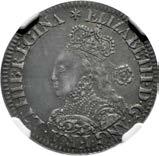
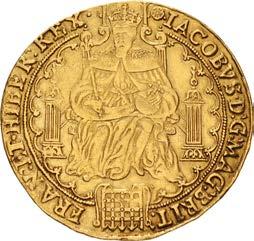


4.50 g, 12h). Second coinage, fine gold. Tower (London) mint; im: tower. Struck 1612-1613. (tower) · IACOBVS · D‘· G‘· MAG‘· BRIT‘· FRA‘· ET · HIB‘· REX ·, Archangel Michael slaying dragon lying at his feet to right / (tower) · A · DNO · FACTVM · EST · ISTVD ·, ship bearing coat-of-arms; above, cross between I and rose. Schneider –; North 2081; SCBC 2616. Pierced for use as a touch piece. Richly toned. Good VF. Rare. ($2500)

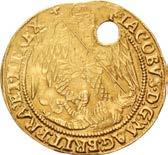
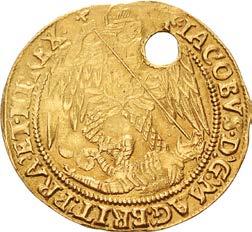
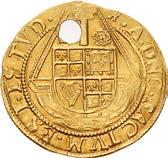
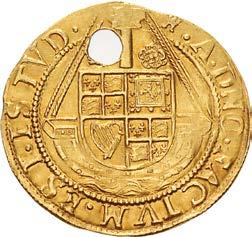
234
982. TUDOR. Elizabeth I. 1558-1603. AR Sixpence. Milled coinage. Tower (London) mint; im: star. Dated 1562. Crowned bust D left; rose to right / Coat-of-arms over long cross fourchée. Borden & Brown 25 (O1/R6 [24]); North 2026; SCBC 2595. In NGC encapsulation 6057755-003, graded AU 55. Top Pop. ($1000)
983. STUART. James I. 1603-1625. AV Rose Ryal (40mm,
g,
coinage,
(London) mint; im: rose.
984. STUART. James I. 1603-1625. AV Angel (27.5mm,
985. STUART. James I. 1603-1625. AV Unite (37mm, 9.68 g, 5h). Second coinage, crown gold. Tower (London) mint; im: lis. Struck 1604-1605. Crowned second bust right, holding lis-tipped scepter and globus cruciger / Crowned coat-of-arms. Schneider 22 (same obv. die); North 2083; SCBC 2618. Lightly toned, three small punch marks in field. Good VF. ($1500)


986. STUART. James I. 1603-1625. AV Double Crown (27mm, 5.01 g, 2h). Second coinage, crown gold. Tower (London) mint; im: castle. Struck 1612-1613. Crowned and mantled fifth bust right / Crowned coat-of-arms. Schneider –; North 2088; SCBC 2623. Toned. In NGC encapsulation 6515817-009, graded AU 53. ($1500)
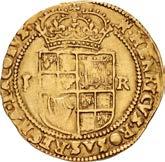
From the Malthouse Collection.
987. STUART. James I. 1603-1625. AV Britain Crown (22mm, 2.40 g, 1h). Second coinage, crown gold. Tower (London) mint; im: trefoil. Struck 1612. Crowned third bust right / Crowned coat-of-arms; I R flanking crown. Schneider –; North 2091; SCBC 2625. Areas of weak strike, flan flaw behind head, toned. VF. ($600)
From the Malthouse Collection.
988. STUART. James I. 1603-1625. AV Britain Crown (22mm, 2.56 g, 11h). Second coinage, crown gold. Tower (London) mint; im: tun. Struck 1615-1616. Crowned fifth bust right / Crowned coat-of-arms; I R flanking crown. Schneider 52-5; North 2092; SCBC 2626. Small flan flaw before face, minor marks. Toned. VF. ($600)
From the Malthouse Collection.
989. STUART. James I. 1603-1625. AV Unite – Laurel (35mm, 9.06 g, 12h). Third coinage, crown gold. Tower (London) mint; im: spur ryal. Struck 1619-1620. Laureate, draped, and cuirassed second bust left; XX (mark of value) to right / Crowned coat-of-arms over long cross fourchée. Schneider 83; North 2114; SCBC 2638. Lustrous, scattered scrapes and marks. Good VF. ($2000)

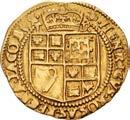

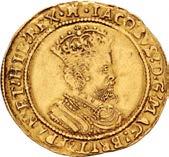

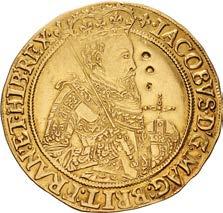
From the Malthouse Collection.
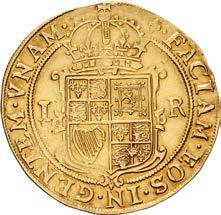
235
986 987 988
990. STUART. Charles I. 1625-1649. AV Angel (26mm, 4.07 g, 3h). Fine gold coinage. Tower (London) mint; im: star. Struck 1640-1641. CAROLVS · D’· G’· MAG’· BRI’· FR’· ET · HI · REX · ᛋ , Archangel Michael slaying the Dragon; X to left / ᛋ AMOR · POPVLI · PRESIDIUM · REGIS ·, three-masted ship sailing left; royal coat-of-arms on mainsail; hull ornamented with lis and lions passant. Schneider, Tower dies 0-24/R-23; Brooker 14 (same dies); Schneider 111 (same dies); North 2145; SCBC 2684A. In NGC encapsulation 2119532-039, graded AU Details, holed. Pierced for use as a touch piece. Very rare with this mintmark. ($3000)



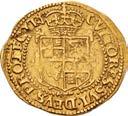


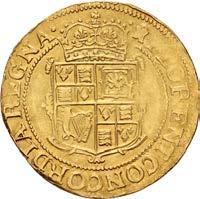

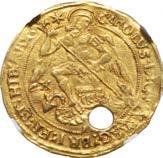

Ex Dr. Baumhauer Collection.
991. STUART. Charles I. 1625-1649. AV Unite (34mm, 8.83 g, 5h). Crown gold coinage, group B. Tower (London) mint; im: castle. Struck 1627-1628. Crowned second bust left; wearing ruff; XX (mark of value) to right (bust 2a) / Crowned coat-of-arms. Brooker 38 var. (obv. legend; same rev. die); cf. Schneider 123 (for type); North 2148; SCBC 2687. Scrape on face. Trace of luster. VF. ($2000)
992. STUART. Charles I. 1625-1649. AV Unite (35mm, 9.05 g, 1h). Crown gold coinage, group B. Tower (London) mint; im: heart over anchor/heart over anchor. Struck 1629-1630. Crowned second bust left; XX (mark of value) to right / Crowned coat-of-arms. Brooker 55/57 (same obv./rev. dies); Schneider 127 (same rev. die); North 2149; SCBC 2687. Some deposits on reverse, worn obverse die. Toned. VF. Struck on a broad flan. ($1500)
From the Malthouse Collection.
993. STUART. Charles I. 1625-1649. AV Crown (21mm, 2.28 g, 3h). Crown gold coinage, group B. Tower (London) mint; im: anchor. Struck 1628-1629. Crowned third bust right; V (mark of value) to right / Crowned coat-of-arms. Brooker 195 (same dies); Schneider 230 (same dies); North 2182; SCBC 2712. Richly toned, a few scratches and light marks, diagnostic die break. Near VF. ($600)

From the Malthouse Collection.
994. STUART. Charles I. 1625-1649. AV Double Crown (27mm, 4.45 g, 10h). Crown gold coinage, group E. Tower (London) mint; im: anchor. Struck 1628-1629. Crowned bust left, wearing ruff; X (mark of value) to right (5th, ‘Aberystwyth’ bust) / Crowned and garnished coat-of-arms; crowned C R flanking. Schneider, Tower, group E, class II; Brooker 170/169 (same obv./rev. dies); cf. Schneider 204 (for type); North 2173; SCBC 2717. Smoothing on bust and in fields. Good Fine. Very rare – only one example in CoinArchives. The highest value denomination to feature this distinctive bust. ($1500)
236
991 992
993
994
995. STUART. Charles I. 1625-1649. AR Crown (42mm, 29.84 g, 10h). Group II, type 2a. Tower (London) mint; im: harp. Struck 1632-1633. Charles, armored, on horseback left, holding rein and raising sword; plume on horse’s head / Coatof-arms over long cross fourchée. Cooper, Silver dies XI/XV; Brooker 250 (same dies); North 2193; SCBC 2755. Old scratch in fields, scattered light marks under tone. Near VF. ($750)
From the Malthouse Collection.
996. STUART. Charles I. 1625-1649. AR Halfcrown (35mm, 15.07 g, 8h). Group V, type 5. Tower (London) mint; im: sun. Struck under Parliament, 1645-1646. Charles on horseback left, holding sword and reigns / Coat-of-arms. Bull 536E/33; Brooker 377 (same obv. die); North 2215; SCBC 2780. A little weak in parts. Toned. Good VF. A finely detailed horseman. ($500)
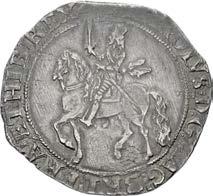
Ex Countryman Collection (M. Rasmussen FPL 22 [Winter 2011/2012]), no. C22.
Pattern by Vanderdoort
997. STUART. Charles I. 1625-1649. Cast Pattern AR Shilling or Unite (28mm, 5.22 g, 1h). By A. Vanderdoort; im: lis. · CAROLVS · D’ · G’ · MAG’ · BRIT’ · FR’ · ET · HI’ · REX ·, armored bust left / · FLORENT · CONCORDIA · REGNA ·, crowned coat-of-arms; crowned C R across field. Brooker 1240; North 2655; SCBC –; MI 374/269. Cast. Chased in fields as usual. Most attractively toned. Near EF. A lovely high-relief portrait. Rare. ($2500) Ex J. Tooze (Dix Noonan Webb 163, 18 September 2019), lot 1340.
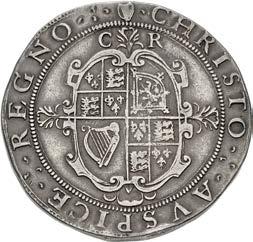

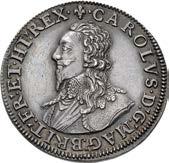



998. STUART. Charles I. 1625-1649. AR Groat (23mm, 2.07 g, 2h). Aberystwyth mint; im: open book. Struck 1638/91642. Crowned and mantled bust right, with short collared-ruff and visible armor; plume to left, IIII (mark of value) to right / Coat-of-arms; plumes above. Brooker 771 (same rev. die); North 2339; SCBC 2892. Lightly toned. Near EF. ($300) Ex Morton & Eden 113 (25 November 2021), lot 524.


237
995
996
999. STUART. Charles I. 1625-1649. AR Pound (52mm, 108.75 g, 7h). Oxford mint. Dated 1642. Charles on horseback riding left, holding reins and sword; plume to right, pile of arms below / RELIG · PROT · LEG/ANG · LIBER · PAR in two lines between parallel lines; above, three Oxford plumes above ·XX· (denomination); 1642 below. Morrieson, Oxford, B-2; Brooker 860 (same dies); North 2398; SCBC 2940. Once gilt, some scratches, very lightly chased, edge bumps and split. Near VF. Rare. ($4000)
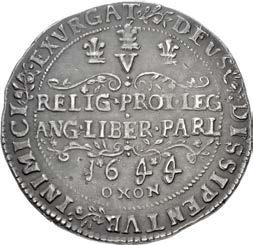
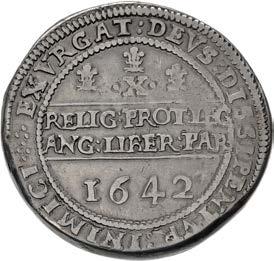


From the Malthouse Collection.
1000. STUART. Charles I. 1625-1649. AR Halfpound (44mm, 59.59 g, 4h). Oxford mint. Dated 1642. Charles on horseback riding left, holding reins and sword; plume to right, pile of arms below / RELIG : PROT : LEG/ANG : LIBER : PAR in two lines between two parallel lines; above, three Oxford plumes above ·X·; I642 below. Morrieson, Oxford, A-2; Brooker 867 (same dies); North 2404; SCBC 2945. Toned, scattered light scratches and marks. Fine. ($1500)
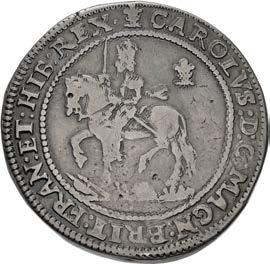
From the Malthouse Collection.
1001. STUART. Charles I. 1625-1649. Cast Reproduction AR Crown (41mm, 27.93 g, 6h). City view type. Oxford mint Dies by T. Rawlins. Dated 1644. Charles on horseback left, holding sword and reigns; below, OXON and view of Oxford / RELIG • PROT • LEG/ ANG • LIBER • PARL between floral scrolls; three crowns and V above, 1644 and OXON below. For original: Morrieson, Oxford A/1; Brooker 876; North 2407; SCBC 2948. Toned, chased. VF. Cast copy of this famous type. ($1000)
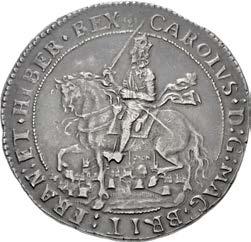
238
1002. STUART. Charles I. 1625-1649. AR Threepence (18mm, 1.15 g, 2h). Declaration type. Oxford mint; im: lis. Dated 1644. Crowned and mantled bust left; III (mark of value) to right / RELIG : PRO/LEG : ANG/LIBER : PAR; three lis above, 1644 below. Morreisson B/3; Brooker 961 (same dies); North 2471; SCBC 2994. Toned. VF. ($400) Ex Horizons Collection; H. Parsons (Glendinings, 11 May 1954), lot 473 (part of; with his ticket [Eaglen C60-2]).
1003. STUART. Charles I. 1625-1649. AR Groat (22mm, 1.92 g, 12h). Declaration type. Bristol mint. Dated 1644. Crowned and mantled bust left; plumelet to left, IIII (mark of value) to right / Declaration in three lines across field and within two parallel lines; three plumes above; 1644 below. Brooker 1003 (same dies); North 2505/2504 (for obv./rev.); SCBC 3022. Toned with flashes of golden luster, slightly double struck. Good VF. ($500)
Ex Dix Noonan & Webb 107 (20 March 2013), lot 349.
1004. STUART. Charles I. 1625-1649. AR Threepence (19mm, 1.29 g, 8h). Exeter mint; im: rose. Dated 1644. შ CAROLVS · D · G · MA · F · ET · H · RE, crowned, draped, and cuirassed bust left; III (mark of value) to right / CRISTO AVS PICE · R EGNO შ , coat-of-arms over long cross fourchée. Besly dies A/1; Brooker 1072 (same dies); North 2580; SCBC 3089. Richly toned. Good VF. Bold portrait. ($500)

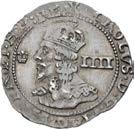

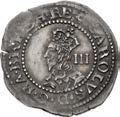


& Webb 104 (5 December 2012), lot 279.
STUART, Siege money. Newark. 1645-1646. AR Ninepence (29x35mm, 4.29 g, 12h). In the name of Charles I. Dated 1645. Large crown; C R flanking, IX (mark of value) below / OBS : / NEWARK/ 1645. Brooker 1226 (same dies); North 2641; SCBC 3144. Small area of weak strike. Toned. VF. ($1500)

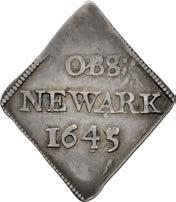
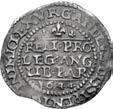
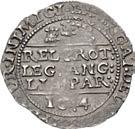
239
Ex Dix, Noonan,
1005.
1006. COMMONWEALTH. 1649-1660. AV Unite (33mm, 8.36 g, 9h). Tower (London) mint; im: sun. Dated 1653. Coat-of-arms within wreath / Two coats-of-arms; XX (mark of value) above. O over horizontal O in GOD. Schneider 341; North 2715; Bull, Gold I 17; SCBC 3208. Scratches and hairlines, edge marks. Good Fine. ($1500)


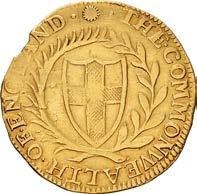

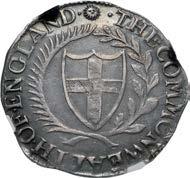
1007. COMMONWEALTH. 1649-1660. AV Unite (34mm, 9.09 g, 3h). Tower (London) mint; im sun. Dated 1654. Coatof-arms within wreath / Two coats-of-arms; XX (mark of value) above. Schneider 342; North 2715; Bull, Gold I 20; SCBC 3208. Minor flan flaw in center and slightly bent. Otherwise toned. VF. ($3000)
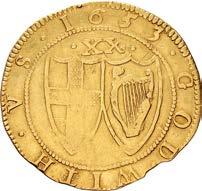
From the Malthouse Collection.
1008. COMMONWEALTH. 1649-1660. AR Shilling (30mm, 5.95 g, 11h). Tower (London) mint; im: sun. Dated 1656. Coat-of-arms within wreath / Two coats-of-arms; XII (mark of value) above. Bull 150; ESC 995; North 2724; SCBC 3217. Toned. In NGC encapsulation 6062176-008, graded AU 58. ($1000)

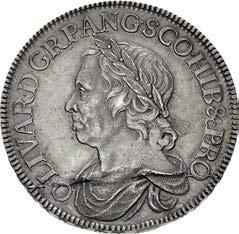

1009. COMMONWEALTH. Oliver Cromwell. Lord Protector, 1653-1658. AR Crown. Dated 1658/7. Lessen E12; Bull 240; ESC 10; North 2745; SCBC 3226. Die flaw carefully smoothed, a few minor marks. Richly toned with considerable underlying luster. Near EF. ($7500)
From the Malthouse Collection.
240
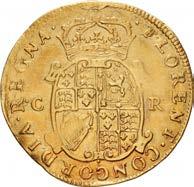

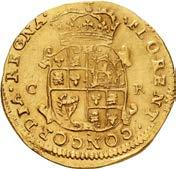

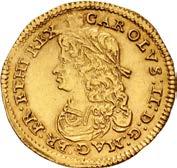
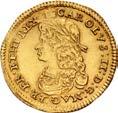






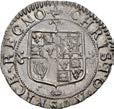


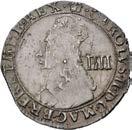
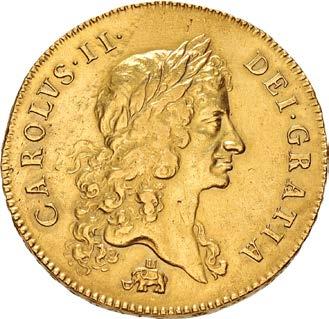
241
1010. STUART. Charles II. 1660-1685. AV Crown (19mm, 2.16 g, 10h). Hammered coinage, first issue. Tower (London) mint; im: crown. Struck 1660-1662. Laureate, draped, and cuirassed bust left / Crowned coat-of-arms. Schneider, Hammered dies O3/R3; Bull, Gold I 114 (this coin illustrated); Schneider 389 (same dies); North 2757; SCBC 3303. Toned, holed and plugged. Good VF. Very rare. ($3000)
From the Malthouse Collection.
1011. STUART. Charles II. 1660-1685. AV Unite (33mm, 8.81 g, 10h). Hammered coinage, second issue. Tower (London) mint; im: crown. Struck 1660-1662. Laureate, draped, and cuirassed bust left; XX (mark of value) to right / Crowned coat-of-arms. Schneider, Hammered dies O7/R11; Schneider 404 (same dies); North 2754; Bull, Gold I 139; SCBC 3304. Edge marks and rim crimped. Toned with some luster. VF.. ($3000)
From the Malthouse Collection.
1012. STUART. Charles II. 1660-1685. AR ‘Maundy Set’. Hammered coinage, third issue. Struck 1660-1662. Includes: Penny. SCBC 3327 // Twopence. SCBC 3326 // Threepence. SCBC 3325 // Fourpence. SCBC 3324. For set: ESC 2364. Toned. Near EF. Unusually high grade. A delightful matching set. Four (4) coins in lot. ($750)
From the Malthouse Collection.
a b c d
1013. STUART. Charles II. 1660-1685. AV 5 Guineas. Dated 1676 and OCTAVO. Elephant & castle. First bust. Bull, Gold I 183; SCBC 3330. Metal flaws behind bust. Altered surfaces. Once gilt. VF. ($7500) From the Malthouse Collection.

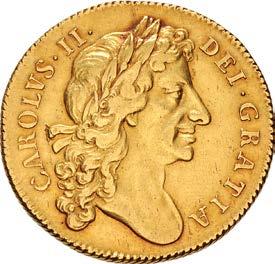
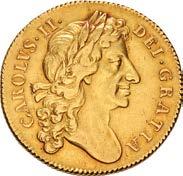
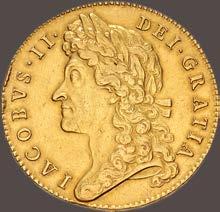











242
1014. STUART. Charles II. 1660-1685. AV 2 Guineas. Dated 1677. Second bust. Bull, Gold I 212; SCBC 3335. Attractive rich orange-red tone with flashes of luster. In NGC encapsulation 6515820-013, graded AU 53. Rare. ($7500) From the Malthouse Collection.
1015. STUART. Charles II. 1660-1685. AR Maundy Set. Dated 1680. Includes: Penny // Twopence // Threepence // Fourpence. ESC 2376; SCBC 3392. Matching iridescent blue toning, light scratches on the twopence. Good VF or better. Four (4) coins in lot. ($400)
From the Malthouse Collection.
1016. STUART. James II. 1685-1688. AV 5 Guineas. Date 1687 and TERTIO. Second bust. Bull, Gold I 311; SCBC 3397A. A few minor edge bumps. Richly toned. Well struck. In NGC encapsulation 6515820-014, graded AU 53. ($20,000)
a b c d
From the Malthouse Collection.
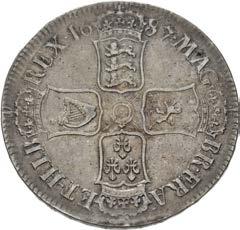
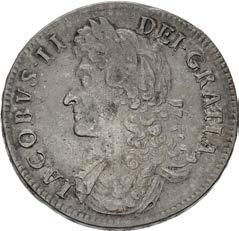


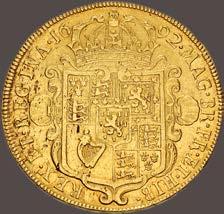
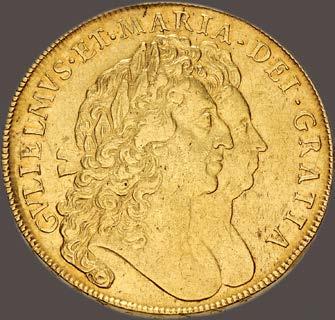
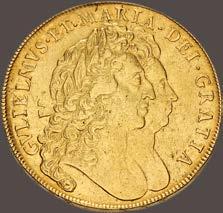



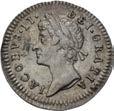
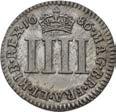



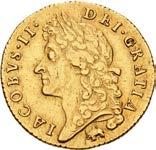
243
1017. STUART. James II. 1685-1688. AV Guinea. Dated 1688. Elephant & castle. Second bust. Bull, Gold I 335; SCBC 3403. Boldy struck and attractively toned with flashes of luster. In NGC encapsulation 6515820-015, graded XF 45. ($2500)
From the Malthouse Collection.
1018. STUART. James II. 1685-1688. AR Crown. Dated 1687 and RY TERTIO. 2nd bust. Bull 743; ESC 78; SCBC 3407. Richly toned. VF. ($750)
From the Malthouse Collection.
1019. STUART. James II. 1685-1688. AR Maundy Set. Dated 1686. Includes: Penny // Twopence // Threepence // Fourpence. ESC 2381; SCBC 3418. Matching rich toning, light scratch on penny. Good VF. Four (4) coins in lot. ($400)
From the Malthouse Collection.
a b c d
1020. STUART (ORANGE). William III & Mary. 1688-1694. AV Five Guinea. Dated 1692 and RY QVARTO. Bull, Gold I 347; SCBC 3422. In NGC encapsulation 6508417-001, graded AU 53. ($25,000)
1022
1021. STUART (ORANGE). William III. 1694-1702. AR Halfcrown. Dated 1698 and DECIMO. First bust, modified large shields. Bull 1034; ESC 554; SCBC 3494. Some flecking and metal flaws. Otherwise much as struck with considerable brilliance. Reverse with light purple tone. In NGC encapsulation 2118473-035, graded MS 62. ($500)
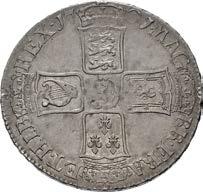


Ex Mildenhall Collection, purchased from Seaby, June 1960. Reportedly ex W. D. Ferguson Collection.
1022. STUART (ORANGE). William III. 1694-1702. AR Halfcrown. Dated 1701 and DECIMO TERTIO. Bull 1046; ESC 564; SCBC 3494. Light marks under old tone. EF. ($400)

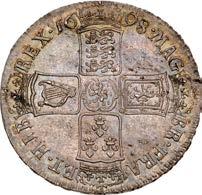
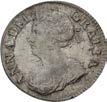



Ex Mildenhall Collection, purchased from Spink, November 1998.
1023. STUART. Anne. 1702-1714. AV Guinea. Dated 1712. Third bust. Bull, Gold I 476; SCBC 3574. Toned with some luster. In NGC encapsulation 6515817-008, graded XF 45. ($1500)

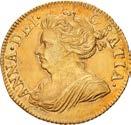
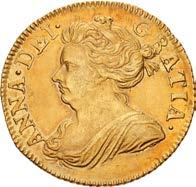
From the Malthouse Collection.
1024. STUART. Anne. 1702-1714. AV Half Guinea. Dated 1713. Post-Union. Bull, Gold I 492; SCBC 3575. Richly toned with flashes of brilliance. In NGC encapsulation 6515817-007, graded AU 55. ($3000)
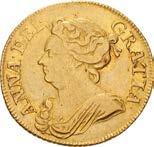


From the Malthouse Collection.
1025. STUART. Anne. 1702-1714. AR Maundy Set. Dated 1706. Includes: Penny // Twopence // Threepence // Fourpence. ESC 2395; SCBC 3599. EF. A beautiful set with matching toning. Four (4) coins in lot. ($600)

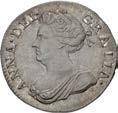
From the Malthouse Collection.
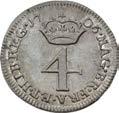
244
a b c d
1021
From the Malthouse Collection.
From the Malthouse Collection.

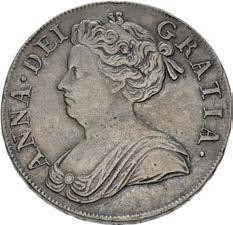
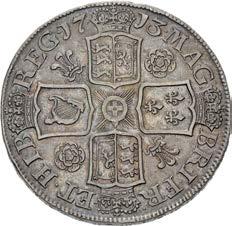
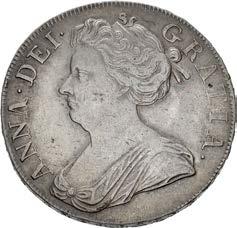



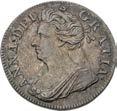

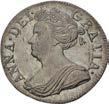





245
1026. STUART. Anne. 1702-1714. AR Maundy Set. Dated 1710. Includes: Penny // Twopence // Threepence // Fourpence. ESC 2398; SCBC 3599. Richly toned. Near EF or better. Four (4) coins in lot. ($400)
From the Malthouse Collection.
1027. STUART. Anne. 1702-1714. AR Crown. Dated 1707 and RY SEPTIMO. Post-union. Bull 1344; ESC 104; SCBC 3601. Toned, a few faint hairlines. Good VF. ($750)
1028. STUART. Anne. 1702-1714. AR Crown. Dated 1707 and RY DVODECIMO. Post-Union. Roses & plumes. Bull 1349; ESC 109; SCBC 3603. Toned. VF. ($500)
1029. HANOVER. George I. 1714-1727. AV 5 Guineas. Dated 1726 and D. TERTIO. SCBC 3626. Toned. In NGC encapsulation 6515817-005, graded XF Details, rim repair. Rare. ($15,000)
a b c d
From the Malthouse Collection.
1027
1028
1030. HANOVER. George I. 1714-1727. AV 2 Guineas. Dated 1717. Bull, Gold I 499; SCBC 3627. Toned. In NGC encapsulation 6515820-007, graded AU 53. ($7500)
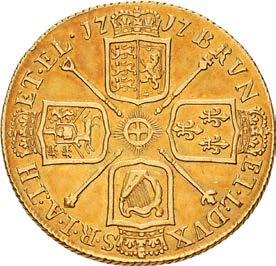
From the Malthouse Collection.
1031. HANOVER. George I. 1714-1727. AV Half Guinea. Dated 1715. 1st bust. Bull, Gold I 431; SCBC 3635. Toned, slightly bent. VF. ($1000)
From the Malthouse Collection.
1032. HANOVER. George I. 1714-1727. AV Half Guinea. Dated 1725. 2nd, older bust. Bull, Gold I 546; SCBC 3637. Richly toned with some luster. In NGC encapsulation 6515820-008, graded AU 55. ($2000)
From the Malthouse Collection.
1033
1033. HANOVER. George I. 1714-1727. AV Quarter Guinea. Dated 1718. Bull, Gold I 550; SCBC 3638. Deep orange toning, a few light scratches. Good VF. ($500)
1034. HANOVER. George I. 1714-1727. AV Quarter Guinea. Dated 1718. Bull, Gold I 550; SCBC 3638. Toned, minor marks. Good VF. ($400)





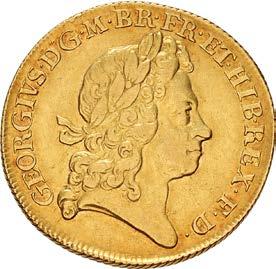

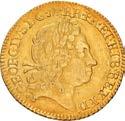
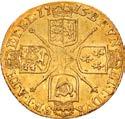
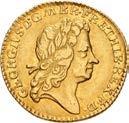

From the Malthouse Collection.

246
1034




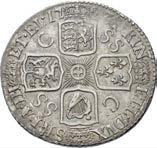

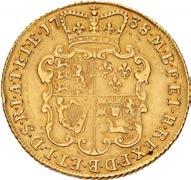


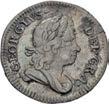
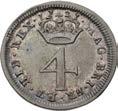


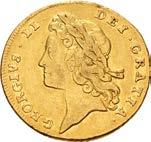




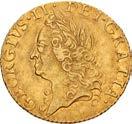
247
1035. HANOVER. George I. 1714-1727. AR Shilling. Dated 1723. South Seas Company issue. Bull 1586; ESC 1176; SCBC 3647. Superb iridescent cabinet toning. Choice EF. ($400)
From the New Horizons Collection. Ex Sovereign Rarities 1 (25 September 2018), lot 266; M. Rasmussen FPL 22, (Winter 2011/2012), no. 234.
1036. HANOVER. George I. 1714-1727. AR Maundy Set. Dated 1727. Includes: Penny // Twopence // Threepence // Fourpence. ESC 2401; SCBC 3658. Toned. VF or better. Four (4) coins in lot. ($300)
From the Malthouse Collection.
1037. HANOVER. George II. 1727-1760. AV Two Guineas. Dated 1738. Bull, Gold I 569; SCBC 3667B. Toned, once polished, edge bumps. Good Fine. ($1000) From the Malthouse Collection.
1038. HANOVER. George II. 1727-1760. AV Guinea. Dated 1732. Bull, Gold I 589; SCBC 3674. Scratch, ex mount. Good Fine. ($500)
From the Malthouse Collection.
1039. HANOVER. George II. 1727-1760. AV Guinea. Dated 1735. Bull, Gold I 593; SCBC 3674. Toned with hints of luster, light earthen deposits, scratch. Good VF. Rare date. ($1000) From the Malthouse Collection.
1040. HANOVER. George II. 1727-1760. AV Half Guinea. Dated 1752. Bull, Gold I 655; SCBC 3685. Wonderful toning especially on reverse with blazing brilliance beneath. In NGC encapsulation 6515820-009, graded AU 55. ($2500)
a b c d
From the Malthouse Collection.
1038
1039
1041. HANOVER. George II. 1727-1760. AR Halfcrown. Dated 1741 and D QVARTO. Roses. Bull 1681; ESC 601; SCBC 3693. Iridescent toning, minor adjustment marks. Good VF. ($500)


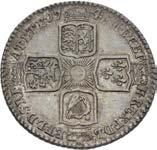

From the Malthouse Collection.
1042. HANOVER. George II. 1727-1760. AR Shilling. Dated 1745. LIMA type. Bull 1724; ESC 1205; SCBC 3703. Rich blue and gold iridescent toning with underlying luster. Near EF. ($300)
From the Malthouse Collection.
1043. HANOVER. George II. 1727-1760. AR Sixpence. Dated 1735/4. Plumes & roses. Bull 1746; ESC 1610A; SCBC 3707. Toned. In NGC encapsulation 4842621-002, graded MS 62. ($500)

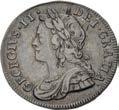
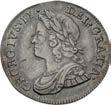



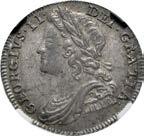
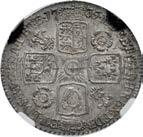
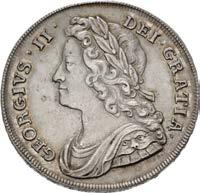
From the New Horizons Collection.
1044. HANOVER. George II. 1727-1760. AR Maundy Set. Dated 1739. Includes: Penny // Twopence // Threepence // Fourpence. ESC 2407; SCBC 3716. Attractive matching toning. VF to EF. Four (4) coins in lot. ($300)
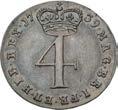

From the Malthouse Collection.
1045. HANOVER. George III. 1760-1820. AV Guinea. Dated 1777. Bull, Gold I 695; SCBC 3728. Richly toned, faint hairlines. Near EF. ($1000)
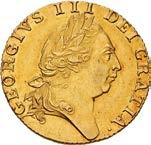
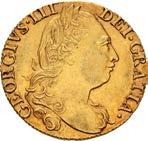
From the Malthouse Collection.
1046. HANOVER. George III. 1760-1820. AV Guinea. Dated 1787. ‘Spade’ type. Bull, Gold I 711; SCBC 3729. Toned, minor dimple on obverse, traces of underlying luster. EF. ($1000)
From the New Horizons Collection. Ex Classical Numismatic Review XLIV.1 (Winter 2019), no. 502959.
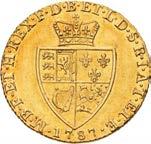
248
1042
a b c d
1043
1045 1046
1047
1048
1047. HANOVER. George III. 1760-1820. AV Guinea. Dated 1792. Spade type. Bull, Gold I 720; SCBC 3729. Possibly lightly cleaned. Now toned with underlying brilliance. EF. ($750)
From the Malthouse Collection.
1048. HANOVER. George III. 1760-1820. AV Guinea. Dated 1793. Spade type. Bull, Gold I 723; SCBC 3729. A superb specimen with considerable luster. In NGC encapsulation 6516027-001, graded MS 61. Conservatively graded by NGC in our opinion. ($1500)
From the Malthouse Collection.
1049. HANOVER. George III. 1760-1820. AV Guinea. Dated 1794. Spade type. Bull, Gold I 725; SCBC 3729. Toned, a few light marks. EF. ($1000)
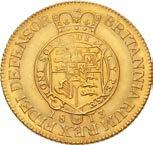
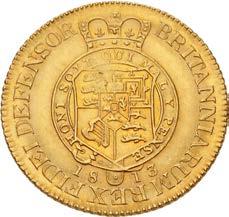



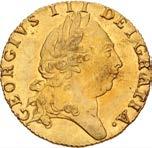

From the Malthouse Collection.
1050. HANOVER. George III. 1760-1820. AV Guinea. Dated 1798. Spade type. Bull, Gold I 732; SCBC 3729. Toned. Good VF. ($500)
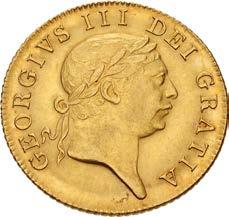
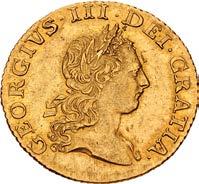






From the Malthouse Collection.
1051. HANOVER. George III. 1760-1820. AV Guinea. Dated 1813. ‘Military’ type. Bull, Gold I 737; SCBC 3730. Toned pristine surfaces with gleaming luster beneath. In NGC encapsulation 6515820-011, graded MS 62. A most attractive example of this one year type. Silken cabinet toning. Conservatively graded by NGC in our opinion. ($6000)
From the Malthouse Collection.
249
1052. HANOVER. George III. 1760-1820. AV Half Guinea. Dated 1764. Bull, Gold I 801; SCBC 3732. Toned with underlying luster. In NGC encapsulation 6479215-003, graded AU 58. ($1500)
1049
1050
1053. HANOVER. George III. 1760-1820. AV Half Guinea. Dated 1806. “Military” type. Bull, Gold I 851; SCBC 3737. Toned, haymarks. Good VF. ($400)

From the Malthouse Collection.
1054. HANOVER. George III. 1760-1820. AV Quarter Guinea. Dated 1762. Bull, Gold I 886; SCBC 3741. Spots of blue toning. VF. ($400)

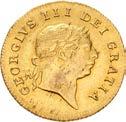
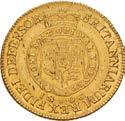
From the Malthouse Collection.
1055. HANOVER. George III. 1760-1820. AR Maundy Set. Dated 1786. Includes: Penny // Twopence // Threepence // Fourpence. ESC 2418; SCBC 3762. Beautiful matching toning with considerable luster. Superb EF. Four (4) coins in lot. ($400)
From the Malthouse Collection.
1056. HANOVER. George III. 1760-1820. AR Maundy Set. Dated 1792. ‘Wire money’ type. Includes: Penny // Twopence // Threepence // Fourpence. ESC 2419; SCBC 3763. Pleasing bluish toning, minor marks to threepence. The threepence Good VF, other EF or better. Four (4) coins in lot. ($400)


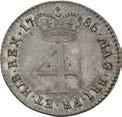
From the Malthouse Collection.
1057. HANOVER. George III. 1760-1820. AR Maundy Set. Dated 1800. Includes: Penny // Twopence // Threepence // Fourpence. ESC 2421; SCBC 3764. Toned. Good VF to EF. Four (4) coins in lot. ($300)
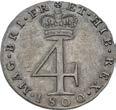
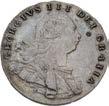
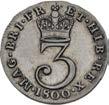


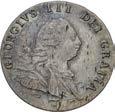
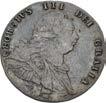









From the Malthouse Collection.
1058. HANOVER. George III. 1760-1820. AR Dollar. Struck 1797. Oval countermark on a Bolivian 8 Reales dated 1795 (PTS) PP. Bull 1851; ESC 131; SCBC 3765A. Toned, some very light marks. Good VF. ($750)





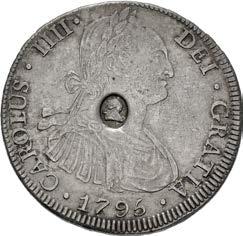
From the Malthouse Collection.

250
1053 1054 a b c d a b c d a b c d
1059. HANOVER. George III. 1760-1820. AR Dollar. Dated 1804. Bull 1951; ESC 164; SCBC 3768. Iridescent toning with uniform line of toning across obverse, spot on obverse, hints of luster. AU. ($400)
From the Malthouse Collection.
1060. HANOVER. George III. 1760-1820. AV Sovereign. Dated 1820. Open 2, larger date. Marsh 4D; SCBC 3785C. Toned, small edge bump. VF. ($750)

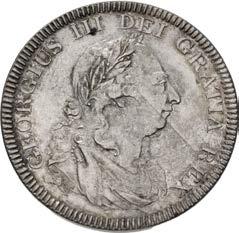

From the Malthouse Collection.
1061. HANOVER. George III. 1760-1820. AV Sovereign. Dated 1820. Compact date, closed 2. Marsh 4B; SCBC 3785C. Scrapes. Near VF. ($500)


From the Malthouse Collection.
1062. HANOVER. George III. 1760-1820. AV Half Sovereign. Dated 1817. Marsh 400; SCBC 3786. Small rim bump. Near EF. ($1000)
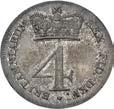




From the Malthouse Collection.
1063. HANOVER. George III. 1760-1820. AV Half Sovereign. Dated 1817. Marsh 400; SCBC 3786. A few light marks. VF. ($400)
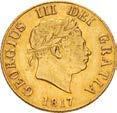

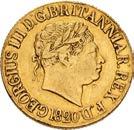


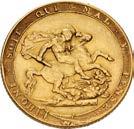
From the Malthouse Collection.
1064. HANOVER. George III. 1760-1820. AR Maundy Set. Dated 1817. Includes: Penny // Twopence // Threepence // Fourpence. ESC 2422; SCBC 3792. Dappled toning. UNC. Four (4) coins in lot. ($400)
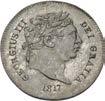
From the Malthouse Collection.

251
1060 1061 1062 1063 a b c d
1065. HANOVER. George IV. 1820-1830. AV Two Pounds. Dated 1823. SCBC 3798. Richly toned with underlying brilliance. In NGC encapsulation 6515820-012, graded MS 62. ($2500)
From the Malthouse Collection.
1066. HANOVER. George IV. 1820-1830. AV Sovereign. Dated 1822. Marsh 6; SCBC 3800. Richly toned. Good Fine. ($600)
From the Malthouse Collection.
1067. HANOVER. George IV. 1820-1830. AV Sovereign. Dated 1825. Bare head. Marsh 10; SCBC 3801. Richly toned, minor marks and scratches. VF. ($750)
From the Malthouse Collection.
1068. HANOVER. George IV. 1820-1830. AV Sovereign. Dated 1826. Bare head. Marsh 11; SCBC 3801. Faint hairlines. VF. ($750)
From the Malthouse Collection.
1069. HANOVER. George IV. 1820-1830. AV Half Sovereign. Dated 1824. Marsh 405; SCBC 3803. Toned. Near EF. ($750)
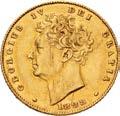
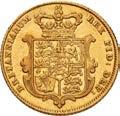

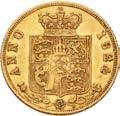
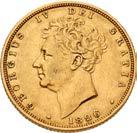

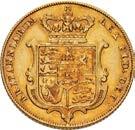


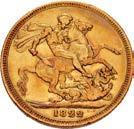

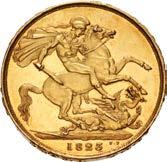
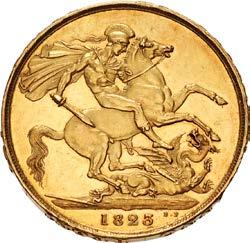
From the Malthouse Collection.
1070. HANOVER. George IV. 1820-1830. AV Half Sovereign. Dated 1828. Marsh 409; SCBC 3804A. Toned, some light scratches on bust. Good VF. ($400)
From the Malthouse Collection.
1071. HANOVER. George IV. 1820-1830. AR Halfcrown. Dated 1820. Bull 2357; ESC 628; SCBC 3807. Toned. AU. ($400)

From the Malthouse Collection.
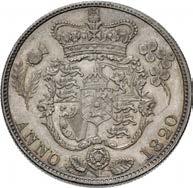
252
1069 1070
1066 1067 1068
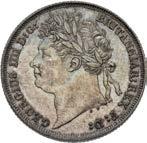

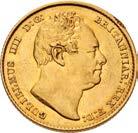







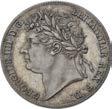




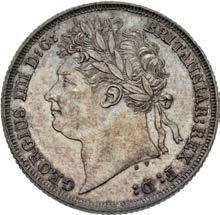
253
1072. HANOVER. George IV. 1820-1830. AR Shilling. Dated 1825. Laureate head. Bull 2402; ESC 1253; SCBC 3811. Toned, a few light bag marks. AU. ($300)
From the Malthouse Collection.
1073. HANOVER. George IV. 1820-1830. AR Maundy Set. Dated 1824. Includes: Penny // Twopence // Threepence // Fourpence. ESC 2428; SCBC 3816. Toned, the threepence darker. UNC. Four (4) coins in lot. ($400)
From the Malthouse Collection.
1074. HANOVER. William IV. 1830-1837. AV Sovereign. Dated 1832. 2nd bust. Marsh 17; SCBC 3829B. Highly lustrous, rim ding. EF. ($1000)
From the Malthouse Collection.
1075. HANOVER. William IV. 1830-1837. AV Sovereign. Dated 1837. Marsh 21; SCBC 3829B. Toned. Near VF. ($750)
a b c d
From the Malthouse Collection.
Wyon Pattern Crown Struck on Heavy Weight Flan
An
A copy of the Royal Mint’s correspondence with the consignor is included.


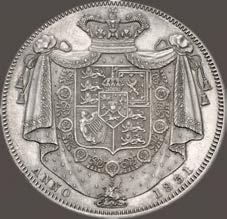
William IV pattern Crowns dated 1831, struck from dies prepared by William Wyon and J. B. Merlen, are known from two distinct types. The most frequently encountered type is distinguished by the WW on truncation and an inverted die axis and was issued for the proof sets of this year (ESC 271; Bull 2462). Much rarer is the type with W. WYON on truncation and a medal die axis, such as the coin offered here (ESC 273; Bull 2460). At 30.28 grams our coin is some eight percent heavier than William IV Crowns of all types that we can find weights recorded for. The remarkable weight of this coin led our consignor to submit it to the Royal Mint Museum for examination. In their analysis the Mint noted that the coin was ‘notably overweight’ and shared an obverse die with undated pattern Crown of William IV in their collection (Hocking 1927). Furthermore the Royal Mint’s study showed that the coin is struck in sterling silver as with the only other example of this W.WYON on truncation type they have examined whereas the WW on truncation with inverted die axis Crowns are apparently all struck in fine silver. Independent analysis undertaken by NGC confirms this significant discovery
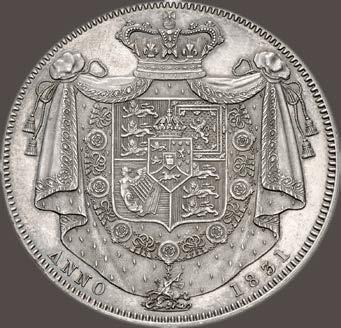
254
1076. HANOVER. William IV. 1830-1837. Proof Pattern AR Crown (39mm, 30.282 g, 12h). Dies by W. Wyon. Dated 1831. Bare head right. W. WYON on truncation / Crowned, collared, and mantled coat-of-arms. Edge: plain. L&S 3; Bull 2460; ESC 273; SCBC 3833. In NGC encapsulation 6516477-001, graded PF 61. Carefully struck in sterling silver on an overweight flan.
important and extremely rare Wyon pattern. ($25,000)
1077. HANOVER. William IV. 1830-1837. AR Maundy Set. Dated 1831. Includes: Penny // Twopence // Threepence // Fourpence. ESC 2436; SCBC 3840. Deep iridescent blue toning, light marks to penny. UNC. Four (4) coins in lot. ($250)

From the Malthouse Collection.
1078. HANOVER. Victoria. 1837-1901. AV Sovereign. Dated 1844. Marsh 27; SCBC 3852. Toned, light scratch, minor marks. Near EF. ($400)
From the Malthouse Collection.
1079. HANOVER. Victoria. 1837-1901. AV Sovereign. Dated 1872. Die no. 109. Marsh 56; SCBC 3853B. Some luster, a few light bagmarks. AU. ($500)

From the Malthouse Collection.
Rare Date for Melbourne
1080. HANOVER. Victoria. 1837-1901. AV Sovereign. Melbourne mint. Dated 1887 M. Third young head. Shield reverse. Marsh 68; SCBC 3854A. Toned with some brilliance. In NGC encapsulation 6515820-001, graded AU 58. Very rare date. ($2500)

From the Malthouse Collection.
1081. HANOVER. Victoria. 1837-1901. AV Sovereign. Melbourne mint. Dated 1887 M. Marsh 109A; SCBC 3857C. Some light bagmarks. AU. ($400)
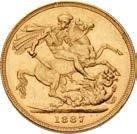
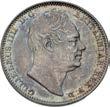




From the Malthouse Collection.
1082. HANOVER. Victoria. 1837-1901. AV Half Sovereign. Dated 1872. Die no. 138. Marsh 447; SCBC 3860C. Toned with significant luster on reverse. EF. ($400)
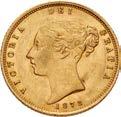
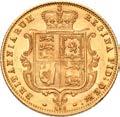

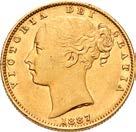
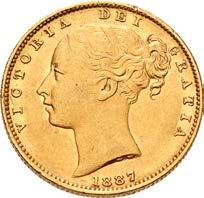
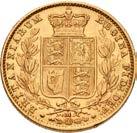



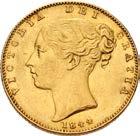
From the Malthouse Collection.

255
a b c d
1078 1079 1081 1082
1083. HANOVER. Victoria. 1837-1901. AV Half Sovereign. Dated 1884. Marsh 458; SCBC 3861. EF. ($400)
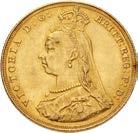


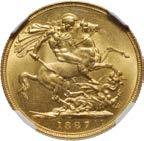
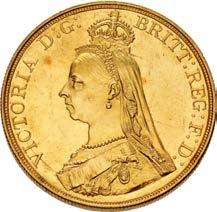
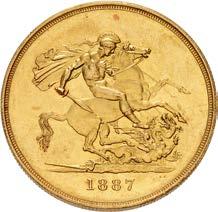
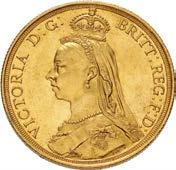

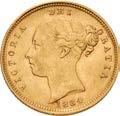
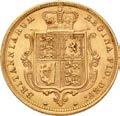
From the Malthouse Collection.
1084. HANOVER. Victoria. 1837-1901. AV Five Pounds. Dated 1887. Jubilee type. SCBC 3864. A few toning spots. The obverse prooflike. In NGC encapsulation 6515820-002, graded MS 62. ($3000)
From the Malthouse Collection.
1085. HANOVER. Victoria. 1837-1901. AV Two Pounds. Dated 1887. Jubilee type. SCBC 3865. In NGC encapsulation 6515820-003, graded MS 62. ($750)


From the Malthouse Collection.
1086. HANOVER. Victoria. 1837-1901. AV Sovereign. Dated 1887. Jubilee type. Marsh 125B; SCBC 3866. In NGC encapsulation 6134502-001, graded MS 64+. ($1000)
1087. HANOVER. Victoria. 1837-1901. AV Sovereign. Dated 1887. Jubilee type. Marsh 125B; SCBC 3866. Attractive orange toning, a few very light marks. AU. ($400)
From the Malthouse Collection.
1088. HANOVER. Victoria. 1837-1901. AR Crown. Dated 1845. Young head. Bull 2564; ESC 282; SCBC 3882. Toned. In NGC encapsulation 6515820-004, graded AU 58. ($1000)
From the Malthouse Collection.
256
1086 1087

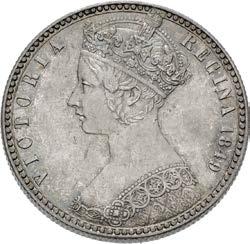
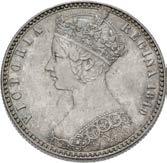




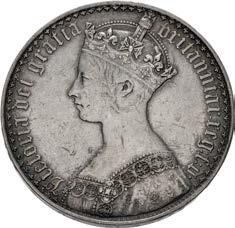
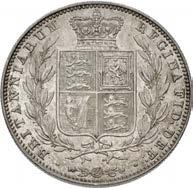

257
1089. HANOVER. Victoria. 1837-1901. Proof AR Crown. Dated 1847 and UNDECIMO. Gothic type. Bull 2571; ESC 288; SCBC 3883. Rich tone with underlying brilliance. In NGC encapsulation 6515820-005, graded PF 60. ($6000) From the Malthouse Collection.
1090. HANOVER. Victoria. 1837-1901. AR Crown. Dated 1847 and RY UNDECIMO. Gothic type. Bull 2571; ESC 288; SCBC 3883. Toned, marks, ex mount with two small drill holes in edge. VF. ($1000)
From the Malthouse Collection.
1091. HANOVER. Victoria. 1837-1901. AR Halfcrown. Dated 1843. Bull 2718; ESC 676; SCBC 3888. Lightly toned with traces of luster, usual light die breaks on obverse. Near EF. Very rare date. ($750) From the Malthouse Collection.
1092. HANOVER. Victoria. 1837-1901. AR Florin. Dated 1849. ‘Godless’ type. Bull 2815; ESC 802; SCBC 3890. Frosty light toning with hints of underlying brilliance. In NGC encapsulation 6515820-006, graded MS 65. ($1500) From the Malthouse Collection.
1090
1091
1093. HANOVER. Victoria. 1837-1901. AR Maundy Set. Dated 1841. Includes: Penny // Twopence // Threepence // Fourpence. ESC 2451; SCBC 3916. Lightly toned. UNC. Rare. Four (4) coins in lot. ($500)




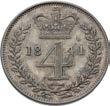





From the Malthouse Collection.
1094. HANOVER. Victoria. 1837-1901. AR Maundy Set. Dated 1872. Includes: Penny // Twopence // Threepence // Fourpence. ESC 2485; SCBC 3916. Lightly toned. UNC. Four (4) coins in lot. ($300)
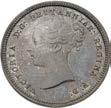
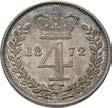


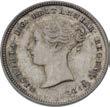








From the Malthouse Collection.
1095. HANOVER. Victoria. 1837-1901. AR Crown. Dated 1889. Jubilee type. Bull 2589; ESC 299; SCBC 3921. Attractively toned. UNC. ($500)

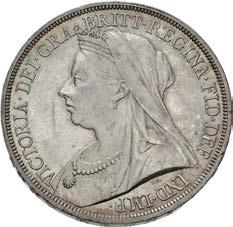

From the Malthouse Collection.
1096. HANOVER. Victoria. 1837-1901. AR Maundy Set. Dated 1888. Jubilee type. Includes: Penny // Twopence // Threepence // Fourpence. ESC 2502; SCBC 3932. Exquisite matching toning. UNC. Four (4) coins in lot. ($200)
From the Malthouse Collection.
1097. HANOVER. Victoria. 1837-1901. AR Crown. Dated 1893 and RY LVI. Old head. Bull 2593; ESC 303; SCBC 3937. Beautifully toned with significant luster. UNC. ($500)
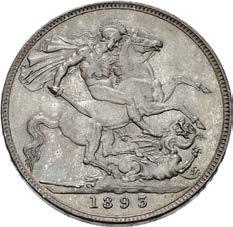
From the Malthouse Collection.
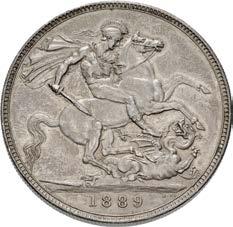
258
a b c d a b c d a b c d
1098.
Victoria. 1837-1901. AR Crown. Dated 1896 and RY LX. Old head. Bull 2601; ESC 311; SCBC 3937. Toned with some luster, a few light bag marks. UNC. ($500)

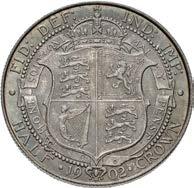


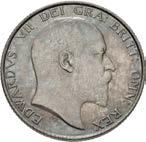

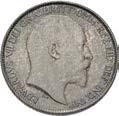
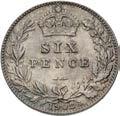
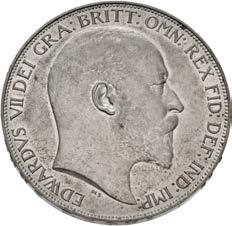
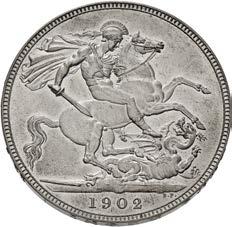
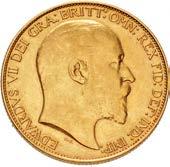
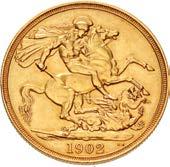
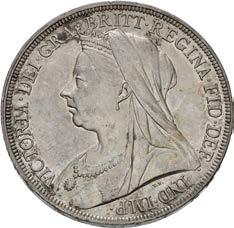

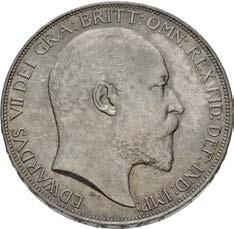

From the Malthouse Collection.
From the Malthouse Collection.
From the Malthouse Collection.
From the Malthouse Collection.
From the Malthouse Collection.
259
HANOVER.
1099. SAXE-COBURG-GOTHA. Edward VII. 1901-1910. AV Two Pounds. Dated 1902. SCBC 3967. Lightly polished. Good VF. ($600)
1100. SAXE-COBURG-GOTHA. Edward VII. 1901-1910. AR Crown. Dated 1902. Bull 3560; ESC 361; SCBC 3978. Exquisite toning, some very faint bag marks. UNC. ($500)
1101. SAXE-COBURG-GOTHA. Edward VII. 1901-1910. Matte Proof AR Crown. Dated 1902. Bull 3562; ESC 362; SCBC 3979. Lightly toned. Proof. ($500)
1102. SAXE-COBURG-GOTHA. Edward VII. 1901-1910. Lot of four (4) silver issues. Dated 1902. Includes: AR Sixpence. ESC 1785; SCBC 3983 // AR Shilling. ESC 1410; SCBC 3982 // AR Florin. ESC 919; SCBC 3981// AR Halfcrown. ESC 746; SCBC 3980. All with delicate matching toning. UNC. Four (4) coins in lot. ($400)
1099 1101 a b c d
1100 1098
1103. WINDSOR. George V. 1910-1936. Proof AR Shilling. Dated 1911. Bull 3800; ESC 1421; SCBC 4013. Rich iridescent toning with splashes of ochre and blue. In NGC encapsulation 4211777-006, graded PF 66. ($300)
From the New Horizons Collection.
1104. WINDSOR. George V. 1910-1936. Proof Set. Dated 1927. Includes: Crown. In NGC encapsulation 6509227-004, graded PF 64// Halfcrown. In NGC encapsulation 6509227-005, graded PF 64 // Florin. In NGC encapsulation 6509227-006, graded PF 64 // Shilling. In NGC encapsulation 6509227-007, graded PF 64 // Sixpence. In NGC encapsulation 6509227-008, graded PF 65 // Threepence. In NGC encapsulation 6509227-009, graded PF 66. SCBC PS14. A superb matching set with official Royal Mint hard red leatherette case. ($750)

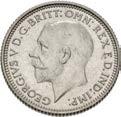
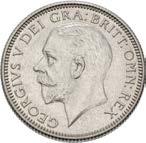
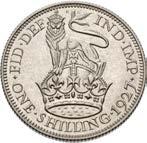

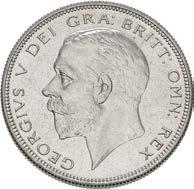
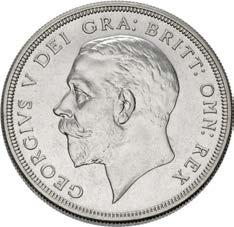

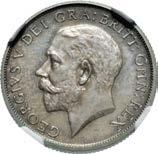

Very Rare David I from the Jourdan Collection
1105. SCOTLAND. David I. 1124-1153. AR Penny (21mm, 1.29 g, 1h). Edinburgh mint; uncertain moneyer. Struck 1136–early 1140s. Crowned bust right, holding lis-tipped scepter / [... ɭ ] n Ḧ ዞዝɭn , cross moline-fleury. Cf. Burns 23 (fig. 24C-D); cf. SCBI 35 (Ashmolean & Hunterian) 3/A; SCBC 5003. Small edge loss, mottled tone on reverse, obverse slightly double struck. VF. Very rare. ($2500)
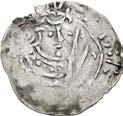
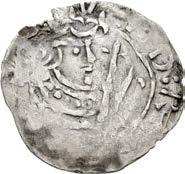
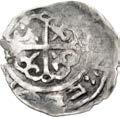
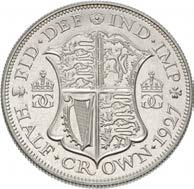
Ex Richard A. Jourdan (Triton XXIII, 13 January 2020), lot 1251 (hammer $8000); Classical Numismatic Group 72 (14 June 2006), lot 2674.

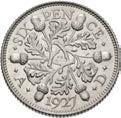
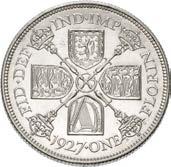
260
a b c d e f
Impressive Charles I Scottish Unit
1106. SCOTLAND. Charles I. 1625-1649. AV Unit (36mm, 9.86 g, 6h). Third coinage, Briot’s issue. Edinburgh mint. Struck 1637-1642. Crowned and armored half-length bust right, holding lis-tipped scepter and globus cruciger / Crowned coat-of-arms; crowned C R above quadrate stop across fields. Burns 3 (fig. 1032 – same dies); SCBI 35 (Scottish), 13926 (same dies); SCBC 5531. Attractive light blue and purple toning. Minor scratches in reverse legend. Near EF. A most handsome example. ($7500)




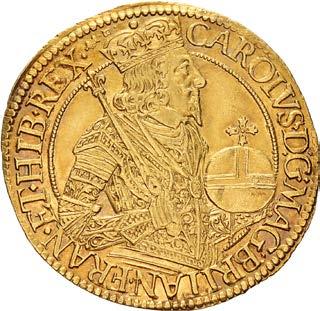
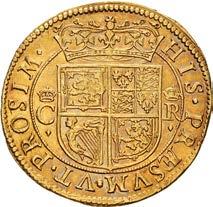
Very Rare Irish Farthing

1107. IRELAND. John. As King, 1199-1216. AR Farthing (10mm, 0.33 g). Second (’DOMinus’) coinage, group II. Dublin mint; Adam, moneyer. Struck circa 1198-1199. Mascle with trefoils at corners / Cross pattée; © ዝ © ዦ in quarters. Withers VI p. 31; O’S, Earliest 1; SCBI –; D&F 41; SCBC 6220. Light find patina. VF. Very rare. ($1500)

1108. IRELAND. Henry III. 1216-1272. AR Penny (18mm, 1.44 g, 2h). Group Ia. Dublin mint; Ricard, moneyer. Struck 1251-1254. Crowned facing bust, holding cruciform scepter; cinquefoil to right; all within triangle / Voided long cross, with pellet at center; triple pellets in quarters. SCBC 6235. Deeply toned. Near EF. Well struck. ($300)


From the New Horizons Collection.
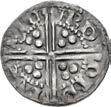
261
1109. IRELAND. Edward IV. Second reign, 1471-1483. AR Groat (24mm, 2.05 g, 2h). Light ‘Cross and Pellets’ coinage, reduced standard. Waterford mint; im: pierced mullet; Germyn Lynch, mintmaster. Struck 1473-1478(?). Crowned facing bust within tressure of arches; lis at cusps, G on breast / Long cross pattée; trefoils in quarters, saltires in 2nd and 4th trefoils. SCBI 22 (Copenhagen), 401; D&F 134; SCBC 6351. Toned. Good VF. ($500)
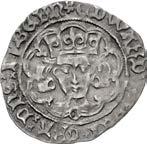
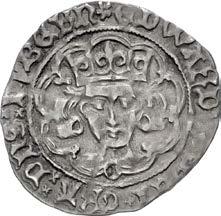
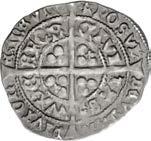
1110. IRELAND. Elizabeth I. 1558-1603. AR Shilling (32mm, 8.81 g, 8h). First (base) coinage. Tower (London) mint; im: rose. Struck 1559. Crowned bust 1A left / Crowned harp; crowned E R flanking. BCW RS1D/RS-a1; SCBC 6503. Toned, traces of deposits, some roughness. VF. Struck on a full flan. ($600)

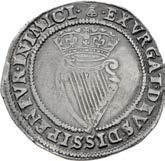


1111. IRELAND. James I. 1603-1625. AR Shilling (27mm, 4.40 g, 7h). Tower (London) mint; im: bell. Struck 16031604. Crowned first bust right / Crowned harp. D&F 259; SCBC 6512. Toned, a few light marks. VF. ($600)
BRITISH MEDALS
1112. COMMONWEALTH. Oliver Cromwell. Lord
1653-1658. AR Medal (49mm, 42.89 g, 12h). The Death of Oliver Cromwell. Of Dutch manufacture. Dated 3 September 1658. OLIVAR · D · G · RP · ANG · SCO · HIBERNIÆ · PROTECTOR, laureate and armored bust left / NON · DEFITIENT · OLIVA · SEP · 3 · 1658 ·, shepherd standing below olive tree, tending to his flock. Lessen, Funeral, –; MI 435/85; Eimer 200; van Loon (new edition) 1658.6. Iridescent toning, hint of double striking in legends, light hairlines and handling marks. EF. Very rare. ($2000)
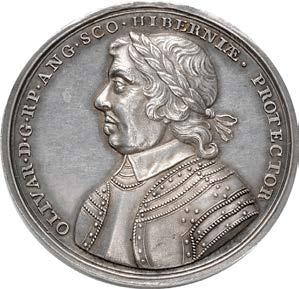
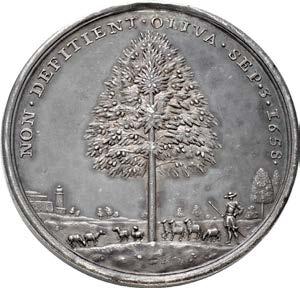
Ex North Yorkshire Moors [M. Lessen] (Part IV, Dix Noonan Webb 186, 21 January 2021) lot 1255; R.C. and O.M.W. Warner; R.E. Ockenden (from O.M.W.W. 1964); purchased from R.E.O.
1113. HANOVER. George IV. 1820-1830. AV Medal (34mm, 31.30 g, 12h). Coronation. By B. Pistrucci. Dated 19 July 1821 (in Roman numerals). GEORGIUS IIII D · G · BRITANNIARUM REX F · D ·, laureate head left / PROPRIO JAM JURE ANIMO PATERNO ·, George seated left on throne, being crowned by Victory to right; to left, Britannia, Hibernia, and Scotia standing right; in exergue in three lines, INAUGURATUS/DIE · JULII · XIX/ANNO · MDCCCXXI. BHM 1070; Eimer 1146a. Minor scrapes and scratches, edge nicks. Near EF. Rare. ($2500)


262
Protector,
1110 1111 1112
1113
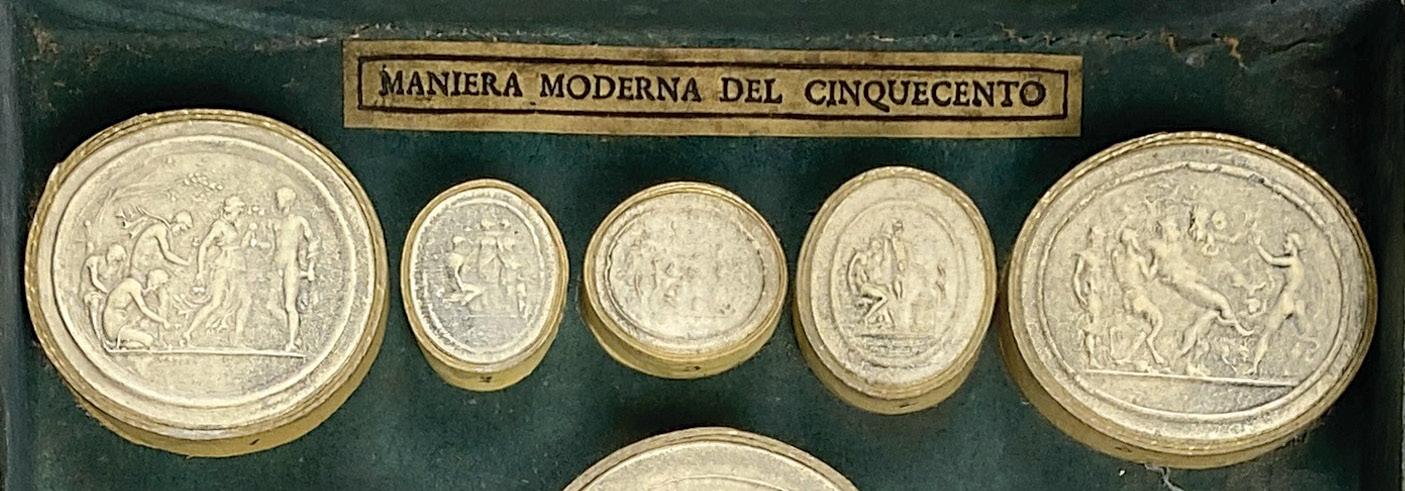

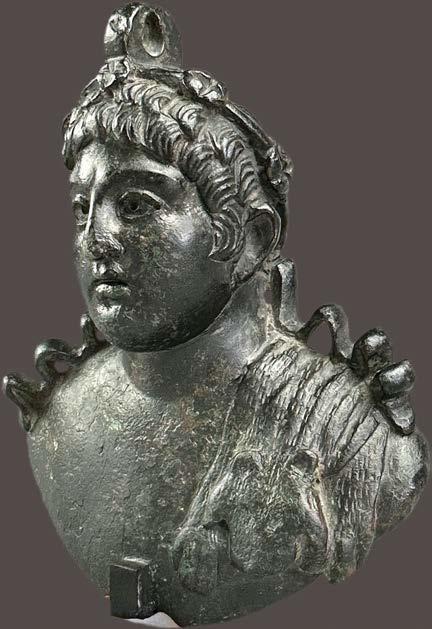
263
ANTIQUITIES
1114. Exceptional Bronze Steelyard Weight Modeled After the Emperor Nero. Roman. Late 1st-3rd Centuries AD. (41/8” x 3-1/2” x 1-3/4”, 445g) Youthful bust with features resembling Nero wearing diadem of roses and vines with streamers hanging across his shoulders, lion’s skin draped over his left shoulder. Pierced for suspension, remnants of mounting post remain. Pleasing natural patina with minimal deposits. Website shipping rates do not apply. ($7500)
Ex Joel Malter Collection, purchased from Jerome Eisenberg in 1999. From an old Cologne Collection.
Part of Lot 1115




264
Photos reduced
1115. Set of one-hundred (100) plaster casts of intaglio gems. Made by Thomas Cades, Rome, circa 1840. Each piece with gilt-foil edge and yellow paper surrounds, mounted on a sea-green paper background on one of four stacking wood trays. Maker’s label on inner lid. As made. Box mostly intact, one impression chipped. A wonderful souvenir of the Grand Tour. ($2000)
Banti
BMC
BMCRE
BN
Bodenstedt
Boehringer
Bopearachchi
Depeyrot
Calicó
CNS
Crawford
CRI
Fischer-Bossert
Flament
Hendin
HN Italy
Kumar
Meshorer
MK
MIR
Price
Prieur
RIC
RPC
RSC
SC
Sellwood
GENERAL BIBLIOGRAPHY
Please refer to our online bibliography at www.cngcoins.com for a complete listing of specialized and general references used, and abbreviations.
ANCIENT
A. Banti. I grandi bronzi imperiali 9 Vols. Florence. 1983-1986.
Various authors. Catalogue of Greek Coins in the British Museum. 29 Vols. London. 1873-1927.
H. Mattingly et al. Coins of the Roman Empire in the British Museum. 6 Vols. London. 1932-1962.
J. Giard. Bibliothèque Nationale, catalogue des monnaies de l’empire romain 3 Vols. Paris. 1976-present.
F. Bodenstedt. Die Elektronmünzen von Phokaia und Mytilene. Tübingen. 1981.
E. Boehringer Die Münzen von Syrakus. Berlin and Leipzig. 1929.
O. Bopearachchi. Monnaies Gréco-Bactriennes et Indo-Grecques Paris. 1991.
G. Depeyrot. Les monnaies d’or (Diocletian à Constantin I, Constantin II à Zenon). Wetteren. 1995-1996.
X. Calicó. The Roman avrei catalogue. 2 Vols. Barcelona. 2002.
R. Calciati. Corpus Nummorum Siculorum: la monetazione di bronzo 3 Vols. Italy. 1983-87.
M. Crawford. Roman Republican Coinage. 2 Vols. Cambridge. 1974.
D. Sear The History and Coinage of the Roman Imperators 49-27 BC. London. 1998.
W. Fischer-Bossert. Chronologie der Didrachmenprägung von Tarent 510-280 v.Chr. Berlin 1999.
C. Flament. Le monnayage en argent d’Athènes. De l’époque archaïque à l’époque hellénistique (c. 550-c. 40 av. J.-C.). Lovainla-Neuve. 2007.
D. Hendin. Guide to Biblical Coins. 6th Edition. New York. 2021.
N.K. Rutter, ed. Historia Numorum. Italy. London. 2001.
S. Kumar Treasures of the Gupta Empire. A Catalogue of Coins of the Gupta Dynasty. San Francisco. 2017.
Y. Meshorer. A Treasury of Jewish Coins from the Persian Period to Bar Kokhba. Jerusalem. 2001.
R. Göbl. Münzprägung des Kušanreiches. Vienna. 1984.
R. Göbl, et al. Moneta Imperii Romani 5 Vols. Vienna. 1984-present.
M.J. Price. The Coinage in the Name of Alexander the Great and Philip Arrhidaeus. London. 1991.
M. Prieur A type corpus of the Syro-Phoenician tetradrachms and their fractions from 57 BC to AD 253. Lancaster. 2000.
H. Mattingly, et al. The Roman Imperial Coinage. 10 Vols. London. 1923-1994.
A. Burnett, et al. Roman Provincial Coinage. 3 Vols and 2 Suppls. London and Paris. 1992-present.
D. Sear, et al. Roman Silver Coins 5 Vols. London. 1978-1987.
A. Houghton & C. Lorber Seleucid Coins: A Comprehensive Catalog. 2 Parts. Lancaster. 2002 and 2008.
D. Sellwood. An Introduction to the Coinage of Parthia. 2nd edition. London. 1980.
SNG ANS Sylloge Nummorum Graecorum, American Numismatic Society New York. 1969-present.
SNG BM Black Sea Sylloge Nummorum Graecorum, British Museum, 1: The Black Sea. London. 1993.
SNG Copenhagen Sylloge Nummorum Graecorum, Danish National Museum. Copenhagen. 1942-1979.
SNG BN Sylloge Nummorum Graecorum, Cabinet des Médailles, Bibliothèque Nationale Paris. 1993-2001.
SNG Kayhan Sylloge Nummorum Graecorum, Turkey 1: The Muharrem Kayhan Collection. Istanbul. 2002.
SNG Levante Sylloge Nummorum Graecorum, Switzerland; E Levante - Cilicia Bern. 1986.
SNG Lloyd Sylloge Nummorum Graecorum, Lloyd Collection. London. 1933-1937.
SNG Lockett Sylloge Nummorum Greacorum, Lockett Collection. London. 1938-1949.
SNG München Sylloge Nummorum Graecorum, München Staatlische Münzsammlung Berlin. 1968-present.
SNG von Aulock Sylloge Nummorum Graecorum, Sammlung Hans Von Aulock. Berlin. 1957-1968.
Starr
Svoronos
Traité
Weidauer
C. Starr Athenian coinage 480-449 BC. London. 1970.
J. Svoronos. Τὰ νομίσματα τοῦ κράτους τῶν Πτολεμαίων Athens. 1904-08.
E. Babelon. Traité des monnaies grecques et romaines. 9 Vols. Paris. 1901-1932.
L. Weidauer. Probleme der frühen Elektronprägung. Fribourg. 1975.
BYZANTINE, MEDIEVAL, WORLD, and BRITISH
Album
Biaggi
Bitkin
BMC Vandals
CIS
CNI
Davenport
S. Album. A Checklist of Popular Islamic Coins 3rd ed. Santa Rosa. 2011.
E. Biaggi. Monete e zecche medievali italiane dal seculo VIII al seculo XV. Torino. 1992.
V. Bitkin. Composite Catalogue of Russian Coins. 2 vols. Kiev. 2003.
W. Wroth. Catalogue of the Coins of the Vandals, Ostrogoths and Lombards and of the Empires of Thessalonica, Nicaea and Trebizond in the British Museum. London. 1911. (Reprinted as Western and Provincial Byzantine Coins in the British Museum.)
S. Goron and J.P. Goenka. The Coins of the Indian Sultanates. New Delhi. 2001.
Corpus Nummorum Italicorum 20 Vols. Rome. 1910-1943.
J.S. Davenport. Various works on European crowns.
ESC H.A. Seaby & P.A. Rayner. The English Silver Coinage from 1649. London. 1992.
Friedberg
R. Friedberg. Gold Coins of the World 8th ed. Clifton. 2009.
KM C.L. Krause & C. Mishler Standard Catalogue of World Coins. Krause Publications. Iola.
Levinson
Lunardi
MEC
MIB
MIBE
R.A. Levinson. The Early Dated Coins of Europe. Clifton, NJ. 2007.
G. Lunardi. Le monete delle repubblica di genova. Genoa. 1975.
P. Grierson & M. Blackburn. Medieval European Coinage. Cambridge. 1986.
W. Hahn. Moneta Imperii Byzantini 3 Vols. Vienna. 1973-81.
W. Hahn and M.A. Metlich. Money of the Incipient Byzantine Empire. Vienna. 2000.
MIR Various. Monete Italiane Regionali. 5 Vols. Pavia. ND.
NM G. Depeyrot. Le numéraire mérovingien. 5 vols. Wetteren. 1998-2001.
North J.J. North. English Hammered Coinage. 2 Vols. London. 1963, 1975.
SB D. Sear, et al. Byzantine Coins and Their Values. 2nd edition. London. 1987.
SCBC Standard Catalogue of British Coins London. Annually.
SCBI Various authors. Sylloge of the Coins of the British Isles.
265
266

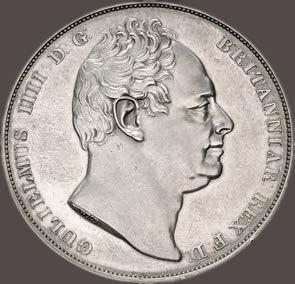




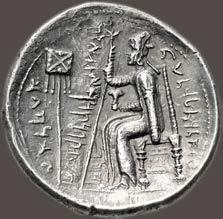

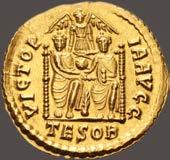

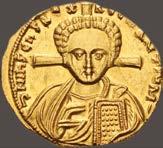

CNG Classical Numismatic Group, LLC Classical Numismatic Group, LLC (PA License Number AY002406) Jeffrey B. Rill (PA License No. AU006206); Brian Callahan (PA License No. AU005870) US OFFICE PO Box 479, Lancaster, PA 17608-0479 Phone (717) 390.9194 Fax (717) 390.9978 UK OFFICE 20 Bloomsbury Street, London WC1B 3QA, UK Phone +44.20.7495.1888 Fax +44.20.7499.5916 EU OFFICE 64A Noordeinde The Hague, Netherlands ZH 2514 GK EMAIL & WEBSITE Email cng@cngcoins.com Website www.cngcoins.com































 Mike Gasvoda Managing Director Lancaster Office
Steve Pruzinsky Chief Financial Officer Lancaster Office
Victor England Consulting Director Lancaster Office
Eric McFadden Consulting Director London Office
Dave Michaels Director Shows & Consignments Lancaster Office
Kate Rill Customer Relations Manager Lancaster Office
Dylan Ossman Office Manager Lancaster Office
Julia Motter Shipping Lancaster Office
Jennifer Ventura Shipping Lancaster Office
Christian Ventura Photographer Lancaster Office
Travis Markel Manager IT & Production Lancaster Office
Alexandra Spyra Office Manager London Office
Sharon Pruzinsky Accounting Lancaster Office
Additional Support IT Consultant A.J. Gatlin Printing Control Robert A. Trimble Auctioneers Jeffrey B. Rill PA License No. AU006206
Brian Callahan PA License No. AU005870
Daniel Burch Numismatist Lancaster Office
Katie Vint Numismatic Intern Lancaster Office
Caroline Holmes Numismatist London Office
Lance Hickman Managing Numismatist Consignment Staff Lancaster Office
Steve Lloyd Numismatist Islamic Specialist London Office
Julian Okun-Dubitsky Numismatist Lancaster Office
Jeffrey B. Rill Numismatist Lancaster Office
Bill Dalzell Managing Numismatist Cataloging Staff Lancaster Office
Bradley R. Nelson Senior Numismatist Lancaster Office
D. Scott VanHorn Senior Numismatist Lancaster Office
David Guest Managing Numismatist London Office
Paul Hill Managing Numismatist London Office
Tom Mullally Numismatist Lancaster Office
Mike Gasvoda Managing Director Lancaster Office
Steve Pruzinsky Chief Financial Officer Lancaster Office
Victor England Consulting Director Lancaster Office
Eric McFadden Consulting Director London Office
Dave Michaels Director Shows & Consignments Lancaster Office
Kate Rill Customer Relations Manager Lancaster Office
Dylan Ossman Office Manager Lancaster Office
Julia Motter Shipping Lancaster Office
Jennifer Ventura Shipping Lancaster Office
Christian Ventura Photographer Lancaster Office
Travis Markel Manager IT & Production Lancaster Office
Alexandra Spyra Office Manager London Office
Sharon Pruzinsky Accounting Lancaster Office
Additional Support IT Consultant A.J. Gatlin Printing Control Robert A. Trimble Auctioneers Jeffrey B. Rill PA License No. AU006206
Brian Callahan PA License No. AU005870
Daniel Burch Numismatist Lancaster Office
Katie Vint Numismatic Intern Lancaster Office
Caroline Holmes Numismatist London Office
Lance Hickman Managing Numismatist Consignment Staff Lancaster Office
Steve Lloyd Numismatist Islamic Specialist London Office
Julian Okun-Dubitsky Numismatist Lancaster Office
Jeffrey B. Rill Numismatist Lancaster Office
Bill Dalzell Managing Numismatist Cataloging Staff Lancaster Office
Bradley R. Nelson Senior Numismatist Lancaster Office
D. Scott VanHorn Senior Numismatist Lancaster Office
David Guest Managing Numismatist London Office
Paul Hill Managing Numismatist London Office
Tom Mullally Numismatist Lancaster Office
































































































































































































































































































































































































































































































































































































































































































































































































































































































































































































































































































































































































































































































































































































































































































































































































































































































































































































































































































































































































































































































































































































































































































































































































































































































































































































































































































































































































































































































































































































